Early Los Angeles City Views (1900 - 1925)
Historical Photos of Early Los Angeles |
 |
|
| (ca. 1902)* - View looking north on Spring Street from 3rd Street. Early model automobiles share the road with horse-drawn wagons, electric streetcars, and bicycles. A large number of pedestrians fill the sidewalk and some are seen crossing the road. A large sign on the side of the horse-drawn wagon in the foreground reads: "California Carpet Co." Also, the sign on top of the streetcar reads: "Washington St - Western Ave" |
Historical Notes In 1900, 8,065 horses called Los Angeles home, one for every 12.7 people. Inside the city, stables, saddlers, and blacksmiths occupied prime real estate along L.A. streets. Outside the city, farmers planted countless acres with the oat and alfalfa that fueled these animal engines. And the horse-drawn vehicle was hardly a zero-emissions machine. In fact, though Southern California's millions and millions of internal combustion engines have added up to an environmental disaster, the urban horse made the automobile look like a clean technology by comparison. A single animal produced 15-30 pounds of manure and a quart of urine each day, much of which festered on the city streets, attracting flies, soiling shoes, and mingling with dirt to form noxious mud when wet and eye-stinging dust in dry weather. And when draft animals collapsed from over-exertion, their drivers often left their carcasses to rot in the roadway -- a sight that disturbed humans and spooked other horses, occasionally triggering mad stampedes through crowded streets. City officials struggled to keep this public health menace in check, contracting with street sweepers and dead animal removers, but ultimately it took the replacement of equine by automobile power to clean up L.A.'s streets. Horses continued to march down (and foul up) Los Angeles streets well into the 1920s. Not until 1924 had the balance of power tilted to motorists such that city leaders felt comfortable banning horse-drawn vehicles from downtown during rush-hour -- a traffic-relief measure that remains on the books to this day.**# |
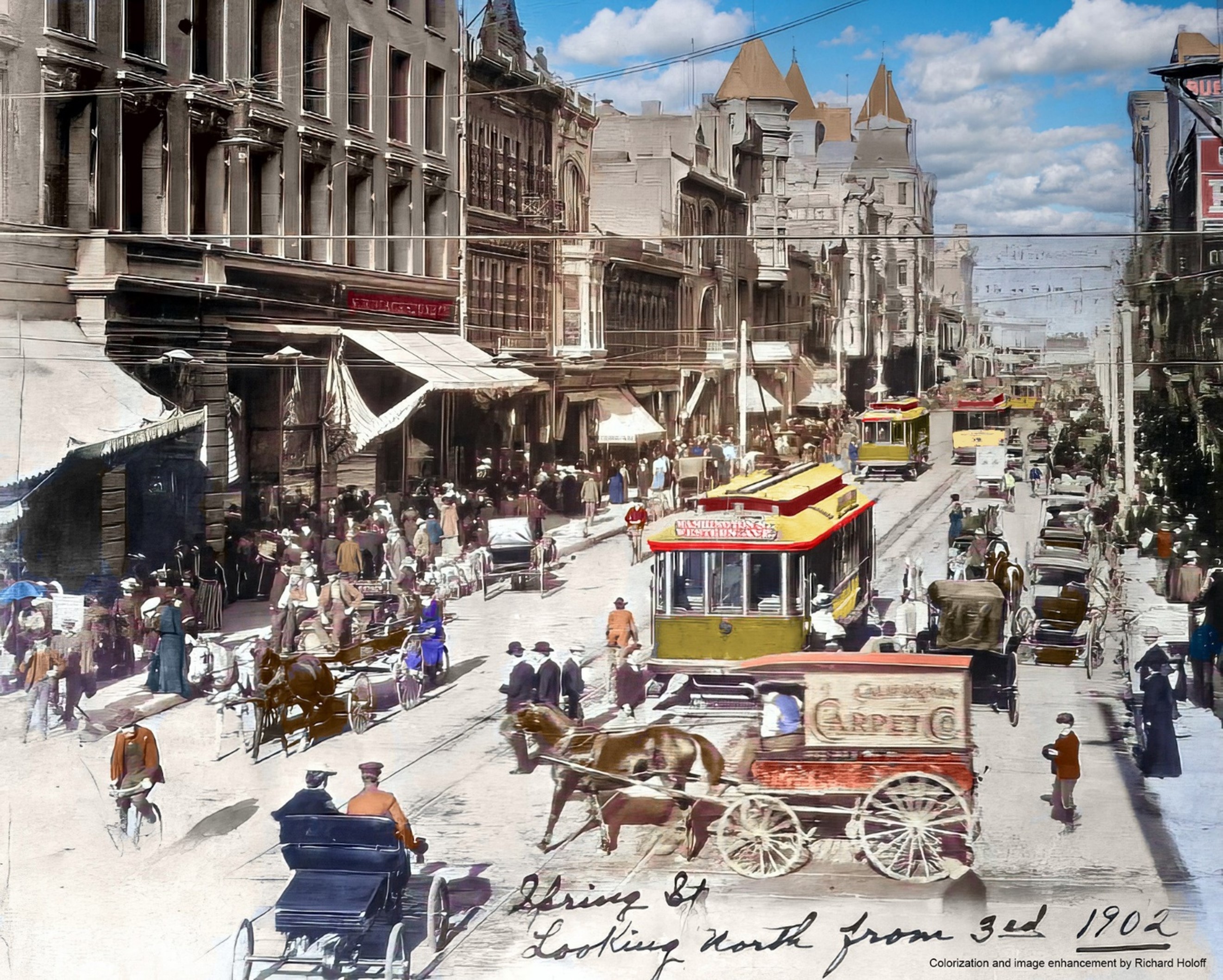 |
|
| (ca. 1902)* - View looking north on Spring Street from 3rd Street. Early model automobiles share the road with horse-drawn wagons, electric streetcars, and bicycles. A large number of pedestrians fill the sidewalk and some are seen crossing the road. A large sign on the side of the horse-drawn wagon in the foreground reads: "California Carpet Co." Also, the sign on top of the streetcar reads: "Washington St - Western Ave". Image enhancement and colorization by Richard Holoff. |
Historical Notes In 1902, the Los Angeles Railway (LARy) streetcars operating in downtown Los Angeles were painted a distinctive yellow color. This color scheme became iconic for LARy and was maintained throughout much of its existence. The yellow streetcars were a familiar sight on the streets of Los Angeles during the early 20th century, contributing to the city's vibrant and bustling atmosphere. |
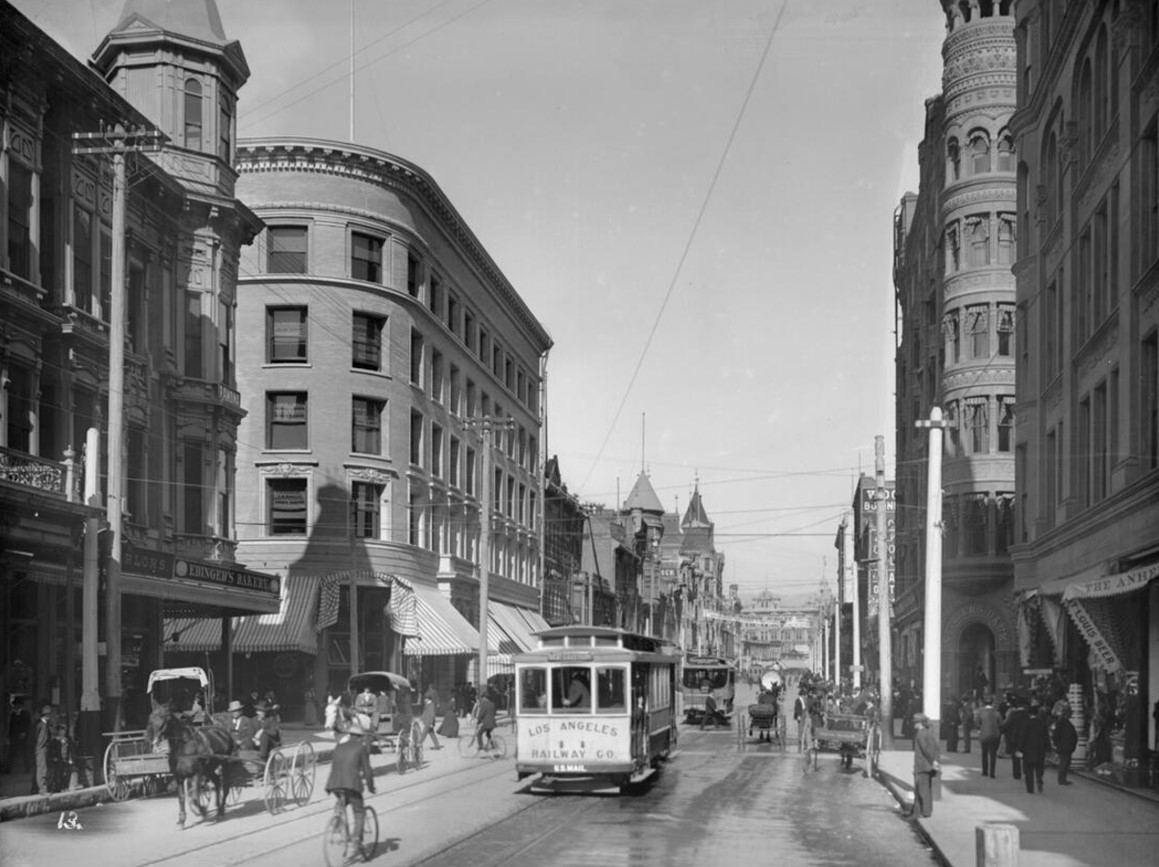 |
|
| (1903)* - A view looking north on Spring Street toward Third Street with carriages, trolley cars, pedestrians and bicycles. This photo was taken from about the same location as previous image but about one year later. The sign on the cable car reads: "Los Angeles Railway Co." The Douglas Building on the NW corner still stands. Click HERE for contemporary view. |
Historical Notes Los Angeles Railway (1895-1945) also known as the Yellow Cars of Los Angeles, was the local streetcar transit system running down the center of city streets and connecting the city center to neighborhoods in about a six mile radius of downtown. |
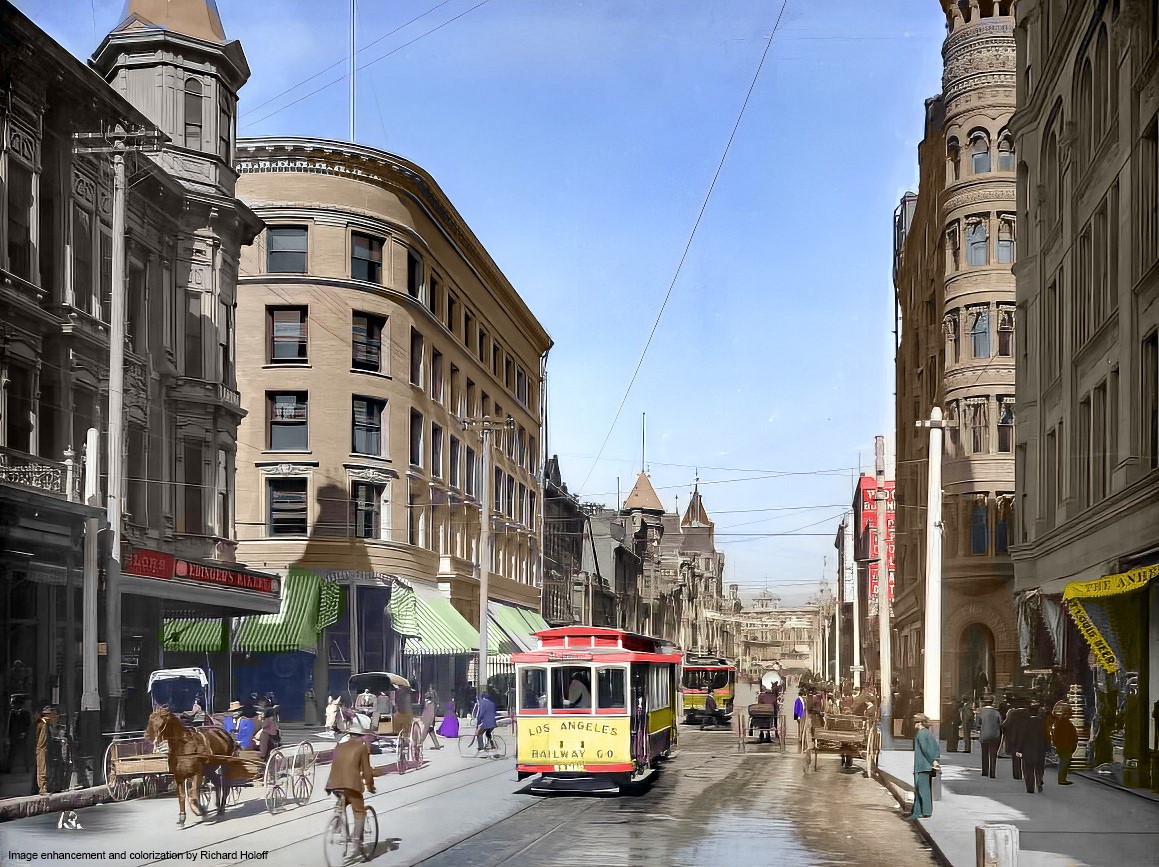 |
|
| (1903)* - A view looking north on Spring Street toward Third Street with carriages, trolley cars, pedestrians and bicycles. The sign on the cable car reads: "Los Angeles Railway Co." The Douglas Building on the NW corner still stands. Click HERE for contemporary view. Photo by C.C. Pierce; Image enhancement and colorization by Richard Holoff |
Historical Notes Los Angeles Railway (1895-1945) also known as the Yellow Cars of Los Angeles, was the local streetcar transit system running down the center of city streets and connecting the city center to neighborhoods in about a six mile radius of downtown. |
.jpg) |
|
| (1903)* - Close-up panoromic view of Spring Street from Third Street showing a typical downtown Los Angeles day in 1903. On the right is the entrance to Citizens Bank. |
Then and Now
 |
|
| (1903 vs. 2019) – View looking North on Spring Street at 3rd Street with the Douglas Building seen on the NW corner. Photo comparison by Jack Feldman. |
Historical Notes The 1899-built Douglas Building located on the NW corner of Spring and 3rd streets still stands today. It was designed by the Reid Brothers, architects, and developed by Thomas Douglas Stimson. In 2009 the Classical Revival style building was declared LA Historic-Cultural Monument No. 966. |
Then and Now
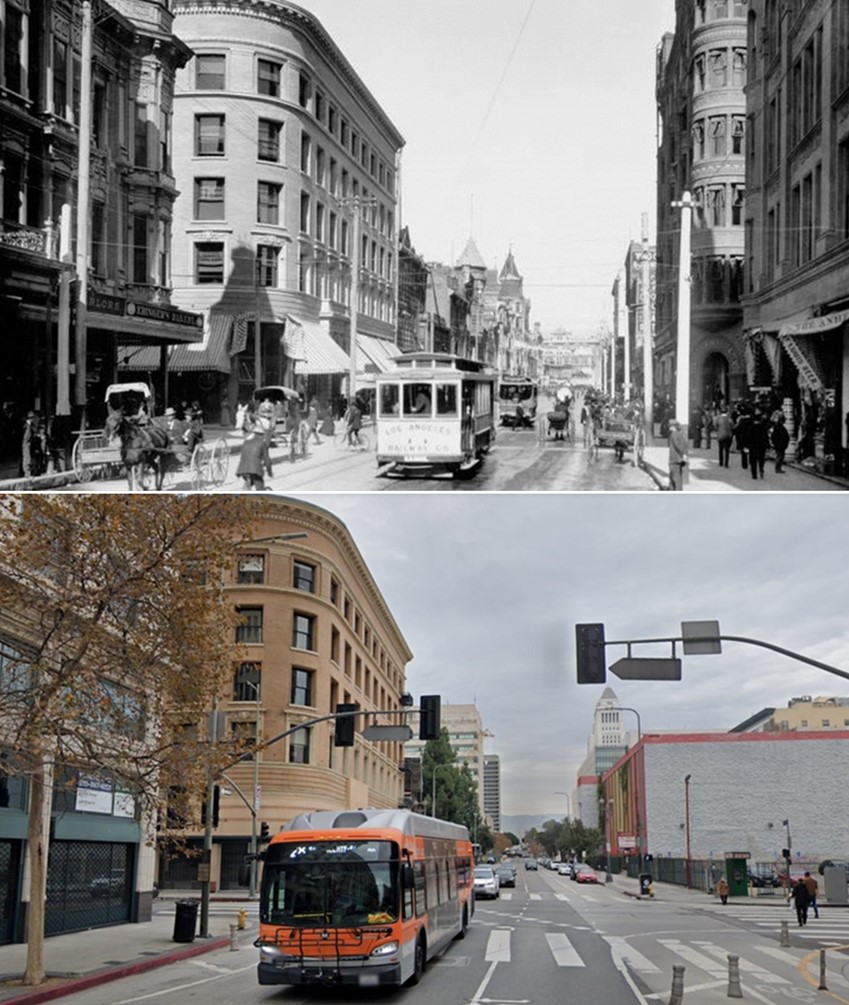 |
|
| (1903 vs. 2021) – View looking North on Spring Street at 3rd Street with the Douglas Building seen on the NW corner. Photo comparison by Jack Feldman. |
Historical Notes The Douglas Building was commissioned by T.D. Stimson, a lumber baron turned real estate mogul who fostered commercial development in Los Angeles during the 1890s. The five-story building was designed by San Francisco architects James and Merritt Reid, who gained fame for designing the remarkable Hotel del Coronado near San Diego in 1888. The Douglas Building was one of Los Angeles’ greatest office building and commanded the highest rentals. In its early years, it housed the chief ticket office of the Southern Pacific Railroad. During that time many travelers passed through its doors to purchase a ticket. In 2005, this former office block was renovated into 50 residential units.* |
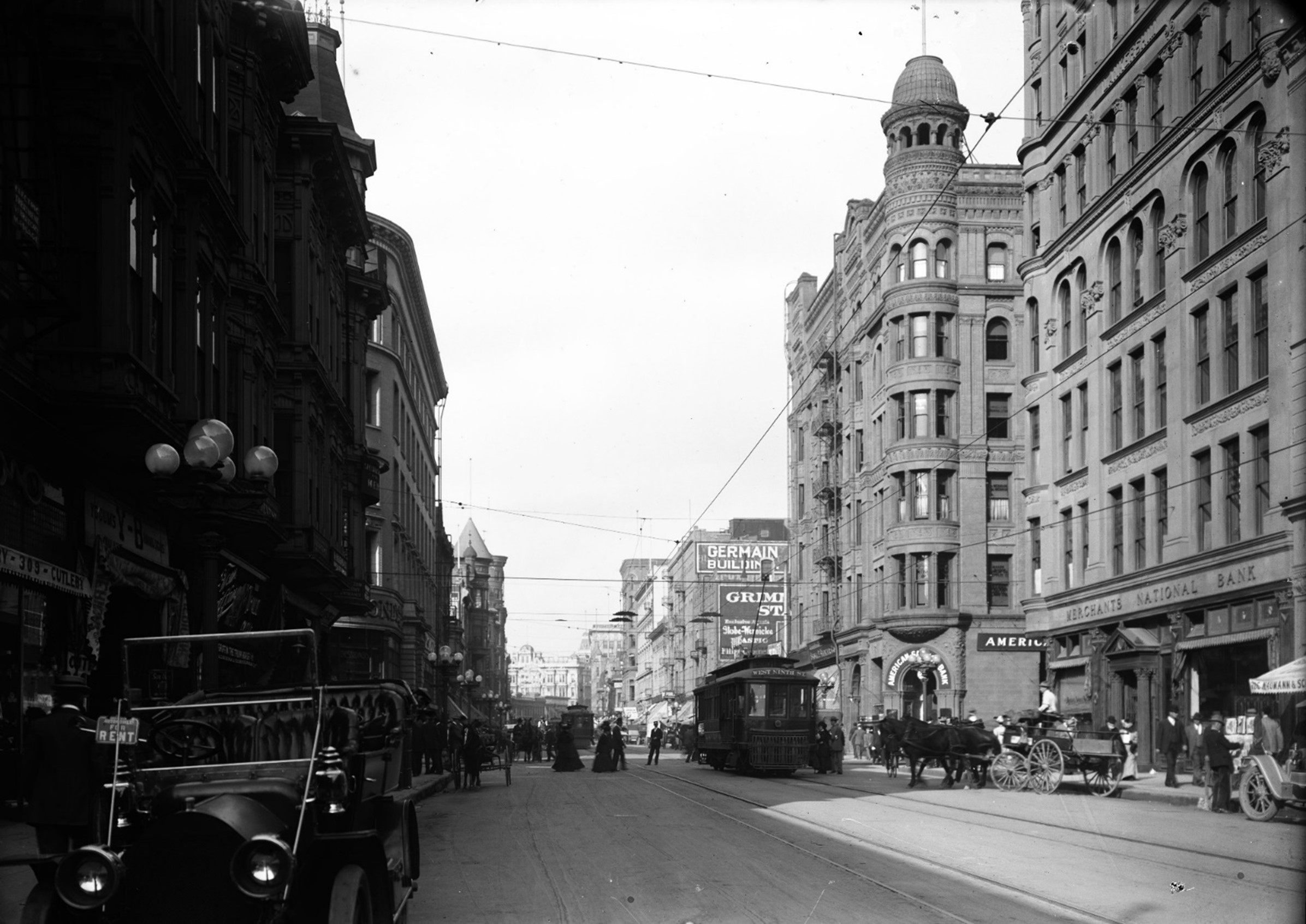 |
|
| (ca. 1907)* - Looking north on Spring Street toward Third Street with the beautiful Stimson Building seen on the NE corner. |
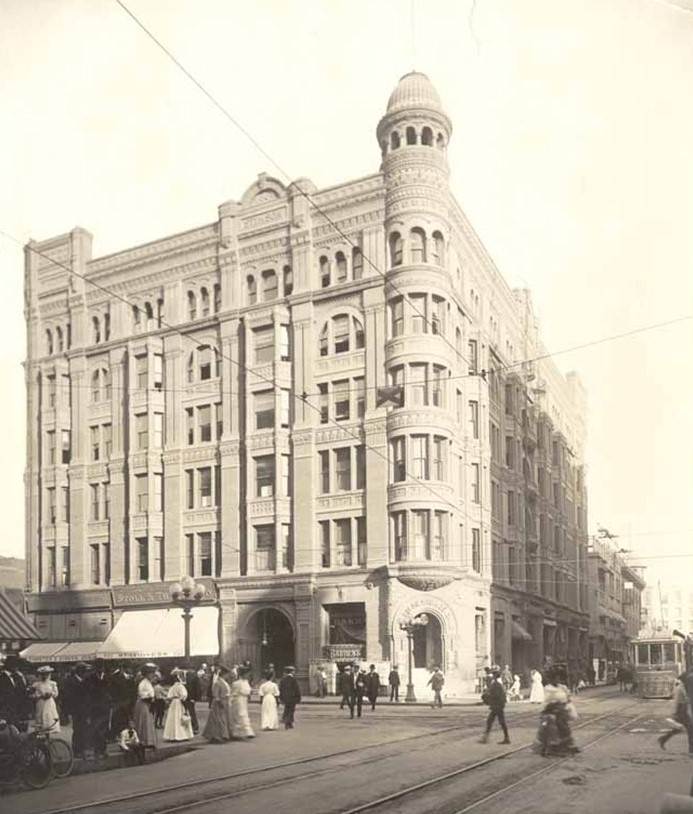 |
|
| (ca. 1908)*- Looking east on Third Street at Spring Street showing the Stimson Building on the NE corner. The six-story stone masonry building with cupola and projecting bays was located at 256 South Spring Street. |
Historical Notes The 1893-built Stimson Building, a six story Richardsonian Romanesque office building with an observation tower, stood on the NE corner of Spring and 3rd streets until 1963…today a parking lot. Click HERE to see more Early Views of the Stimson Building. |
Then and Now
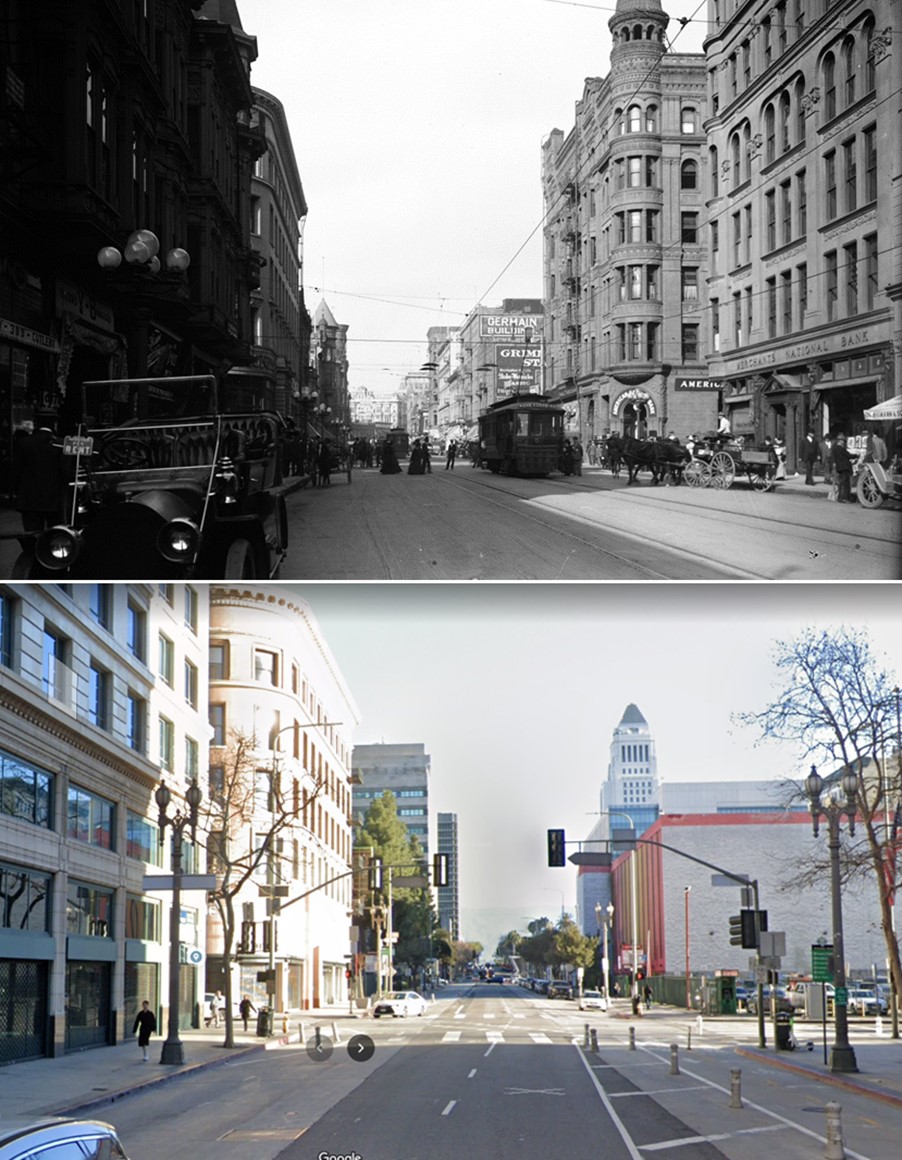 |
|
| (1907 vs 2023)* - Looing north on Spring Street toward Third Street. Photo comparison by Jack Feldman. |
Broadway
.jpg) |
|
| (ca. 1900)^^ - Panoramic view looking south on Broadway from the LA County Courthouse. City Hall is the tallest structure in the distance. |
Historical Notes The above photograph features the following buildings: From north-west corner of Broadway and First Street: Tajo Building (1894-1938), Tally-Ho (circa 1894-1939, adjoining Tajo to north), Watauga Hotel (four-story, two buildings north of Tally-Ho), Brotherton Building, Franklin Hotel (far lower right, top of T, Broadway at Franklin Street) and Los Angeles Police Central Division (west of, and partially behind Tajo, across First Street); South of First Street: Hough Block (unknown-1956, 2nd from SW corner), Yosemite Hotel (left of the Hough Block), Newell and Rader Block (the shorter building left of Yosemite Hotel), Newell and Gammon Building (a taller building with "Smith Premier" sign), Roanoke Building (built in 1886 as Millar Building, left of Newell), C.H. Frost Building (built in 1898, north-west corner of Broadway and Second Street), California Hotel (First and Hill Streets), Hotel Lincoln (with white cupola, Hill Street at First and Second Streets), Crocker Mansion (at Bunker Hill - just above and left of Lincoln cupola, south-east of Olive Street and Third Street); South of Second Street: California Bank Building (built in 1887, south-west corner), YMCA Building (built ca.1887, left of the California Bank), B.F. Coulter Building (built ca.1888, left of YMCA Building), Bicknell Building (built in 1892, left of the Coulter Building), . H. Newmark Building (left of Bicknell), Boston Dry Goods Store (built ca. 1896, J. W. Robinson's, left of Newmark), Fred J. Byrne Building (at north-west corner with Second Street). From the left side Broadway: Second Los Angeles Times Building; South of First Street: Culver Block (at south-east corner of Broadway and First Street), Hayes Block (just east of the Culver Block), Larronde Block (at north-west corner of Spring and First Streets), Schumacher Block (just north of the Larronde Block), Nadeau Hotel (First and Spring Streets), Wilson Block (south-east corner of Spring and First Street); South of Second Street: Hellman Building (north-east corner of Broadway and Second Street), Bryson-Bonebrake Building (north-west corner of Spring and Second Streets), Hollenbeck Hotel (1884-1931, south-west corner of Second and Spring Streets), Wilcox Building (1896 - shortened in 1971, south-east corner of Spring and Second Streets), Third City Hall (1888-1928); South of Third Street: Bradbury Building (built in 1893, south-east corner of Broadway and Third Street).^^ |
 |
|
| (ca. 1900)#*^^ - View looking north on Broadway from near 3rd Street showing streetcars, horse-drawn wagons, bicycles and pedesrians all sharing the roadway. City Hall stands tall on the east side of Broadway. The LA County Courthouse, built in 1891, stands in the background. |
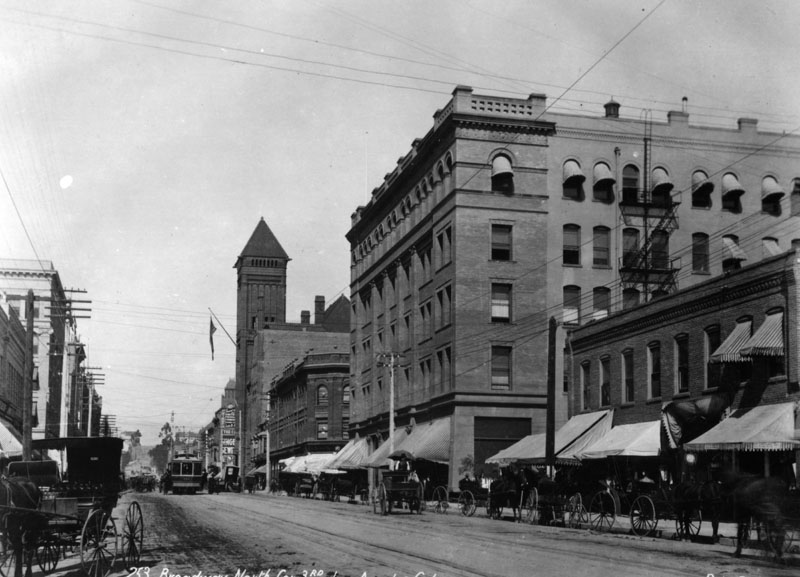 |
|
| (ca. 1900)^ - Street view of Broadway looking north from 3rd Street. Trolleys as well as horses and carriages are seen on the street. City Hall can be seen down the street on the right (tall tower and flag). |
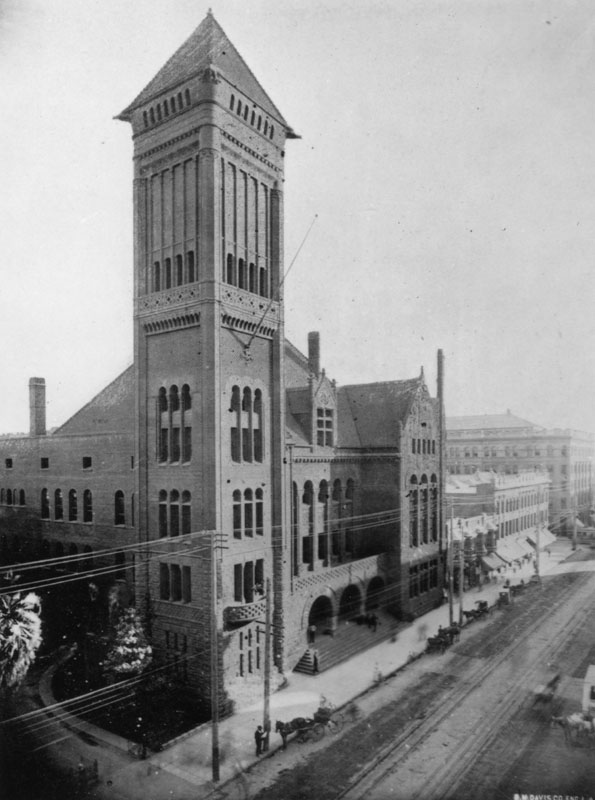 |
|
| (ca. 1890)^ - Close-up view of Old City Hall at 226 Broadway. Horse-drawn carriages can be seen parked in front of the building. |
Historical Notes The following historical timeline lists the buildings used by City Council, also known as City Hall, since 1850, when Los Angeles was incorporated as a municipality: ◆ 1850 - 1853 - used rented hotel and other buildings for City meetings ◆ 1853 - rented adobe house (aka Rocha Adobe) on Spring Street - across from current City Hall (now parking lot for Clara Shortridge Foltz Criminal Justice Center). The buliding was shared with the County who used it as a Court House. ◆ 1861 - moved into John Temple's Clocktower Market Building, but only stayed for less than a year before the County Court House moved-in ◆ 1861 - 1884 - relocated back to the Rocha Adobe and stayed for over 20 years ◆ 1884 - 1888 - moved to new City Hall Building at South Spring Street and West 2nd Street (site of current Los Angeles Times Building) ◆ 1888 - 1928 - moved to new Romanesque Revival Building on 226-238 South Broadway between 2nd Street and 3rd Street; demolished in 1928 and now site of parking lot between LA Times Parking structure and 240 Broadway. ◆ 1928 - moved to current City Hall Building *^ |
Broadway and 2nd Street
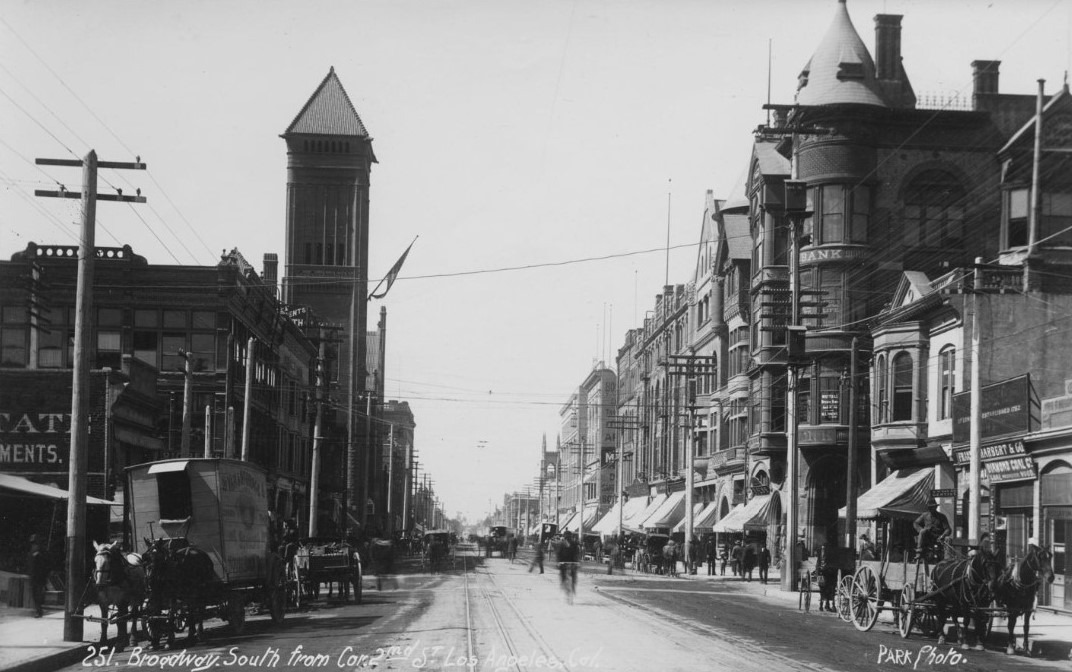 |
|
| (ca. 1902)^ - Street view looking south on Broadway from near the conrner of 2nd Street showing the 1888-built City Hall with flag. Horse-drawn carriages are seen on both sides of the street. A bicycle is moving north toward the photographer as it passes 2nd Street. The building with the conical roof on the right, SW corner of Broadway and 2nd Street, is the California Bank Building (built in 1887). |
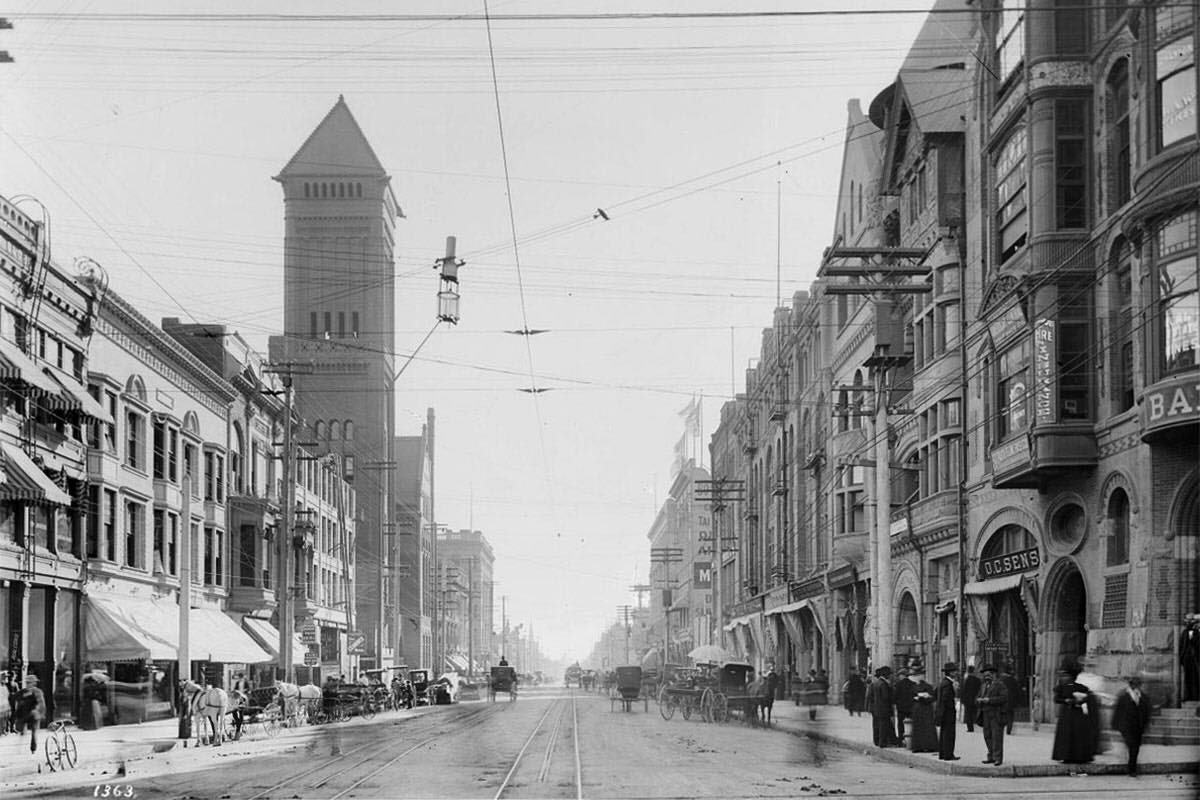 |
|
| (ca. 1904)* - Broadway looking south from Second Street. A double carbon arc lamp utilitarian streetlight is hanging from wire at the center of the intersection. |
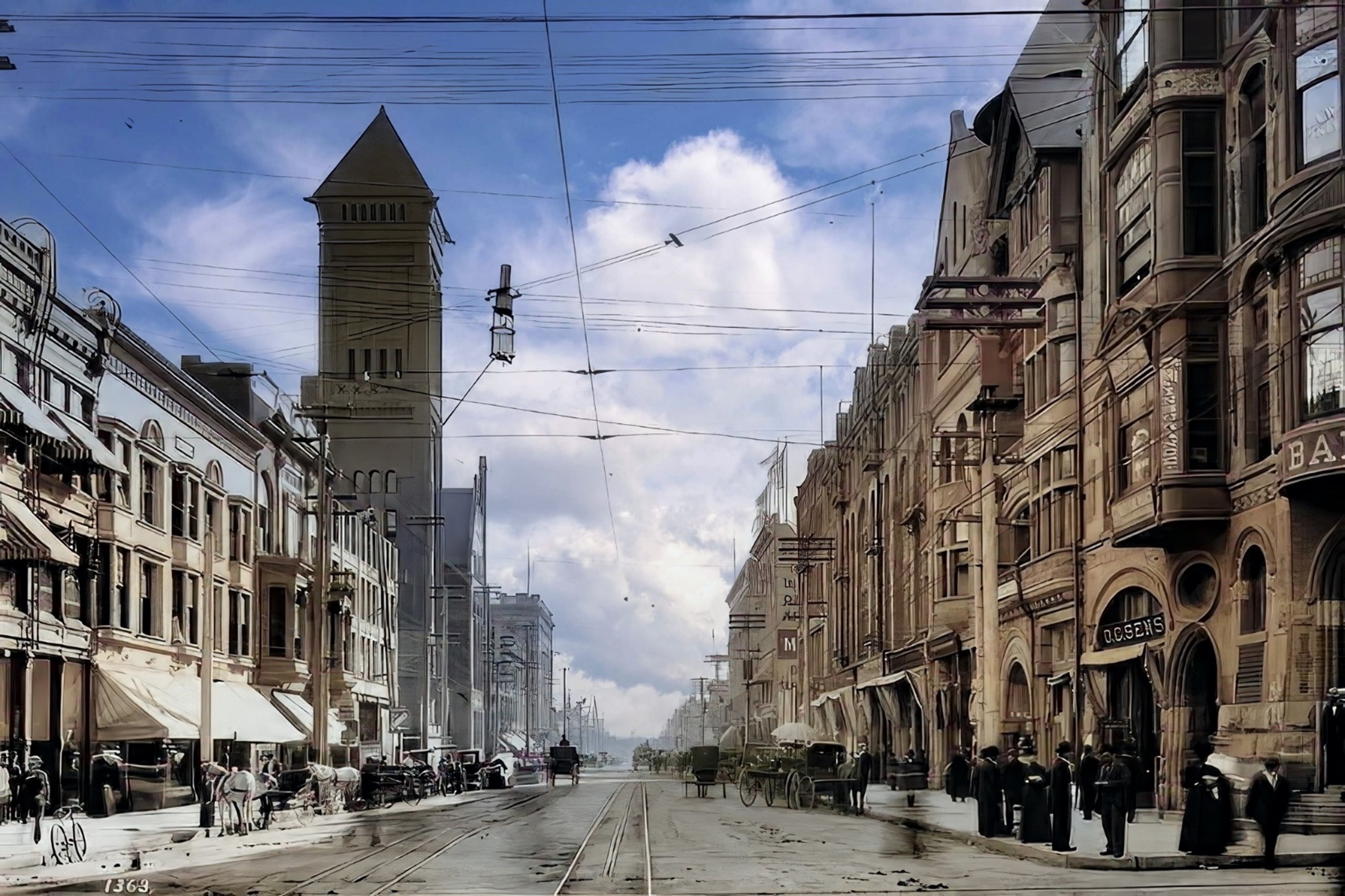 |
|
| (ca. 1904)* - Looking south on Broadway at 2nd Street in DTLA. Photo by C.C. Pierce; AI enhancement and colorization by Richard Holoff |
Then and Now
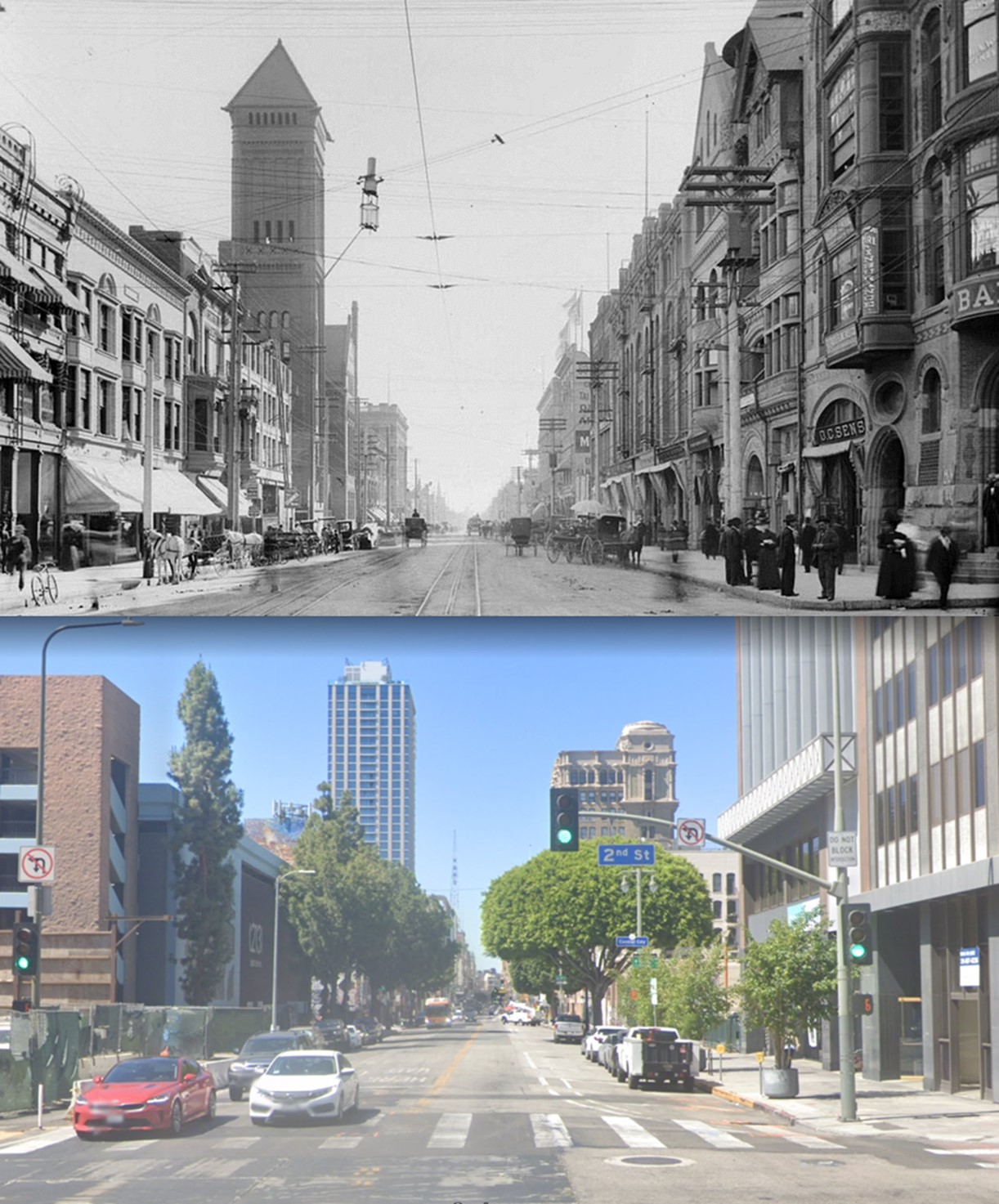 |
|
| (1904 vs. 2022)* - Looking south on Broadway at 2nd Street. Photo comparison by Jack Feldman. |
Broadway and 1st Street
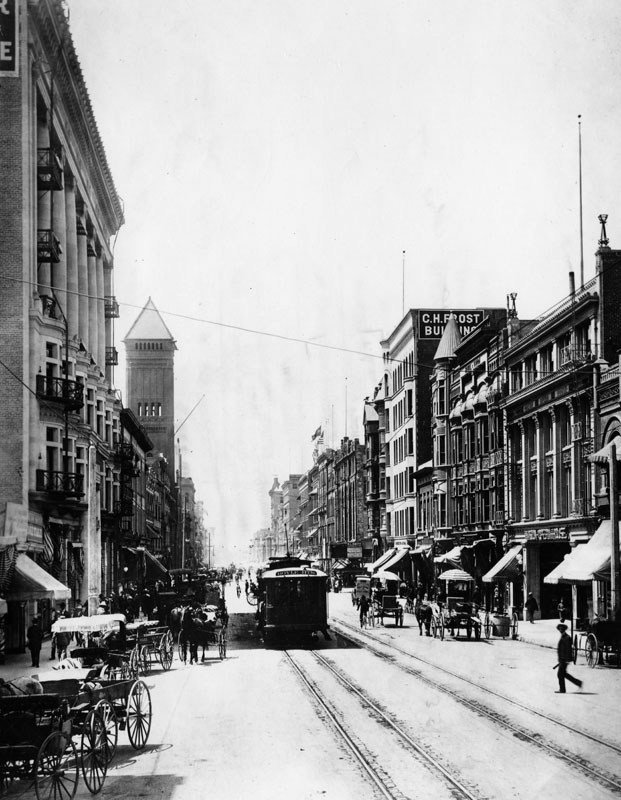 |
|
| (ca. 1904)^ - A view of Broadway looking south from 1st Street. A trolley marked "Boyle Heights” takes the center of the street while horses and carriages fill the sides in front of the businesses along the street. The building on the left with the large columns is the Southwest Building (130 S. Broadway). It was occupied by the LA Chamber of Commerce between 1903 and 1925. The ornate building across the street with the turret is the Newell and Gammon Building (131 S. Broadway). Down the street on the left can also seen the tower of the City Hall building. |
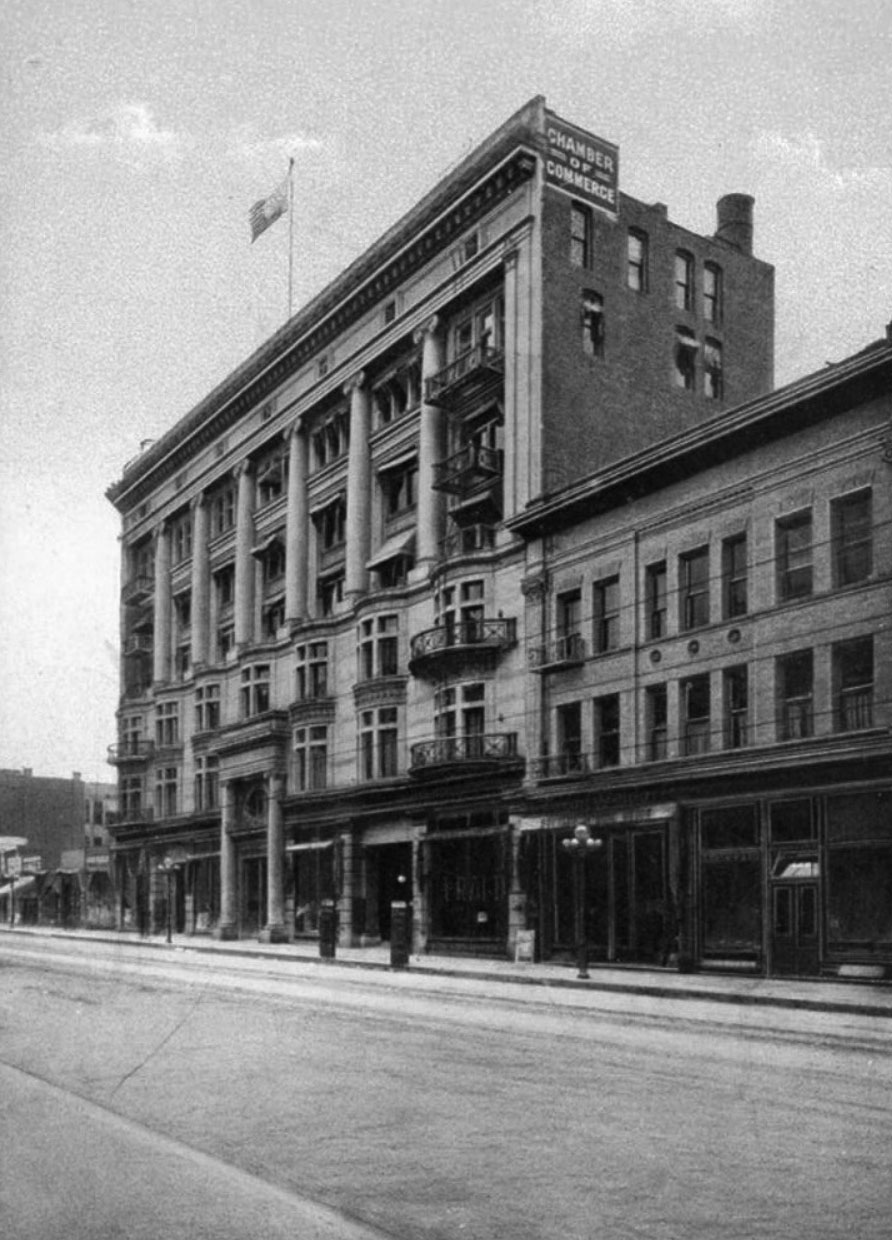 |
|
| (ca. 1903)* – Postcard view showing the Los Angeles Chamber of Commerce, also known as the Southwest Building, located at 130 S. Broadway between 1st and 2nd streets; view is looking north. |
Historical Notes The Los Angeles Chamber of Commerce's first meetings were held in the old board of trade building on First and Broadway, which has since been torn down. In 1890, the Chamber moved into the Mott Building at 131 S. Main Street, where it stayed for four years. In 1894, the organization moved to new quarters at the southeast corner of Broadway and 4th, in a building designed especially for its use, the then-new three-story Mason Building - which would serve as the L.A. Chamber of Commerce for twelve years. In 1903, it moved into the Southwest Building, located at 130 S. Broadway, and stayed there until January 31, 1925. In 1925 it moved to its brand new building at 1151 S. Broadway and 12th Street. It now makes its home at 350 S. Bixel and 6th streets.* |
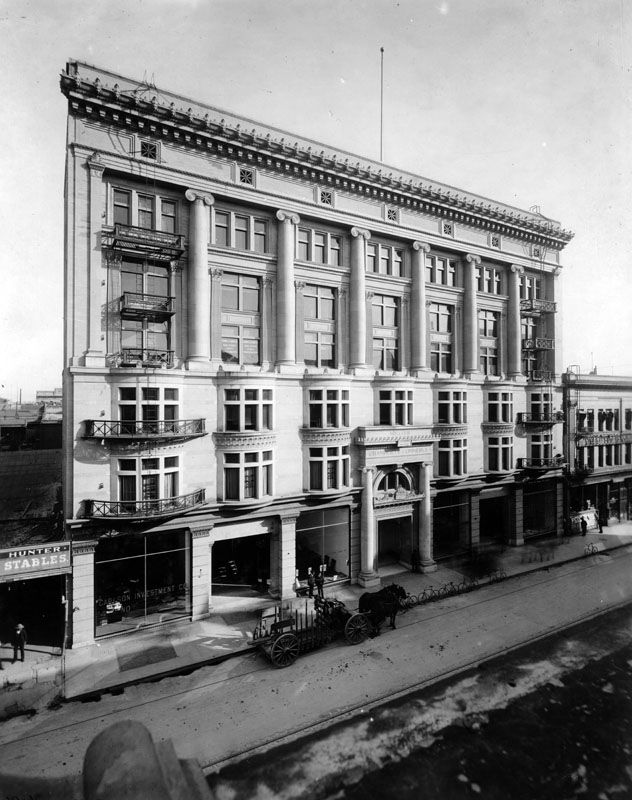 |
|
| (1905)^ - The Los Angeles Chamber of Commerce, also known as the Southwest Building, located at 130 S. Broadway. The white building has numerous windows, columns, and balconies as well as ornamental detailing throughout. The Chamber of Commerce moved here in 1903 and stayed until January 31, 1925. Parked along the front are several bicycles, as well as a horse-drawn cart. |
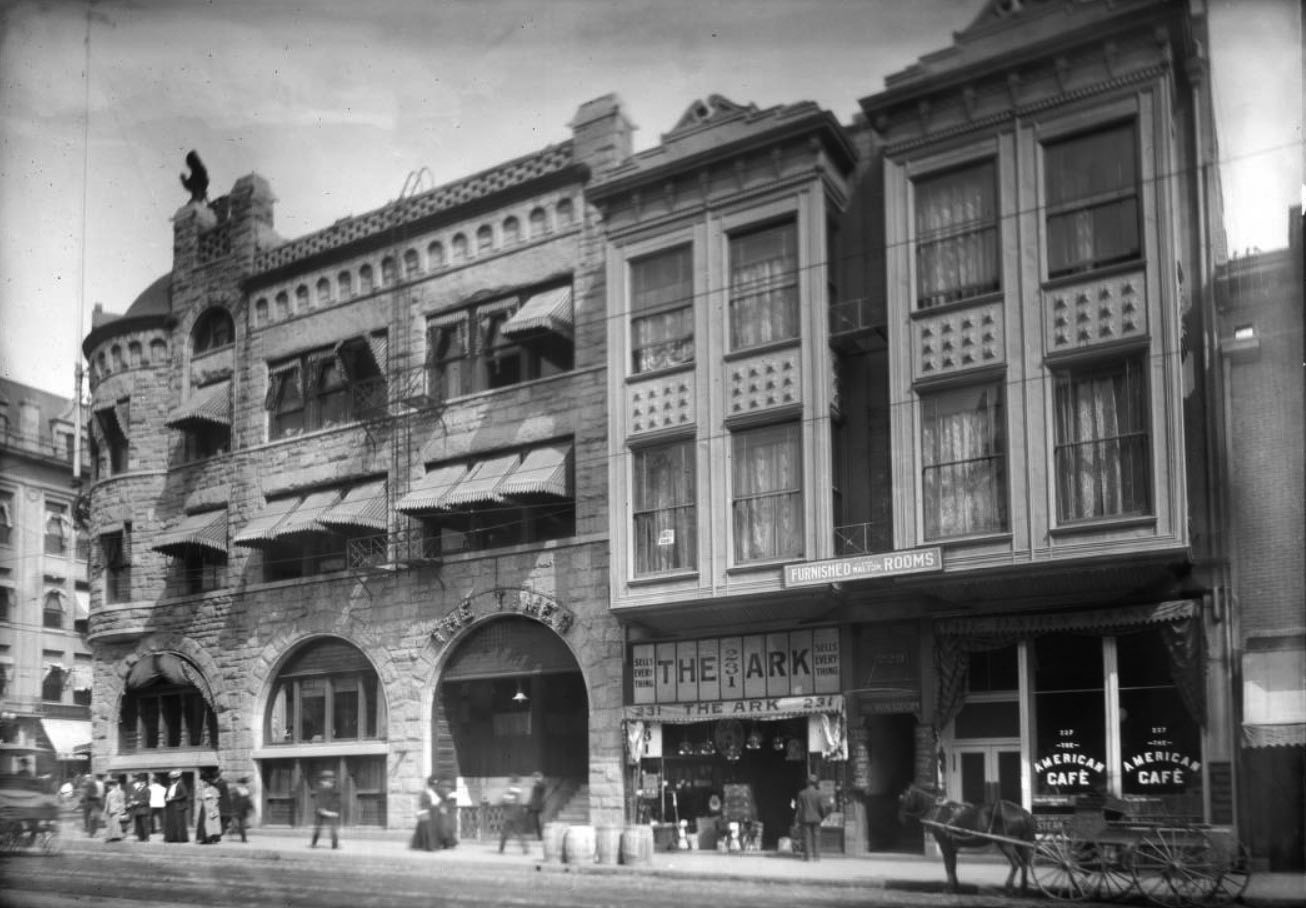 |
|
| (ca. 1905)^^ - View looking at the north side of 1st Street showing the three-story stone Los Angeles Times Building (built in 1886), N/E corner of First Street and Broadway. Next door is a rooming house above store fronts. About fifteen pedestrians are on the sidewalk. Two horse-drawn carriages are in the street. Legible signs include: "The Times", "Furnished Rooms", "Sells Everything - The Ark, 231", "The American Café”. |
Views from Bunker Hill
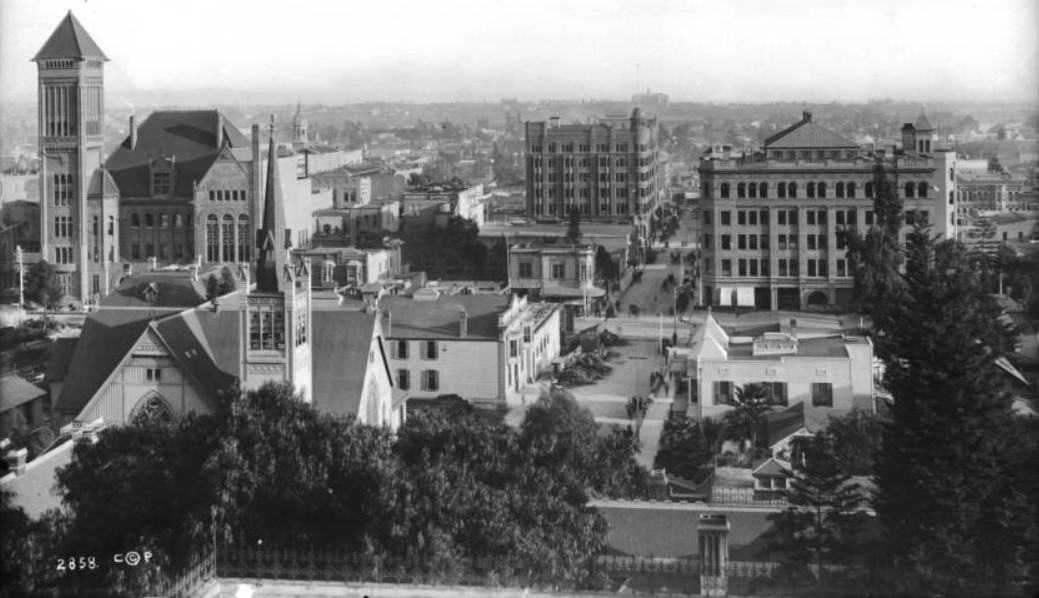 |
|
| (ca. 1900)^^ - Panoramic view of downtown Los Angeles, looking east, as seen from the rear deck of the Crocker Mansion . The view is looking toward the intersection of Broadway and Third Street where the Bradbury Building stands on the southeast corner. The streets are busy with horse-drawn vehicles and pedestrians. A pile of construction supplies and debris is visible near the intersection. City Hall is at left and the First Congregational Church at lower-left. |
Historical Notes Built in 1893, the Bradbury Building was commissioned by LA mining millionaire Lewis L. Bradbury and designed by local draftsman George Wyman. Click HERE to see more Early Views of the Bradbury Building. |
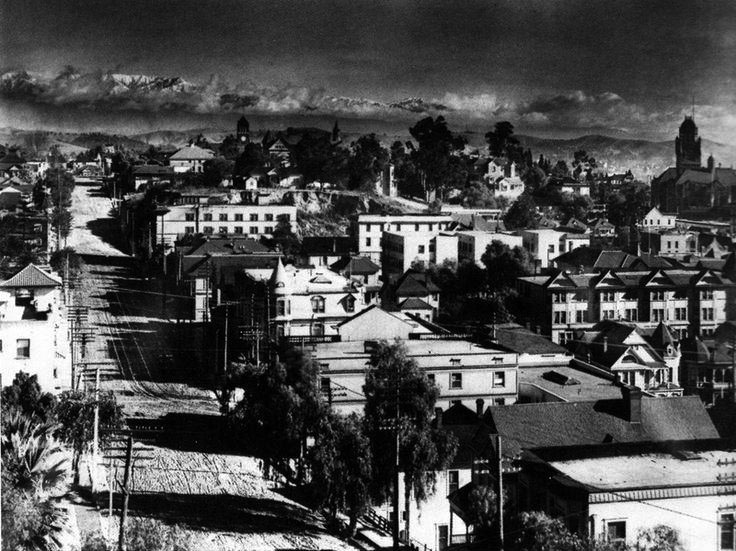 |
|
| (ca. 1900)* - View from Bunker Hill looking north on Grand Avenue near Third Street on an exceptionally clear day. The San Gabriel Mountains can be seen in the background. |
Historical Notes This exclusive residential area, most of it built during the 1880's, was at its zenith in 1900. |
* * * * * |
Spring and 4th Streets
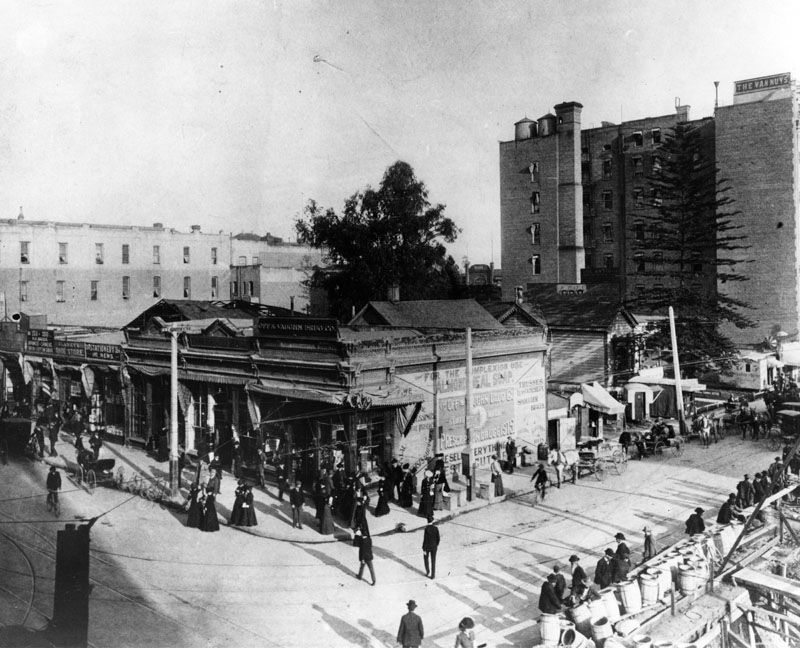 |
|
| (ca. 1900)^ - View of the northeast corner of Spring and 4th streets, showing pedestrians and Off & Vaughan Drug Co., Blaney's Shoe Store and part of the Van Nuys Hotel. Pedestrians and horse-drawn wagons are seen throughout. In 1903, the 8-story Hellman Building would be built on the northeast corner of Spring and 4th. |
Historical Notes By 1900, Los Angeles' population swelled to 102, 500. This was double the City's population of only 10 years earlier (1890). The Van Nuys Hotel was built by Isaac Newton Van Nuys, businessman, real estate developer, banker, and agricultural entrepreneur. He founded the community of Van Nuys in the San Fernando Valley in 1911. As a major figure in regional history and development, there are schools, streets, libraries, and a Liberty Ship with the name of Van Nuys. |
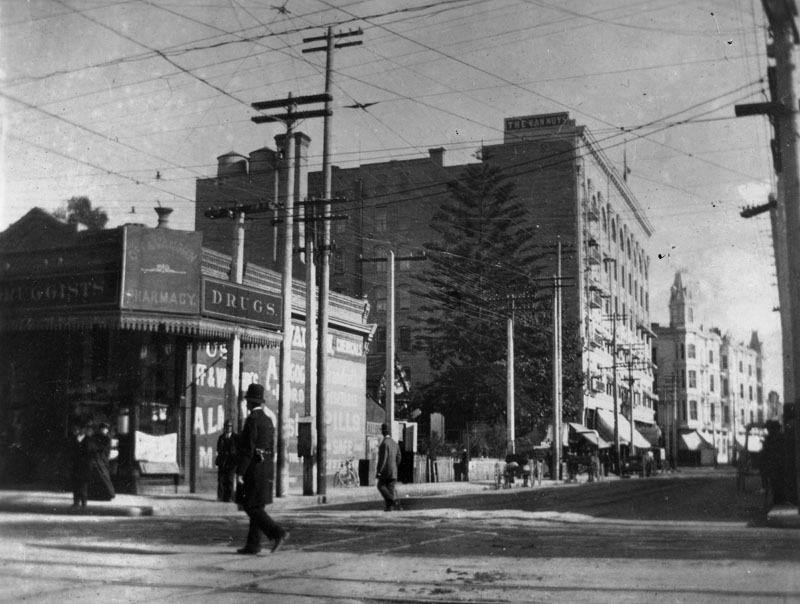 |
|
| (ca. 1900)^ - The intersection of 4th Street looking east from Spring Street toward Main Street in 1898. The Off & Vaughn Pharmacy is seen on the northeast corner, and the Van Nuys Hotel at 103 W. 4th Street at the corner of Main Street. Further in the distance is the Westminster Hotel. Pedestrians and horse-drawn carriages are seen. We are beginning to see overhead line congestions from telephone poles and electric streetcars. |
Historical Notes The Van Nuys Hotel was designed in 1895 by Octavius Morgan and J. A. Walls in a Beaux-Arts style for Isaac Newton Van Nuys. Consolidated Hotels, Inc., leased the hotel in 1929, renamed it to Barclay, and renovated it to include a high-speed elevator and a remodeled lobby. |
 |
|
| (1903)* – View showing a steam shovel excavating the northeast corner lot of Spring and 4th streets where the Hellman Building will soon go up. The Angelus Hotel is seen across the street on the southwest corner. |
Historical Notes When built in 1901, the Angelus Hotel was advertised as the tallest building in Los Angeles. The Hellman Building, built in 1903, would surpass it at eight stories. |
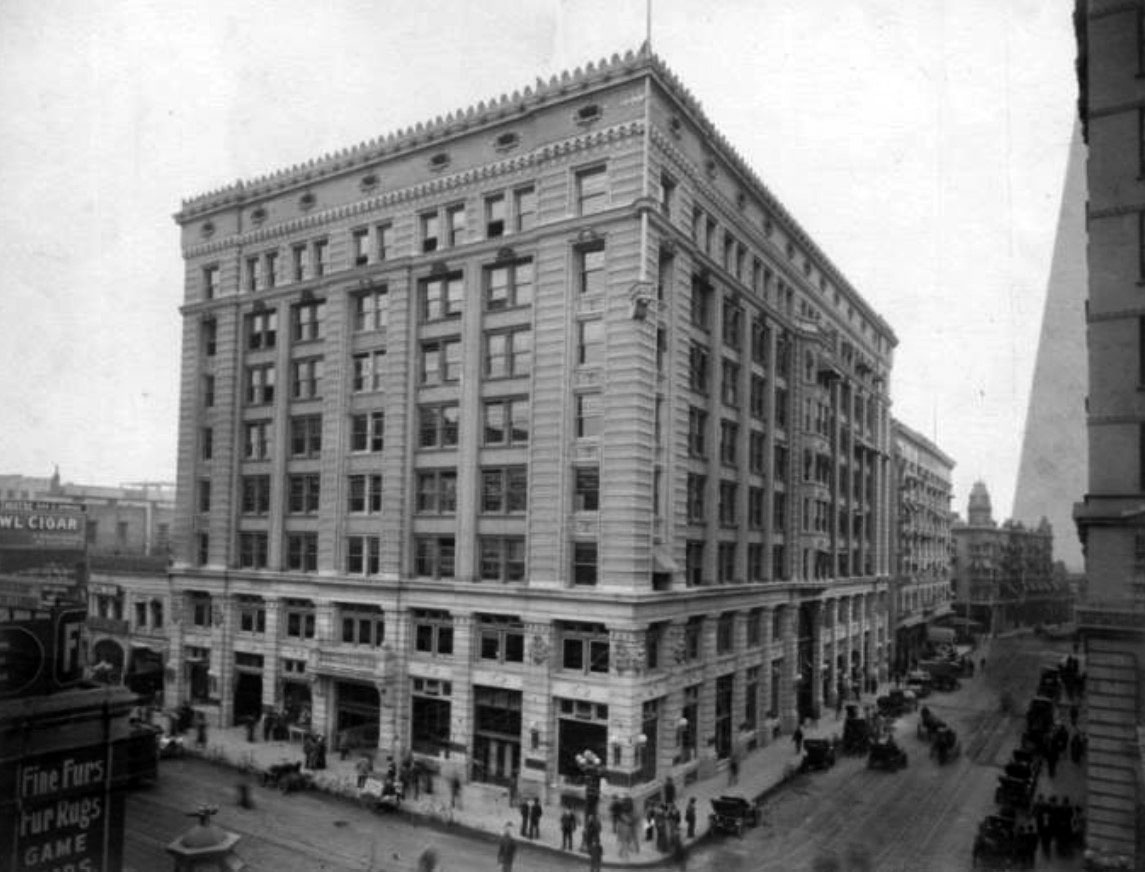 |
|
| (ca. 1906)^ – View showing the 8-story Hellman Building located on the NE corner of Spring and 4th streets as seen from the Angelus Hotel. In the distance, on the right, can be seen the Westminster Hotel (N/E corner of Main and 4th). |
Historical Notes The Hellman Building still stands today. In 2002 it was dedicated Los Angeles Historic-Cultural Monument No. 729. |
* * * * * |
Main and 4th Streets
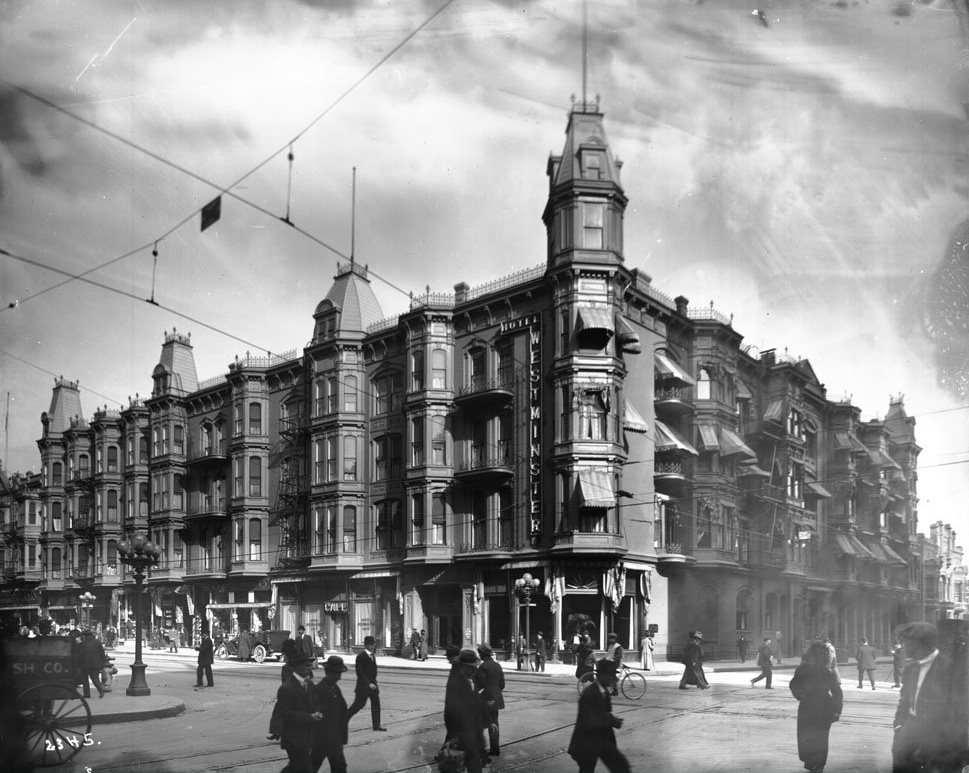 |
|
| (ca. 1900)* - People near and far walk across 4th and Main Street past the majestic Westminster (architect, Robert B. Young). Included also are a bicycle, a car and a horse-drawn cart. |
Historical Notes The Westminster Hotel was a large Victorian brick building with a six-story tower. It was designed in 1887 by Robert B. Young and was considered the grandest hotel in the city. In about 1870, this area was the site of a Chinese market. By the mid-1930s the hotel was in decline. It, however, continued to operate until 1960 when the building was razed to make room for new development. Click HERE to see more Early Views of 4th and Main Street (1890s) |
* * * * * |
Olive and 6th Streets
 |
|
| (ca. 1900)^ - View of 6th Street looking west from Olive St. Pedestrians and horse-drawn vehicles are seen, and men are doing road work. A druggist is at left, and at right is Fontella Cigar Store, above which are Park View Apartments. Glengarry is a building further down the street, past several small shops. |
Then and Now
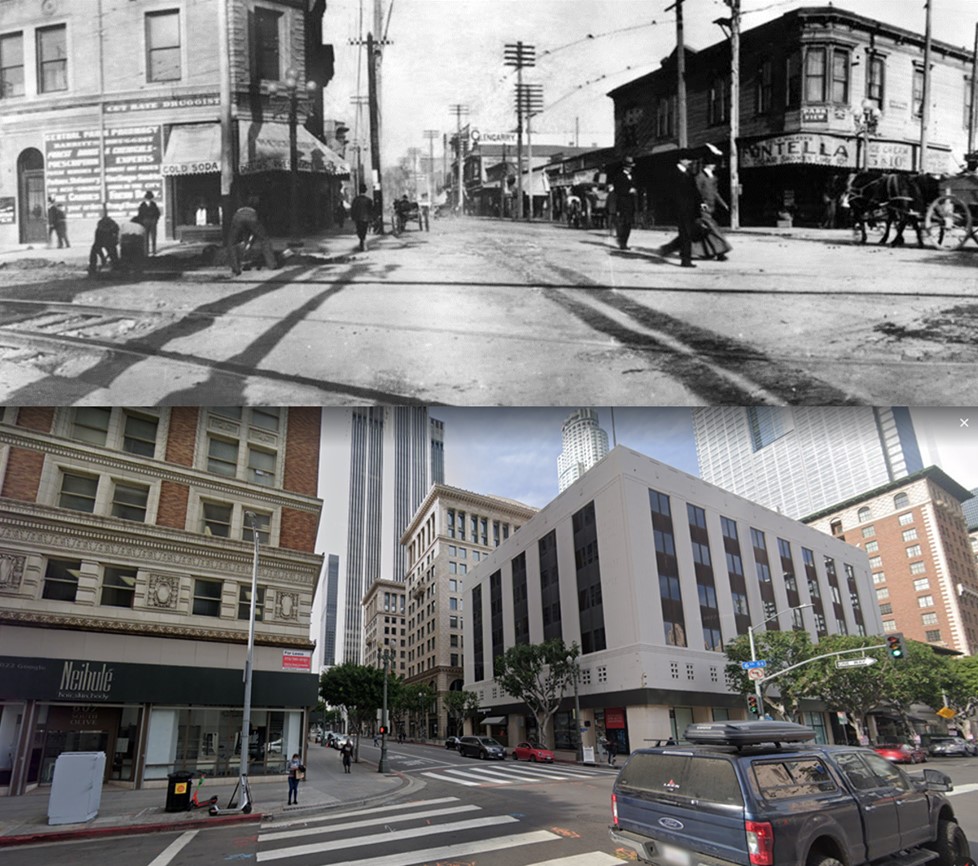 |
|
| (1900 vs. 2022)* - Looking West on 6th Street at Olive Street. |
* * * * * |
Spring and 2nd Streets
 |
|
| (1888)* – Looking north on Spring Street toward 2nd Street showing horse-drawn wagons and a street car in front of the Hollenbeck Hotel left and the Bryson-Bonebrake Block on the NW corner. |
Historical Notes This intersection was at the heart of Los Angeles' expanding central business district. The period between 1888 and 1900 was pivotal in shaping Spring Street's future as a financial center, as key structures like the Bryson-Bonebrake Block and the California Bank Building were constructed, reflecting the growing economic importance of the area. By the early 1900s, the city center began spreading south, with banks and financial institutions concentrating along South Spring Street. This shift laid the groundwork for the area to eventually earn the nickname 'Wall Street of the West,' a title solidified in the decades following 1900. |
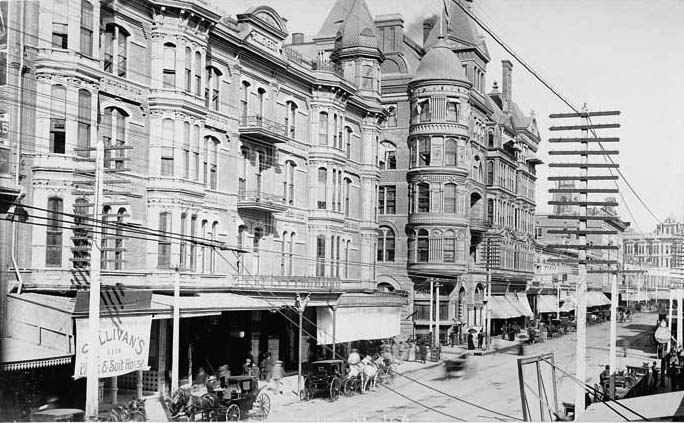 |
|
| (1890)^ - View of Spring at 2nd Street looking north. The Hollenbeck Hotel is seen on the left and the Bryson-Bonebrake Block is on the right. Horse-drawn carriages are parked in front of the hotel. |
Historical Notes Two highly influential figures in 1880s Los Angeles, John Bryson, Sr., the 19th mayor, of LA and Major George H. Bonebrake, President of the Los Angeles National Bank and the State Loan and Trust Company, commissioned Joseph Cather Newsom to erect this 126-room bank and office building. It's cost was projected to be $224,000, a staggering sum at the time. Bonebrake was one of the richest men in the city at the time, and he could afford making such an investment. He located the main headquarters of his bank in the Bryson-Bonebrake Blocks. |
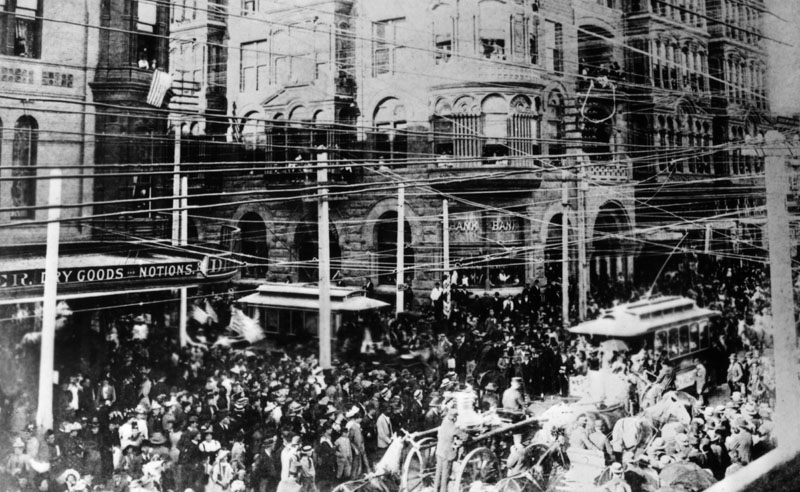 |
|
| (1892)* - A Columbus Day parade on October 26, 1892, on Spring and 2nd Streets. The Bryson-Bonebrake Block is on the right and the Hollenbeck Block on the left. |
Historical Notes The Columbus Day parade on October 26, 1892, in Los Angeles was a significant event that took place at the intersection of Spring and 2nd Streets. This parade was part of the nationwide celebrations marking the 400th anniversary of Christopher Columbus's arrival in the Americas. |
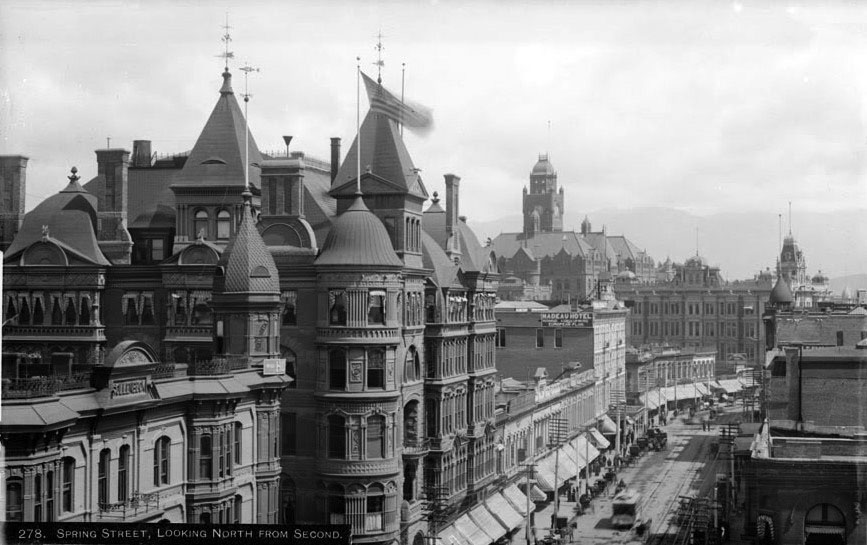 |
|
| (ca. 1895)^ - View of Spring Street looking north from Second. The Bryson-Bonebrake Block is seen on the northwest corner of Spring and Second streets. The Hollenbeck Hotel is seen across the street (left of photo). Both the LA Country Courthouse and the Phillips Block can be seen in the background. Photo by C.C. Pierce |
Historical Notes The architecture of early Los Angeles around Spring and 2nd Streets from 1895 to 1905 reflected the city's rapid growth and economic ambition. This period saw the dominance of impressive structures like the Bryson-Bonebrake Block, an eight-story Romanesque edifice completed in 1888 and expanded between 1902-1904, which housed numerous offices and banks. Across the street, the Hollenbeck Block, built in 1884, remained a significant presence with its hotel and retail spaces. The area was characterized by a mix of architectural styles, including Romanesque Revival, Second Empire, and early skyscraper designs, showcasing the city's evolving urban landscape. Buildings like the California Bank Building and the YMCA Building added to the commercial vibrancy of the neighborhood. |
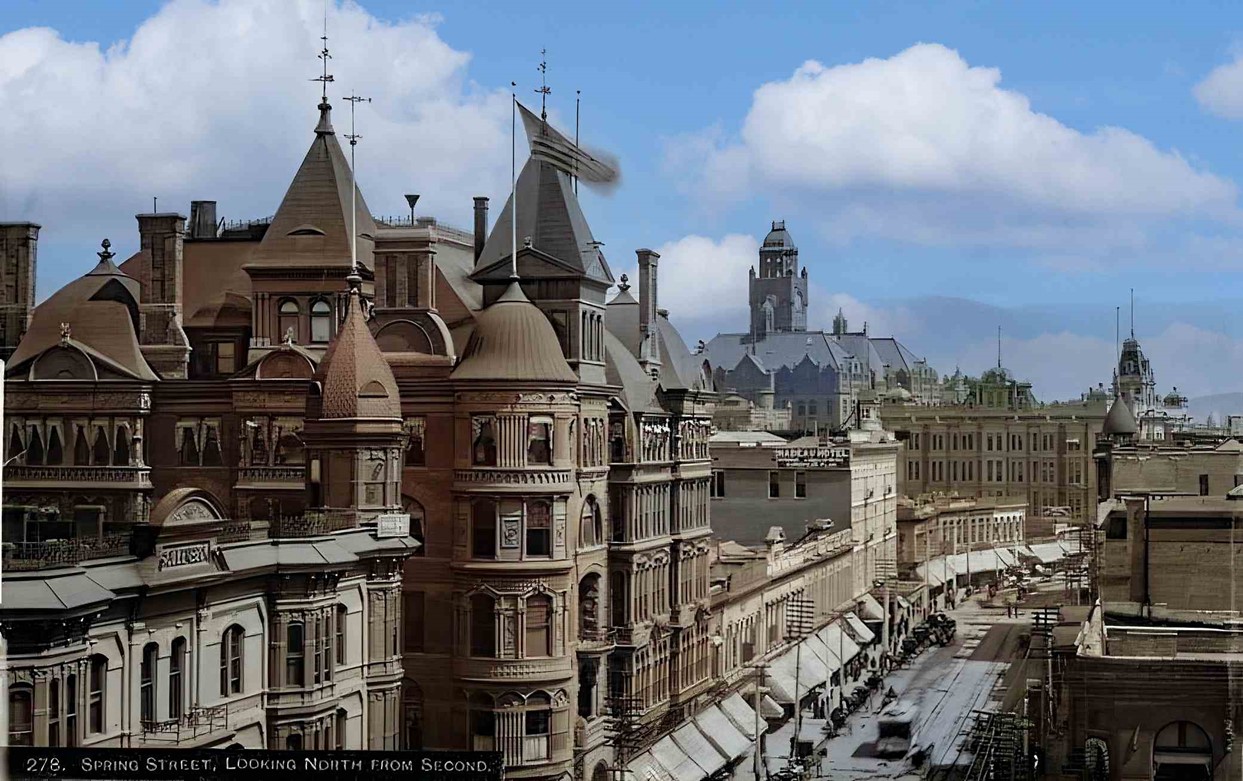 |
|
| (ca. 1895)^- View of Spring Street looking north from Second. The Bryson-Bonebrake Block is seen on the northwest corner of Spring and Second streets. The Hollenbeck Hotel is seen across the street (left of photo). Both the LA Country Courthouse and the Phillips Block can be seen in the background. Photo by C.C. Pierce, AI image enhancement and colorization by Richard Holoff |
Historical Notes The streets were lined with multi-story structures featuring ornate facades and ground-floor retail spaces, creating a dense urban fabric that bustled with pedestrians, horse-drawn carriages, and early automobiles. This intersection was rapidly becoming the heart of Los Angeles' financial district, earning the nickname "Wall Street of the West" as banks and financial institutions concentrated along South Spring Street. The grand scale and elaborate designs of these buildings symbolized Los Angeles' transition from a small town to a major urban center, setting the foundation for the city's future growth and development. The architecture of this period around Spring and 2nd Streets not only reflected the city's growing wealth but also its aspirations to become a significant metropolitan area on the West Coast. |
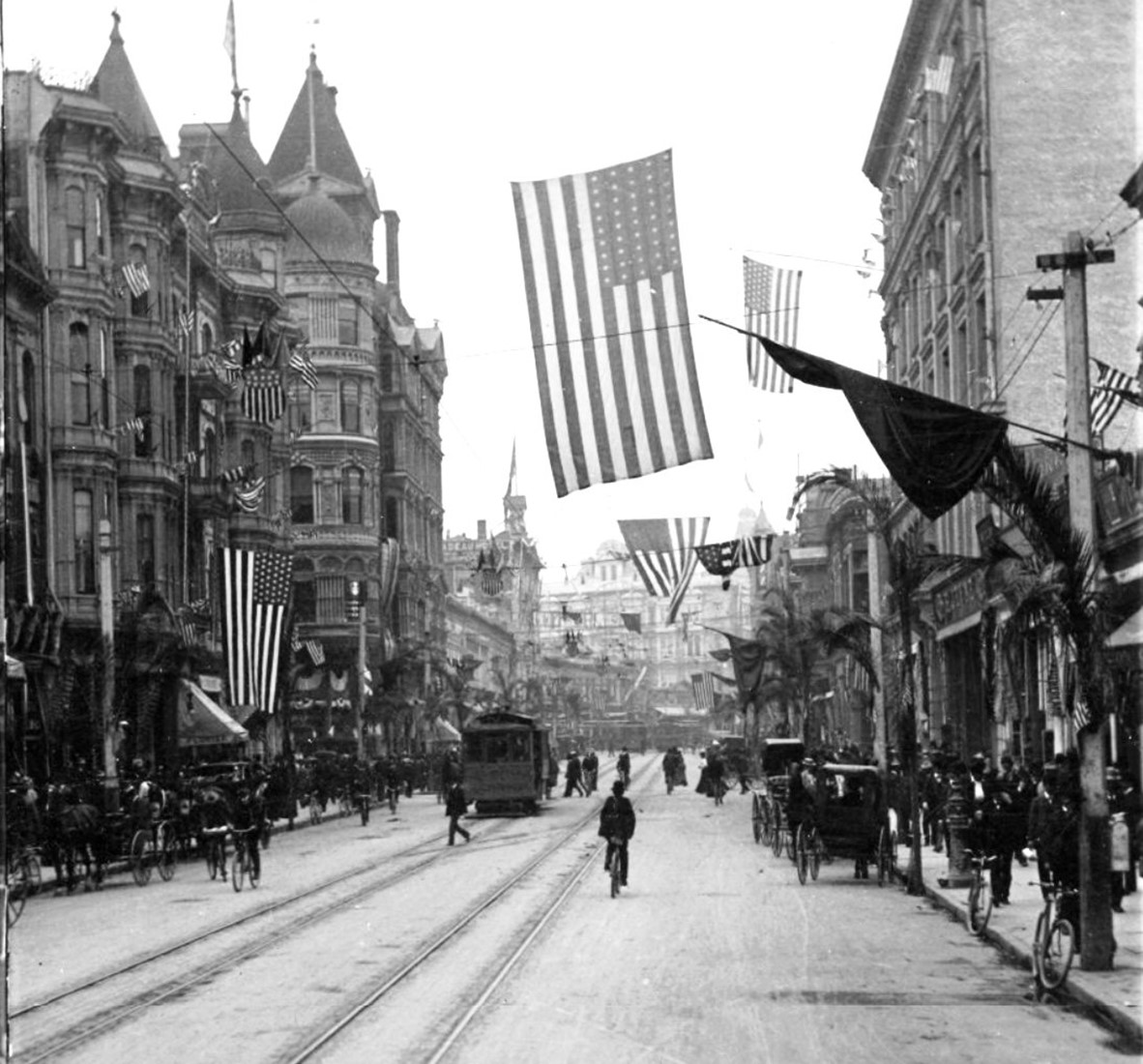 |
|
| (ca. 1900)* – View looking north on Spring Street toward 2nd Street, with the ornate Bryson-Bonebrake Block on the northwest corner and the Hollenbeck Hotel on the southwest corner. American flags drape across the street, and palm fronds adorn telephone poles as decorations. Pedestrians and bicycle riders share the street with a streetcar, while horse-drawn wagons and bicycles are parked along the curb. |
Historical Notes In 1900, horses remained the dominant mode of transportation in Los Angeles, with 8,065 horses, or about one for every 12.7 people. Horse-drawn vehicles were prevalent, while electric streetcars, operated by the Los Angeles Railway (LARy), provided popular public transport in the downtown area. The transition to automobiles began in the 1910s but was gradual; by 1920, there were 161,846 registered cars in Los Angeles County, which surged to 806,264 by 1930. |
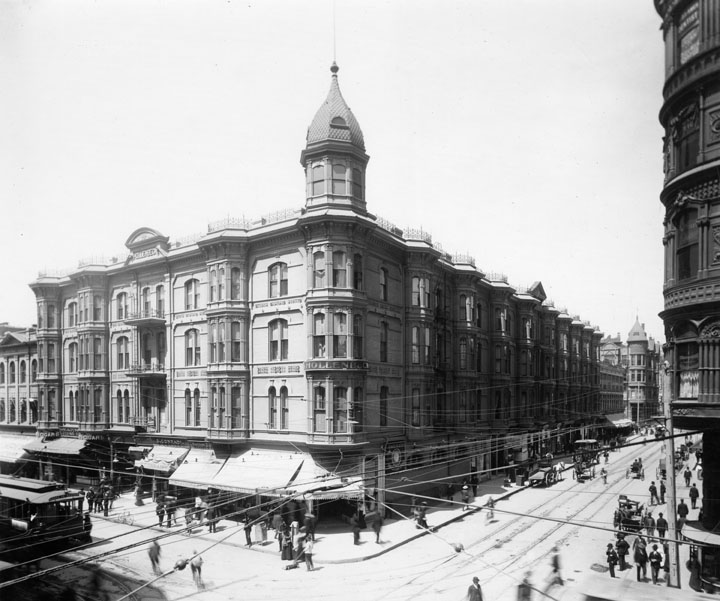 |
|
| (ca. 1900)^ - View of the intersection of Spring and Second streets. The Hollenbeck Hotel stands on the southwest corner. Across the street (right of photo) is a partial view of the Bryson-Bonebrake Block. Trolley lines cross over the intersection. |
Historical Notes The Hollenbeck Hotel was constructed in 1884 at Spring and Second streets. The hotel was named for its owner, John Hollenbeck, a prominent investor, banker, and owner of large landholdings in the Boyle Heights area. A leading hotel in its day, it was designed by Robert Young, an architect responsible for several early downtown hotels, including the Lankershim, the Lexington, and the Westminster. |
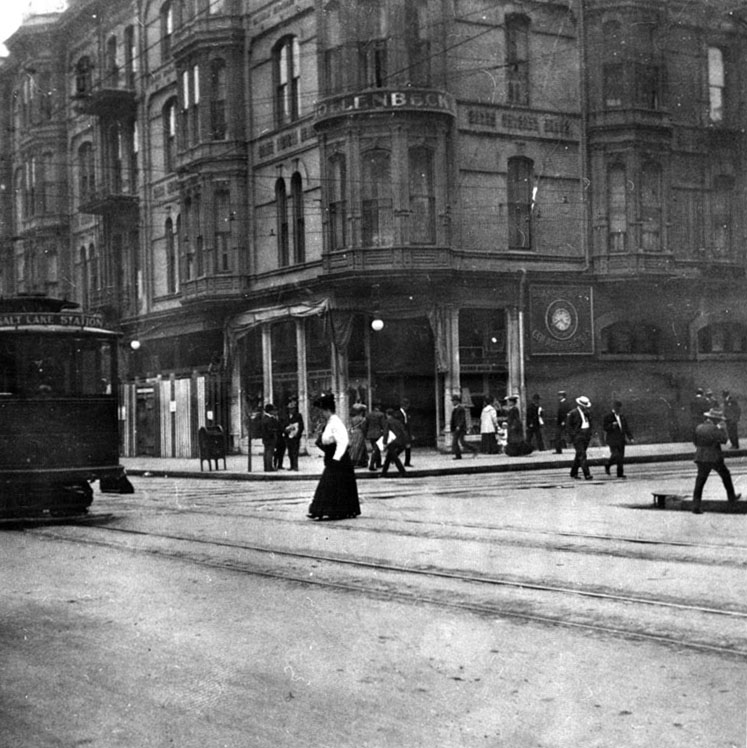 |
|
| (ca. 1900)^ - The intersection of Spring and 2nd Street, showing the Hollenbeck Block. An electric trolley car heading to the Salt Lake Station is seen. A woman appears to walking in the direction of the trolley. |
Historical Notes In downtown Los Angeles around 1900, pedestrians followed a formal dress code reflecting the era's social norms. Men typically wore suits with jackets, waistcoats, and trousers, complemented by white collared shirts and neckties or bow ties. Headwear was common, with styles like bowler hats, fedoras, and straw boaters. Women wore long dresses or skirts that reached the ankles, paired with high-necked blouses and corsets to achieve the fashionable silhouette. Their outfits were often topped with wide-brimmed hats adorned with feathers or flowers, along with gloves. The color palette leaned towards dark or muted tones. |
Then and Now
 |
|
| (1900 vs 2023)* - Looking at the SW corner of Spring and 2nd streets. Photo comparison by Jack Feldman. |
* * * * * |
Hill and 4th Street
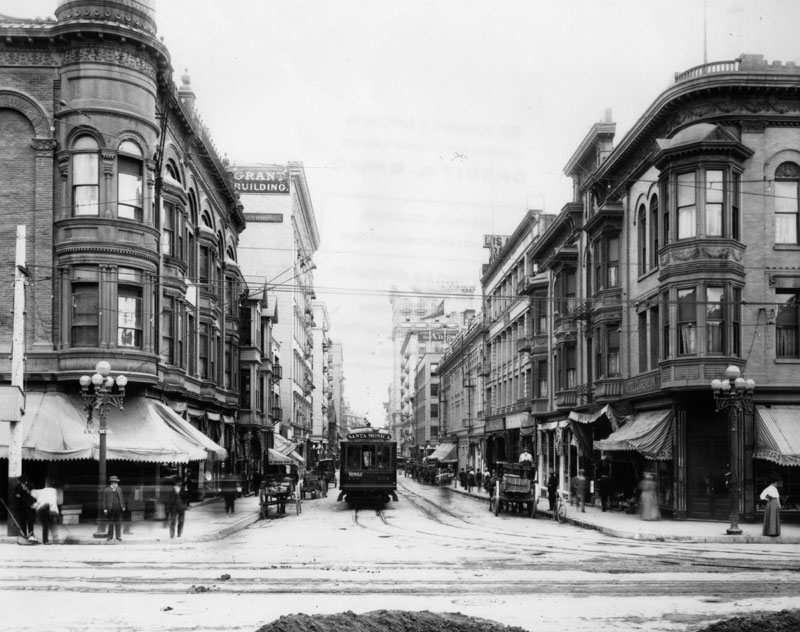 |
|
| (ca. 1900)^ - The 234 Santa Monica/Venice streetcar is running east on 4th St. in this view of commercial, downtown Los Angeles at Hill and 4th. The Hotel Brighton stands on the N/E corner (left). The Hotel Clarendon is on the southeast corner, a cigar store on the bottom floor. The Grant Building is on the center left. Deliveries are being made by horse-drawn wagons. An awning advertises ice cream sodas for 5 cents. |
Historical Notes Click HERE to see more Early Views of Hill and 4th Street. |
* * * * * |
Main Street
.jpg) |
|
| (ca. 1901)* – Street view looking north on Main Street from 6th Street. Horse-drawn wagons and streetcars share the busy street. A sign for Morosco’s Burbank Theatre is seen at right. The streetlight is decorated for possibly a parade. |
Historical Notes In 1900, the Burbank Theatre was leased to Oliver Morosco and became known as Morosco's Burbank Theatre. Morosco was later involved in the Majestic Theater on Broadway (which opened in 1908) and got a house named for himself when he opened the Morosco on Broadway (now the Globe) in 1913. |
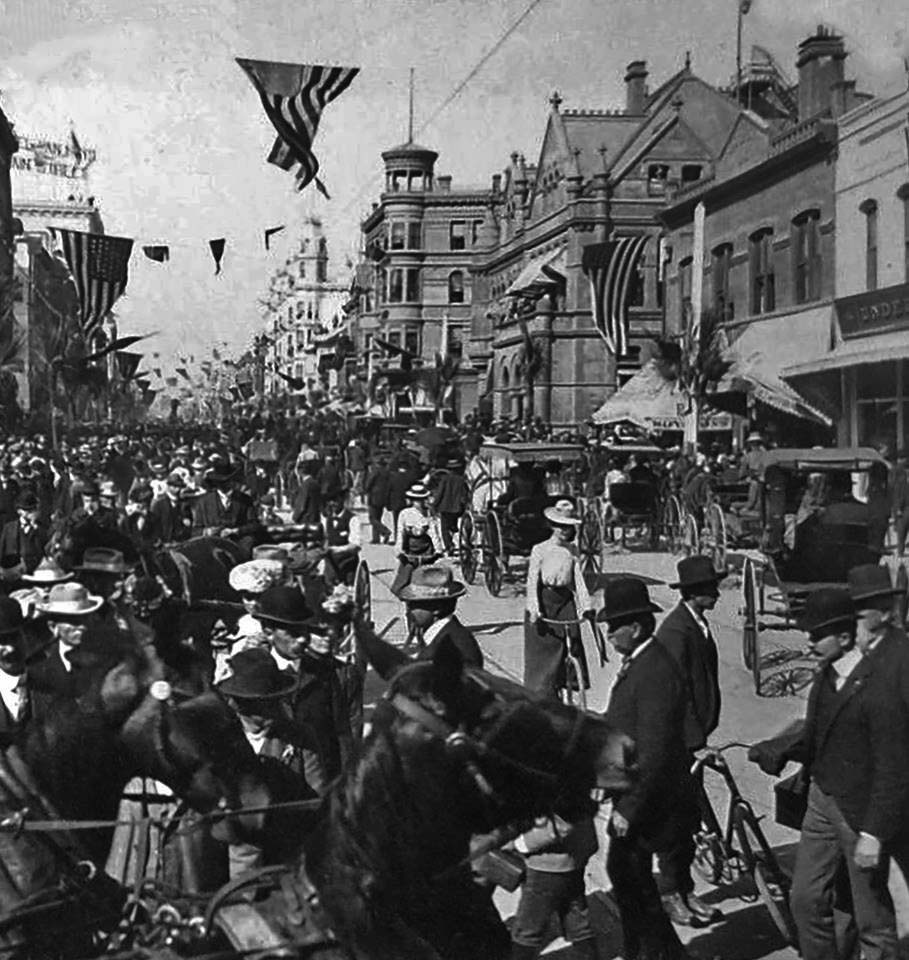 |
|
| (1901)* – View looking north on Main Street from 5th Street toward Winston Street. The large two buildings on the east side of Main Street at Winston Street are the Government Building (S/E corner) and the Main Street Savings Bank Building (N/E corner). Photo was taken on May 8, 1901, the day U.S. President William McKinley came to Los Angeles. Horse-drawn wagons, cyclists, and pedestrians share the street. |
Historical Notes President McKinley, after his second inauguration on March 4, 1901, went on a six-week tour of the United States. Traveling by train, McKinley arrived in Los Angeles on May 8. On May 10, McKinley’s train headed north with stops in Ventura, Santa Barbara and San Luis Obispo. |
* * * * * |
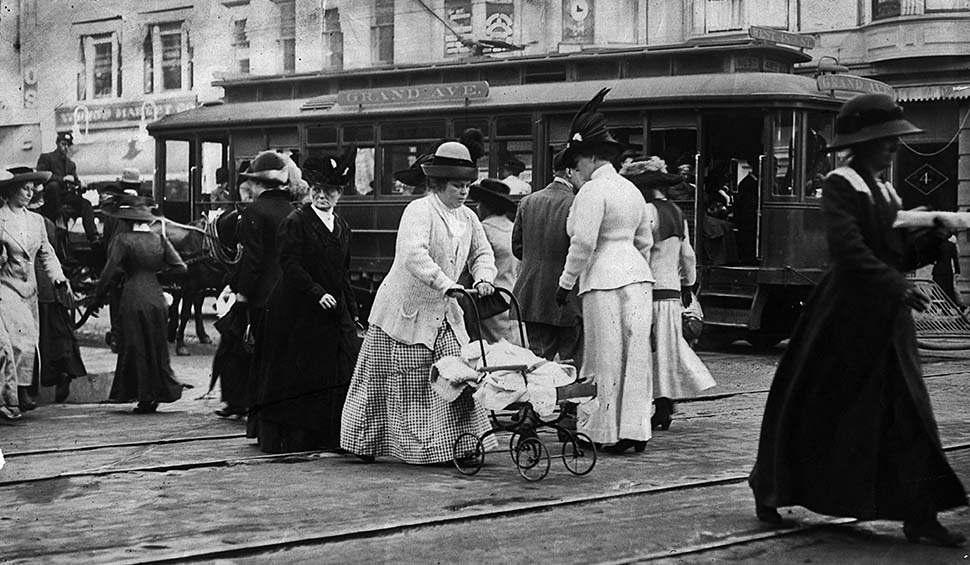 |
|
| (ca. 1900)*- Fashionable women walk in front of a Grand Avenue trolley car. |
Historical Notes This photo was published in the Jan. 3, 1950, Los Angeles Times Mid-Winter Edition as part of a photographic history of Los Angeles. The accompanied headline announced, “Century’s Early Years Brought Trolleys, Traffic and (Ah!) Fashion.” |
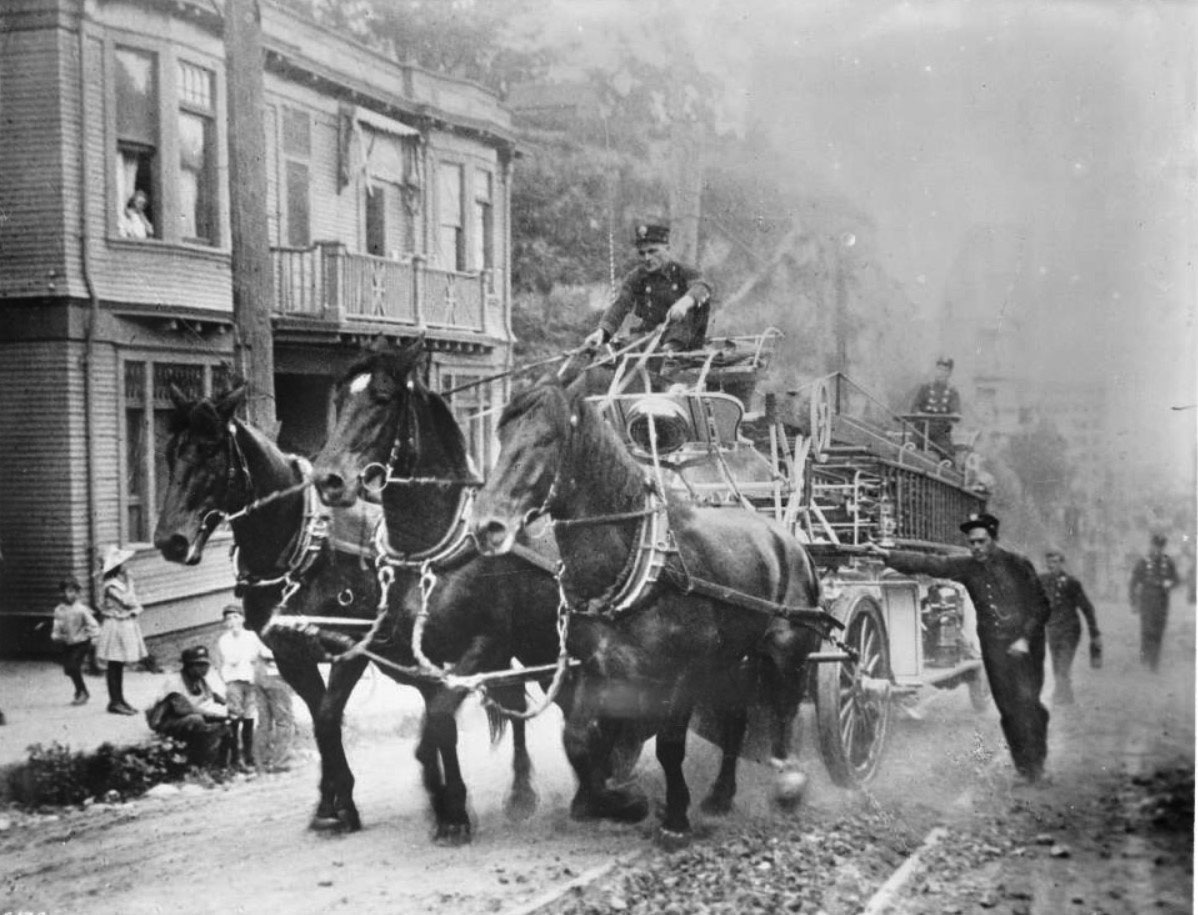 |
|
| (ca.1900)^ - View showing an early fire engine pulled by large muscular horses, up a hill on First Street. Several firefighters help push the fire engine as it makes its way up the hill. The horses kick up a lot of dirt and dust as it pulls the long fire engine. On the fire engine, there is one driver who steers the horses in the front of the engine, and there is one driver in the rear who appears to be holding onto a steering wheel. A large shiny bell is mounted on the engine in front of the firefighter steering the horses. A large ladder, attached to the fire engine, can be seen along the body of the vehicle. The dirt road is littered with rocks. At left, about five children can be seen playing on the sidewalk or looking at the commotion. A woman can be seen in her window in the two-story house at left. Caption reads: "Early days with the fire companies. A hard pull up First Street hill toward a fire." |
* * * * * |
Elysian Park
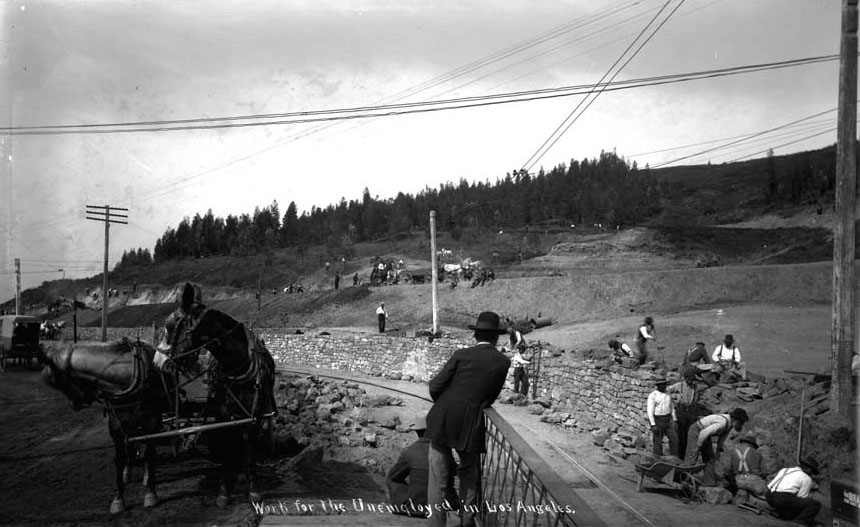 |
|
| (ca. 1895)^*# - View showing a man leaning on a rail and another man sitting in front of him as they watch workers construct a retaining wall at the newly created Elysian Park. Title on photograph reads "Work for the Unemployed in Los Angeles". |
Historical Notes Elysian Park is the city's oldest public park and, at 575-acres, the second largest after Griffith Park. It is home to numerous historic sites, including the Los Angeles Police Academy and Barlow Hospital, that are linked by miles of walking trails. In 1769, Gaspar de Portola and Father Juan Crespi camped on the river bank opposite Buena Vista Hill near the North Broadway Bridge entrance to Elysian Park. Yang-Na Indian villagers from the creeks of Solano Canyon and the current location of the Los Angeles Police Academy greeted the Spaniards with native refreshments. In 1781, the Pueblo of Los Angeles was officially established by Spanish California Governor Felipe de Neve with the Royal Grant of 4 square Spanish leagues (translated into 28 square miles or about 17,000 acres) of Pueblo Lands. Of this public land grant, the approximately 575-acre Elysian Park is the last remaining large piece. All else has been auctioned off or given away. Los Angeles even had to buy back the site of the present City Hall. One of the first American official acts was the Ord Survey of 1849 to record the boundaries of these Pueblo Lands so they could be auctioned to produce city revenue. Elysian Park was then known as Rock Quarry Hills for the building stone mined in the area. But instead of being sold, the Rock Quarry Hills area were "reserved" for public purpose and withdrawn from public auction.**^ |
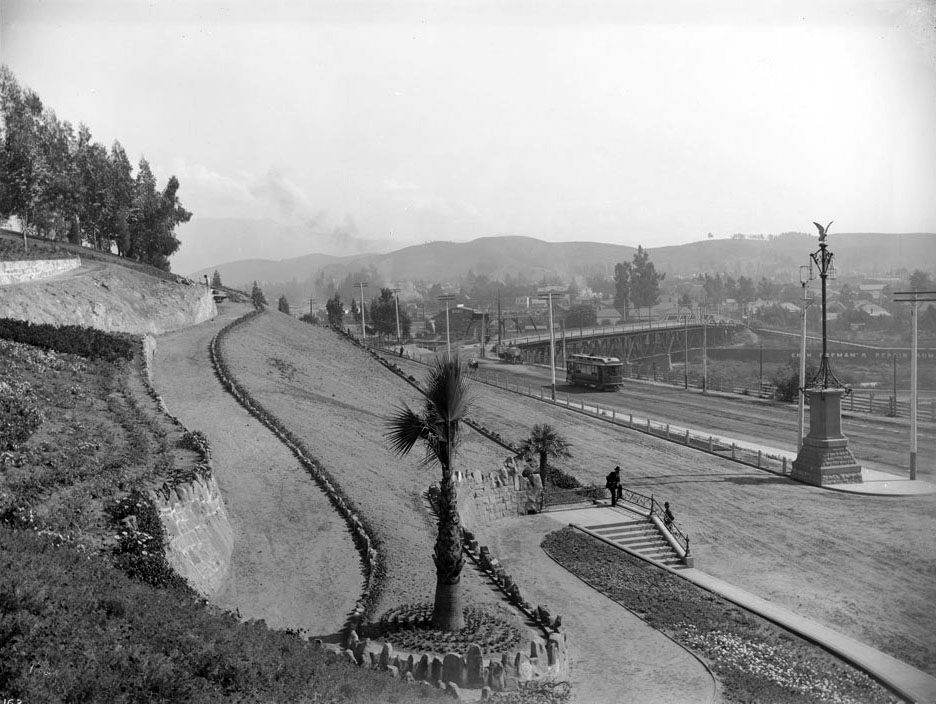 |
|
| (ca. 1900)* - Photograph of the North Broadway entrance to Elysian Park. Here we have a panoramic view of Elysian Park hillside with an electric car approaching. A palm tree is planted in the elbow of a path as it curves up into the park. A man is standing at the railing of a landing of steps. Two other men are further into the park itself. Nearby is a decorative lamp post topped with a bird. Visible in the background are the Buena Vista Street bridge and several horse-drawn vehicles. Photo by C.C. Pierce |
Historical Notes In 1886, the Mayor and City Council of Los Angeles dedicated the Rock Quarry Hills as a city park forever, and renamed it Elysian Park (Elysian is derived from the Greek word paradise). Subsequent city charters have protected dedicated park lands and their use for park purposes in perpetuity.**^ |
 |
|
| (ca. 1900)* - North Broadway entrance to Elysian Park with Buena Vista Street bridge seen in the background as it crosses the Los Angeles River. Elysian Park is the City’s oldest park, established in 1886. Photo by C.C. Pierce; AI image enhancement and colorization by Richard Holoff |
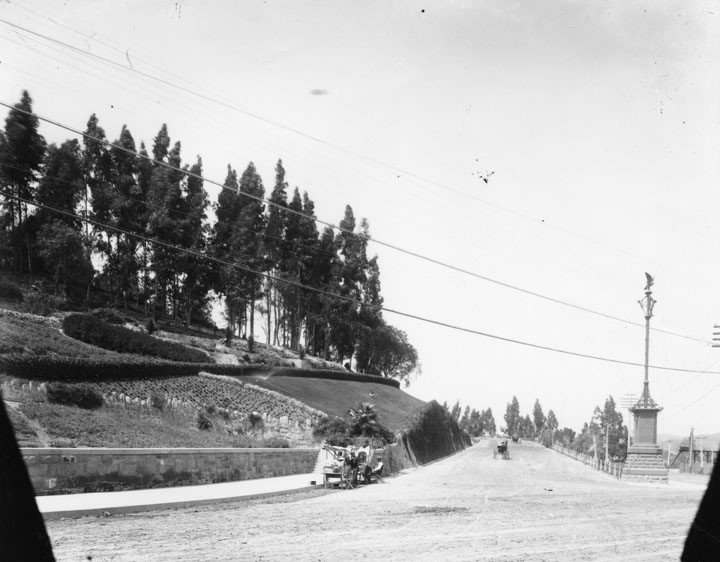 |
|
| (ca. 1900)^ - A small stand with three men sets beside the road just before the Fremont entrance to Elysian Park. The hill on their left is landscaped with shrubs and flowers, and 2 horses & carriages are on the road into the park. |
Historical Notes After beautification, improved access was a top priority. The extension of Buena Vista Street to the park's Fremont Gate entrance brought the park within a short carriage ride of the central city, and in 1893 a former burro trail became a trans-park road. Further improvements in 1896 -- funded by a $20,000 subscription drive and performed by an army of unemployed workers -- laced the park with footpaths and added basic facilities like restrooms.**# |
 |
|
| (ca. 1909)^*# – View showing a man and woman walking down the stairs at the entrance to Elysian Park. |
Historical Notes The park became even more colorful in 1893, when the Los Angeles Horticultural Society created the City Arboretum in Chavez Ravine. A haphazard planting of rare trees from around the world, the arboretum transformed Elysian Park's western canyon into an exotic forest. Some of the arboretum's trees, still growing today, remain the only representatives of their species in Los Angeles.. |
* * * * * |
Avenue of the Palms
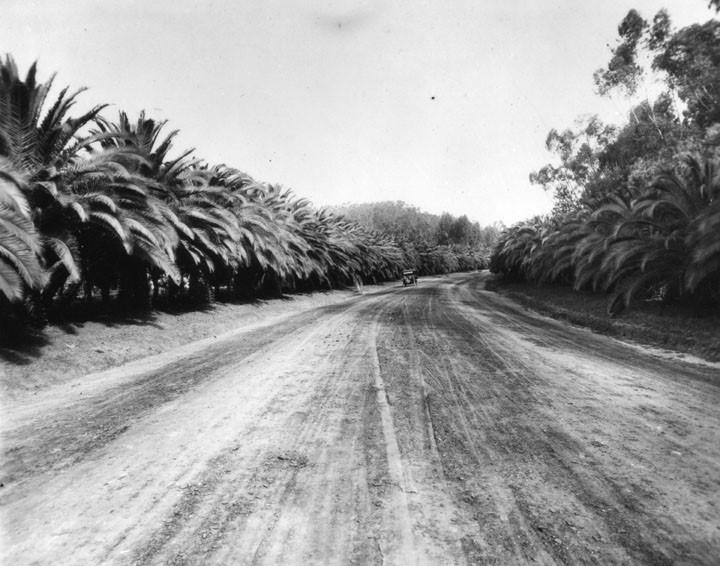 |
|
| (ca. 1920s)* - The Avenue of the Palms: Looking down the road, palm trees only a few feet apart line both sides of a wide dirt road in Elysian Park. A single car is coming toward the camera. |
Historical Notes Around 1895, Elysian Park saw one of its most recognizable tree plantings with the creation of the Avenue of the Palms, a row of Canary Island date palms along present-day Stadium Way. |
 |
|
| (1937)* – Avenue of the Palms in Elysian Park. Looking down the road, palm trees only a few feet apart line both sides. A single car is parked on the left. |
Historical Notes The Avenue of the Palms in Elysian Park is lined with Canary Island date palms (Phoenix canariensis). These palms were planted sometime between 1895 and 1900 as a gift from a foreign country. The Canary Island date palm is easily distinguishable from other palm species due to its stouter trunk and round proliferation of feather-shaped leaves. |
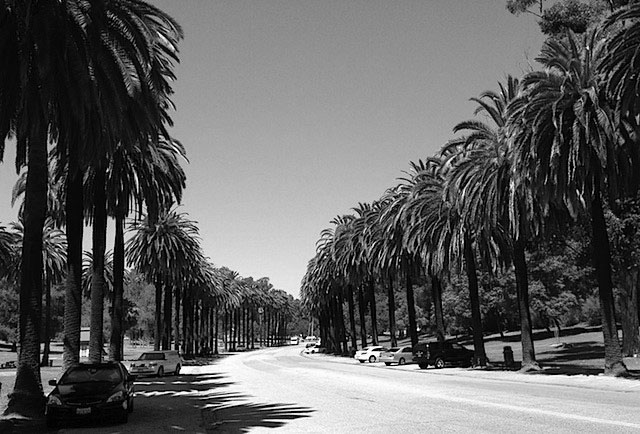 |
|
| (2013)* - View showing Avenue of the Palms, a section of Stadium Way, as it appears today. The palm trees are over 120 years old! |
Historical Notes A fatal fungus – Fusarium wilt – that has killed off Canary Island palms from Spain to Santa Monica has also spread to the Elysian Park trees. Faced with the prospect of a forest of dead palm trees, the Citizens Committee to Save Elysian Park, a nonprofit park support group, came up with a proposal to plant disease-resistant palms. The new palms and irrigation system were paid for with a fund earmarked for Elysian Park improvements. As of May, 2014, Elysian Park has been planted with a grove of more than 100 knee-high palm trees that will one day replace the majestic Canary Island Date Palms that are slowly dying from a fatal tree fungus. The new trees – Chilean Wine Palms, Jubaea chilensis – were planted in between the century-old palms that have risen about 50 feet high along the Avenue of the Palms. |
Then and Now
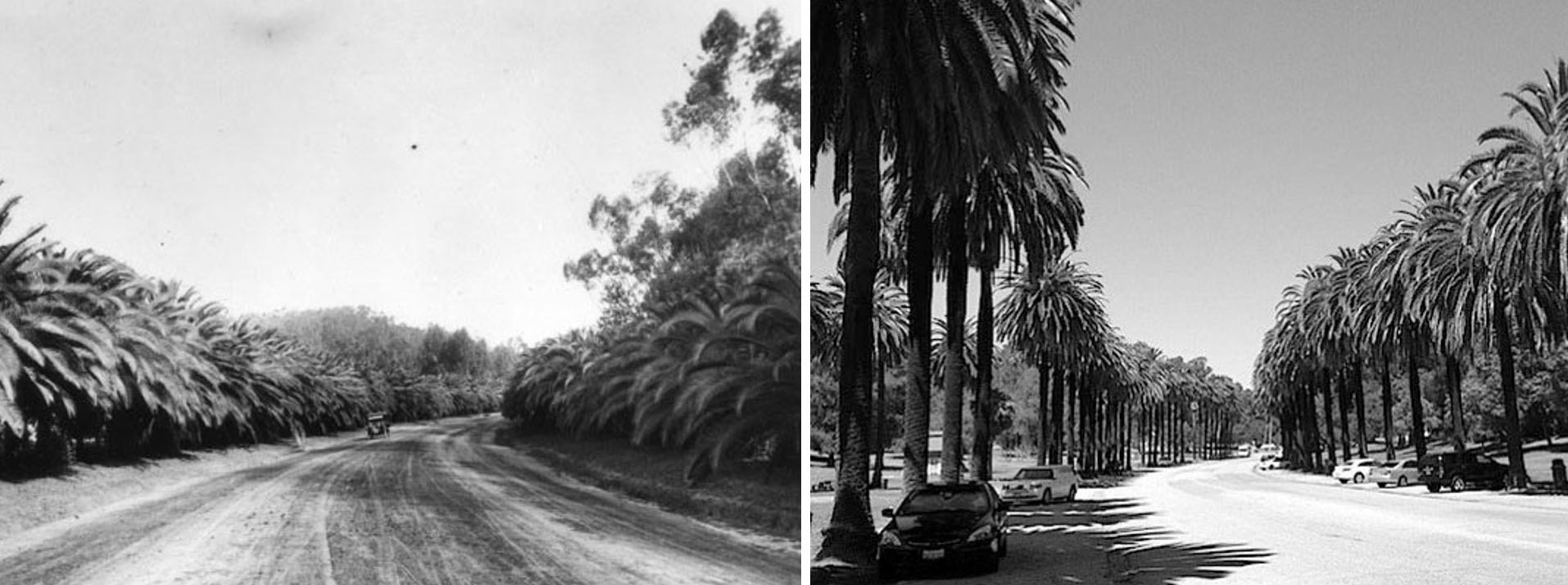 |
|
| (1920s vs. 2013) – Avenue of the Palms in Elysian Park. Photo comparison by Jack Feldman. |
Then and Now
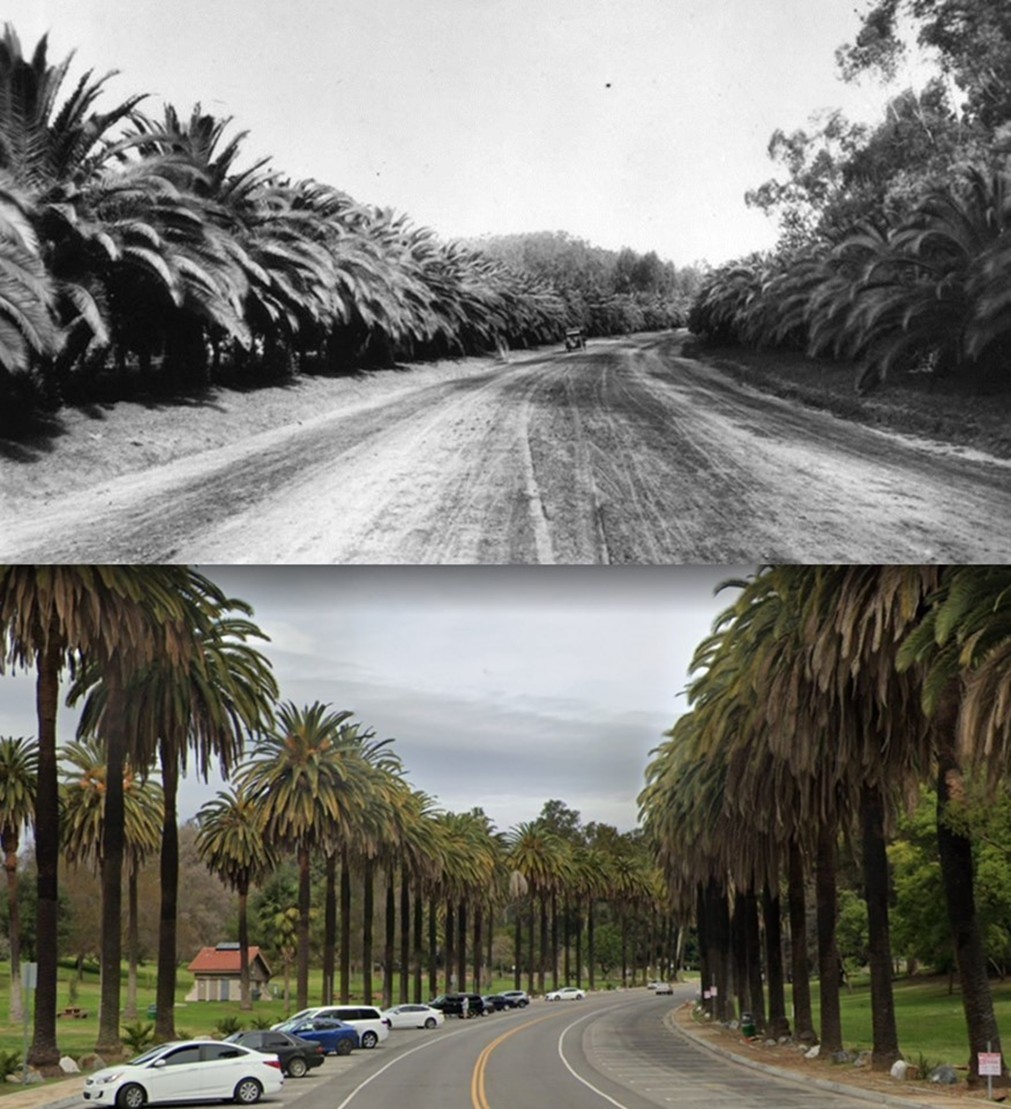 |
|
| (1920 vs. 2021)* - Avenue of the Palms - a section of Stadium Way. Note the new Chilean Wine Palms planted in-between the century old original palms. Photo comparison by Jack Feldman. |
* * * * * |
Echo Park & Echo Park Lake
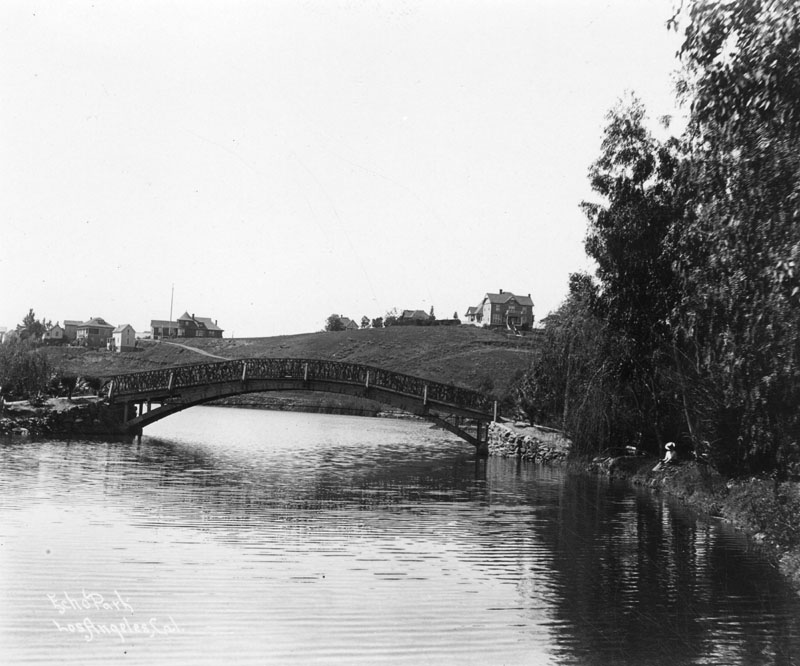 |
|
| (1900)* - Wooden bridge over Echo Park Lake as it looked at the turn of the century. Note the homes on the hillside behind the bridge and the woman with the hat relaxing alongside the lake. |
Historical Notes Echo Park Lake didn’t start out as a man-made lake. Instead, its earliest use by the city was as a reservoir, storing water in a section sometimes known as the city’s “West End.” In those years this area was thought of as the city’s west side.^ |
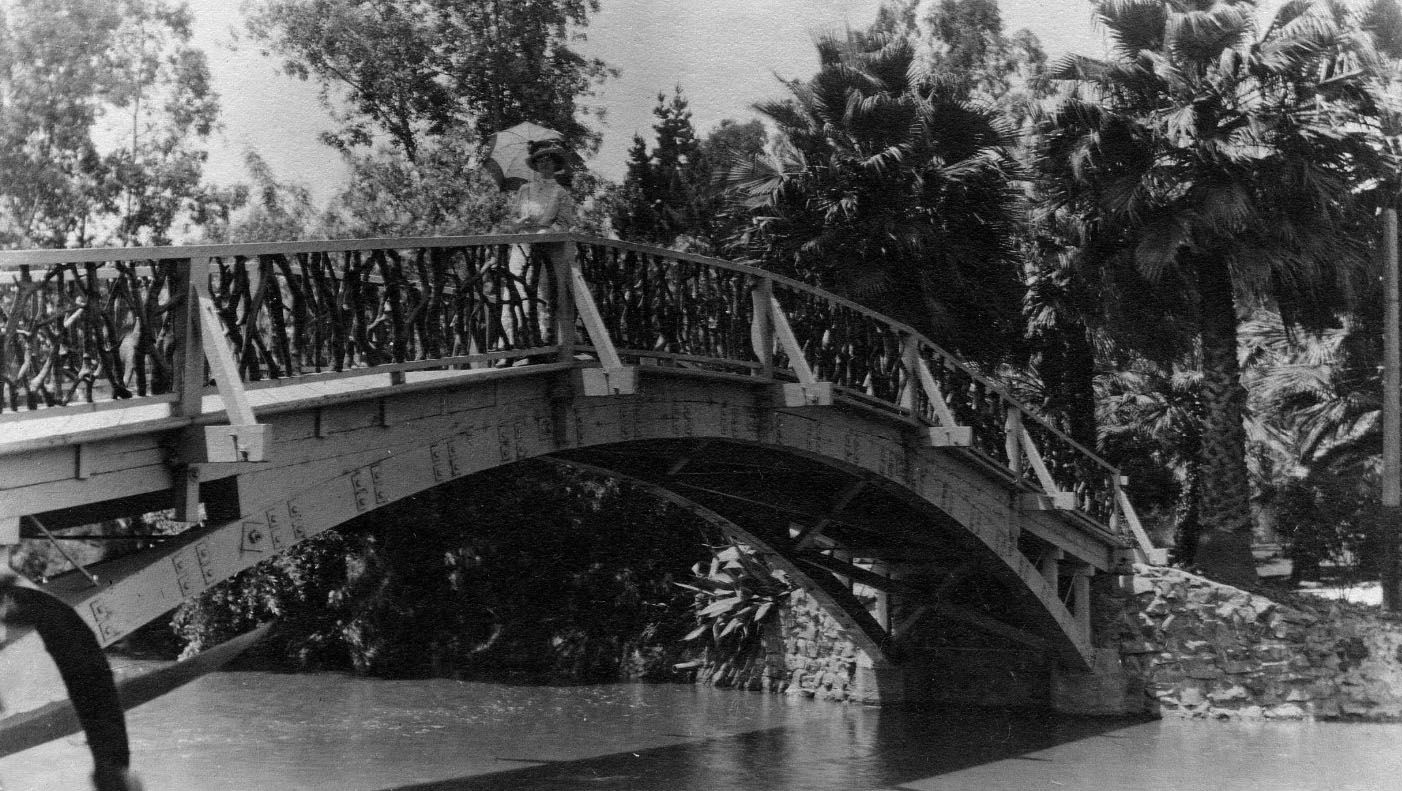 |
|
| (ca. 1910)^.^ – View showing a woman (Grace McCarthy) with a parasol standing on a bridge at Echo Park Lake. William M. McCarthy Photograph Collection |
Historical Notes Designed in the rustic style, one of the lake's two bridges (seen above) helped pedestrians reach an island, while a second bridge passed over the lake’s northwest corner, where a ditch delivered water from the Los Angeles River (and lotus now grow). |
 |
|
| (ca. 1900)^ - View of a woman seated on a bench by Echo Park. Behind her can be seen two men standing by their bicycles on an ornate bridge which passed over the lake’s northwest corner where lotus now grow. This is where a ditch emptied LA River water into the lake |
Historical Notes The Los Angeles Canal and Reservoir Co. formed Reservoir No. 4 in 1868. The company obtained the water by digging a ditch that sent water flowing from the Los Angeles River – in the area now known as Los Feliz – along a zigzag path that merged with the Arroyo de los Reyes and then emptied into the reservoir.* The Arroyo de los Reyes originates near the Catholic school on Glendale Boulevard – right by the 2 off-ramp. It flowed southward, along Glendale Boulevard, occupied the area now taken by Echo Park Lake, and continued down to 2nd Street, then crossing through downtown LA, about a block or two south of Pershing Square, where it spread and created a big muddy mess. These flows eventually connected with the Los Angeles River, when they didn’t seep into the ground first.^ Click HERE to see more Early LA Water Reservoirs. |
 |
|
| (ca. 1900)^.^ – Several boys are seen fishing off a wooden bridge over lake at Echo Park. |
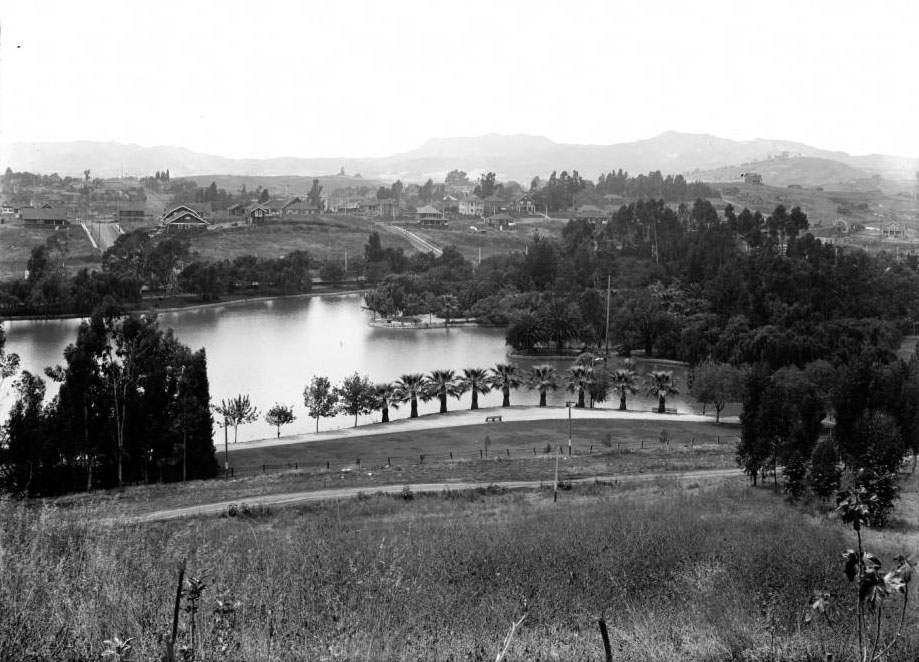 |
|
| (1911)^^ - View of Echo Park Lake looking northwest towards the Hollywood Hills. |
Historical Notes In the late 1880s, a carriage maker turned real estate developer, by the name of Thomas Kelley, teamed up with other investors to purchase about 70 acres that included Reservoir No. 4—what is now Echo Park Lake. Kelley and his business partners sold off pieces of what they called the Montana Tract to individuals who built the business district along Sunset Boulevard and the densely packed homes and apartments that surround Echo Park Lake. In 1891, city leaders struck a deal with the men who owned the land around the reservoir. Kelley and his associates – including William LeMoyne Wills, who like Kelley, would later serve on the school board – gave up 33 acres of land around the reservoir so that it could be used as a park. In exchange, the city agreed not to overflow the reservoir land, making the remaining land held by Kelley and his associates – including the street that would soon become Sunset Boulevard – far more valuable. Click HERE to see more on the Grand Opening of Sunset Boulevard. By 1920, many of the hills surrounding the lake were still untouched. Farm houses lined the northern edge of the lake, while four-unit, Craftsman-style apartment flats ran up Echo Park Avenue and Alvarado Street. Kelley died in 1906, the same year he built a house for his sister at 1467 Echo Park Ave. Within a few years, Kelley’s heirs had sold off much of his land to Henry Christian Jensen, who built the Sunset Pharmacy at Sunset and Echo Park, the motion picture house known as the Globe Theater – now Guadalupana – at 1624 Sunset Boulevard, and the Jensen's Recreation Center at Sunset and Logan Street. * Click HERE to see more Early Views of Echo Park (1890s). |
Then and Now
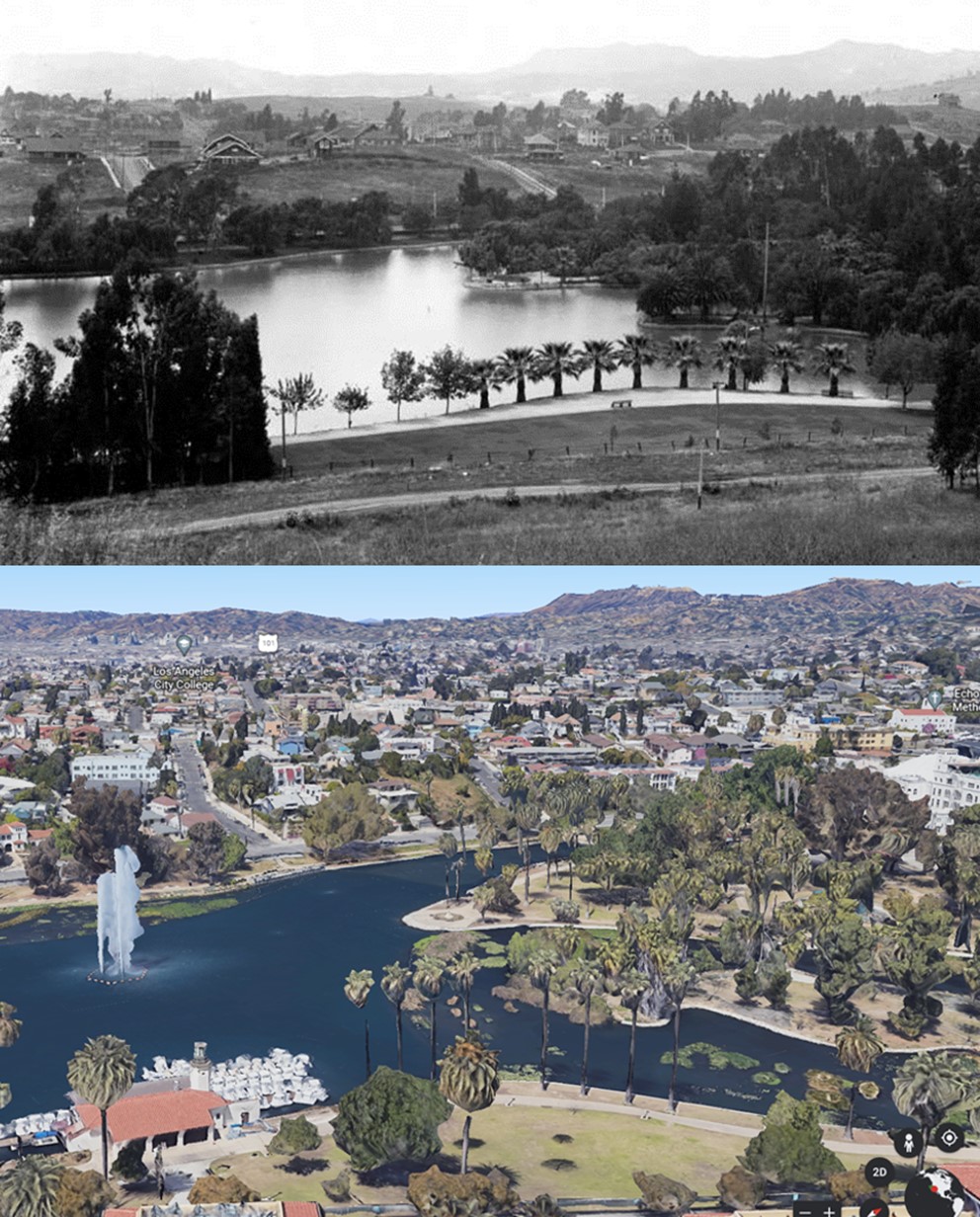 |
|
| 1911 vs. 2022 - Echo Park Lake with the Hollywood Hills in the distance. Photo comparison by Jack Feldman. |
* * * * * |
Echo Park Playground
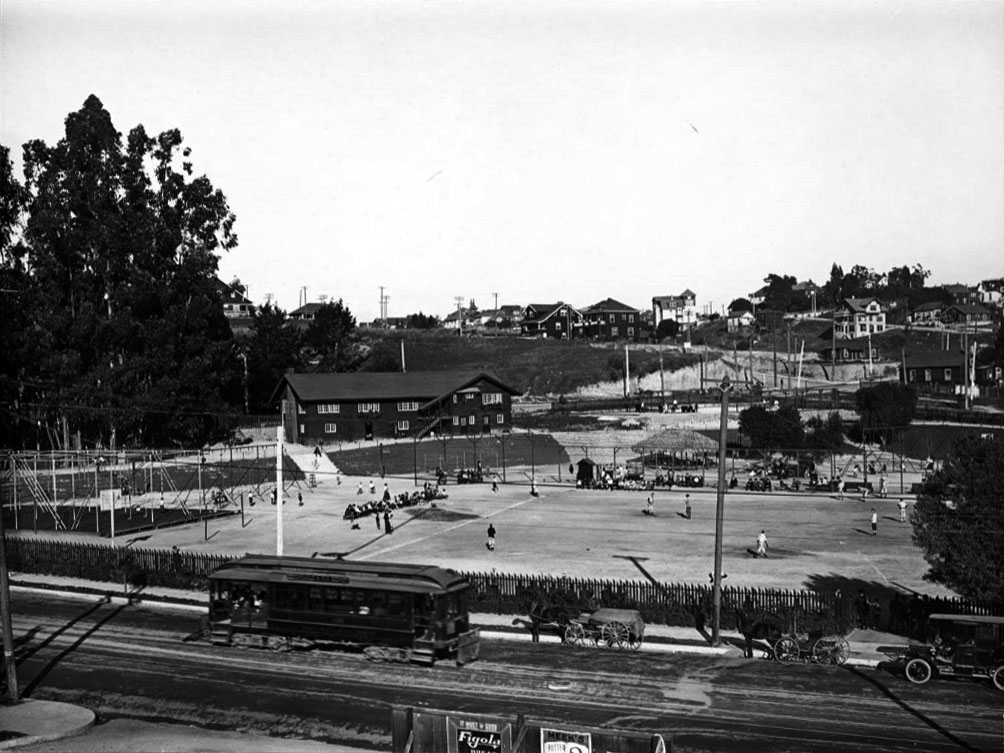 |
|
| (1909)*^ - View of the Echo Park Playground, a city playground in the Echo Park neighborhood located south of Echo Park Lake between Bellevue Avenue and Temple Street. A Pacific Electric streetcar, a horse and buggy and an automobile are all seen on Temple Street in foreground. Children play in the playground on a ball field, and large houses are seen on the hill. |
Historical Notes The Echo Park Playground opened in 1907 between Bellevue Avenue and Temple Street, and was only the second public playground to be built in the city of Los Angeles. Prior to this, this piece of land south of the lake was a muddy lot and a nuisance to the neighbors. The land was filled in and a 4-acre playground was built upon the fill. Echo Park was a relatively new district still sparsely settled when construction of the playground began. Its location, adjacent to but separate from an existing park, was a pattern that would be followed elsewhere, most notably with the Griffith Park Playground. Playground Number Two in Echo Park (seen above) remains today, although in a highly altered form with the Hollywood Freeway (101) bisecting its grounds.^ |
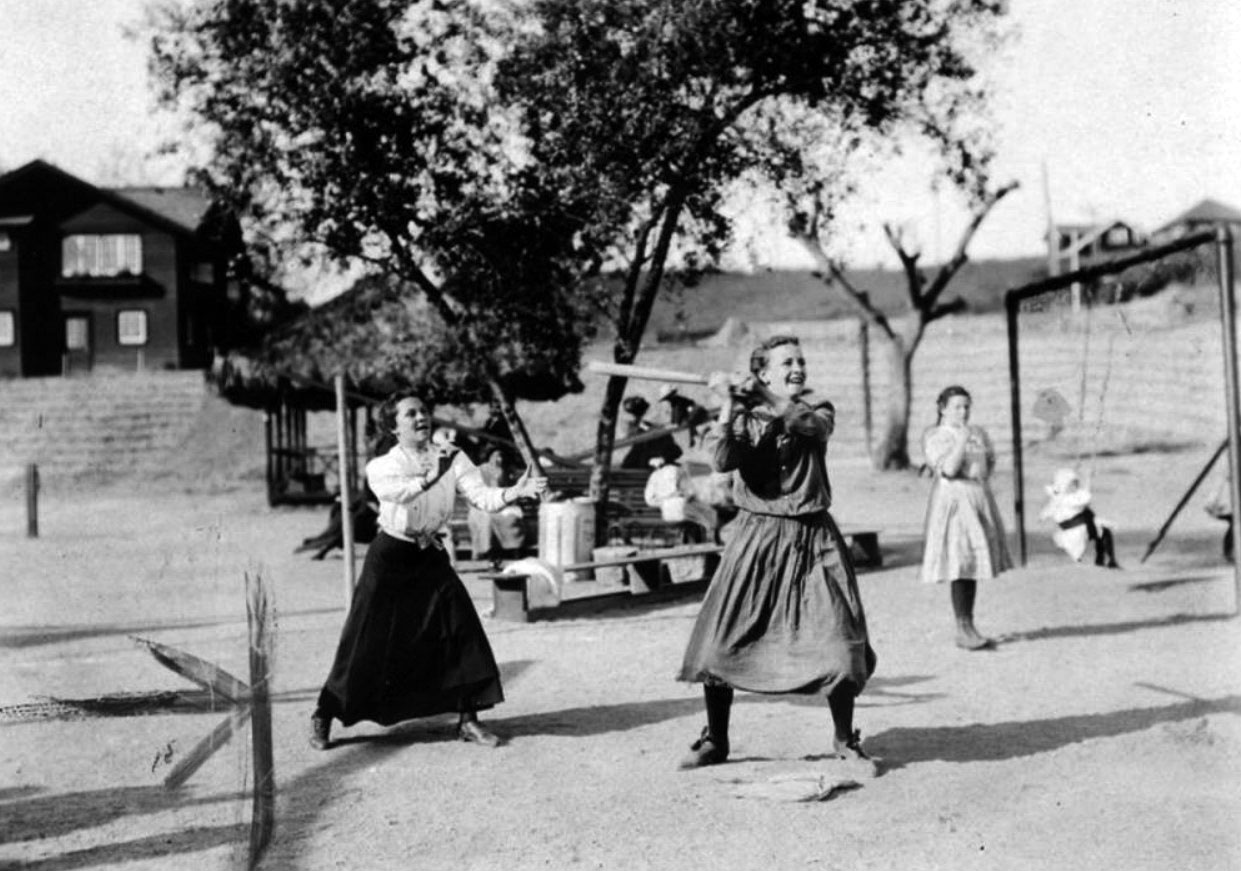 |
|
| (1907)^ - Bloomer girls enjoying a game of baseball in Echo Park Playground, the oldest existing playground in Los Angeles. The club house is the two story structure seen in upper-left. Photograph was published in 1949. |
Historical Notes Los Angeles was, in 1904, the first major city in the country to establish a separate Playground Commission. As with many of the Progressive innovations of the day, it came with support of upper- and middle-class women’s organizations. The most important advocate was Mrs. Arabella Rodman, with the backing of the Ebell Club and similar groups. The original playground plans called for a gymnasium, a club house, and a residence for the director. The club house also contained a meeting space with a raised platform. (In 1925 the club house was moved to a new location nearby and later become L.A. Historic-Cultural Monument No. 950.) Soon there followed similar playgrounds, such as the 1907 Solano Playground in Solano Canyon, the 1910 Slauson Playground in Southeast Los Angeles, and the 1911 Hazard Playground, between Boyle and Lincoln Heights. By 1924 the existing club house was considered inadequate. Echo Park residents, whose groups used its meeting space, petitioned the City Council for a new building. In June of that year the City approved the construction of a new club house and awarded the commission to the Allied Architects’ Association, a cooperative that did a good deal of the City’s work. The architects produced a design that the Playground Commission saw as the first of a series of similar structures.^ |
 |
|
| (1937)^ – View showing the new Echo Park Clubhouse with fenced in playground to protect the children. |
Historical Notes The new club house was completed in 1926 and still stands, if somewhat altered. It was described as “an attractive building” in the Spanish Colonial Revival style, and was “the first of several structures to be erected in various parts of the City.” It is constructed of brick covered in stucco and topped by a clay tile roof. Because of the sloping site, it is single story facing Bellevue Avenue and two stories in the rear. The lower level, opening to the playground, contained separate lockers and shower rooms for men and women, while the upper floor had a large meeting room, complete with stage and surrounded by supporting spaces.^ The Echo Park Clubhouse was designated Historical Cultural Monument No. 950. |
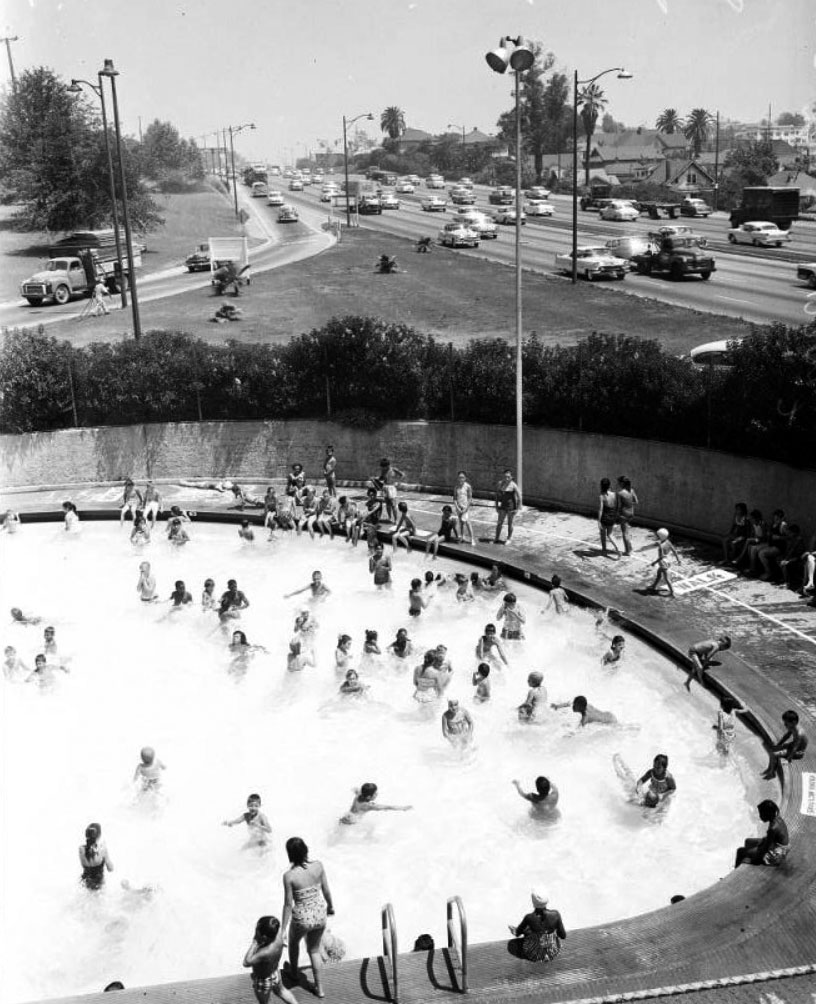 |
|
| (1958)^^ - Cars on the Hollywood Freeway speeding by the Echo Park Community Pool. The Hollywood Freeway was constructed in the early 1950s (Click HERE to see more). |
Historical Notes As with the club house, the municipal swimming pool, or plunge as it was popularly known at that time, was a playground facility that served all ages. A skate park is planned to be built (2019) where the now empty public swimming pool is located next to the 101 Freeway onramp at Echo Park and Bellevue avenues. |
* * * * * |
LA Plaza Open-Air Market
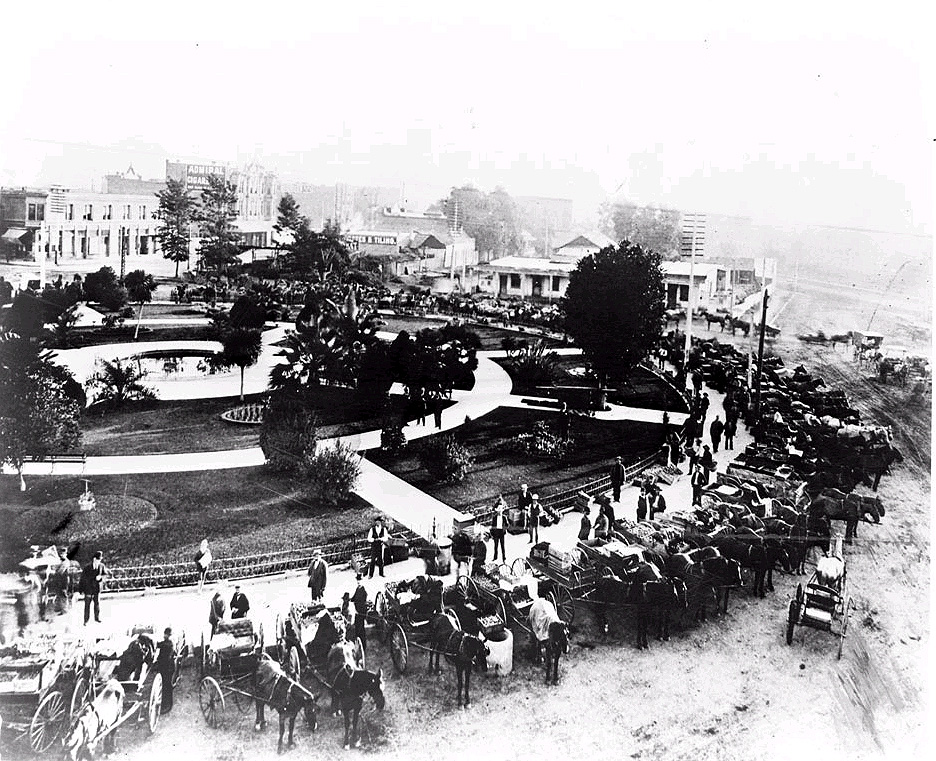 |
|
| (ca. 1900)^#^ - Open air market at the L.A. Plaza, view is looking north westerly from the Plaza Firehouse. |
Historical Notes Initially, the majority of vegetable selling in Los Angeles was done around the circular Olvera Street Plaza, just South of Macy Street, where Caucasian, Japanese and Chinese farmers congregated with their goods. However, the increased presence of wagons and the long hours of the makeshift vegetable market became a nuisance to the city. Click HERE to see more Early Views of the LA Plaza. |
Los Angeles City Market
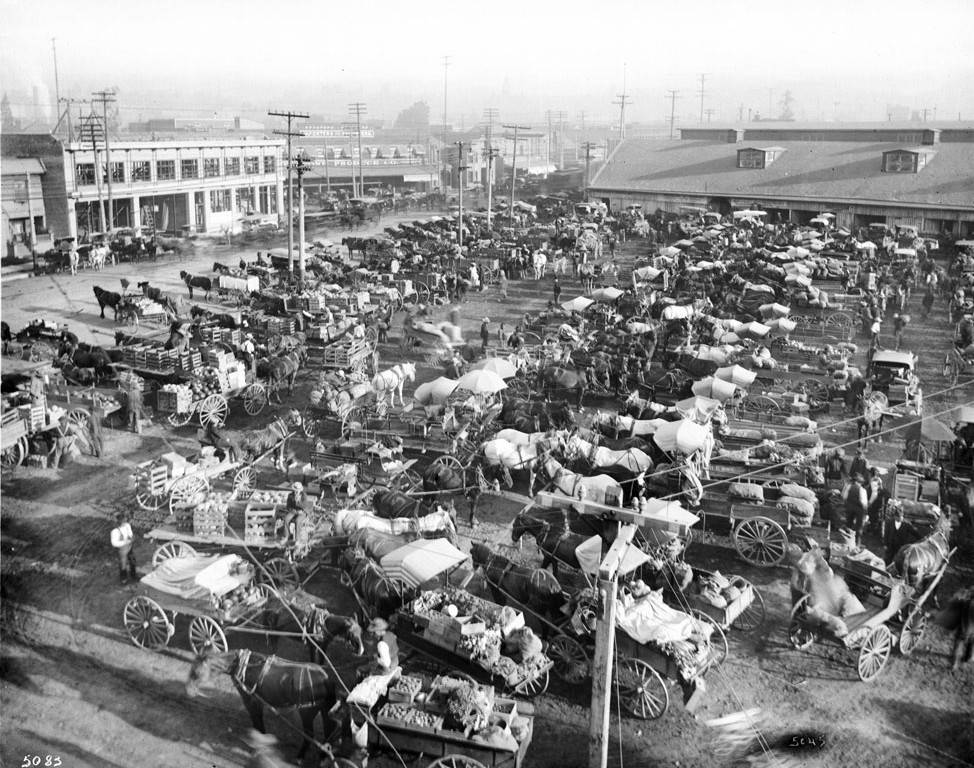 |
|
| (ca. 1903)^^ - View of the Los Angeles Produce Market (Old City Market) as it appeared near the time it opened. |
Historical Notes The City’s demand for fresh produce was only increasing; subsequently, it leased a vacant lot at 9th Street and Los Angeles Street to provide a more regulated space for the vegetable market. This new market, known as the Hughes Market, opened its stalls in 1901, expanding at a rapid rate until it outgrew its bounds and leased another vacant lot from the city at 3rd Street and Central in 1903, establishing the Los Angeles Market Company.^^^^# In the upper left of the photo can be seen two buildings. The building in front (the one under construction) was the Produce Exchange Building and the one in the back has a sign which reads Towne Produce Co. These two buildings are still there and look like this today.*^^ |
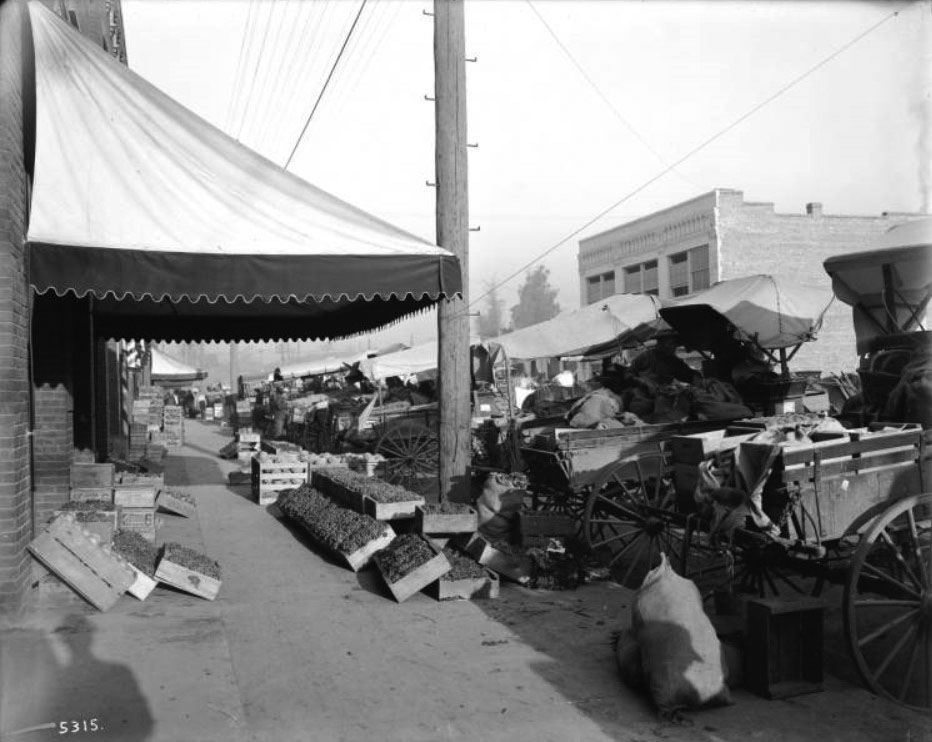 |
|
| (ca. 1910)^^ - View showing wagons loaded with food at the Old City Market at 3rd Street and Central Avenue. The street is filled with parked carriages at right containing goods to be sold at the market. Crates of fruits and vegetables clutter the sidewalks. |
Historical Notes Infighting amongst the shareholders and stall vendors led to the creation of two new markets in 1909; one was the City Market of Los Angeles on 9th Street and San Pedro, established by Mr. Louis Quan, while the other remained, in name, the Los Angeles Market Company, established on 6th Street and Alameda (the Southern Pacific railroad, wanting to run track through the 3rd and Central street location, exchanged this land for the lot on 6th street). Both markets grew at a tremendous rate, and while the City Market was able to expand three blocks south to 12th street, and 1 block west from San Pedro to Wall Street, the Los Angeles Market Company soon moved to a larger space on 7th and Central Streets. |
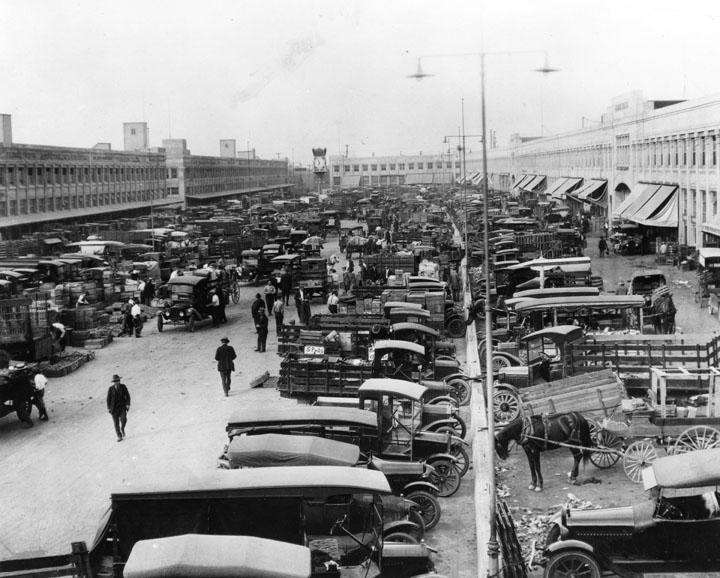 |
|
| (1920s)^ - Terminal Market, located at Seventh and Central. The entire center area consists of cars and at least one horse & cart, parked while people walk to or from the market area around the outside. |
Historical Notes Where previously the market was crowded with horses and buggies, this new site was designed to be large enough to accommodate automobile traffic. In 1926, horses were legally prohibited on streets, making wagons an obsolete method for transporting produce. |
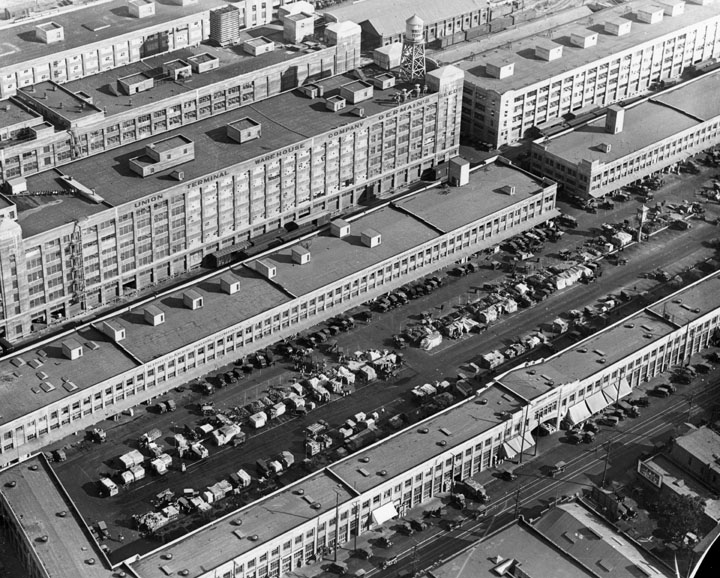 |
|
| (ca. 1930)^ - Long buildings in rows stretch across the picture. The Produce Market is stretched a block long between two of these rows, with double rows of stands. A warehouse in the back row carries the name "Union Terminal Warehouse Company". |
Click to see more on Los Angeles City Market |
* * * * * |
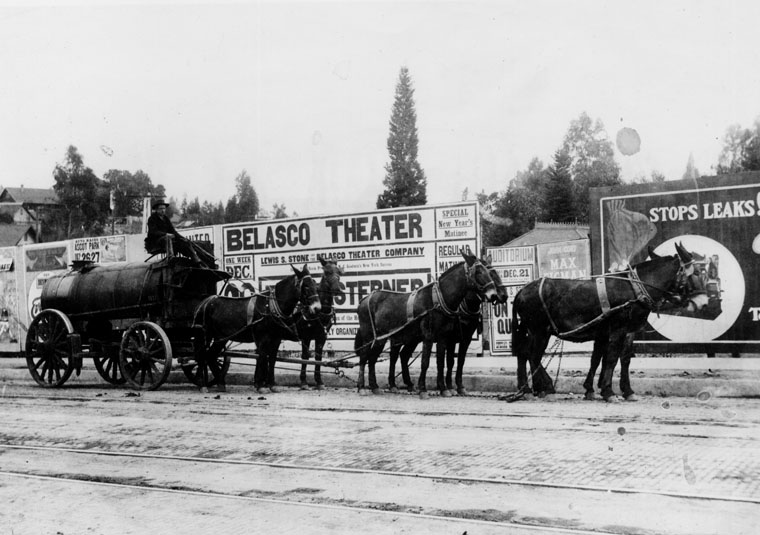 |
|
| (ca. 1900)^ - A horse-drawn wagon of the A. F. Gilmore Oil Co. on a Los Angeles street, in front of an advertisement for the Belasco Theater. |
Historical Notes A.F. Gilmore and his son, Earl Bell (E.B.) turned their Gilmore Oil Company into the largest distributor of petroleum products in the Western U.S. E. B. Gilmore appears to have invented the self-serve gas station. He created a “gas-a-teria” not far from Farmers Market where customers saved 5 cents per gallon by filling their own tanks. Those who preferred to have their gas pumped by “professionals” at the gas-a-teria got unusual service for a period of time when young ladies on roller skates would glide to the pumps to gas the cars up.^** |
* * * * * |
Sawtelle
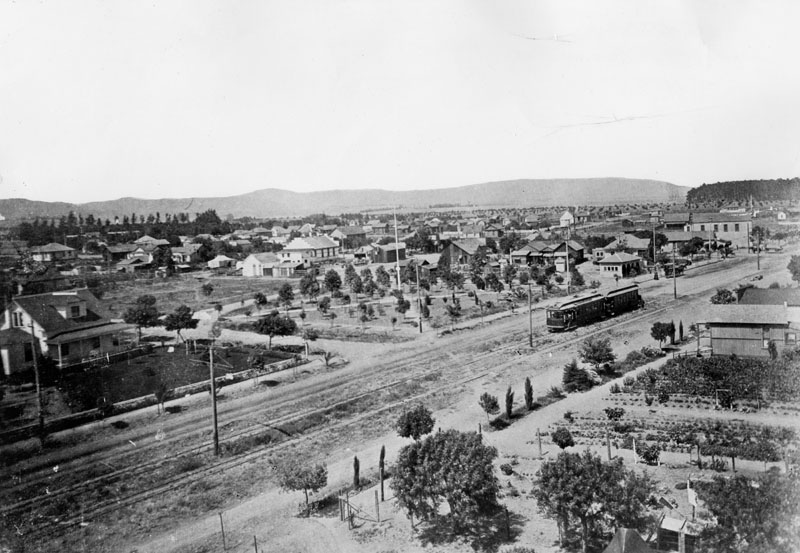 |
|
| (1890)^ - An early look at the newly developing Santa Monica Boulevard in Sawtelle (now Los Angeles). |
Historical Notes In 1896, the Pacific Land Company purchased a 225-acre tract and hired S.H. Taft to develop a new town named Barrett, after Gen. A.W. Barrett, local manager of the veterans home situated in the area. When the Pacific Land Company attempted to secure a post office for the new town, the postal authorities objected to the name "Barrett" on account of its similarity to Bassett, California. In 1899, the name of the town was formally changed to Sawtelle (for W.E. Sawtelle who superseded Taft as manager of the Pacific Land Company). Sawtelle is where the U.S. Government established the National Soldier's Home (now Veterans Administration Hospital). Click HERE to see more. Sawtelle existed as a separate city until 1922 when Sawtelle voters decided to join Los Angeles.*^ |
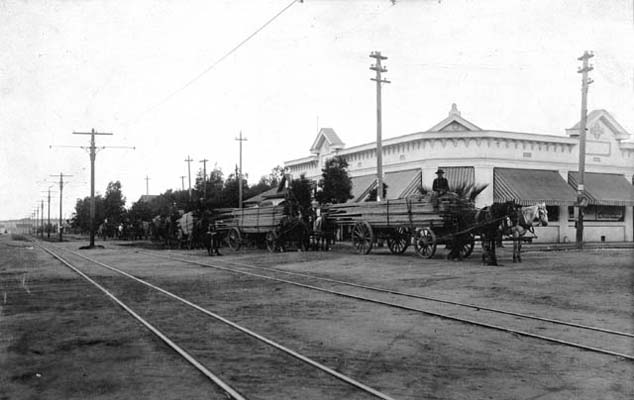 |
|
| (1900)^ - Teams of horses pulling stacks of planks on Santa Monica Bld. at Sawtelle Blvd. in the City of Sawtelle (now part of Los Angeles). |
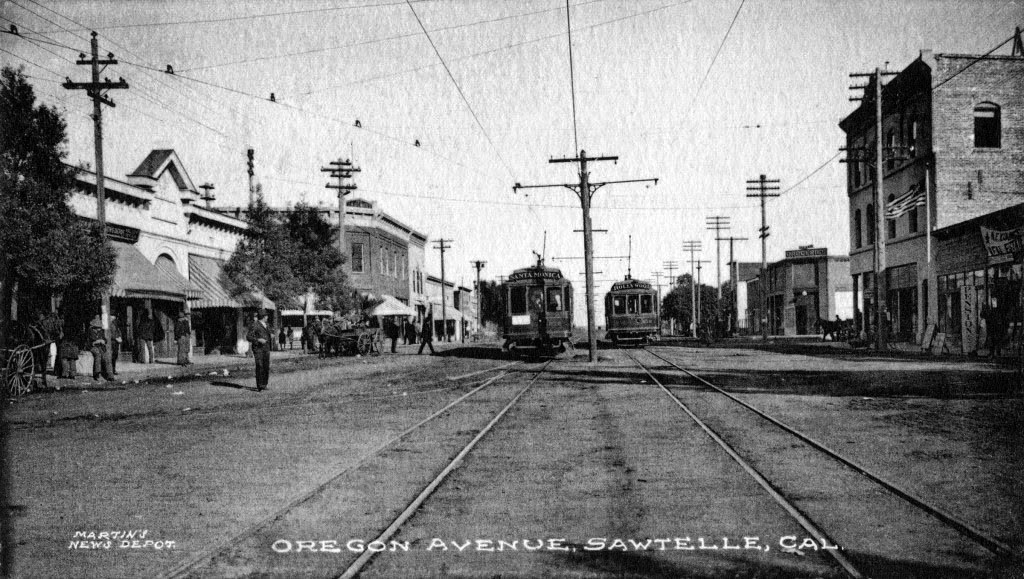 |
|
| (1906)**^*^ – View looking east on Oregon Avenue, which was the original name of Santa Monica Boulevard in this part of Los Angeles. The line going off the left of the frame is the Westgate Line that ran down the middle of Burton Way through Brentwood Park. The exact location of this photo is somewhere near present-day Santa Monica Boulevard and Purdue Avenue. |
Historical Notes Sawtelle existed as a separate city until 1922 when Sawtelle voters decided to join Los Angeles. |
* * * * * |
Santa Monica
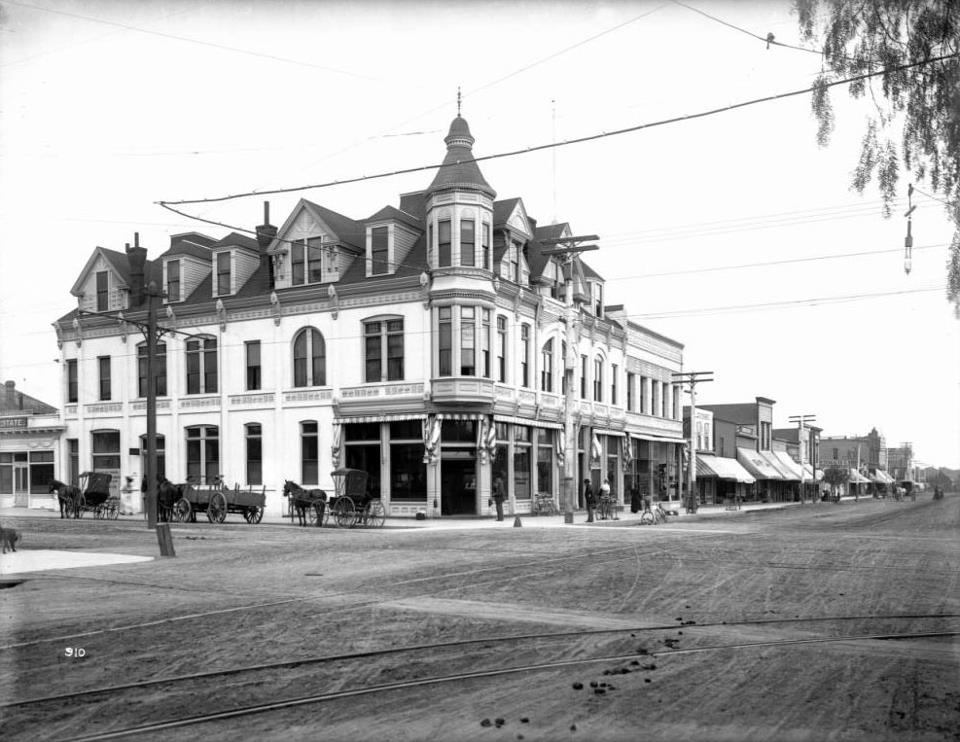 |
|
| (ca. 1900)^^ - View of the corner of Third Street and Santa Monica Boulevard (then named Oregon Avenue). Today the intersection is part of the popular Third Street Promenade retail district. |
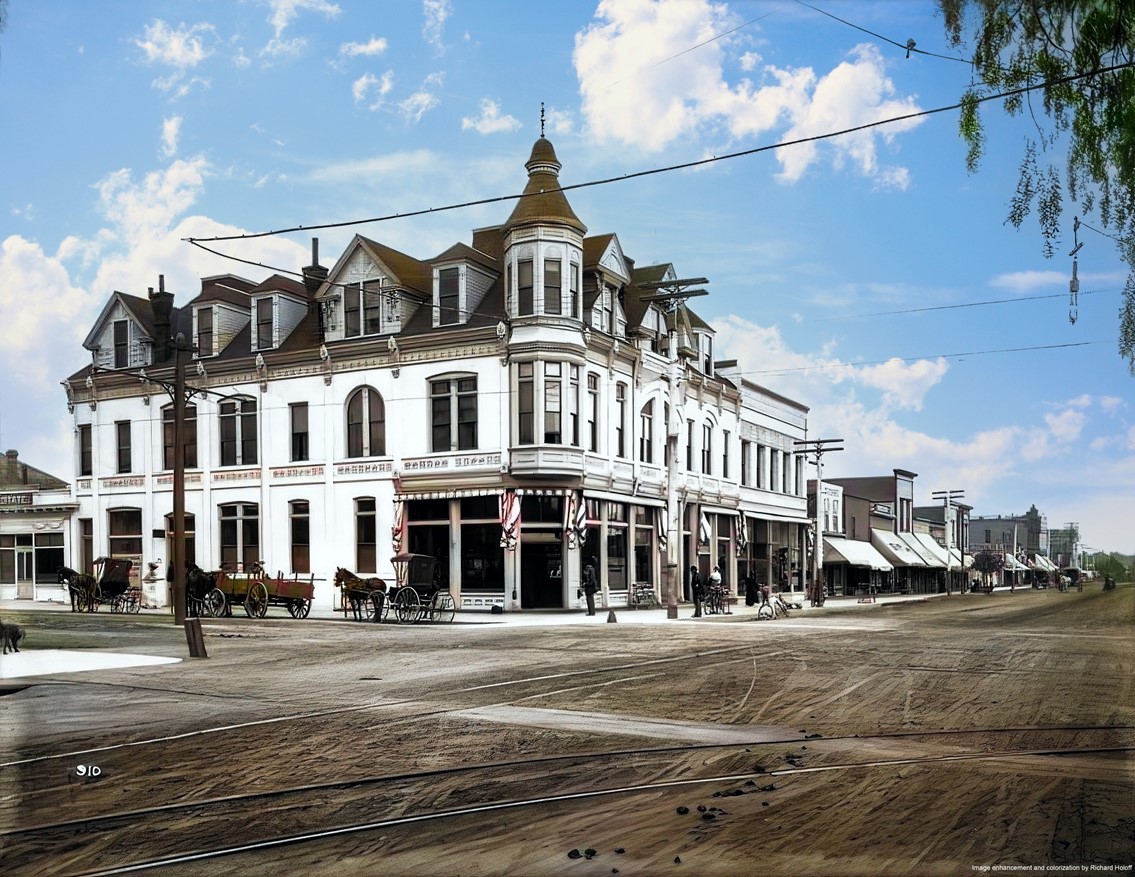 |
|
| (ca. 1900)^^ - View of the corner of Third Street and Santa Monica Boulevard (then named Oregon Avenue). Today the intersection is part of the popular Third Street Promenade retail district. Image enhancement and colorization by Richard Holoff. |
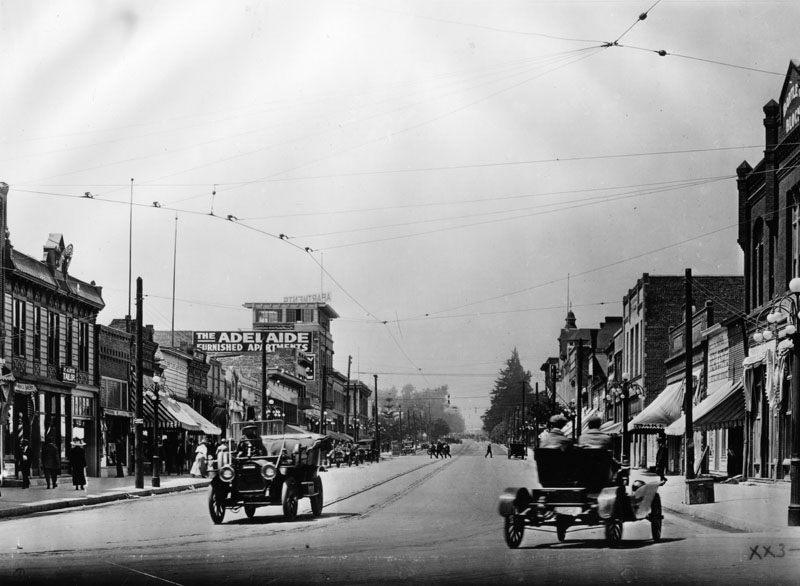 |
|
| (1910)^ - View shows two automobiles driving on the 400 block of 3rd Street in Santa Monica. The Adelaide apartments can be seen on the left. Today, this is the Thrid Street Promenade. |
Click HERE to see more in Early Views of Santa Monica |
* * * * * |
San Fernando Valley
 |
|
| (ca. 1900)***^ - An old time camp outfit near Ventura Boulevard and Valley Circle Boulevard. Leonis Adobe is in the background to the left of the photo. On the El Camino Real sign it says, "83.9 Santa Barbara, 18 Newberry Park, 47.9 Ventura, Los Angeles 26.1, Encino 8, Hollywood 19.6, San Fernando Mission 14." The El Camino Real bells were placed along the mission routes. |
Historical Notes Leonis Adobe, built in 1844, is one of the oldest surviving private residences in Los Angeles County and one of the oldest surviving buildings in the San Fernando Valley. Located in what is now Calabasas, the adobe was occupied by the wealthy rancher, Miguel Leonis, from 1880 until his death in 1889. Following Leonis' death, the property was the subject of a legal dispute between his common law wife (Espiritu Leonis), heirs, and a daughter born out of wedlock; the dispute lasted more than 15 years in the courts.*^ |
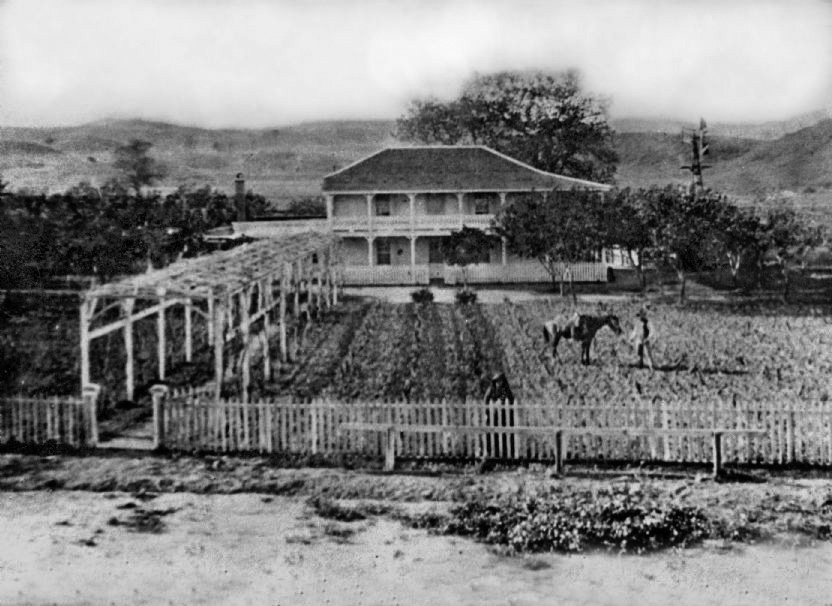 |
|
| (ca. 1890s)****# - Leonis Adobe as it appeared in the 1890s. The photo shows a man standing by his horse in the field. If you look closely, standing right behind the fence (center) is a woman looking at the photographer. This is purported to be Espiritu Leonis, wife of Miguel Leonis. |
Historical Notes In 1961, the adobe had fallen victim to vandalism, and its owner applied for a permit to raze the structure and erect a supermarket in its place. Preservationists succeeded in having the adobe declared a Historic-Cultural Landmark (the first structure in Los Angeles receiving the designation in 1962 - Click HERE to see the LA Historic-Cultural Monuments List). Leonis Adobe is also known as one of the most haunted sites in Los Angeles County, and it was profiled in the British paranormal television series "Most Haunted" in 2005. The adobe was restored and is operated as a living museum. It was listed on the National Register of Historic Places in 1975.*^ |
Click HERE to see more in Early Views of the San Fernando Valley |
* * * * * |
San Pedro
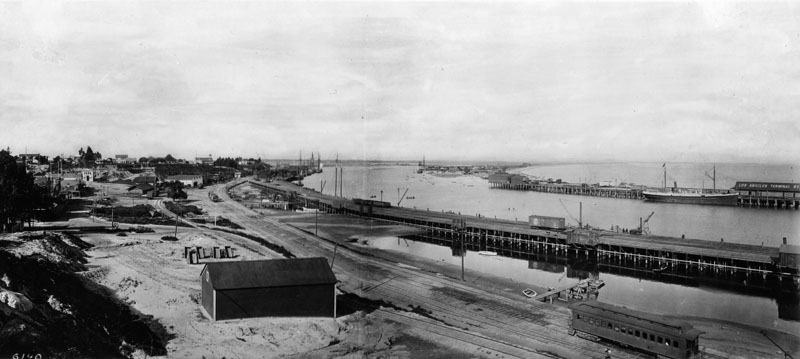 |
|
| (ca. 1900)^ - View of L.A. Harbor at San Pedro showing a large ship anchored alongside the Los Angeles Terminal Railway across the channel. Railroad tracks can be seen in the foreground. |
Historical Notes In 1542, Juan Rodriquez Cabrillo discovered the "Bay of Smokes". The south-facing San Pedro Bay was originally a shallow mudflat, too soft to support a wharf. Visiting ships had two choices: stay far out at anchor and have their goods and passengers ferried to shore; or beach themselves. Phineas Banning greatly improved shipping when he dredged the channel to Wilmington in 1871 to a depth of 10 feet. The port handled 50,000 tons of shipping that year. Banning owned a stagecoach line with routes connecting San Pedro to Salt Lake City, Utah and to Yuma, Arizona, and in 1868 he built a railroad to connect San Pedro Bay to Los Angeles, the first in the area.*^ |
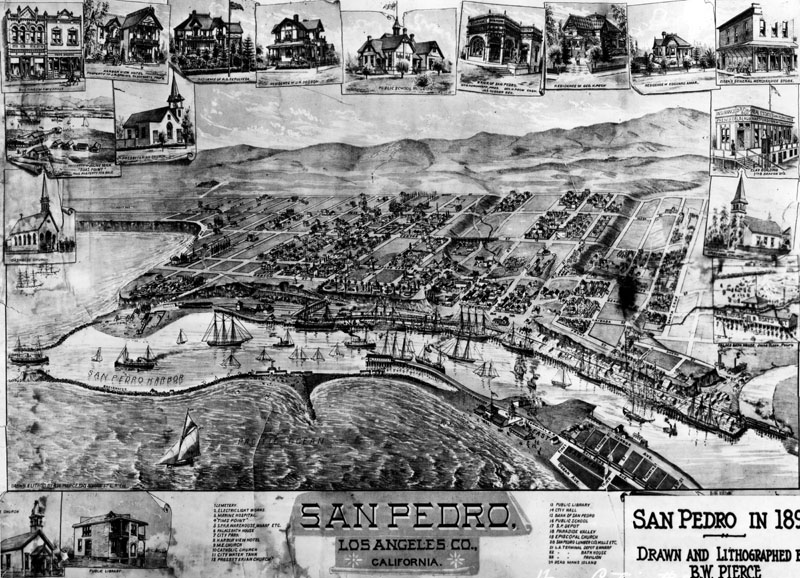 |
|
| (1893)^ - Map of San Pedro in 1893. Drawn and lithographed by Bruce W. Pierce. |
Historical Notes San Pedro was named for St. Peter of Alexandria, a Fourth Century bishop in Alexandria, Egypt. His feast day is November 24 on the local ecclesiastical calendar of Spain, the day on which Juan Rodriguez Cabrillo discovered the bay in 1542 which would be known as San Pedro. Santa Catalina Island, named after Catherine of Alexandria, was claimed for the Spanish Empire the next day, on her feast day, November 25. In 1602–1603, Sebastián Vizcaíno (1548–1624) officially surveyed and mapped the California coastline, including San Pedro Bay, for New Spain. The land was granted in 1784 by King Carlos III to Juan Jose Dominguez, a retired Spanish soldier who came to California with the Gaspar de Portolà expedition. Under United States control after 1848, when the United States defeated Mexico in the Mexican-American war, the harbor was greatly improved and expanded under the guidance of Phineas Banning and John Gately Downey, the seventh governor of California.*^ |
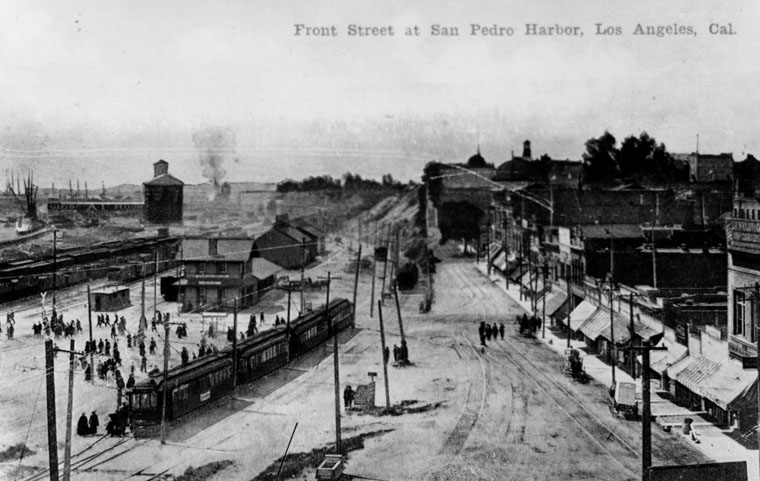 |
|
| (ca. 1900)^ - View of Front Street at San Pedro Harbor showing a multitude of people disembarking from a commuter train. Commercial storefronts can be seen acroos the unpaved road to the far right of the photo. |
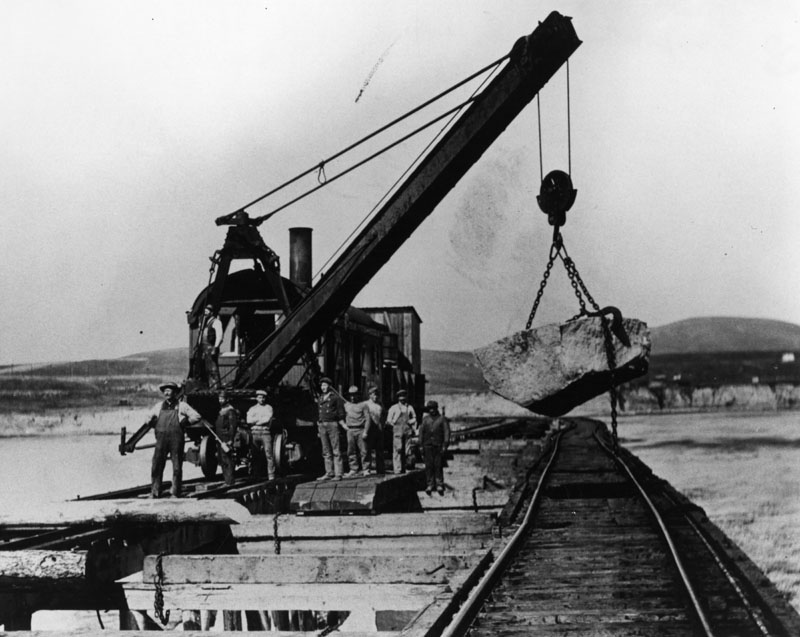 |
|
| (1904)^ - Photo of workers building the breakwater in the San Pedro Harbor. Work was started in 1899. |
Historical Notes Most of the boulders used to construct the breakwater in San Pedro Harbor came from the mountains of west San Fernando Valley. Between 1898 and 1904, Southern Pacific was grading, cutting, and tunneling through the Santa Susana Mountains near Chatsworth Park as they establshed their new Coast Line connection from Ventura to Burbank. This provided San Pedro with an ample supply of boulders for their new breakwater. Click HERE to see more in Early Views of the San Fernando Valley. |
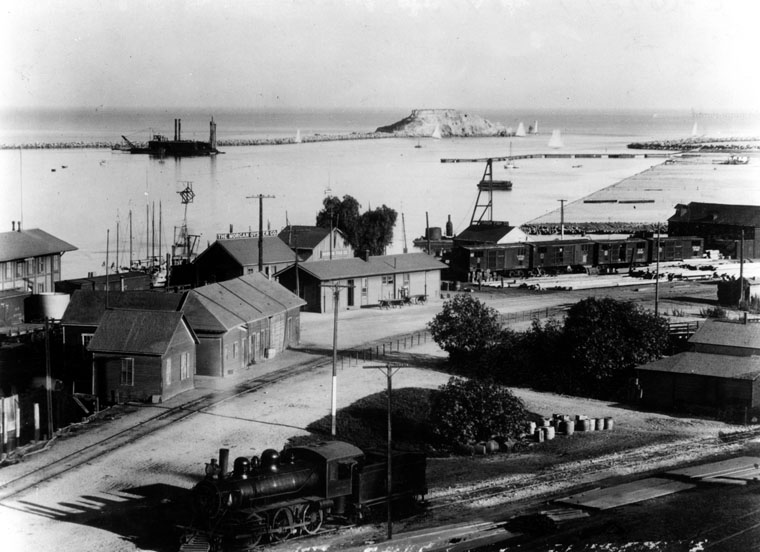 |
|
| (1905)^ - View looking over a portion of San Pedro, toward Deadman's Island, and the beginning harbor. Building at extreme left is the Southern Pacific depot. In the distance is a dredge at work along the breakwater. |
Historical Notes Deadman's Island was one of two islands near San Pedro in the 19th century. The land, sometimes referenced as Dead Man's Island, Isla Del Muerto, and Reservation Point, was dredged away in 1928 as part of a harbor development effort. Rattlesnake Island, the other islet in the area, became Terminal Island.*^ |
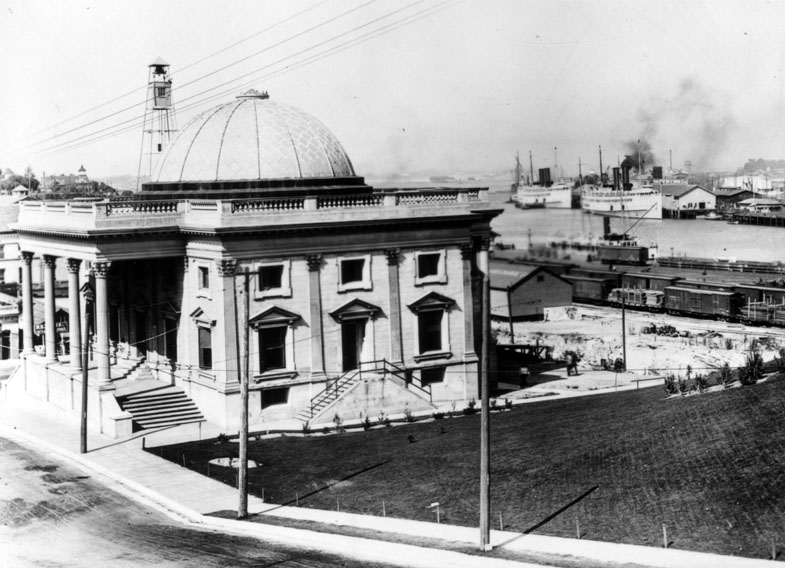 |
|
| (ca. 1907)* - Exterior view of the San Pedro City Hall. A rail yard and the Los Angeles Harbor are visible in the background on the right. |
Historical Notes In 1906, the City of Los Angeles annexed the Harbor Gateway, a long narrow strip of land connecting the city to the coast, and in 1909, the city annexed San Pedro and the adjacent town of Wilmington. The odd shape is still seen in the map of the city.*^ |
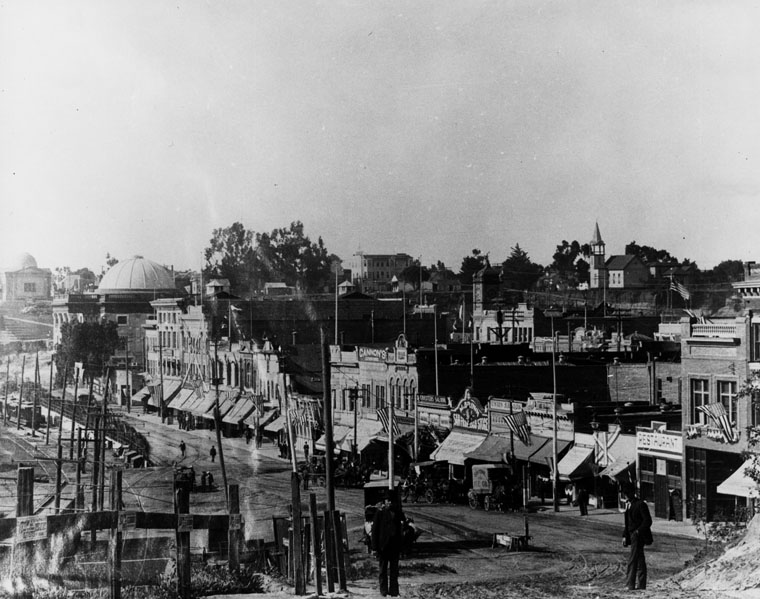 |
|
| (1910)^ - San Pedro waterfront looking south along Harbor Boulevard from 4th Street. City Hall is the building with the large dome; the smaller dome belongs to the Carnegie library building. |
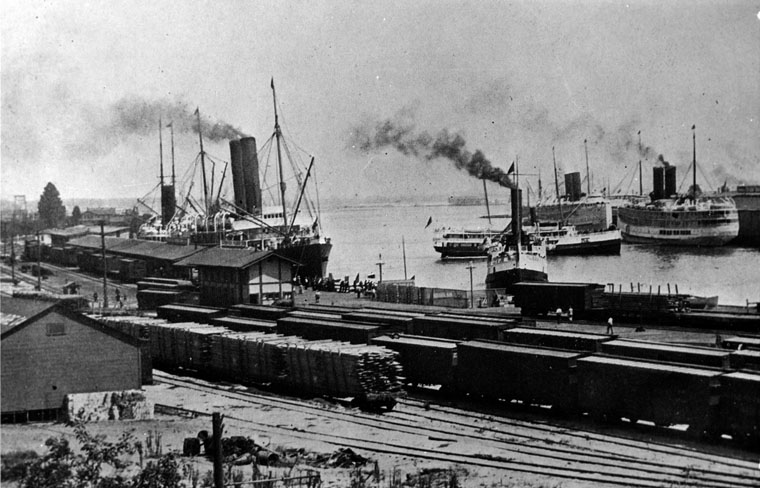 |
|
| (1913)^ - The Port of Los Angeles in 1913. The harbor appears to be filled to capacity with steam ships and train cars are full of cargo. |
Historical Notes In 1912 the Southern Pacific Railroad completed its first major wharf at the port. During the 1920s, the port passed San Francisco as the west coast's busiest seaport. In the early 1930s a massive expansion of the port was taken with the construction of a massive breakwater three miles out that was over 2 miles in length. In addition to the construction of this outer breakwater an inner breakwater was built off of Terminal Island with docks for sea going ships and smaller docks built at Long Beach.*^ |
Click HERE to see more in Early Views of San Pedro and Wilmington |
* * * * * |
Hill and 6th Street
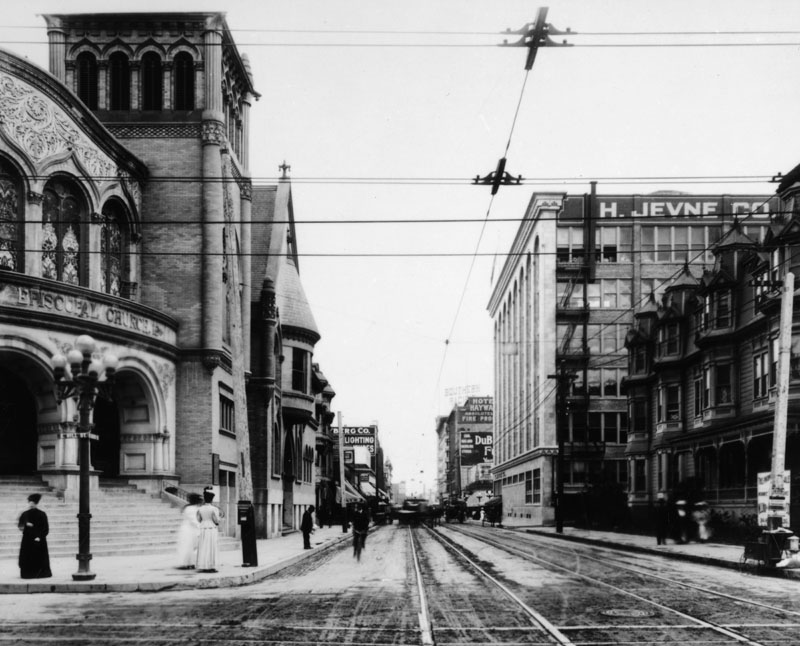 |
|
| (ca. 1900)^ - View looking east on Sixth Street from Hill Street with the First Methodist Episcopal Church on the left (N/E corner). Three women and a man are in front of the church while another man is riding a bycicle. Streetcar tracks can also be seen on the unpaved road. |
 |
|
| (ca. 1900)^ - View looking east on Sixth Street from Hill Street with the First Methodist Episcopal Church on the left (N/E corner). Three women and a man are in front of the church while another man is riding a bycicle. Streetcar tracks can also be seen on the unpaved road. Image enhancement and colorization by Richard Holoff. |
 |
|
| (2022)* - Looking east on 6th Street at Hill Street. |
Then and Now
 |
|
| (1900 vs 2022)* - Looking east on 6th Street at Hill Street. Photo comparison by Jack Feldman. |
* * * * * |
Central and 1st Street
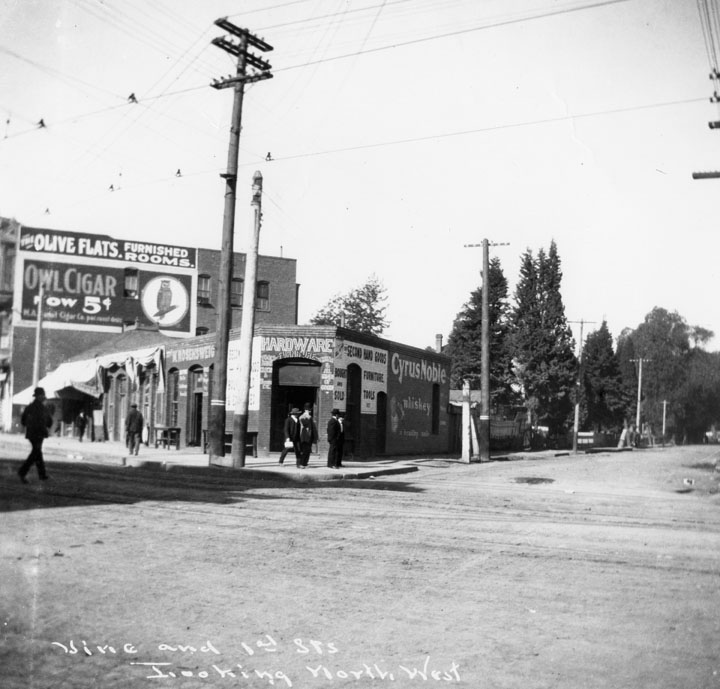 |
|
| (Early 1900s)^ - View of the corner of First Street and Vine (later renamed Central Ave.) A few pedestrians on the street, no automobiles. Hardware and furniture store on corner. Signage on building: "The Olive Flats, furnished rooms," "Owl cigar now 5 cents." |
Historical Notes This is in Little Tokyo. The building at center left was later replaced by a Buddhist temple, later the Japanese-American Museum. The building further to the left later had a very famous restaurant/cafe within. View is to the northwest. |
* * * * * |
Normandie Ave and 3rd Street
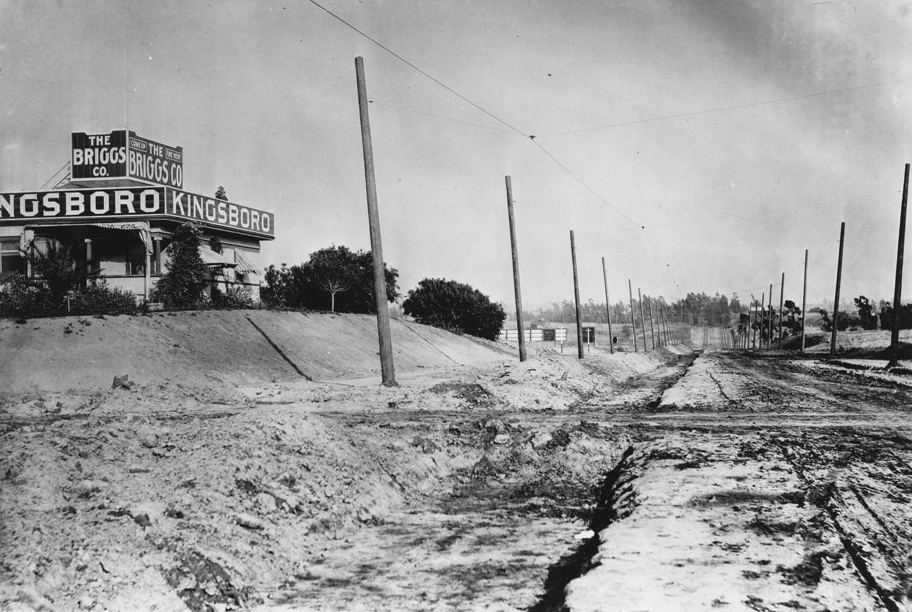 |
|
| (1900)* - View looking east along an unpaved, muddy Third Street at Normandie Avenue. |
Historical Notes This was a common scene on many Los Angeles streets at the turn of the century, as paved roads were still relatively rare several miles from downtown. The street was originally named Rosedale Avenue when it was established in 1884. This name was chosen because the street led to the newly opened Rosedale Cemetery. However, in 1898, real estate developer Edwin S. Rowley successfully petitioned the Los Angeles City Council to rename the street to Normandie Avenue. Rowley's motivation for the name change was apparently that he didn't want to sell houses on a street named after a graveyard, as that could be unappealing to potential buyers. The exact reason why Rowley chose the name "Normandie" is unclear. The French-inspired name could indicate a desire to add a touch of European sophistication to the rapidly growing city, or it might have been chosen to honor French settlers or notable figures. This renaming coincided with a period of substantial growth in Los Angeles, as the city's population was booming and new areas were being developed. Over time, Normandie Avenue grew to become one of Los Angeles County's longest north-south streets, stretching approximately 22.5 miles. |
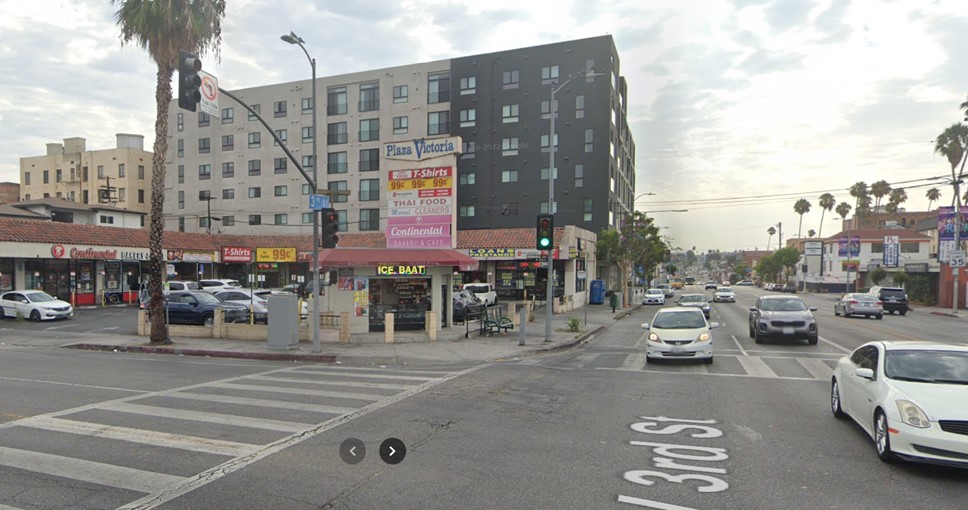 |
|
| (2022)* - Looking east on Third Street at Normandie Avenue showing a mixture of commercial and residental property. |
Then and Now
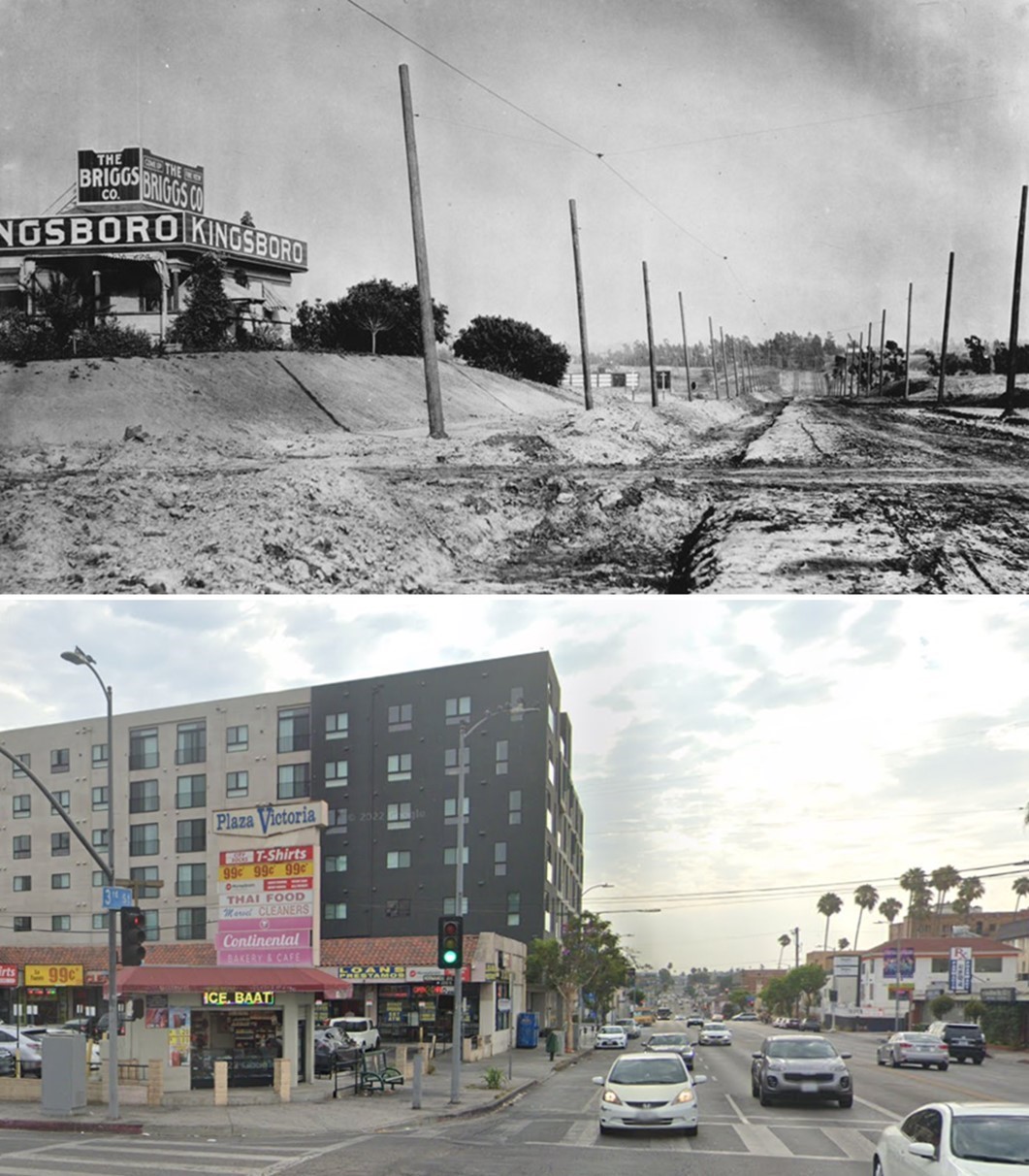 |
|
| (1900 vs 2022)* - Looking east on Third Street at Normandie Avenue, highlighting how this Los Angeles neighborhood has changed over the years. Photo comparison by Jack Feldman. |
* * * * * |
Hollywood Area
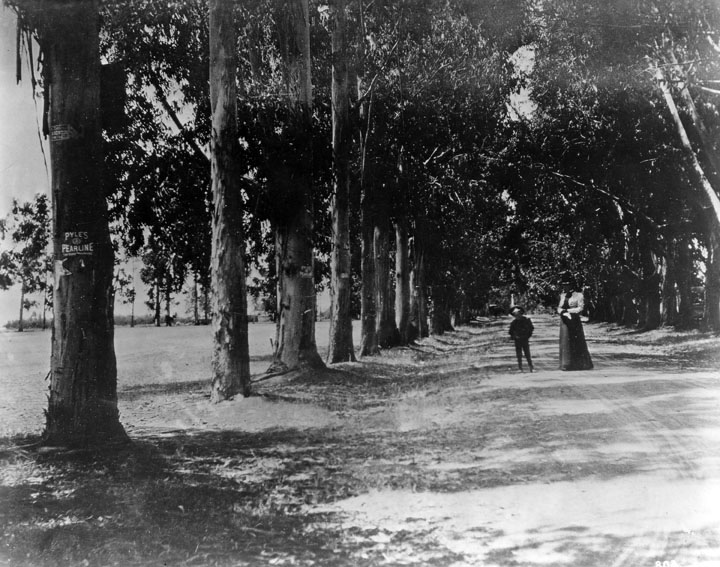 |
|
| (ca. 1900)^ - View looking west on Melrose Avenue from Western Avenue. Trees were planted in the early 1880's and felled on the right side in 1922 and on the left side in 1923. |
Historical Notes Melrose Avenue was named by ranch owner E. A. McCarthy after his hometown of Melrose, Mass. The McCarthy Ranch occupied most of the area bounded by Western to Wilton and Melrose to Santa Monica Blvd. |
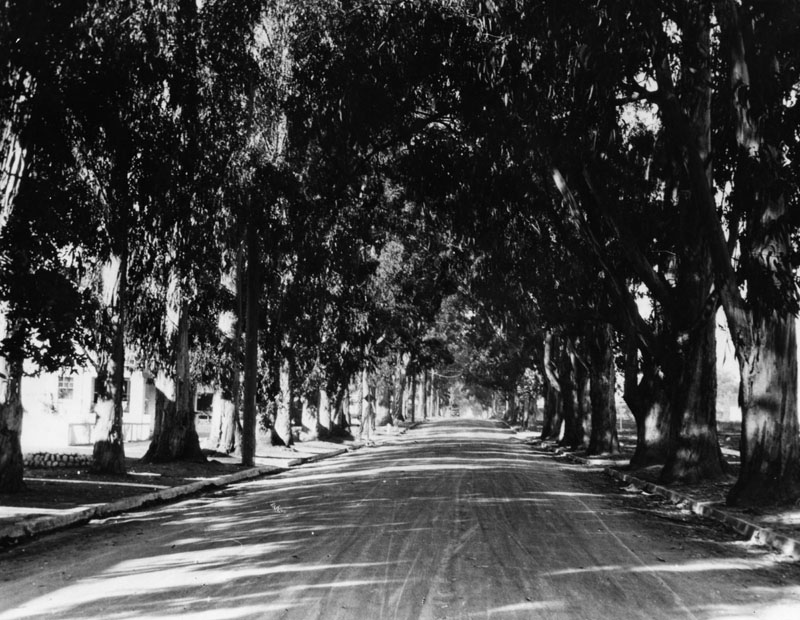 |
|
| (ca. 1910)^ - Tree-lined Melrose Avenue at Western Avenue. Houses and street curbs can now be seen. This was a favorite street for horse and buggy rides on Sundays. |
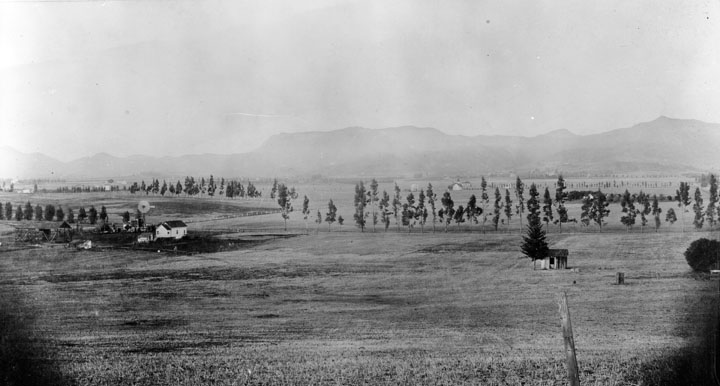 |
|
| (1906)^ - Large rural area with a few houses and trees. The future site of Melrose and Normandie, 1906. Mt. Hollywood peak can be seen in the upper right of the photo. |
Historical Notes The above farm is where the Hollywood Frwy crosses Melrose Avenue today. Just to the west and out of view is the location of the McCarthy Ranch. In 1887 E. A. McCarthy named Melrose Avenue after his hometown of Melrose, Massachusetts. |
 |
|
| (ca. 1915)^^ - View from the E. A. McCarthy ranch showing the Hollywood Hills in the background. |
Historical Notes In 1896 Griffith J. Griffith donated over 3000 acres of Rancho Los Felis to the City of Los Angeles to create a public park in his name. Mount Hollywood, the highest peak of the park, rises to an elevation of 1640 feet. Griffith Park was declared Los Angeles Historic-Cultural Monument No. 942 in 2009 (Click HERE to see complete listing). |
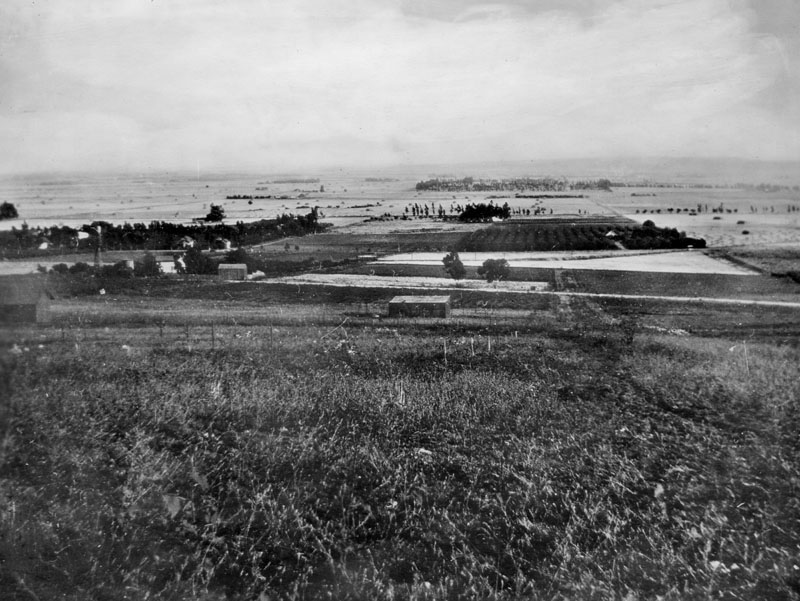 |
|
| (1901)^ - Panoramic view of Hollywood looking southeast from near Vista Street and Franklin Avenue. The scene is largely agricultural. |
Historical Notes The Hollywood area was still very rural in the turn of the century with the first substantial residences built around farmland. |
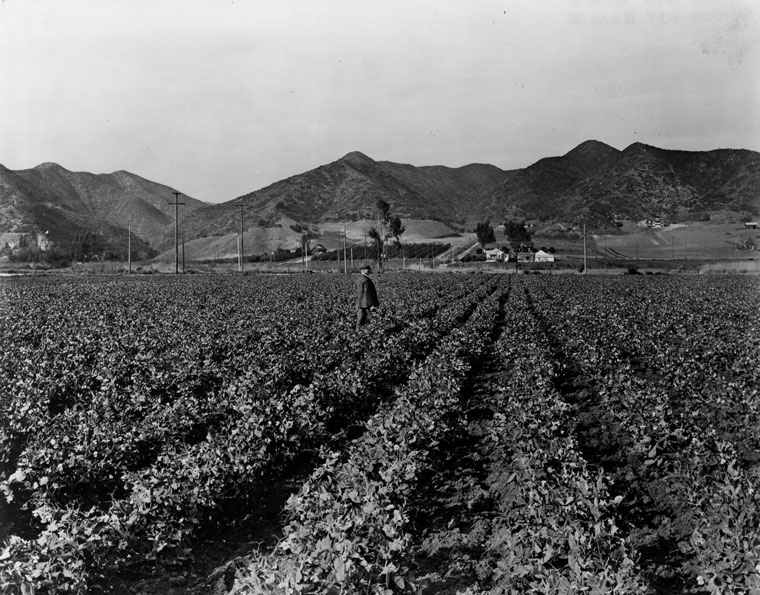 |
|
| (1901)^ - A man walks through a sweet pea field located at about Fairfax and Sunset, in West Hollywood. |
Historical Notes Click HERE to see more in Early Views of Hollywood (1850 - 1920) |
* * * * * |
Early Modes of Transportation
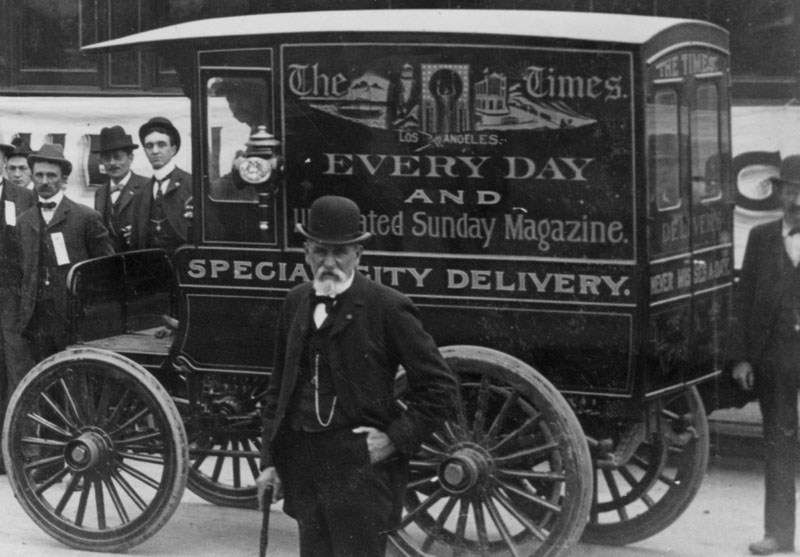 |
|
| (1901)^ - A delivery truck for the Los Angeles Times in 1901. Several men are looking toward the photographer. |
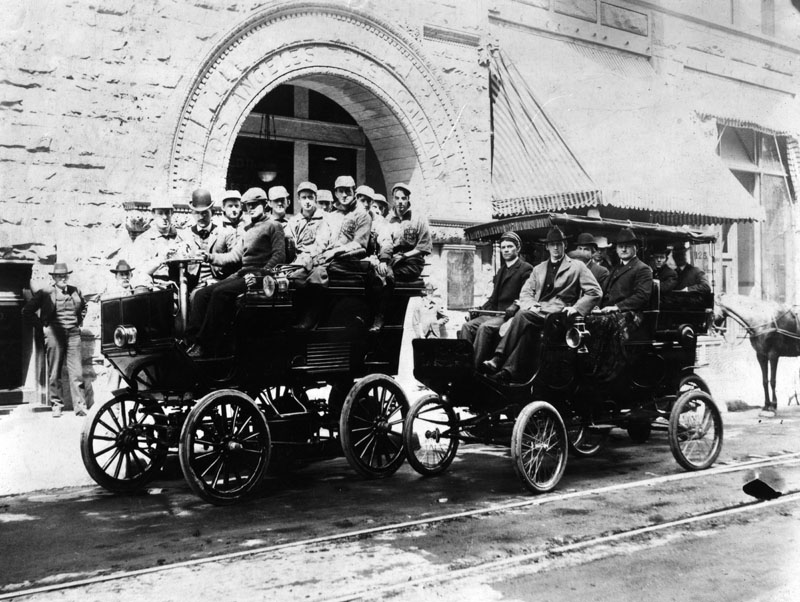 |
|
| (1902)^ - Two unidentified vehicles used to transport a large number of people,"Sports" is the note on the photograph. From another copy of the subject the team is identified as the "Bank baseball team, Second Street and Spring Street, 1902." Los Angeles Trust Company, engraved in the arch of the doorway to the building in the background, may be the "Bank" referred to. |
Historical Notes Click HERE to see more in Baseball in Early L.A. |
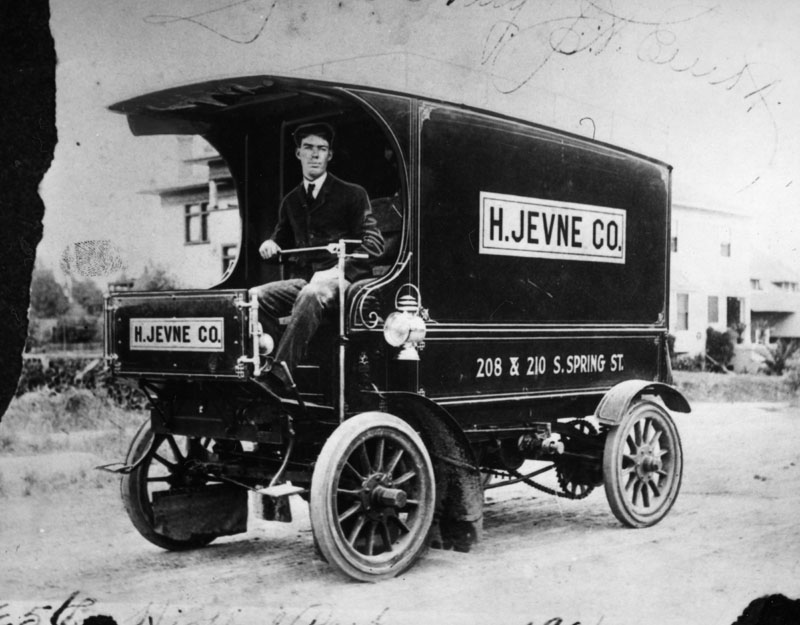 |
|
| (1906)^ - Delivery vehicle of the H. Jevne Co., a wholesale grocery supplier, taken in Highland Park in 1906. The company was located at 208 and 210 South Spring Street. This early truck has no steering wheel but uses a metal post device and has no front enclosure. |
Historical Notes Hans Jevne, in the grocery business in downtown Los Angeles from 1882-1920, didn’t want to miss a sale. At some point quite early in his operations (perhaps right from the start), he determined that if customers in the vicinity couldn’t come to him—or did come but didn’t want to tote the groceries—he’d have the merchandise delivered to them. While free home delivery by a grocery store was certainly not originated by Jevne, he eventually provided that service on an exceptionally grand scale. He employed deliverymen at least as early as 1893. On As of 1889, when “The Illustrated History of Los Angeles County, California” was published, H. Jevne Co. had 13 horses (and employed 27 men). His store, at 38 and 40 North Spring Street, had by then expanded from a single room in the building to both floors, according to the book. In 1890, Jevne moved to a three-story building at 136 and 138 N. Spring St. (in the “Wilcox Block”), and in 1896 relocated to 208/210 S. Spring Street (in the newly opened “Wilcox Building”). Jevne continued to offer home delivery, shifting from reliance on horse-pulled wagons to motorized vehicles. |
* * * * * |
La Fiesta de las Flores Parade (aka La Fiesta de Los Angeles)
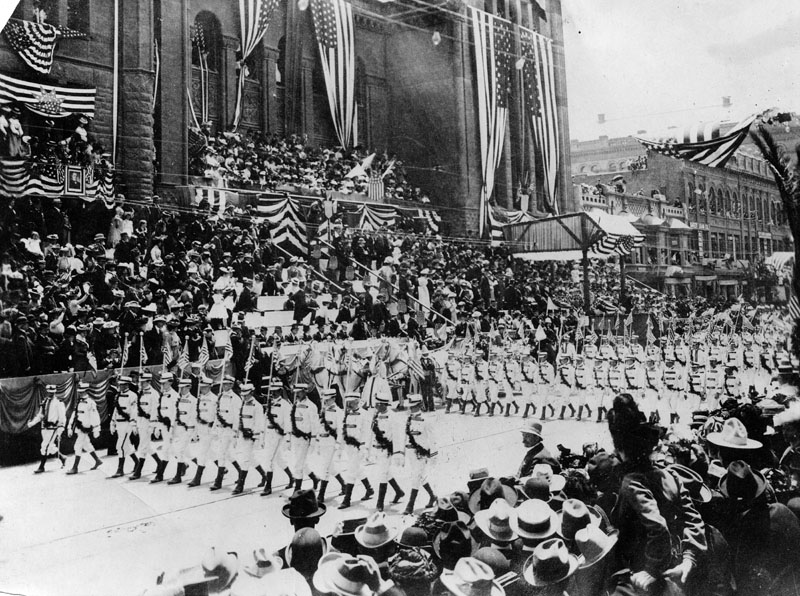 |
|
| (1901)^ - President McKinley reviewing the Americus Club marching in the La Fiesta de las Flores Parade from the steps of the Los Angeles City Hall building on Broadway. |
Historical Notes La Fiesta de Los Angeles which began on April 10, 1894, was a four day festival that the city threw in its own honor celebrating its many different cultures. It continued throughout the 1890s and early 1900s. The event featured parades, floats, many flowers, athletic competitions, a costume ball, and carnival attended by masked revelers. It was conceived of by a local business man as a way to attract tourism at a time when the effects of the 1893 depression were being felt. The City Hall building as seen above was LA's third. It was built in 1888 and stood until the current city hall was completed in 1928. |
 |
|
| (ca. 1901)* - View of the La Fiesta Parade between Broadway and Sixth Street showing President McKinley. McKinley turns the corner of the two streets in a horse-drawn carriage that has been decorated with a layer of roses while a cavalcade of police officers follow him to his side both on foot and on horseback, as well as behind him in rank. Spectators sit and stand in the bleachers in the left background. To the right, a brick business building advertises yeast for the Golden Gate Compressed Wheat Company. |
 |
|
| (1901)* – View looking north on Spring Street from 4th Street showing crowds of spectators observing the Chinese dragon in a parade at the Los Angeles Fiesta. One parade marcher carries a stool on which the head of the dragon sits when at rest. American flags hang from lines strung across the road. Onlookers sit on the edge of the roof in the foreground. |
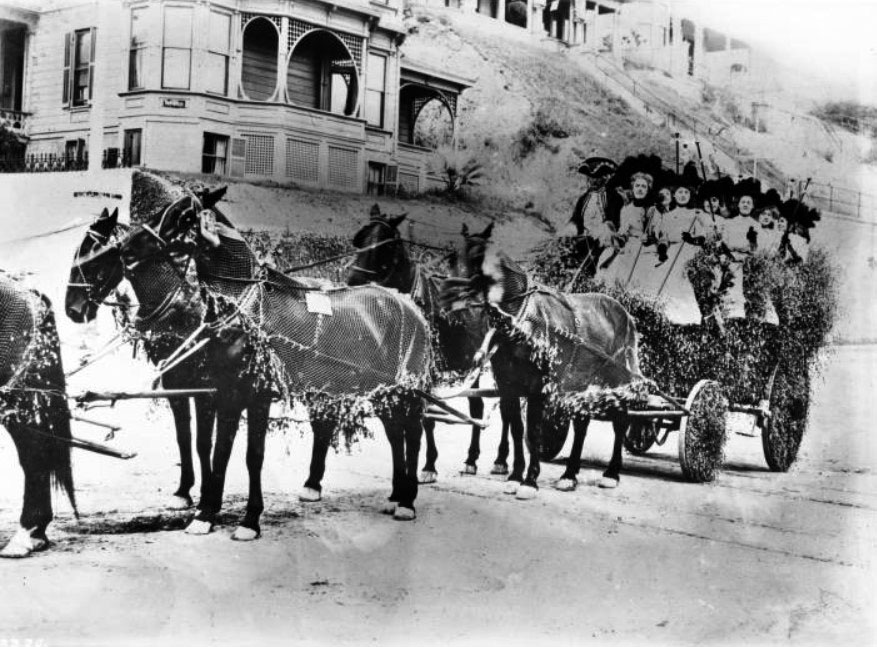 |
|
| (ca. 1901)* – View showing a carriage drawn by 6 horses and decorated with flowers, the Friday Morning Club float, standing at the corner of Second Street and Hill Street, during La Fiesta de Los Angeles. |
Historical Notes Founded by abolitionist, suffragist, mother and homemaker Caroline Severance in 1891, the Friday Morning Club (FMC) was the largest single women's club in California, with membership of over 1,800 women by the 1920s. Women's clubs were a mainstay of middle-class women's social and intellectual life across America from the end of the Civil War until the middle of the 20th century, when their numbers declined as opportunities increased for women's equal participation in mainstream business, educational, and social institutions. |
 |
|
| (1903)^ - View of La Fiesta de las Flores parade passing in front of several large buildings along Spring Street in Downtown Los Angeles. Multitudes of people line both sides of the street and numerous others can be seen enjoying the parade from open windows and rooftops high above. |
 |
|
| (1903)* - View showing the same floats as previous photo but now Broadway. Thousands of people line the street and/or sit in the stands. Sign on building reads "Conservative Life". |
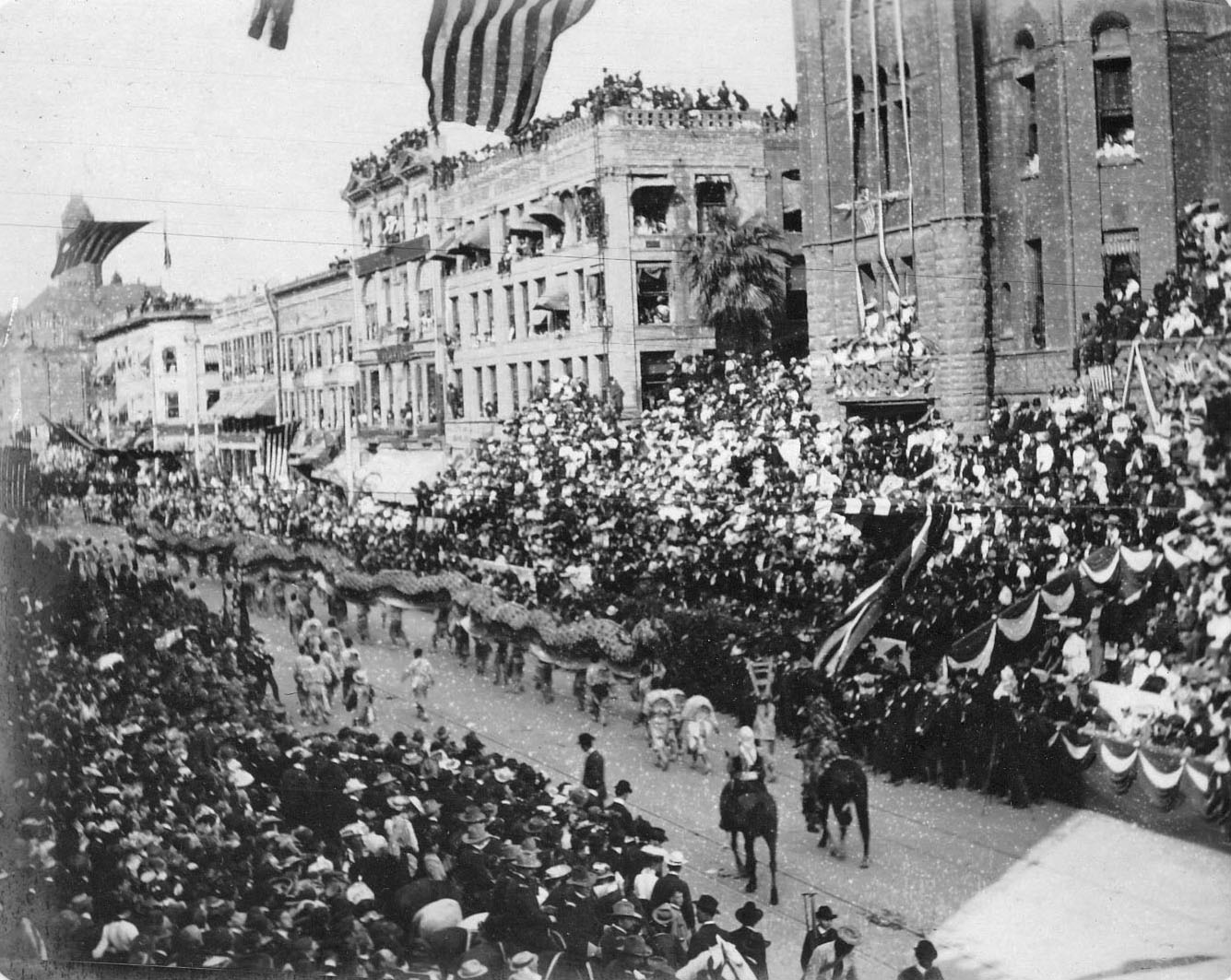 |
|
| (1903)* - Chinese Dragon winds its way heading north on Broadway in front of Los Angeles City Hall , at the Fiesta de la Flores Parade. The County Courthouse tower can be seen in the upper-left. |
Historical Notes The 1903 La Fiesta de la Flores parade was notable because President Theodore Roosevelt was in attendance and watched as it passed this reviewing stand. On each side, flanking the Presidential stand, is the Grand Stand containing the Executive Committee, sub-committees, County and City Officials, and invited guests. After the Floral Parade, the Presidential party entered the carriages in waiting and with military escort, drove to Sixth Street Park (later Pershing Square). |
 |
|
| (ca. 1910)* - The Wheelmen were regular participants in the La Fiesta de Los Angeles downtown parade in April. |
Historical Notes The Los Angeles Wheelmen, a prominent cycling club formed around 1896 during the height of the bicycle craze, were regular participants in the annual La Fiesta de Los Angeles downtown parade in April. This period marked a surge in cycling's popularity as both a sport and a mode of transportation, with the Wheelmen actively organizing and participating in events like races and century runs, including the notable Fourth of July race from Los Angeles to Santa Monica. The completion of the 18-mile Santa Monica Cycle Path in 1900, part of the broader good roads movement, provided a reliable route to the sea and highlighted the Wheelmen's advocacy for better road conditions and safer riding environments. Their legacy endured through reunions of former racers, known as the "Wheelmen of the Past Century," which continued into the mid-20th century, celebrating the lasting impact of early cycling culture in the region. The La Fiesta de Los Angeles parades ended in 1916. |
* * * * * |
Tournament of Roses (Pasadena)
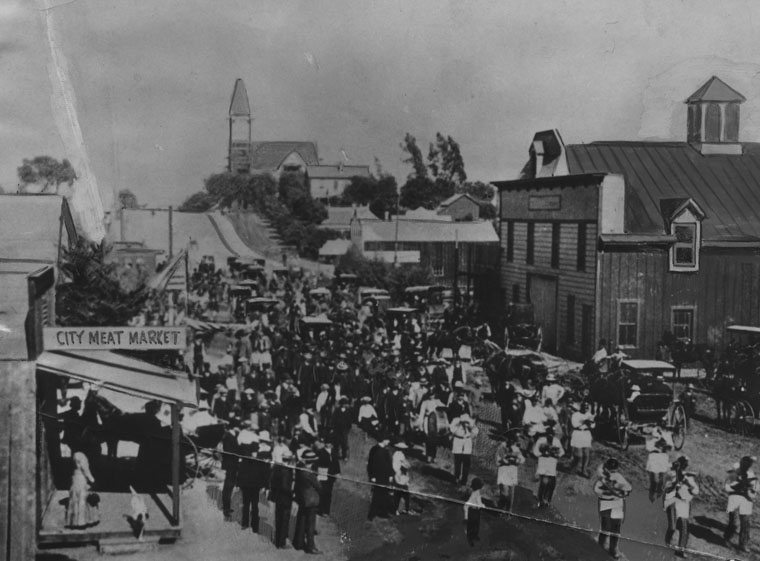 |
|
| (1902)^ - This was the 1902 Tournament of Roses parade, with a butchers band marching down the Pasadena street. There was nothing spectacular about the parade then, and the spectators were few. This was also the first year of the Rose Bowl game. |
Historical Notes Members of Pasadena's Valley Hunt Club first staged the Tournament of Roses parade in 1890. Since then the parade has been held in Pasadena every New Year's Day, except when January 1 falls on a Sunday. Many of the members of the Valley Hunt Club were former residents of the American East and Midwest. They wished to showcase their new California home's mild winter weather. At a club meeting, Professor Charles F. Holder announced, "In New York, people are buried in the snow. Here our flowers are blooming and our oranges are about to bear. Let's hold a festival to tell the world about our paradise." So the club organized horse-drawn carriages covered in flowers, followed by foot races, polo matches, and a game of tug-of-war on the town lot that attracted a crowd of 2,000 to the event. Upon seeing the scores of flowers on display, the professor decided to suggest the name "Tournament of Roses." Over the next few founding years, marching bands and motorized floats were added. |
 |
|
| (1902)^ - First Tournament East-West football game, January 1, 1902, Michigan vs. Stanford. Note the crowd of people standing in foreground, and to the right side of the football field. Horse-drawn carriages are lined along a fence beyond the crowds of people. |
Historical Notes Before the Rose Bowl was built, 1923, games were played in Pasadena's Tournament Park, approximately three miles southeast of the current Rose Bowl stadium near the campus of Caltech. Tournament Park was determined to be unsuitable for the larger and larger crowds gathering to watch the game and a new, permanent home for the game was commissioned. Click HERE to see more in Early Views of Pasadena |
* * * * * |
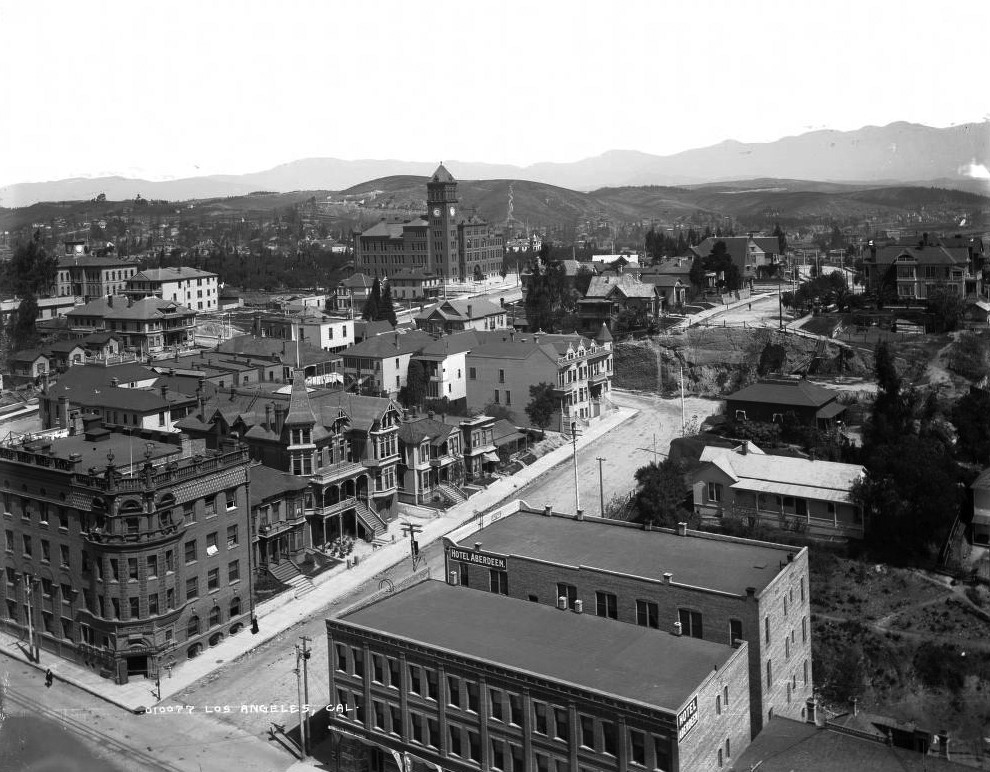 |
|
| (1900)* - View looking northwest from the top of the County Courthouse located on Temple Street and Broadway. The tall building with a clock tower is Los Angeles High School. The Broadway Tunnel would be bored through Fort Moore Hill, at the end Broadway (center-right), within a year of this photo. |
Historical Notes The Broadway Tunnel was a tunnel under Fort Moore Hill, built in 1901, extending North Broadway (formerly Fort Street), at Sand Street (later California Street), one block north of Temple Street, northeast to the intersection of Bellevue Avenue (later Sunset Boulevard, now Cesar Chavez Avenue), to Buena Vista Street (now North Broadway). Buildings seen include the Hotel Aberdeen and the Women's Christian Temperance Union building with a rounded corner and a balustrade on the cornice. Signs read: "Hotel Aberdeen" "W.C.T.U, Temperance Temple, Furnished Rooms" and "Sanitarium and Health Office." Multi-story Victorian houses have half-timbering, dormers, and turrets. |
 |
|
| (1901)^ - Close-up view of the second building housing Los Angeles High School, located on north Hill Street between California and Bellevue. There are numerous oil derricks behind it, all part of the Los Angeles Oil Field. |
Historical Notes This was Los Angeles High School's second home, built in 1891 on Fort Moore Hill. Los Angeles High School was founded in 1873 and is the oldest public high school in the L.A. Unified School District. The original building was at Temple and Broadway (the current site of the Los Angeles County Court House). In 1891, L.A. High School moved to its second building at a new location (seen above) on nearby Fort Moore Hill, located on north Hill Street between California (now the 101 Freeway) and Sunset Blvd (now Cesar E. Chavez Ave). Early buildings commissioned to house the Los Angeles High School were among the architectural jewels of the city, and were strategically placed at the summit of a hill, the easier to be pointed to with pride. One of the school's long standing mottos is "Always a hill, always a tower, always a timepiece." In 1917, the school moved to its current location at 4650 West Olympic Boulevard (which incidentally is not on a hill). |
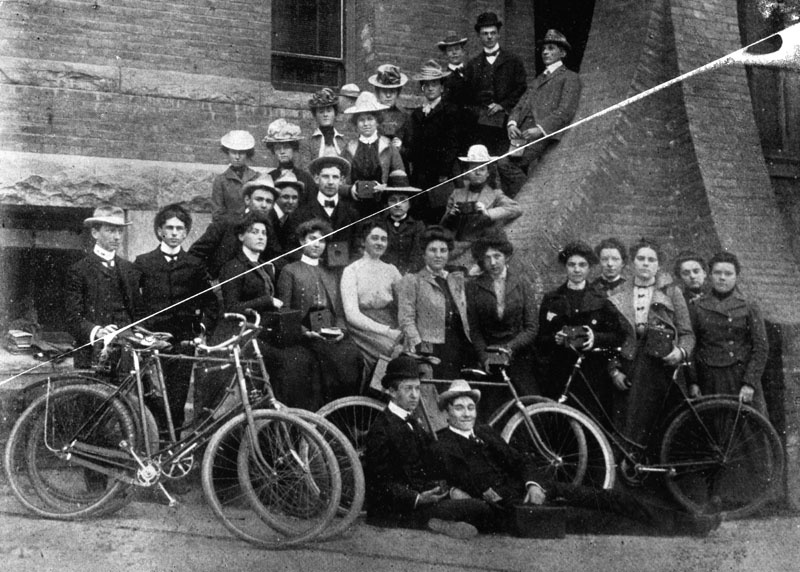 |
|
| (1900)^ - Group photo of members of Los Angeles High School's Kodak and bicycle club. Some hold their cameras, other stand near bicycles. |
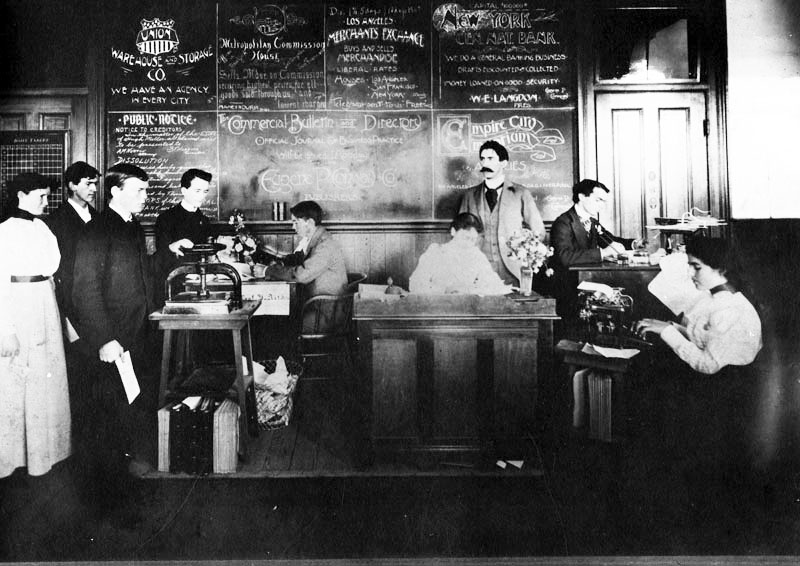 |
|
| (1899)^ - Los Angeles High School's commercial practices class, in 1899. Click HERE to see more Early Views of Los Angeles High School. |
\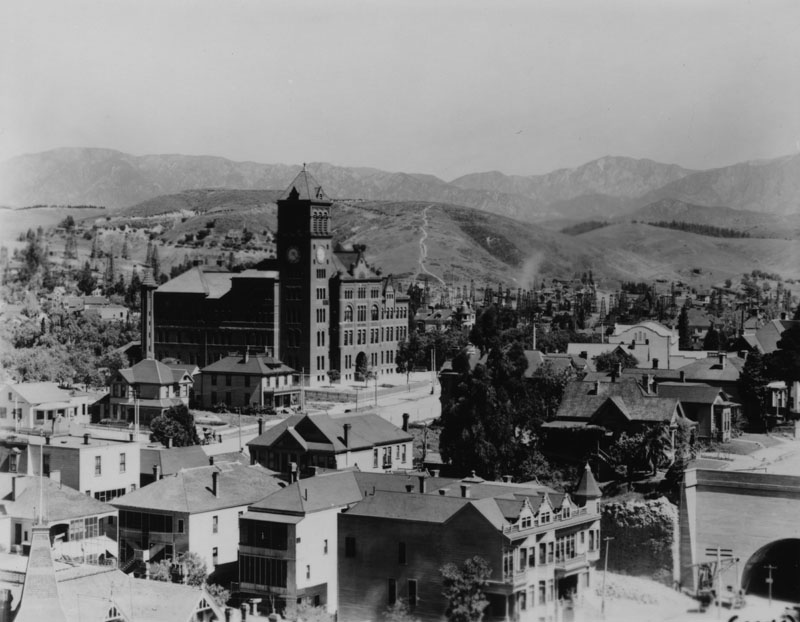 |
|
| (ca. 1902)^ - View from Broadway between Temple and California Streets, northwest. The tall building with a clock tower is Los Angeles High School. The Los Angeles Oil Field is in the background behind the school. The Broadway Tunnel can be seen in the lower right corner of this photo. |
Historical Notes Discovered in 1890, and made famous by Edward Doheny's successful well in 1892, the Los Angeles Oil Field was once the top producing oil field in California, accounting for more than half of the state's oil in 1895. In its peak year of 1901, approximately 200 separate oil companies were active on the field, which is now entirely built over by dense residential and commercial development. |
* * * * * |
Broadway Tunnel
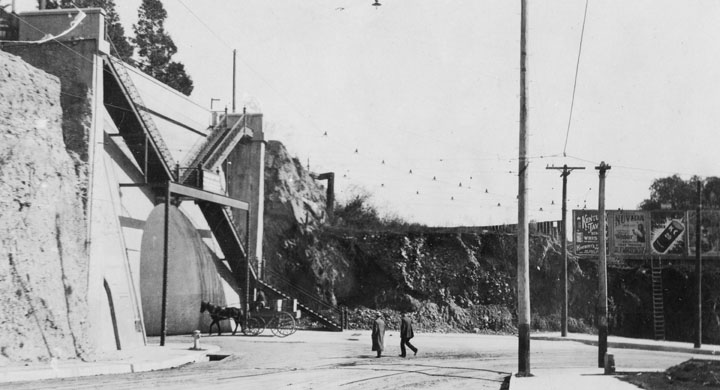 |
|
| (ca. 1902)^ - South approach to the Broadway Tunnel and the stairway leading up to Fort Hill. A man is riding a horse-drawn wagon into the tunnel while two men are crossing the unpaved road and appear to also be heading toward tunnel opening. There was a sign over the Tunnel which read: “$50.00 fine for riding through this tunnel faster than a walk.” |
Historical Notes The Broadway Tunnel opened in August 1901, pushing through Fort Moore Hill at a cost of $66,000. At 760 feet long, 40 feet wide, and 22 feet high, it was one of the largest urban tunnels in the United States at the time. Signs warned drivers of a steep grade and imposed a $50 fine for traveling faster than a walk—an attempt to control the speed of horses and wagons. Alongside the nearly completed Third Street Tunnel under Bunker Hill, it marked Los Angeles’ growing confidence in reshaping its landscape to meet the needs of a fast-expanding city. Third Street Tunnel under Bunker Hill was also completed in 1901. |
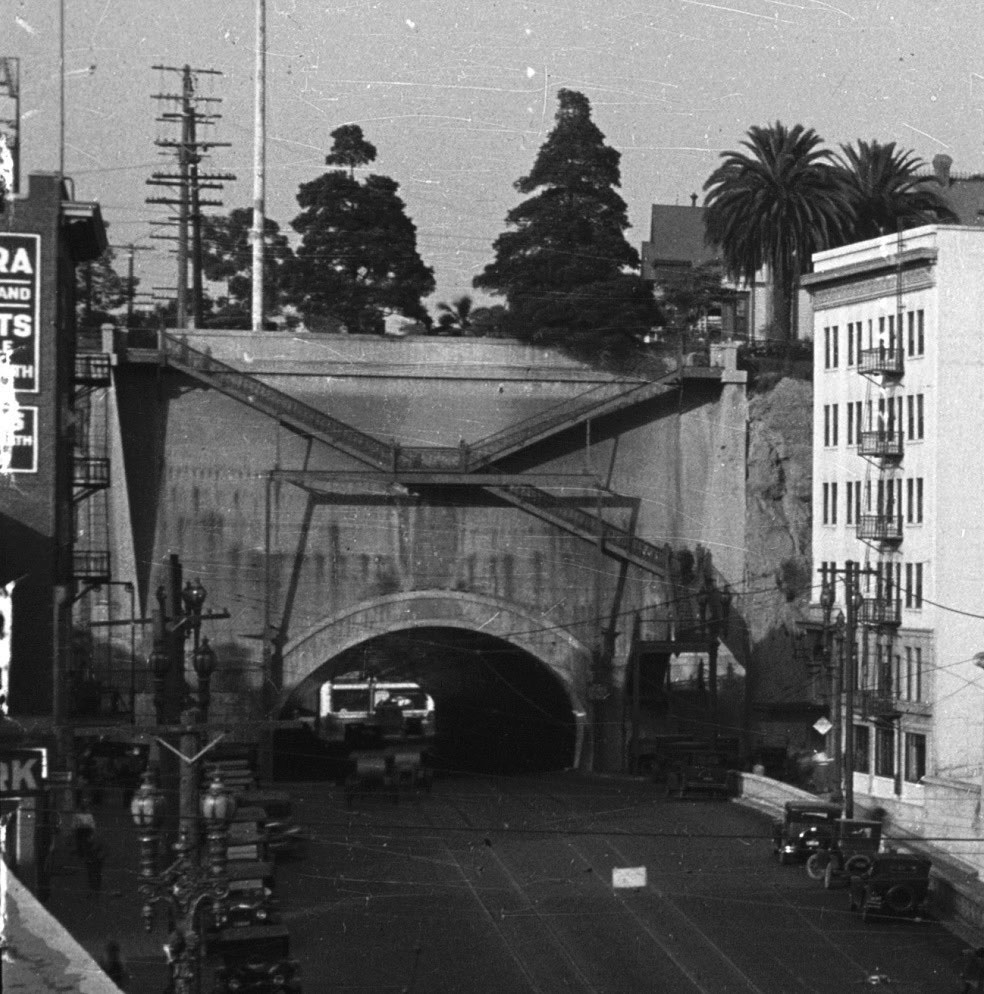 |
|
| (ca. 1924)* – View showing the south portal of the Broadway Tunnel. Note the pedestrian staircase on the face of the tunnel. |
Historical Notes By the 1920s, the tunnel had become a critical link between the Civic Center and neighborhoods to the north. The south portal stood out for its pedestrian staircase, which climbed the face of Fort Moore Hill and provided access to the residential streets above. The tunnel was more than just a passage for cars, wagons, and streetcars—it was a connector that stitched together the city’s civic and residential worlds, a symbol of Los Angeles’ determination to overcome the barriers of its rugged topography. |
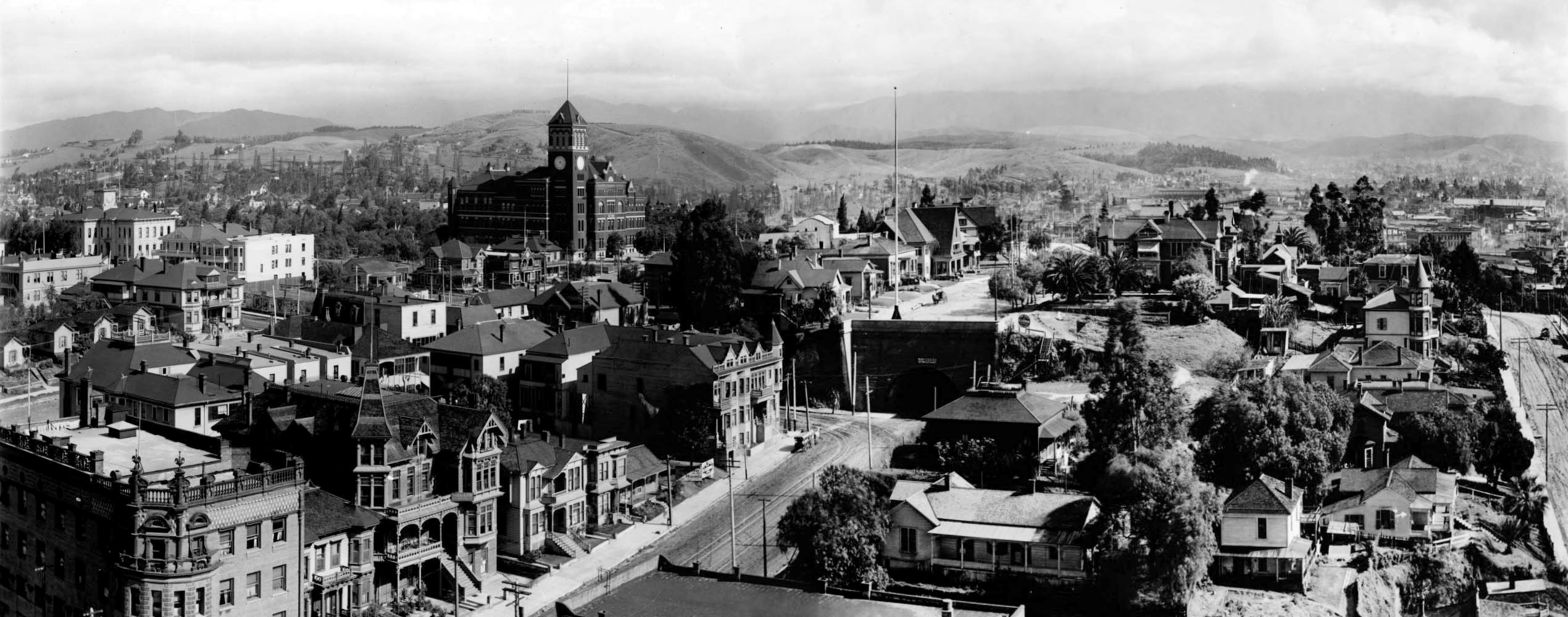 |
|
| (ca. 1905)* - Panoramic view looking northwest as seen from the LA County Courthouse (S/E corner of Broadway and Temple Street) showing a completed Broadway Tunnel at center and Los Angeles High School in the background. |
Historical Notes From the vantage point of the Los Angeles County Courthouse, the Broadway Tunnel appeared as a bold cut through Fort Moore Hill, with Los Angeles High School visible in the distance. The tunnel not only relieved congestion in downtown’s crowded streets but also signaled the city’s ambitions to expand northward. For early Angelenos, it was a daily reminder that growth required reshaping the land itself. |
Before and After
 |
|
.jpg) |
|
| (1900)* vs. (1905)* - View looking northwest from the top of the County Courthouse located on Temple Street and Broadway. |
Historical Notes Only a few years separated the barren slope of Fort Moore Hill from the fully operational Broadway Tunnel, but the difference was striking. The project reflected Los Angeles’ transformation at the turn of the century, when major infrastructure projects turned physical barriers into conduits for movement, commerce, and civic pride. |
 |
|
| (1905)* - Detail view showing houses, dirt road, and a horse-drawn carriage above the finished tunnel. Note the wooden steps on the right. Also, there is a sign above the tunnel entrance that warns of a $50 fine "For Riding Or Driving Through This Tunnel Faster Than A Walk". |
Historical Notes Above the tunnel’s southern entrance, homes clung to the hillside and wooden steps climbed the slope. A sign at the entrance repeated the warning against moving faster than a walk—an early attempt at traffic regulation in a city where horses, carriages, and pedestrians all shared the same space. Though modest by today’s standards, the tunnel represented an ambitious reimagining of Los Angeles’ landscape, one that foreshadowed the larger engineering projects of the freeway era. |
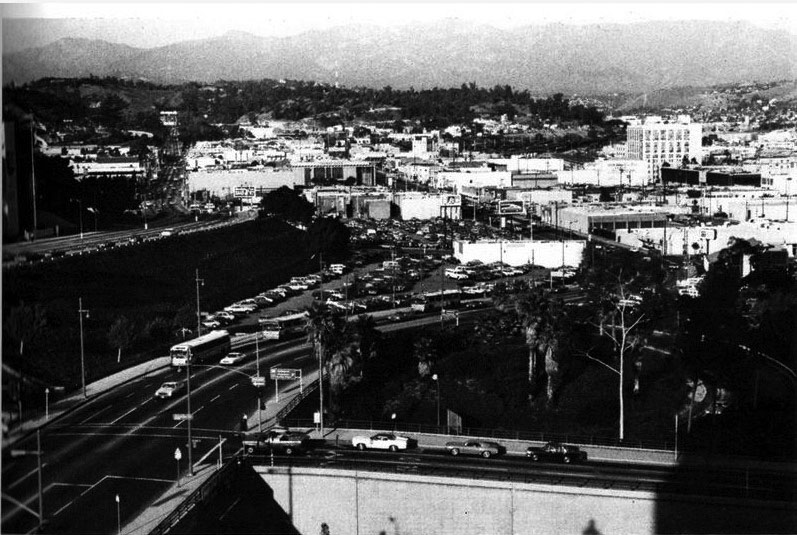 |
|
| (1987)^#^ - View looking north from Temple between Broadway and Spring Street. The Hollywood Freeway now cuts through where the Broadway Tunnel used to be. Same view as previous photo but 82 years later. |
Historical Notes The Broadway Tunnel was closed on June 2, 1949, and demolished soon after to make way for the Hollywood Freeway. Fort Moore Hill, once a formidable barrier, was reduced to a remnant. Broadway, which had once dipped beneath the hill, now crossed above the freeway on a bridge at the very spot where the tunnel once stood. The shift marked the transition from an era of horse-drawn wagons and early automobiles to one dominated by freeways, cars, and a completely reconfigured downtown. |
Then and Now
 |
 |
| (1905 vs. 1987) - Then and Now |
Historical Notes The comparison of Broadway’s southern approach in 1905 and 1987 highlights the scale of change in Los Angeles’ core. What had once been a tunnel beneath Fort Moore Hill became an overpass above the Hollywood Freeway, reflecting the city’s unrelenting drive to rebuild its landscape in pursuit of growth and mobility. |
Then and Now
 |
|
| (1949 vs. 2022)* - Looking south from the northern portal of the 1901-built Broadway Tunnel. In 1949, the construction of the 101 freeway through downtown L.A. reduced Fort Moore Hill to a stump and converted the section of Broadway between Temple and Sunset from a tunnel to a freeway overpass. Photo comparison by Jack Feldman. |
Historical Notes By 1949, construction of the Hollywood Freeway cut directly through Fort Moore Hill, sealing the tunnel’s fate. Broadway, which had once depended on the 1901 tunnel, now crossed the freeway on an overpass. More than just a shift in design, it reflected Los Angeles’ embrace of the automobile and its willingness to erase older infrastructure to build anew. Click HERE to see more Early Views of the Broadway Tunnel |
* * * * * |
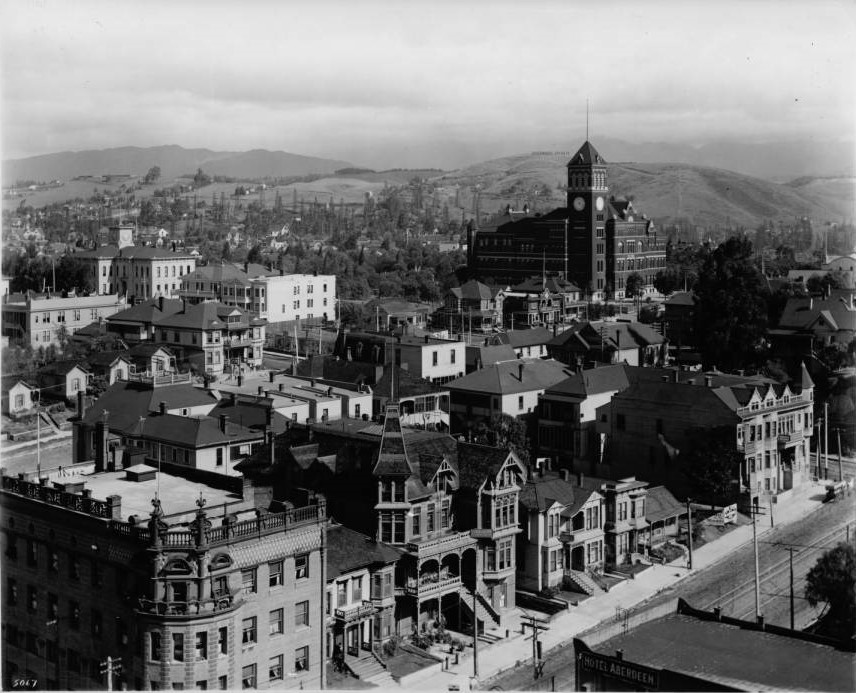 |
|
| (ca. 1905)^^ – Panoramic view looking northwest from the LA County Courthouse. Los Angeles High School stands tall in the background. The Temperance Temple building is seen in the lower-left located on the northwest corner of Temple and Broadway. The Broadway Tunnel is out of frame at right-center. |
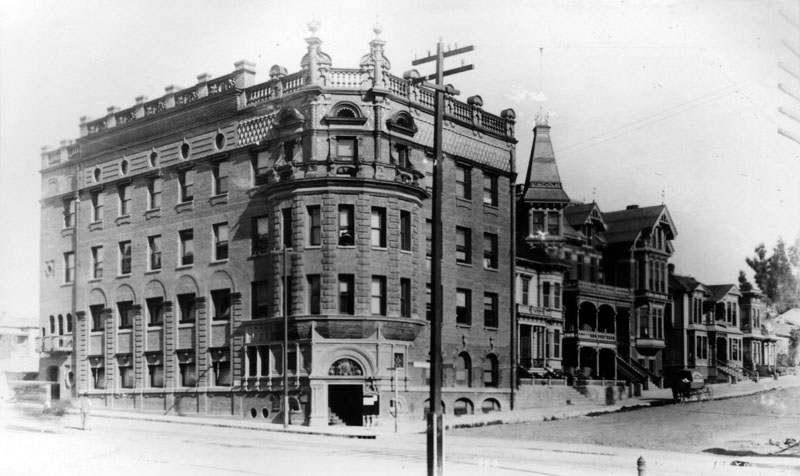 |
|
| (ca. 1890s)^ - Street view of the Temperance Temple of the Women's Christian Temperance Union (WCTU), located at 301 N. Broadway at Temple Street. A horse-drawn carriage is shown parked along the street past the Temple and other neighboring buildings. |
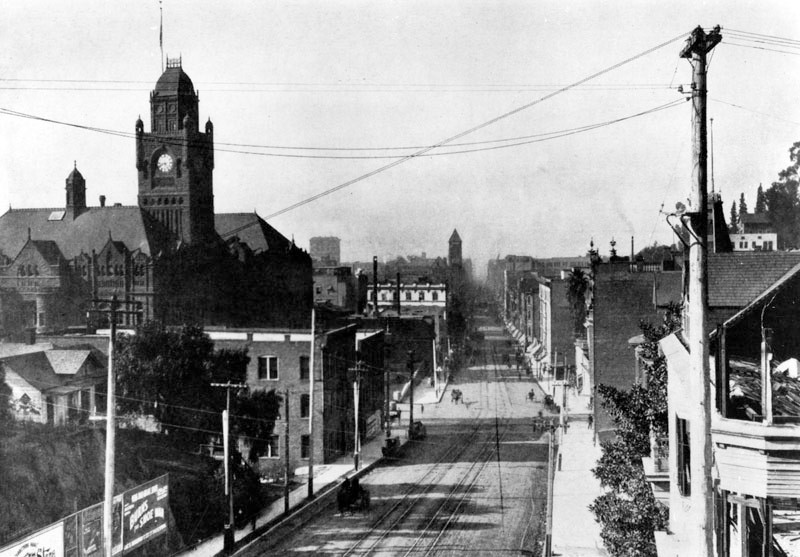 |
|
| (ca. 1900)^ - View of Broadway looking south toward Temple Street, with the County Courthouse on the left. The northern wall of the Temperance Temple Building (N/E corner of Broadway and Temple) is at center-right. City Hall (built in 1888) stands tall in the distance. |
(ca. 1901)* – View looking northwest showing Temple Street as seen from the LA County Courthouse. A horse-drawn carriage and a streetcar can be seen at the intersection of Temple and N. Hill streets at center of photo. The Temperance Temple Building is at lower right.
Historical Notes
At the end of Temple Street can be spotted one of Los Angeles' earliest streetlights. They were carbon-arc lamps mounted on 150-foot tall poles. Click HERE to see more in Early Los Angeles Streetlights.
(ca. 1905)* - View looking northwest from the top of the LA County Courthouse toward the intersection of Temple and North Hill streets. The Hollywood Hills can be seen in the background. Same view as previous photo but 4 years later.
(ca. 1905)* - View showing the Los Angeles County Courthouse located on Poundcake Hill at the southeast corner of Temple and Broadway as seen from the Women's Christian Temperance Union Building across the street. In view are pedestrians, a cable car, horse-drawn buggies, houses and commercial buildings.
Historical Notes
Constructed in 1891, the Los Angeles County Courthouse stood where the city’s first high school, Los Angeles High School, had been located. The high school was there from 1873 until 1886 when it was moved to North Hill Street to allow for construction of the courthouse.
Third Street Tunnel
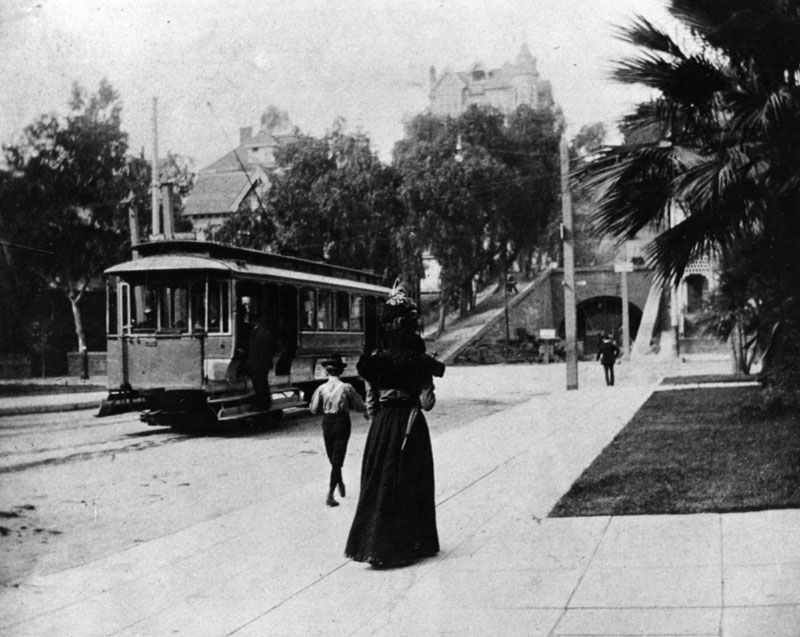 |
|
| (1902)* - View looking west on 3rd St toward Hill St showing the newly completed 3rd Street Tunnel through Bunker Hill. A conductor is seen standing on the outside steps of a streetcar as a woman carrying a parasol and a young boy walk by. Edwin B. Crocker's mansion is seen above on Bunker Hill. Angels Flight has not been built yet. |
Historical Notes On July 3, 1893, residents and taxpayers presented a petition to the Los Angeles City Council asking that a tunnel be created to connect those who lived in the Crown Hill neighborhood with the business district located on this side of Bunker Hill. Their plans called for a tunnel 1080 feet long, with a twenty-six foot roadway and eight foot sidewalks. Nothing happened for five years. In 1898 the City Council ordered the City Attorney to draw up an ordinance putting tunnel bonds in front of the public via a special election. That election was held on July 6, 1898, and funds were approved for both the Third Street and Broadway tunnels. On January 21, 1900, a serious disaster struck. Thirteen men were "entombed" in the tunnel dig after a massive cave-in on the western end. Several were killed in the collapse, but others were trapped inside with only the air in the tunnel. Frantic efforts were made to dig into their position. Ten men were rescued, while three perished. In March of 1901 the tunnel was opened to the public. It was unpaved and unlit. Gutters weren’t installed until 1902. |
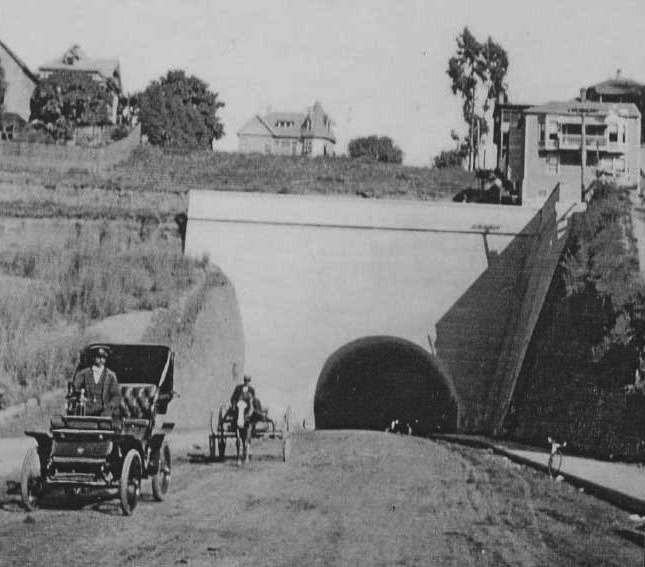 |
|
| (1903)* - View of the western terminus of the Third Street Tunnel. An early model automobile and a horse-drawn carriage can be seen after they exit from the tunnel while a bicycle is parked along the curb. |
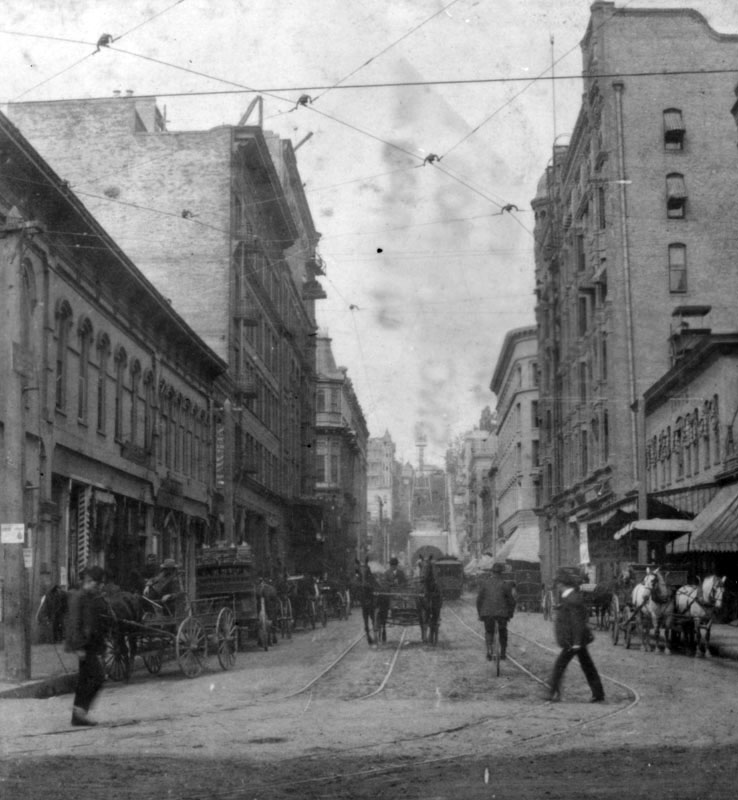 |
|
| (ca. 1901)* - Half of a stereoptic view of 3rd Street, looking west past office buildings to the newly constructed 3rd Street Tunnel under Bunker Hill in the far distance. Horse-drawn vehicles and a streetcar are on the unpaved street. |
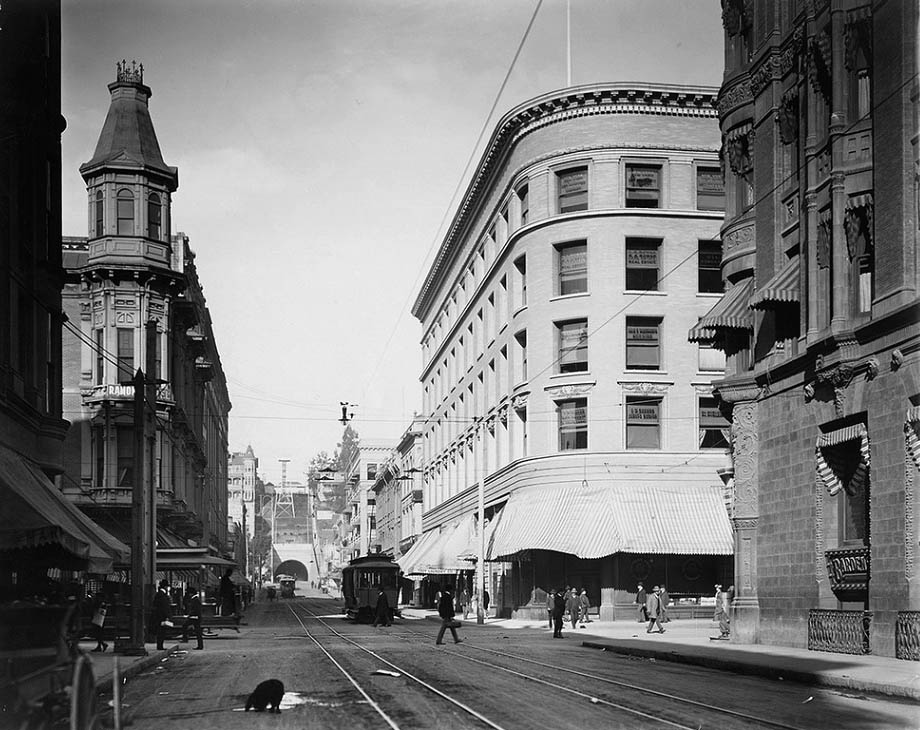 |
|
| (ca. 1901)* - View of 3rd Street looking west from Spring Street. A dog appears to be drinking from a puddle of water in the street (lower left). The 3rd Street Tunnel is seen in the distance with an observation tower perched above it. The Ramona Hotel with the beautiful corner tower is seen on the left, SW corner of 3rd and Spring. |
Historical Notes The Douglas Building, seen on the right (northwest corner) with the large awnings, was constructed in 1899 and still stands today. This Classic Revival style building was declared an LA Historic-Cultural Monument in 2009. Click HERE for contemporary view. |
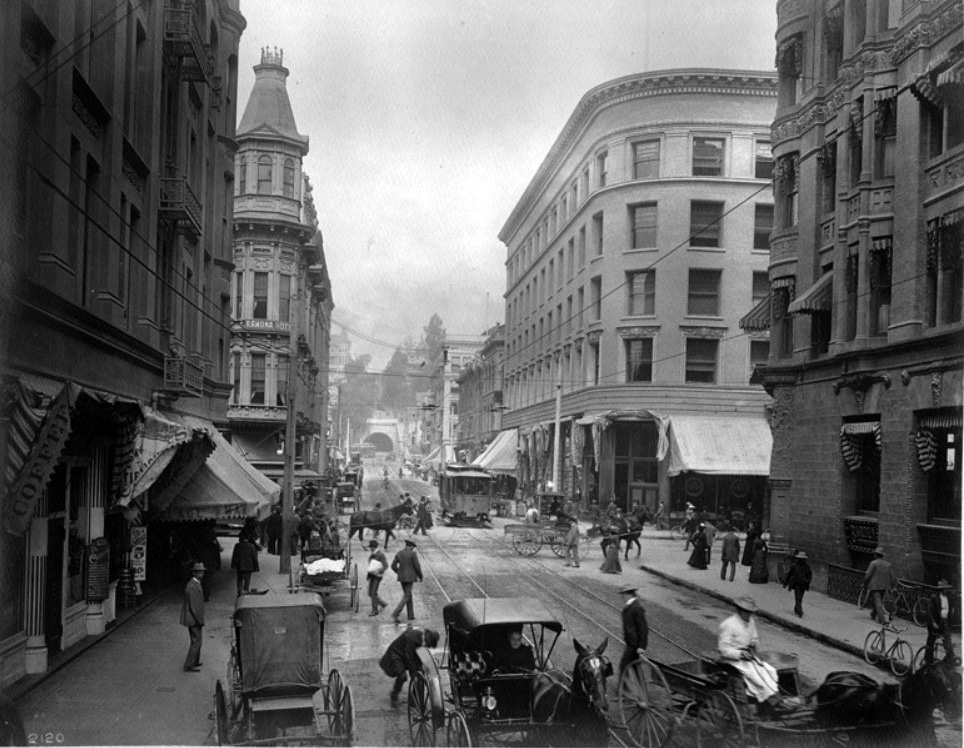 |
|
| (ca. 1901)^ - View looking west on 3rd Street toward Spring Street with the 3rd Street Tunnel seen in the distance. Streetcar, horse-drawn carriages, and pedestrians share the streets. The Ramona Hotel with its 4-story tower can be seen on the SW corner of 3rd and Spring streets. The Douglas Building on the NW corner is still standing today. |
Then and Now
 |
|
| (1901 vs. 2017) - Photo comparison by Jack Feldman. |
Then and Now
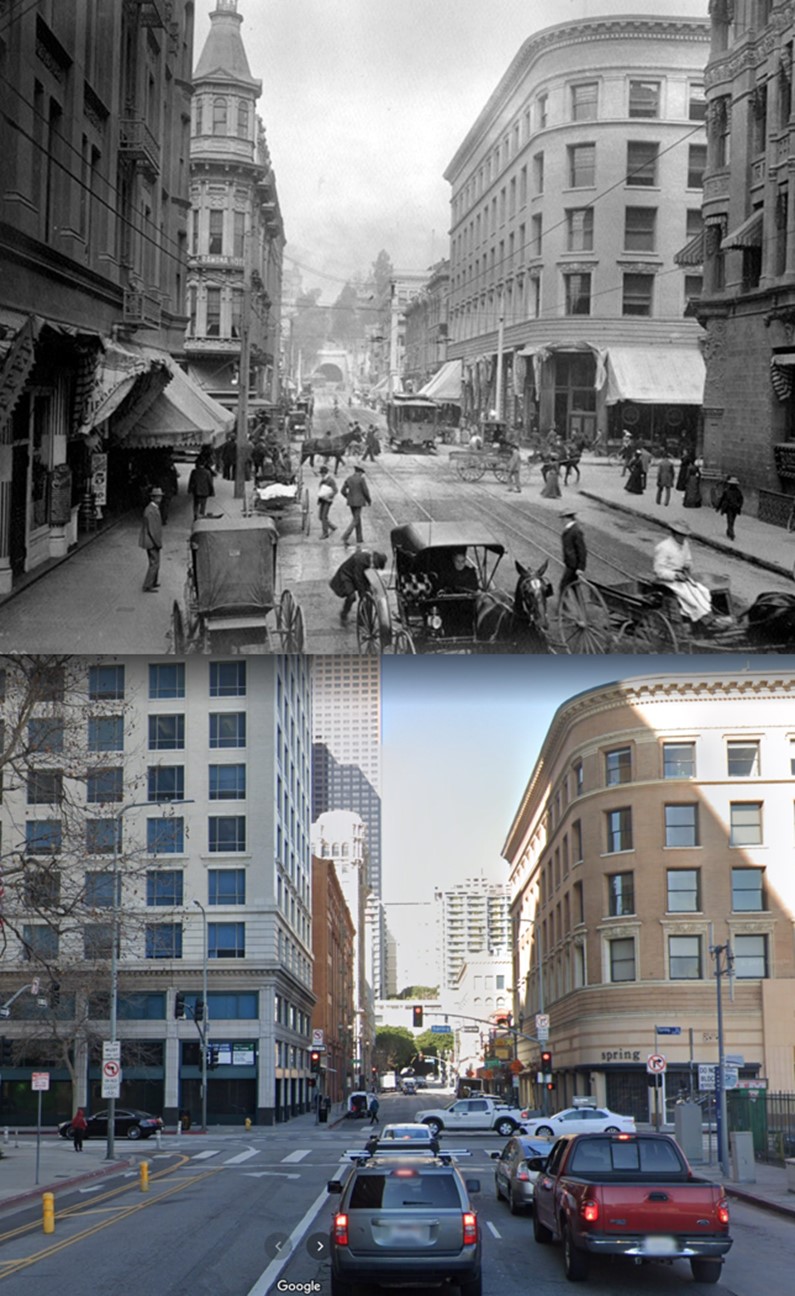 |
|
| (1901 vs 2022)* - Looking west on 3rd Street toward Spring Street with the Third Street Tunnel seen in the distance. Photo comparison by Jack Feldman. |
Historical Notes The reason the Third Street Tunnel looks different and closer in the bottom photo is that, in the late 1960s, as part of the Bunker Hill redevelopment project, the tunnel was lengthened and extended to Hill Street. |
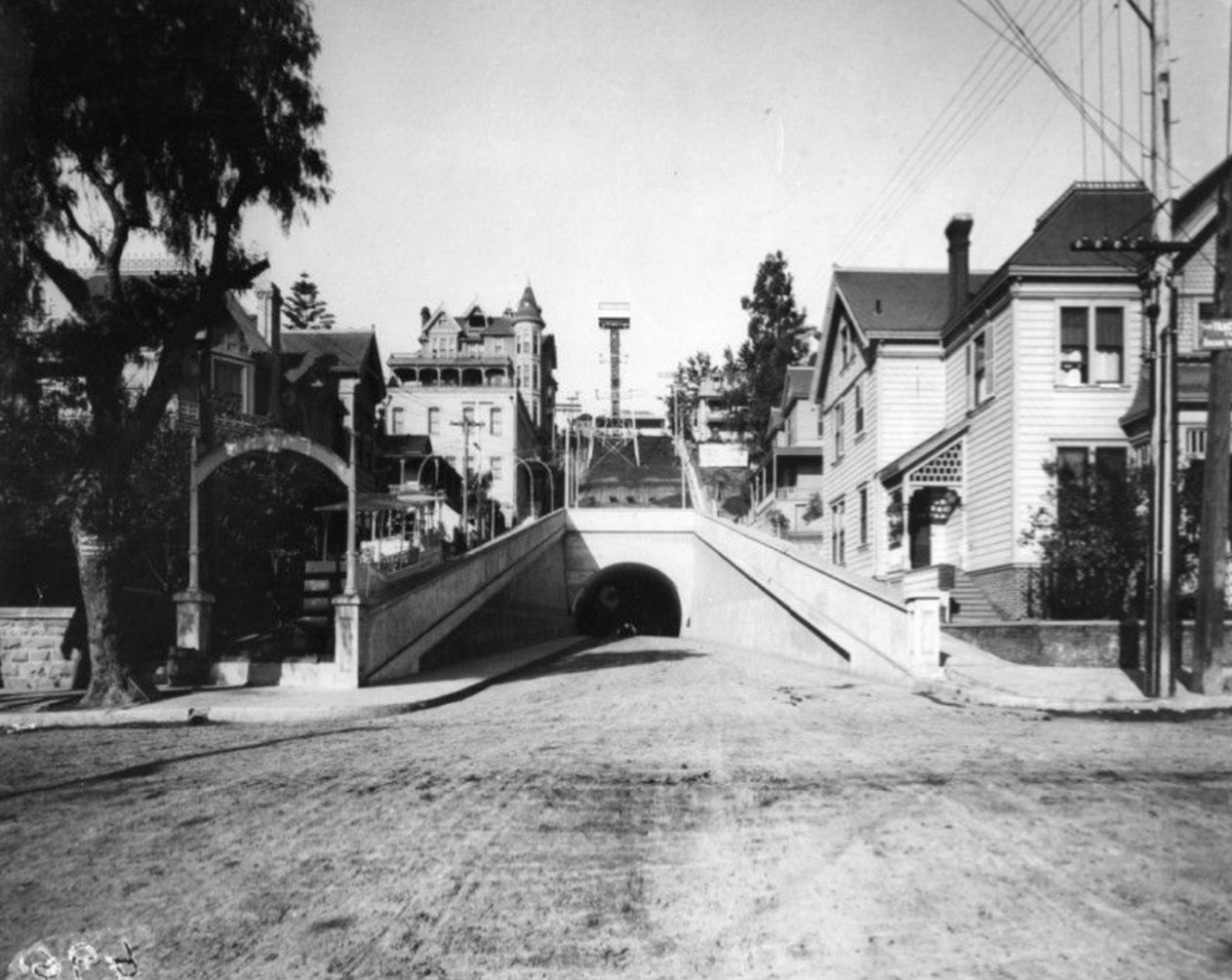 |
|
| (1901)* - View looking west on 3rd Street at Hill Street showing the terminus of the recently completed Third Street Tunnel located at the base of Bunker Hill. Angels Flight, also completed in 1901, is seen on the left. Crocker Mansion stands at the top of Bunker Hill. |
.jpg) |
|
| (ca. 1901)* – Looking west on 3rd Street toward Hill Street showing the Third Street Tunnel and Angels Flight. |
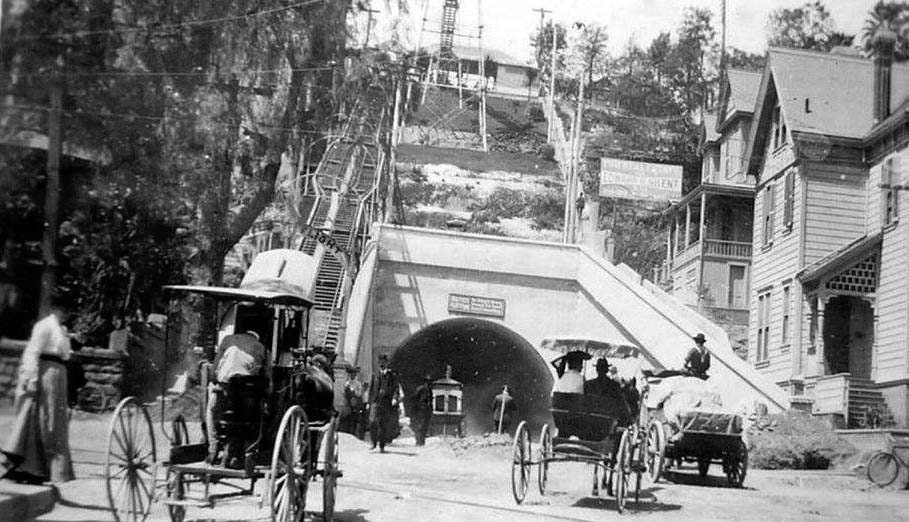 |
|
| (ca. 1905)* – Panoramic view showing a horse-drawn wagon and two horse-drawn carriages heading toward the entrance to the Third Street Tunnel shortly after it opened. On the left can be seen the newly constructed Angels Flight. |
Historical Notes Sign above tunnel entrance reads: "Notice, $50.00 fine for riding or driving through this tunnel faster than a walk". |
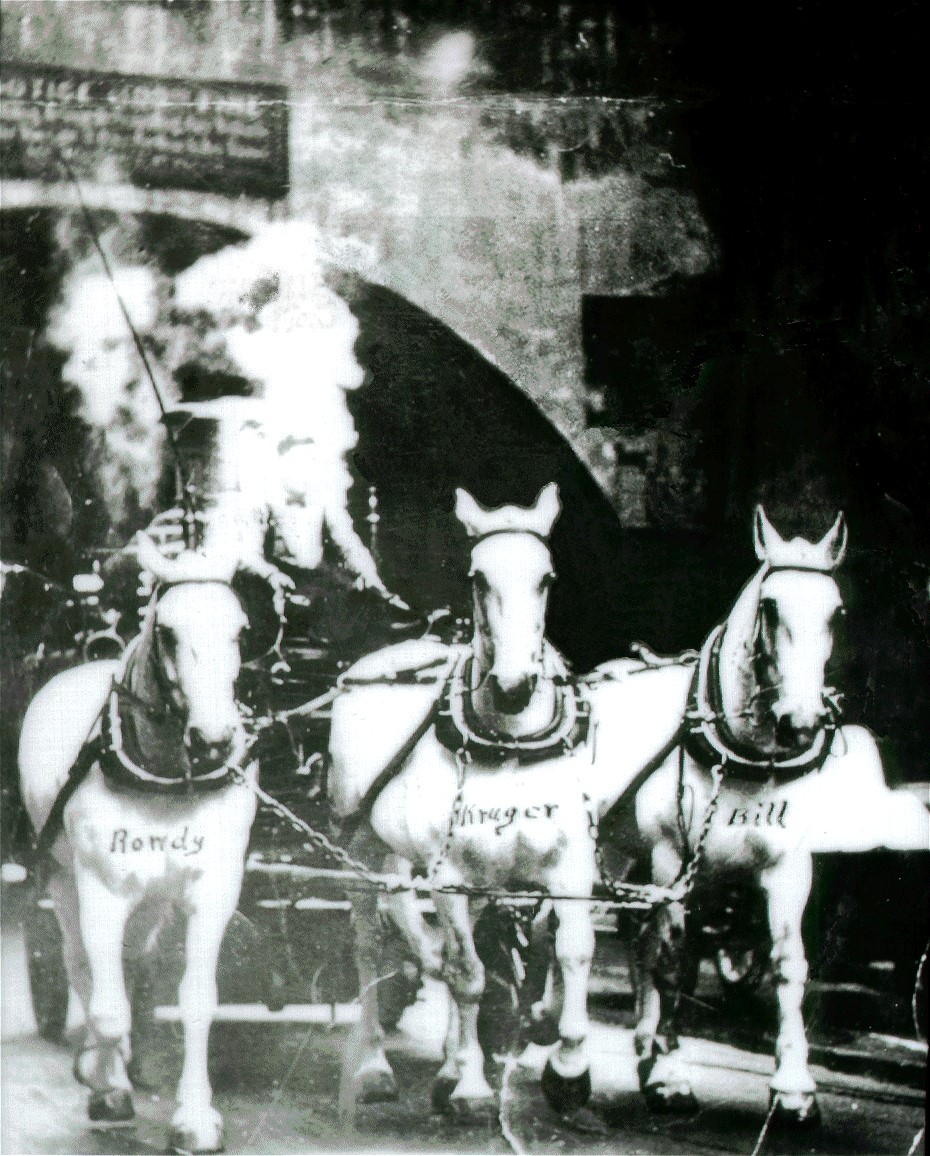 |
|
| (ca. 1904)* - Engine 3, running out of the Third Street Tunnel. The driver is Miller, and the horses are named Rowdy, Kruger, and Bill. Photo Source: LAFD Historical Archive |
Historical Notes The sight of horses racing through the streets to respond to alarms was a common and memorable scene in early Los Angeles. Powered by steam generated from burning coal, the engines used this steam to move pistons that operated water pumps, allowing them to deliver substantial amounts of water to fires. The year 1911 marked a significant transition, as it was the last year all 25 horse-drawn steam fire engines remained in service in Los Angeles. |
Third Street Tunnel - Before and After
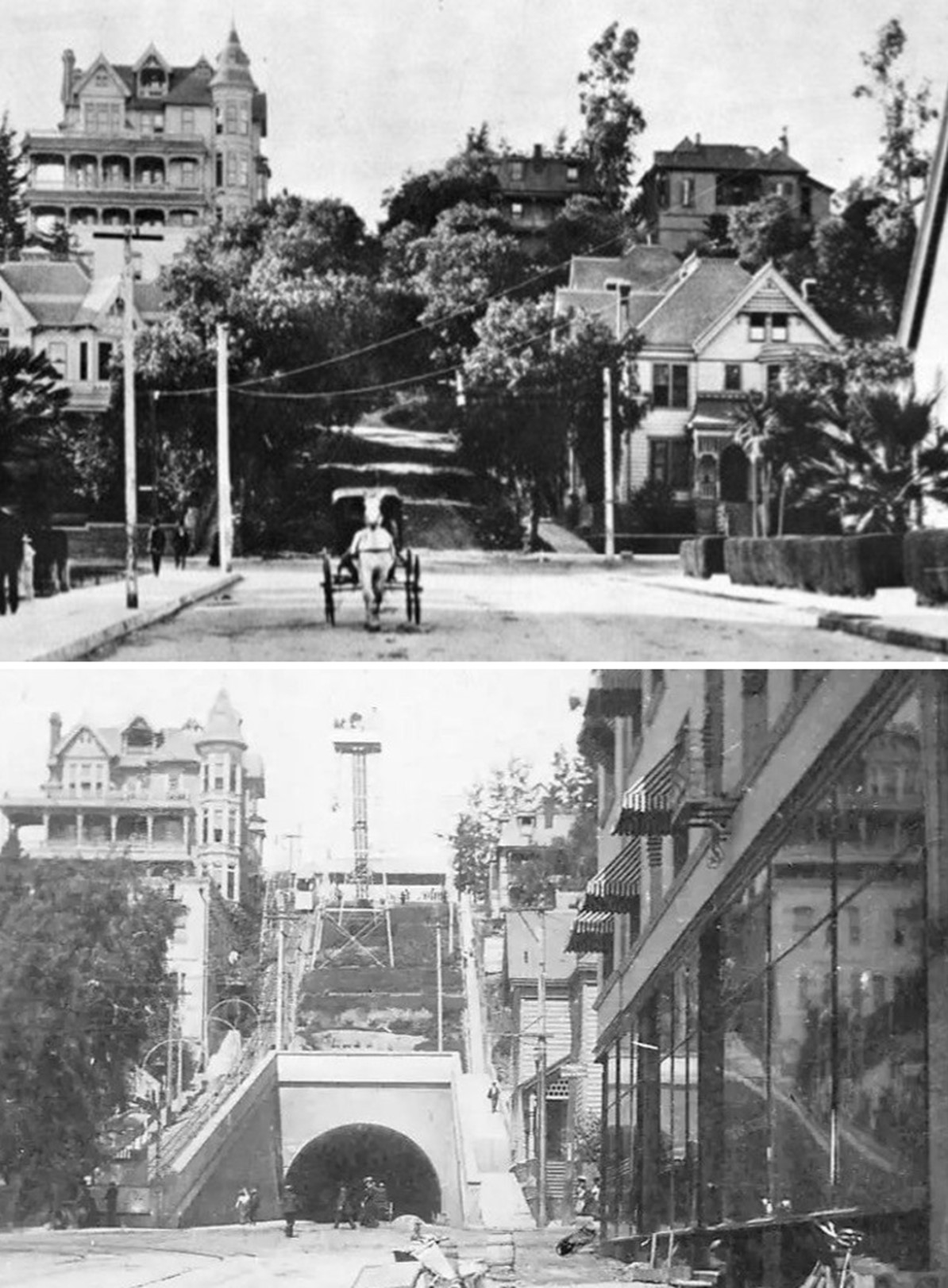 |
|
| (1885 vs. 1901)* – Looking west on 3rd Street toward Hill Street, before and after the construction of the 3rd Street Tunnel and Angels Flight, with the Crocker Mansion seen at the upper left on top of Bunker Hill. Photo comparison by Jack Feldman. |
Before and After
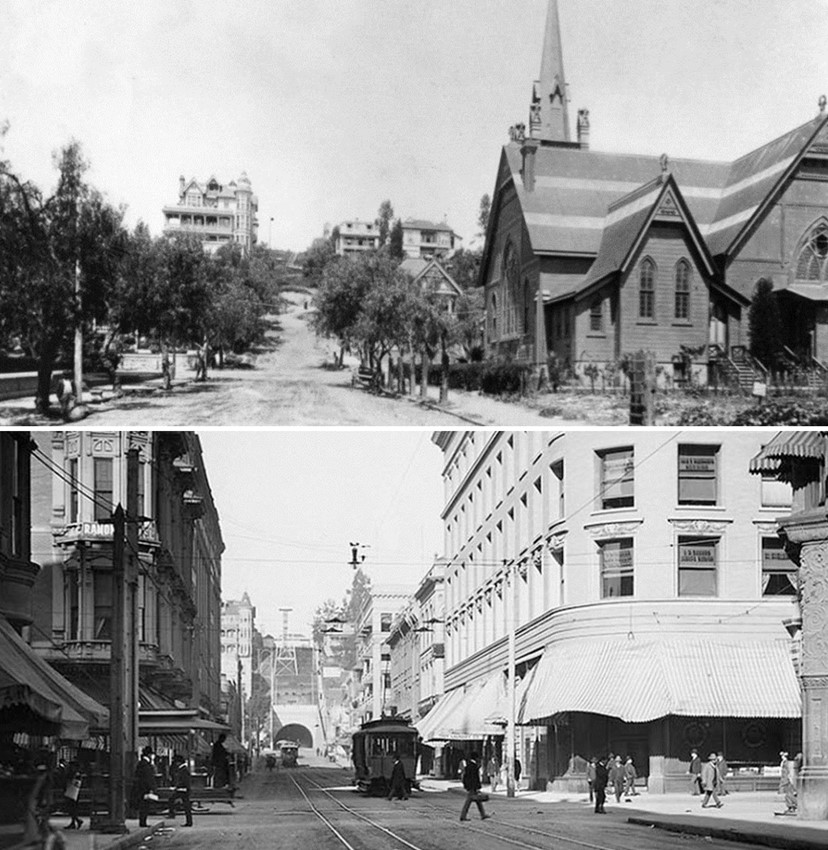 |
|
| (1885 vs. 1901)* – A view looking west on 3rd Street near Spring Street shows Bunker Hill in the distance before and after the construction of the 3rd Street Tunnel and Angels Flight. Photo comparison by Jack Feldman. |
Historical Notes In the 1901 image, the building on the right with the awnings is the Douglas Building, constructed in 1899 and still standing today. This Classic Revival style building was declared an LA Historic-Cultural Monument in 2009. |
Then and Now
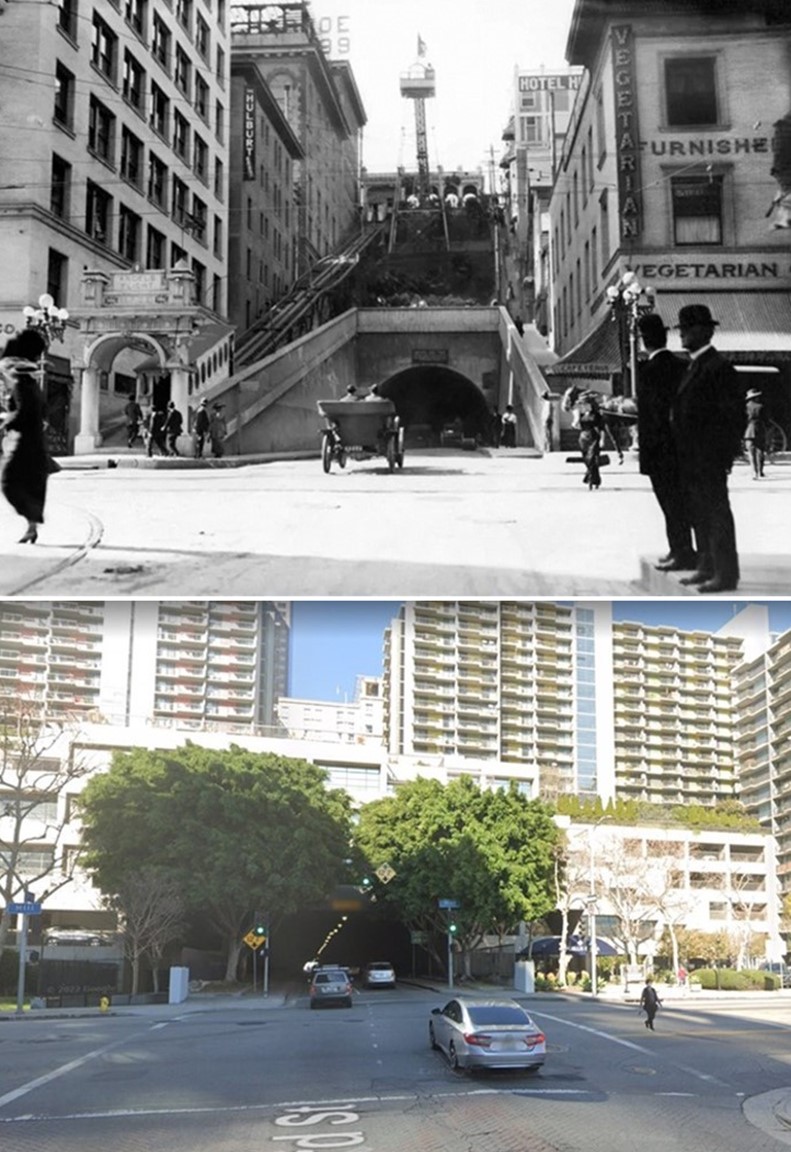 |
|
| (1910s vs. 2022)* - Looking west on 3rd Street at Hill Street, showing the Third Street Tunnel and the earlier location of Angels Flight. Photo comparison by Jack Feldman. |
Historical Notes In the late 1960s, as part of the Bunker Hill redevelopment project, Angels Flight was dismantled (1969) and stored until it was relocated a block further south, where it was eventually reopened in 1996. |
* * * * * |
Angels Flight
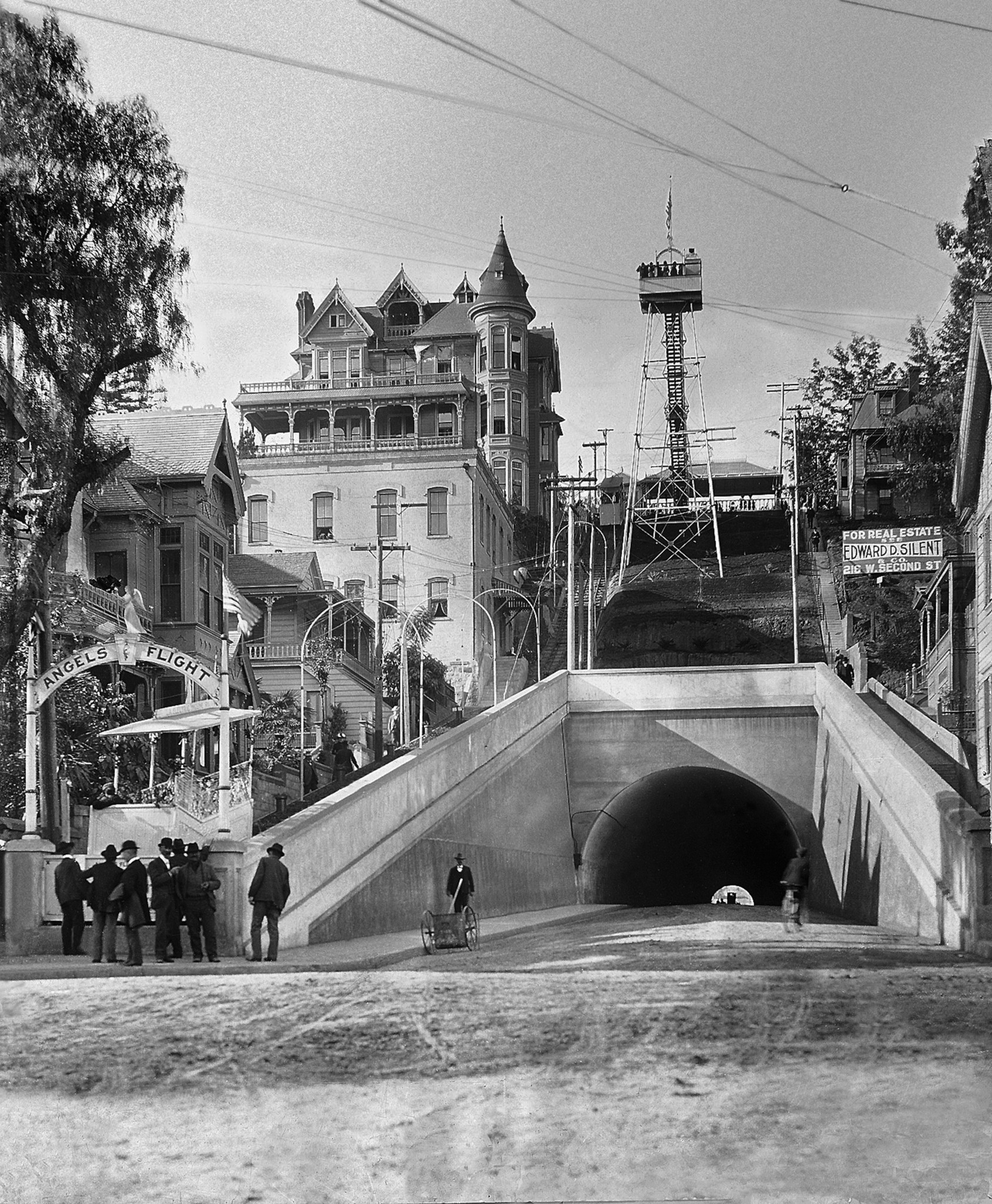 |
|
| (1901)* - Photo of Angels Flight at the grand opening of the incline railway, December 31st, 1901. |
Historical Notes Built in 1901 with financing from Colonel J.W. Eddy, as the Los Angeles Incline Railway, Angels Flight began at the west corner of Hill Street at Third and ran for two blocks uphill (northwestward) to its Olive Street terminus. An observation tower and a 'Camera Obscura' were also constructed on top of the hill adjacent to the Crocker Mansion . A Camera Obscura (Latin: "dark chamber") is an optical device that consists of a box or room with a hole in one side. Light from an external scene passes through the hole and strikes a surface inside, where it is reproduced, rotated 180 degrees (thus upside-down), but with color and perspective preserved. The image can be projected onto paper, and can then be traced to produce a highly accurate representation. |
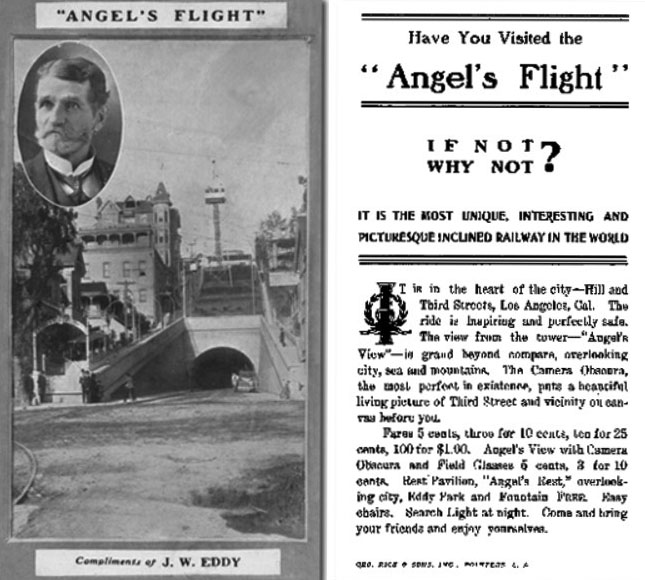 |
|
| (ca. 1901)* – Brochure for Angel’s Flight, compliments of J.W. EDDY. “Have You Visited the Angel’s Flight? If Not Why Not? It is the most unique, interesting and picturesque inclined railway in the world.” |
Historical Notes Brochure reads: "It is in the heart of the city--Hill and Third Street, Los Angeles, Cal. The ride is inspiring and perfectly safe. The view from the tower--'Angel's View'--is grand beyond compare, overlooking city, sea and mountains. The Camera Obscura, the most perfect in existence, puts a beautiful living picture of Third Street and vicinity on canvas before you. Fares 4 cents, three for 10 cents, ten for 25 cents, 100 for $1.00. Angel’s View with Camera Obscura and Field Glasses 5 cents, 3 for 10 cents. Best Pavilion, “Angel’s Rest,” overlooking city, Kiddy Park and Fountain Free. Easy chairs. Search Light at night. Come and bring your friends and enjoy yourselves. A Camera Obscura was also installed in Santa Monica in 1898. Click HERE to see more. |
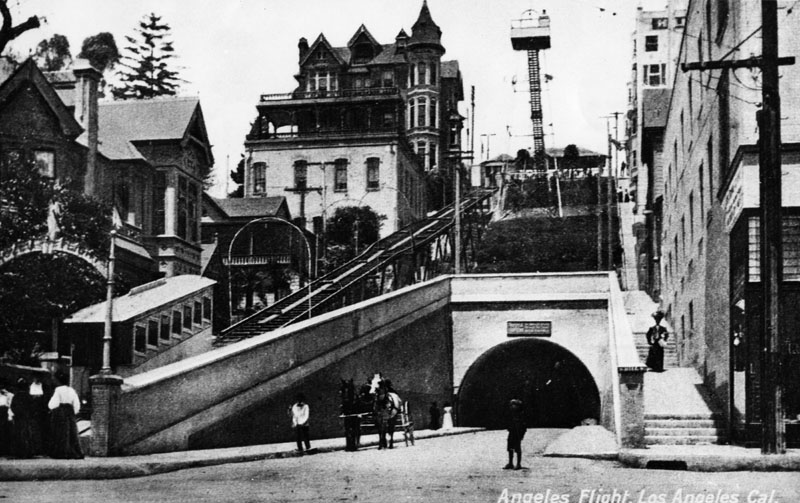 |
|
| (ca. 1905)^ - A view of Third Street looking west. A horse and carriage are seen coming out of the Third Street Tunnel. To the left is the newly constructed Angels Flight. Two cable cars now run up and down making it easier for poeple to traverse the hill. On the right are the 123 steps built to provide an alternate route to the top of Bunker Hill. |
Historical Notes When Angels Flight first opened in 1901, it featured two distinct inclines: a gradual 40-foot climb to Clay Street and a steeper 70-foot ascent to Olive Street. This initial configuration utilized an inclined cable railway on grade and trestle work connecting different street elevations in the Bunker Hill area of Los Angeles (see previous two images). In 1905, the railway underwent a significant transformation, replacing the original two-incline system with a single, uniform 33% grade track supported by timber trestles. The reconstruction also included new cars (Sinai and Olivet) and a three-track system with a mid-point turn-out area, allowing the cars to pass each other with minimal clearance. This redesign established the iconic funicular railway configuration that would become synonymous with Angels Flight's historic character. |
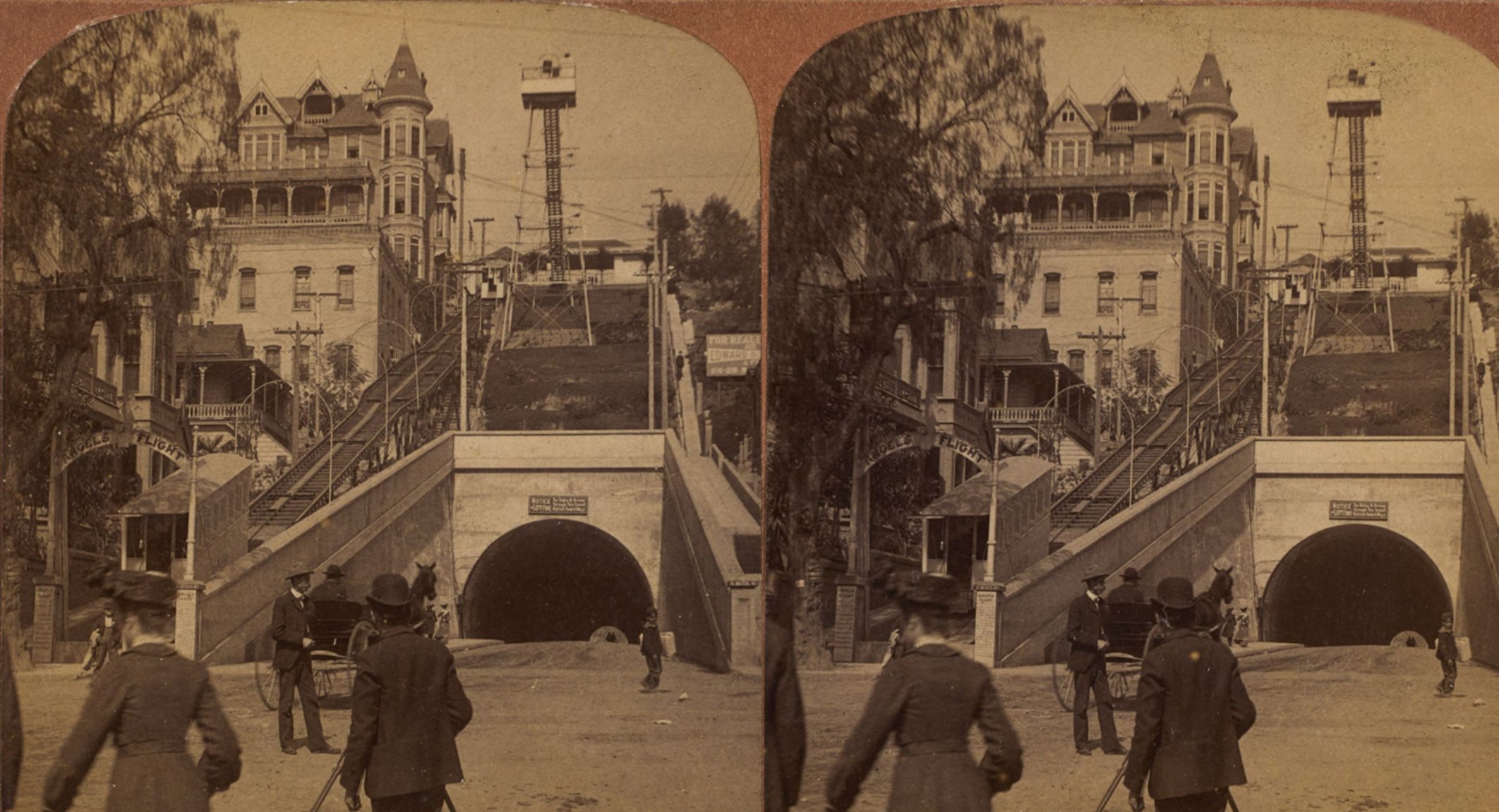 |
|
| (ca. 1905)* – Stereoscopic view of Angels Flight incline railway, showing a car at the base of the tracks near the intersection of Hill Street and Third Street in downtown Los Angeles. The three-story Crocker Mansion is visible at the top left, with the Third Street Tunnel at the center and a sightseeing tower above. Photo from the Ernest Marquez Collection. |
Historical Notes For at least 25 years after Angels Flight opened in 1901, the incline railway featured an observation tower called Angels Rest, built by Colonel James Ward Eddy. This 100-foot tower, located behind the Olive Street railway terminal, offered breathtaking panoramic views of downtown Los Angeles, attracting tourists to the Bunker Hill area and showcasing the city's burgeoning skyline. |
Before and After
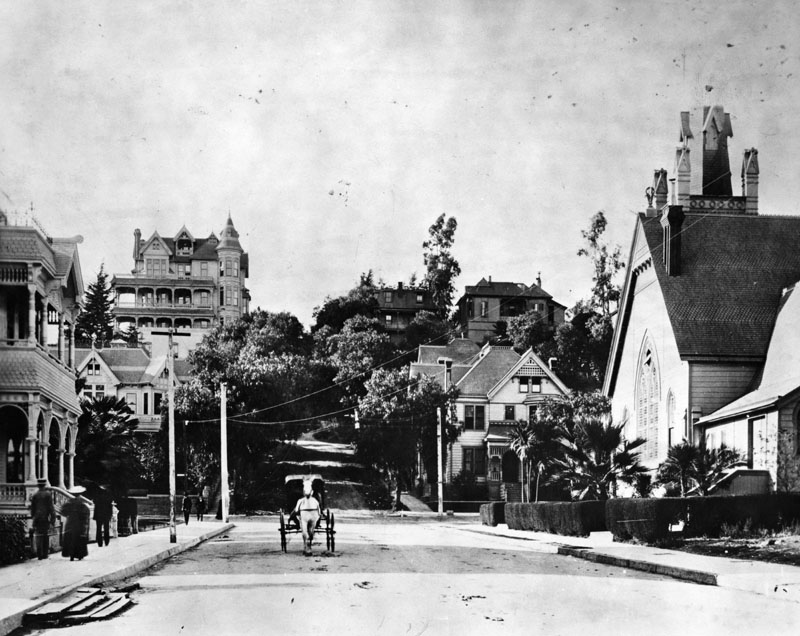 |
 |
|
| (1885 vs. 1905)^ - Before and After |
 |
|
| (1902)* - View looking down from the top of Angels Flight east on Third Street. A woman holding a small dog is posing on the stairway adjacent to the Bunker Hill furnicular. The bottom of the observation tower is seen at right. |
Historical Notes A stairway of approximately 150 steps ran parallel to the Angels Flight funicular railway on Bunker Hill, providing pedestrians an alternative route up the steep urban incline between Hill and Olive Streets during the early 20th century. |
 |
|
| (ca. 1905)* - View showing Angels Flight and observation tower at the 3rd Street tunnel. A horse-drawn carriage approaches the tunnel opening and several pedestrians are on the sidewalk at left. Legible signs include: "Angels Flight", "S. Hill St.", "Notice, $50.00 fine for riding or driving through this tunnel faster than a walk". |
Historical Notes Angels Flight consisted of two vermillion "boarding stations" and two cars, named Sinai and Olivet, pulled up the steep incline by metal cables powered by engines at the upper Olive Street station. As one car ascended, the other descended, carried down by gravity. |
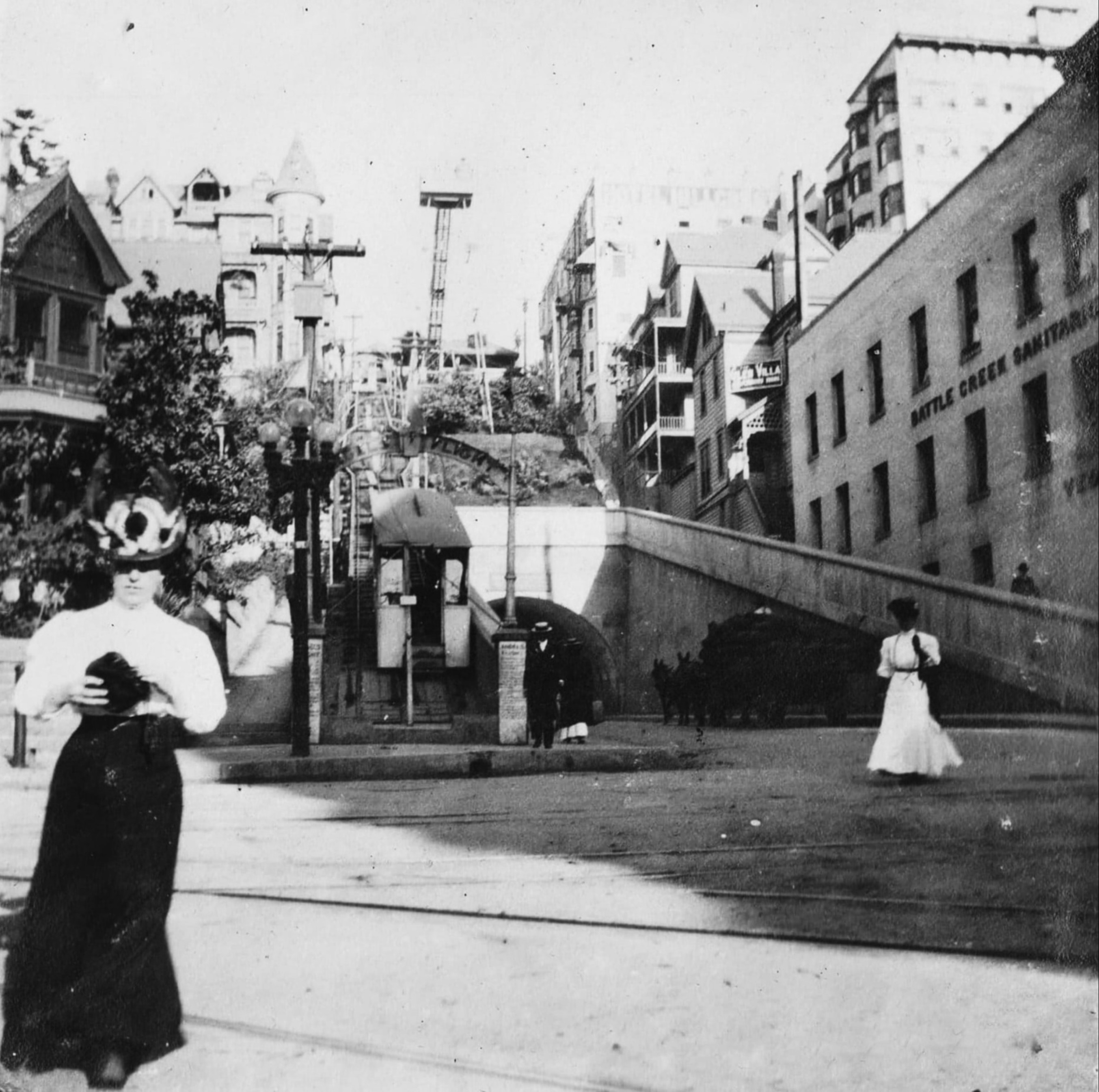 |
|
| (ca. 1905)* - Pedestrians wearing the latest styles cross the street in front of Angels Flight with the 3rd Street Tunnel seen in the background. The sign on the building to the right reads ‘Battle Creek Sanitarium’. This builidng would later be converted into an Apartment House. |
Historical Notes The original Battle Creek Sanitarium was a health resort in Battle Creek, Michigan, founded by the Seventh-day Adventist Church. It was known for its focus on health and wellness and its strict vegetarian diet. |
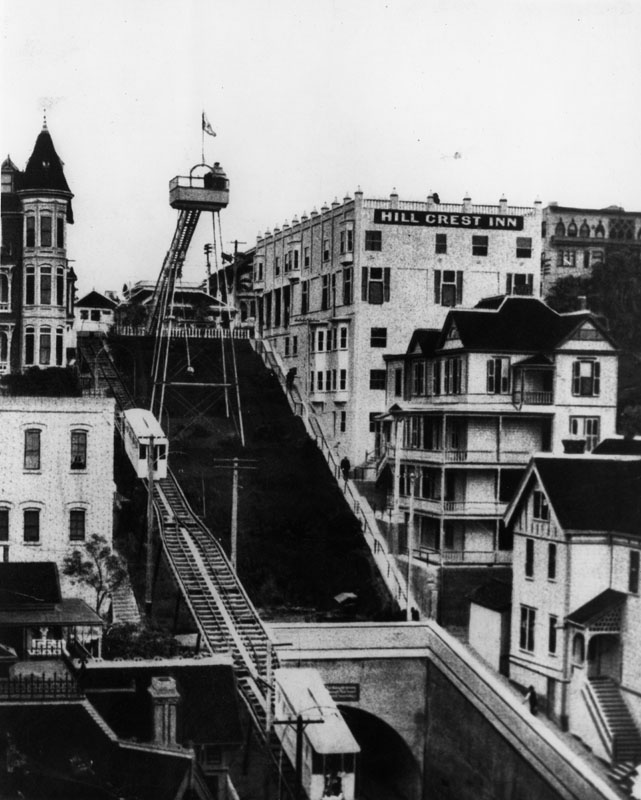 |
|
| (1907)^ - Angels Flight - A view from a nearby roof shows 2 cars on the rail, houses, and Hill Crest Inn on the right side, the observation tower above in the middle, and the Third Street Tunnel below. There is a partial view of the Crocker Mansion on the left. |
Historical Notes When the construction on the Third Street tunnel began in 1900, Mrs. Crocker filed a petition claiming that the mansion was endangered by the street tunnel which was “unsafe, improperly constructed and a veritable death trap.” According to the Los Angeles Times, “the walls of her house are settling, the foundations giving way and the plaster is falling off…Unless something is done, the building is liable to topple into a hole.” The house never did topple and was alive and well in 1902 when Angels Flight began operating and dropping riders off practically on the Crocker doorstep. The Victorian building was razed in June 1908 and the cornerstone for the Elk’s Annex was laid the following September. |
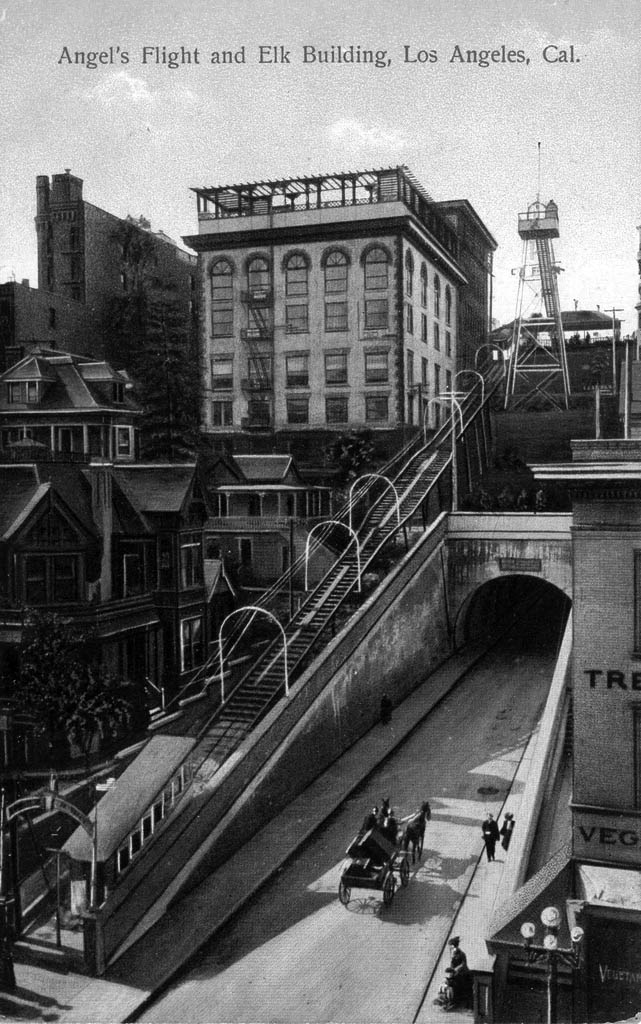 |
|
| (ca. 1910)* - Postcard view showing Angels Flight and the newly construct Elk Building where the Crocker Mansion once stood. A horse-drawn wagon is about to enter the 3rd Street Tunnel. |
Historical Notes The Elks Lodge No. 99 building on Bunker Hill in Los Angeles has a rich history dating back to 1908-1910. Strategically located at the upper terminal of the Angels Flight funicular railway, it was built to host the 1909 national Elks gathering. The main building on Clay Street housed various facilities, including an auditorium and dormitories, while an annex on South Olive Street provided additional amenities. The Elks' presence was closely tied to Angels Flight, with the railway even incorporating the organization's initials into its lower arch. However, the Elks' time on Bunker Hill was brief; by 1925, they had moved to larger quarters near Westlake Park. The buildings were then taken over by the Loyal Order of Moose, reflecting the dynamic urban development of early 20th century Los Angeles. |
 |
|
| (ca. 1910)* - View of Angels Flight and the 3rd Street Tunnel. The new Elks Building has now replaced Crocker Mansion. A woman is seen walking down the stairs on the right. |
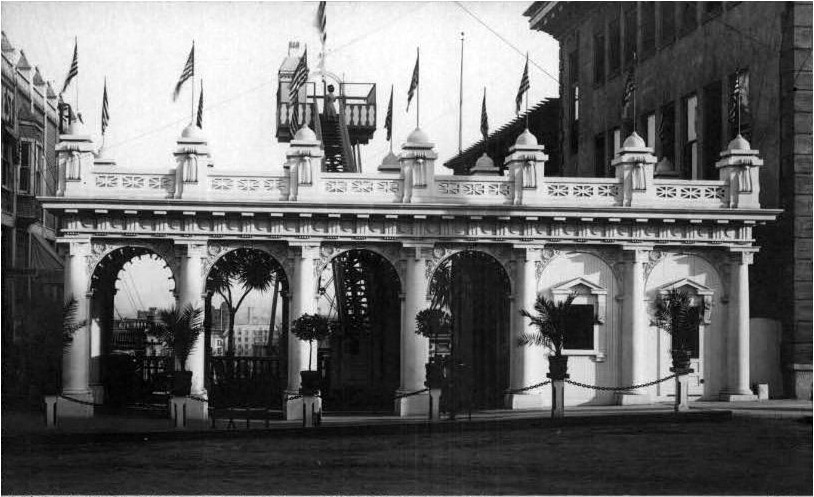 |
|
| (ca. 1910)* - View of Angels Flight's new terminal at the top of the hill on Olive and Third St. The observation tower is seen in the background with a woman standing on its platform. |
Historical Notes When Angels Flight - "the shortest railroad in the world" - first opened in 1901, there was only a small shelter at the top; in 1910, a larger and permanent depot was built. |
 |
|
| (Early 1900s)^ - Standing at the top of Olive Street just under the observation tower, the cable car is descending on the right of the picture. Straight ahead you can see several blocks down 3rd St., which is filled with cars. |
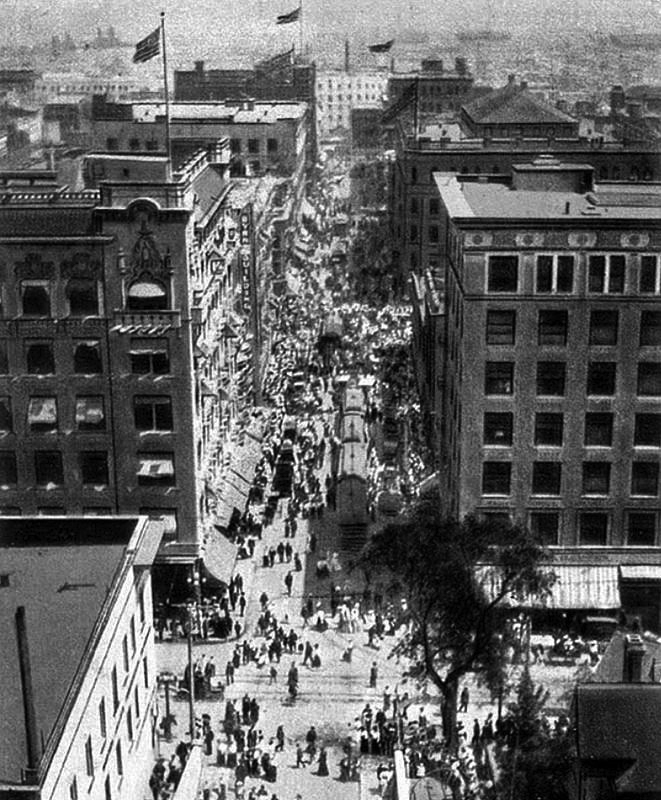 |
|
| (Early 1900s)* – Postcard view looking east on 3rd Street as seen from the observation tower at the top of Angels Flight. |
 |
|
| (ca. 1907)^ - Seen from directly across Hill Street are, from left to right, Marsden Drug Co., the arch for Angels Flight, 3rd Street Tunnel with observation tower at the top of the hill, Vegetarian Cafeteria with a horse-drawn wagon in front, and the YWCA Building with top floors visible. |
Historical Notes An archway labeled "Angels Flight" greeted passengers on the Hill Street entrance, and this name became the official name of the railway in 1912 when the Funding Company of California purchased the railway from its founders. |
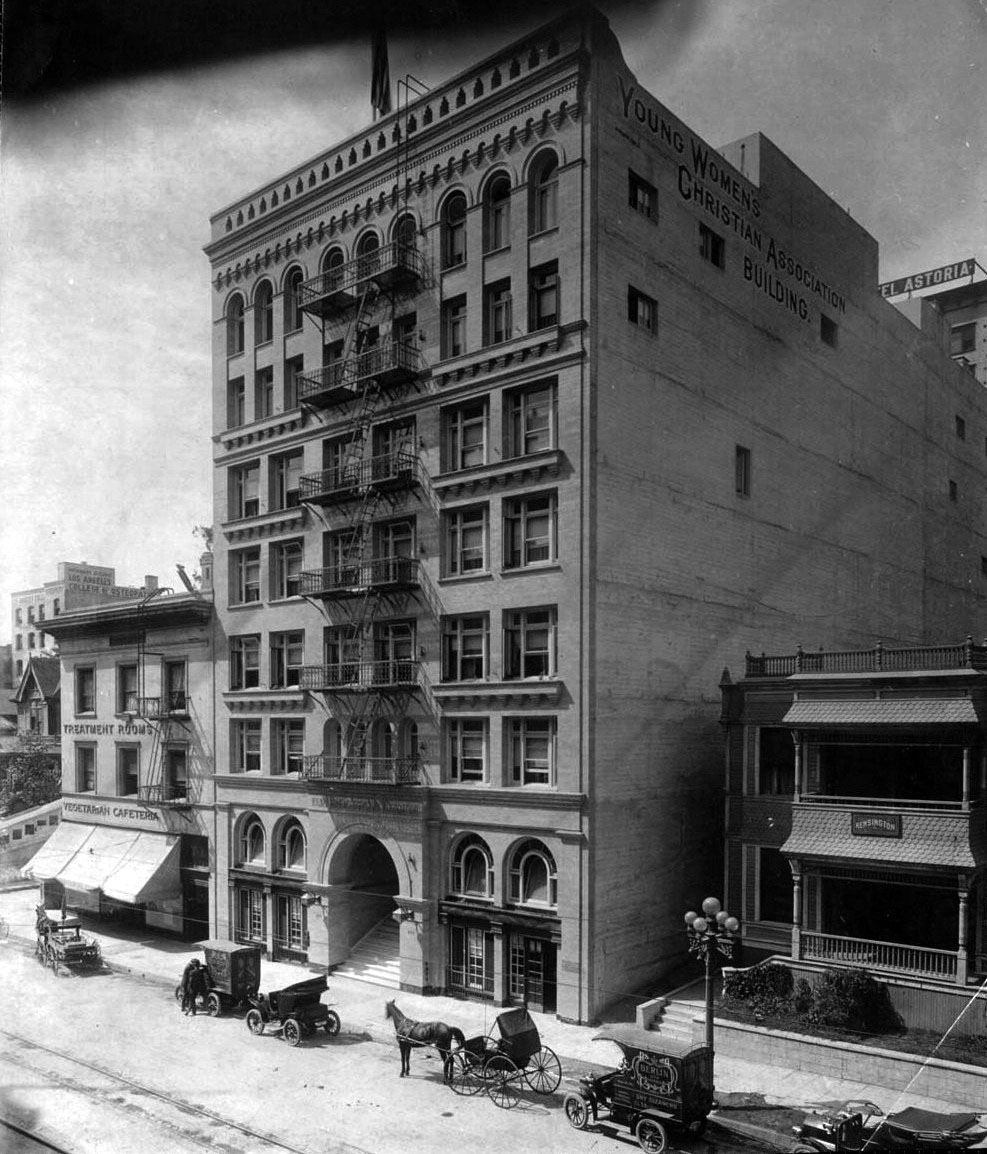 |
|
| (ca. 1907)^ - View of the west side of Hill Street showing the YWCA Building. Several horse-drawn wagons, early model cars and trucks are parked along the curb. The 3rd Street tunnel is just to the left of the 'Vegetarian Cafeteria'. Across Third Street can be seen one of the two Angels Flight cars stopped at the lower terminus. |
 |
|
| (ca. 1910)* - Looking toward the Third Street Tunnel and Angels Flight as seen from near the NE corner of 3rd and Hill. The Vegetarian Cafeteria is on the ground floor of the building on the NW corner. |
Then and Now
 |
|
| (1910s vs. 2022)* - Looking west on 3rd Street at Hill Street, showing the Third Street Tunnel and the earlier location of Angels Flight. Photo comparison by Jack Feldman. |
Historical Notes In the late 1960s, as part of the Bunker Hill redevelopment project, Angels Flight was dismantled (1969) and stored until it was relocated a block further south, where it was eventually reopened in 1996. |
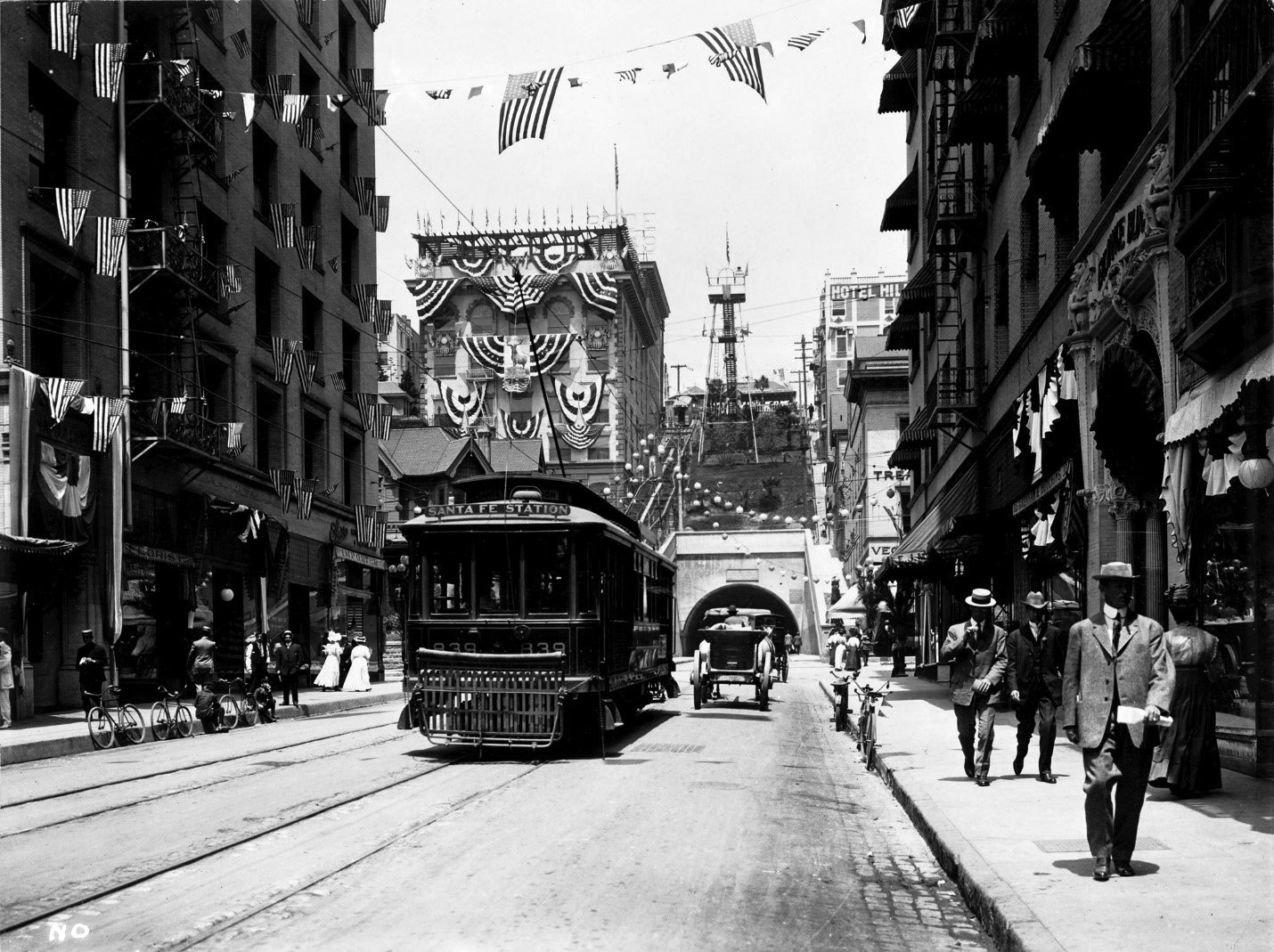 |
|
| (1910)* - View looking west toward the 3rd Street Tunnel and Angels Flight showing a streetcar sharing the road with horse-drawn wagons and cars while bycicles are parked along the curb. American flags and banners are seen throughout (probably in honor of 4th of July). Photo Martin Behrman |
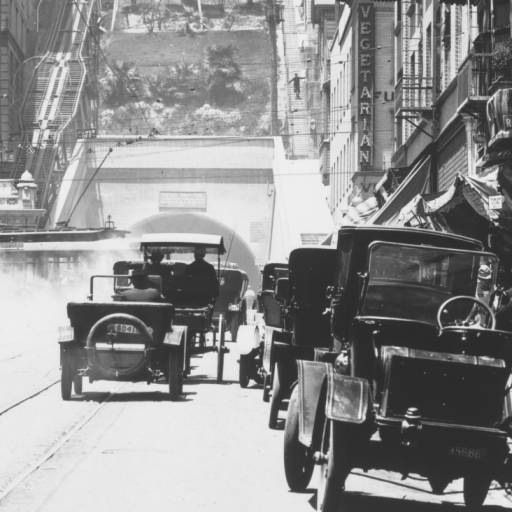 |
|
| (ca. 1910)* - Autos and horse-drawn carriage are heading toward the 3rd St. Tunnel. Angels flight can be seen in the upper left. Cars are parked along the curb fronting commercial storefronts. A large sign for the Vegetarian Cafeteria can be seen on the building located on the northwest corner of 3rd and Hill. |
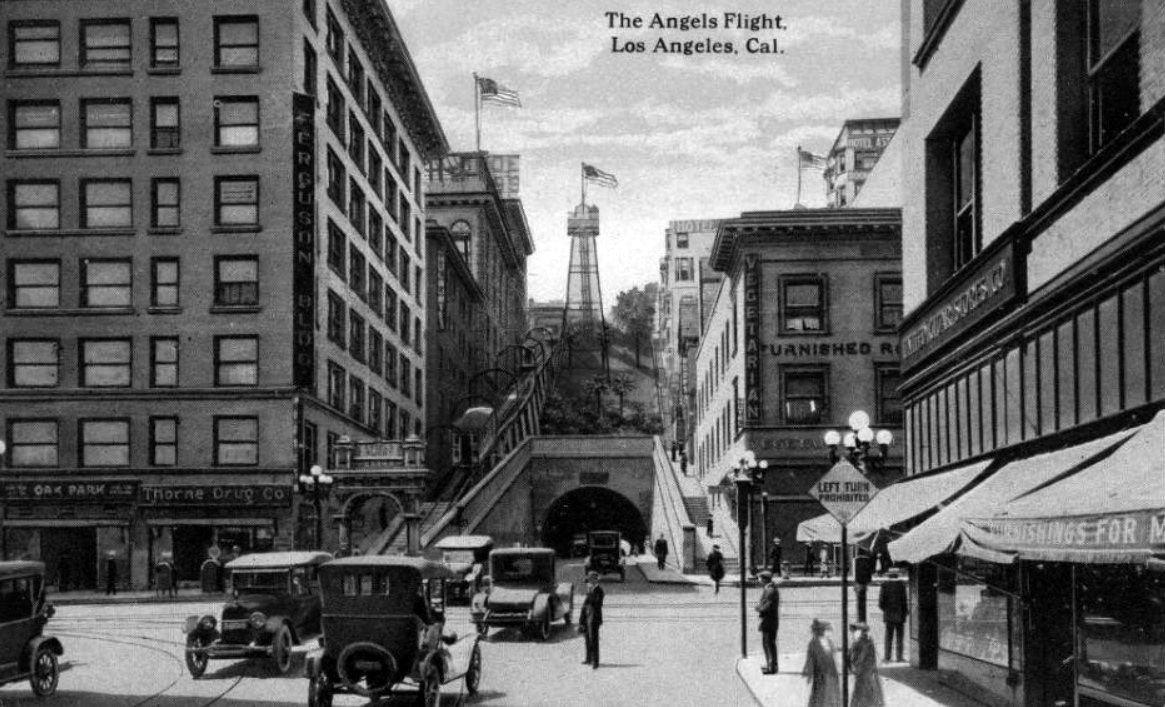 |
|
| (ca. 1913)* – Postcard view showing Angels Flight with traffic flowing in and out of the Third Street Tunnel. Sign on right reads: LEFT TURN PROHIBITED. |
 |
|
| (ca. 1915)* – View showing a newspaper boy standing next to a traffic officer in the middle of the intersection at 3rd and Hill streets. Angels Flight and the Third Street Tunnel are in the background. |
 |
|
| (1919)* – View looking east toward the intersection of 3rd and Hill streets as seen from the top of the staircase railing opposite Angels Flight. Notice the Vegetarian Cafeteria on the left, which is seen in other pictures but from across the intersection, looking west towards the 3rd Street Tunnel and Angels Flight. |
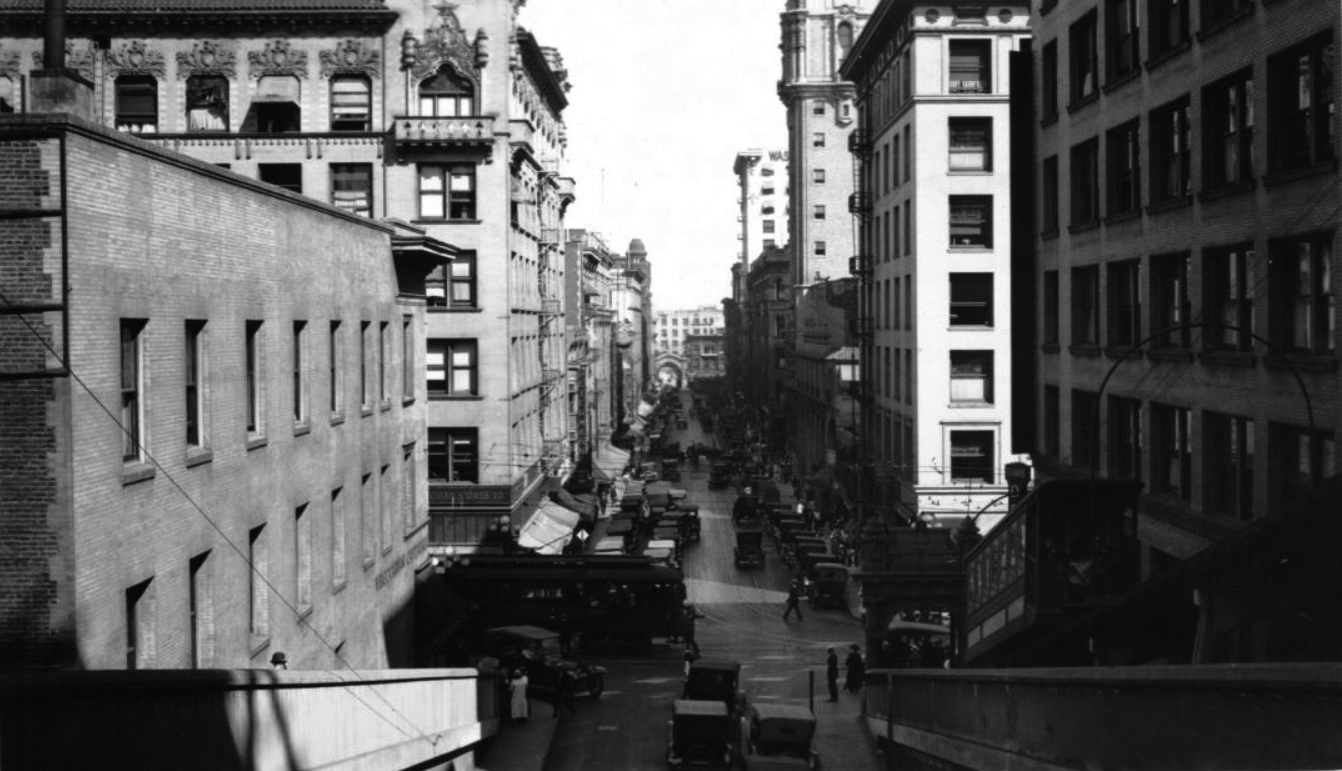 |
|
| (1922)* – View looking looking east along 3rd Street from east portal of the Third Street Tunnel with Angels Flight on the right. |
Historical Notes Click HERE to see more early views of Angels Flight. Click HERE to see more early views of the Third Street Tunnel. |
* * * * * |
Aliso Street
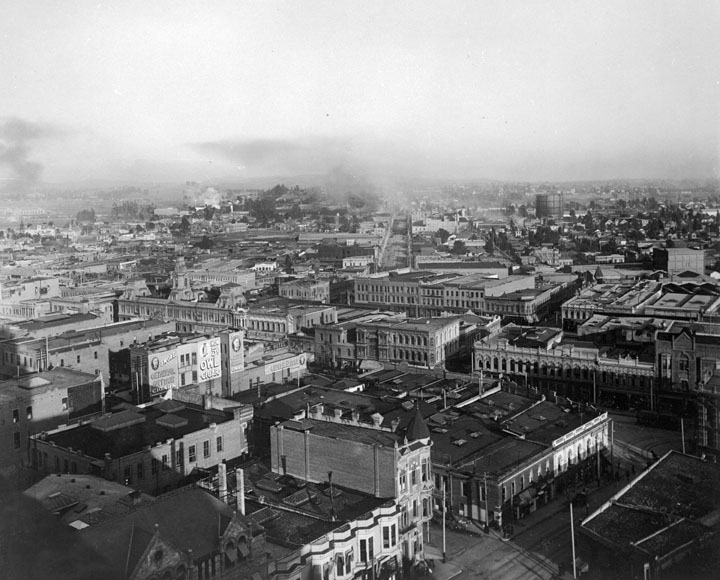 |
|
| (Early 1900s)^ - Los Angeles historical view looking northeast showing the heart of downtown in early 1900s. Aliso Street runs diagonally away from the center of photo. |
Historical Notes The wide avenue in the background pointing almost straight at us is Aliso Street, which today is the alignment of the 101 freeway east of the Civic Center. It turns slightly to the viewer’s left then and becomes The Slot as it passes through the site of the Baker Block - that long building at center-left with the three large cupolas, located on the 300 block of Main Street. Down at the lower right can be seen a portion of Temple Square - the "Times Square" of old L.A. And at the extreme right edge you can just barely see a corner of the Temple Block - one of the most important buildings in the early political and commercial life of the city.^^# |
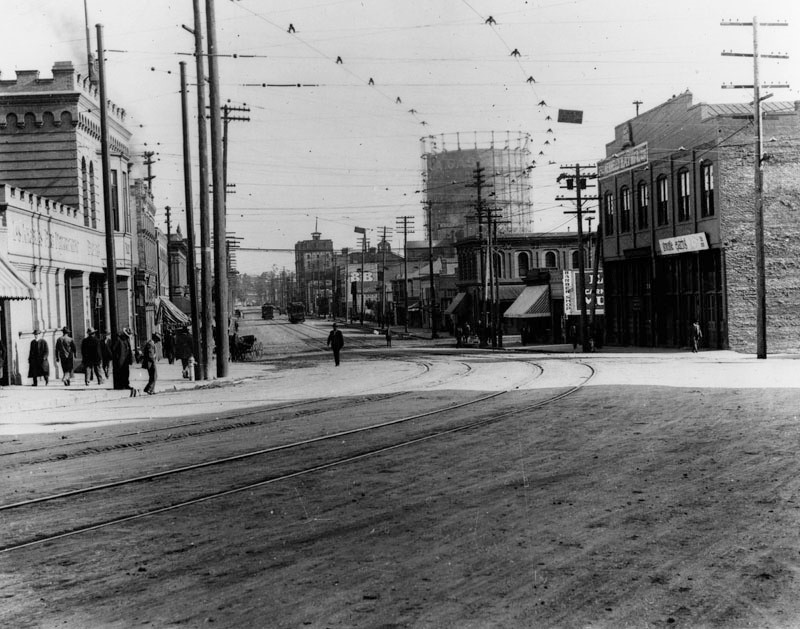 |
|
(ca. 1900)^ - View looking northeast along Aliso Street from San Pedro Street. Street cars and a gas storage tank (aka 'Gasometers') are seen in the background. On the left is a Los Angeles Fire Station. On the right, second building, is a barber shop. A few horse and buggies are waiting at the curb. Today, the 101 Freeway runs in alignment with Aliso St. |
* * * * * |
Los Angeles Camera Club
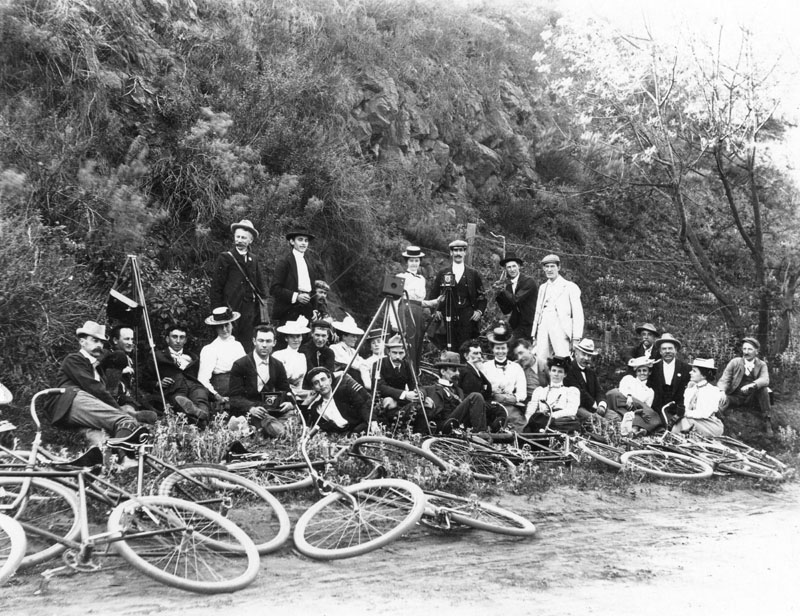 |
|
| (Early 1900s)^ - Members of the Los Angeles Camera Club relax next to their bicycles on a dirt road. The club's outings took place at the beginning of the 20th century. |
Historical Notes A Mr. Sturdevant put in a notice calling the first meeting; only three showed up. Then Carl K. Broneer put in another notice, and ten camera enthusiasts showed up at the office of the Los Angeles and Pasadena Electric Railway, 222 West 4th Street, where he was office boy. Then Mr. Valentine, assistant to Frank Wiggins, director of the Los Angeles Chamber of Commerce, moved the meeting to the chamber director's office. From that time on the club grew by leaps and bounds and signed a lease for the top floor of the Wright & Callender Building on Hill Street.^ |
Early Modes of Transportation
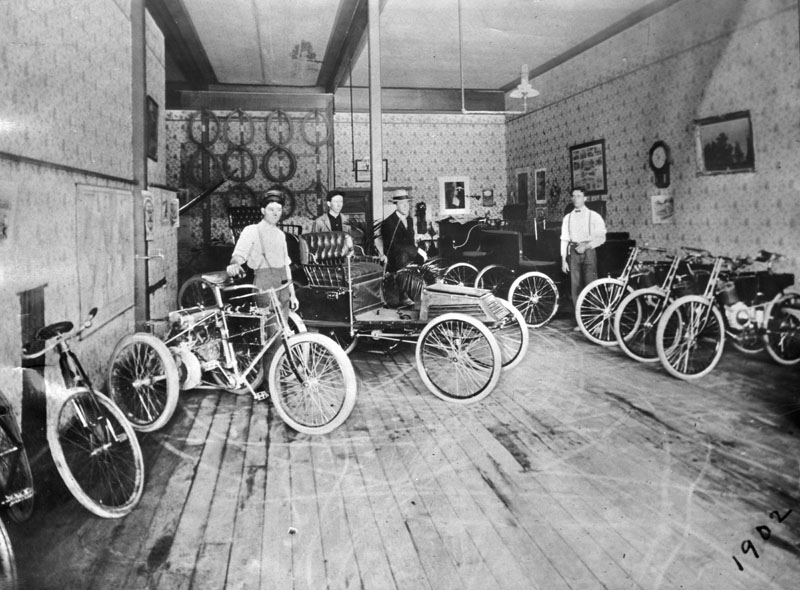 |
|
| (1902)* - Employees stand by early motorcycles and "horseless carriages" that are parked on a wooden floor in this view of Ralph Hamlin's wallpapered salesroom on Main St. Inner tubes hang on the wall in back. Photo caption reads: "This was Hamlin's salesroom in 1902, located at 1837 South Main street. Hamlin was born in San Francisco and was brought to Los Angeles by his parents at the age of six." |
 |
|
| (ca. 1902)^ - This picture shows a man driving a Waverley Electromobile car on Spring Street (looking north from 8th Street). Behind him on the left the Copeland Building tower (also called the Armory Building) can be seen. On the right side (east side of Spring) a sign for the Corum Paper Box Factory is visible on the side of a building. |
Historical Notes By the turn of the century, America was prosperous and cars, now available in steam, electric, or gasoline versions, were becoming more popular. The years 1899 and 1900 were the high point of electric cars in America, as they outsold all other types of cars. One example was the 1902 Phaeton built by the Woods Motor Vehicle Company of Chicago, which had a range of 18 miles, a top speed of 14 mph and cost $2,000. Later in 1916, Woods invented a hybrid car that had both an internal combustion engine and an electric motor.#* |
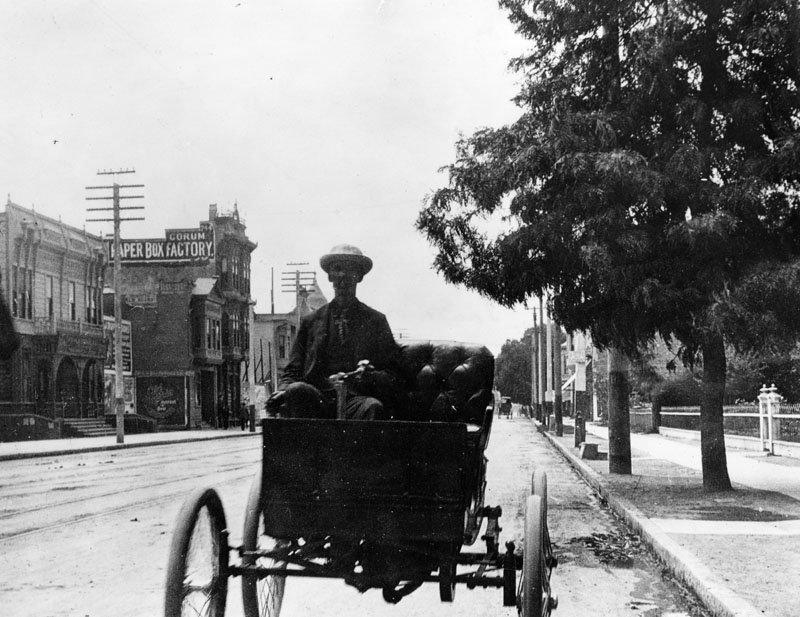 |
|
| (1902)^ - View of a man driving a Waverley Electromobile car on Spring St. (looking south near 8th St.). Behind him on the left (east side of Spring) a sign for the Corum Paper Box Factory is visible on the side of a building. |
Historical Notes Electric vehicles had many advantages over their competitors in the early 1900s. They did not have the vibration, smell, and noise associated with gasoline cars. Changing gears on gasoline cars was the most difficult part of driving, while electric vehicles did not require gear changes. While steam-powered cars also had no gear shifting, they suffered from long start-up times of up to 45 minutes on cold mornings. The steam cars had less range before needing water than an electric's range on a single charge.#* |
Los Angeles Examiner (1st Building)
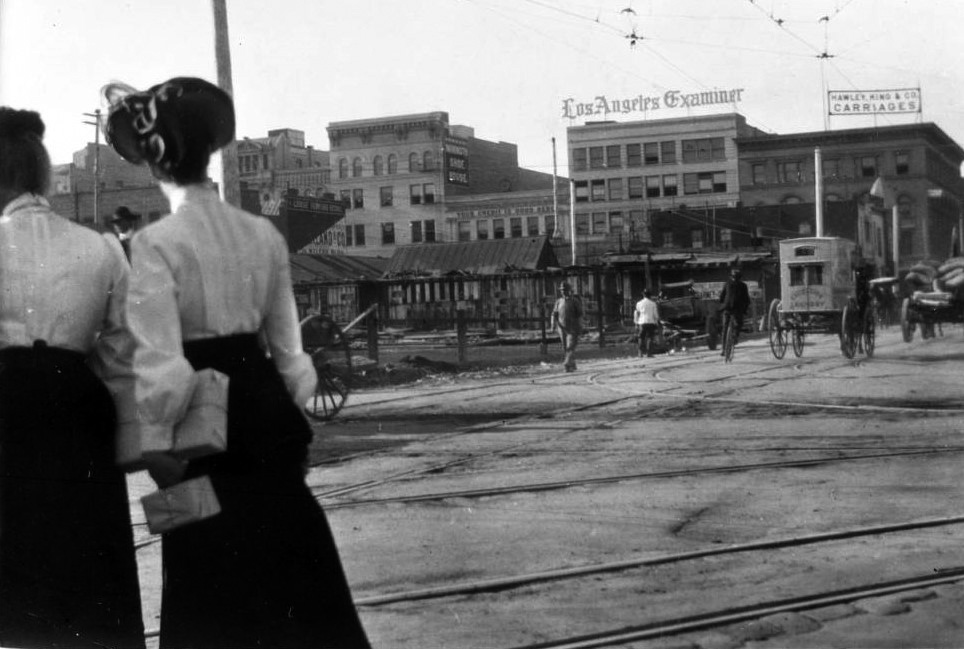 |
|
| (ca.1903)^^ - View showing two women crossing the street at Spring and Fifth Street looking west toward a group of buildings at a distance. The buildings are located on the west side of Broadway just south of Fifth Street with the Los Angeles Examiner building visible at center. |
Historical Notes The Los Angeles Examiner was founded in 1903 by William Randolph Hearst as a union-friendly answer to the Los Angeles Times. At its peak in 1960, the Examiner had a circulation of 381,037. It attracted the top newspapermen and women of the day. The Examiner flourished in the 1940s under the leadership of City Editor James H. Richardson, who led his reporters to emphasize crime and Hollywood scandal coverage.*^ |
 |
|
| (ca. 1903)^ - View showing a horse-drawn wagon and three bicycles parkd in front of the Los Angeles Examiner building located at 509 South Broadway. |
Historical Notes The Herald Examiner would move into a new, larger building in 1914, located at the southwest corner of Broadway and 11th Streets. Click HERE to see the Examiner's 2nd buidling located at 1111 South Broadway. |
Broadway and 5th Street
 |
|
| (1903)^*# - View looking south on Broadway from 5th Street. Men and women are crossing the street in all directions. The sign on top of the building on the southwest corner reads: The 5 Cents Store - S & H Green Stamps |
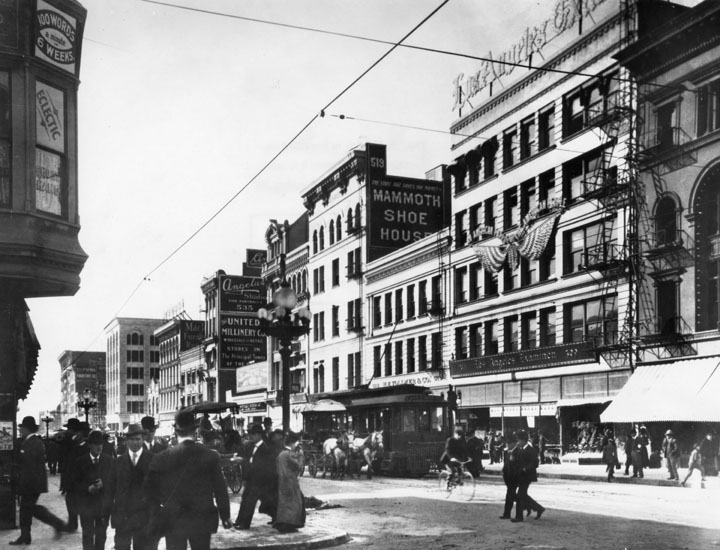 |
|
| (ca. 1903)^ - The intersection at Broadway and 5th, looking south from 5th. The Los Angeles Examiner building is visible on the right. Pedestrians line the sidewalks, and horses and buggies are on the street. A lone bicycle rider leads the pack. Signs for "Mammoth Shoe House", "United Millinery Company", and "Angelus Studio" are visible. |
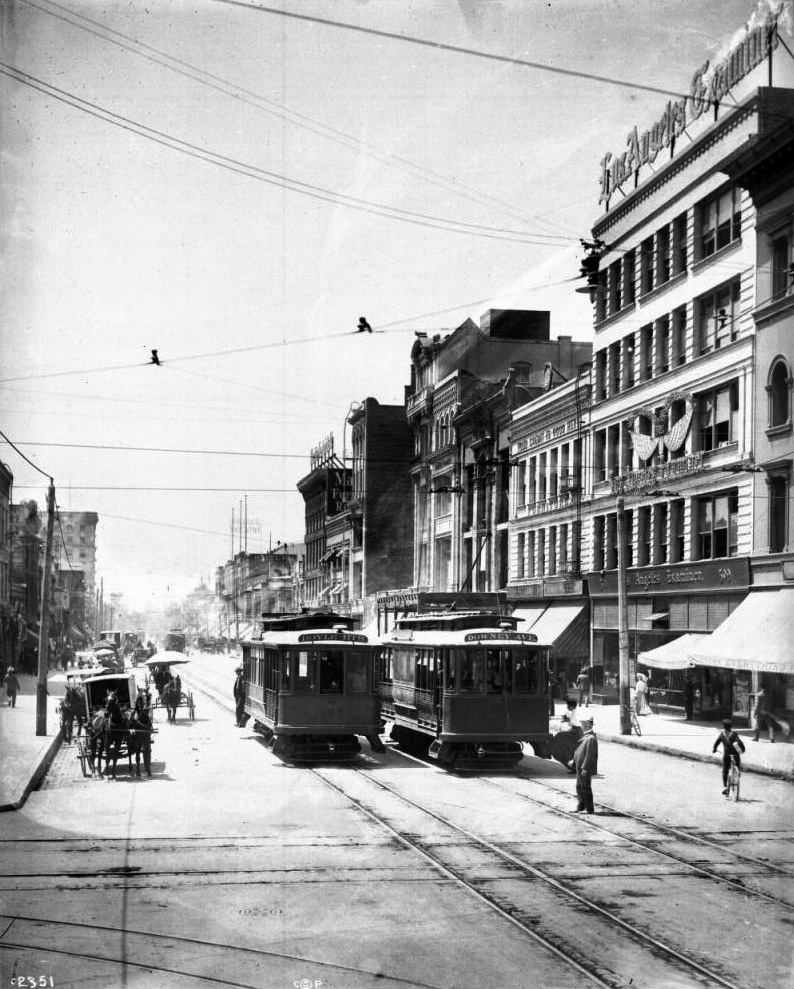 |
|
| (ca. 1908)^^ - View looking south on Broadway from Fifth Street showing two streetcars heading in opposite directions. One streetcar sign reads “Boyle Hts” and the other “Downey Ave". On the left can be seen several horse-drawn carriages and on the right a young man is riding a bicycle with a package under his arm. Also at right, commercial buildings line the street, including the Los Angeles Examiner building. |
Historical Notes In 1967, Herald Examiner employees began a strike that lasted almost a decade and resulted in at least $15 million in losses. The paper never recovered from the strike and went out of business November 2, 1989, leaving the Los Angeles Times as the sole city-wide daily newspaper.*^ |
* * * * * |
 |
|
| (1903)^ - An early photo looking west on 6th Street from Main Street. Streetcar tracks cross at this intersection, and horse-and-carriages are seen. The Lion Cafe is at right, and houses are on both corners. Pedestrians are walking |
Then and Now
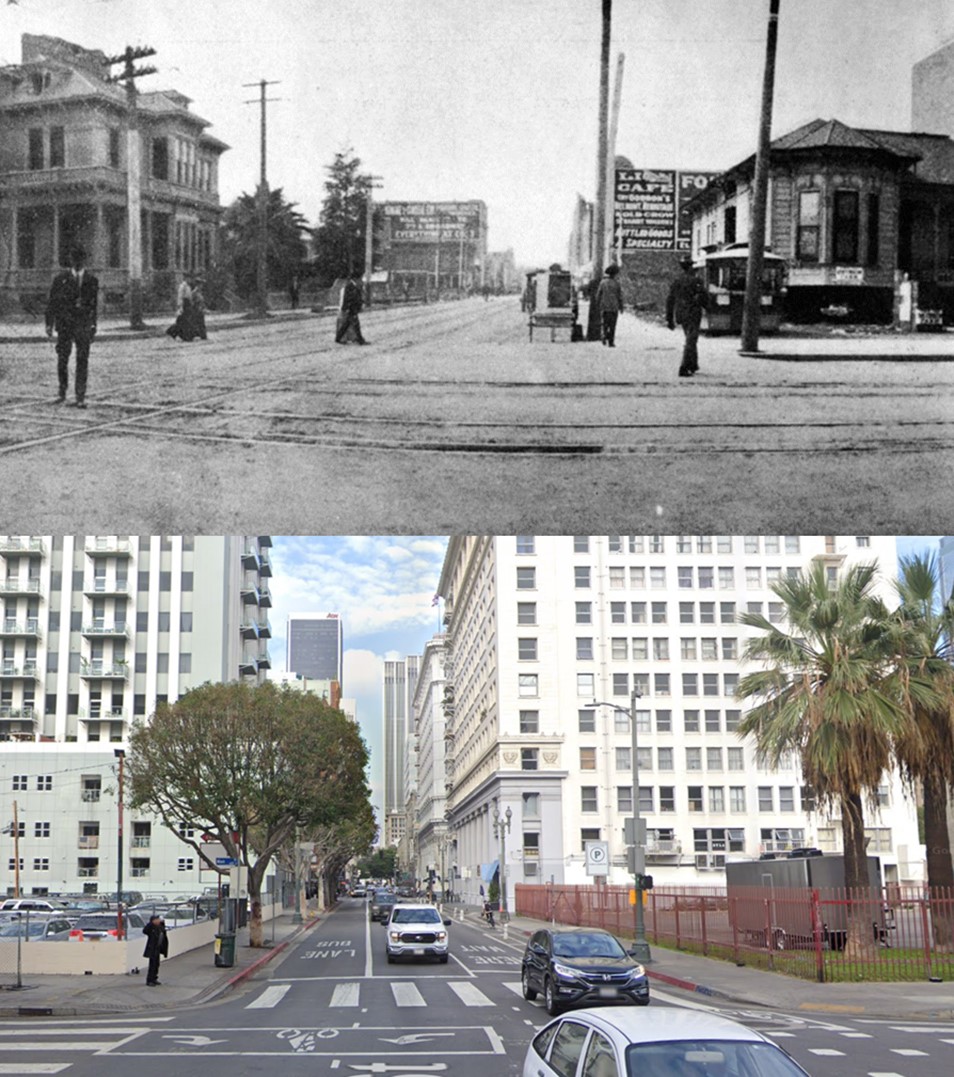 |
|
| (1903 vs 2022)* – Looking west on 6th Street from Main Street. Photo comparison by Jack Feldman. |
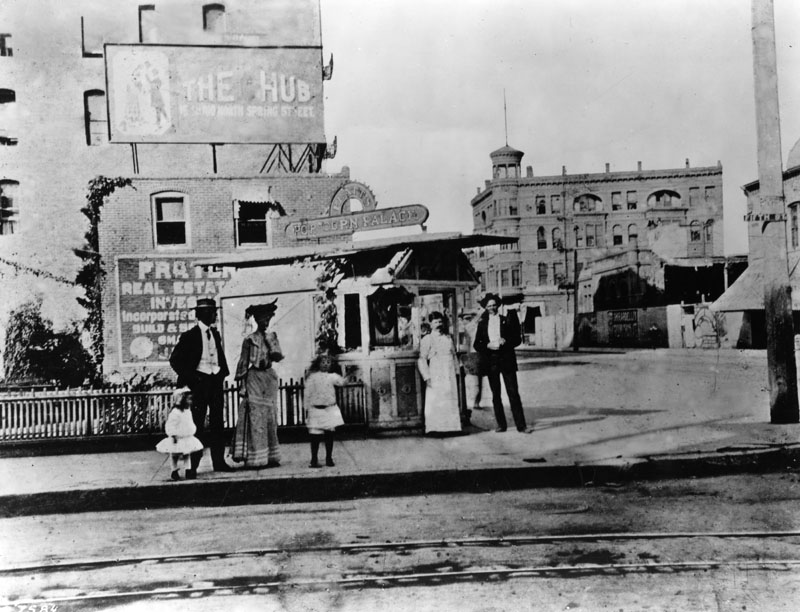 |
|
| (1903)^ - A group of people standing outside of Platt's Popcorn Palace on 5th and Main Streets. The Rosslyn Hotel later came to occupy this site. |
 |
|
| (ca. 1903)^^ - Panoramic view of downtown Los Angeles looking east from the Fremont Hotel, 4th Street and Olive Street. Notable buildings include the Angelus Hotel (top-center), W.E. Cummings building (left), Niles Pease Furniture Co. (right). Legible signs include: "Conrad's, men's furnishings", "factory, climax, isolar [...]", "W.E. Cummings", "the Angelus", "restaurant", "Niles Pease Furniture Co.", "429, delicatessen, B.W. [...] & Co.". |
Historical Notes The Angelus Hotel was built in 1901 by G.S. Holmes (also the proprietor of The Knutsford Hotel in Salt Lake City, Utah). Advertised then as the tallest building in Los Angeles, the hotel consisted of two, seven-story buildings joined by a central structure with a lobby, dining rooms, meeting rooms and other shared facilities, including a central court yard on top.^^*^ |
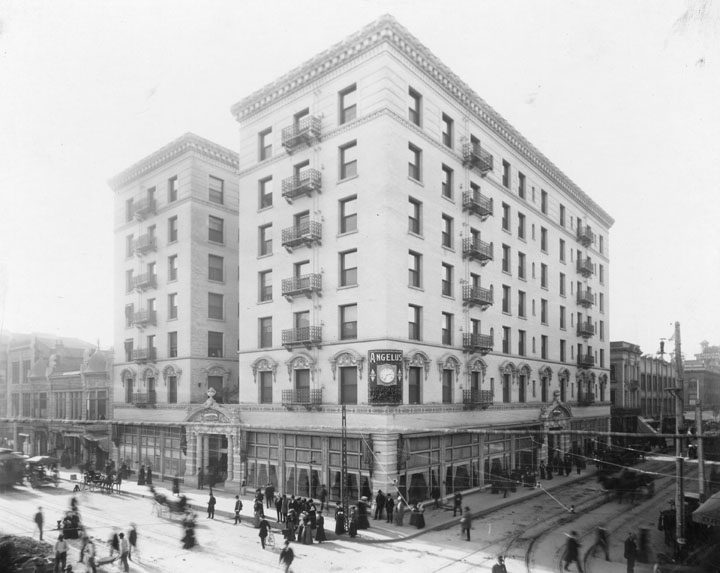 |
|
| (ca. 1902)^ - View of the Angelus Hotel located on the southwest corner of Spring and Fourth streets. A sign with the name "Angelus" and containing a clock is located on the corner of the building. The street is filled with people and horses and carriages, and a streetcar coming from the left. |
Historical Notes According to The American Globe, Independent Illustrated Monthly of 1909, The Angelus was sold circa 1903 to the Loomis Brothers, who were experienced hoteliers. The Angelus had a Turkish-themed room in its early days, along with a bowling alley, billiards, a buffet and hair dressing parlor. Under the Loomis Brothers, the hotel later offered onsite "progressive tailoring" services by Eisner & Company.^^*^ |
 |
|
| (ca. 1903)^ - Spring Street between 2nd and 3rd Streets, looking north. The National Bank of California is on the northeast corner and H. Jevne Grocers at 208-210 South Spring. Two streetcars can be seen at the intersection of Spring and 2nd. Horse-drawn wagons and several bicycles are parked at the curb. |
* * * * * |
Broadway and 9th Street (Car Rally)
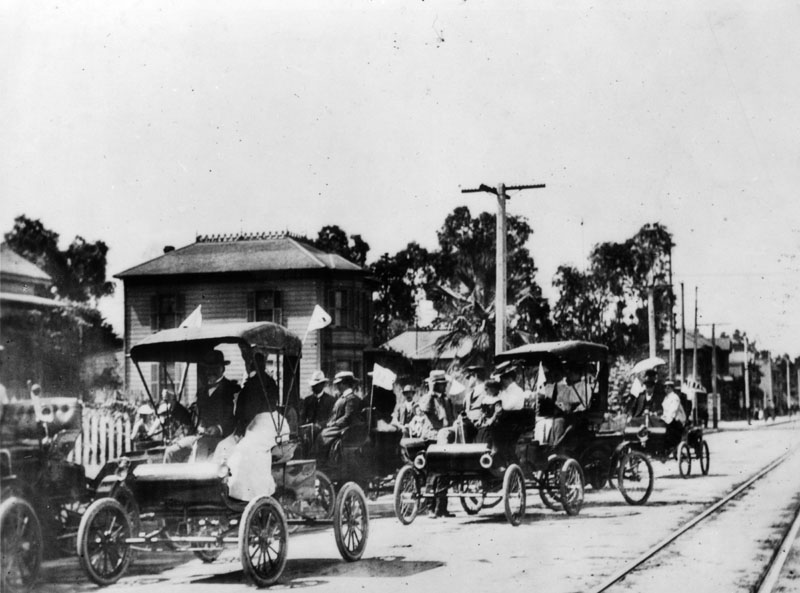 |
|
| (1903)* - View looking south on Broadway from near 9th Street. Five motorcarriages with spoked wheels form a line running up the side of the still unpaved street, in which embedded trollycar tracks are visible. |
Historical Notes In 1903, Los Angeles was seeing the beginnings of informal car rallies, with several automobiles occasionally following each other through downtown streets. Though formal rallies weren’t organized yet, small caravans of cars weaving through the city offered a glimpse of the coming automotive culture. These early gatherings symbolized a growing fascination with automobiles amidst the usual traffic of horse-drawn carriages and streetcars. |
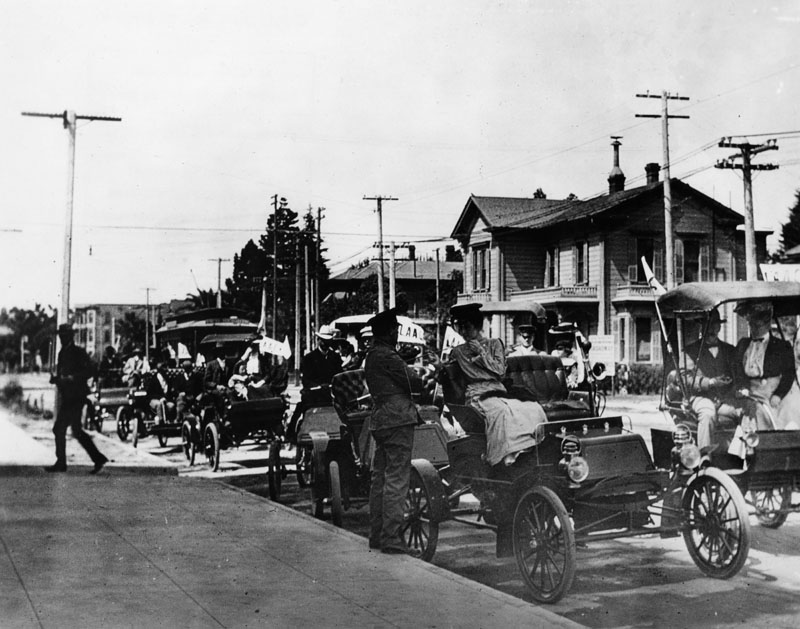 |
|
| (1903)* - A view of the west side of Broadway south of 9th St. A group of people are seen in their parked cars by the curb. Some of the cars have their tops down. Pennants are attached to the automobiles. On the opposite side of Broadway are homes. |
Historical Notes While automobiles were visible on the streets of downtown Los Angeles in 1903, they were still a relatively rare sight compared to other forms of transportation. Their presence was growing, but they were far from dominating the urban landscape at this point. |
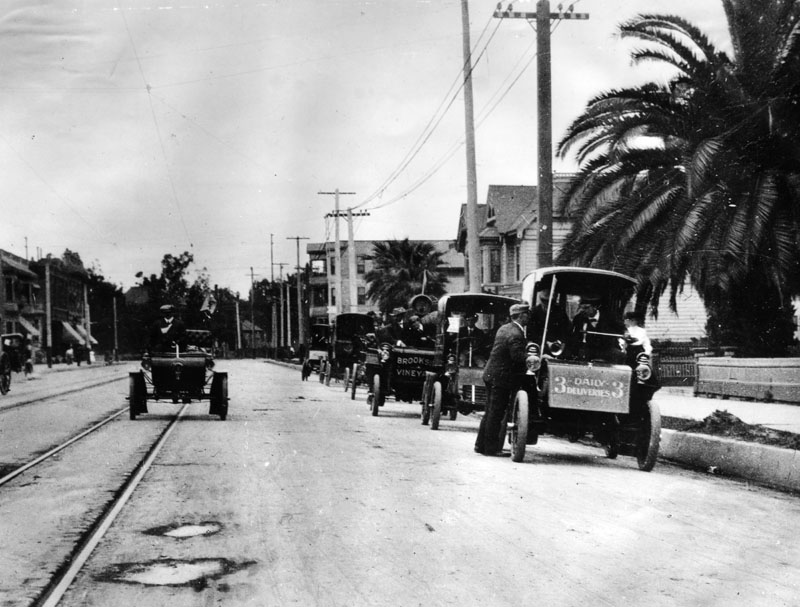 |
|
| (1904)* - View of Broadway looking south from 9th St. Note the cars with signs such as "3 Daily Deliveries" lined up on one side of the street. |
Then and Now
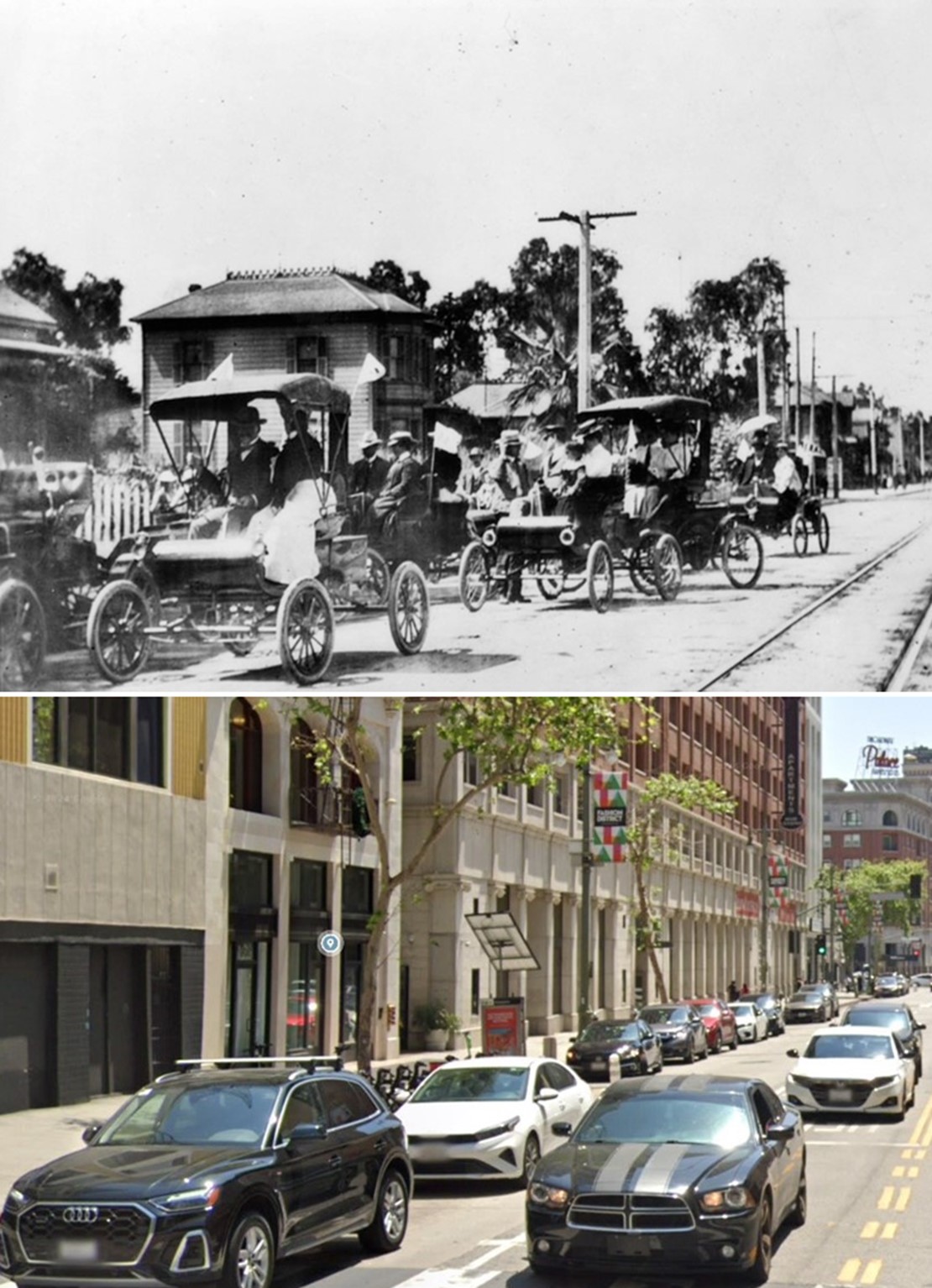 |
|
| (1903 vs. 2024)* - Looking south on Broadway from near 9th Street toward 10th Street (now Olympic Boulevard). Photo comparison by Jack Feldman. |
Historical Notes 10th Street in downtown Los Angeles was renamed Olympic Boulevard in 1932 to honor the Summer Olympics that were held in the city that year. The 1932 Olympics were the tenth modern Olympic event, which is how the street got its new name. Some parts of the old 10th Street still exist as smaller streets in Westlake, near Hancock Park, and in the Central City East area. Tenth Street School, located at Olympic and Grattan, still has its original name. |
* * * * * |
Sunset Boulevard - Echo Park
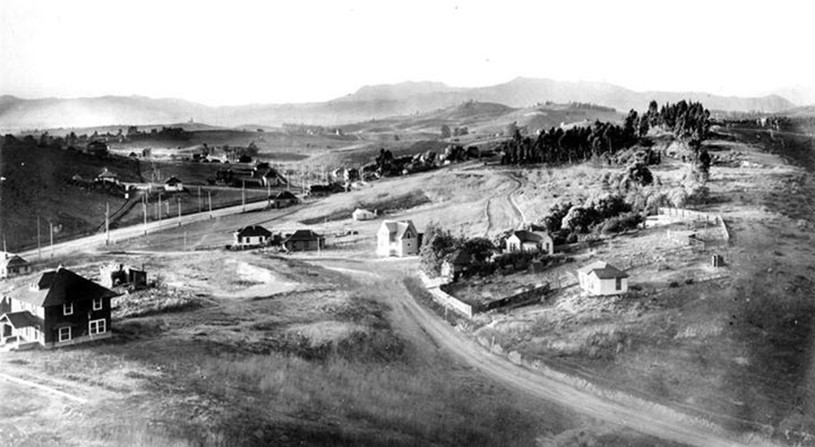 |
|
| (ca. 1903)* – Early view of Echo Park looking NW toward the Hollywood Hills with the intersection of Sunset Blvd and Innes Ave at center-left. |
Historical Notes This was Edendale, later Echo Park, with Silver Lake over the hills in the center middle distance. The photo was taken from atop the Everett St. hill, circa 1903. * Left lower middle, Sunset Blvd. with the Hollywood Line trolly electric poles appears, continues diagonally up to the right, bears left, and bears left again. * Very lower left, the road by the large dark house was and is Innes Ave. * Closest left middle, the intersection closest was Elysian Park Ave. (now Vin Scully Ave.) proceeding uphill to the right. * Center and right bottom, the road became Lilac Pl. * Left middle, the dark path across from Elysian Park Ave. was and is Allison Ave. * Left middle, the road crossing Allison and Sunset was and is Douglas St. * Upper left middle, the road crossing Sunset and proceeding to the right is Echo Park Ave., with the Echo Park Ave. Line trolly electric poles. * Left middle, Reservoir No. 4 / Echo Park Lake was behind the hill with trees. (Above Notes: Courtesy of Mike Forster) |
Then and Now
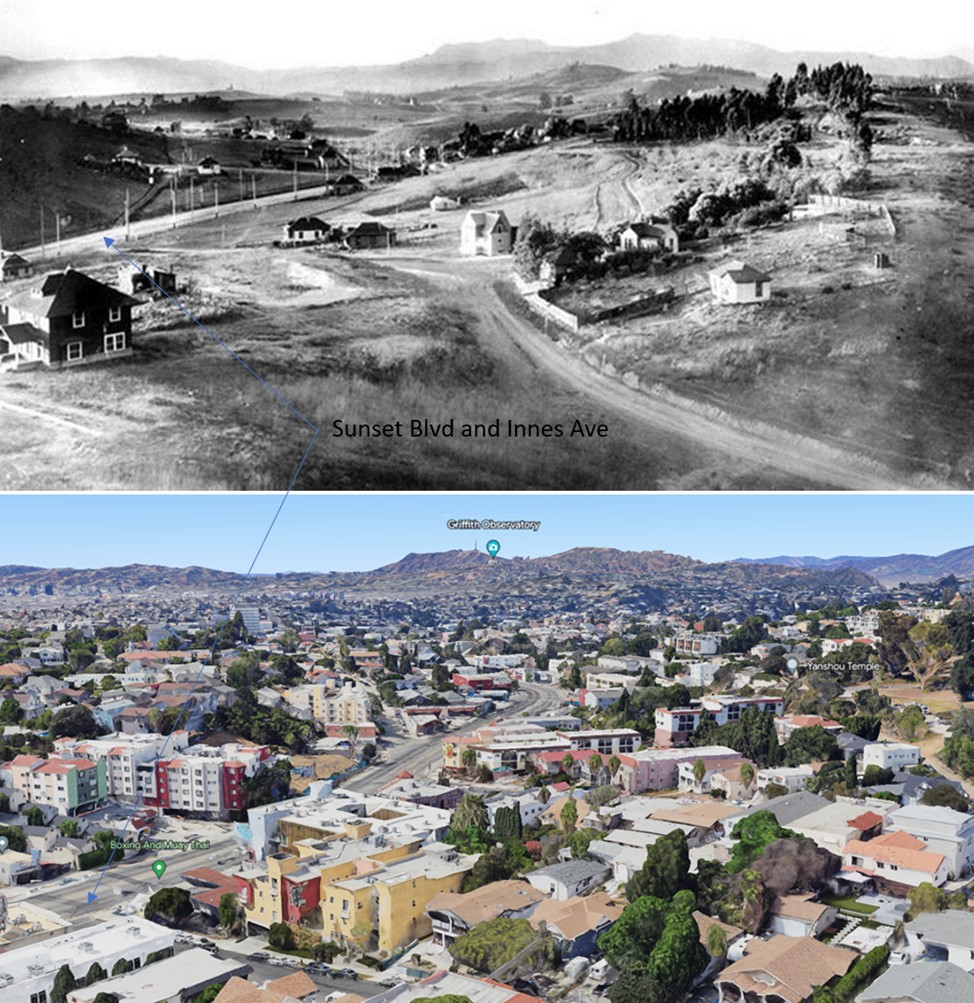 |
|
| (1903 vs 2022) – View of Echo Park with the intersection of Sunset Blvd and Innes Ave shown on the left. Elysian Park Ave (now Vin Scully Ave) is one block to the north. Photo comparison by Jack Feldman. |
Sunset Boulevard - Grand Opening (Echo Park)
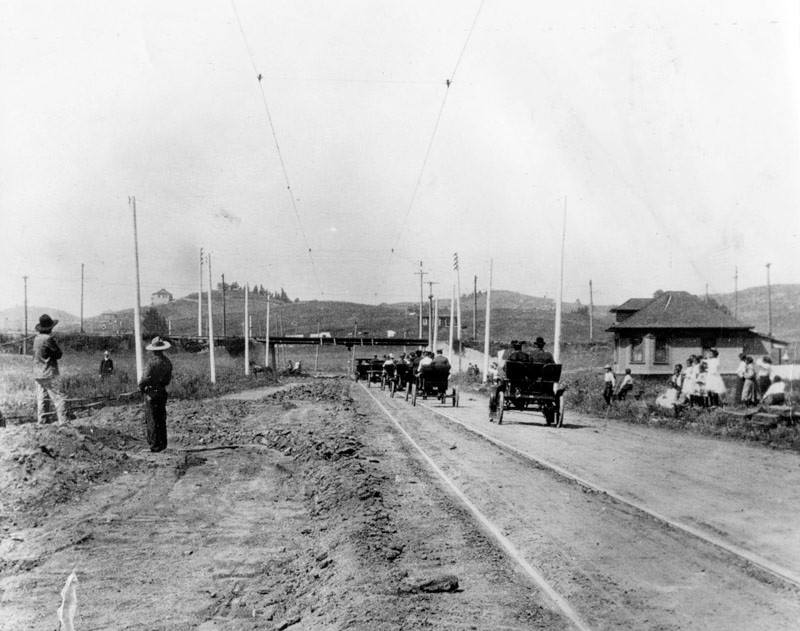 |
|
| (1904)^ – View of Glendale Boulevard (then Lake Shore Ave), still a dirt road, with a ‘parade’ of cars near Sunset Boulevard. |
Historical Notes Sunset Boulevard had its grand opening on May 14, 1904. A parade of a dozen or so automobiles — accompanied by horse-drawn carriages, tally-hos, and electric rail cars — puttered over the freshly macadamized roadway that now connected Los Angeles with the then-independent city of Hollywood. Crowds of well-wishers gathered along the route.* |
 |
|
| (1904)**# - The procession at the intersection of Sunset and Glendale (then Lake Shore Avenue). This view looks west toward the present-day site of the Echo and Echoplex music venues. Courtesy of the Automobile Club of Southern California Archives. |
Historical Notes Property owners in the hilly area now known as Silver Lake and Echo Park soon realized that the road would catalyze development and boost the value of their holdings. In 1892, led by the Los Angeles and Pacific Railway and a Confederate Civil War veteran named George H. Smith, they petitioned the city to open Sunset Boulevard through their land. The city council mapped out a route the following year, tracing the path of the defunct Ostrich Farm Railway. Actual work, however, didn't begin in earnest until April 18, 1903, when contractor Charles Stansbury and his workers began carving the boulevard's meandering path into the area's soft sandstone hills.* |
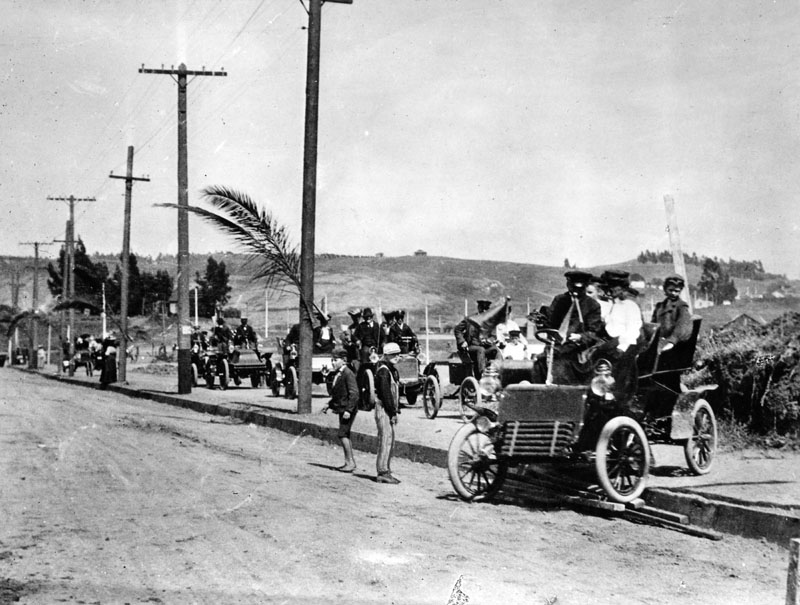 |
|
| (1904)^ - Automobile Parade on Sunset Boulevard. The vehicles are going down the sidewalk past redwood electric poles with palm fronds attached. There are boards stacked to lessen the shock of returning to the road, the curbs have not yet been cut for driveways. |
Historical Notes When the new boulevard finally opened in the spring of 1904, its future as one of L.A.'s iconic automobile routes might have seemed unlikely. The road surface was uneven in places, and there had been no effort to plant shade trees — an oversight that celebrants hastily remedied by fastening palm fronds to telegraph poles. Furthermore, the boulevard didn't yet extend to the sea and wouldn't until 1934, when sinuous Beverly Boulevard was remade into the westernmost stretch of Sunset.* |
Then and Now
 |
|
| (1904 vs. 2022)* - Looking north on Glendale Boulevard (then Lake Shore Ave) toward the Sunset Boulevard overcrossing. Lake Shore Ave is still there as the street on the right past the overcrossing. Photo comparison by Jack Feldman. |
* * * * * |
Sunset Boulevard - Echo Park
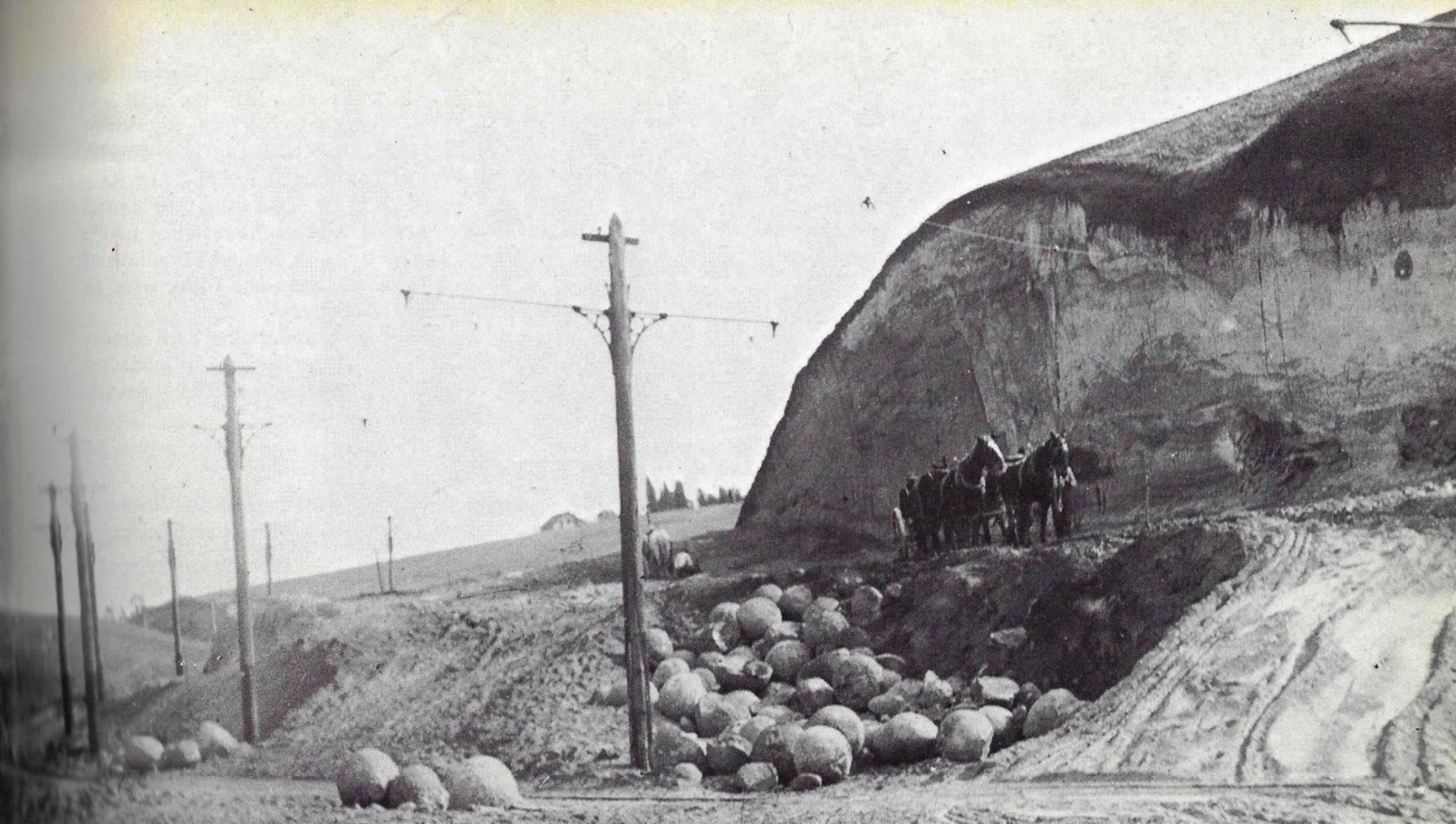 |
|
| (1907)* - View looking east on Sunset Boulevard toward Benton Way, as seen from near Occidental Boulevard. Large, rounded boulders have been moved aside while crews prepare the street for public transportation. Note the unusual roundness of the boulders. It was initially speculated that some of these formations might be dinosaur eggs, with a few reportedly displayed at the La Brea Tar Pits Museum and the Natural History Museum in Exposition Park. However, this is unlikely, as these formations appear to be 'cannonball concretions,' and research indicates that no dinosaur eggs have been discovered in Southern California. |
Historical Notes The area around Sunset Boulevard near Occidental Boulevard and Benton Way in Echo Park has a rich history dating back to the early 20th century. In 1907, this region was experiencing significant development as Los Angeles expanded westward. Sunset Boulevard itself had only recently opened in 1904, marking a new era in Los Angeles' urban development. The boulevard's grand opening on May 14, 1904, was celebrated with a parade of automobiles, horse-drawn carriages, and electric rail cars. At the time, Sunset Boulevard primarily functioned as an interurban railcar route, with the Los Angeles Pacific Railway tracks running down its median. However, it was also beginning to accommodate the growing number of automobiles in the city. |
 |
|
| (1912)* - Looking east on Sunset Boulevard from near Occidental Boulevard (about 2751 Sunset Boulevard). |
Historical Notes Sunset Boulevard's history through Echo Park is a fascinating tale of urban development and cultural evolution. Conceived in the late 19th century as a road connecting Los Angeles to the sea, the boulevard's section through Echo Park was crucial in linking downtown to Hollywood. Property owners in the area petitioned for its construction in 1892, recognizing its potential to boost development. The grand opening on May 14, 1904, marked a pivotal moment in Los Angeles' history, celebrated with a parade showcasing various modes of transportation. Initially serving as an interurban railcar route with tracks running down its median, Sunset Boulevard quickly became one of the city's first corridors designed partly for automobiles. |
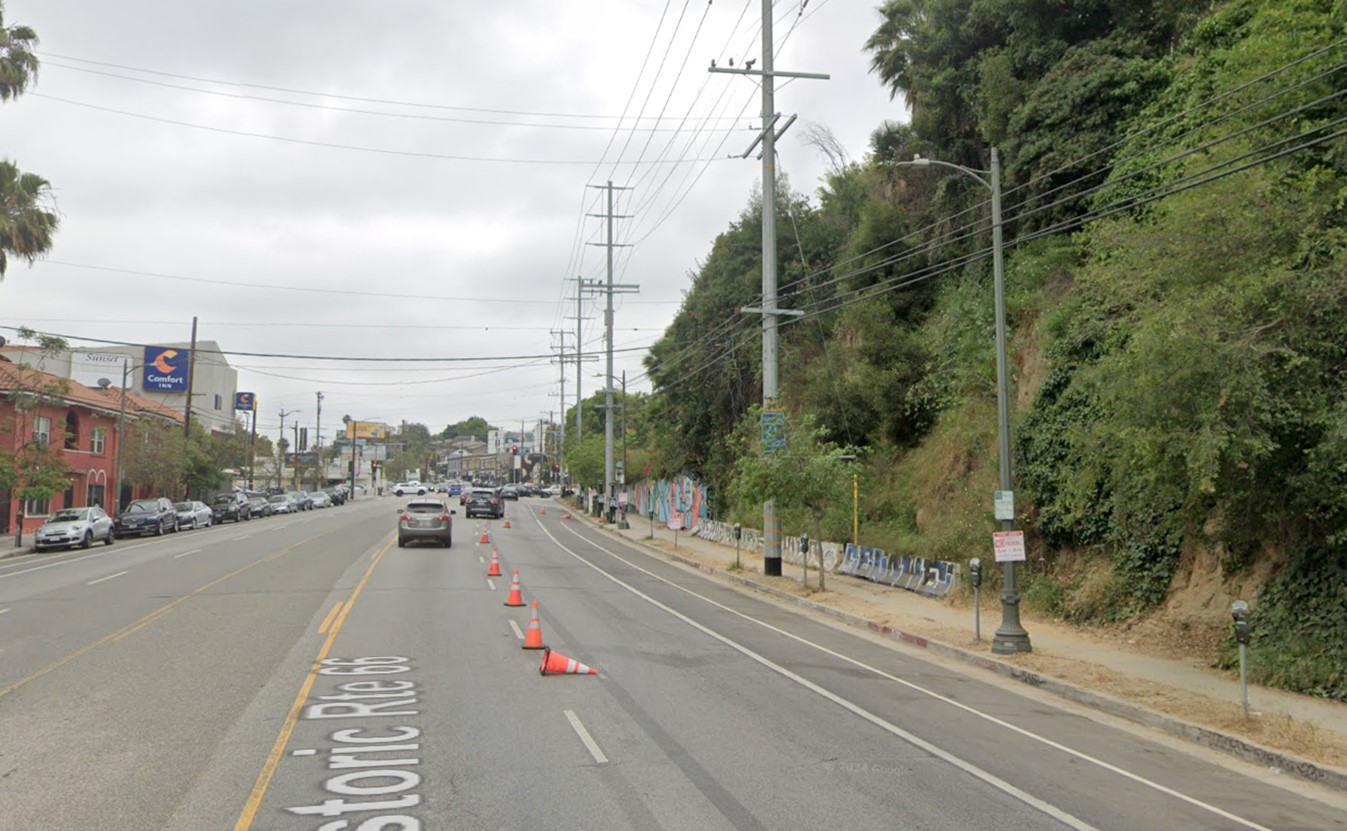 |
|
| (2024)* - Looking east on Sunset Boulevard from near Occidental Boulevard (about 2751 Sunset Boulevard). |
Then and Now
 |
|
| (1912 vs 2019)* - Looking east on Sunset Boulevard from near Occidental Boulevard (about 2751 Sunset Boulevard). Photo comparison by Jack Feldman. |
* * * * * |
Downtown
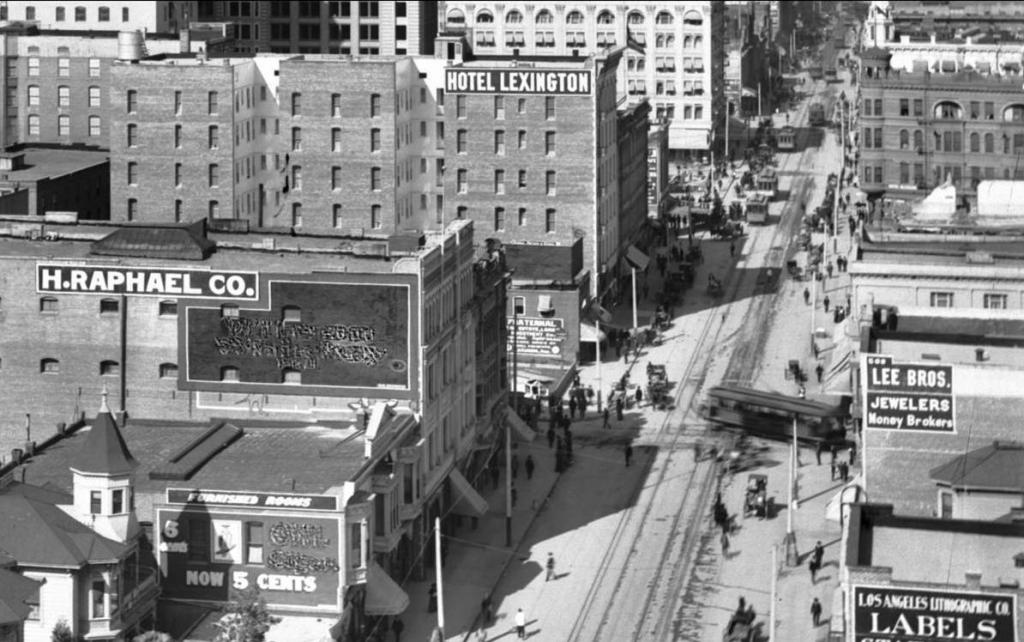 |
|
| (ca. 1904)^^ - View looking north on Main Street. The streets are filled with horse-drawn carriages, streetcars, and pedestrians. Large business signs can be seen throughout. |
 |
|
| (ca. 1904)^ - At the intersection of Main (foreground) and 9th streets, a bicycle group prepares to depart for Griffith Park. |
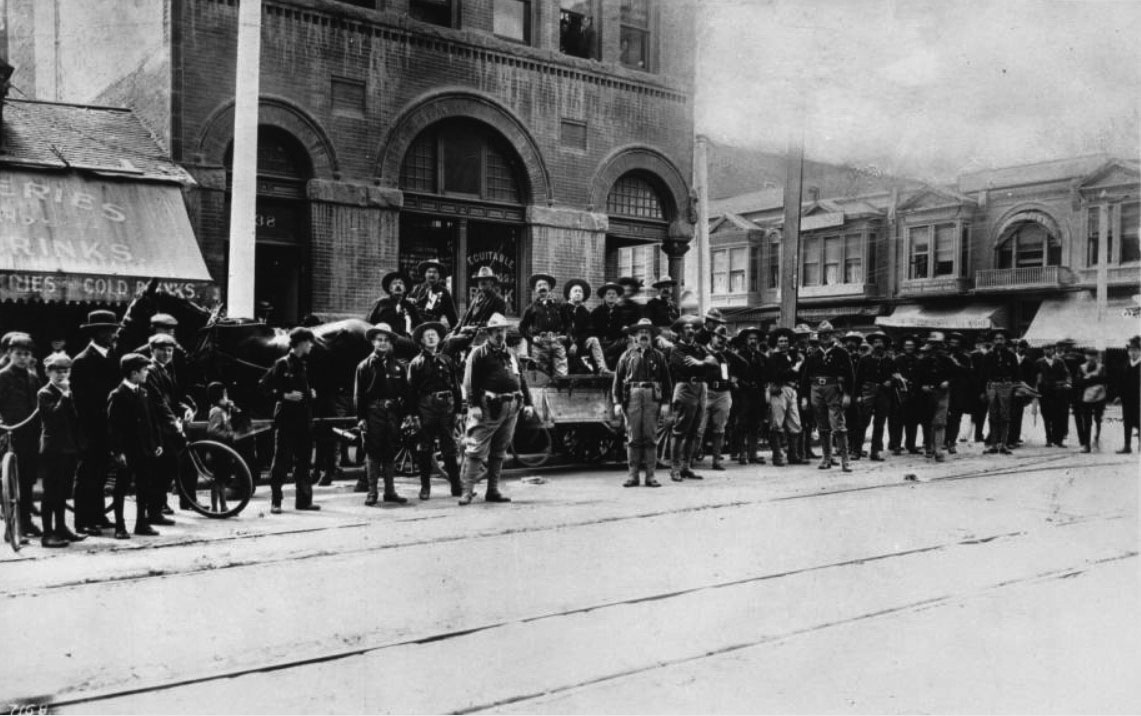 |
|
| (ca. 1904)^^ – Portrait of veterans "Teddy's Terrors" at First Street and Broadway. Soldiers from the Spanish-American War who served under Theodore Roosevelt stand in front of a two-story brick corner building in their cavalry uniforms with a group of young boys standing with their bicycles to the left. More onlookers are visible to the right and peering out of the windows above. These soldiers were campaigning for the soon-to-be President Roosevelt at the time. |
* * * * * |
Los Angeles Police
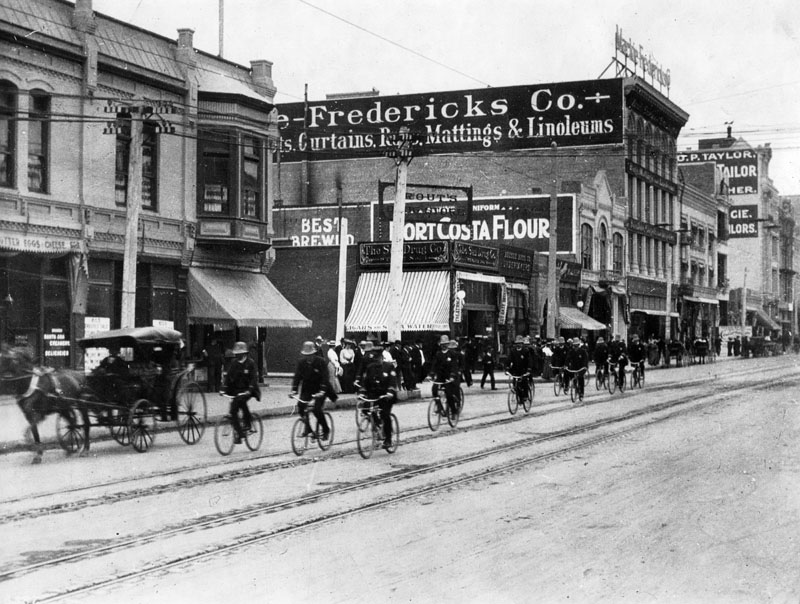 |
|
| (ca. 1904)^ - Scores of uniformed bicyclists (police officers) share the road with a horse-drawn buggy on Broadway and 6th Streets, west side looking north, on May 24, 1904. The Sun Drug Company is visible, as is Mackie Fredericks Company. |
Historical Notes By 1900 Los Angeles had 70 police officers, one for every 1,500 people. In 1903, with the start of the Civil Service, this force was increased to 200, although training was not introduced until 1916. |
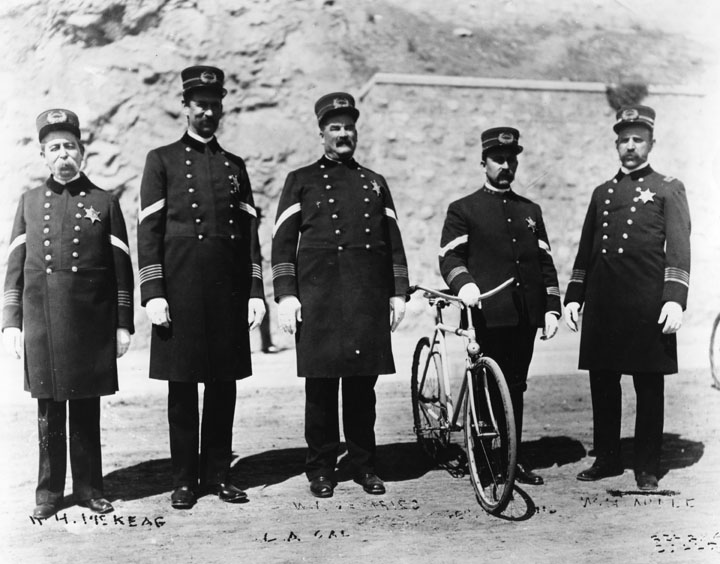 |
|
| (Early 1900s)^ - Five policemen in uniforms from the early part of the century pose for their picture. One holds a bicycle. |
Historical Notes In the early 1900s, the office of Chief of Police became increasingly politicized. From 1900 to 1923 there were sixteen different chiefs. The longest-lasting was Charles E. Sebastian, who served from 1911 to 1915 before going on to become mayor. In 1910 the department promoted the first sworn female police officer with full powers in the United States, Alice Stebbins Wells. Georgia Ann Robinson became the first African-American female police officer in the country in 1916. |
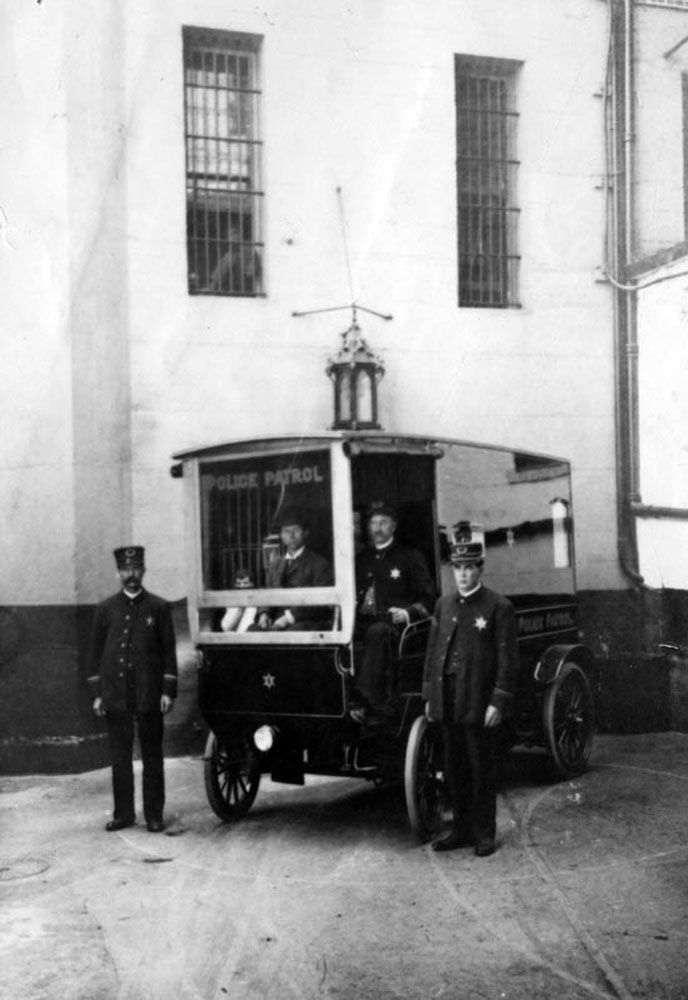 |
|
| (Early 1900s)^ - Photo of Los Angeles' first horseless patrol wagon in front of the prison. |
Historical Notes Los Angeles' first patrol wagon was also used as an ambulance. It was bought in 1904, was driven by electricity and boasted 20 miles per hour. |
\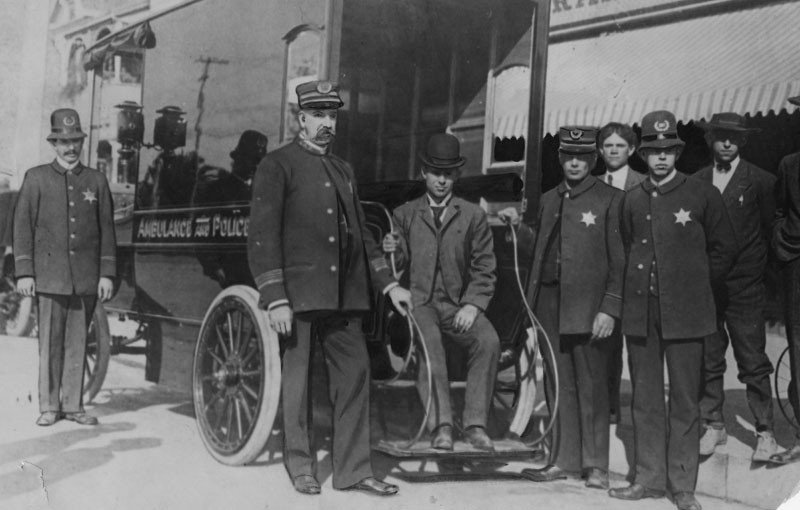 |
|
| (Early 1900s)^ - View showing police officers in front of Los Angeles' first horseless patrol wagon. At right is George Home, who became Chief of Police in later days. Captain C. L. Johnson is second from left. Photo dated: June 27, 1927. |
Historical Notes In the early 1900s, the office of Chief of Police became increasingly politicized. From 1900 to 1923 there were sixteen different chiefs. The longest-lasting was Charles E. Sebastian, who served from 1911 to 1915 before going on to become mayor. In 1910 the department promoted the first sworn female police officer with full powers in the United States, Alice Stebbins Wells. Georgia Ann Robinson became the first African-American female police officer in the country in 1916. |
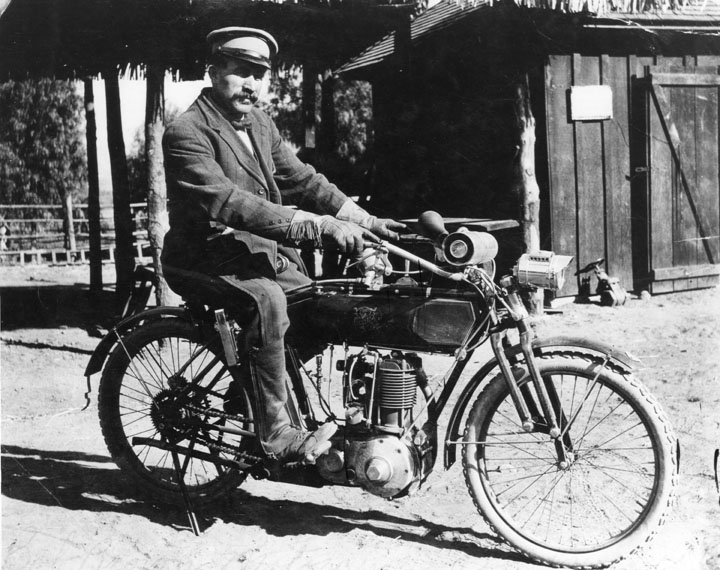 |
|
| (ca. 1910s)^ - The Griffith Park's first motorcycle officer, Bob Brown, sits here on his vehicle, by a building in the park. |
 |
|
| (1919)* - A group portrait of Los Angeles police officers standing in front of the Stephen M. White Statue, with the LA County Courthouse building behind them. At center, in front row is police chief George K. Home, wearing hat that says "Chief." The man second from left, front row, is Alexander W. Murray. |
* * * * * |
Pacific Electric Interurban Lines (Pasadena and Glendale-Burbank)
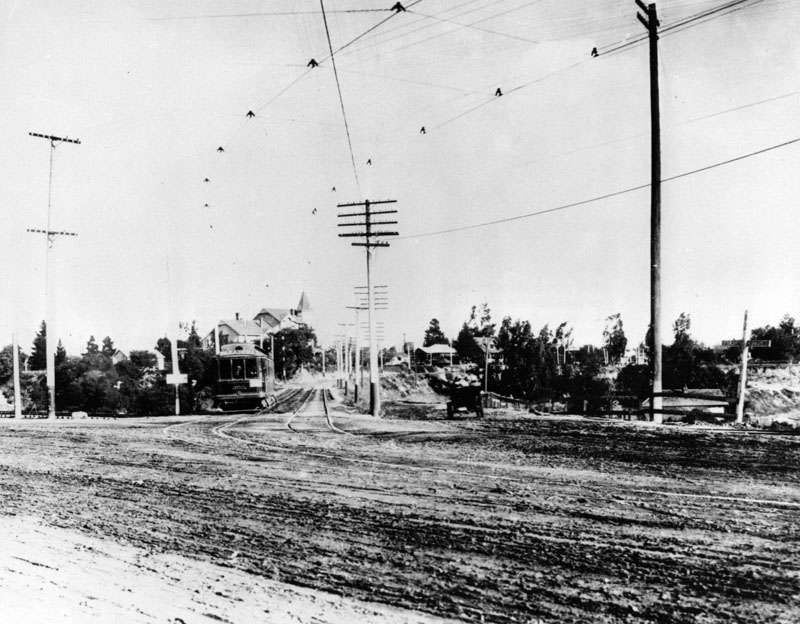 |
|
| (1904)* - Pacific Electric Railway car number 202 stopping at North Figueroa Street in Highland Park on its way to Los Angeles from Pasadena. A conductor on the left is flagging the car across the Los Angeles terminal tracks. An automobile is on the right. |
Historical Notes The Pacific Electric Interurban Lines serving Pasadena and Glendale-Burbank were vital components of Southern California’s early 20th-century electric railway network, connecting downtown Los Angeles with growing suburban communities through frequent, fast, and modern electric rail service. The Pasadena lines, among the earliest in the region, helped spur suburban development in the San Gabriel Valley, while the Glendale-Burbank line featured advanced infrastructure like a dedicated right-of-way and a downtown subway for efficient travel. Although these lines thrived during the 1910s through World War II, they declined after the war due to rising automobile use and freeway expansion, leading to their replacement by buses and eventual abandonment by the mid-1950s. |
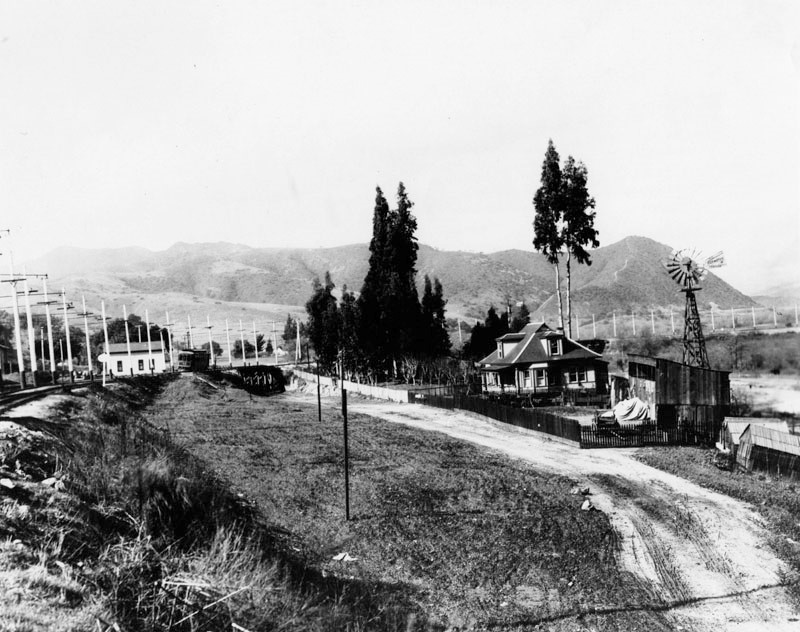 |
|
| (ca. 1904)^ - View of a Pacific Electric Railway car making its way south on its track near what is now called Riverside Drive, traveling south from the Silver Lake and Los Feliz areas. The 5 Freeway is now located at this spot. Griffith Park is visible in the background and a few homes can be seen as well. |
Historical Notes The Glendale-Burbank Line was for many years PE's finest example of suburban rail service. It presented multiple unit PCC cars, considerable private way and the subway entry into downtown Los Angeles. PE brought such crowds to Glendale that in 1906 the incorporation of the city was effected. |
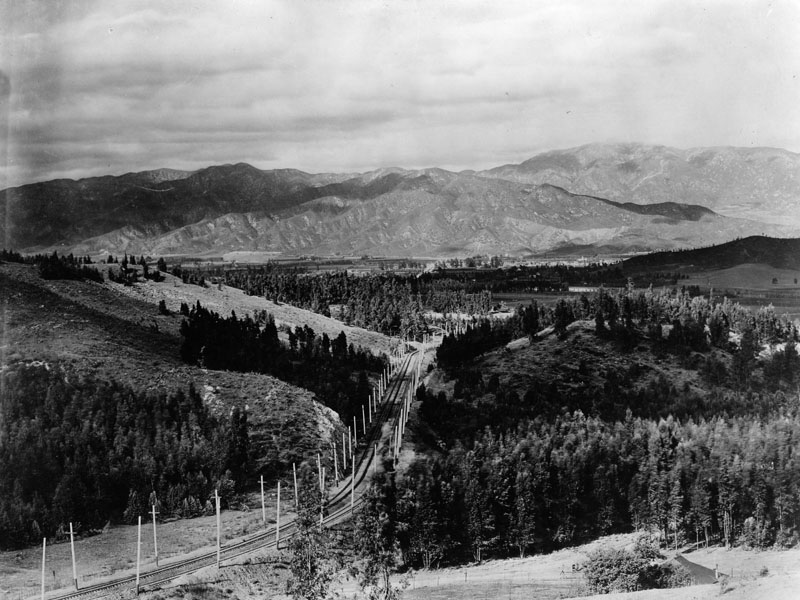 |
|
| (1904)^ - Panoramic view looking north toward Glendale along the Pacific Electric line through the Edendale Cut. |
Historical Notes The Edendale Cut was an unpaved road (some of which is now known as Silver Lake Ct.) and was the former route of the Glendale and Burbank interurban railway lines operated by Pacific Electric. The line crossed Fletcher Drive over a viaduct before continuing along a hillside ledge to the Monte Sano stop at Glendale Blvd. and Riverside Drive. |
* * * * * |
Fletcher Viaduct
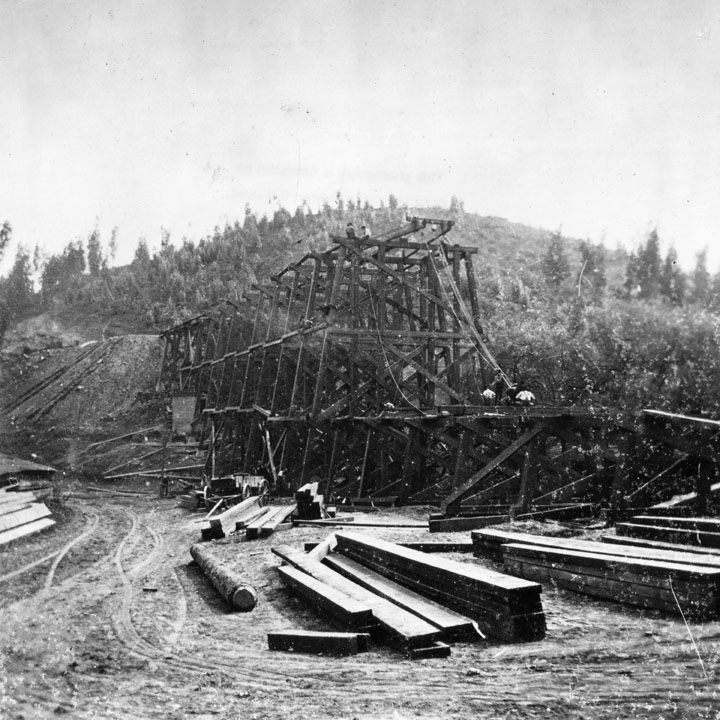 |
|
| (1904)^ - View showing the construction of the Fletcher Viaduct at Riverside Drive in Silver Lake. It was built for the PE Glendale-Burbank Line through Edendale. |
Historical Notes The Pacific Electric Glendale and Burbank interurban railway lines, including the Fletcher Viaduct, was constructed in 1904 and abandoned in 1955.* All viaducts are a type of bridge, but not all bridges are viaducts. The key difference between a viaduct and a bridge is that a viaduct is a long, elevated structure that carries a road or railway across a valley, gorge, or other low-lying area, while a bridge is typically used to cross a body of water. What makes the Fletcher overcrossing a viaduct and not a bridge is that it is an elevated, arched structure used to carry transportation infrastructure across a gap in the terrain, rather than over a river, lake, or other body of water. |
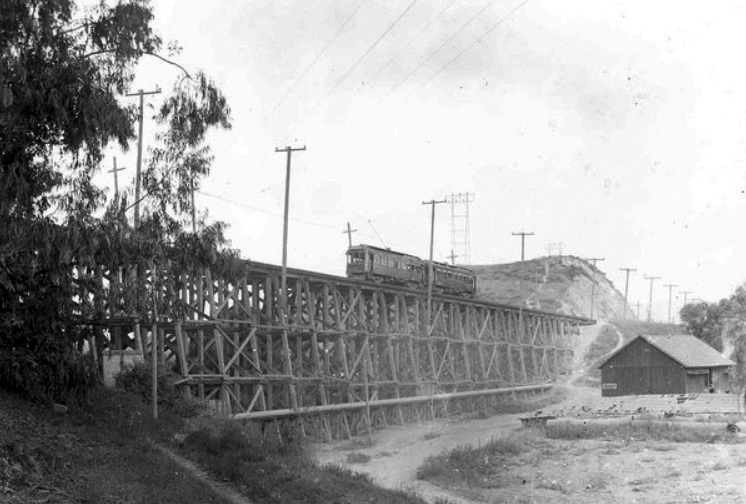 |
|
| (Early 1900s)^## – View showing two PE cars of the Glendale-Burbank Line on top of the Fletcher Drive timber bridge. |
Historical Notes In 1904, a nearly 454 foot long bridge, the Fletcher Viaduct, was built over Fletcher Drive, which ran forty feet below. The viaduct stood until 1928 when it was replaced by a steel structure bridge.* |
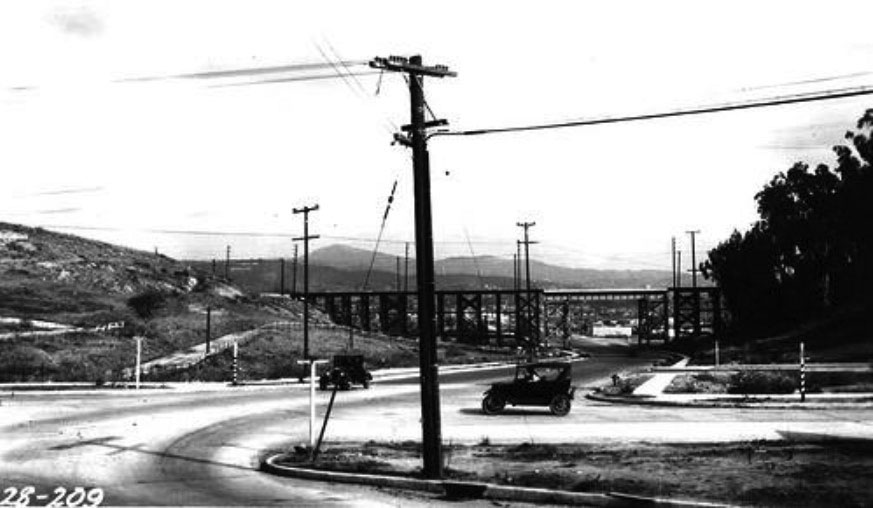 |
|
| (ca. 1920)* – View looking northeast from the intersection of Fletcher Drive and Glendale Boulevard showing the Fletcher Drive Viaduct in the distance. |
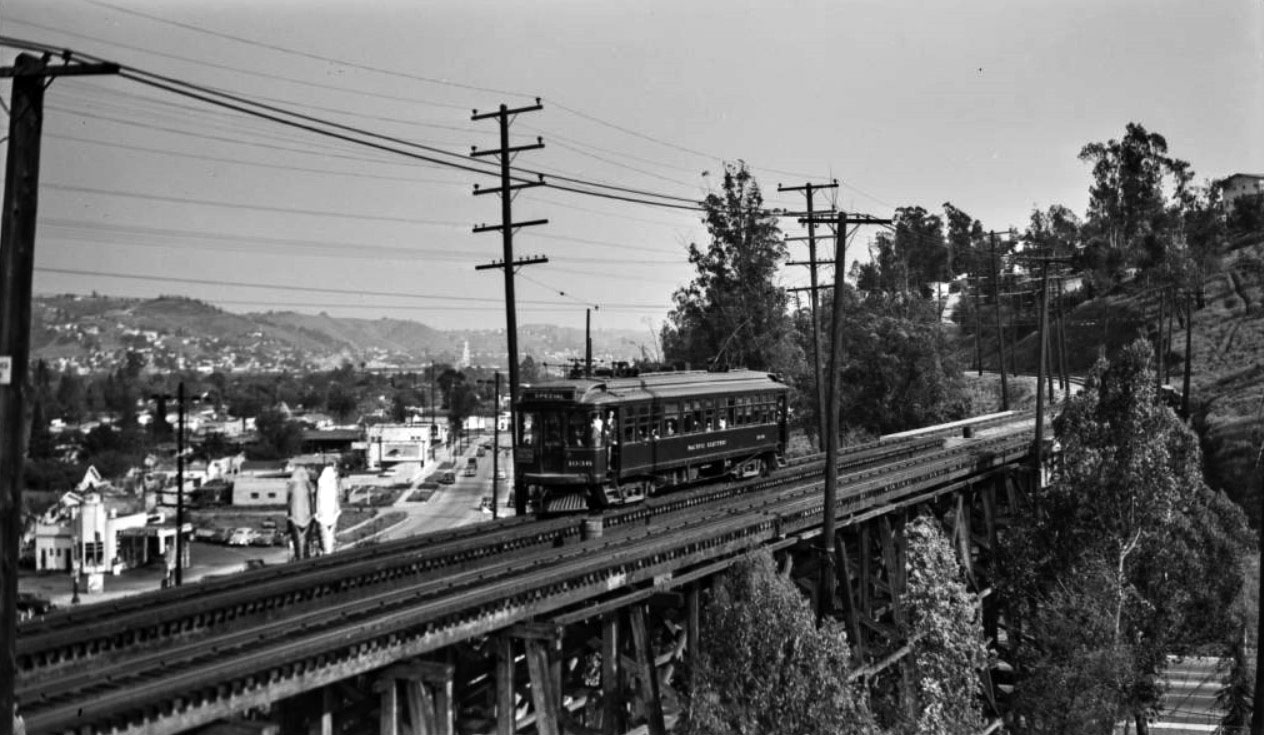 |
|
| (ca. 1928)* - Pacific Electric Railway streetcar going over the Fletcher Drive trestle on the Glendale-Burbank. Currie’s Ice Cream (large cone on top of building) can be seen in at center-left. |
Historical Notes In 1928, when Fletcher was paved, the original timber bridge was replaced with a steel structure mounted on concrete footings. The newer structure soared more than 60 feet above the street.* |
 |
|
| (ca.1938)^ – View looking north from what was once commonly known as Edendale shows Pacific Electric railroad tracks crossing Fletcher Drive and the intersection of Fletcher and Riverside Drive in Silver Lake. The ice cream cone shaped sign and long gabled roof building of Currie's Ice Cream can be seen on the northwest corner just past the bridge. |
 |
|
| (ca. 1939)^ – View looking east on Fletcher at Riverside as seen from the top of the Fletcher Viaduct. |
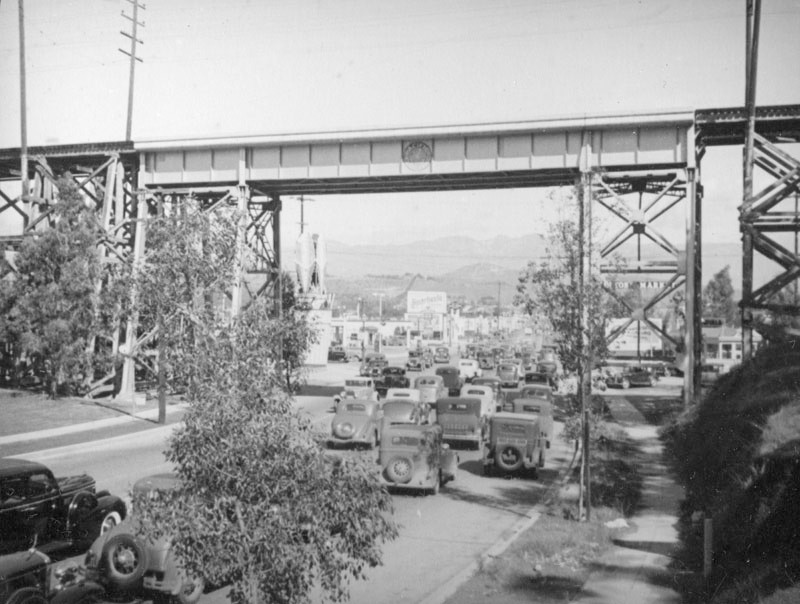 |
|
| (ca. 1938)^ - View of the Fletcher Drive Viaduct seen here with steel trestles that replaced the wooden bridge in 1928. The ice cream cone shaped sign for Currie's Ice Cream (2500 Riverside Drive) can be seen on the left just past the bridge. Atwater Village, Glendale, and the San Gabriel Mountains are seen in the center. |
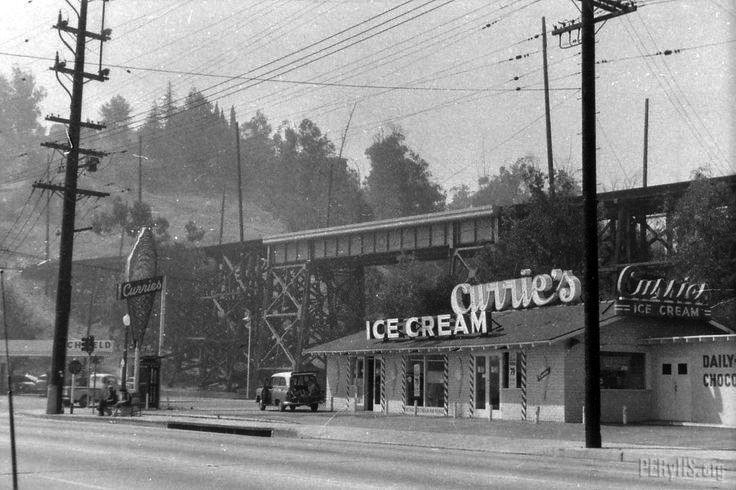 |
|
| (ca. 1940s)* – View showing the Fletcher Drive Viaduct with Currie’s Ice Cream (2500 Riverside Drive) seen in the foreground. The building is still there, just remodeled and expanded. It is now occupied by Home Restaurant and Bar. Click HERE for contemporary view. |
Historical Notes People still fondly remember the Currie’s chain and its “mile-high cone” whose replica was often displayed billboard-style on roofs. The chain was started in 1927 by three brothers named Kuhns. After WWII they sold it to the Good Humor Company who later sold it to Lipton in the 1960s. In 1964 the chain opened its 87th store, in North Hollywood. Although Currie’s anticipated launching units in every community in Southern California, only three outlets were listed in the 1967 Los Angeles phone book and the chain had disappeared by the 1980s.* |
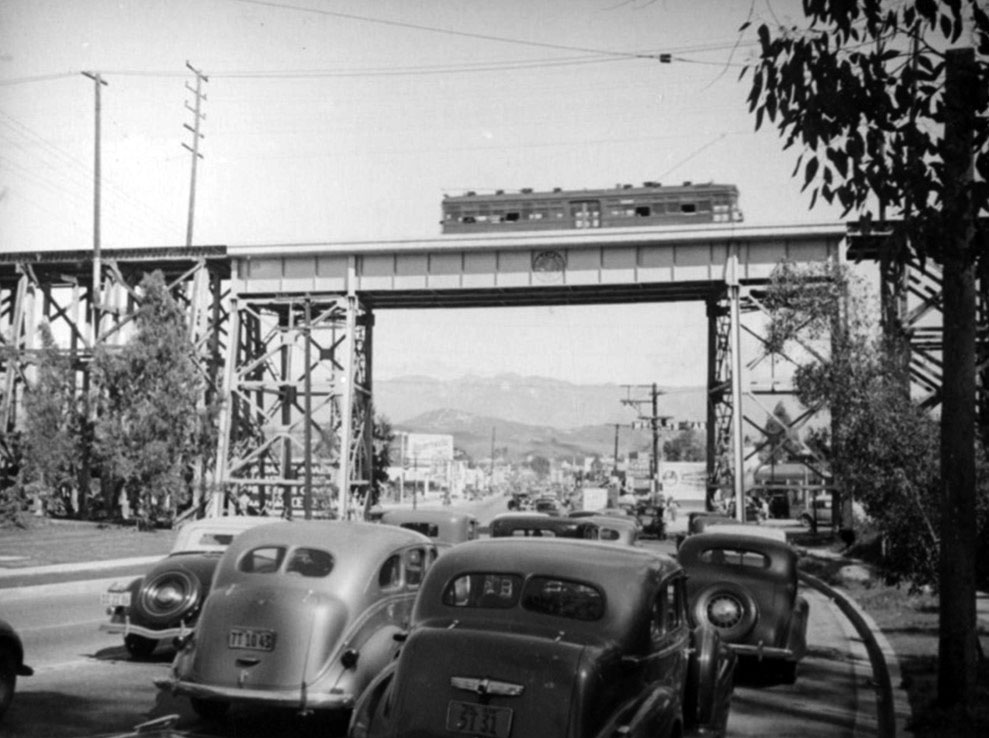 |
|
| (ca. 1939)^ - Ground view of the steel-framed Fletcher Drive Viaduct that replaced the original wooden bridge. |
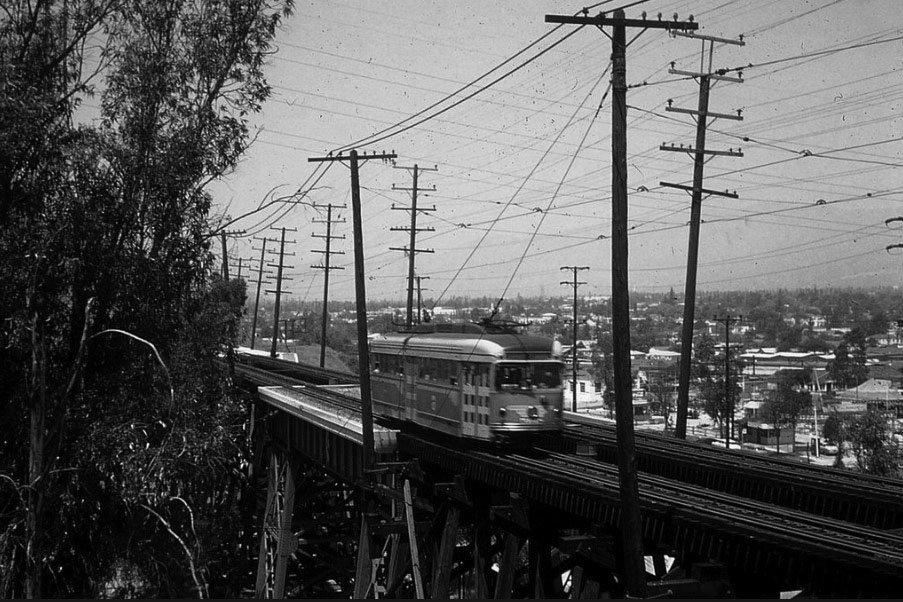 |
|
| (1955)^## – View showing Pacific Electric Railway car no. 5008 inbound at the Fletcher Drive trestle. The steel-framed viaduct would be torn down in 1959 leaving behind only its concrete footings. |
Historical Notes The 1928-built steel trestle remained in place until 1959, when it and the nearby Riverside Drive Viaduct at Glendale Boulevard were demolished. |
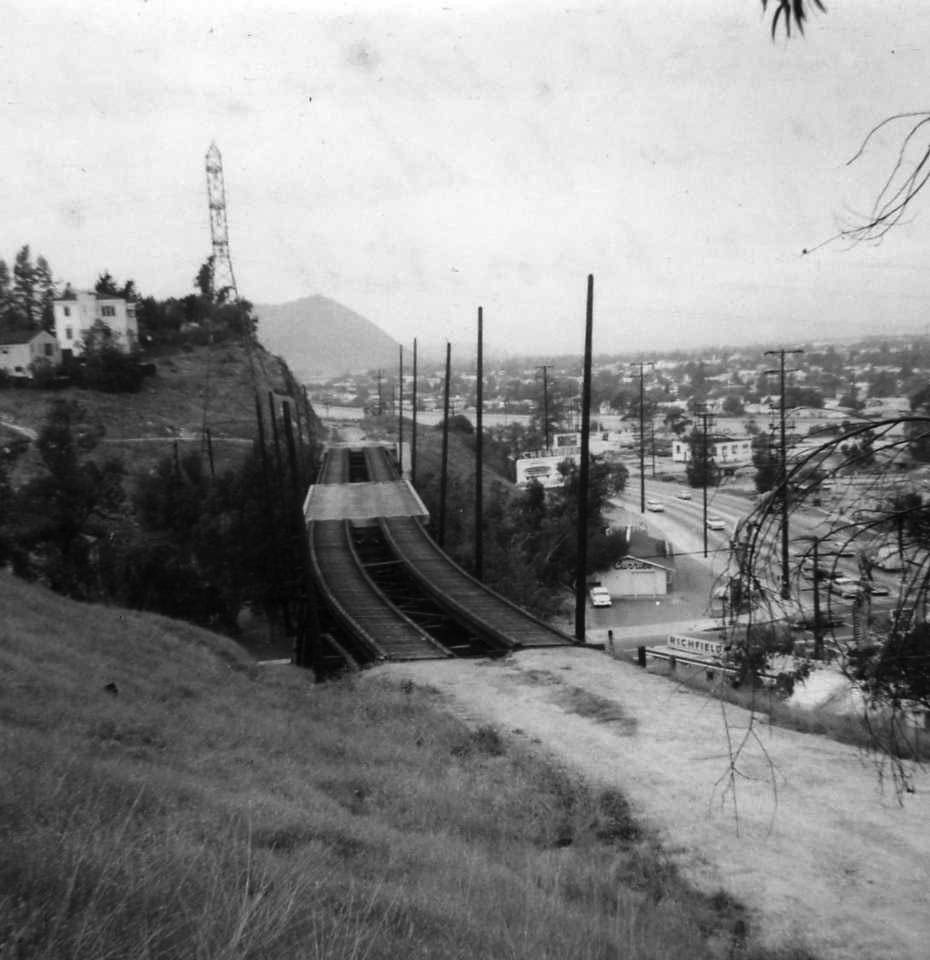 |
|
| (1959)^ – Top view of the Fletcher Viaduct shortly before it was demolished. Note the Richfield Service Station just below at center-right. |
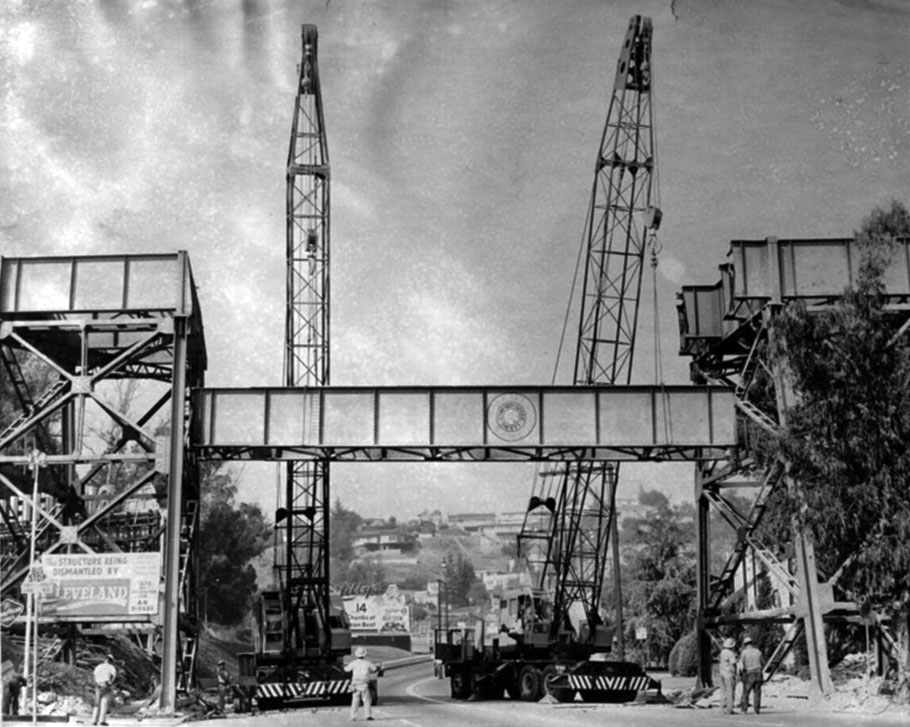 |
|
| (1959)* - Demolition of the old Pacific Electric bridge (aka Fletcher Viaduct) at Fletcher and Riverside drives. |
Historical Notes The viaduct, originally constructed in wood in 1904, was rebuilt as a steel trestle in 1928. It stood until 1959 when it, along with the nearby Riverside Drive Viaduct at Glendale Boulevard, was demolished |
 |
|
| (2022)* – Looking SW on Fletcher Drive from near Riverside Drive toward where the old Fletcher Viaduct used to stand. |
Historical Notes Today the Fletcher Viaduct's concrete footings and pylons are still there and have been designated as LA Historic-Cultural Monument No. 770 (Click HERE to see complete listing). |
Then and Now
 |
|
| (1959 vs 2022)* – Looking SW on Fletcher Drive from near Riverside Drive showing the Fletcher Viaduct before and after demolition. Photo comparison by Jack Feldman. |
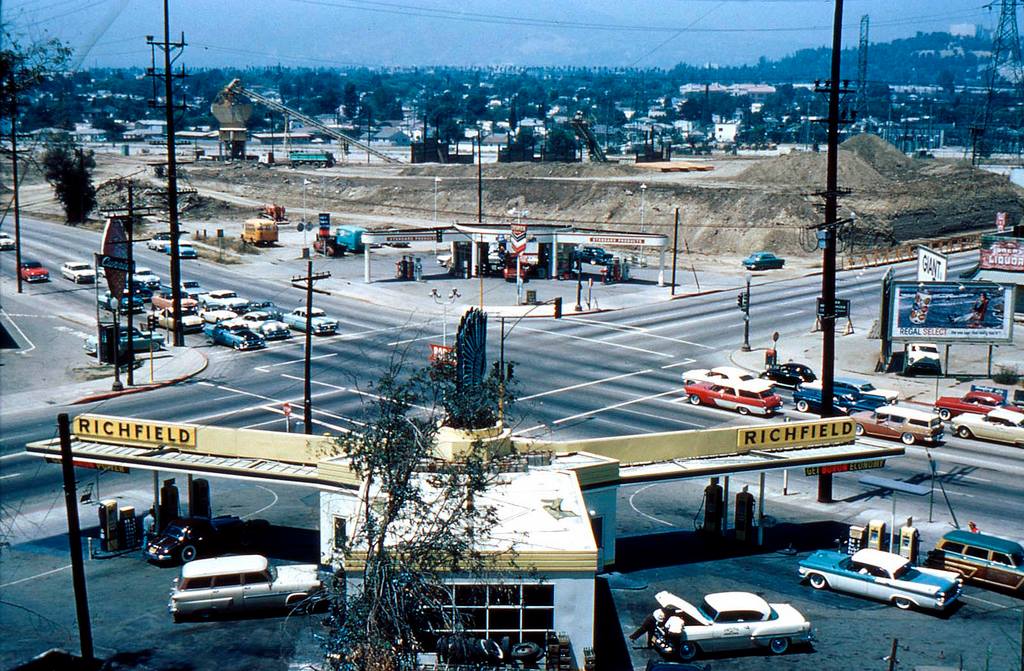 |
|
| (1950s)* – View looking northwest down toward the intersection of Fletcher and Riverside drives as seen from a Glendale Red Car on top of the Fletcher Viaduct. Currie’s Ice Cream store sign is visible on the left and the I-5 (Golden State Freeway) is at the excavation stage. The chapel at Forest Lawn can be seen in the distance (upper-right). Richfield Gas Station is the foreground. Click HERE to see more Early LA Gas Stations. |
Then and Now
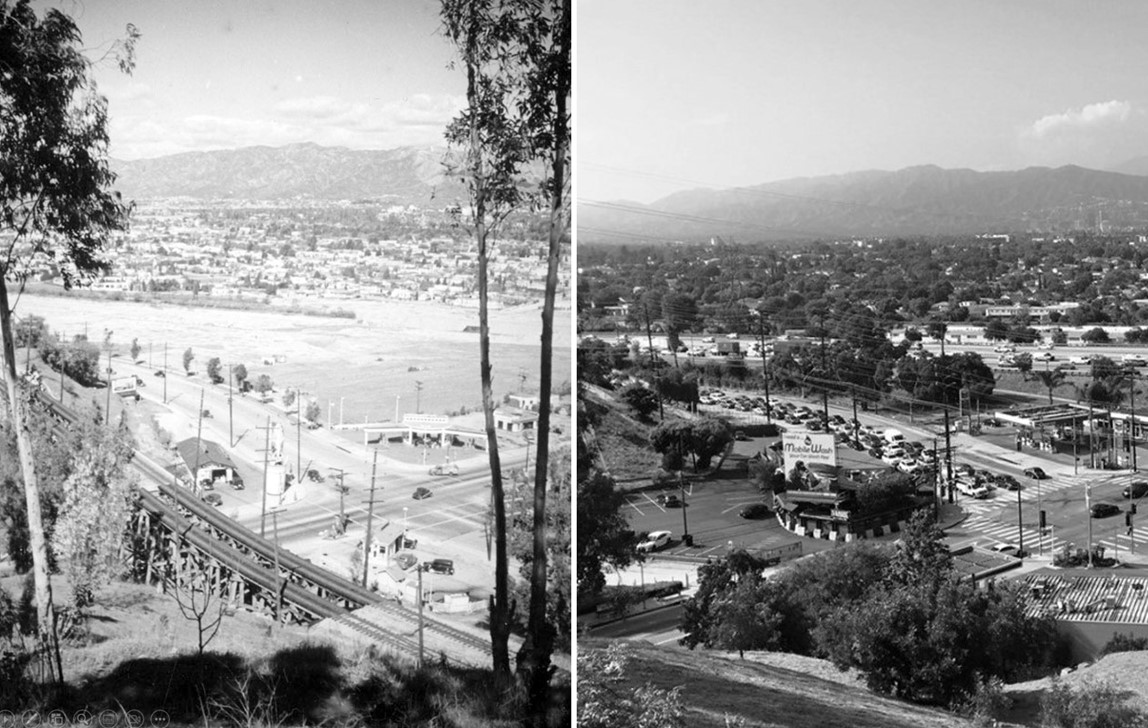 |
|
| (1938 vs. 2019)^ - View looking down toward the intersection of Fletcher and Riverside drives. Photo comparison by Jack Feldman. |
* * * * * |
Edendale
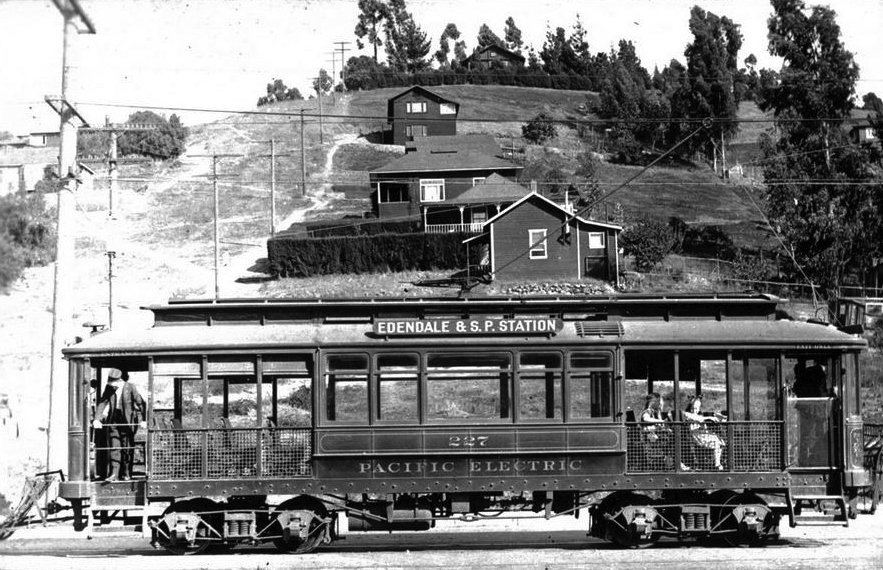 |
|
| (ca. 1914)^## – View showing Pacific Electric City Car No. 227 on the Edendale Glendale-Burbank Line. |
Historical Notes Edendale was the valley along Glendale Boulevard that traverses from Echo Park to the beginning of the 2 Freeway. Today the area is considered Silverlake on the west side and Elysian Park to the east. The grass median that runs along Glendale Boulevard used to be the Red Line Train that ran from downtown and would eventually be extended to Glendale along the hills behind the Red Lion Tavern. Edendale was widely known as the home of most major movie studios on the West Coast. Among its many claims, it was home to the Keystone Kops, and the site of many movie firsts, including Charlie Chaplin's first movie, the first feature-length comedy, and the first pie-in-the-face. The Edendale movie studios were mostly concentrated in a four-block stretch of Allesandro Street, between Berkeley Avenue and Duane Street. Allesandro Street was later renamed Glendale Boulevard (and a smaller nearby street took on the name Allesandro). The name Edendale is no longer used as a place name, and is little known today. A few remnants of the name are the local post office (officially called Edendale Station), a public library branch, an urban farm called Edendale Farm and a restaurant called Edendale. Although many of the structures from the 1910s remain and can be identified by careful comparison with old photos, this district today is located in an unremarkable commercial zone called the "Glendale Boulevard Corridor," which is known mostly for its function as a commuter thoroughfare between the southern end of the Glendale Freeway and downtown Los Angeles.*^ Click HERE to see a 1916 map showing the location of Edendale. |
 |
|
| (1910s)^.^ – Edendale Map showing all the studios along Allessandro Street (later Glendale Boulevard). |
Historical Notes The Los Angeles district of Edendale was one of the biggest producers of motion pictures in the entire world. It was here that the first screen pie fight broke out. It was also here that Roscoe “Fatty” Arbuckle and Mabel Normand became household names. Ant it was also in Edendale that an unknown English music-hall performer named Charles Chaplin first picked up a cane and derby, pasted on a stage mustache, slid into some baggy pants and an unusually large pair of mismatched boots, and waddled into the hearts of movie watchers worldwide.^ The Edendale movie studios were mostly concentrated in a four-block stretch of Allesandro Street, between Berkeley Avenue and Duane Street. Allesandro Street was later renamed Glendale Boulevard (and a smaller nearby street took on the name Allesandro). The former Mack Sennett Studio where Keystone Kops films were shot still stands behind a Jack in the Box -- although it's been repurposed as a Public Storage facility. Click HERE for contemporary view. |
Selig Polyscope Company Studio
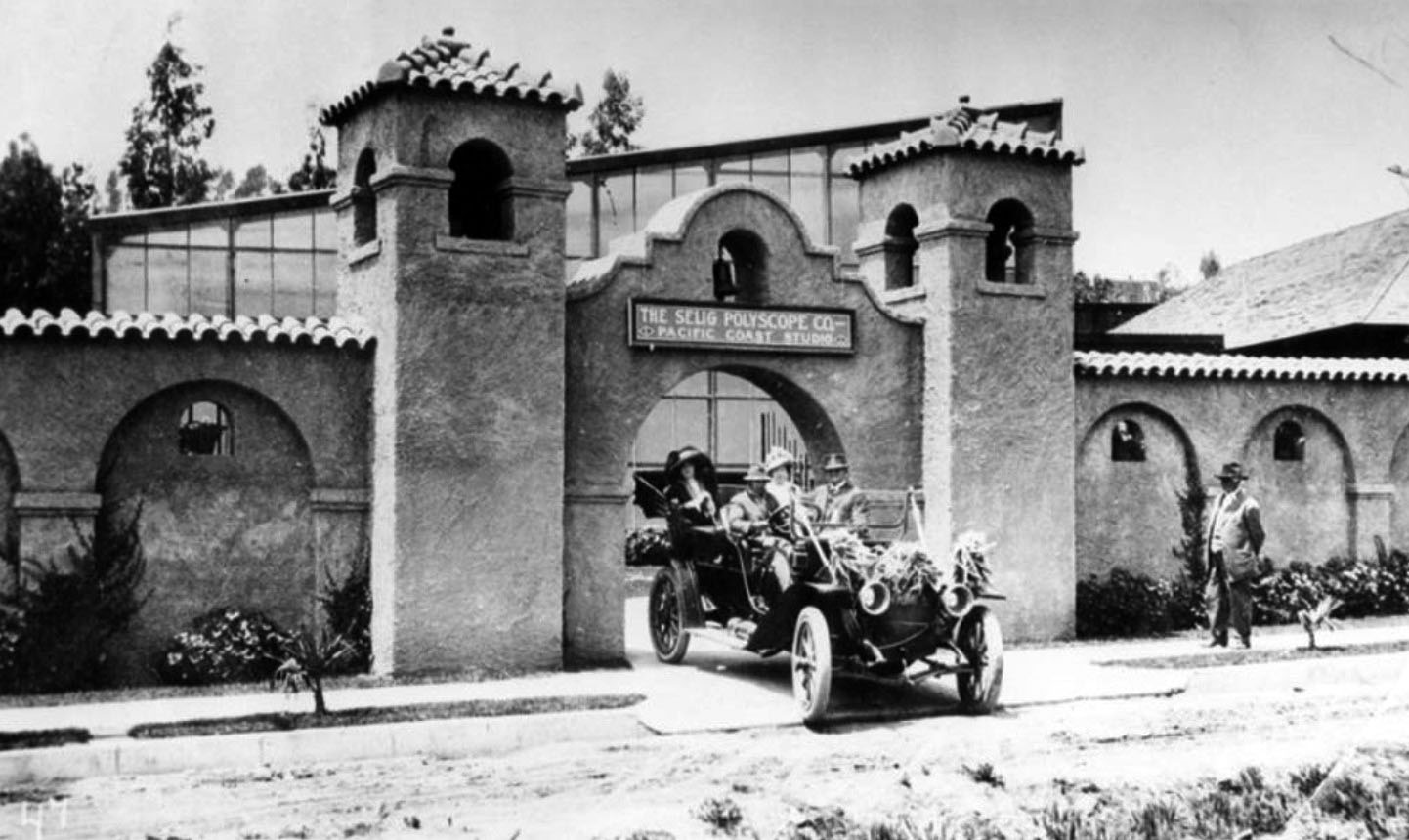 |
|
| (ca. 1909)^ - An early automobile is pulling out of the driveway of The Selig Polyscope Co., Pacific Coast Studio, onto an unpaved street. The studio is built in Mission Revival style located at 1850 Allesandro Street, later renamed Glendale Boulevard, in Edendale. |
Historical Notes Attracted by Southern California's mild, dry climate and varied geography for location shooting, William Selig set up his studio in Edendale in 1909 with director Francis Boggs, who began the facility in a rented bungalow and quickly expanded, designing the studio's front entrance after Mission San Gabriel.*^ |
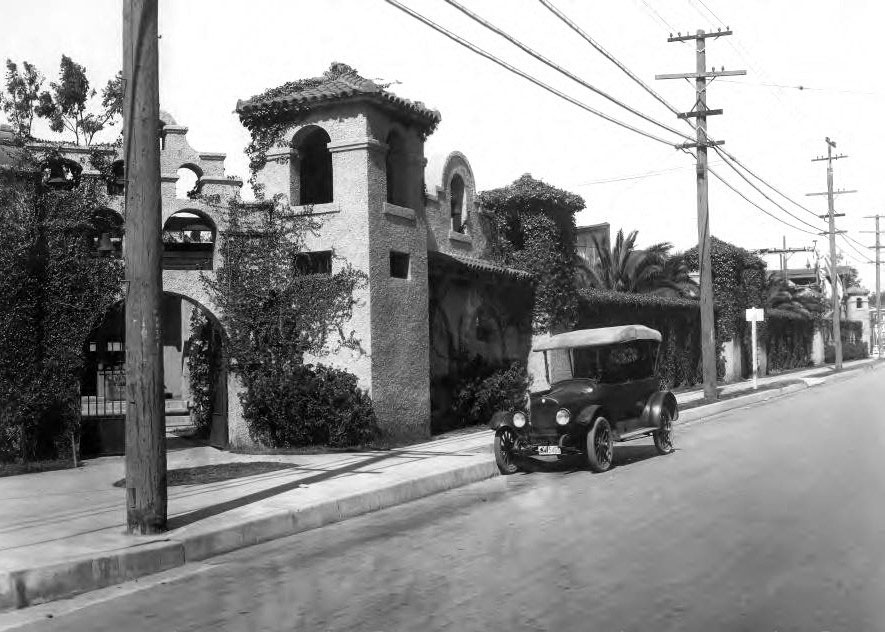 |
|
| (ca. 1910)*^ - Street view showing a car parked in front of the Selig Polyscope Company Studio in Edendale. |
Historical Notes Selig Plyscope Company produced hundreds of early, widely distributed commercial moving pictures, including the first films starring Tom Mix, Harold Lloyd, Colleen Moore, and Roscoe "Fatty" Arbuckle. In 1917 Selig sold the Edendale facility to producer William Fox and moved his movie studio to his zoo located in east Los Angeles. Meanwhile, World War I cut severely into the substantial revenues Selig Polyscope had been garnering in Europe and the company shunned profitable movie industry trends, which had shifted towards dramatic (and more costly) full length feature films. Selig Polyscope became insolvent and ceased operations in 1918.*^ Click HERE to see more on the Selig Zoo. |
William Fox Studio (formerly Selig Studio)
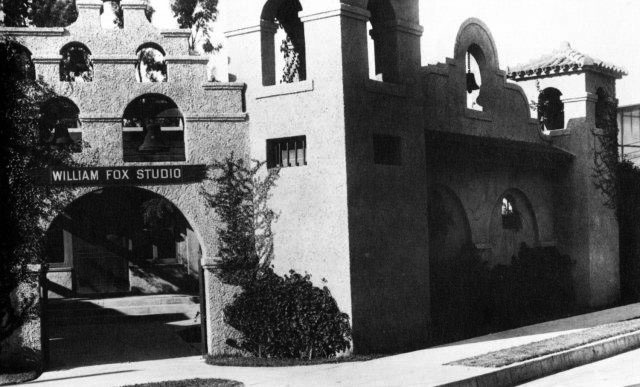 |
|
| (ca. 1917)^.^ - William Fox Studio at the former Selig Polyscope Co. Studio. Fox bought it from Selig around 1917. |
Historical Notes Long before there was Twentieth Century-Fox, there was the William Fox Studios at 1845 Allesandro St. in what was then called Edendale. |
 |
|
| (ca. 1916)^ - Selig studio building and swimming pool, leased by William Fox, located at the corner of Alessandro Avenue (later Glendale Boulevard) and Clifford Street. Two cars are parked, and there is a wave-making machine in the pool. |
Historical Notes William Fox (born as Wilhelm Fuchs) was a Hungarian-American motion picture executive, who founded the Fox Film Corporation in 1915 and the Fox West Coast Theatres chain in the 1920s. Although he lost control of his movie empire in 1930, his name lives on in the names of various media ventures, which are currently either owned by Rupert Murdoch, such as the Fox Broadcasting Company and the Fox News Channel, or by The Walt Disney Company, such as 20th Century Fox and 21st Century Fox.*^ |
Mack Sennett Studios (aka Keystone Studios)
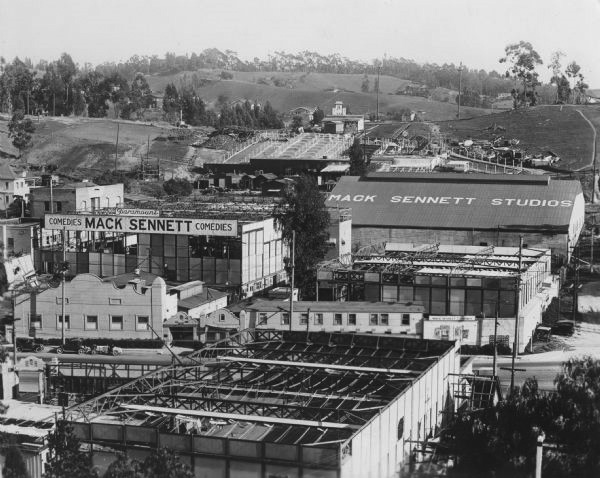 |
|
| (ca 1917)* - A high view of the Mack Sennett Studios showing many open-roofed studios with cloth diffusers. A huge sign reads: "Paramount-Comedies-Mack Sennett-Comedies." Paramount Pictures distributed Sennett's silent films from 1917 to 1921. The present address of the site is 1712 Glendale Boulevard, Echo Park. |
Historical Notes Keystone Studios was an early movie studio founded in Edendale (which is now a part of Echo Park) on July 4, 1912 as the Keystone Pictures Studio by Mack Sennett with backing from actor-writer Adam Kessel and Charles O. Baumann, owners of the New York Motion Picture Company. The company filmed in and around Glendale and Silver Lake for several years, and its films were distributed by the Mutual Film Corporation between 1912 and 1915.*^ The original main building, the first totally enclosed film stage and studio in history, is still standing at Glendale Blvd. between Aaron and Effie Streets in Echo Park, although it's been repurposed as a Public Storage facility. |
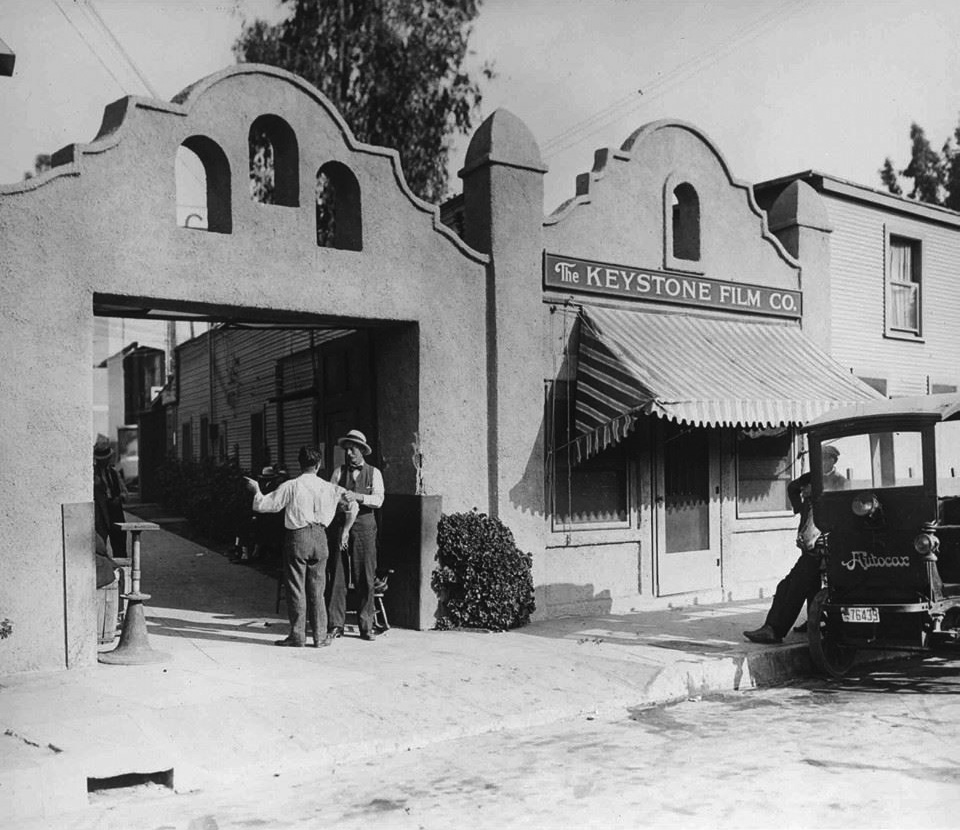 |
|
| (ca. 1917)* – Two men stand at the entryway to the Mack Sennett Studios while another two men are by an electric vehicle parked at the curb. The entrance was located at 1712 Allesandro Street (later Glendale Boulevard around 1922-23) in Edendale (later Echo Park). |
Historical Notes The studio is perhaps best remembered for the era under Mack Sennett when he created the slapstick antics of the Keystone Cops, from 1912, and for the Sennett Bathing Beauties, beginning in 1915. Charles Chaplin got his start at Keystone when Sennett hired him fresh from his vaudeville career to make silent films. Other important actors worked at Keystone toward the beginning of their film careers, including Marie Dressler, Harold Lloyd, Mabel Normand, Roscoe Arbuckle, Gloria Swanson, Louise Fazenda, Raymond Griffith, Ford Sterling, Ben Turpin, Harry Langdon, Al St. John and Chester Conklin.*^ |
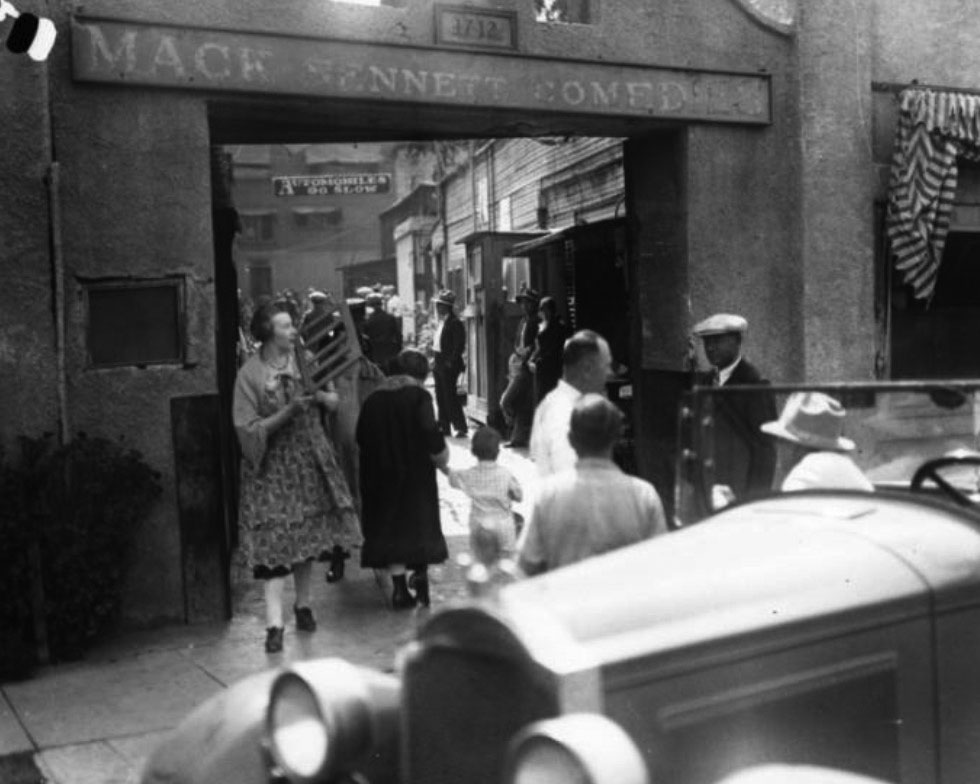 |
|
| (ca. 1917)^ – View showing the entrance to the Mack Sennett Comedies studio, located at 1712 Allesandro Street in Edendale. |
Historical Notes Mack Sennett's slapstick comedies were noted for their wild car chases and custard pie warfare, especially in the Keystone Cops series. Additionally, Sennett's first female comedian was Mabel Normand, who became a major star under his direction and with whom he embarked on a tumultuous romantic relationship. Sennett also developed the Kid Comedies, a forerunner of the Our Gang films, and in a short time, his name became synonymous with screen comedy which were called "flickers" at the time. Sennett departed the studio in 1917 to produce his own independent films (eventually distributed through Paramount). Keystone's business decreased after his departure, and finally closed after bankruptcy in 1935.*^ |
Norbig Studios
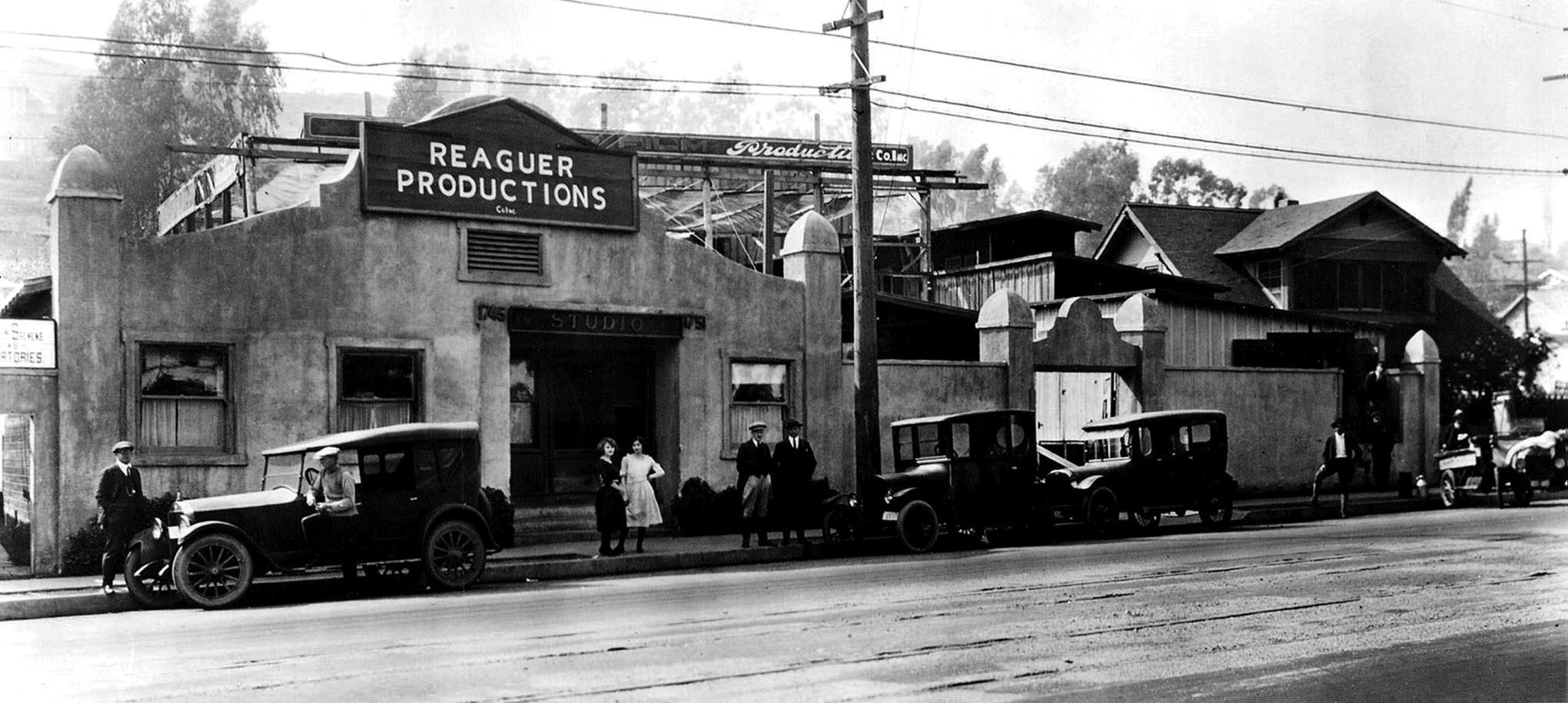 |
|
| (1922)^ – View showing Reaguer Productions located in the Norbig Studios at 1745-1751 Allesandro (now Glendale Blvd), between Aaron and Branden Streets, on the border between Echo Park and Silverlake. Click HERE for contemporary view. |
Historical Notes The above Edendale lot, now gone, was owned by Norbig Studios. It served as a rental lot housing many early companies, including: ◆ Norbig Studios (1914-1919) Studio is long since gone.* Edendale would eventually run out of moviemaking space and within a decade studios were moving over the hill to the dry Methodist community of Hollywood. Edendale’s final claim to fame would be the community of artists and communists that lived there right before World War II. With the construction of the Glendale Freeway cutting up the neighborhood, Edendale became Silverlake, Los Feliz, and Elysian Fields. |
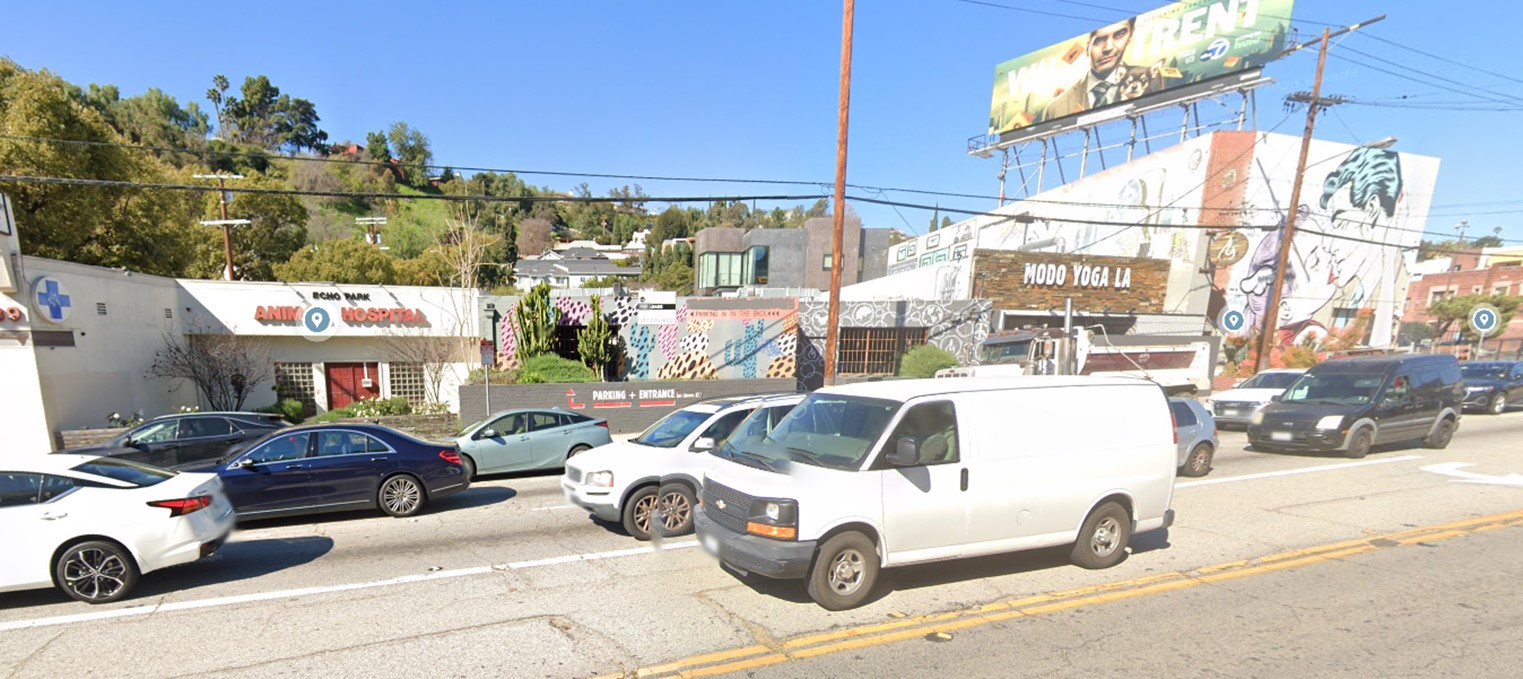 |
|
| (2023)* - Looking at the west side of Glendale Bouelvard (originally Alesandro Avenue) where Reaguer Productions, Norbig Studios, and so many other movie production companies once operated from. |
Then and Now
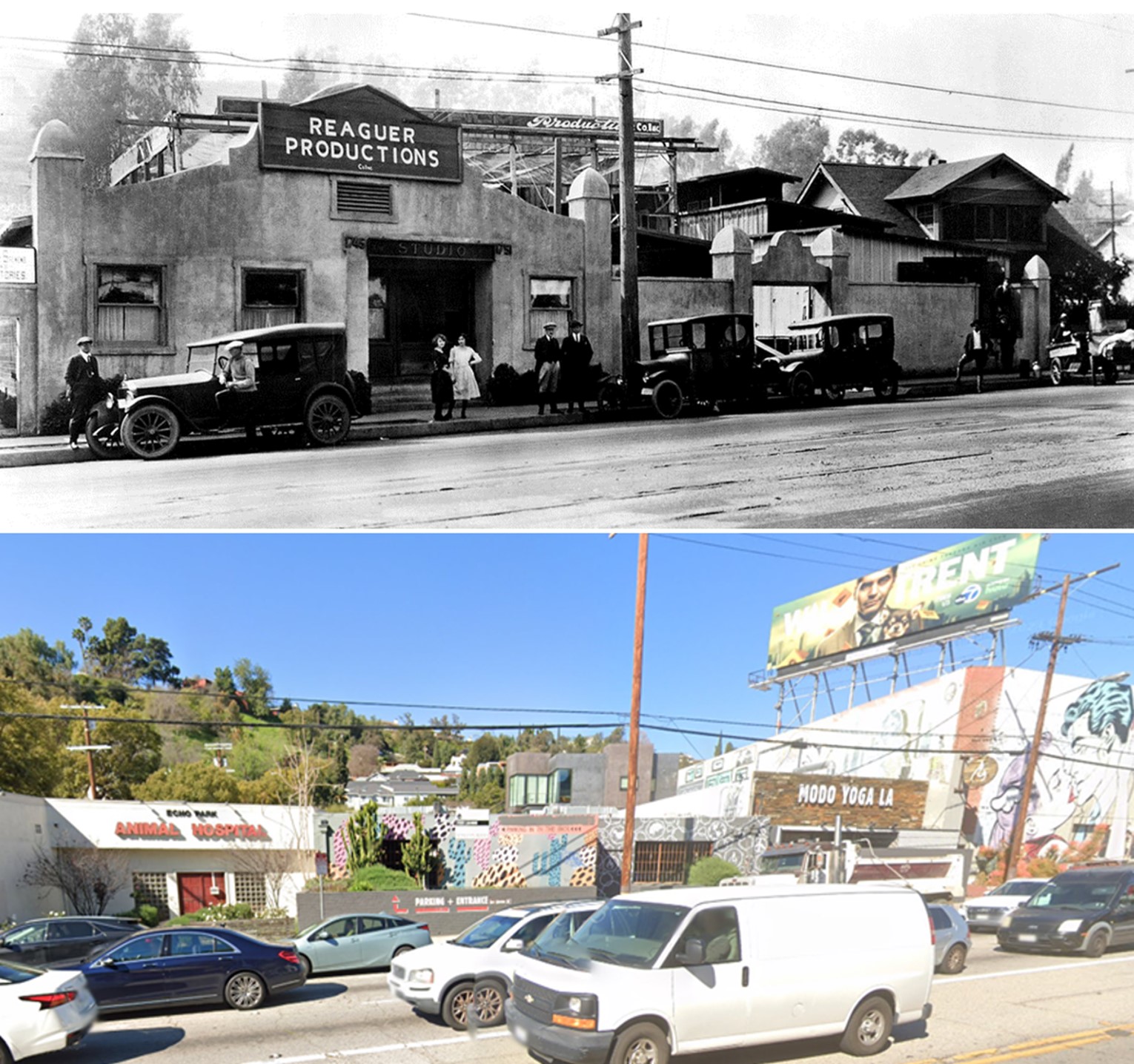 |
|
| (1922 vs 2023)* - Looking at the west side of Glendale Bouelvard (originally Alesandro Avenue) where Reaguer Productions, Norbig Studios, and so many other movie production companies once operated from. Located at 1745-1751 Allesandro (now Glendale Blvd), between Aaron and Branden Streets. Photo comparison by Jack Feldman. |
* * * * * |
Silver Lake
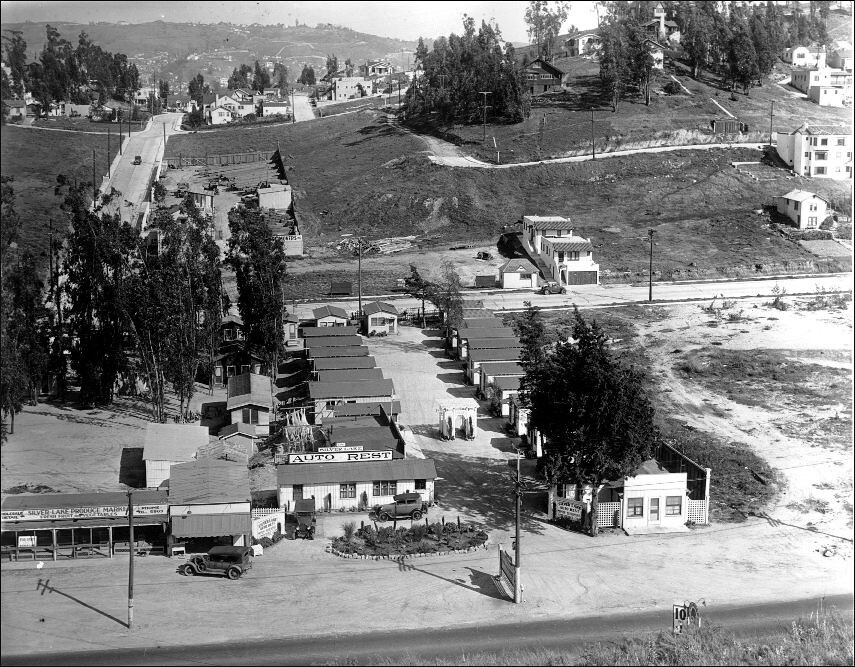 |
|
| (1920s)* - Looking down across Glendale Boulevard showing the Silver Lake Auto Court located at 2500 Glendale Blvd. The street on the left running away from the camera is India Street. |
Historical Notes Silver Lake is a residential and commercial neighborhood in the east-central region of Los Angeles. Originally home to a small community called Ivanhoe in honor of Sir Walter Scott. In 1907, the Los Angeles Water Department built the Silver Lake Reservoir, named for LA Water Commissioner Herman Silver, giving the neighborhood its name. The area is now known for its architecturally significant homes, independently owned businesses, diverse restaurants, painted staircases, and a creative environment. The neighborhood is also home to several highly rated public and private schools. Click HERE to see more on the Silver Lake Reservoir. |
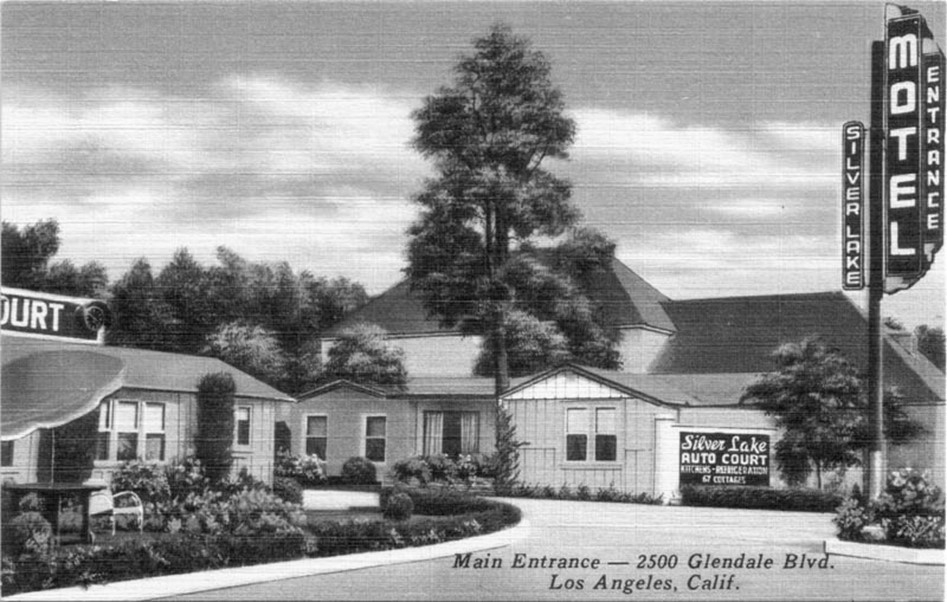 |
|
| (n.d.)* – Postcard view showing the main entrance to Silver Lake Auto Court at 2500 Glendale Blvd. |
Historical Notes On the reverse of the card it states: "A 67 unit Auto Court with Trailer Sites. Resort Atmosphere in the heart of the City, well known for its Hospitality and Service. Rates Most Reasonable." |
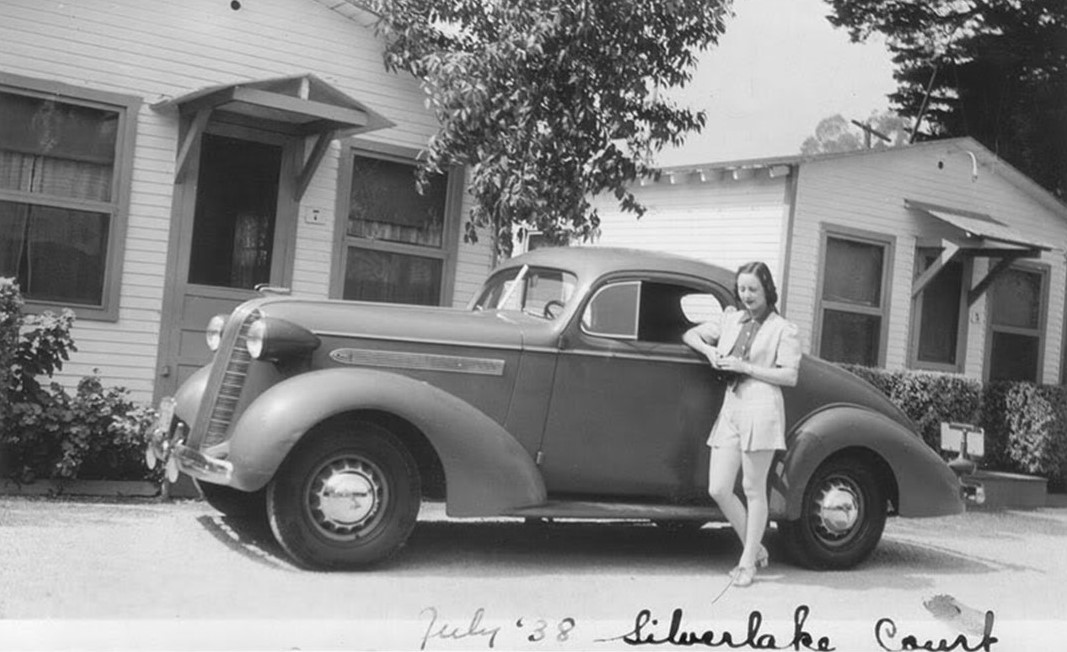 |
|
| (1938)* - A young woman stands next to a 1936 Pontiac Master Six Coupe at the Silver Lake Auto Court, 2500 Glendale Boulevard. |
Then and Now
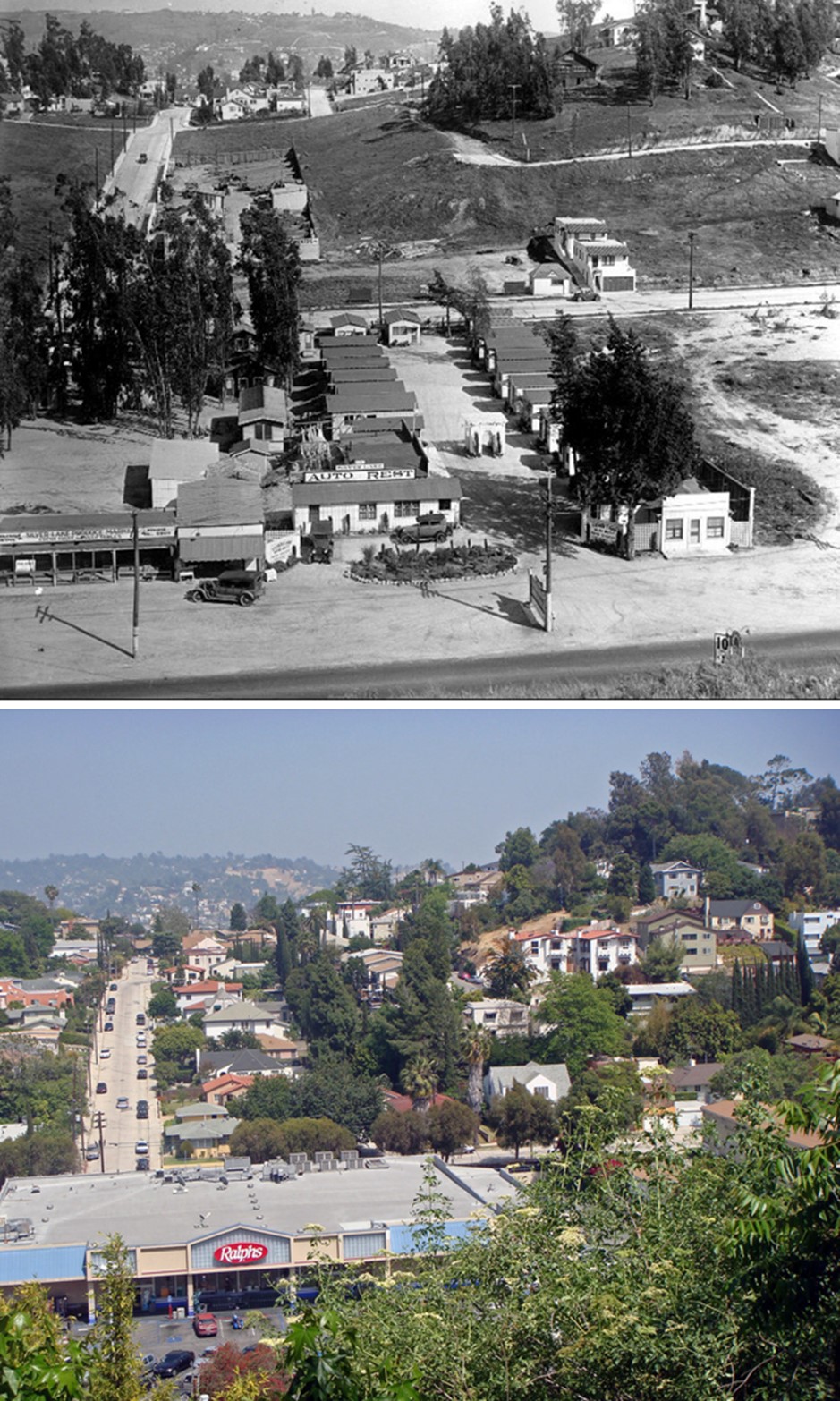 |
|
| (1920s vs 2016)* – Looking east from over Glendale Blvd with India Street running away from the camera on the left. The Ralphs Market seen below is now a Whole Foods Market (2520 Glendale Blvd). Photo comparison by Jack Feldman. |
Sunset Boulevard and Micheltorena Street
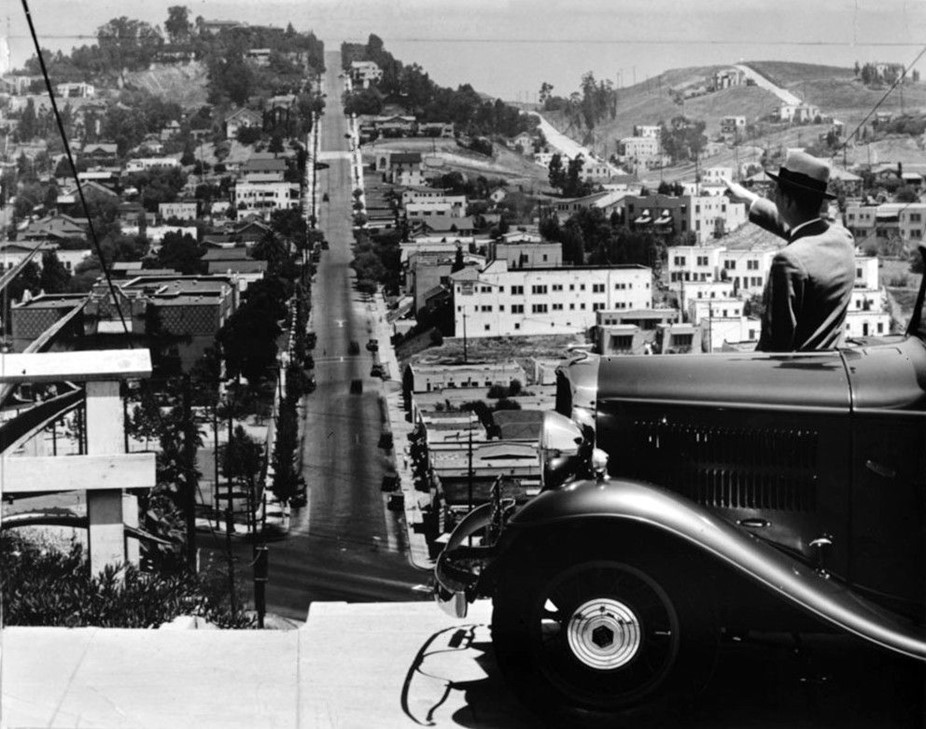 |
|
| (1932)* - A view of Silver Lake, looking north on Micheltorena Street from above Sunset Boulevard. |
Then and Now
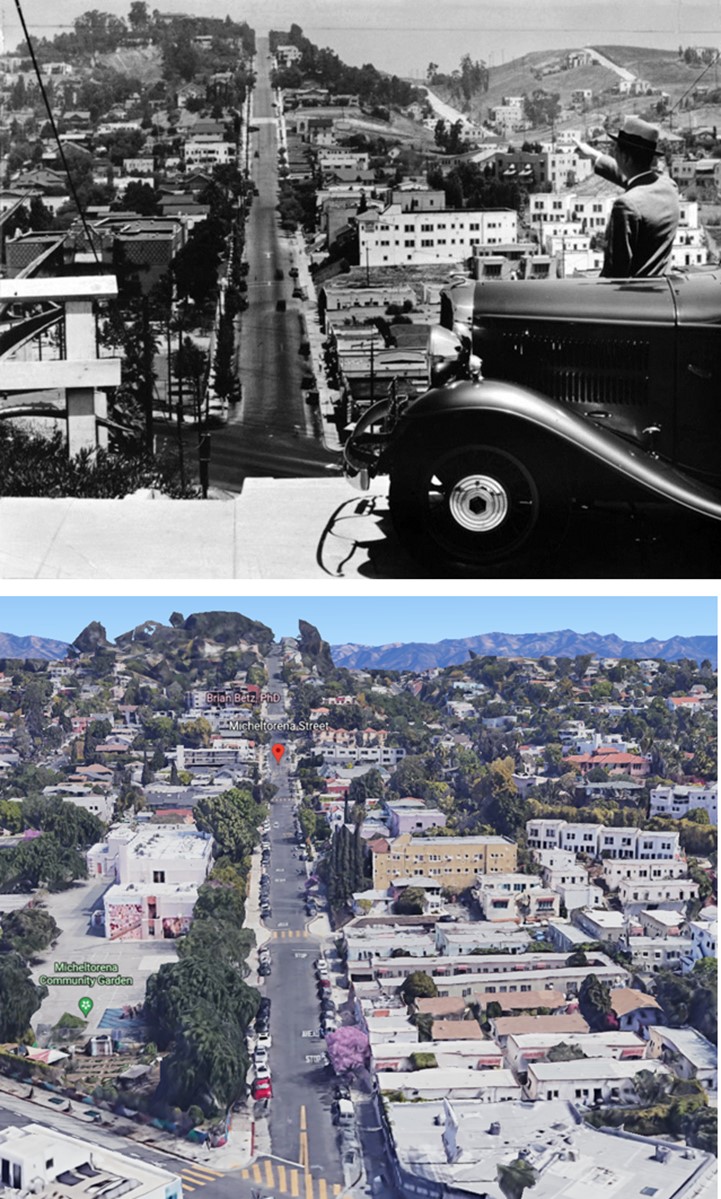 |
|
| (1932 vs. 2022)* - A view of Silver Lake, looking north on Micheltorena Street from above Sunset Boulevard. Photo comparison by Jack Feldman. |
* * * * * |
Glassell Park and Cypress Park
 |
|
| (1900)^ - The Los Angeles River and a farming area looking northeast from Elysian Park. The view is looking toward Cypress Park and Glassell Park. |
Historical Notes Glassell Park is bordered on the north by Glendale, on the northeast and east by Eagle Rock, on the southeast by Mount Washington, on the south and southwest by Elysian Valley and on the west by Atwater Village. |
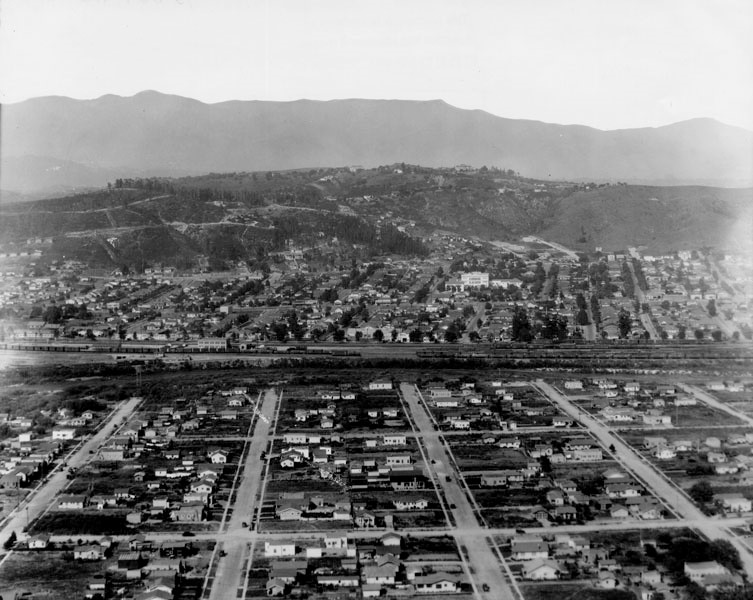 |
|
| (1926)^ - Panoramic view of residential areas bordering the Los Angeles River as seen from Elysian Park, looking northeast toward Glassell Park, Cypress Park and Mt. Washington. Compare to previous photo. |
Historical Notes Cypress Park is situated near the confluence of the Los Angeles River and Arroyo Seco, less than 2.5 miles north of Downtown Los Angeles. It lies within a historic alluvial floodplain shared with the Elysian Valley neighborhood, which is bounded by Elysian Park and Mt. Washington. |
* * * * * |
Highland Park
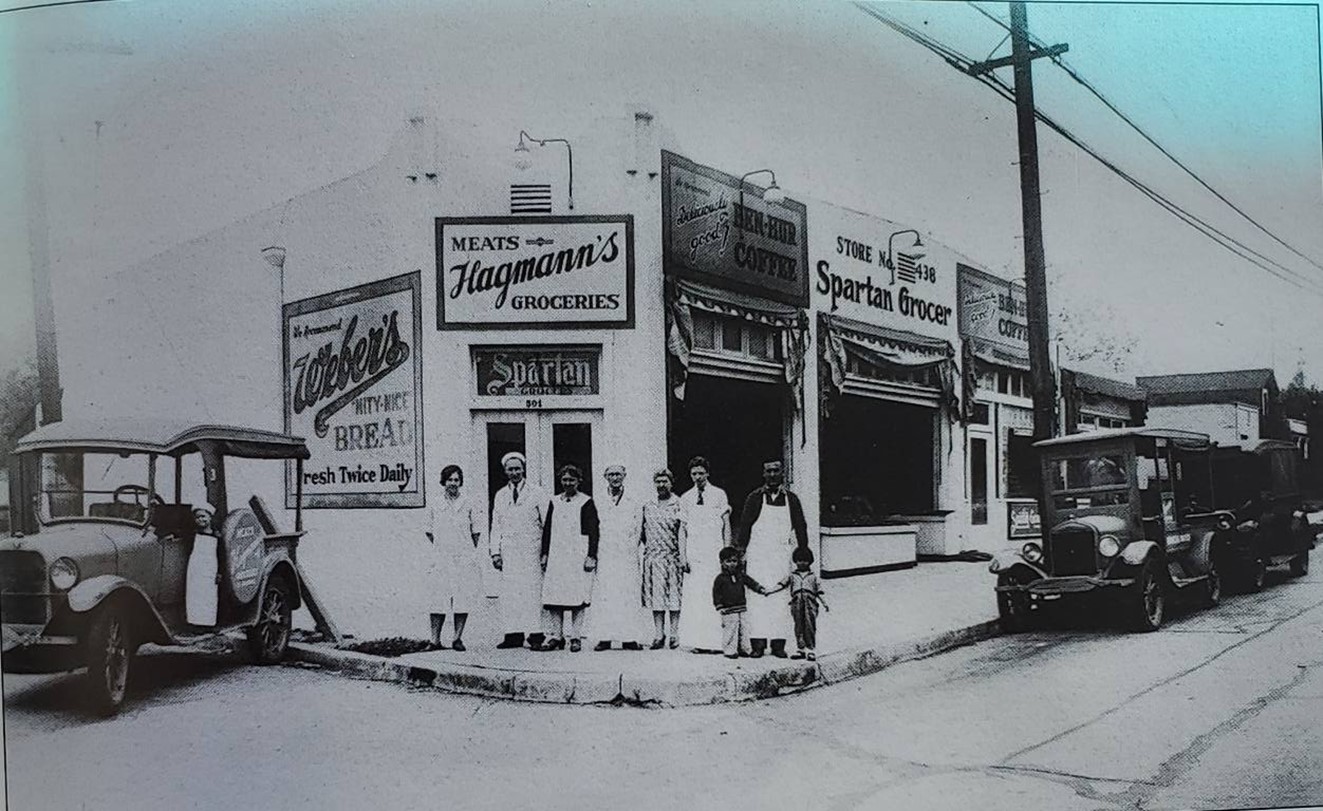 |
|
| (1920)* – Workers and possible owners, along with two children, pose in front of Hagmann’s, a “mom-and-pop” grocery store on the northwest corner of Figueroa Street and Springvale Avenue in Highland Park. This stretch of Figueroa was once part of historic Route 66. |
Historical Notes Figueroa Street in Highland Park was once part of Route 66 during its Transitional (1932-1934) and Alternate (1936-1940) alignments. It served as the main street of Highland Park until the Arroyo Seco Parkway opened on December 30, 1940, which bypassed the area. Before being named Figueroa, the road was known as Pasadena Avenue and had sections called Dayton Avenue. |
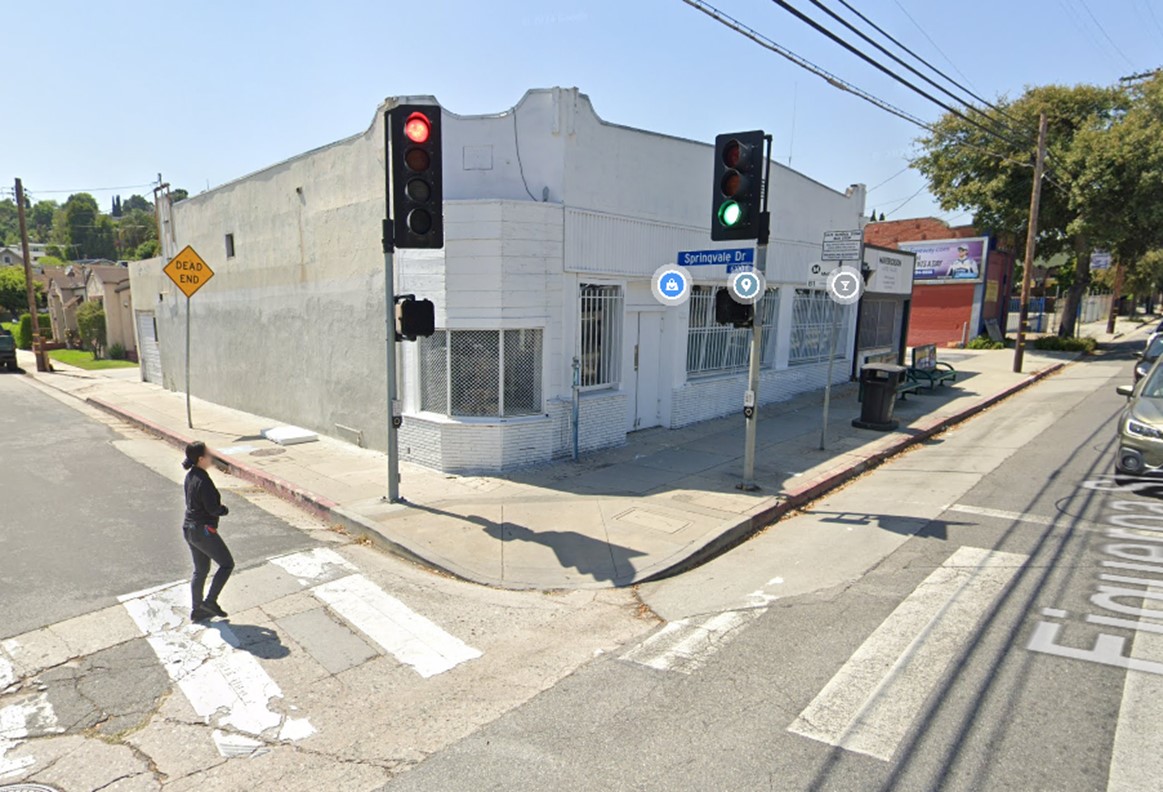 |
|
| (2024)* - A woman crosses the street toward the northwest corner of Figueroa Street and Springvale Avenue in Highland Park, approaching an unmarked building that once housed Hagmann’s grocery store in the 1920s |
Historical Notes Over the past decade, Figueroa Street in Highland Park has undergone a remarkable transformation, evolving from a predominantly working-class Latino area to one of northeast Los Angeles' most vibrant commercial corridors. The street has seen an influx of upscale businesses, including trendy restaurants, coffee shops, and creative enterprises, alongside rising property values and rents. Despite this rapid change, efforts have been made to preserve the area's historic character, with many older buildings being rehabilitated rather than demolished. New mixed-use developments are also emerging, aiming to increase housing and commercial space. This evolution has attracted media and tech companies, establishing Figueroa Street as a mini-design district. However, the rapid gentrification has raised concerns about displacement and affordability among long-time residents. Overall, Figueroa Street now represents a dynamic blend of old and new, balancing its historic charm with modern urban development, making it an increasingly desirable location for businesses and residents alike in Los Angeles. |
Then and Now
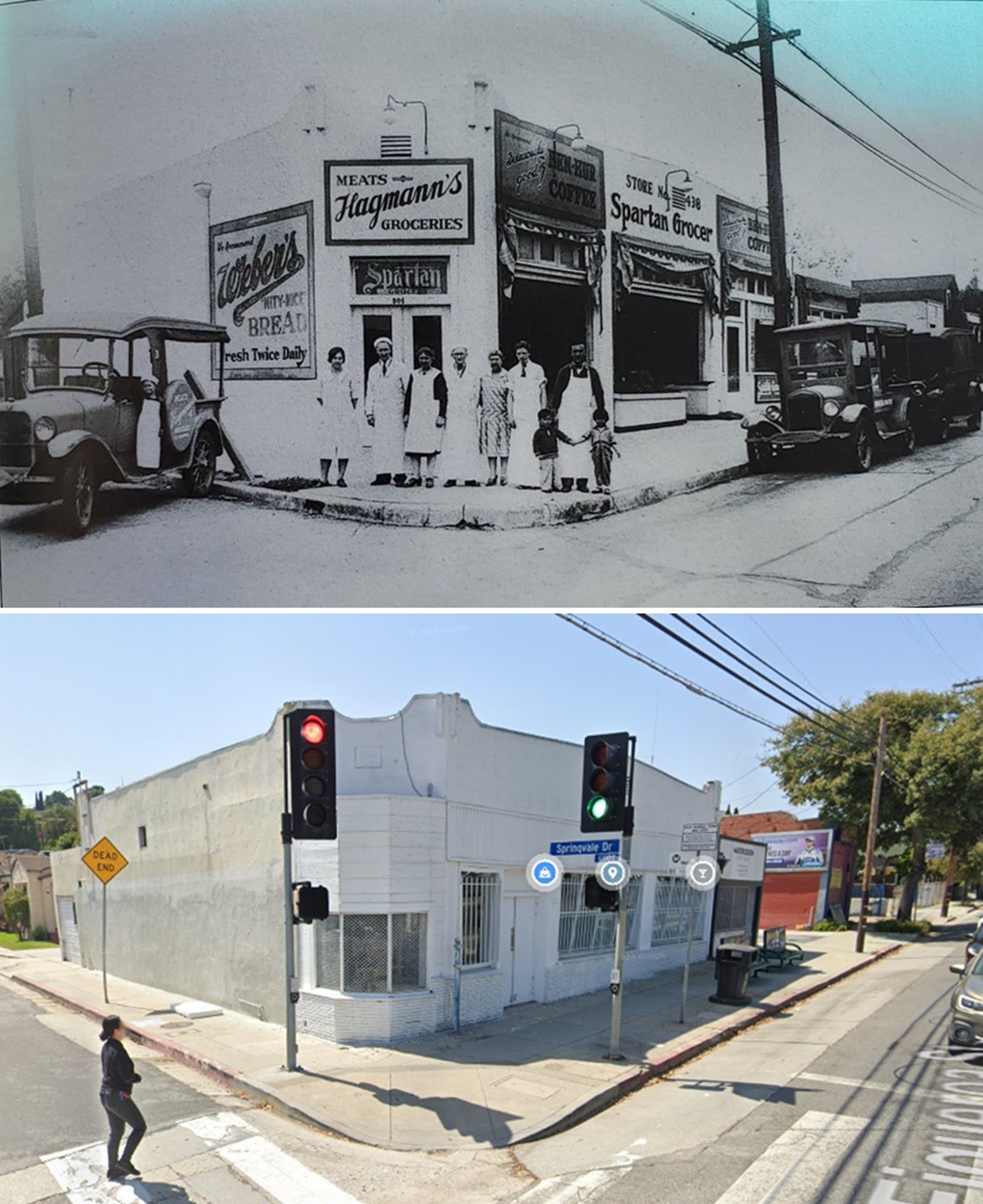 |
|
| (1920 vs. 2024)* – A view of the northwest corner of Figueroa Street and Springvale Avenue, once home to Hagmann’s grocery store. |
Historical Notes Figueroa Street in Highland Park is currently grappling with a complex set of challenges stemming from rapid gentrification. The area is experiencing a significant displacement of long-time residents and local businesses due to rising property values and rents, leading to an affordable housing crisis and the erosion of the neighborhood's cultural identity. This has created tension between newer, often more affluent residents and established community members, resulting in protests and increased community activism. The street faces the difficult task of balancing new development with the preservation of its historic character and architectural heritage. Additionally, the influx of new businesses and residents has exacerbated traffic and parking issues, straining local infrastructure. Economic disparities are widening, and there's growing concern about maintaining the area's racial, ethnic, and economic diversity. The overarching challenge lies in finding ways to improve the neighborhood that benefit all residents, not just newcomers, while preserving the community ties and cultural richness that have long defined Highland Park. |
* * * * * |
Figueroa and Piedmont
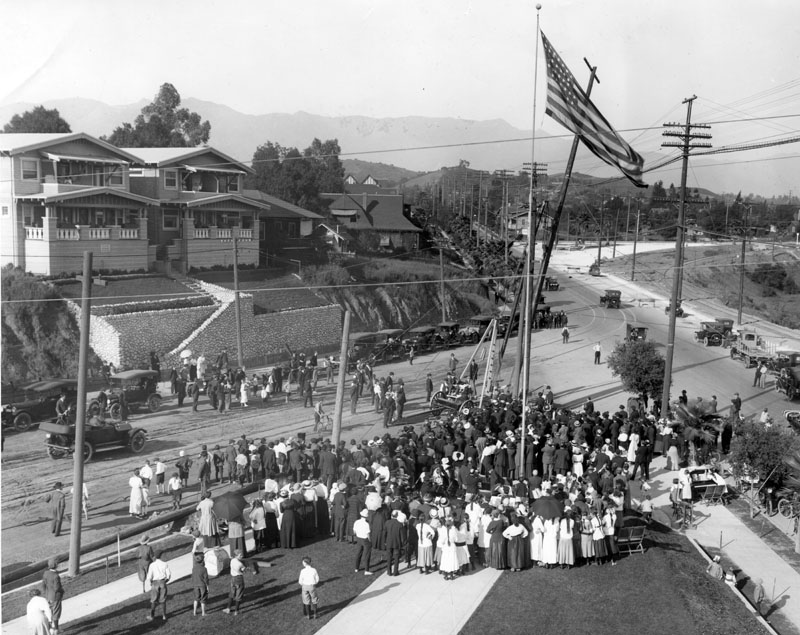 |
|
| (1916)* – A crowd gathers to watch the raising of a power pole at the corner of Pasadena Avenue (now Figueroa Street) and Piedmont Avenue in Highland Park. This event marked the inauguration of a power distribution system by the Los Angeles Bureau of Power and Light (now LADWP) and represents a significant milestone in the utility’s history. This photo was taken from the top of Arroyo Seco Branch Library. |
Historical Notes On March 18th, 1917, the Bureau of Power and Light opened its first major hydro-electric power plant, San Francisquito Power Plant No. 1. The plant used water from the recently completed Los Angeles Aqueduct to generate electricity. The LA Bureau of Power and Light would now be able to sell its excess San Francisquito generated power to Pasadena over two newly constructed 34 kV lines between the two cities. By 1917, World War I had forced the price of fuel oil to rise making the new lower cost hydroelectric power extremely desirable. The Los Angeles Bureau of Power and Light became part of the Los Angeles Department of Water and Power (LADWP) in 1937. Click HERE to see more on Los Angeles' 1st Municipal Power Pole. |
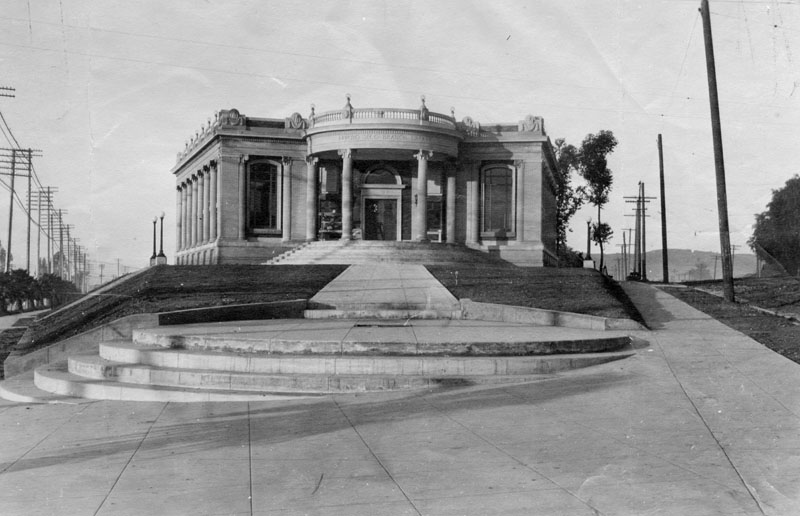 |
|
| (ca. 1916)* - View of the Arroyo Seco Branch Library at the intersection of Pasadena Avenue (now Figueroa Street) and Piedmont Avenue. |
Historical Notes The Arroyo Seco Branch Library was completed in 1914. It was the second of six branches built between 1913 and 1916 with a $210,000 Carnegie grant obtained by Los Angeles in 1911. All but one of these branches included a basement assembly room and an outdoor reading area. In 1932, Pasadena Avenue in Highland Park was renamed to Figueroa Street as part of a larger urban planning initiative in Los Angeles. This change coincided with the completion of the Figueroa Street Tunnels, which created a more direct route between downtown Los Angeles and Highland Park. The renaming was designed to establish Figueroa Street as a continuous thoroughfare from downtown through Highland Park and up to Eagle Rock. Prior to this change, the section of what is now Figueroa Street in Highland Park above Avenue 39 was known as "Pasadena Avenue." |
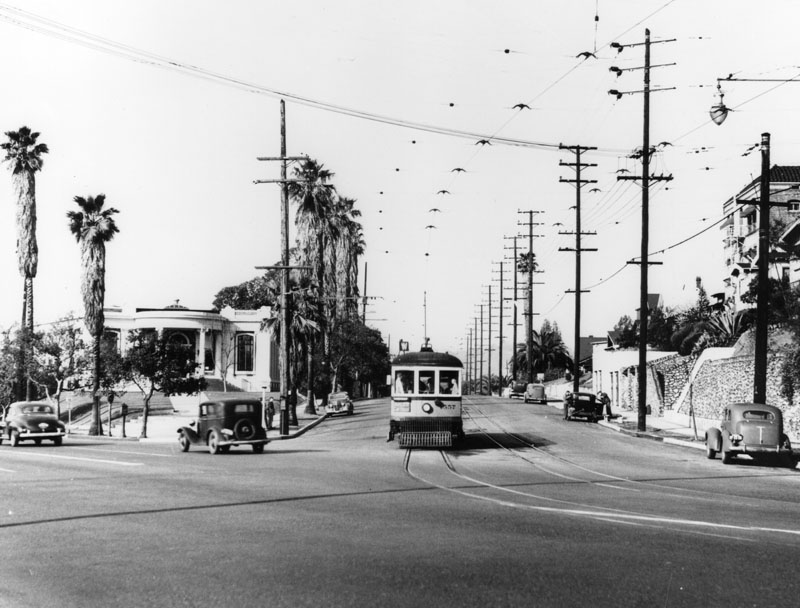 |
|
| (1946)* - View looking southwest on Piedmont Avenue, with the Arroyo Seco Branch Library on the left and a streetcar approaching the bend at N. Figueroa Street. |
Historical Notes In the 1940s, Highland Park's streetcar service along North Figueroa Street, particularly at the intersection with Piedmont Street, was primarily provided by Line 5, operated by the Los Angeles Railway (LARy). This line connected Eagle Rock to downtown Los Angeles and was known for its frequent service, contributing to the vibrant commercial atmosphere of the neighborhood. |
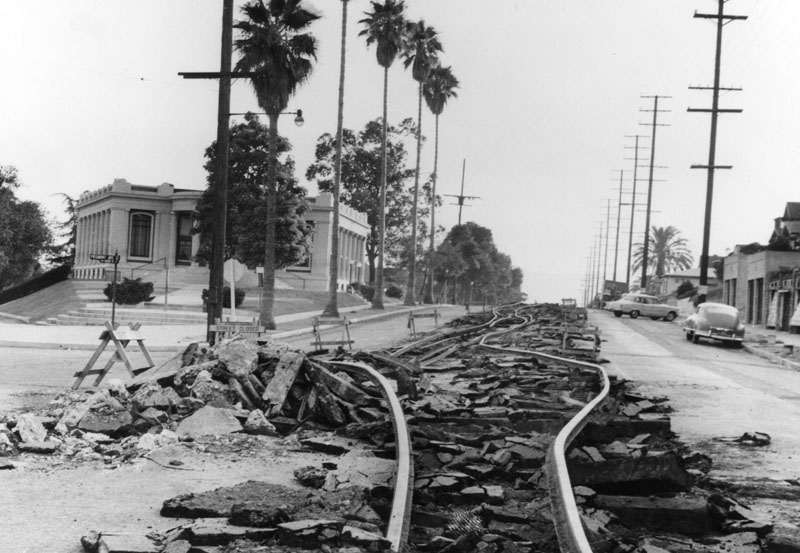 |
|
| (1958)* - View of the old streetcar tracks being torn up on Piedmont Avenue, with one of LADWP’s first power poles still standing in its original location at the corner of Piedmont Avenue and N. Figueroa Street. |
Historical Notes The decline of streetcar service along North Figueroa Street and Piedmont Street in Highland Park was part of a larger trend affecting the Los Angeles Railway (LARy) system in the mid-20th century. Operating from 1895 to 1963, LARy faced financial challenges as early as the 1920s and 1930s, leading to service cuts and the introduction of more efficient streetcars. The rise of bus services and increasing private automobile ownership further pressured the system. Despite a brief period of improved service in the 1920s, the Great Depression and subsequent decades saw a gradual shift away from streetcars. By the 1940s and 1950s, many lines were being replaced by buses. The specific line serving Highland Park, Line 5, continued operating until May 22, 1955, when it was discontinued due to Arroyo Seco Parkway construction. This marked the end of the streetcar era in Highland Park. |
Before and After
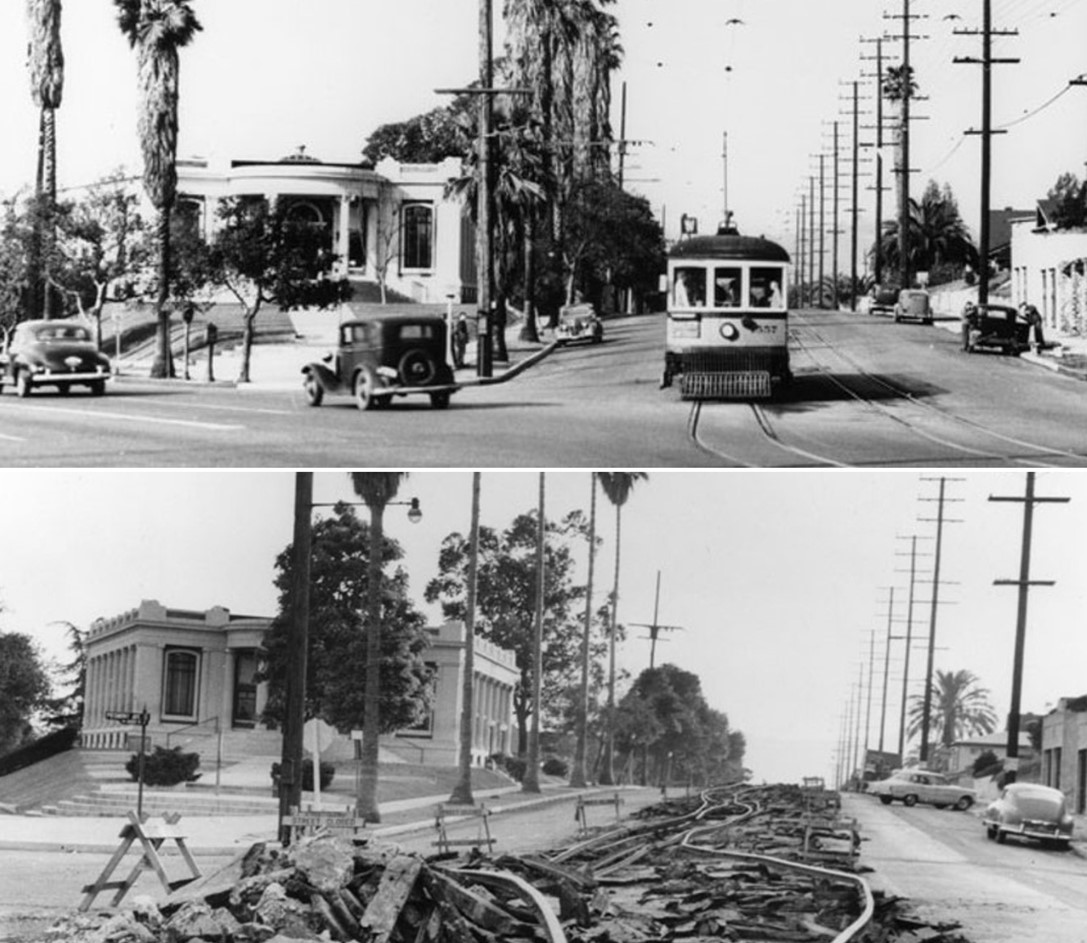 |
|
| (1946 vs. 1958)* - Before and after the removal of the Los Angeles Railway (LARy) tracks on Piedmont Avenue at nd N. Figueroa Street, with the Arroyo Seco Branch Library on the left. |
Then and Now
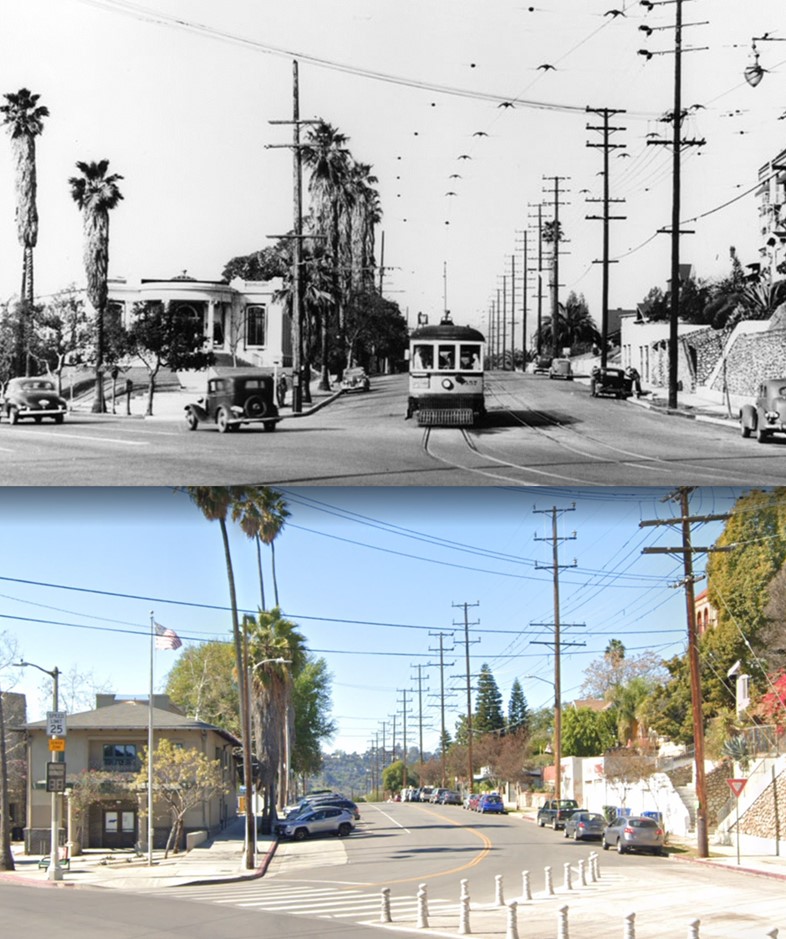 |
|
| (1946 vs. 2021)* – Looking southwest on Piedmont Avenue, with a streetcar heading toward the bend at N. Figueroa Street in Highland Park. |
Historical Notes The original Arroyo Seco Library, built in 1914 in the Classical Revival style, was replaced by a new building in 1960, and then again in 2003. Click HERE to see more. |
* * * * * |
Glendale
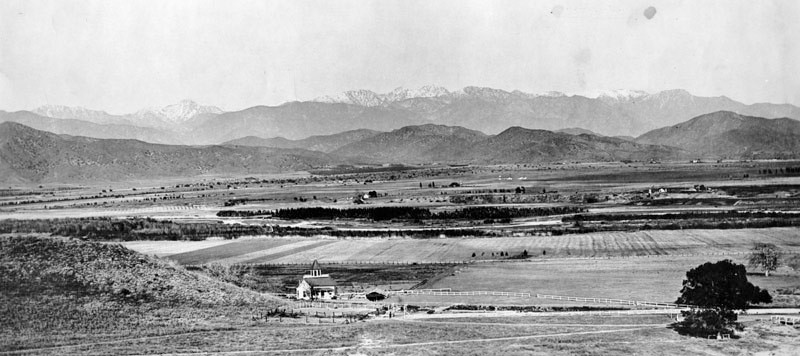 |
|
| (ca. 1900)^ - Panoramic view from Griffith Park of the site of the later city of Glendale as it appeared sometime between the partition of the great San Rafael Rancho in 1870 and the founding of the town in the middle eighties. The Verdugo Hills and San Gabriel Mountains are seen in background. |
Historical Notes In 1884, residents gathered to form a townsite and chose the name "Glendale" (it was bounded by First Street (now Lexington Drive) on the north, Fifth Street (now Harvard Street) on the south, Central Avenue on the west, and the Childs Tract on the east). Residents to the southwest formed "Tropico" in 1887. The Pacific Electric Railway brought streetcar service in 1904. Glendale incorporated in 1906, and annexed Tropico 12 years later. |
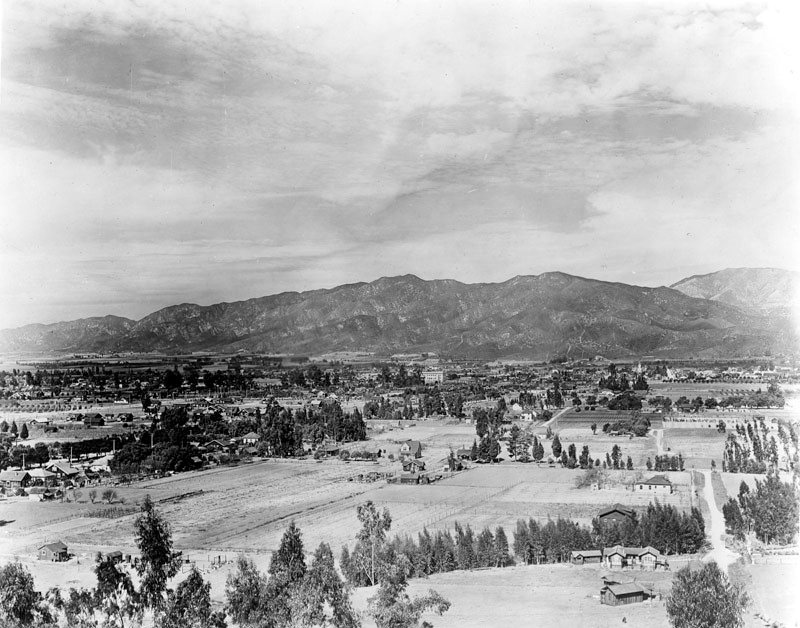 |
|
| (ca. 1910)* - Panoramic view of Glendale, taken from Forest Lawn Hill. |
 |
|
| (ca. 1915)* - Panoramic view of Glendale showing the Pacific Electric Railway running north and south on Brand Boulevard. |
Historical Notes The Pacific Electric Railway brought streetcar service to Glendale in 1904. An important civic booster of the era was Leslie Coombs Brand, who built an estate in 1904 called El Miradero featuring an eye-catching mansion whose architecture combined characteristics of Spanish, Moorish, and Indian styles (today’s Brand Library and Art Center). Brand partnered with Henry E. Huntington to bring the Pacific Electric Railway, or the "Red Cars," to the area. Today, he is memorialized by one of the city's main thoroughfares, Brand Boulevard. |
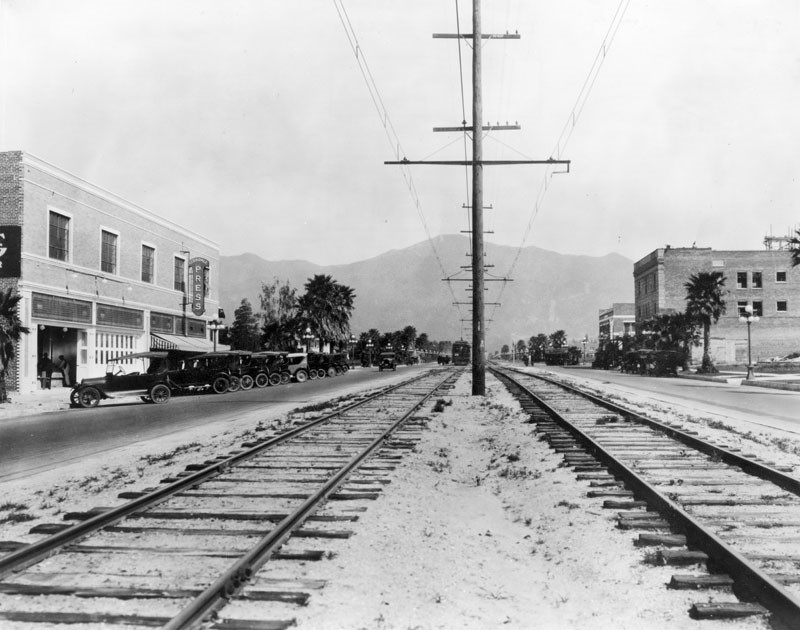 |
|
| (1919)^ - View of Brand and Lexington and the surrounding area. The Glendale Press building is on the left. The train in the distance is stopped to pick up passengers waiting along the way. |
Then and Now
 |
|
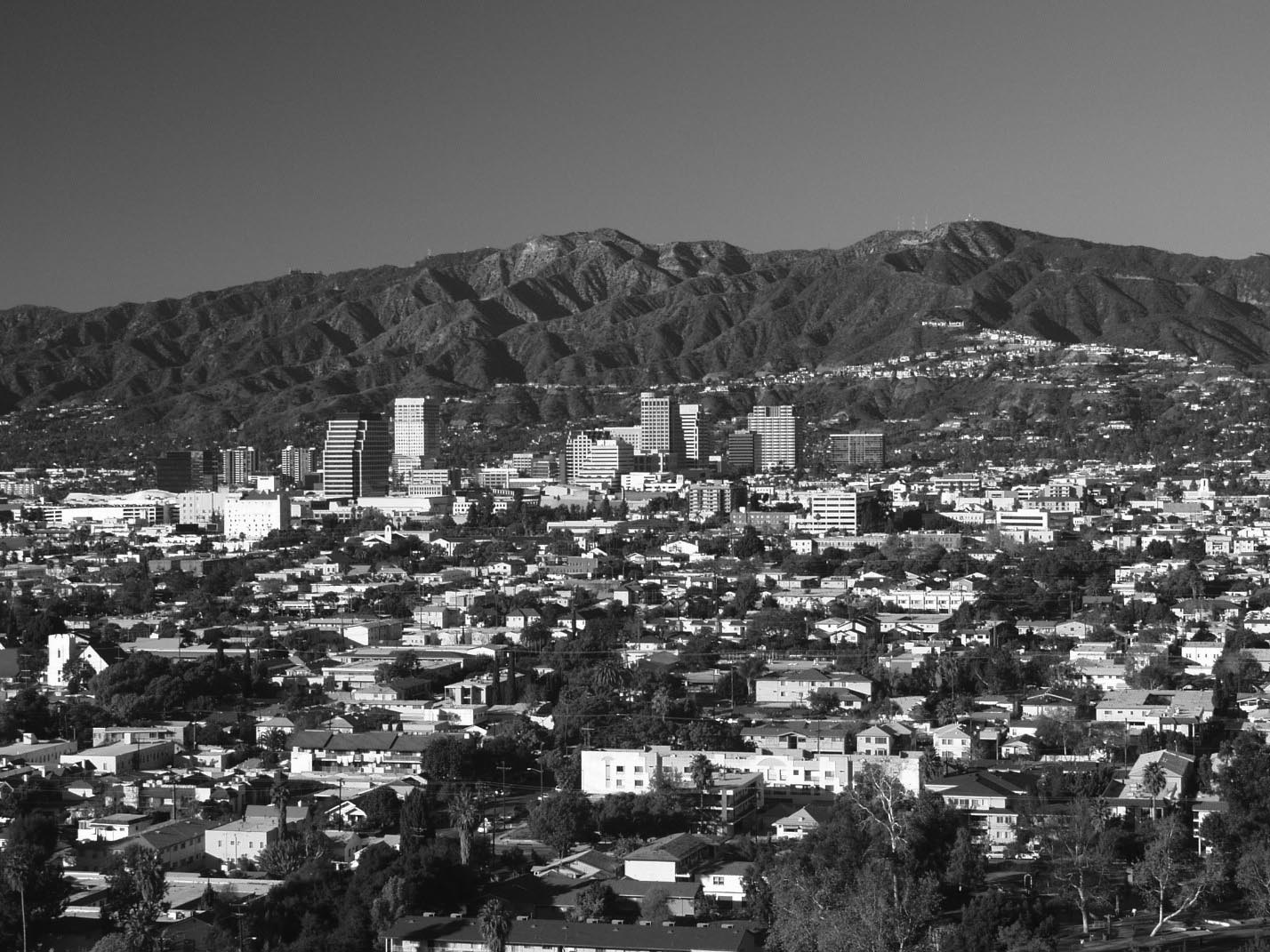 |
|
| (1910 vs 2009)* - View of Glendale from Forest Lawn Memorial Park |
Historical Notes When incorporated in 1906, Glendale consisted of only 1,486 acres. By 1920, the City had grown through nine annexations to over 7,000 acres. From 1920 to 1930, ten annexations brought the total area to 12,294 acres. Click HERE to see more Early Views of Glendale |
* * * * * |
City of Tropico
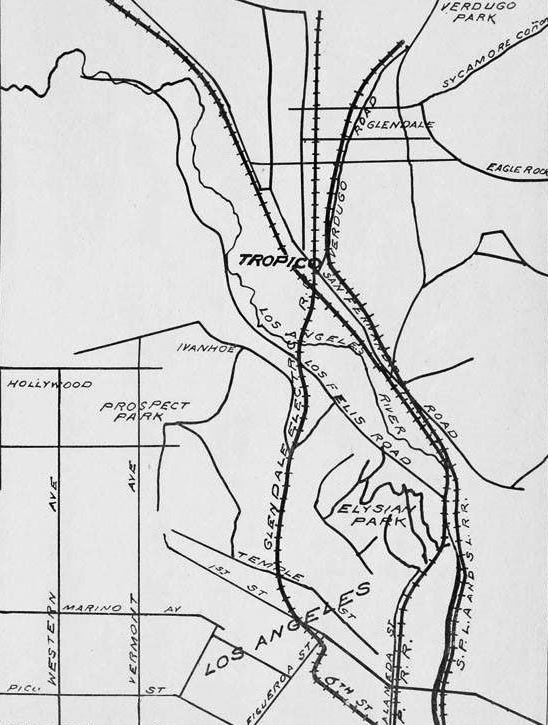 |
|
| (1903)#+++ – A map of Tropico showing rail lines and surrounding area. |
Historical Notes Tropico was put on the map as a fertile agricultural spot in the late 1800s. Shortly thereafter, the town began distancing itself from the rest of Glendale. In 1918, the neighborhood formally succeeded in becoming an independent entity for a short time. |
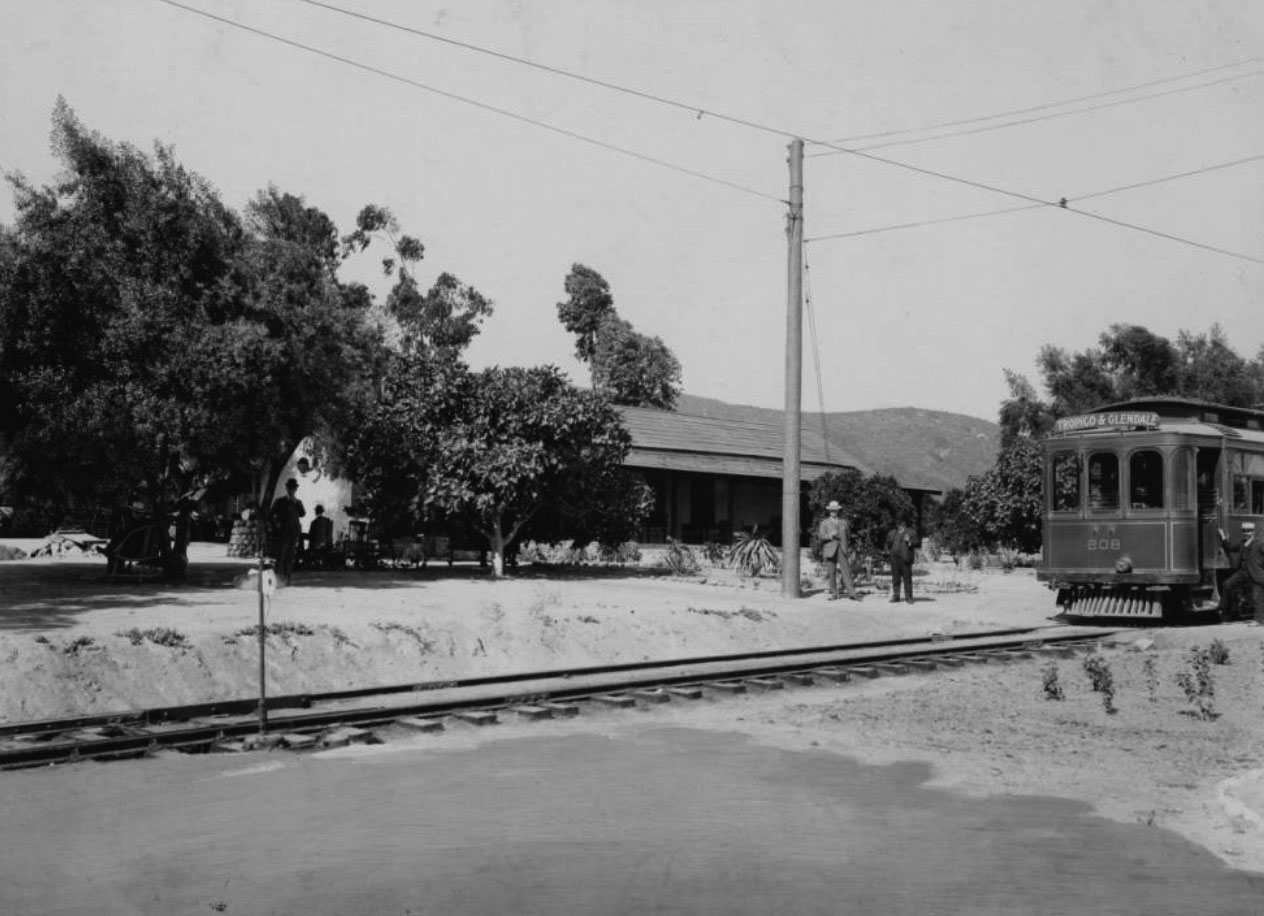 |
|
| (ca. 1900)^^ – View showing a "Tropico & Glendale" electric car outside Casa Verdugo adobe (Catalina Verdugo Adobe) in Glendale. The conductor stands outside of his electric car on the right with the tracks in front of him leading to the left foreground. Two more men stand next to an electrical pole at center while others sit under the shade of trees at left. The adobe can barely be seen through the trees. |
Historical Notes Rancho San Rafael was granted to José María Verdugo on October 20, 1784. Don José died April 12, 1831, leaving his estate to his son Julio and his blind daughter Catalina. This adobe was built for Dona Catalina in the 1830s; she lived here until her death in 1861. Still in excellent condition, the Catalina, or Original Mud Block, Adobe is now in private ownership. Location: 2211 Bonita Dr, Glendale The Catalina Verdugo Adobe is registered as California Historical Landmark No. 637 and the California Parlor No. 247. Click HERE to see more California HIstorical Landmarks in LA. |
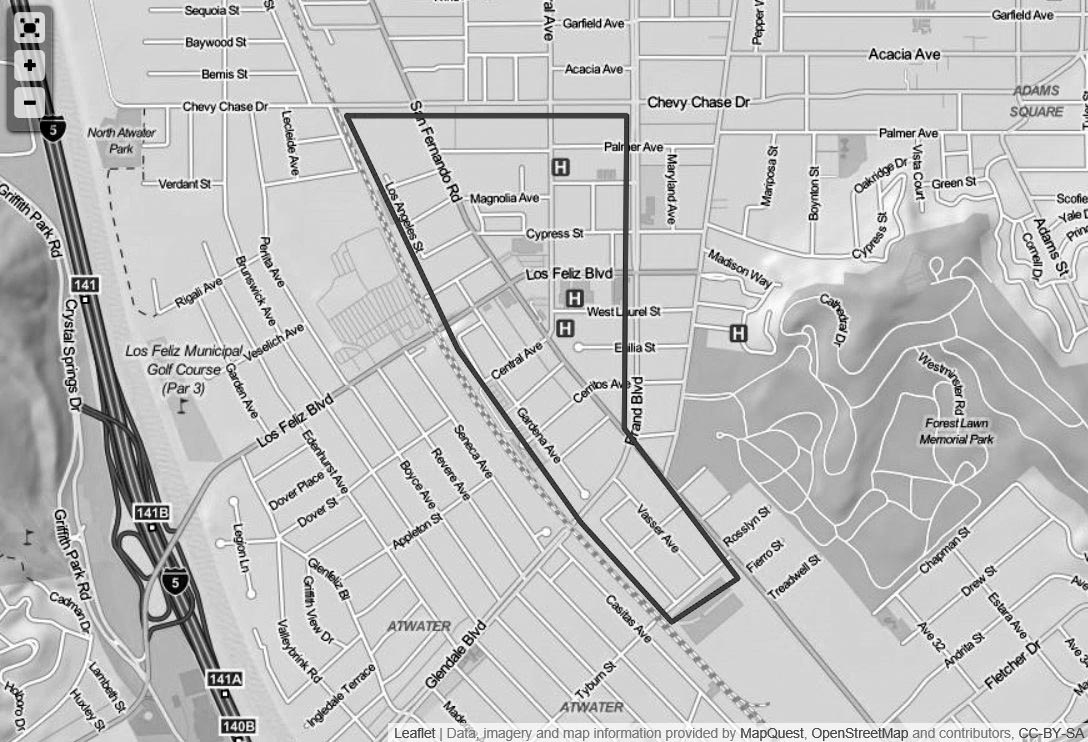 |
|
| (n.d.)*^ – Map view showing the boundaries of Tropico. |
Historical Notes Tropico was the name of the southern portion of Glendale, south of Windsor Road, between the late 1800s and 1918. The name "Glendale" had originated in the 1880s and was utilized north of Windsor Road. Political factions had divided the town in two. By the turn of the century, the commercial center of Tropico was at Central and San Fernando Road and its population was 700. ^##^ |
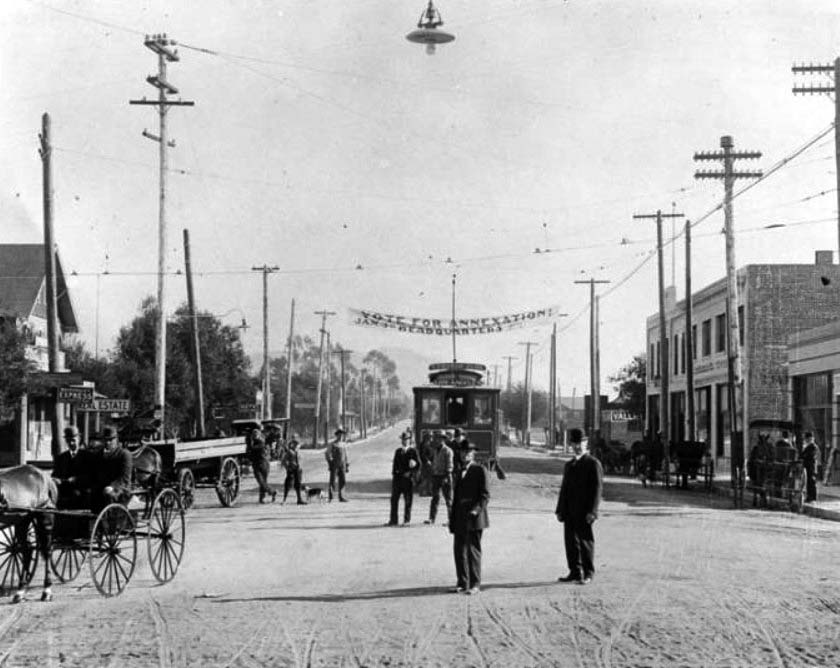 |
|
| (1911)##^ – A banner in support of the annexation of Tropico to Glendale in 1911 hangs outside the measure's headquarters on Broadway near Brand Boulevard in Glendale. The measure failed to pass, with Tropico instead voting for its own incorporation as a city. The issue would be revisited in 1918, when the upper half of Tropico would become a part of Glendale. |
Historical Notes Tropico was just a sleepy little village in the early 1900s. The business district included a few wooden buildings containing a general store, a blacksmith shop, meat store, livery stable, real estate offices and a few other small concerns. The buildings were all clustered near the intersection of San Fernando Road and Central Avenue. But within a few short years, the wood-frame buildings were replaced with brick, business boomed and the community became vibrant. The Tropico Art Tile Works stood just west of the railroad tracks, employing many people, and Tropico also became the shipping center for the strawberries raised in the area. Because of its proximity to Los Angeles, the area became a popular residential spot. The Tropico Chamber of Commerce organized in 1910, along with the Bank of Tropico, and soon the community realized it needed a city government. With so many of its residents commuting into Los Angeles, many favored annexing to Los Angeles. Others, seeing Glendale's successful example of home rule, wanted to be part of Glendale, which had incorporated in 1906. #+#+ |
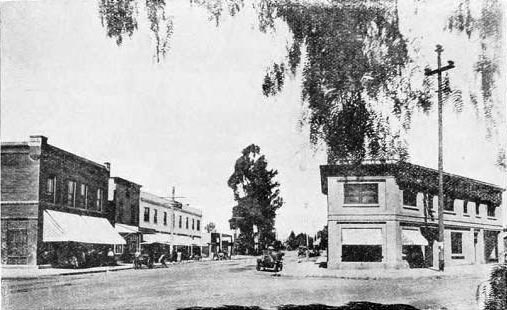 |
|
| (1910s)#+++ - View looking N/W on San Fernando Road at Central Ave with the Bank of Tropico located on the triangular lot at right. |
Historical Notes With so many of its residents commuting into Los Angeles, many favored annexing to Los Angeles. Others, seeing Glendale's successful example of home rule, wanted to be part of Glendale, which had incorporated in 1906. They felt that since the two communities were adjacent and in the same valley, they should be affiliated. Those favoring annexation with Glendale (mainly in the northeast part of Tropico) approached Glendale officials in 1911 and asked that an election be called. The publishers of the Tropico Sentinel vehemently opposed annexation, and the issue failed. Instead, Tropico incorporated as its own city, with Elkanah W. Richardson, son of Tropico's founder, W.C.B. Richardson, serving as a member of the board of trustees. The new city government immediately embarked on a badly needed improvement of the roads, but the annexation issue didn't go away. Petition after petition was filed, each one eventually failing, until finally, in 1918, the annexation proposal passed. The upper half of Tropico voted to go with Glendale, and the lower half voted to merge with Los Angeles. Today, that portion makes up the area known as Atwater. #+#+ |
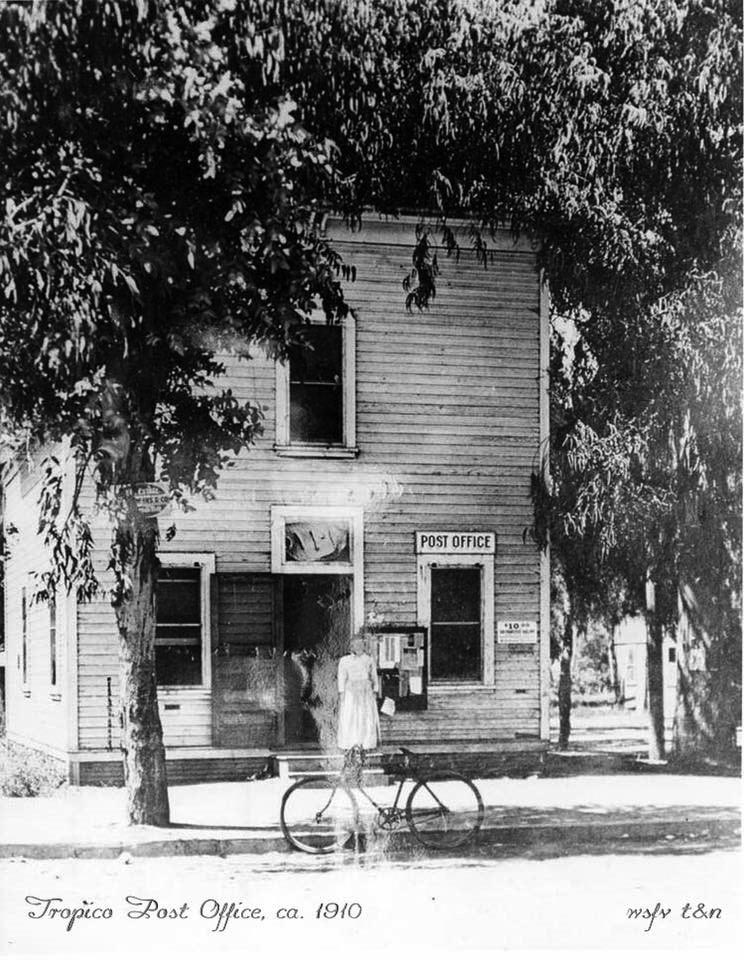 |
|
| (ca. 1910)#+++ – View showing a woman standing in front of the Tropico Post Office, with a bicycle parked by the curb. |
Historical Notes The Tropico Post Office building was owned by WCB Richardson and was located near the corner of Central Avenue and San Fernando Road. |
Then and Now
 |
|
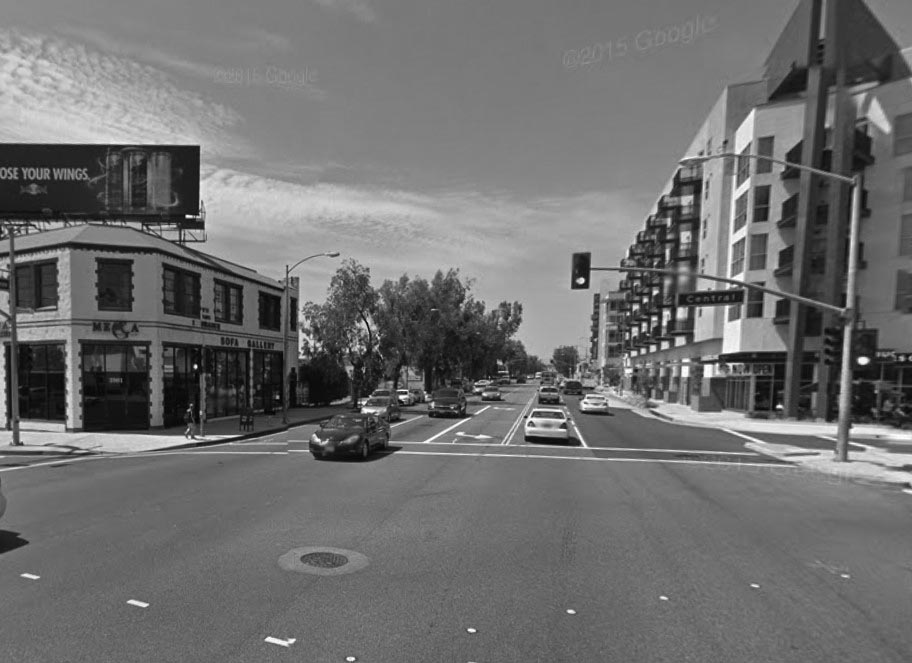 |
|
| (1910s) vs. (2015)##^^ – View looking N/W on San Fernando Road at S. Central Avenue. |
El Miradero
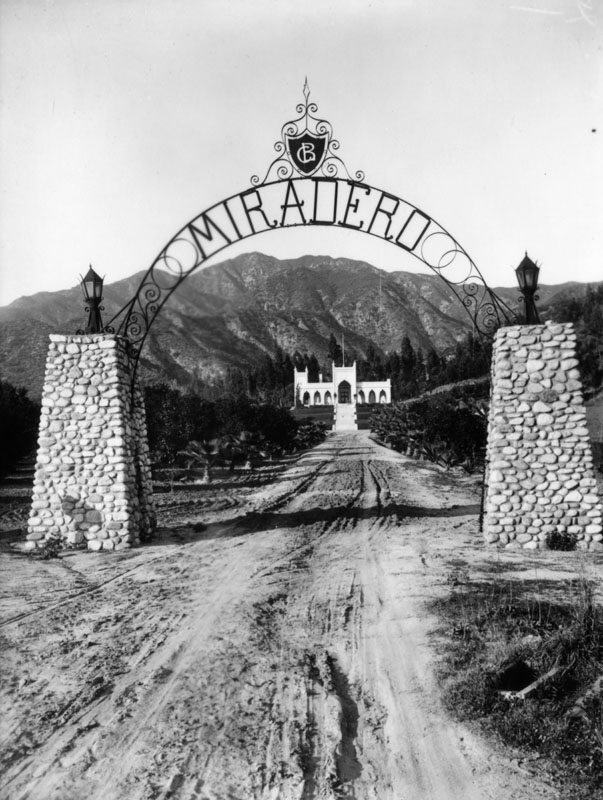 |
|
| (ca. 1904)^ - View of El Miradero, the estate of Leslie C. Brand, as seen from the entrance gates of the property. |
Historical Notes Born in Missouri in 1859, Leslie Coombs Brand became the sole provider for his family at age 11. In 1886, Brand came to California to take advantage of its first boom period. #*#^ Brand was a major figure in the settlement and economic growth of the Glendale area. He had purchased land on the lower slopes of Mount Verdugo overlooking the city, and in 1904 built an imposing residence that became known as Brand Castle, also El Miradero (which today houses the Brand Library).*^ |
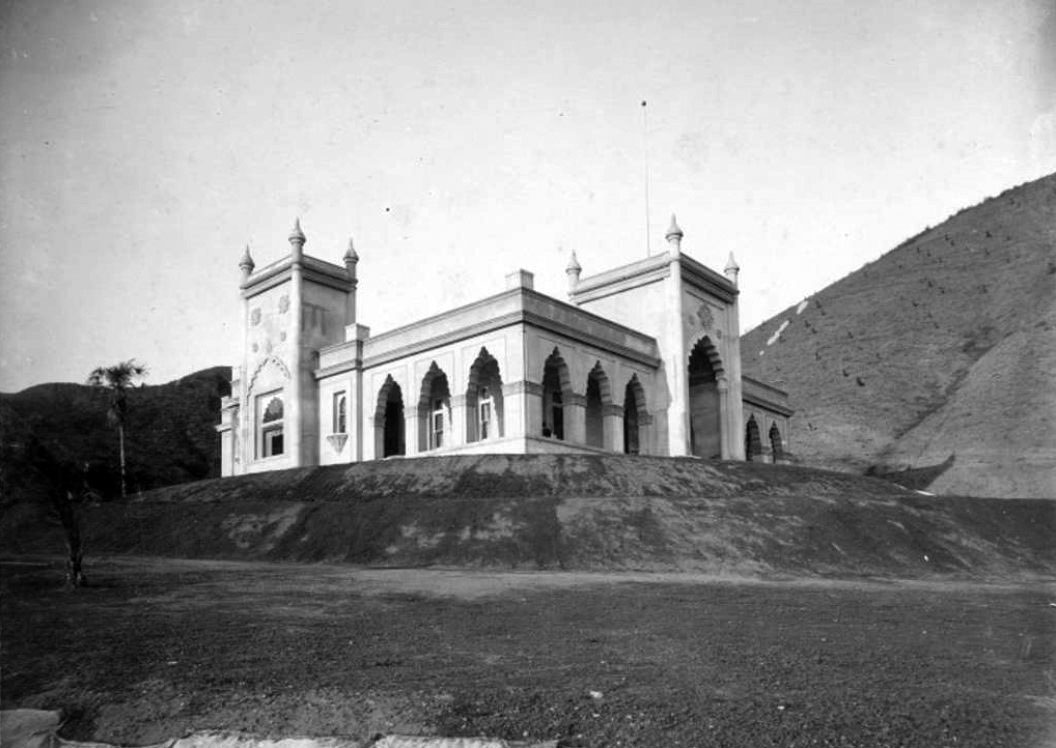 |
|
| (1904)^*# – West side view of the newly constructed ‘El Miradero’, home of Leslie C. Brand. |
Historical Notes Designed by Leslie C. Brand's brother-in-law Nathaniel Dryden, the mansion was completed in 1904 and is similar in style to that of the East Indian Pavilion built for the 1893 Columbian World Exposition held in Chicago. The architecture is considered Saracenic, with crenellated arches, bulbous domes and minars combining characteristics of Spanish, Moorish, and Indian styles.^ |
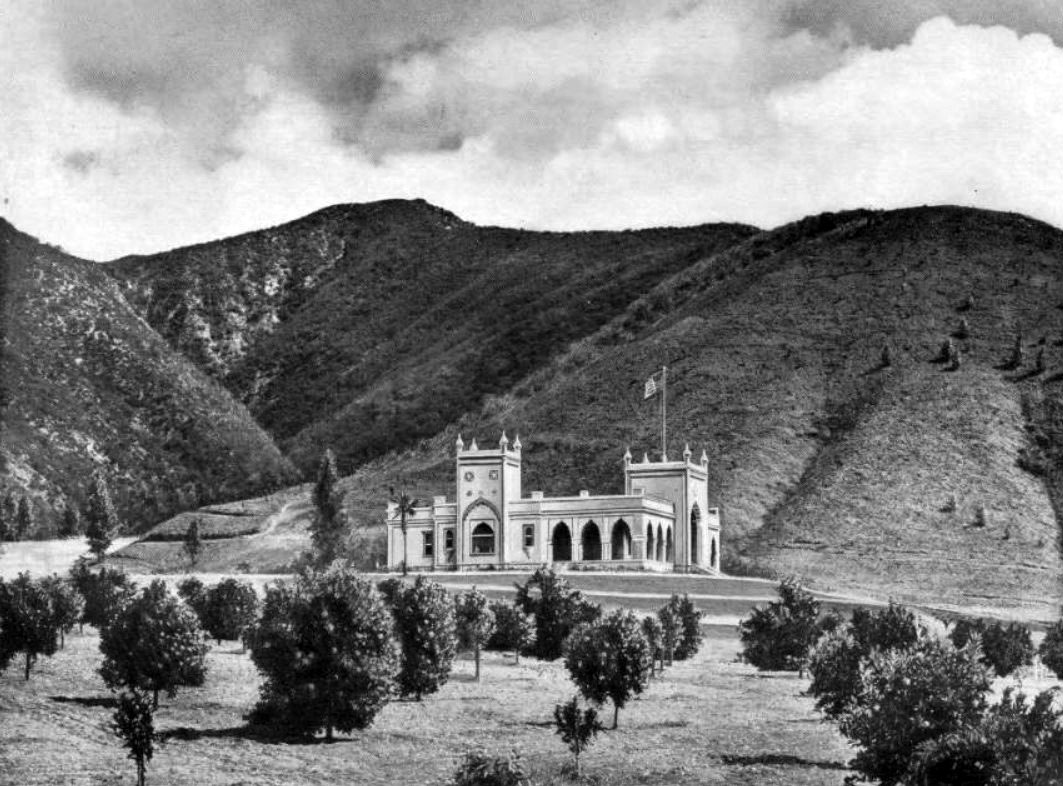 |
|
| (ca. 1906)^*# – View of El Miradero Mansion standing between orange groves in the foreground and the Verdugo Hills in the background. |
Historical Notes Leslie C. Brand helped develop the city of Glendale. Together with Henry E. Huntington, he brought Pacific Electric to the town to develop it. The 'Brand Library' section of the Glendale Public Library is named in his honor. Brand Boulevard in Glendale is also named in his honor.*^ |
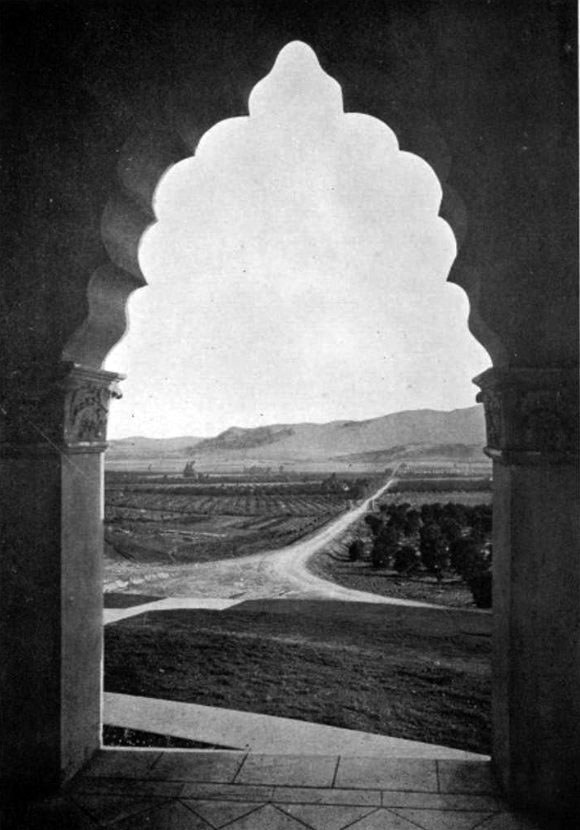 |
|
| (ca. 1906)^*# – View looking South over Glendale and Griffith Park toward Los Angeles through one of the many arches of ‘El Miradero’. |
Historical Notes Just across the mostly dry Los Angeles River, Brand could see the Griffith Park Aerodrome's grass field, built in 1912. Just three years later he decided to build his own grass airstrip below his mansion.*^ |
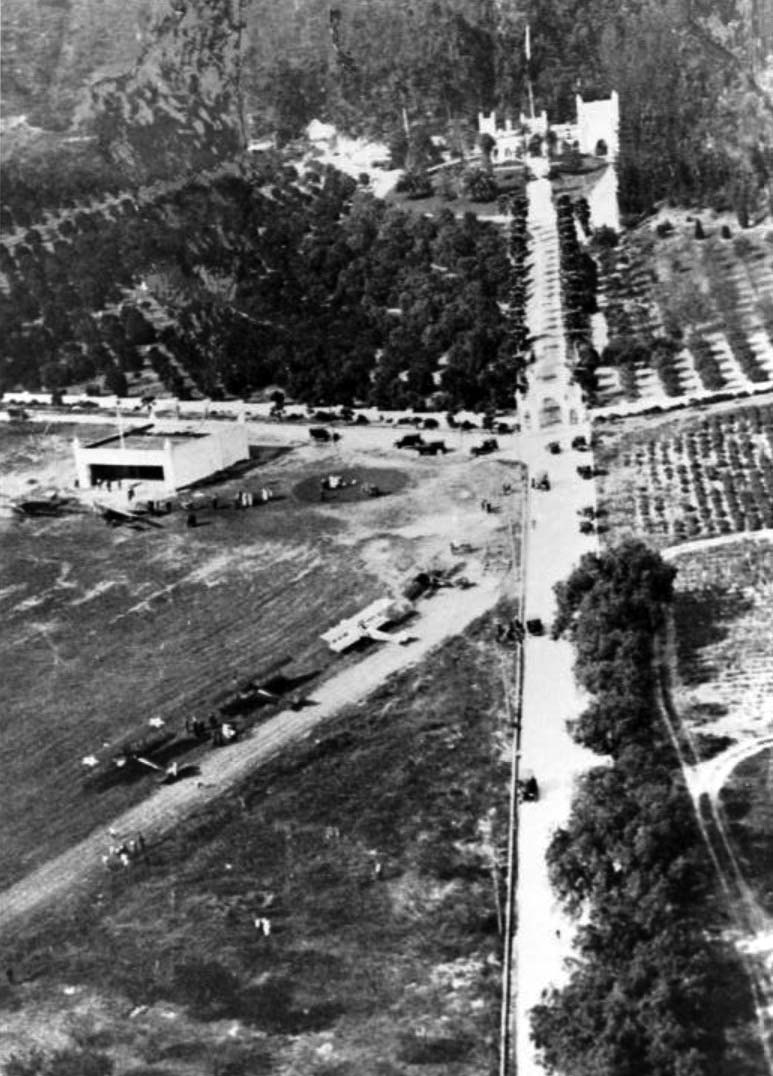 |
|
| (1921)***^ - An aerial view of L. C. Brand's airfield in front of his home, El Miradero in Glendale. The airplanes took off downhill toward Kenneth Road. |
Historical Notes Brand established a grassy, well-manicured airfield in front of the mansion. The airfield consisted of a 1,200' rolled dirt runway, with a white hangar at one end and a putting green on the other. The hangar matched the architectural style of the mansion - with turrets atop each of the 4 corners.*#*# |
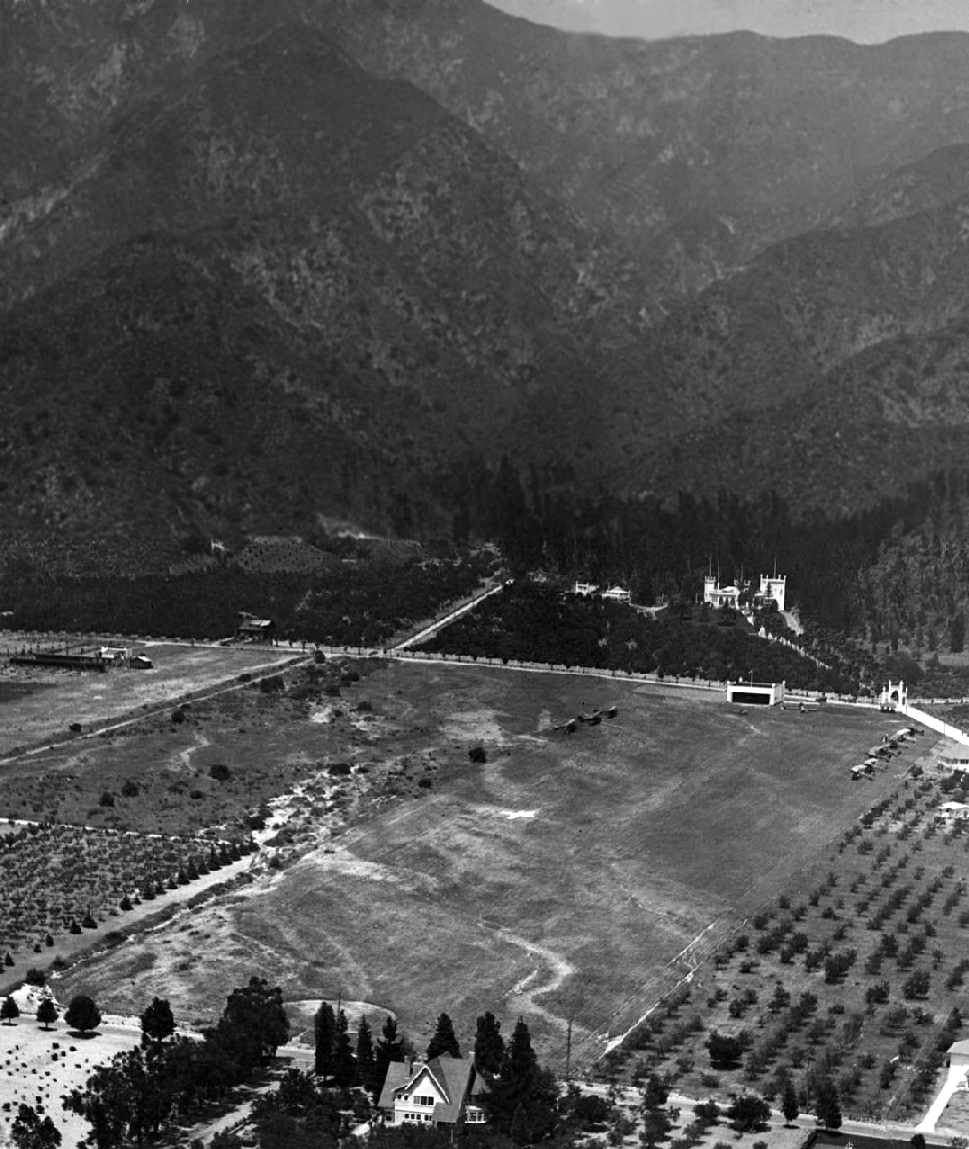 |
|
| 1923)*#*# – Aerial view looking north at Brand Field, showing the hangar and 10 aircraft on the field, and the mansion across the street. Note the steep terrain – obviously takeoffs to the north wouldn't be advisable. |
Historical Notes Only 3 aircraft are known to have been actually based at Brand Field. However, Brand apparently bought many war surplus Jennies, some to tinker with and fly as a sport, although most languished in storage buildings.*#*# |
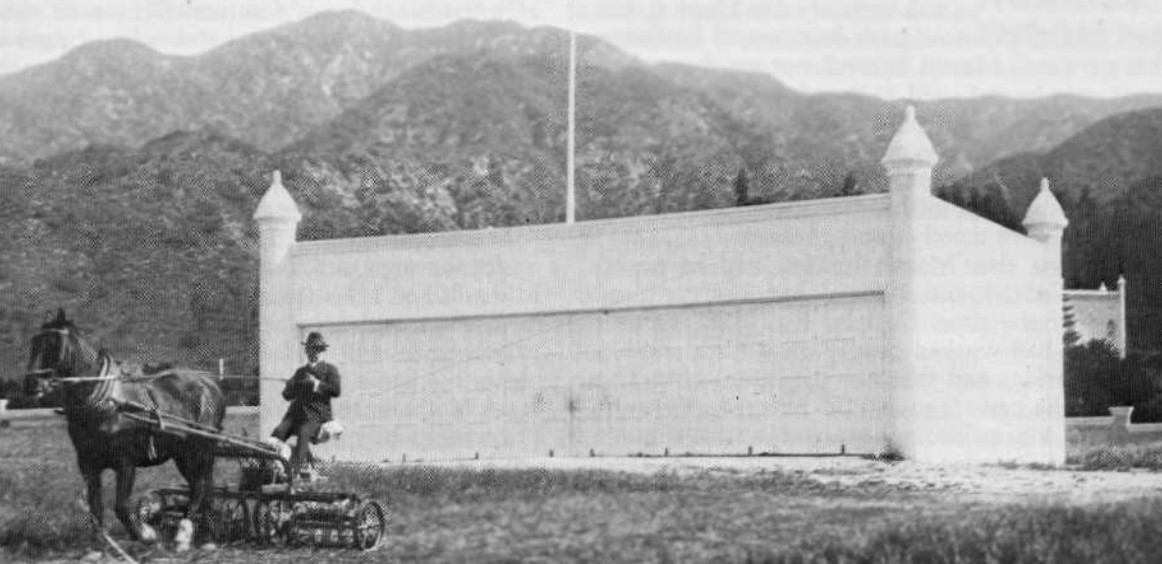 |
|
| (ca. 1920s)*#*# – View of millionaire Leslie C. Brand mowing the lawn in front of the Moorish-style hangar at his private Airfield. |
Historical Notes Brand built his first hangar in 1916 and put together a fleet of planes, and held fly-in parties. The only requirement was that guests had to arrive in their own planes and bring passengers.*^ |
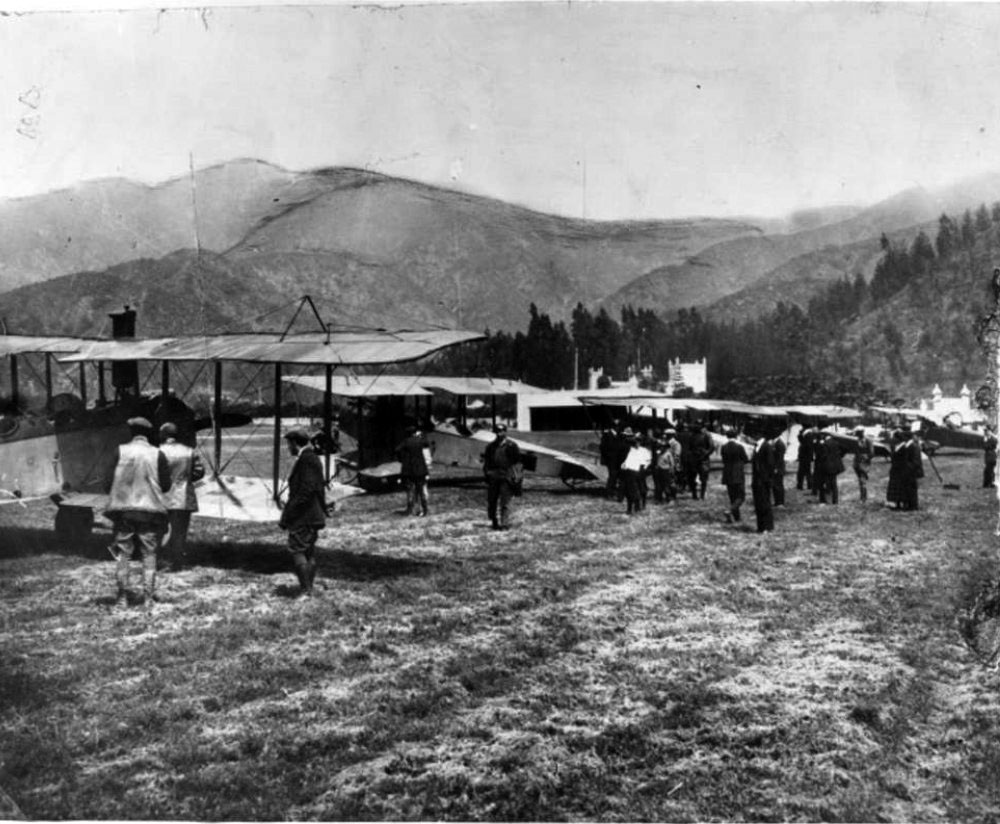 |
|
| (1921)^*# – Several airplanes and guests arriving at Brand's fly-in luncheon party on April 1, 1921. El Miradero Mansion is seen in the background. Click HERE to see more in Aviation in Early L.A. |
Historical Notes Brand Field was no longer depicted on a 1931 street map, but “Brand Park” was depicted, so the airfield may have ceased operation by that point.*#*# |
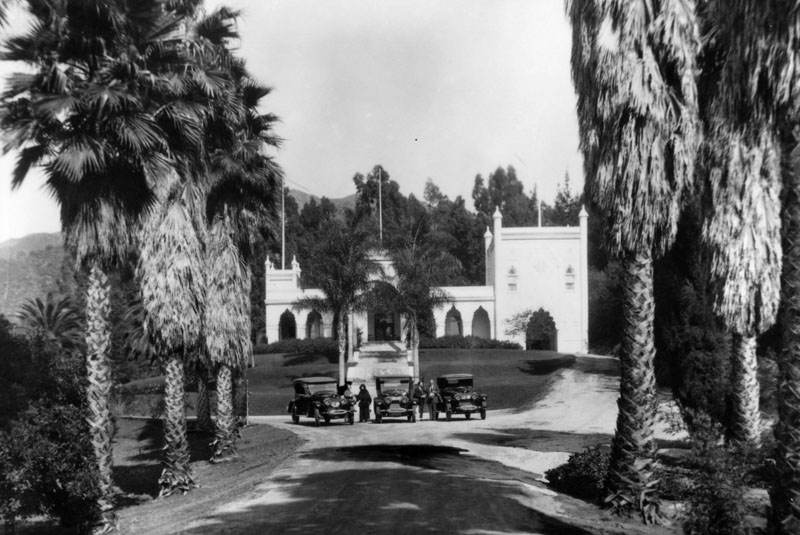 |
|
| (ca. 1920)^ - View of El Miradero and estate grounds, once home to Leslie C. Brand. Three vehicles are seen parked next to one another where the driveway and path to the front door meet. Four people, three men and one woman, are standing next to the automobiles. |
Historical Notes It was stated in Brand's will that El Miradero would be bequeathed to the city upon his wife's death, on the condition that the property be used exclusively for a public park and library. Mrs. Mary Louise Brand retained rights of the residence from 1925, when Mr. Brand died, until her death in 1945.^ |
 |
|
| (ca. 1940s)#^^ - Postcard view of the entrance to El Miradero, the estate of Leslie C. Brand, located in Brand Park. |
Historical Notes In 1956 the mansion became the Brand Library, the art and music branch of the Glendale Public Library. The address is 1601 West Mountain Street, Glendale.^ |
* * * * * |
Downtown Los Angeles
 |
|
| (ca. 1904)^^ - Panoramic view of downtown Los Angeles from the Melrose Hotel, looking east. Large Victorian residential buildings are in the foreground. The commercial district, city government buildings and churches are visible further back. City Hall stands in the middle of the photo. |
Historical Notes The Melrose Hotel was located at 138 S. Grand Ave. on Bunker Hill. It started as a Victorian mansion in 1881 and eventually became a hotel apartment. Click HERE to see more on the Melrose Hotel. If still standing today, the view from the front porch of the Melrose Hotel (looking west) would be that of Disney Hall, located directly across the street, on the other side of Grand Ave. |
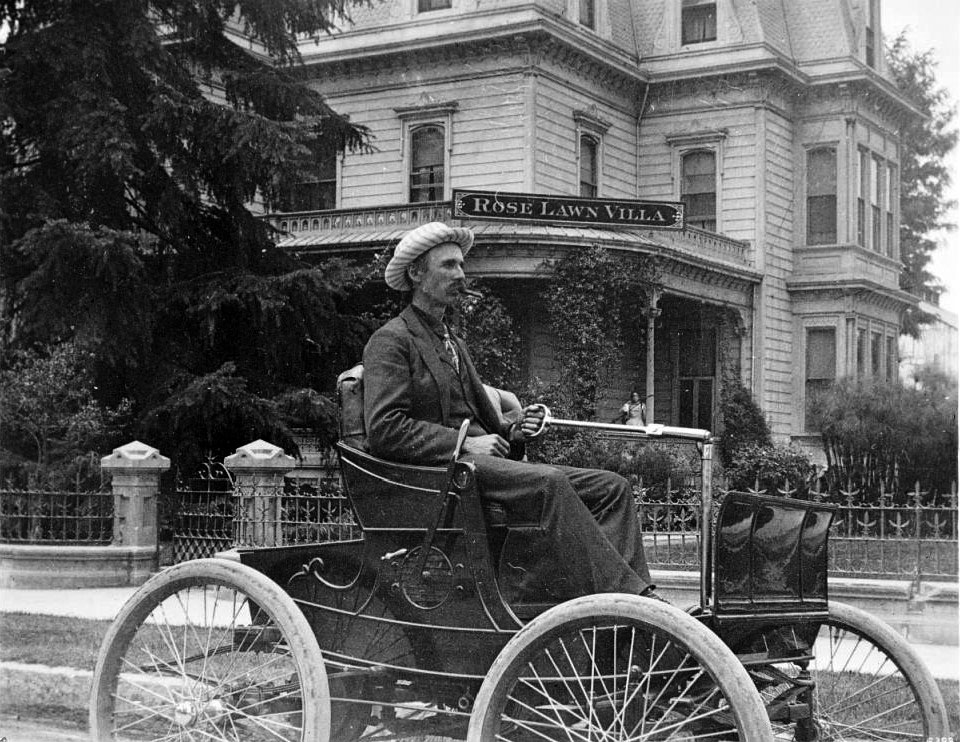 |
|
| (ca. 1902)^^ - View of man driving on Spring Street in front of the Van Nuys family residence. The man, dressed in a dark suit and candystriped hat, steers the topless carriage with a rod-and-stirrup device. In the background, the Victorian architecture of the I.N. Van Nuys residence can be seen, with its gingerbread roof, molded window frames and clapboard veneer. A wrought-iron fence marks the perimeter of the lawn. A woman is partially visible in the background from behind the vine-grown porch of the residence, over which hangs a sign reading "Rose Lawn Villa". Tree foliage obscures the left side of the residence. |
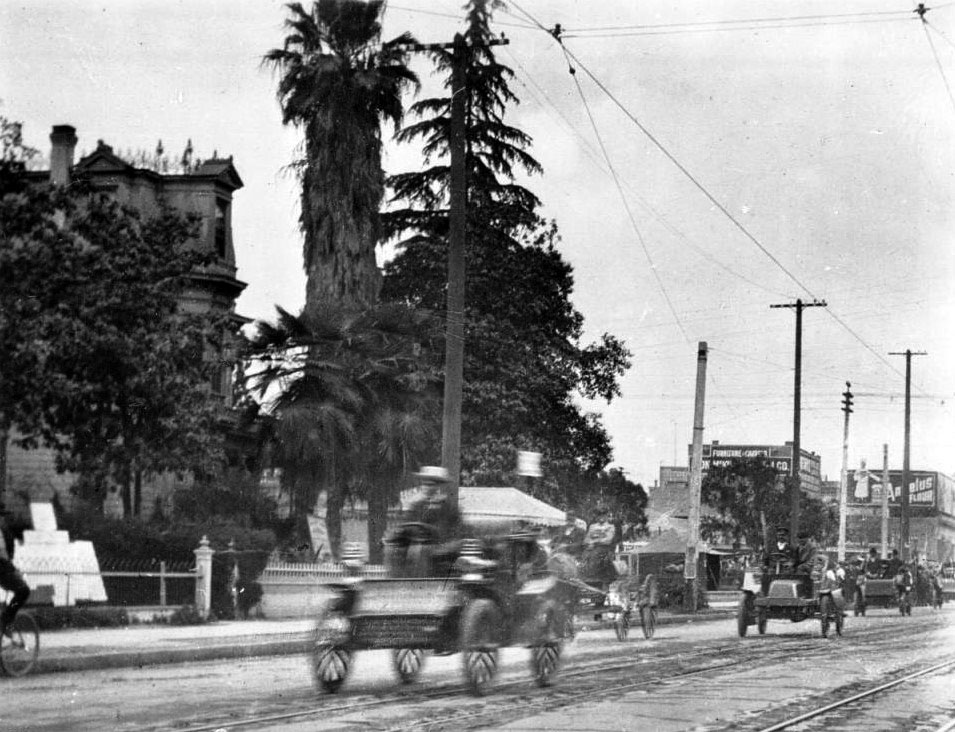 |
|
| (1904)^^ - View of Spring Street looking north from Seventh Street featuring the I.N. Van Nuys residence, May 24, 1904. Several early automobiles drive towards the camera along the unpaved street in which trollycar tracks are visible. Only the wrought-iron fence and the top of the Victorian architecture of the Van Nuys residence is visible from behind the lush treecover surrounding it. Telephone poles are visible, as well as large signs attached to building in the background which read "Furniture and Carpets" and "Angelus Flour". |
* * * * * |
State Normal School
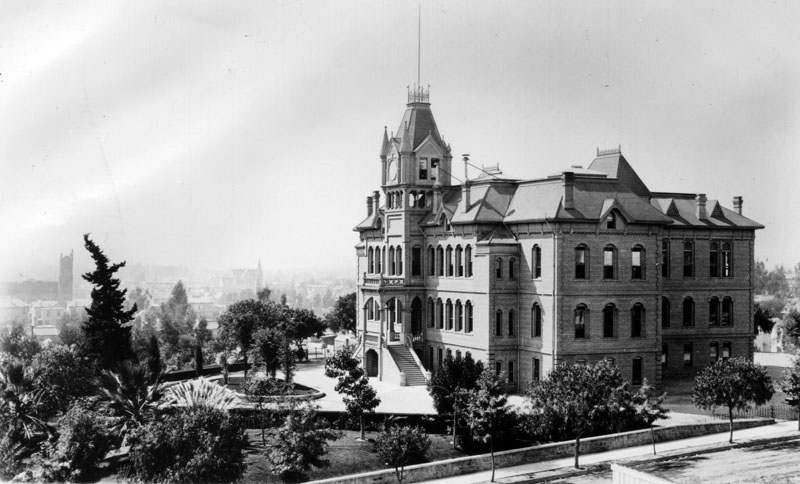 |
|
| (Early 1900s)^ -Side view of the State Normal School, located at Grand Avenue and 5th Street. From this location one could get a great panoramic view of downtown Los Angeles. |
Historical Notes In March 1881, after heavy lobbying by Los Angeles residents, the California State Legislature authorized the creation of a southern branch of the California State Normal School (which later became San Jose State University) in downtown Los Angeles to train teachers for the growing population of Southern California. The State Normal School at Los Angeles opened on August 29, 1882, on what is now the site of the Central Library of the Los Angeles Public Library system.*^ |
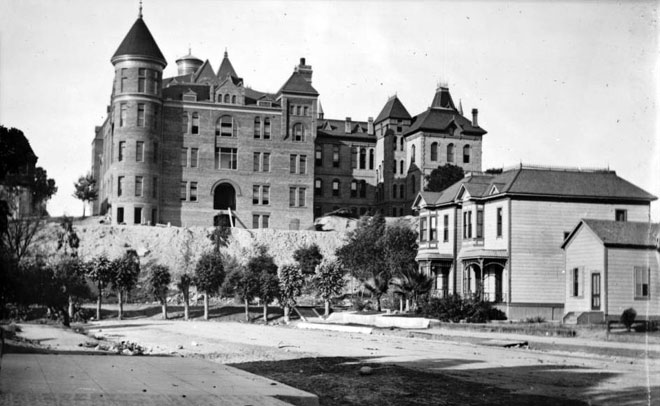 |
|
| (Early 1900s)^^ - Exterior view of the State Normal School,. Residential homes sit on a cul-de-sac behind the school. |
Historical Notes Through the years, the State Normal School was expanded and several new wings were added. In 1887, the school officially became known as the Los Angeles State Normal School.*^ |
 |
|
| (1904)^ - Panoramic photo of teachers and student body of the California State Normal School, located at 5th Street and Grand Avenue in Los Angeles. |
Historical Notes The California State Normal School included an elementary school where teachers-in-training could practice their teaching technique on children. That elementary school is related to the present day version, UCLA Lab School.*^ |
 |
|
| (Early 1900s)^ - Aerial view of the State Normal School, located at Grand Avenue and 5th Street. Because the school sat impressively on the last knoll of Bunker Hill, aptly dubbed "Normal Hill". The large white building on the middle left is the Bible Institute, later to become the Church of the Open Door, that was located on Hope Street; the Key West Rooms and Apartments is visible on the lower left. |
Historical Notes By 1914 the little pueblo of Los Angeles had grown to a city of 350,000 and the school, whose enrollment far exceeded its capacity, moved to new quarters -- a Hollywood ranch off a dirt road which would later become Vermont Avenue. With a view toward expansion, Director Ernest Carroll Moore proposed in 1917 that the school become the first branch of the Berkeley-based University of California. Two years later on May 23, 1919, California Governor William D. Stephens signed the legislation that created the "Southern Branch" of the University of California -- no longer merely a teacher's college but an institution that offered two years of instruction in Letters and Science. Third- and fourth-year courses were soon added, the first class of 300 students was graduated in 1925, and by 1927 the Southern Branch had earned its new name: University of California at Los Angeles (the "at" became a comma in 1958). As the student population of the University continued to increase, the need for a new site became obvious and the search was soon under way for a permanent home for UCLA.^ |
Click HERE to see more Early Views of the Normal School and UCLA. |
* * * * * |
Patent Office (Hazard & Harpham)
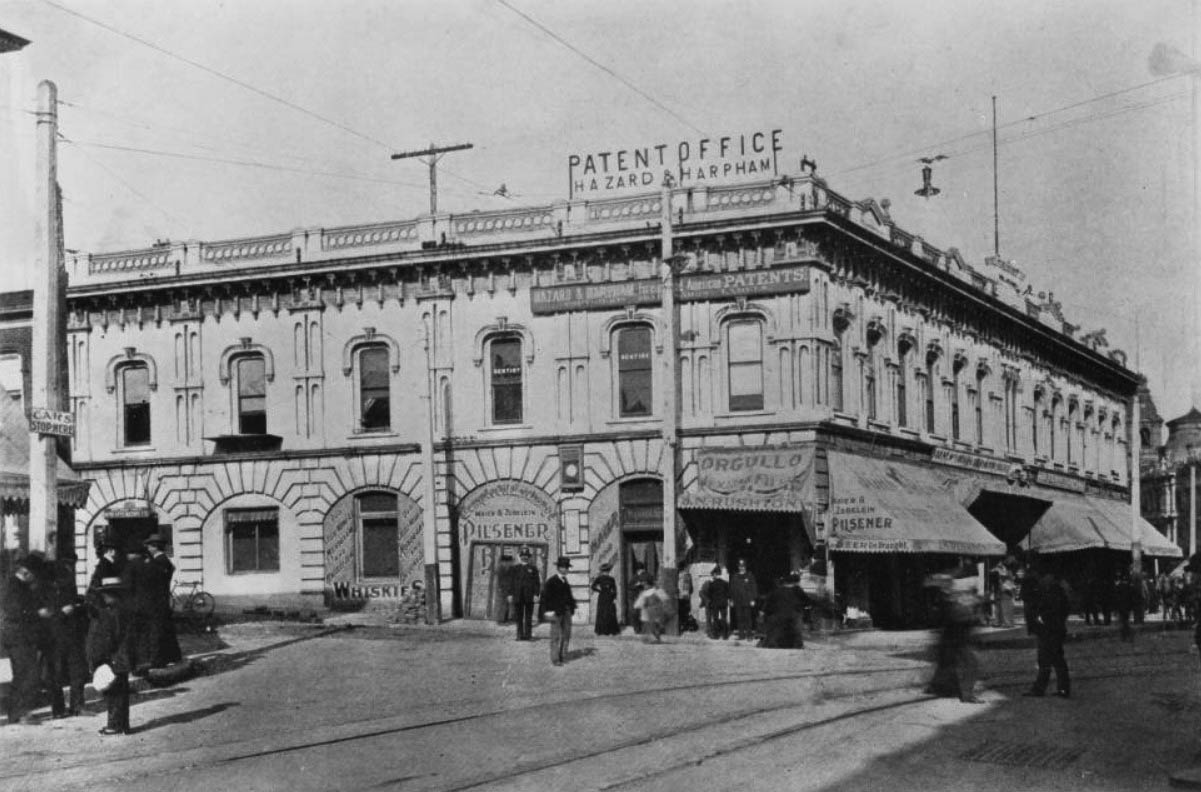 |
|
| (ca. 1904)^^ – View looking north showing the Downey Block on the N/W corner of Spring Street and Temple Street at the intersection of Spring, Main, and Temple streets. Men and women stand along the sidewalks and in the street in front of the Romanesque Downey Block, a building which houses several commercial interests; The Hazard and Harpham Patent Office advertises on the top floor, while signs on the bottom floor advertise all types of alcoholic beverages. |
Historical Notes The Downey Block was demolished in 1904. Since then the corner has been the site of two Federal Buildings: the Federal Building and Post Office (1910 - 1937) and the Federal Courthouse and U.S. Post Office Building (1940 - Present). The Hazard and Harpham Patent Office moved to a building on the southeast corner of Fifth and Spring streets (see next photo). |
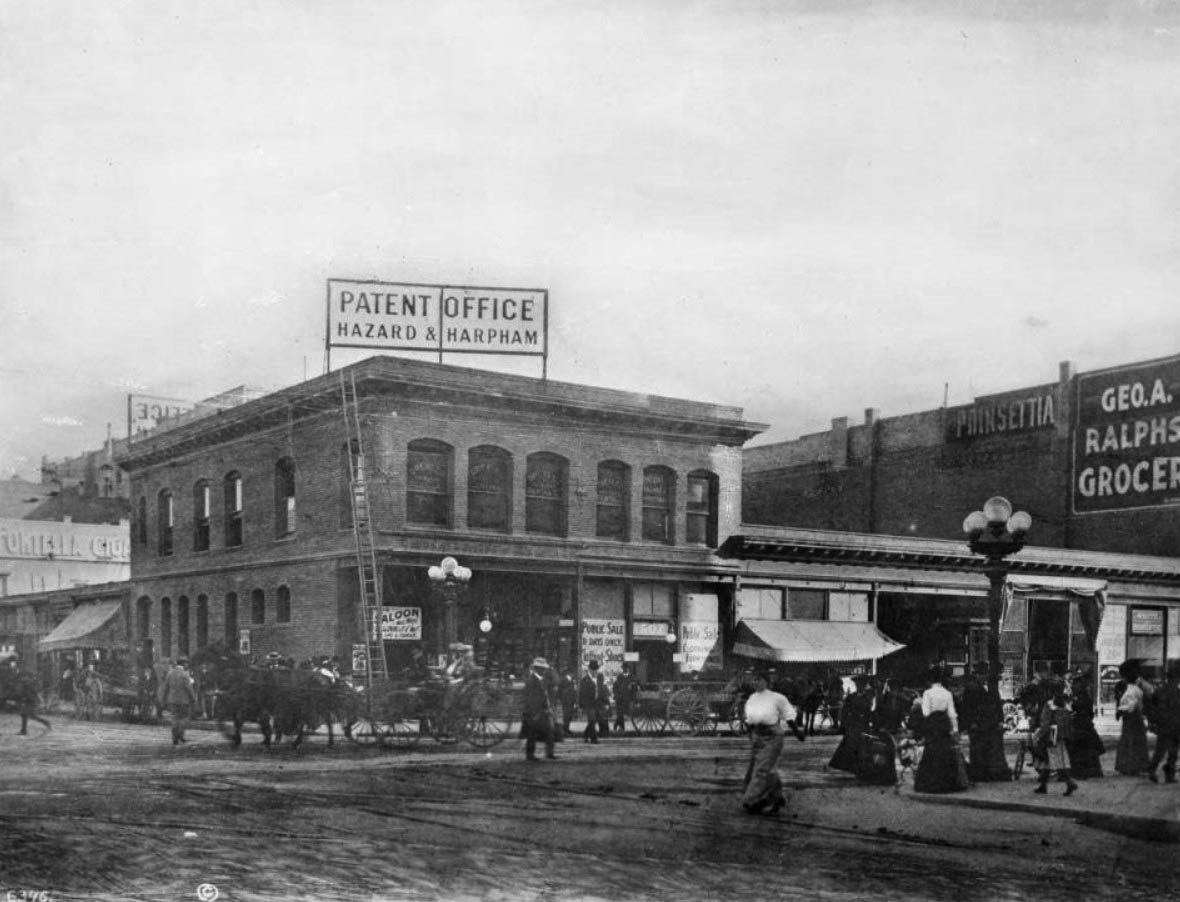 |
|
| (ca. 1905)^^ – View showing the southeast corner of Fifth and Spring Streets. At center, the Hazzard and Harpham Patent Office can be seen with a ladder leading to its roof on the second floor. Pedestrians are visible in the street as well as a horse and carriage at left. Further right, the George A. Ralphs Grocery Company can be seen, with a sign that reads "Poinsettia" on its visible wall. |
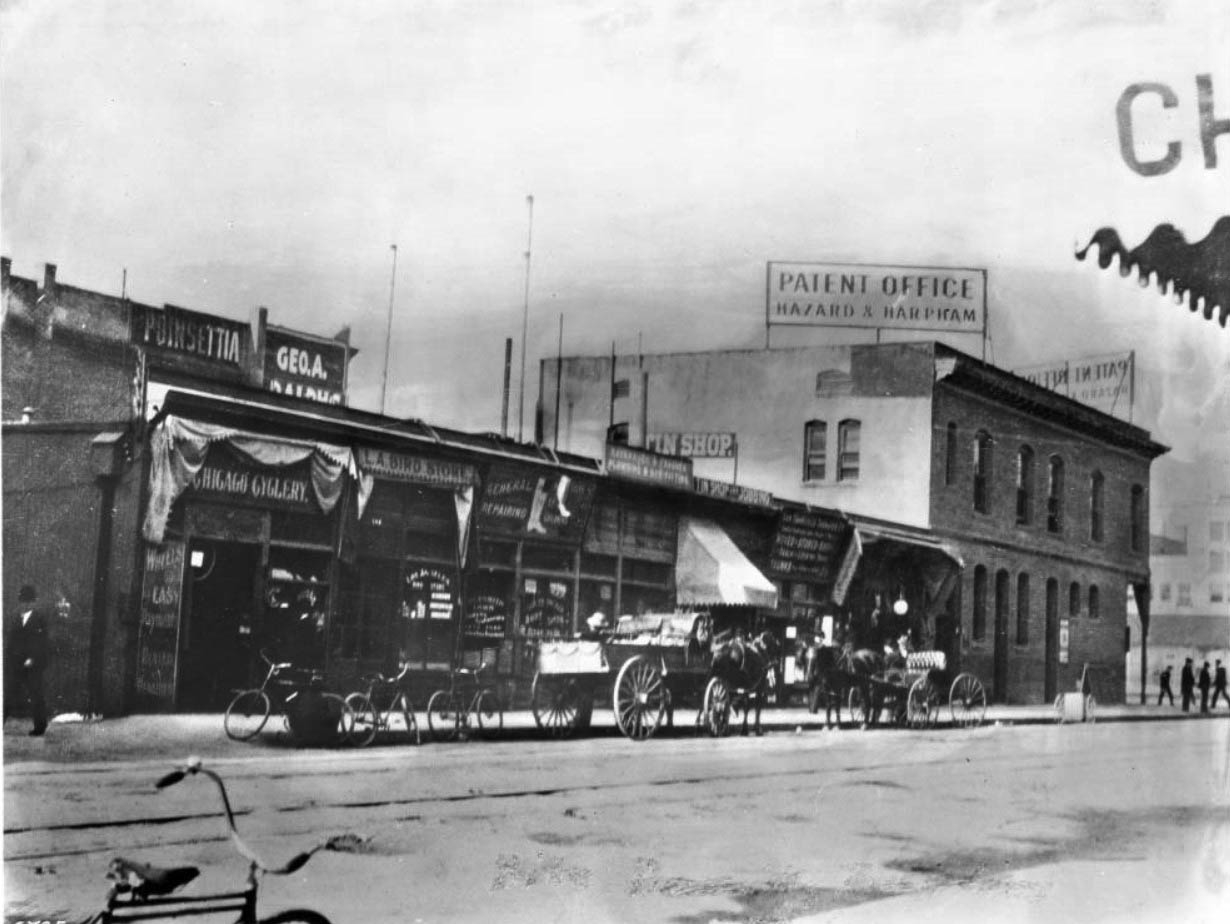 |
|
| (ca. 1905)^^ - View looking west on Fifth Street toward Spring Street. A short, one-story row of shopfronts terminates to the right of the photograph with the two-story brick Hazard & Harpham Patent Office building. A horse-drawn cart and a horse-drawn wagon stand along the sidewalk outside, along with three bicycles. A fourth bicycle is partially visible in the left foreground. A group of four men can be seen in the distance to the right, as well as a fifth that can be seen walking alone at the extreme left. Legible signs include: "Poinsettia", "Chicago Cyclery.", "Geo. A. Ralphs", "L.A. Bird Store" , "Wheels Sold as Easy Payments and Repaired", "General Repairing", "Boot / Shoe", and "Tin Shop and Jobbing". |
* * * * * |
Spring and 1st Street
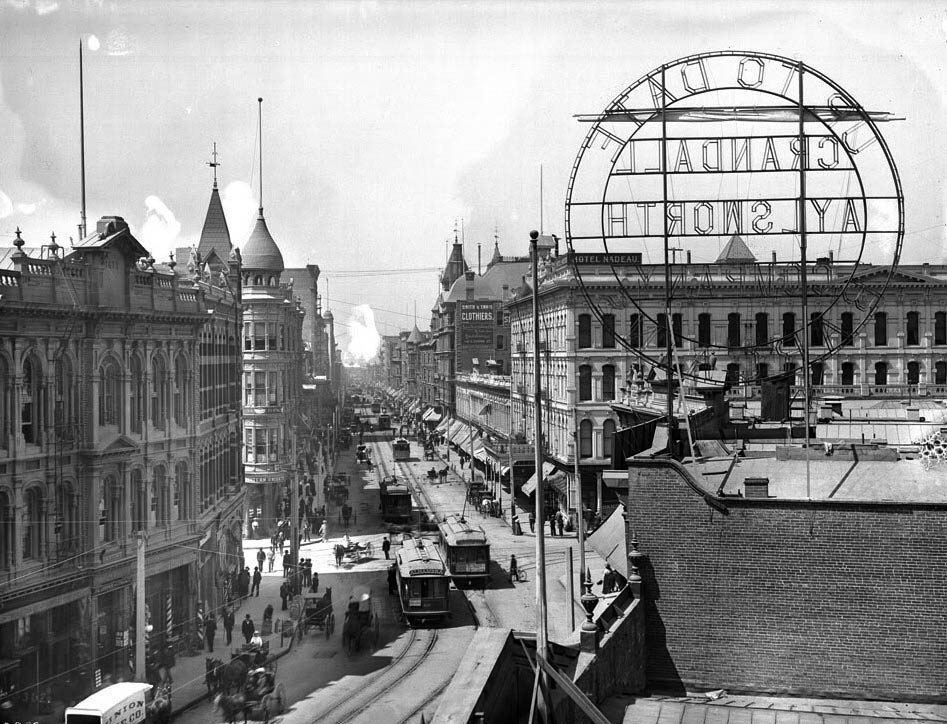 |
|
| (ca. 1904)^^ - Intersection of Spring Street and First Street looking south. The Nadeau Hotel (erected 1885) is visible at right (later the site of the Times Building). Most of the buildings appear to be commercial and average four-stories high. The busy street is crowded with streetcars, horse-drawn vehicles, and pedestrians. The street cars are labeled: "Alhambra and San Gabriel, 88", "Pasadena", "Pasadena, 85", "Plaza". The large circular sign on the roof top to the right reads: "Up to date bargains, Crandall Aylsworth Company". |
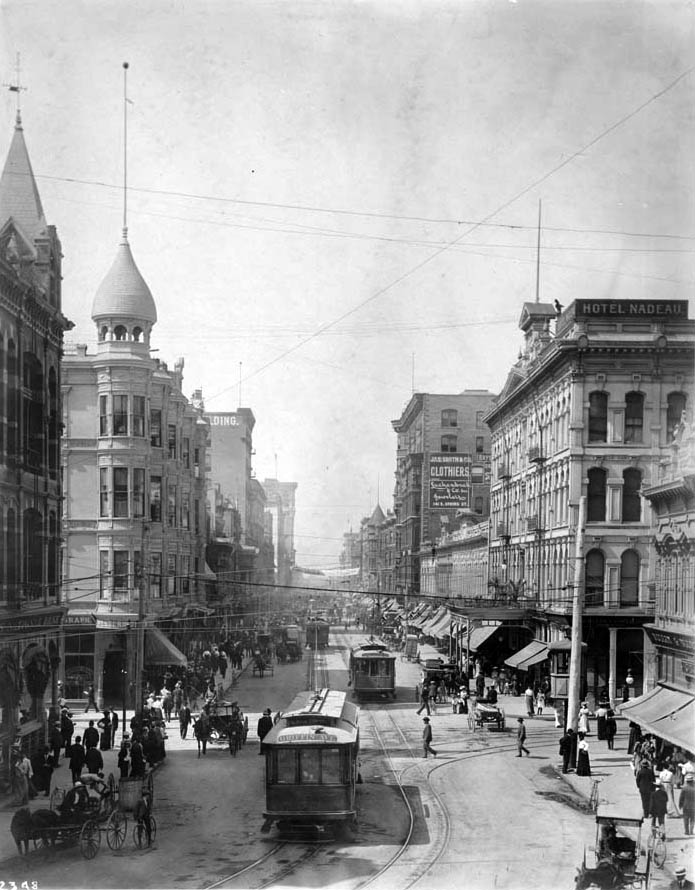 |
|
| (ca. 1905)^ - View of Spring Street at 1st, looking south, circa 1905. The Nadeau Hotel appears on the right. Spring St. was then the center of the city's financial activities. Electric cable cars can be seen in photo. |
Historical Notes In 1882, Remi Nadeau built the Nadeau Hotel on the SW corner of 1st and Spring streets. It was Los Angeles's first four-story structure and the first building with an elevator. The hotel was designed by Morgan & Walls. The Nadeau Hotel stood on the southwest corner until 1932, when it was demolished to make room for the current Los Angeles Times Building. |
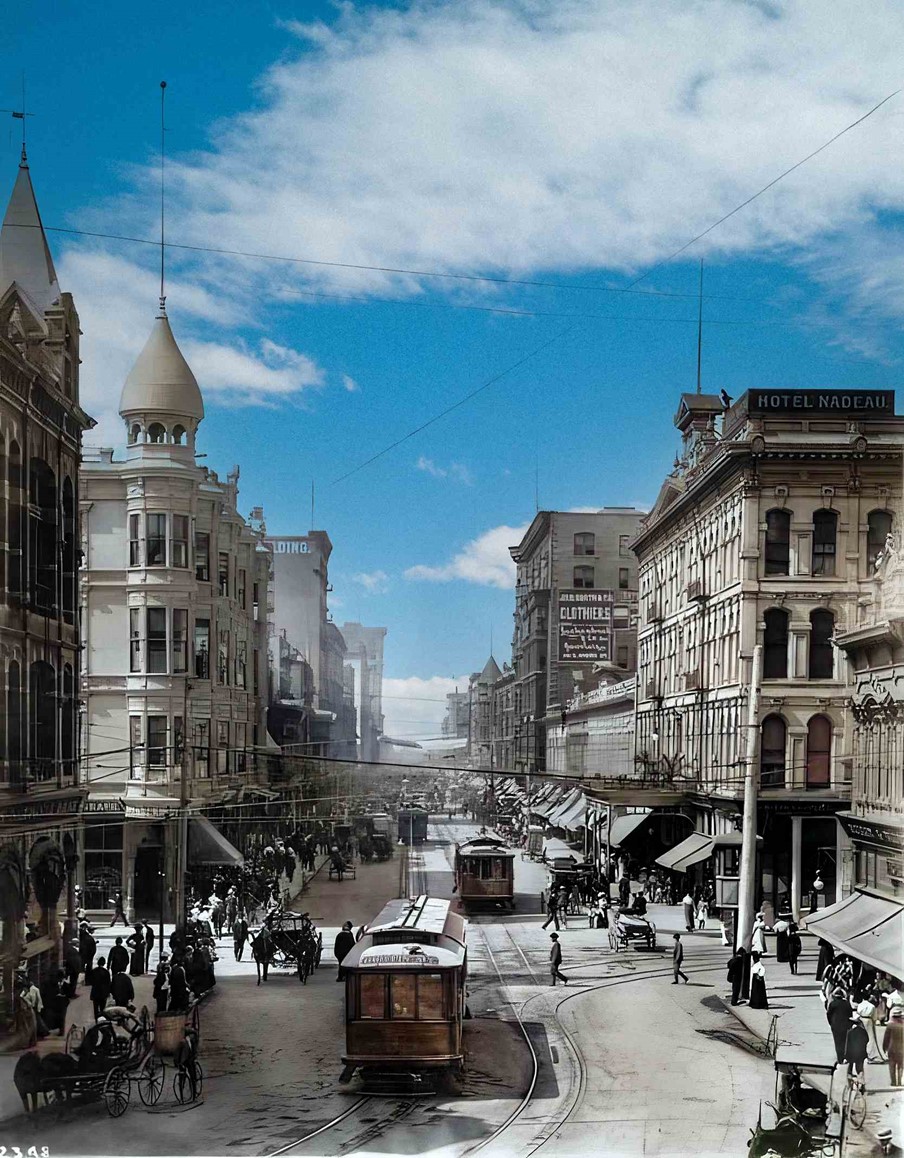 |
|
| (ca. 1905)^ - View of Spring Street at 1st, looking south with the Nadeau Hotel on the right (SW) corner. AI image enhancement and colorization by Richard Holoff |
Spring and 3rd Street
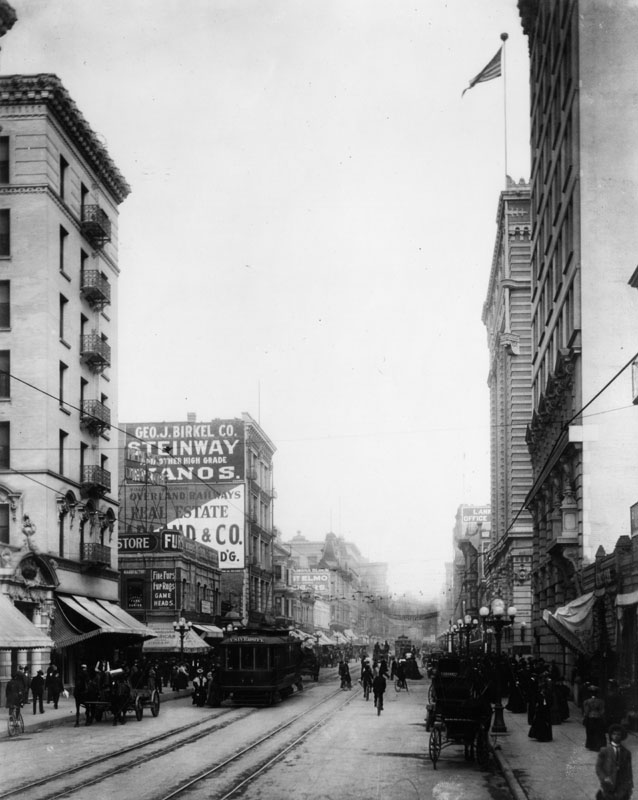 |
|
| (1905)^ - View of Spring Street looking north toward between 4th and 3rd Streets. A large number of pedestrians are on the sidewalk, and in the street are bicyclists, carriages and trolleys, one of which is marked "University." On the left is the George J. Birkel Co., selling Steinway Pianos. Other businesses include a store selling furs, rugs and game heads. Tall office buildings are on either side of the street, including the Braly Building and the Hellman Building at right. |
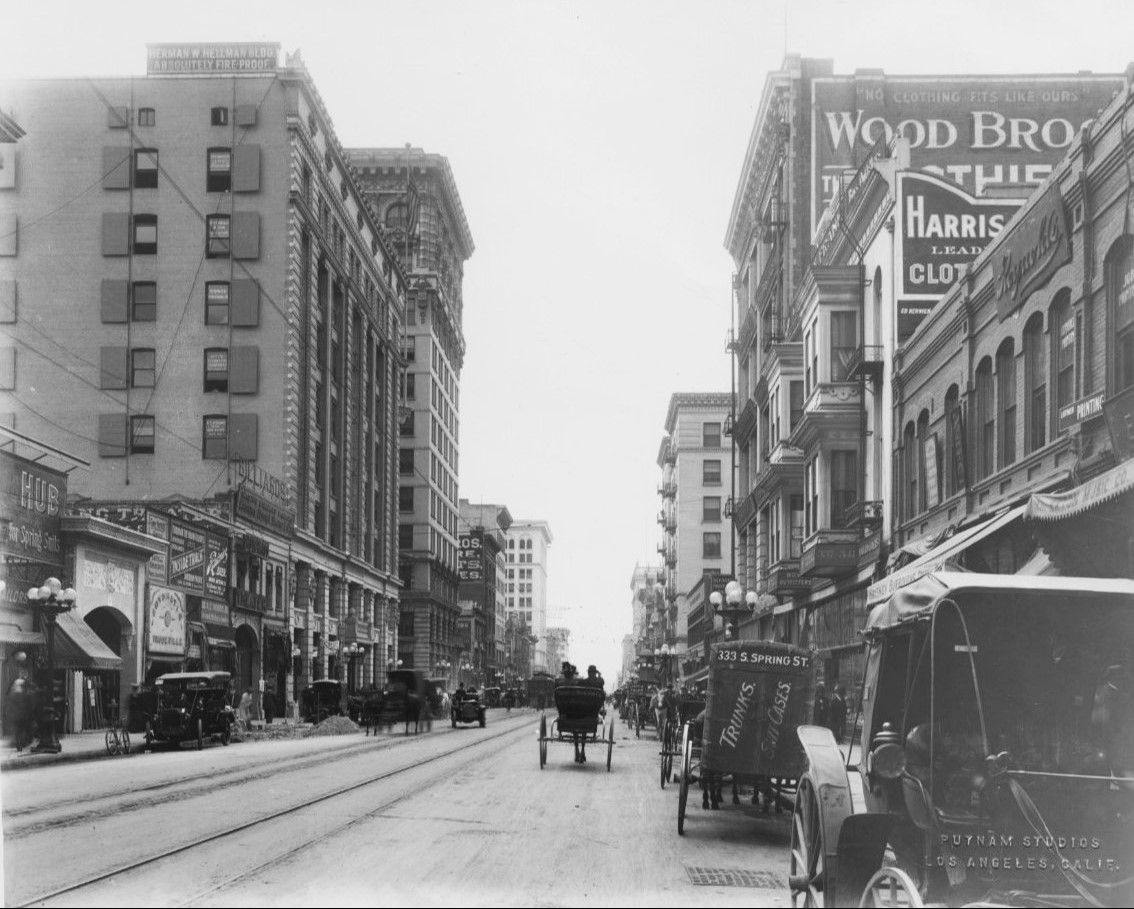 |
|
| (ca. 1904)* – View looking south on the 300 block of Spring Street with the Hellman Building seen on the left (NE corner of Spring and 4th). Horse-drawn carriages share the street with early model cars. |
Spring and 4th Street
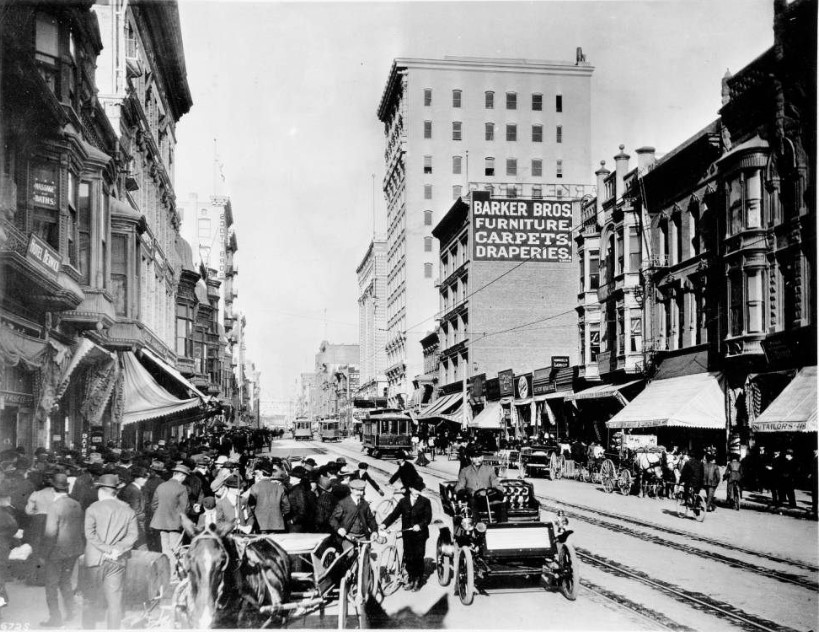 |
|
| (ca. 1905)^ - View of a very crowded Spring Street looking north from 4th Street near Barker Bros. Flat-faced commercial highrise buildings are packed closely together on the side of the street. Businesses include Barker Brothers which boasts "Furniture, Carpets, Draperies", Kunnel's Lunch, the Hotel Berwick, a bath and massage house, the Scott Brothers Building, and the Great Western Market. |
 |
|
| (ca. 1905)^^ - Closer view of previous photo shows a man with a moustache driving an early topless automobile while men stand next to him walking their bicycles. Horse-drawn carriages are visible parked along the sidewalk in the background while a streetcar makes its way up the street from the distance. |
* * * * * |
Hill and 7th Streets
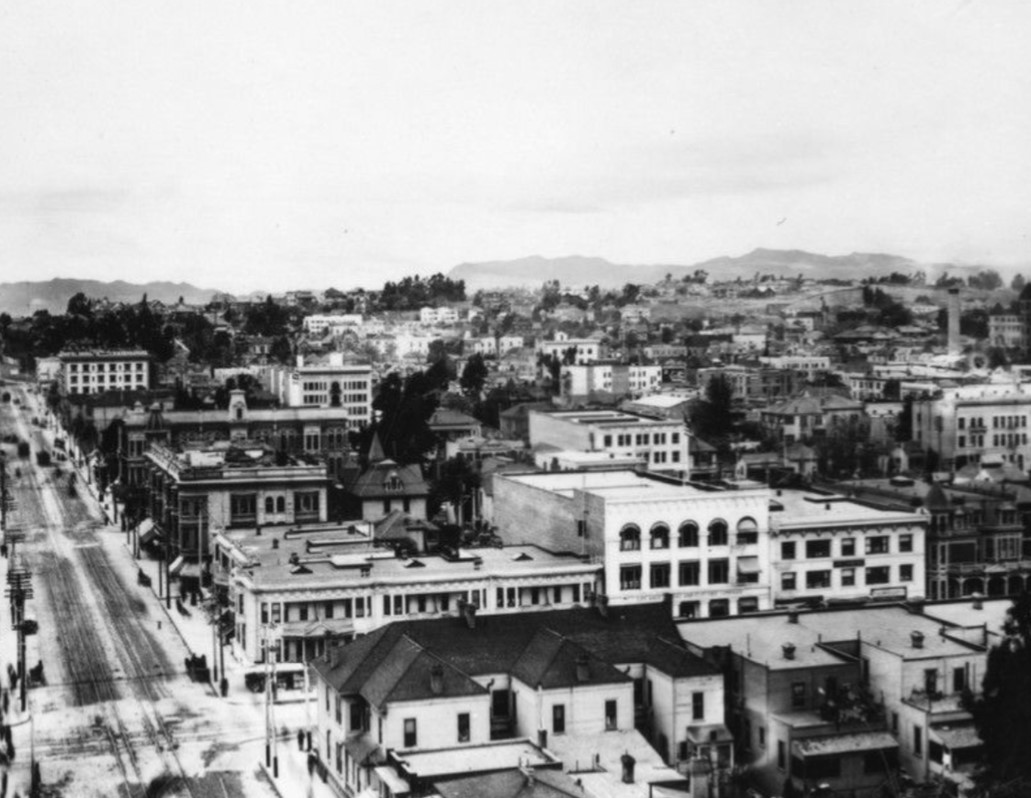 |
|
| (1905)* - Looking west on Hill Street at 7th Street in DTLA. The tall white building (center-right) that has arched windows and is wedged between two others is the Los Angeles Gas and Electric Company building located at 645 S. Hill Street. The original Hotel Biltmore can also be seen here (center-left). It’s the two-toned building located on the NE corner of Olive and 7th streets. |
Historical Notes The original Baltimore Hotel seen above, the two-toned building with the conical tower located on the NE corner of Olive and 7th streets, would become the future site of the Los Angeles Athletic Club (built in 1911, occupied in 1912). The new Hotel Baltimore was built at 5th and Los Angeles Streets in 1910. |
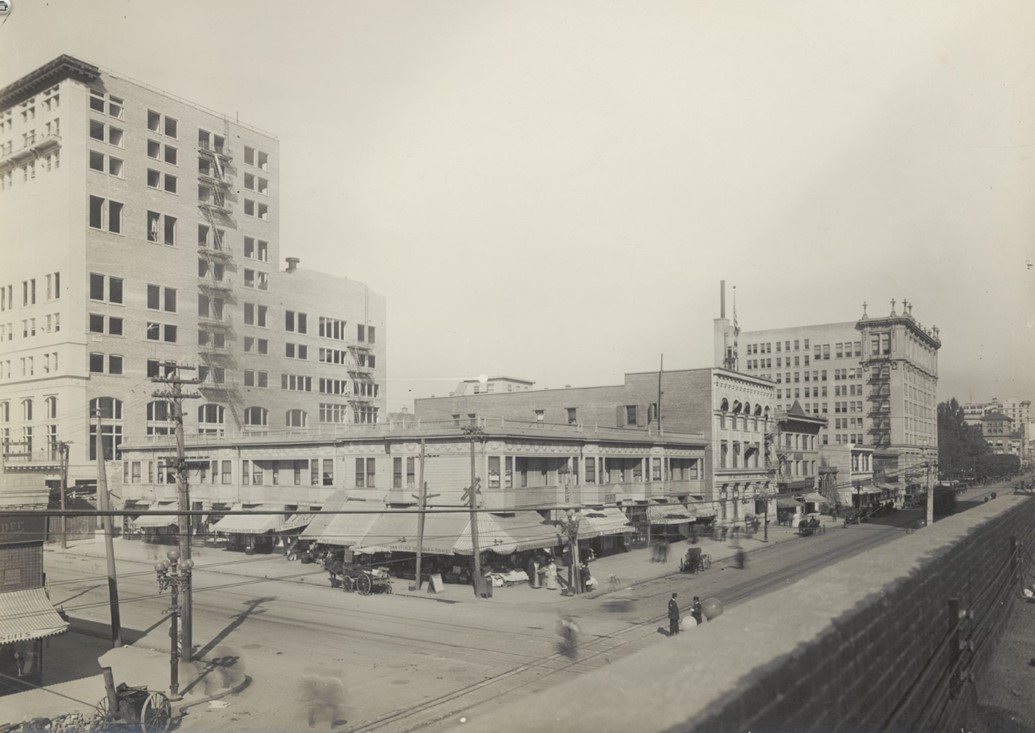 |
|
| (ca. 1911)* - Elevated view looking at the NW corner of S. Hill Street at 7th Street showing a two-story building at center, awnings over open market of stores and shops, three story Los Angeles Gas and Electric Company at 645 S. Hill St. right of market; multi-story building at left is the 1911-built Los Angeles Athletic Club (LAAC), built on the site of the original Hotel Biltmore. |
Historical Notes In 1912, the LAAC moved into its current 12-story Beaux-Arts clubhouse (seen above), designed by architects John Parkinson and George Bergstrom. This building was the first in Southern California to have an interior swimming pool on an upper floor. Click HERE to see more early views of the Los Angeles Athletic Club. |
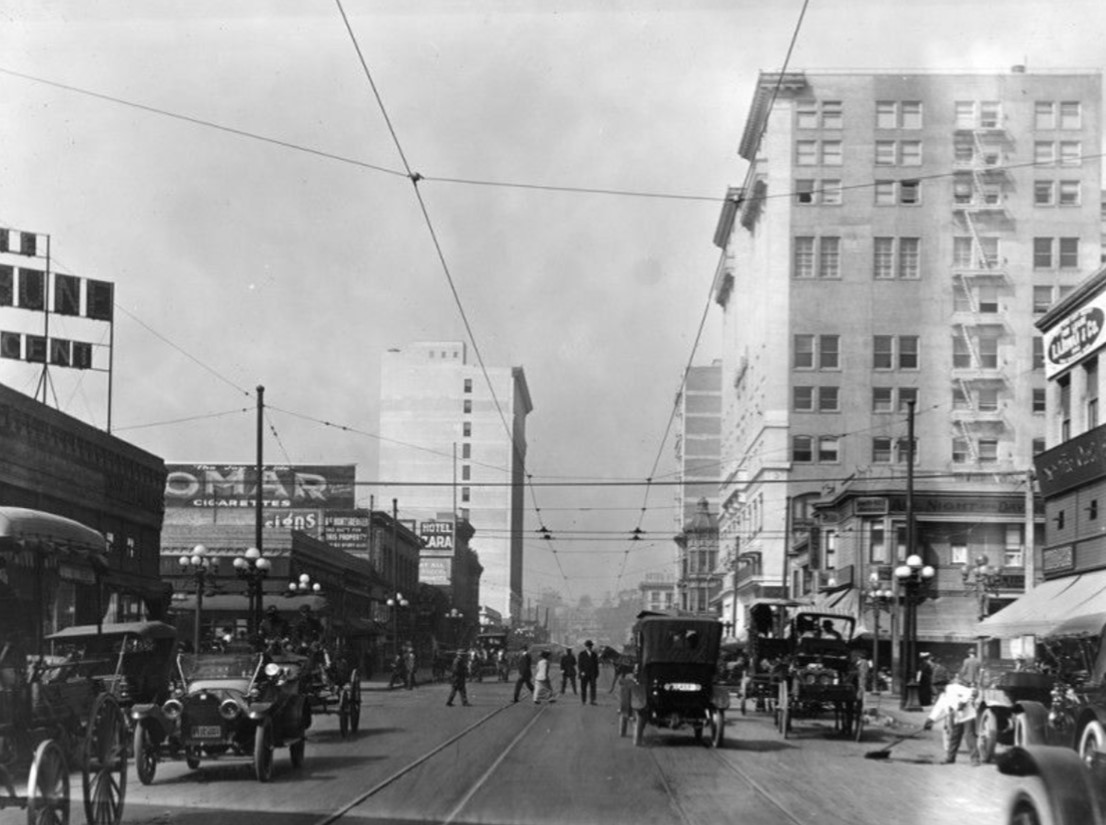 |
|
| (1912)* - Looking west on 7th Street from near Hill Street. The L.A. Athletic Club is the large building on the right. In the foreground from the club appears a sign identifying the "Seventh and Hill St. Branch" of All Night and Day Dentist. |
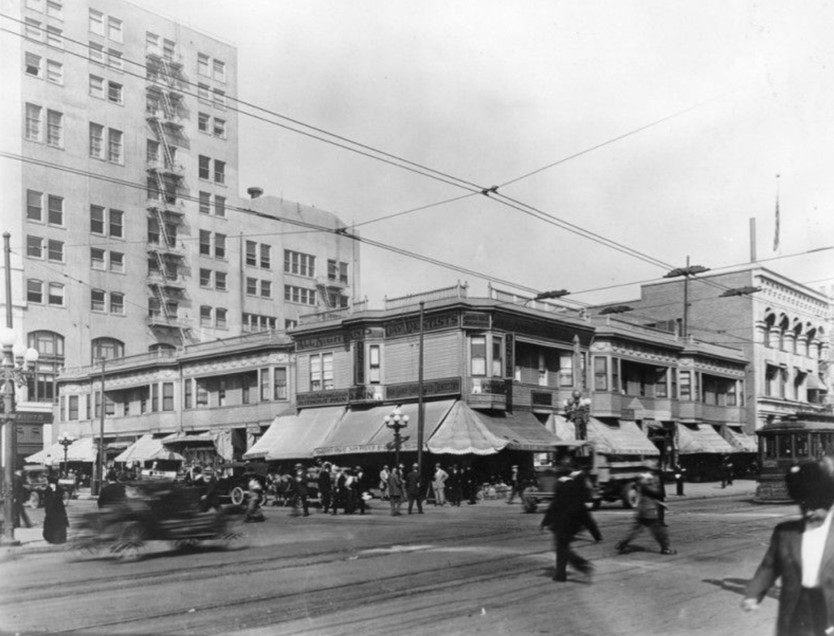 |
|
| (ca. 1912)* - Street view looking at the NW corner of 7th Street at Hill Street. The Los Angeles Athletic Club is the large white building on the left. In the middle of the photo is a dental building identified as the Seventh-Hill St. branch of the All Night and Day Dentists. Other signs read, "Teeth treated, filled, crowned and extracted without pain", "Absolutely no pain", "High grade guaranteed dentistry", and "Latest painless method". Below the dental offices, a small shop sells candies, fruit and .05 cent cigars. On the extreme right, behind a trolley, the Los Angeles Gas and Electric Co. can be seen with Old Glory on its roof. |
Los Angeles Gas and Electric Co. (645 S. Hill St)
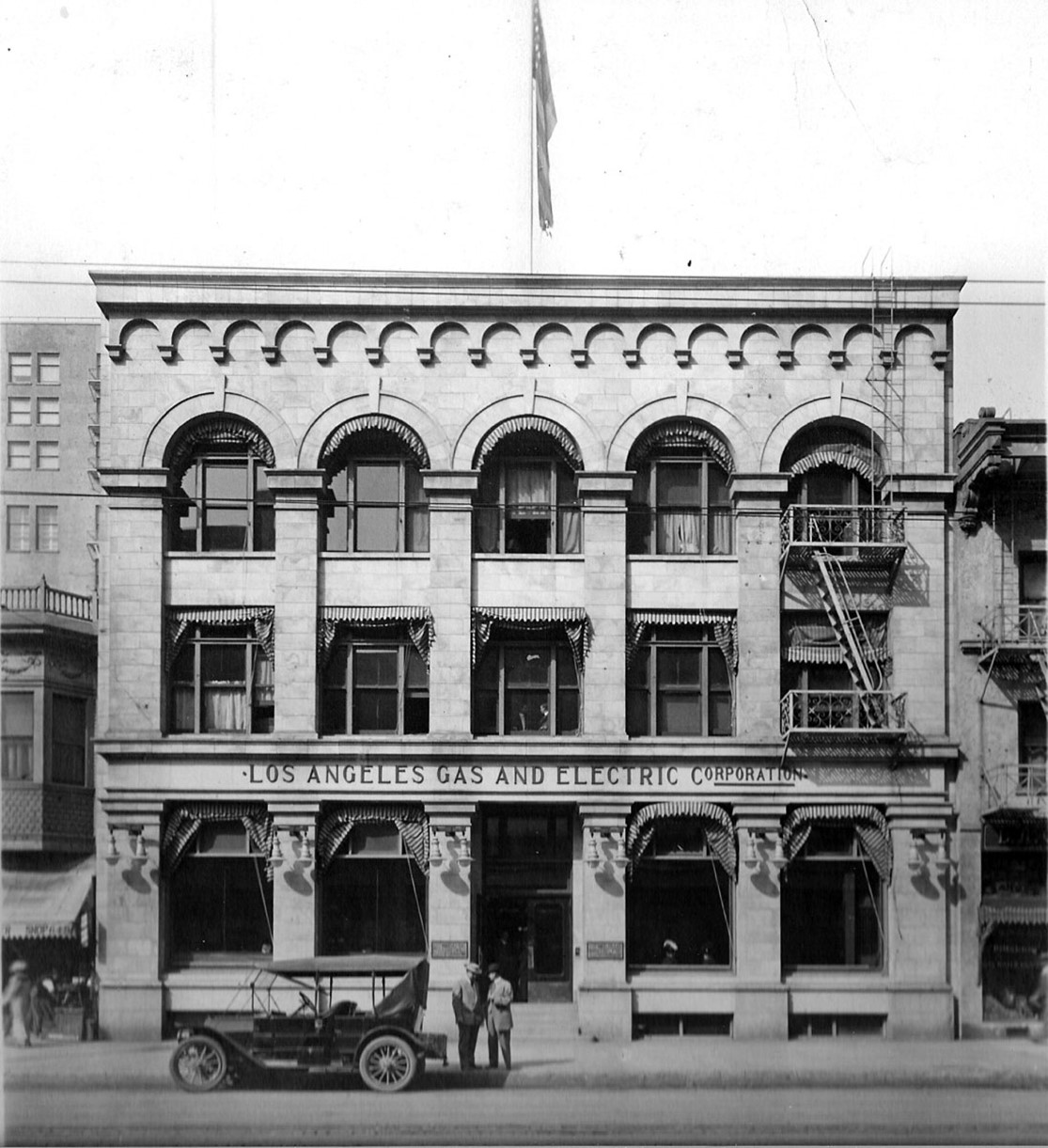 |
|
| (1920s)* - Two men are standing next to an early model car in front of the Los Angeles Gas and Electric Co. Building located at 645 S. Hill Street (two lots north of 7th Street). |
Historical Notes The Los Angeles Gas and Electric Corporation (LAGC) was one of the first utilities in Los Angeles. It competed with Los Angeles Bureau of Power and Light (BP&L) and SCE in the early 1900s. In 1936, BP&L (later LADWP) would buy out the electrical side of LAGC to become the sole provider of electricity in Los Angeles. The gas side of LAGC would then become Southern Californa Gas Company. Click HERE to see more on the Los Angeles Gas and Electric Corporation. |
Boylston Street
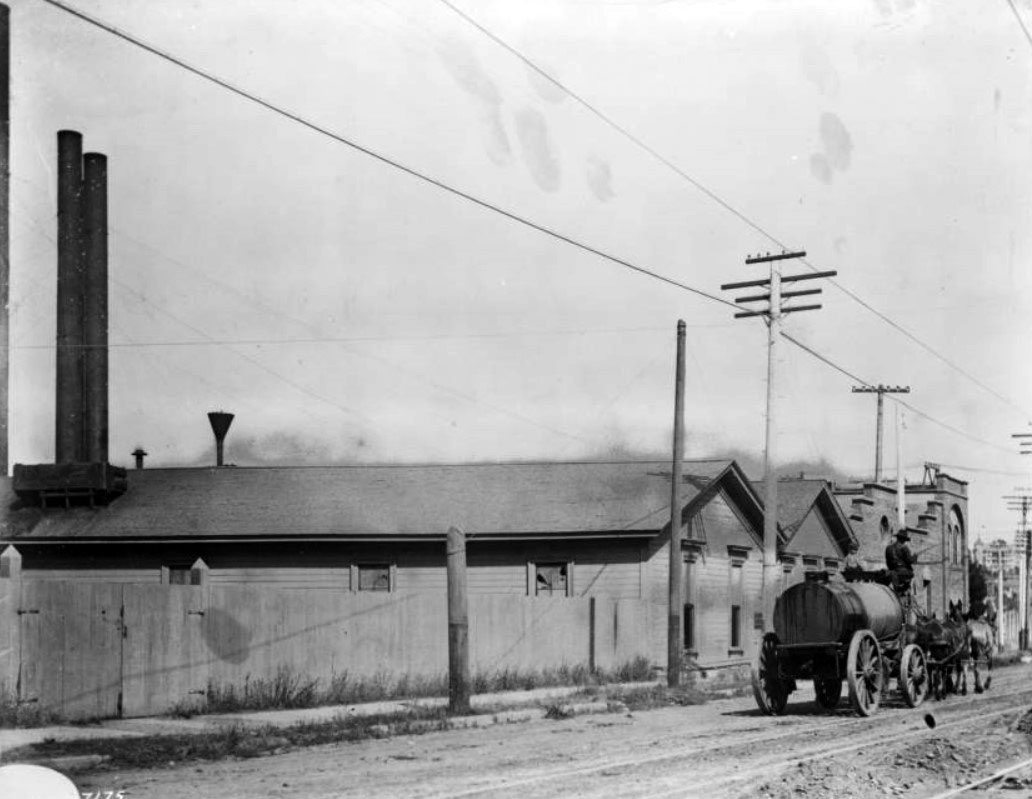 |
|
| (ca. 1900)^^ - View of Second Street looking east toward Boylston Street showing the Edison Electric Company Steam Plant No. 1. A man with a horse-drawn tanker wagon is making his way away from the camera along the unpaved road, with the Edison Electric power house behind a picket fence to his left. |
Historical Notes Between 1897 and 1906 the power house was in use as Edison Electric Company Steam Plant No. 1. This was Edison's first power plant located in the City of Los Angeles. |
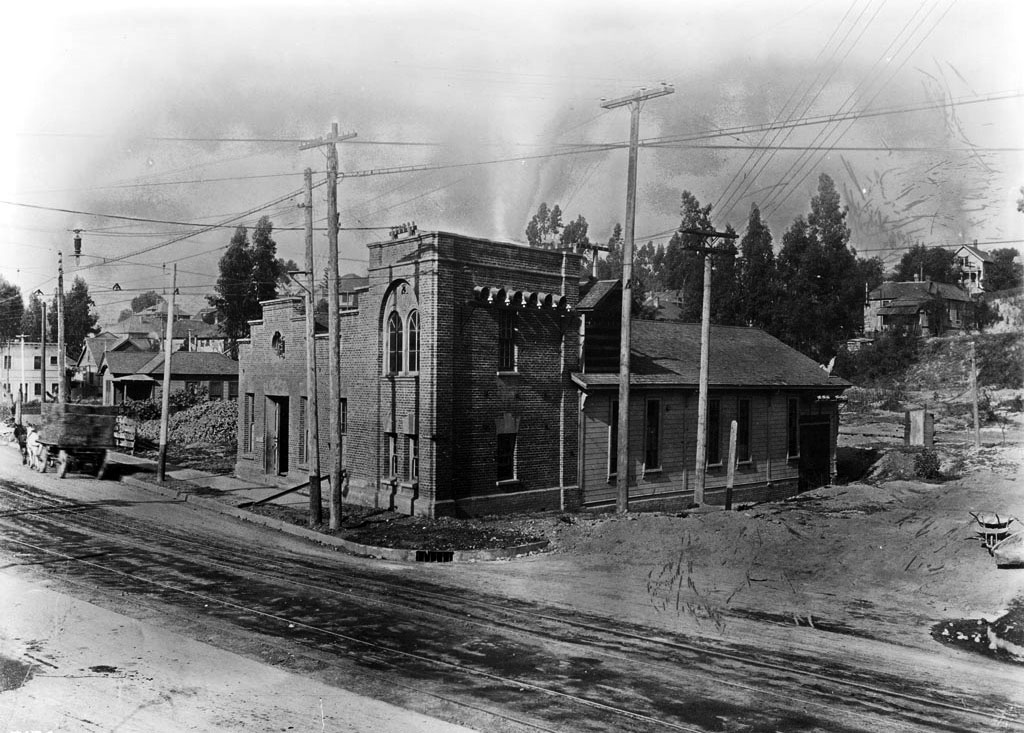 |
|
| (ca. 1906)^ - View showing the 'old' Edison Electric Steam Plan No. 1 located on the northwest corner of 2nd and Boylston streets. The auxiliary buildings with clapboard veneers and smokestacks that once were attached to the corner brick building have been removed.The two-story brick utility building now stands next to a cleared lot in front of an unpaved road in which streetcar rails can be seen, surrounded by utility poles. |
Historical Notes At the time of this photo the brick building at the corner of 2nd and Boylston streets, once part of Edison Electric Steam Plant No. 1, was no longer being used as a power plant. It now was serving as an Edison Electrical Sub-Station. In 1909, Los Angeles Edsion Electric changed its name to Southern California Edison (SCE). |
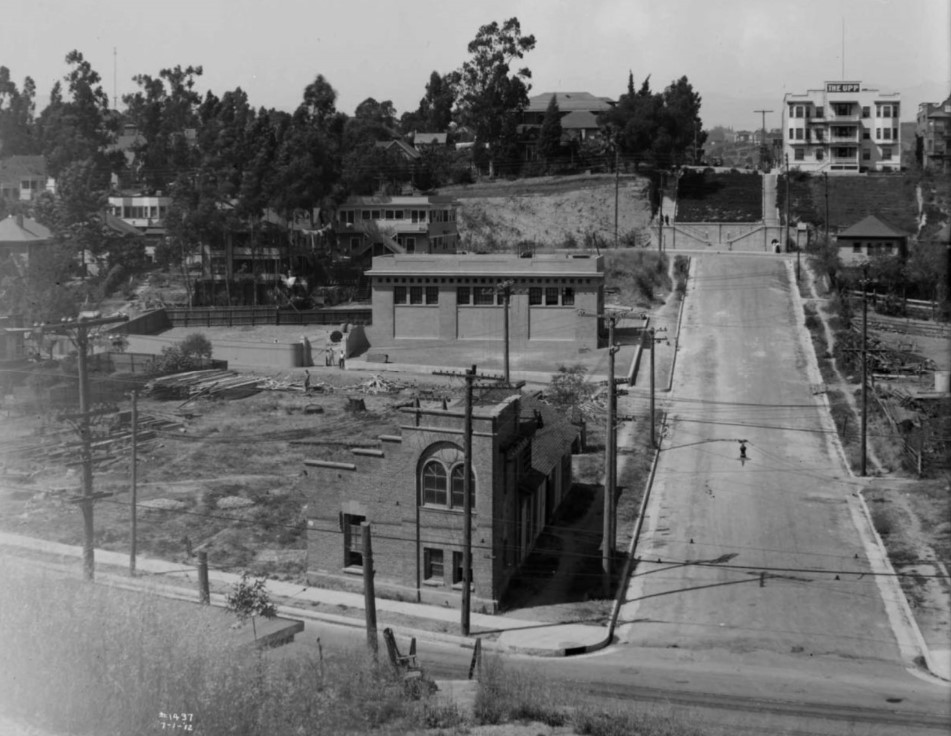 |
|
| (1912)* – View looking north on Boylston Street from above 2nd Street. The 'old' Edison Steam Plant No. 1, later converted to a Sub-Station, is on the N/W corner. A newer, more modern Sub-Station stands a couple hundred feet behind the old one at center of photo. The hill in the background is filled with apartment buildings and homes. Today this same hill is occupied by Belmont High School. |
Historical Notes Over the years the Boylston facility has been used by the West Side Lighting Company, Los Angeles Edison Electric, Southern California Edison, and the Los Angeles Department of Water and Power, which has occupied the site since 1940. Click HERE to see more in Early Boylston Street Yard. |
* * * * * |
Los Angeles and Central Oil Fields
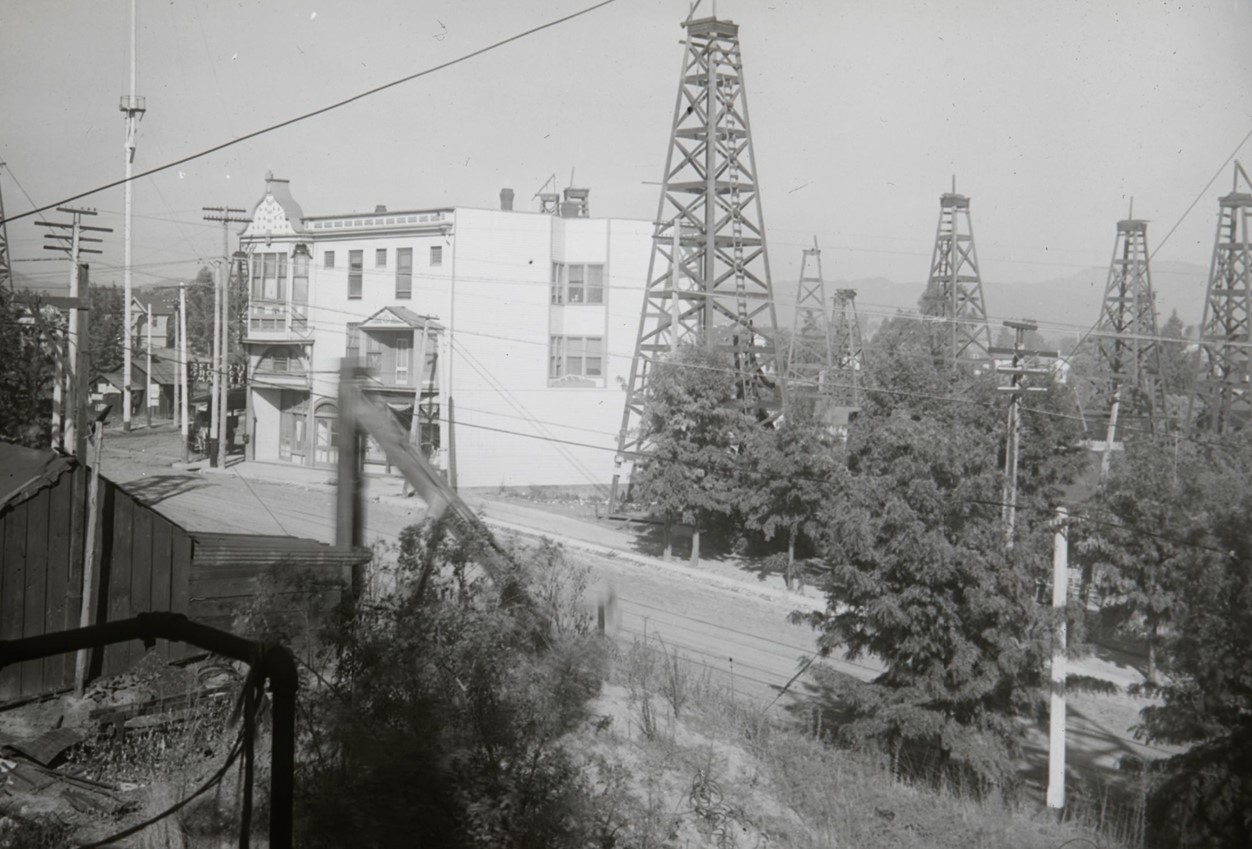 |
|
| (1905)* - Central Los Angeles Oil Field, from top of tank, nw corner 1st Street and Lake Shore Ave. |
Historical Notes The Central Oil Field above is situated just south of the largest producing oil field in the history of the Southland called the Los Angeles Oil Field. The Los Angeles City Oil Field is a large oil field north of Downtown. Long and narrow, it extends from immediately south of Dodger Stadium west to Vermont Avenue, encompassing an area of about four miles long by a quarter mile across. Its former productive area amounts to 780 acres. |
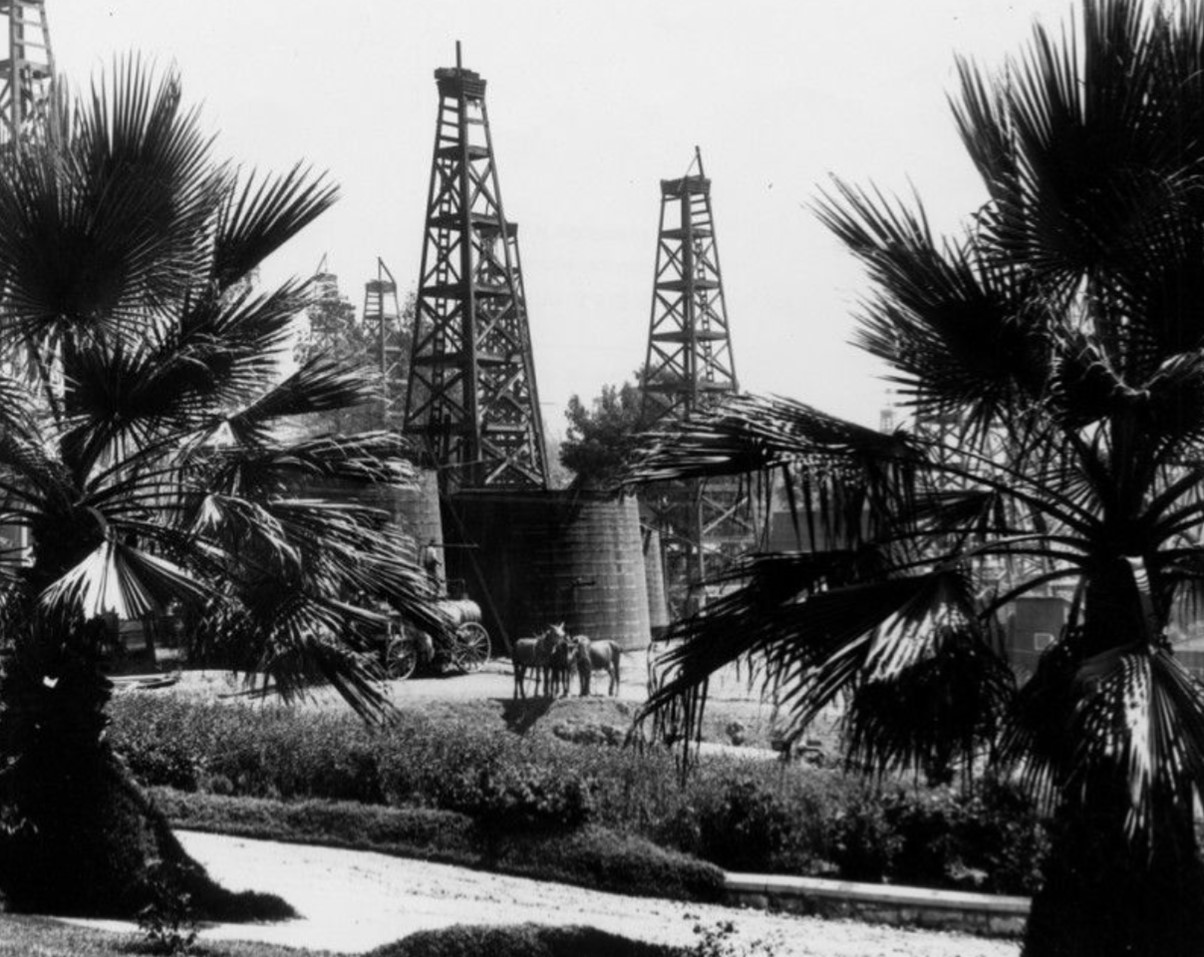 |
|
| (ca. 1890s)* - Oil field east from the corner of 1st Street and Belmont Avenue. |
Historical Notes Discovered in 1890, and made famous by Edward Doheny's successful well in 1892, the Los Angeles Oil Field was once the top producing oil field in California, accounting for more than half of the state's oil in 1895. In its peak year of 1901, approximately 200 separate oil companies were active on the field, which is now entirely overbuilt by dense residential and commercial development. |
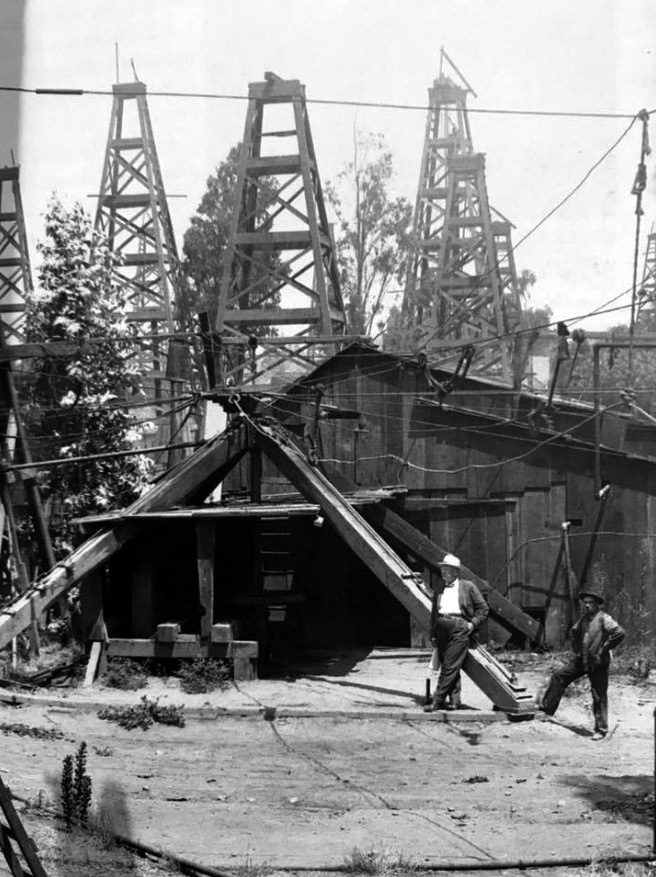 |
|
| (1904)^ – Close-up view showing two men standing in front of an oil rig located at Court and Toluca streets, with several oil wells seen in the background. Click HERE to see a Google map view of the above location. |
.jpg) |
|
| (1906)* - Los Angeles oil fields map of the wells just west of downtown in 1906. The filled in circles represent producing wells, non-filled circles represent non-producing wells (Source: Library of Congress). |
Historical Notes The fortunes made during development of the Los Angeles Oil field led directly to the discovery and exploitation of other fields in the Los Angeles Basin. Of the 1,250 wells once drilled on the field, and the forest of derricks that once covered the low hills north of Los Angeles from Elysian Park west, little above-ground trace remains today. |
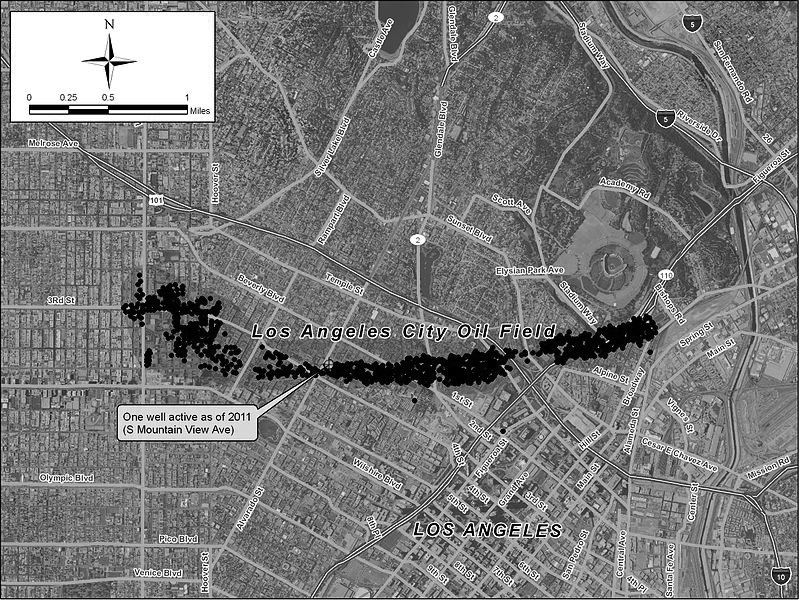 |
|
| (2011)* - Detail of the Los Angeles City Field, showing locations of former wells, and single active well remaining in 2011. |
Before and After
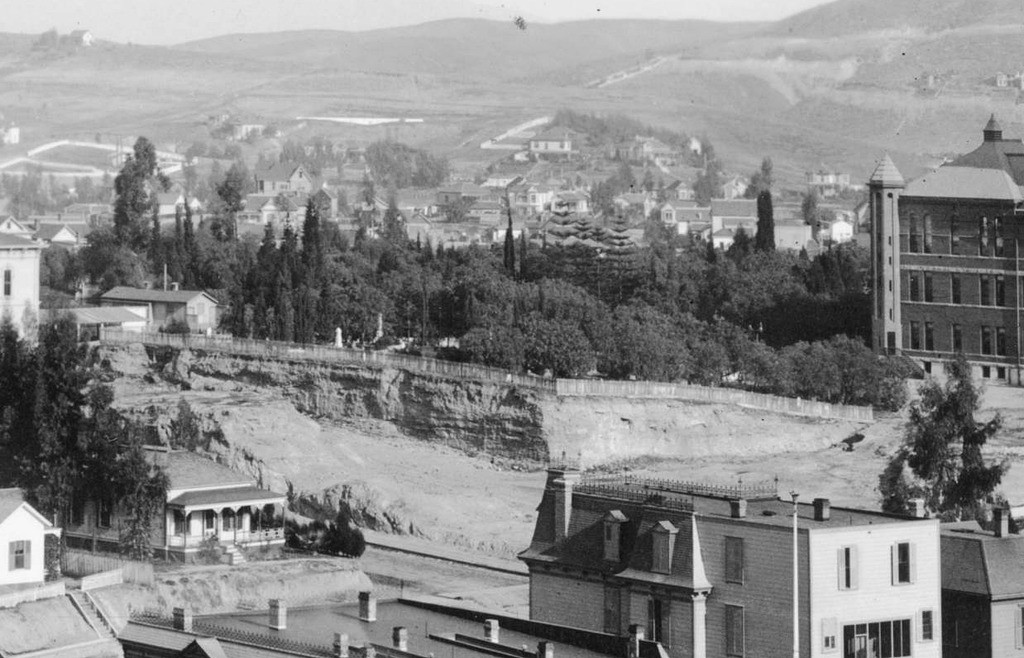 |
|
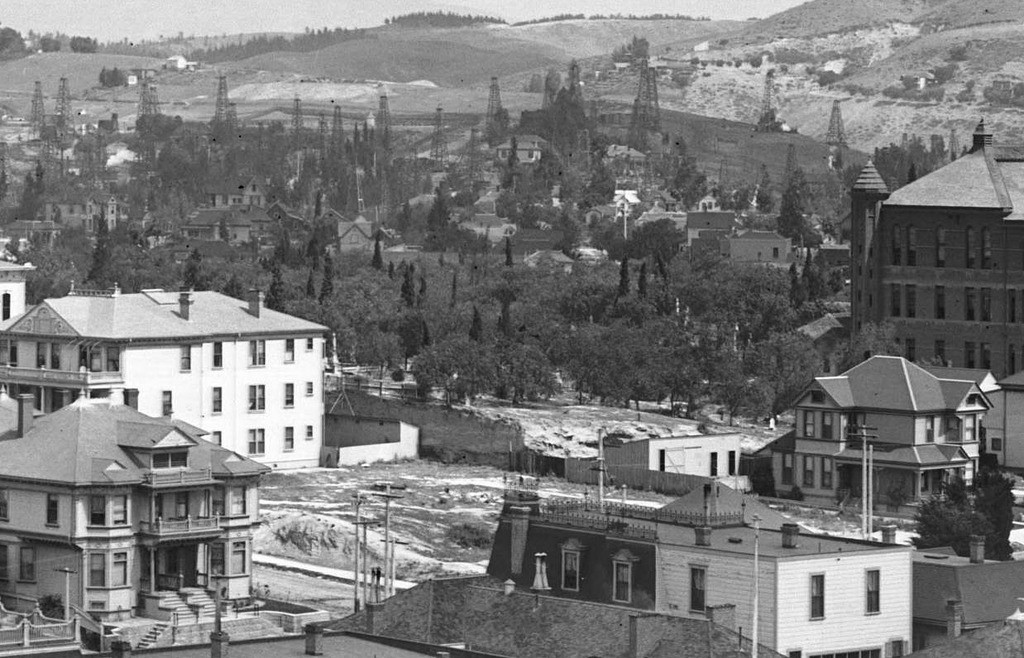 |
|
| (1898 vs. 1904)^ – Before and after views looking northwest from the County Courthouse showing how quickly the landscape has changed (six years) as a result of Edward Doheny’s discovery of oil . Note the numerous oil derricks in the background with Los Angeles High School seen at right. |
Historical Notes Click HERE to see more on the Los Angeles Oil Boom of the 1890s |
* * * * * |
Early Downtown LA
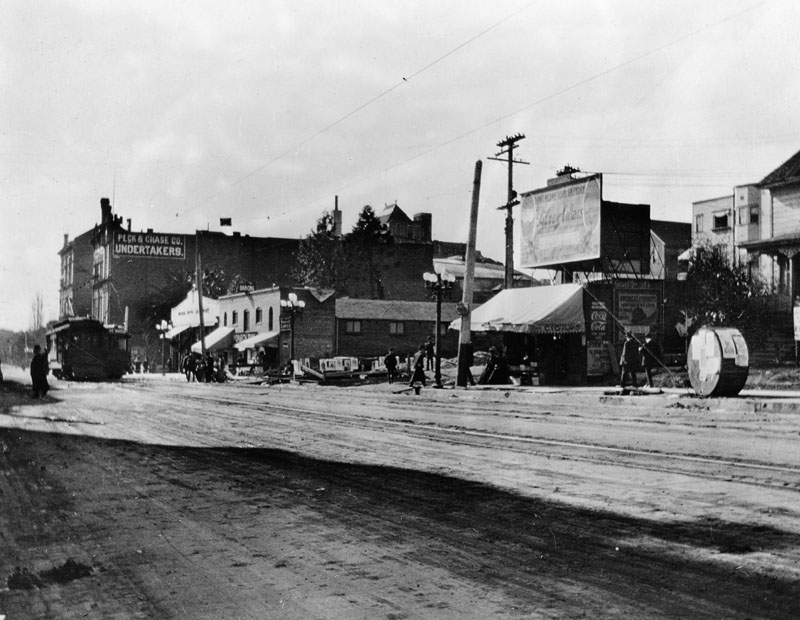 |
|
| (1905)^ - A large, wooden cable wheel plastered with posters stands at the ready on Hill St. looking south from 4th. To the left, a streetcar passes in front of a dance club. The sign on the building behind is for "Peck & Chase Co., Undertakers". Although tracks for the streetcars are laid, the street is unpaved. |
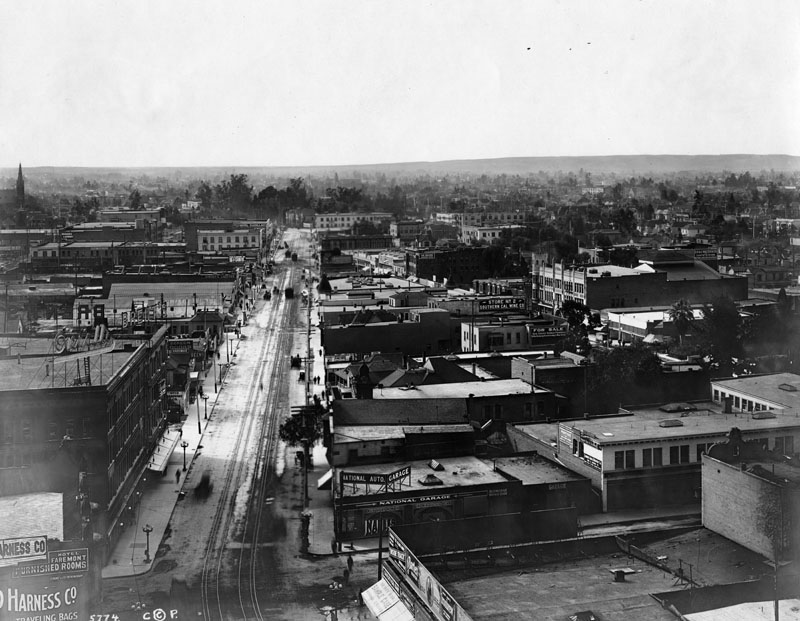 |
|
| (1905)^ - Panoramic view of Main Street, looking south from 7th Street. At left is the Hotel Faremont, next to which is Overall's, Brent's, followed by a hardware, Hunger's Laundry, a sign shop, and Hotel Cadillac. At right is National Auto. Garage, a real estate office and other buildings. Southern California Wine Co. store no. 2 is seen on Spring Street, angling in at right, which joins Main in the distance. |
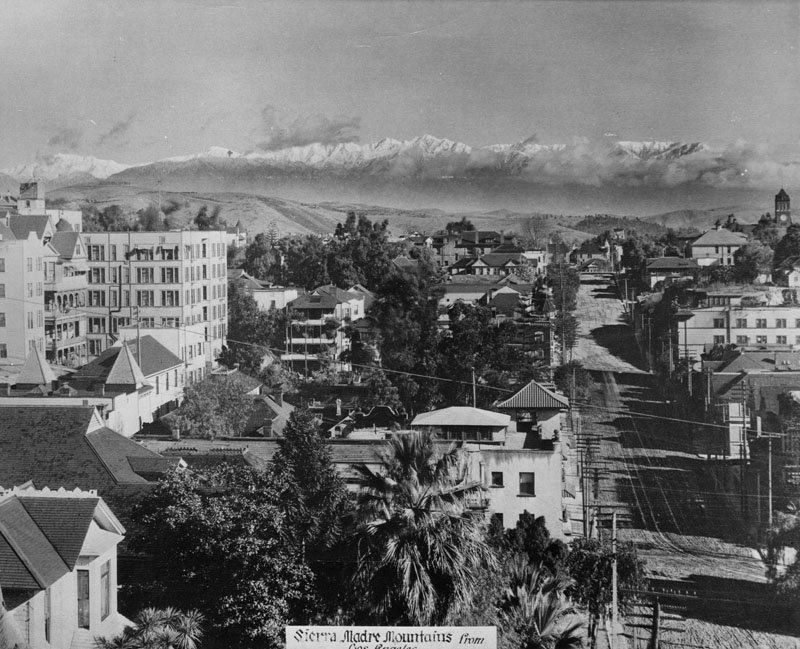 |
|
| (ca. 1905)^ - View from the 200 block of South Olive St. on Bunker Hill looking northeast towards Sierra Madre and the snow-capped San Gabriel Mountains. Although the background hills have few trees, the city is a forest with palms, evergreen, and deciduous trees interspersed among the buildings. The long building behind the palm fronds (foreground) is the Mission Hotel/Apartments on the southwest corner of 2nd St. and Olive. The two larger structures, left, are rear views of the Richelieu and Melrose hotels on Grand Avenue. The Los Angeles High Schooltower is on the far right at the top of the picture. Although utility lines are in, the streets are still unpaved. |
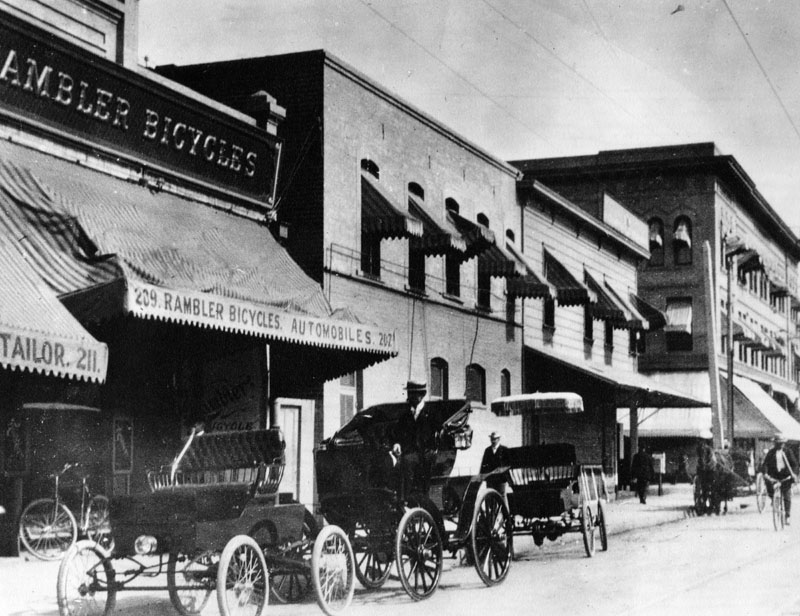 |
|
| (1905)^ - Three cars are parked in front of Rambler Bicycles at 207-209 W. 5th St. near Spring. |
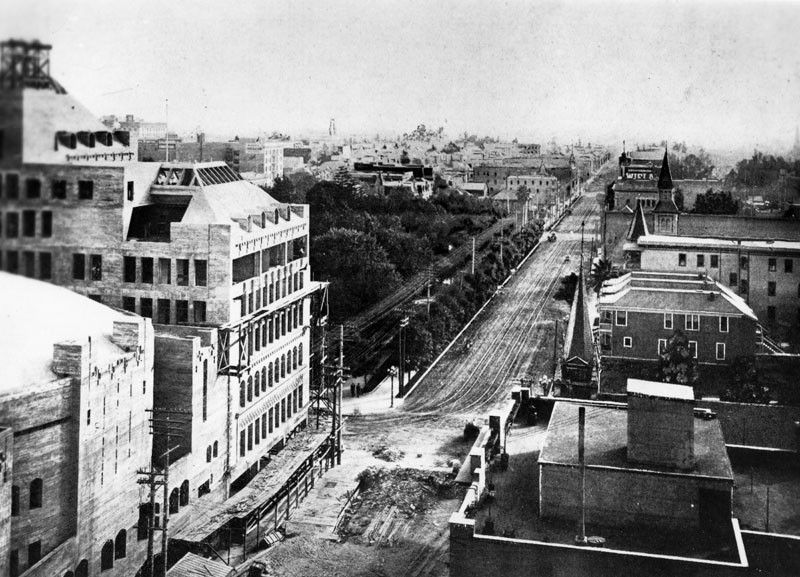 |
|
| (1905)^ - Panoramic view of 5th and Olive Streets, looking south in 1905. Central Park (later Pershing Square) is seen, and there are churches at right. At left the Auditorium Building is under construction. |
* * * * * |
Broadway
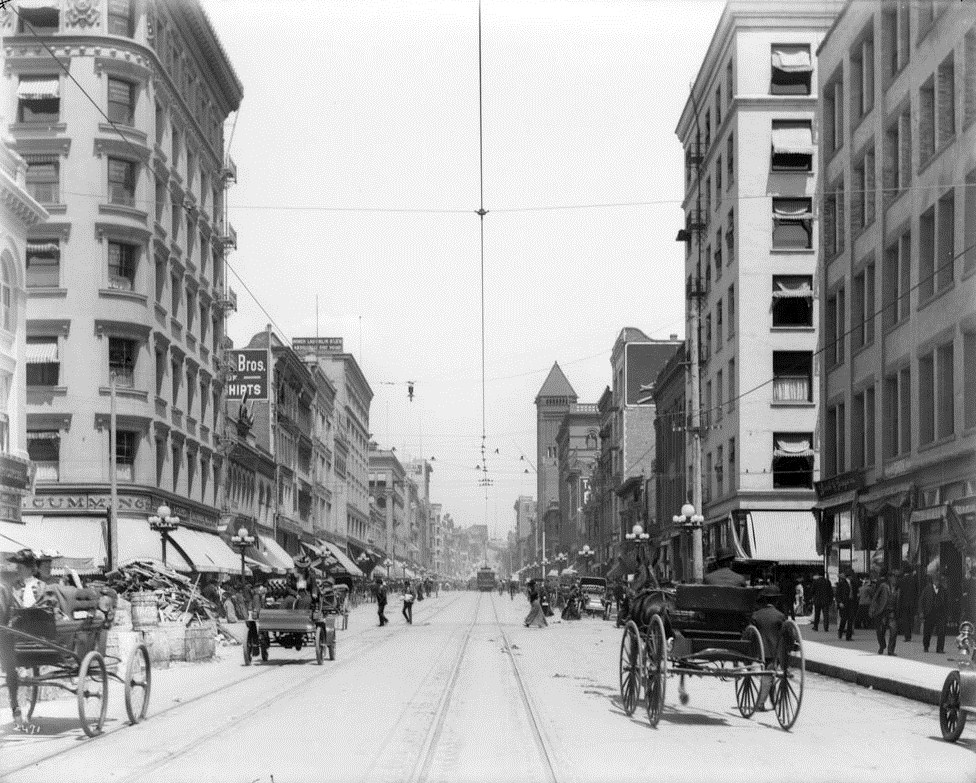 |
|
| (1905)^^ - View looking north on Broadway from Fourth Street. Horse-drawn carriages can be seen on both sides of Broadway. On the left, heading south on Broadway, a woman is behind the stick (no wheel) of an early model car. Ornate multi-lamp streetlights adorn both sides of the street. |
Historical Notes The tall tower in the distance is the Old City Hall, located at 226 Broadway. It was LA’s 3rd City Hall. Built in 1888, it stood until the current City Hall was completed in 1928.^ |
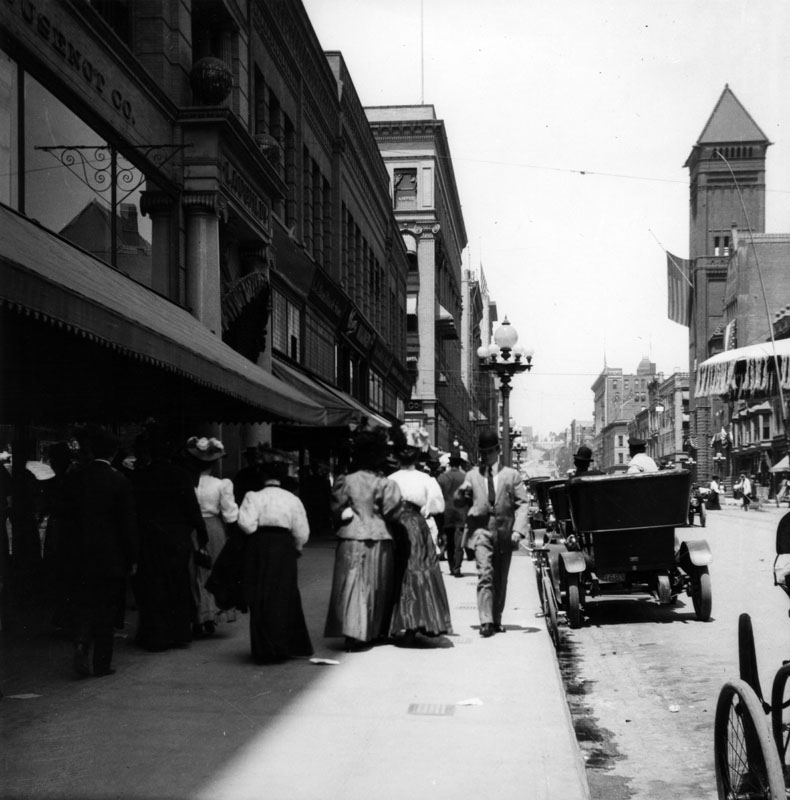 |
|
| (ca. 1905)^ - This photo shows numerous pedestrians walking along Broadway near Second Street in Downtown L.A. The women can be seen wearing long skirts, long sleeved blouses and/or tapered jackets, and all are wearing hats. The gentlemen are dressed in 2-piece suits and all of them can be seen wearing bowler hats as well. Several open cars are parked along the street. City Hall can be seen in the background across the street. |
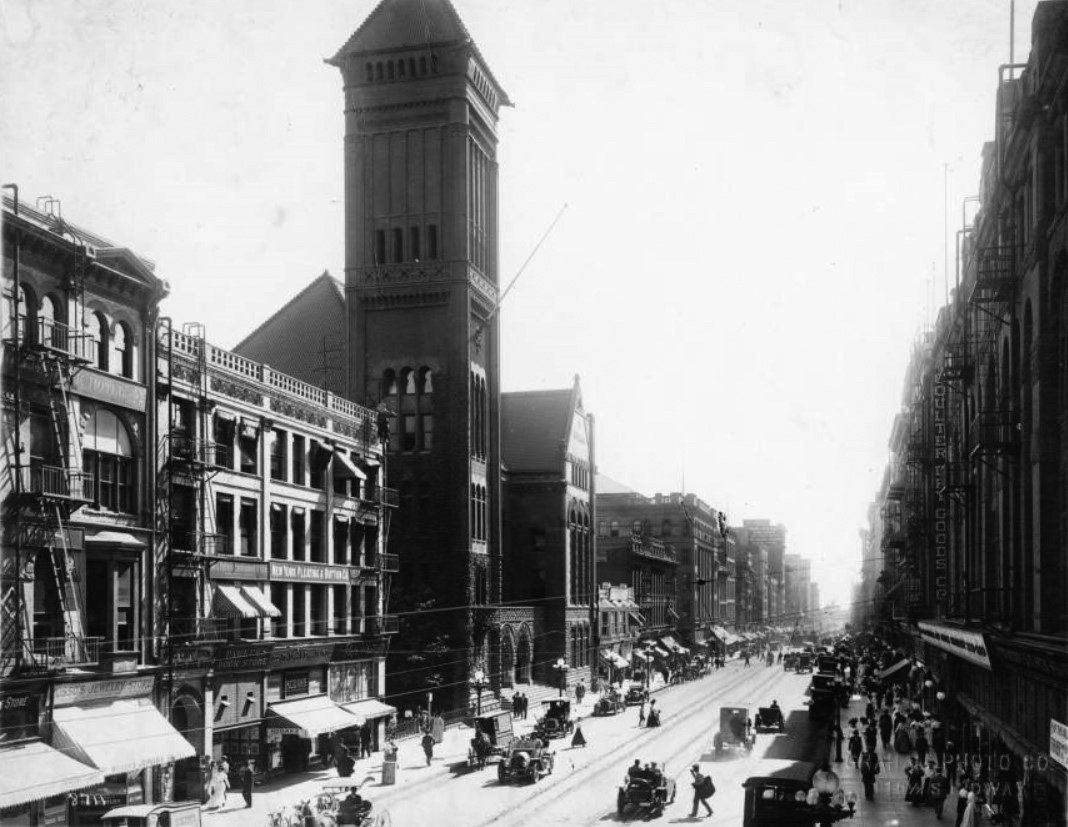 |
|
| (ca. 1905)^ - View looking south on Broadway between 2nd and 3rd streets showing the old Los Angeles City Hall . Early model cars are seen throughout and streetcar tracks run up and down Broadway. |
 |
|
| (ca. 1905)^ - Looking south on Broadway between Second Street and Third Street, showing the old Los Angeles City Hall, ca.1905. The city hall building is across the street at center and is identified by a massive rectangular tower. There are other tall buildings on both sides of the street, most between two and five stories high. The street is paved and is divided by streetcar tracks in the middle. Several early-model automobiles can be seen on the road, and many pedestrians are walking along the sidewalks.; The Bradbury Building (1893) can be seen farther down the left side of the street at the intersection of Third and Broadway (304 S. Broadway). It is quite likely the only extant structure of all those pictured in this photo.; Legible signs include, from left to right: "Hotel", "Russo's Jewelry Store Branch of Naples, Italy", "Parker's Book Store", "Mrs. Patten's Employment Office", "New York Pleating & Button Co.", " The Merick Reynolds Co.", "Kodaks", "Pig 'n Whistle", and "Coulter Dry Goods Co. |
 |
|
| (ca. 1905)* - Looking south on Broadway from 5th Street. Pacific Electric "red cars" share the street with horse carts. The sign on the electric car is marked "Boyle Hts." |
Then and Now
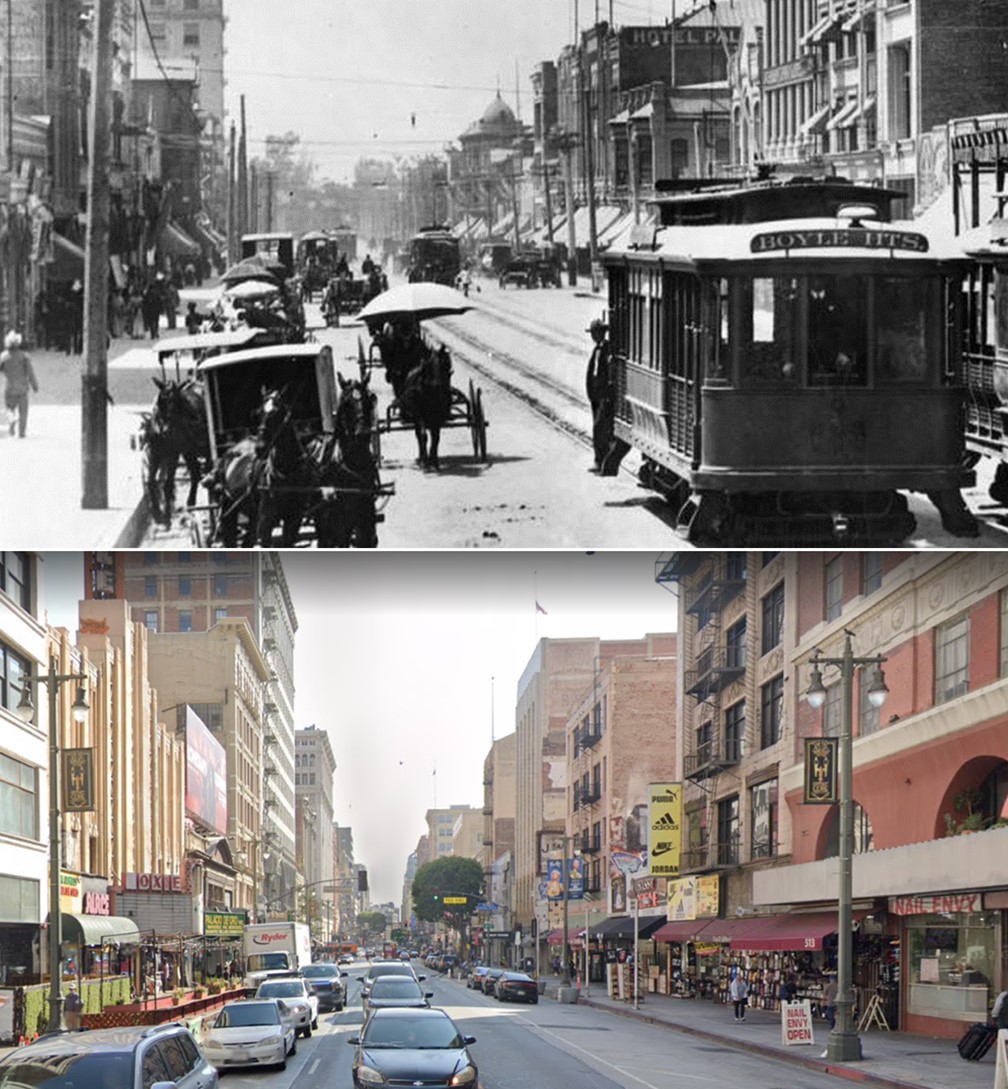 |
|
| (1905 va, 2021)* - Looking south on Broadway from near 5th Street. |
Hill and 4th Street
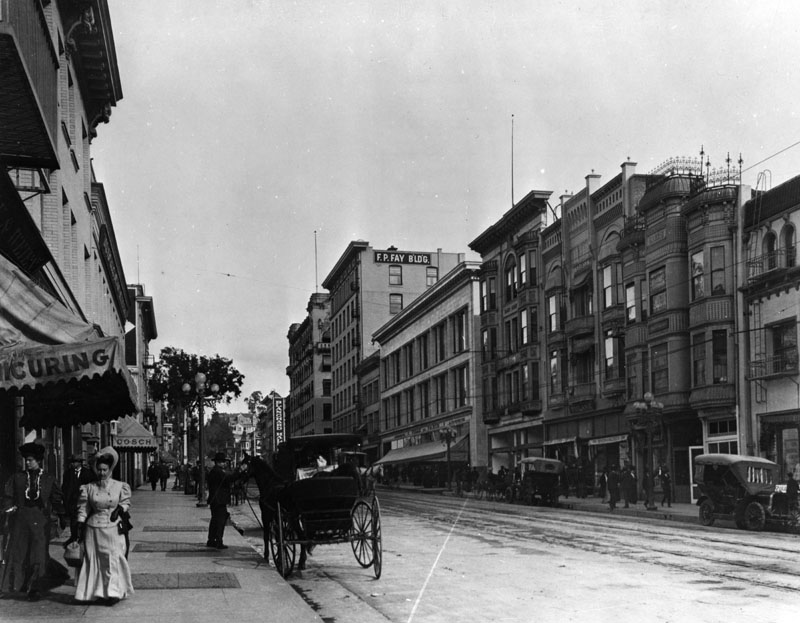 |
|
| (1905)^ - A man pats a horse as women pass under an awning in this view of Hill St. at 4th, looking north. In the center is the F.P. Fay Building with its prominent sign. Second building to the right is the Ville de Paris department store. |
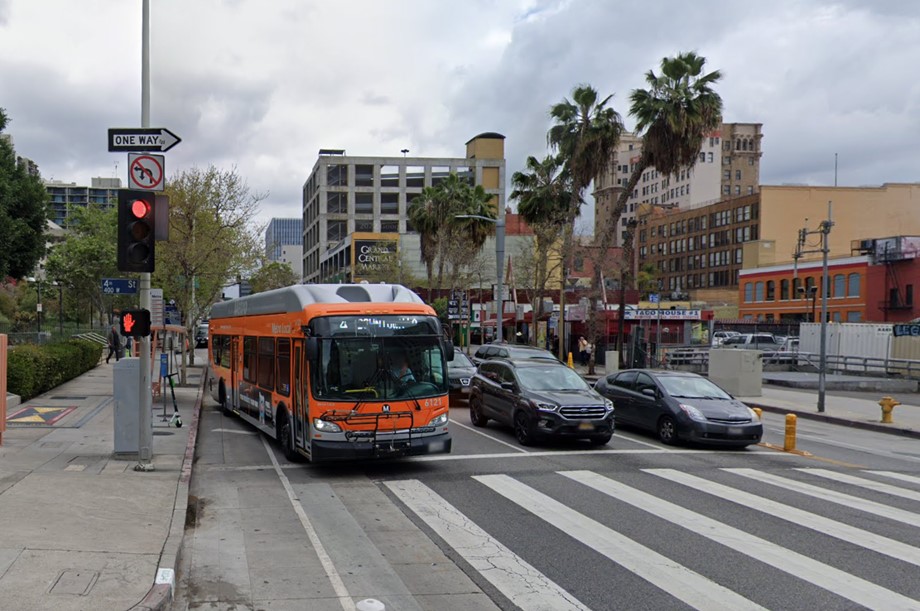 |
|
| (2021)* - Looking north on Hill Street at 4th Street. |
Then and Now
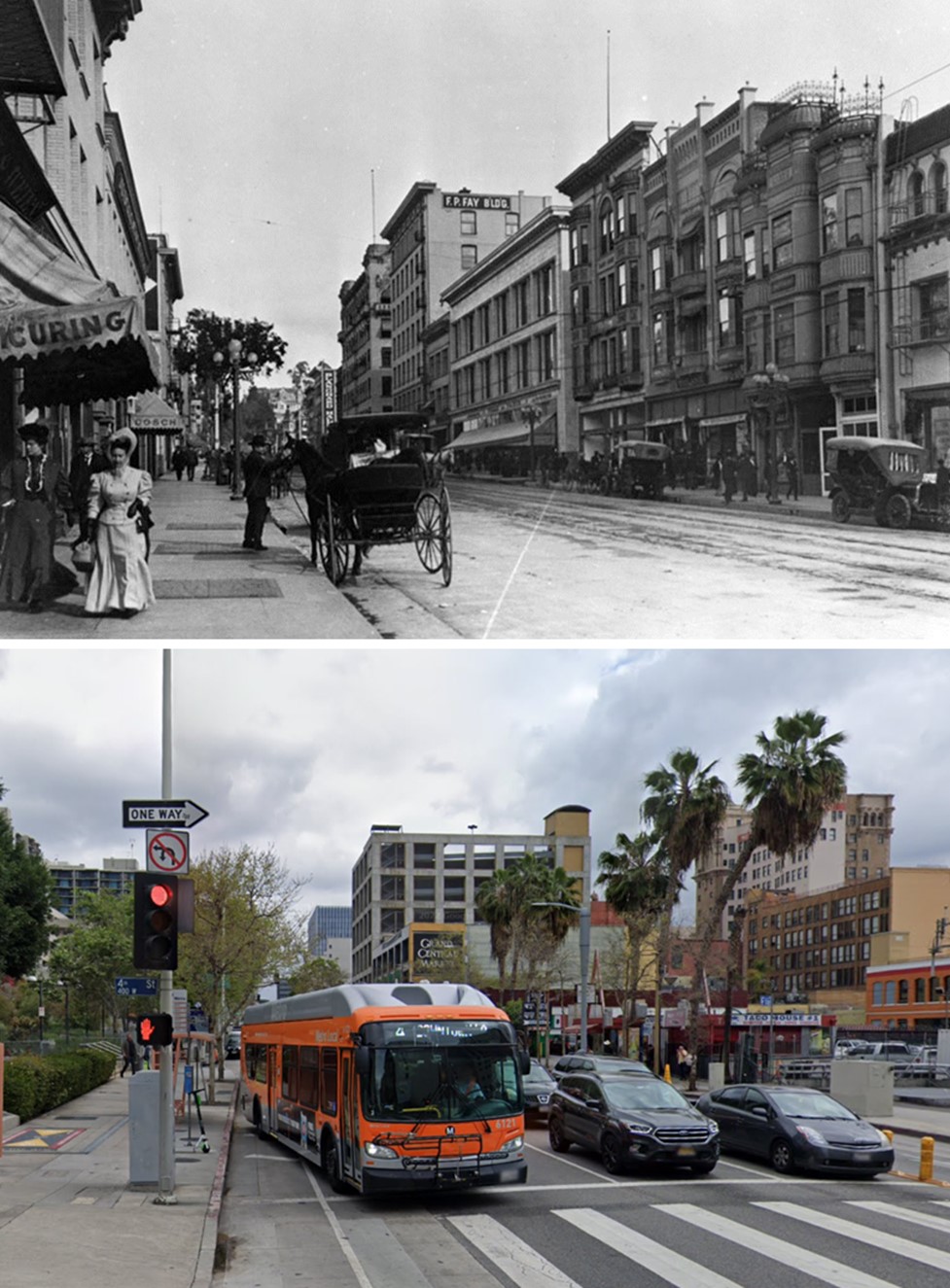 |
|
| (1905 vs 2021)* - Looking north on Hill Street at 4th Street. |
Spring and 2nd Street
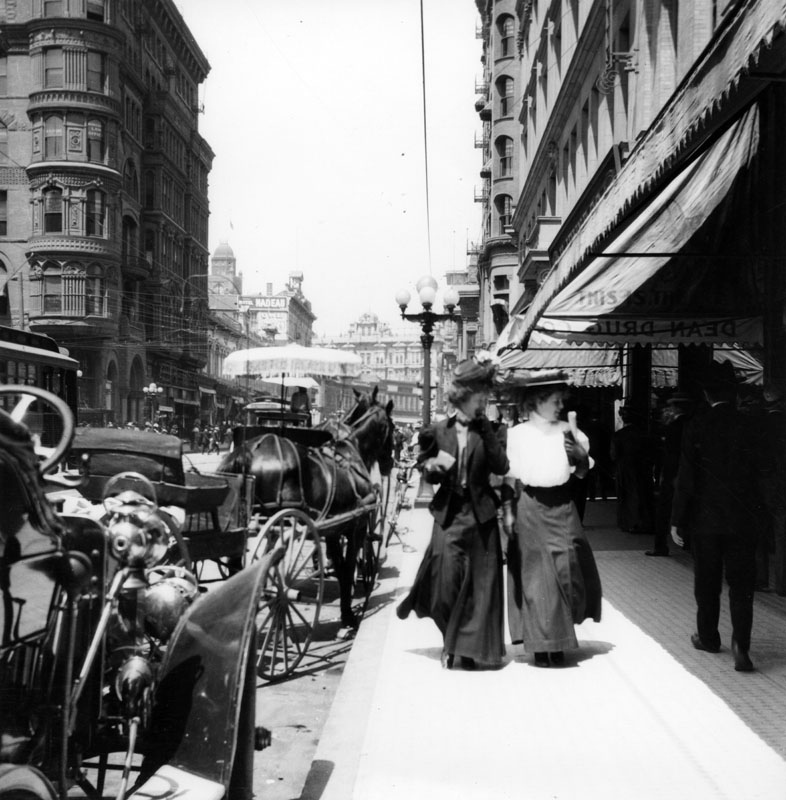 |
|
| (ca. 1905)^ - Two women are walking along Spring Street south of 2nd Street with the Bryson-Bonebrake Block seen on the left (NW corner). It appears that either the man walking by or something in the store window has caught their attention. Several open cars and horse-drawn carriages are seen parked along the street. Note the ornate streetlight behind the women. Click HERE to see more in Early Los Angeles Street Lights |
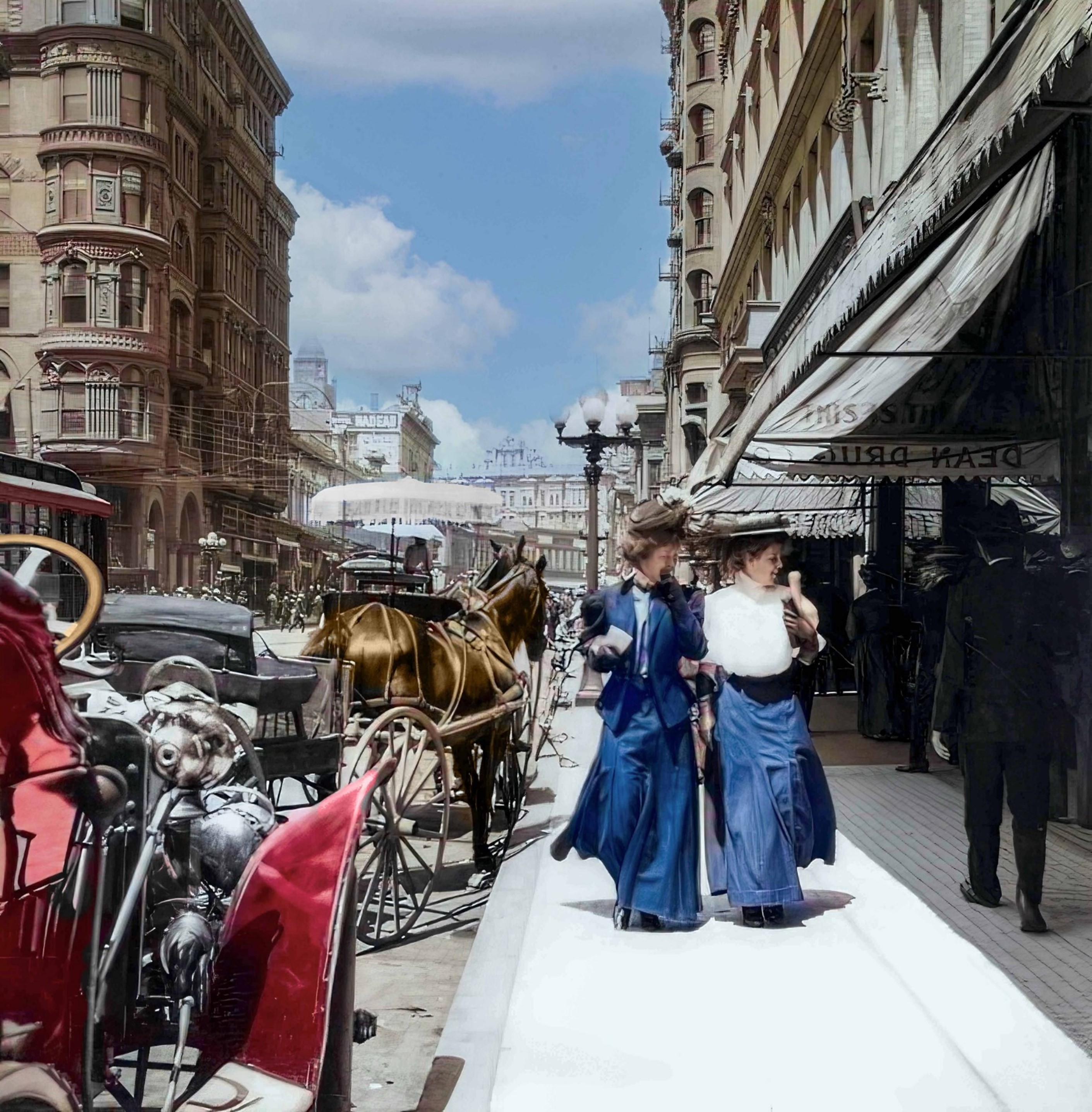 |
|
| (ca. 1905)^ - Two women are walking along Spring Street south of 2nd Street with the Bryson-Bonebrake Block seen on the left (NW corner). It appears that either the man walking by or something in the store window has caught their attention. Several open cars and horse-drawn carriages are seen parked along the street. Note the ornate streetlight behind the women. Click HERE to see more in Early Los Angeles Street Lights. Image enhancement and colorization by Richard Holoff. |
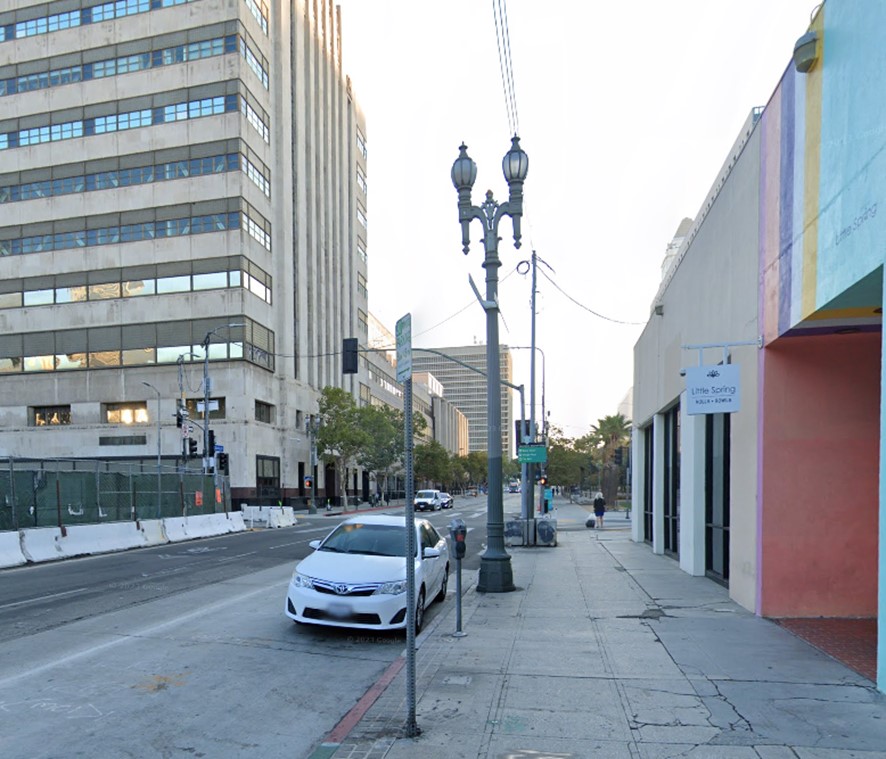 |
|
| (2022)* - Looking north on Spring Street toward 2nd Street. |
Then and Now
 |
|
| (1905 vs 2022)* - Looking north on Spring Street toward 2nd Street. |
Spring and 6th Street
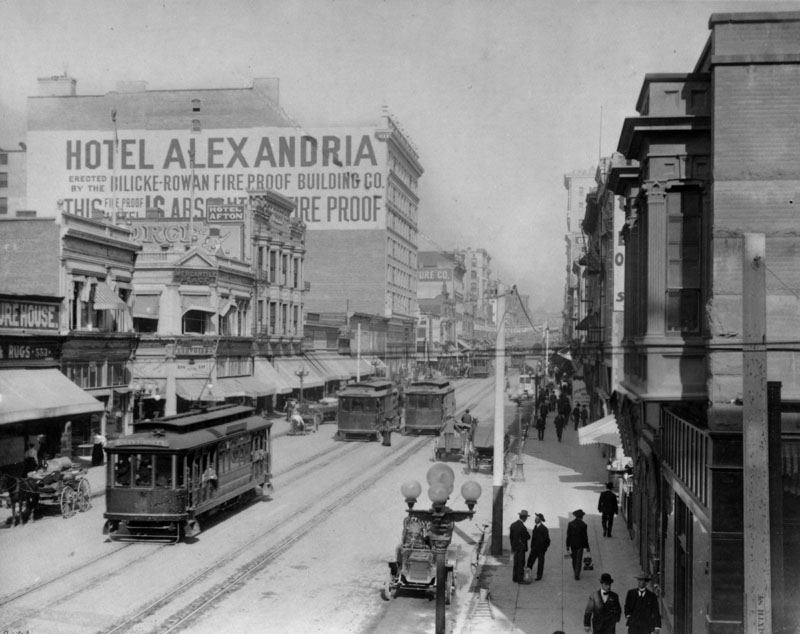 |
|
| (1906)^ - View looking north on Spring Street from 6th St. to the Hotel Alexandria located on the southwest corner at 5th St. |
Spring and 5th Street
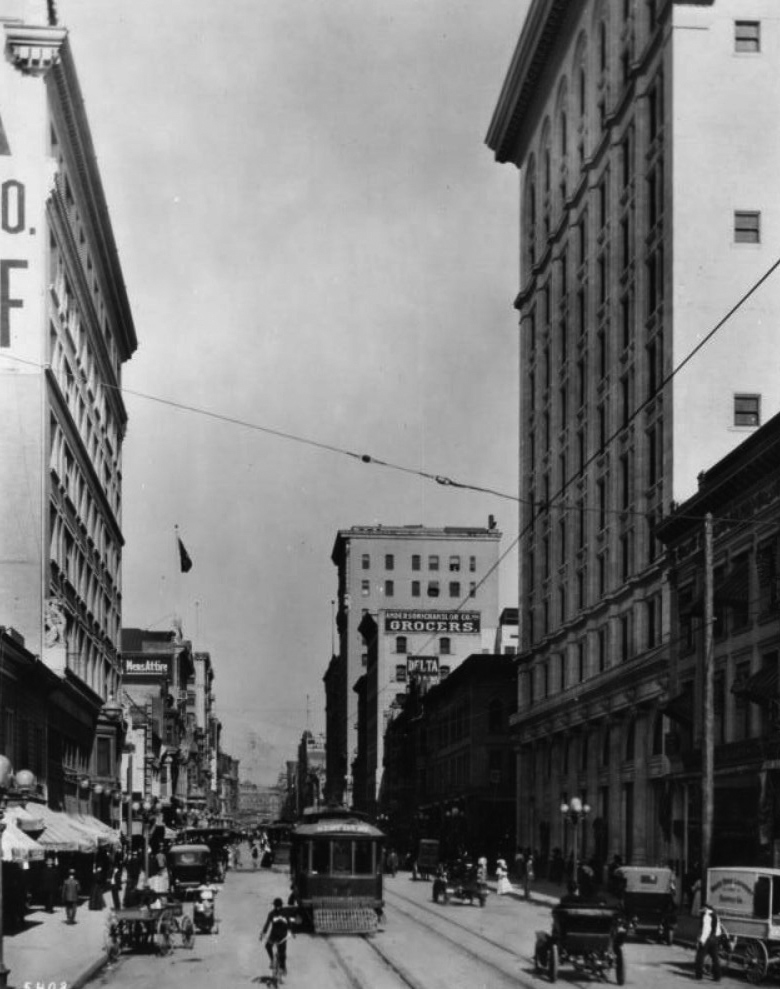 |
|
| (1905)^ – View looking north on Spring Street with the Alexandria Hotel partially seen at the southwest corner of Spring and 5th St. (left side of picture). On the right (east side) sits the tall Security Building. A cyclist shares the road with horse-drawn wagons, early model cars and streetcars. |
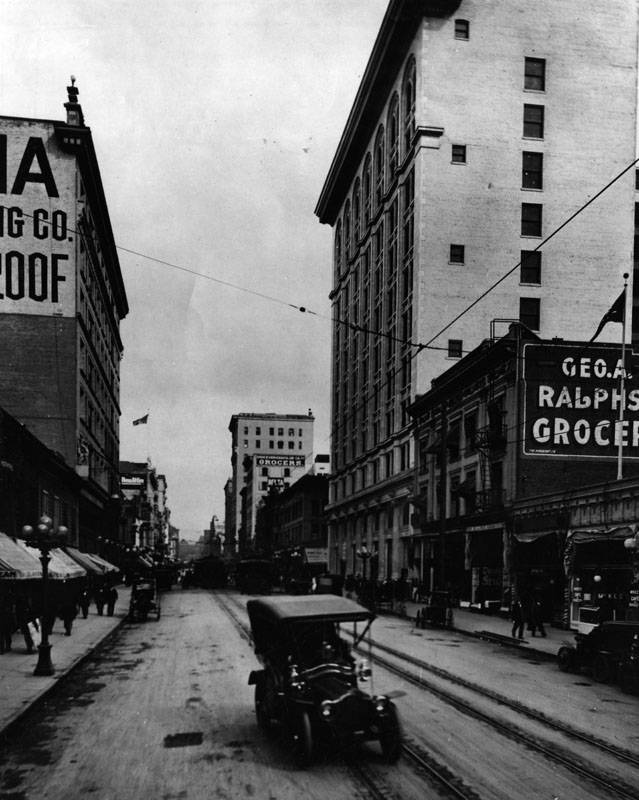 |
|
| (1905)^ - An early view of Spring St. with the Alexandria Hotel partially seen at the southwest corner of Spring and 5th St. (left side of picture). On the right (east side) George A. Ralphs Grocer sits below the taller Security Building. |
Historical Notes Ralphs Grocery Company was founded in 1873 by George Albert Ralphs with the original store being located at Sixth and Spring Streets. The company employed notable architects in designing its stores.*^ Click HERE to see an 1886 photo of George Ralphs standing in front of his original store in the Early LA Buildings (1800s) Section. |
 |
|
| (n.d.)^ - A man is standing next to a delivery truck of Ralphs Grocery Co. A sign on the side says, "Ralphs Grocery Co. Sells for Less." |
Spring and 7th Street
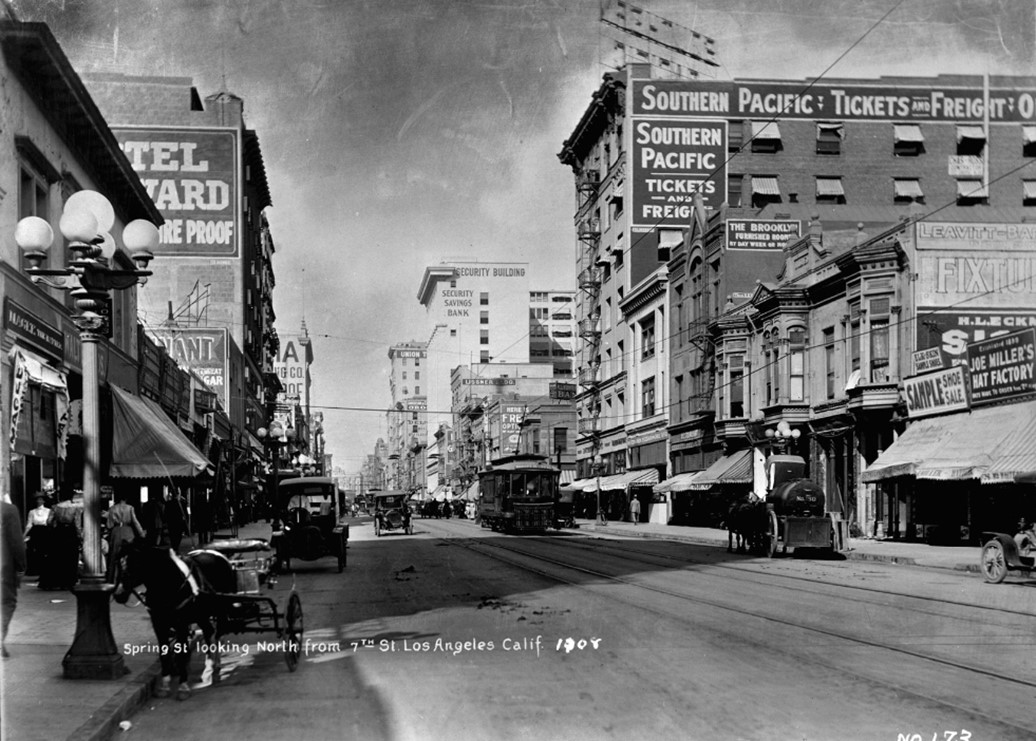 |
|
| (1908)* - Spring Street looking north from 7th Street. Note the horse-drawn wagon parked at the curb under an ornate 5-globe streetlight. |
Historical Notes Click HERE to see more on the early 5-Globe streetlights seen above. |
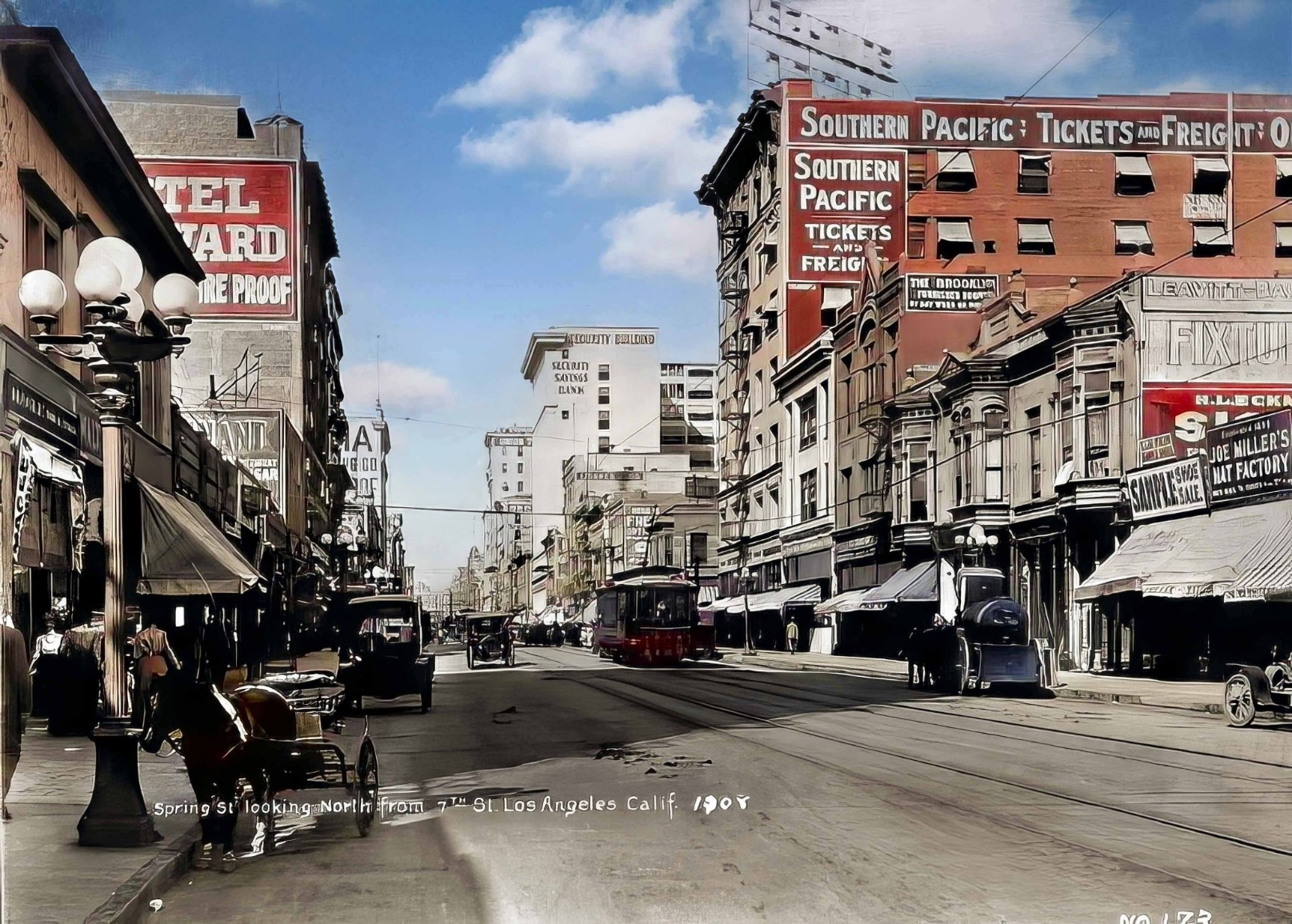 |
|
| (1908)* - Spring Street looking north from 7th Street. Note the horse-drawn wagon parked at the curb under an ornate 5-globe streetlight. Image enhancement and colorization by Richard Holoff. |
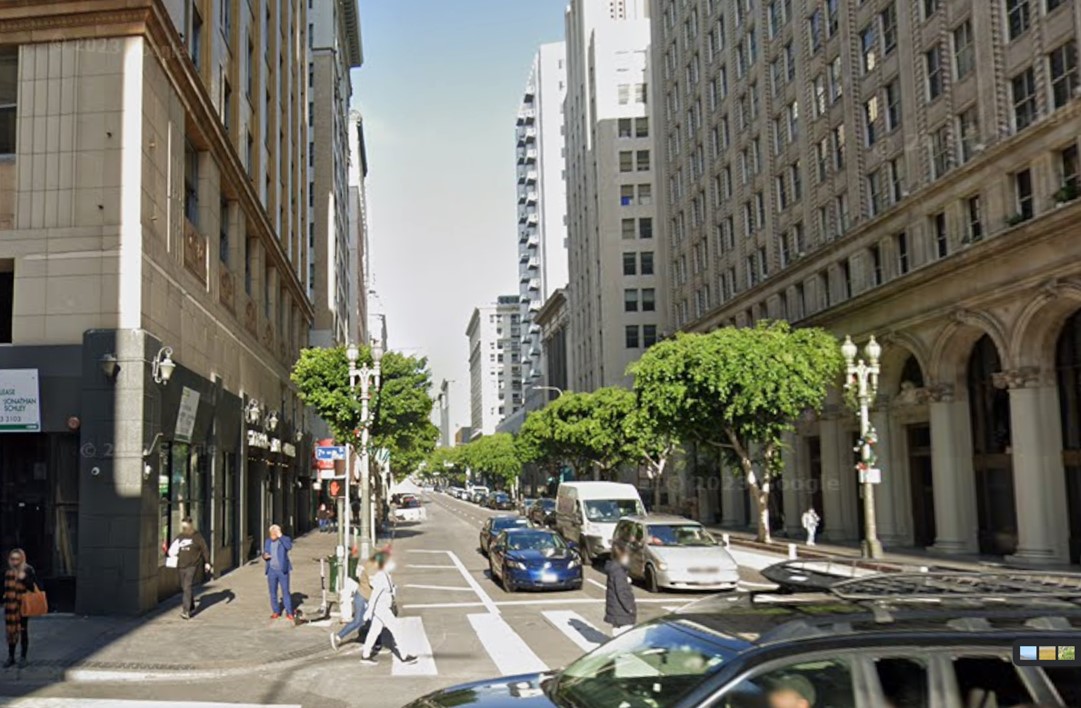 |
|
| (2022)* - Looking north on Spring Street at 7th Street in DTLA. |
Then and Now
 |
|
| (1908 vs 2022)* - Looking north on Spring Street at 7th Street in DTLA. |
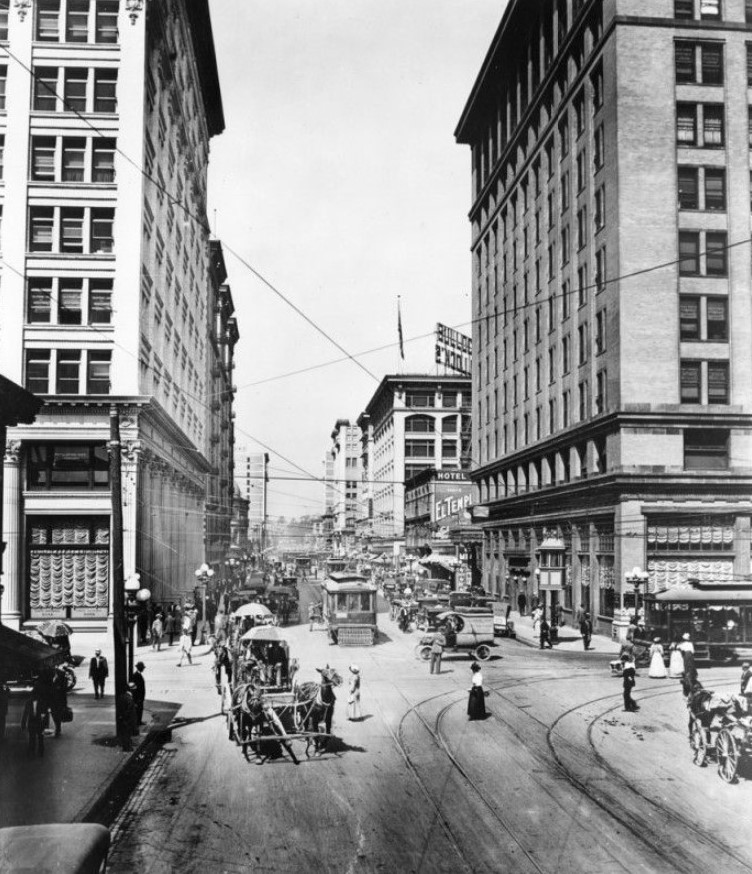 |
|
| (1915)* - Looking west on 7th Street at Spring Street. |
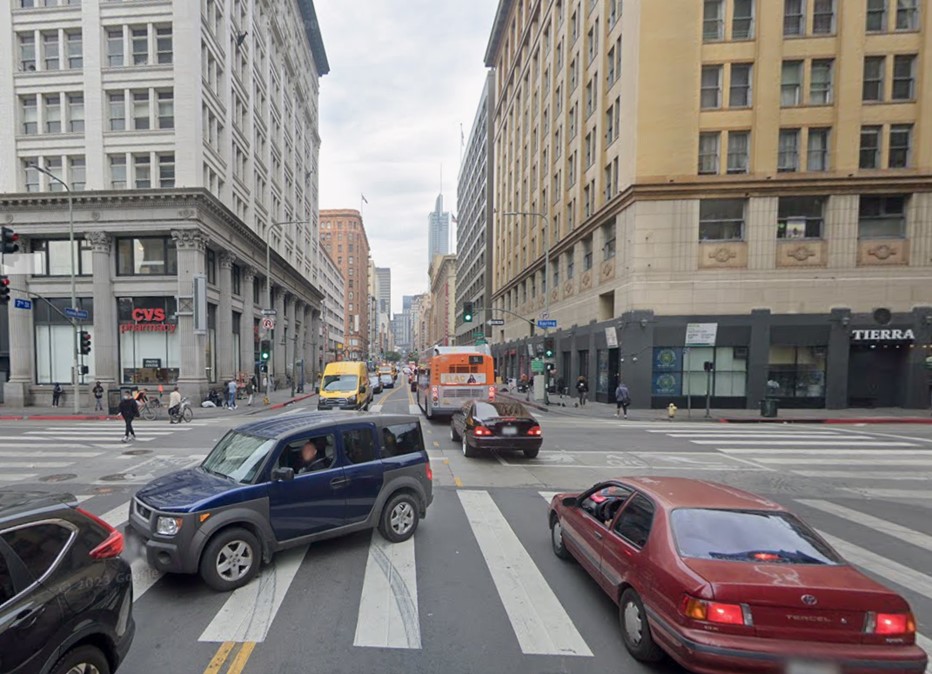 |
|
| (2021)* – Looking west on 7th Street at Spring Street. |
Then and Now
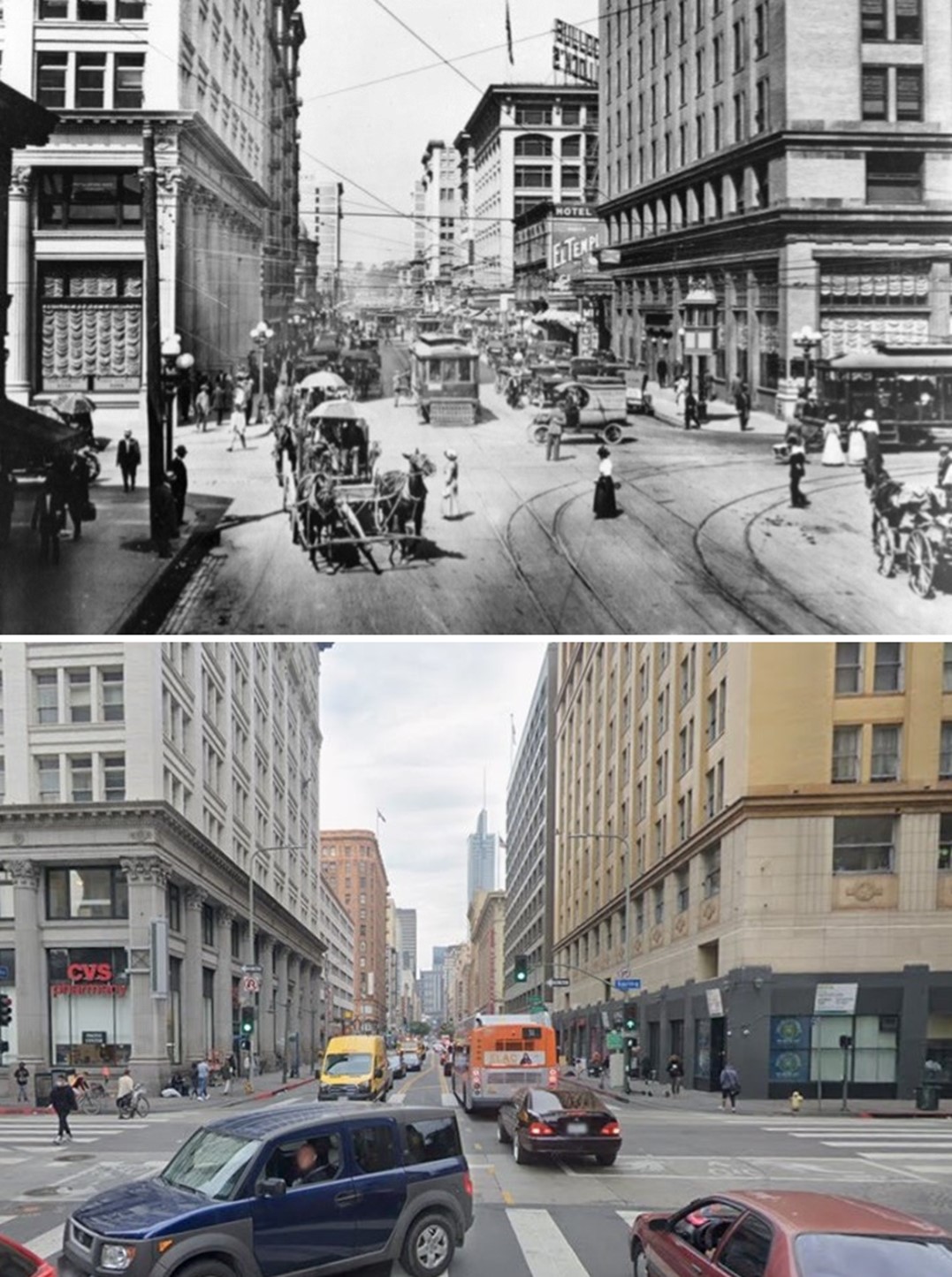 |
|
| (1915 vs 2021)* – Looking west on 7th Street at Spring Street. |
* * * * * |
Fire Department - Hill and 16th Street (later renamed Venice Street)
 |
|
| (ca. 1905)^ - Firemen in their horse-drawn firewagons are seen outside of their station located at Hill and 16th (later renamed Venice Boulevard) streets. |
Hill and 5th Street
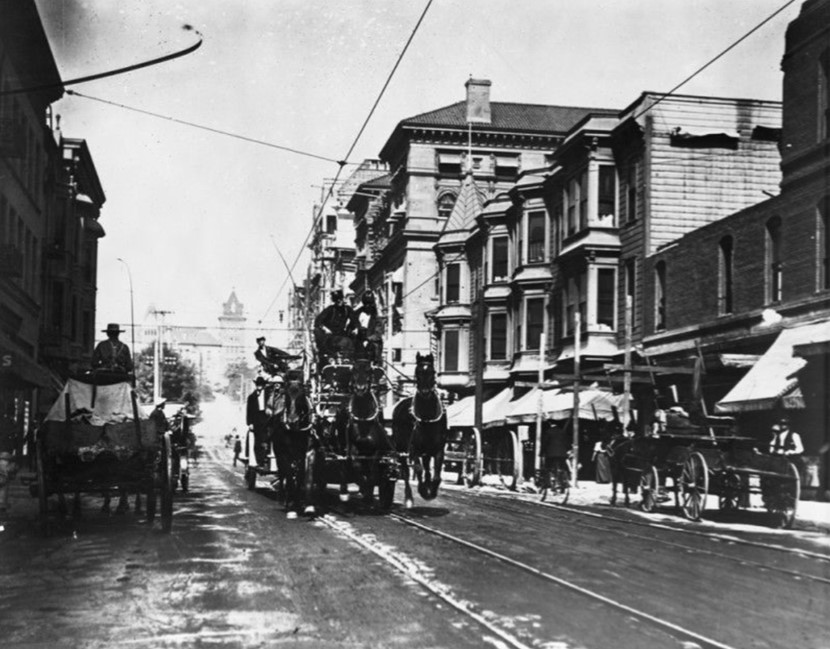 |
|
| (1905)* - A fire engine races east on 5th St. from Hill Street. The view is looking west. The prominent building in the background is the State Normal School, on the present site of the L.A. Public Library, Central Branch. The building with awnings behind the fire engine is the California Club, at its 5th and Hill St. location, from which it moved in 1930. |
Historical Notes The State Normal School later evolved into UCLA. Click HERE to see more in Early Views of the Normal School and UCLA. |
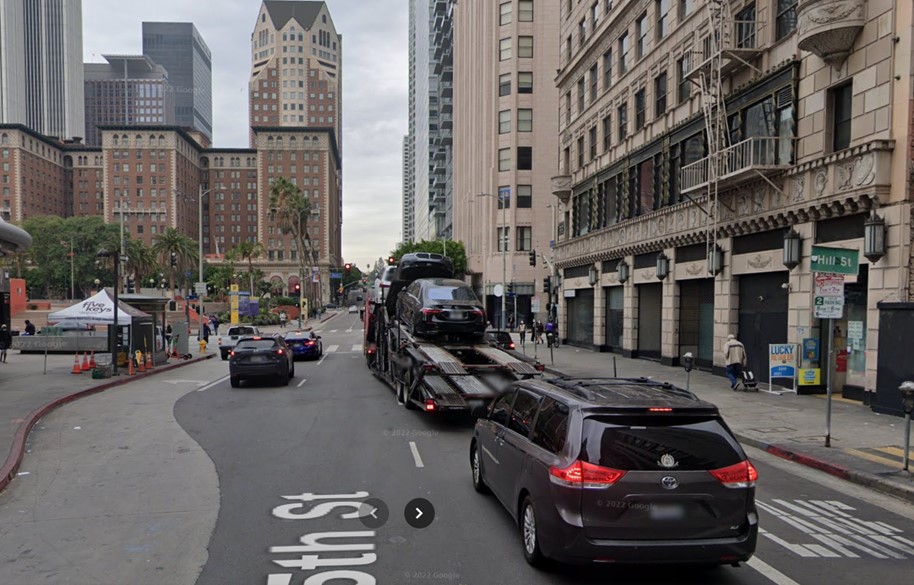 |
|
| (2021)* - Looking west on 5th Street toward Hill Street. |
Then and Now
Then_and_Now.jpg) |
|
| (1905 vs 2021)* - Looking west on 5th Street toward Hill Street. |
Hill and 5th Street
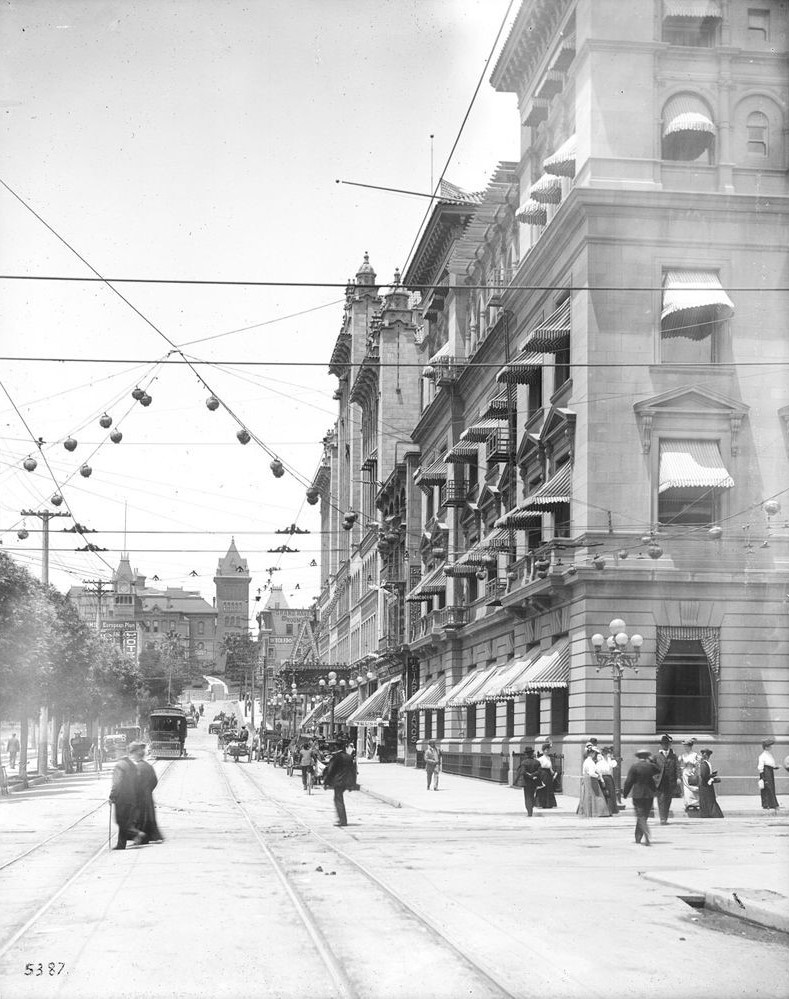 |
|
| (ca. 1910)* - Looking west on 5th Street at Hill Street in downtown Los Angeles. On the left is Central Park, renamed Pershing Square in 1918. In the distance the building with the tower is the State Normal School at Grand Avenue, where 5th Street originally dead-ended. After the State Normal School was demolished in 1924, 5th Street would be straightened and extended past Grand Avenue. The remaining school site became the location of the L.A. Central Library, which would be built in 1925. The building on the right with the awnings is the California Club. |
Historical Notes Note the beautiful ornate streetlight seen on the NW corner. These types of five-globe streetlights were originally installed on most streets in Downtown Los Angeles in the early 1900s, (except for Broadway which had the seven-globe lights). This particularly ornate model (called "Winslow") seemed to be limited to Hill Street and the streets adjacent to Pershing Square: the one block segments of 5th, Olive, and 6th. Today, the last of these poles are still being used as architectural features in the gardens and malls adjacent to City Hall. Click HERE to see more. |
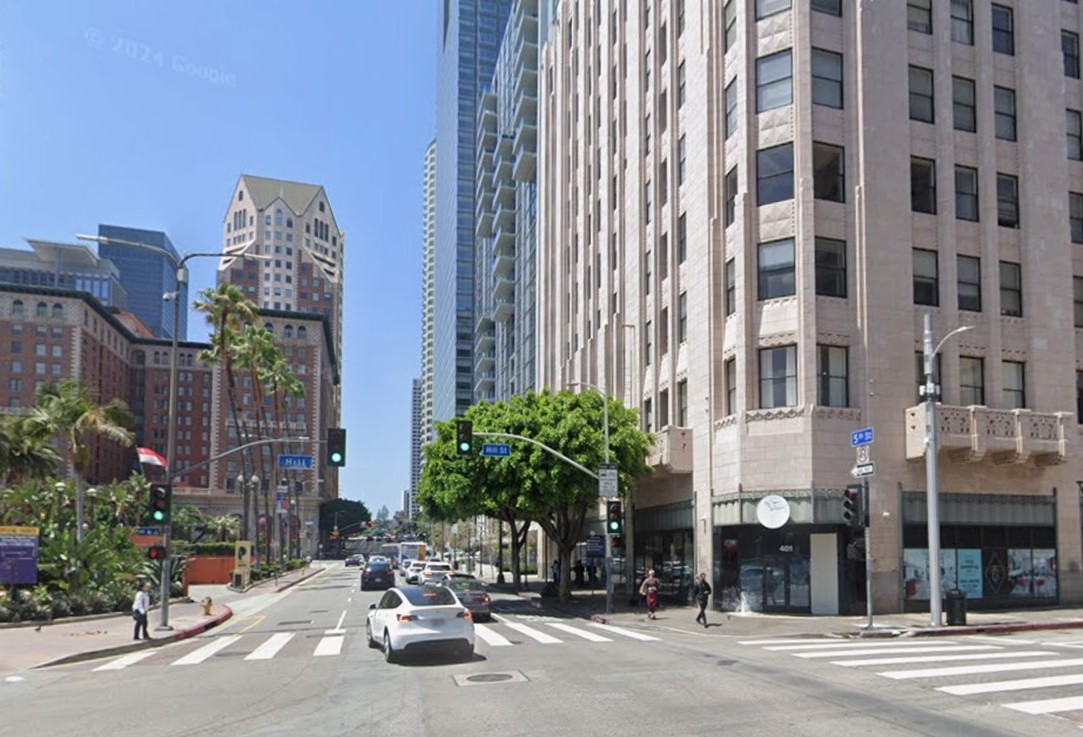 |
|
| (2024)* - Looking west on 5th Street at Hill Street with Pershing Square on the left. The Biltmore Hotel can be seen further back on the left. |
Then and Now
.jpg) |
|
| (1910 vs 2024)* - Looking west on 5th Street at Hill Street with Central Park (now Pershing Square) on the left. |
Historical Notes The following is a chronology of name changes the park has seen before becoming Pershing Square: ◆ 1866 – La Plaza Abaja or "The Lower Plaza" ◆ 1867 – St. Vincent Park ◆ 1870 – Los Angeles Park ◆ 1886 – 6th Street Park ◆ 1890s- Central Park ◆ 1918 – Pershing Square |
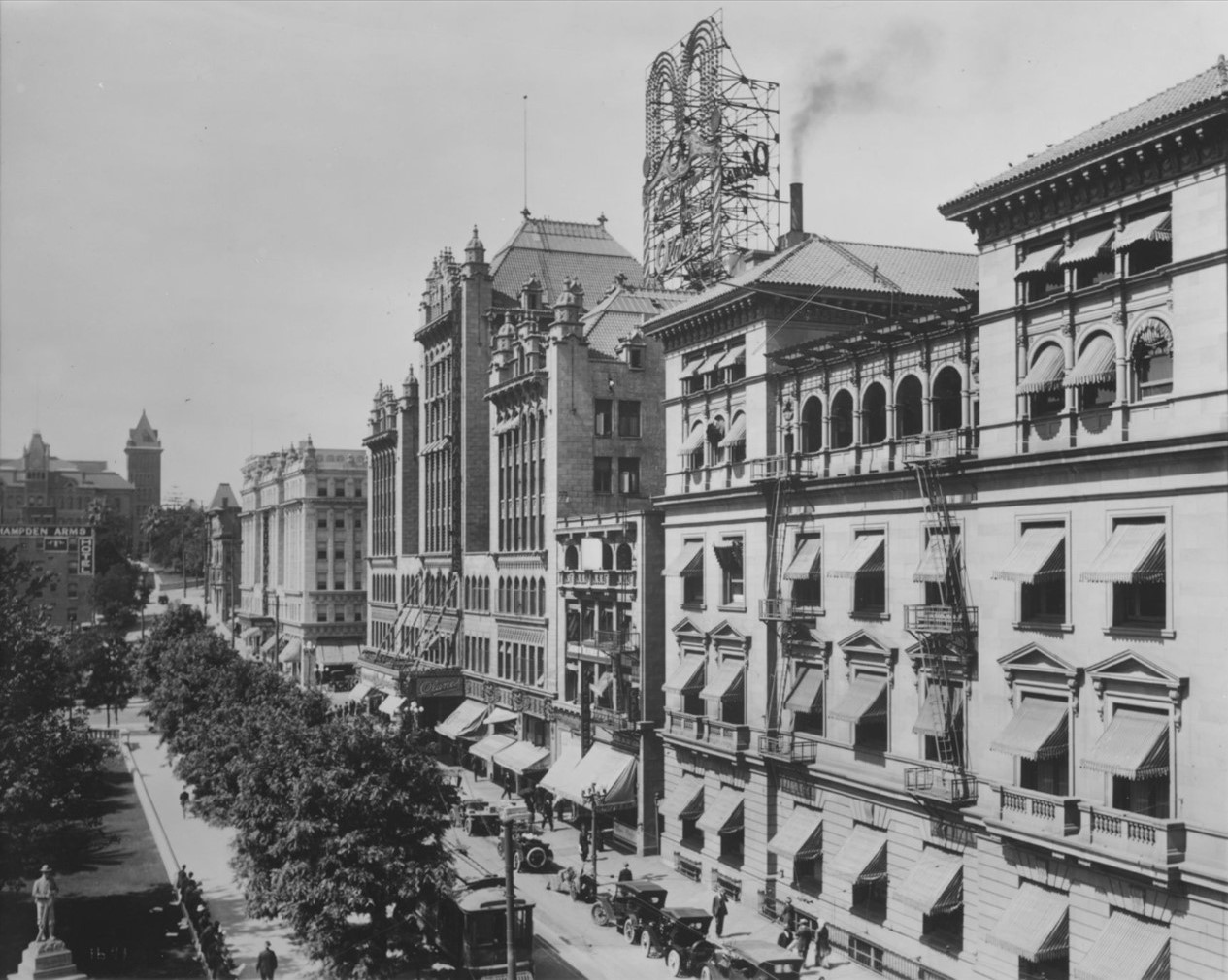 |
|
| (1915)* - Looking west on 5th Street toward Olive Street, with Central Park (later named Pershing Square) on the left. The famous Spanish-American War Soldier’s Monument stands at the lower-left corner of the park. This area was one of Los Angeles’ cultural and social hubs in the early 1900s. Several prominent buildings stand out, especially the Gothic-style Temple Auditorium (known at the time as Clune's Auditorium) with its oversized rooftop neon sign located on the northwest corner of 5th and Olive Street, and the California Club seen on the right on the northwest corner of 5th and Hill Street. |
Historical Notes The ornate theater, initially named Temple Auditorium, opened on November 7, 1906, with a performance of "Aida." Designed by Charles E. Whittlesey, it was the world's largest reinforced concrete structure at the time, featuring an Art Nouveau interior, a Spanish Gothic exterior, 2,700 seats, and the largest stage in the western U.S. In 1914, impresario William "Billy" Clune leased and transformed it into Clune's Auditorium, a pioneering movie palace known for elaborate prologues with music and dancers. Notably, it hosted the premiere of D.W. Griffith's "Birth of a Nation," with a full orchestra. Note: The Spanish-American War Soldier's Monument is still located in Pershing Square today. The monument, also known as the 7th Regiment Monument, remains the oldest piece of public art in the city and has been designated as Cultural-Heritage Monument No. 480 by the Los Angeles Cultural Heritage Commission. |
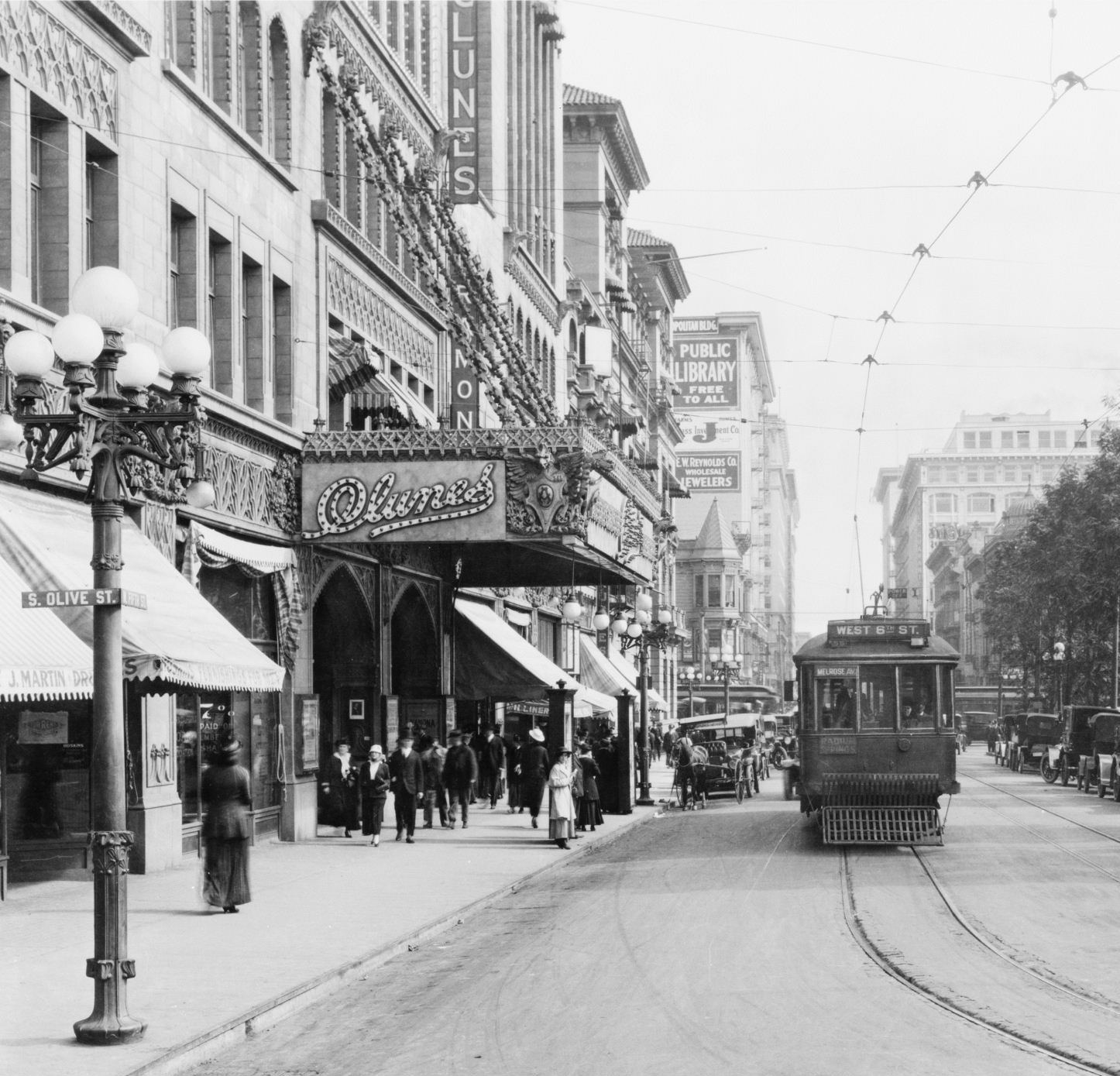 |
|
| (1914)* - View looking east on 5th Street at Olive Street, with Clune’s Theatre Auditorium on the left and Central Park (later named Pershing Square) across the street on the right. A horse-drawn carriage is parked by the curb while a streetcar is in the middle of the road. |
Historical Notes The Los Angeles Railway operated an extensive network of streetcars in the downtown area, including along 5th Street near what would become Pershing Square, during the period around 1914. |
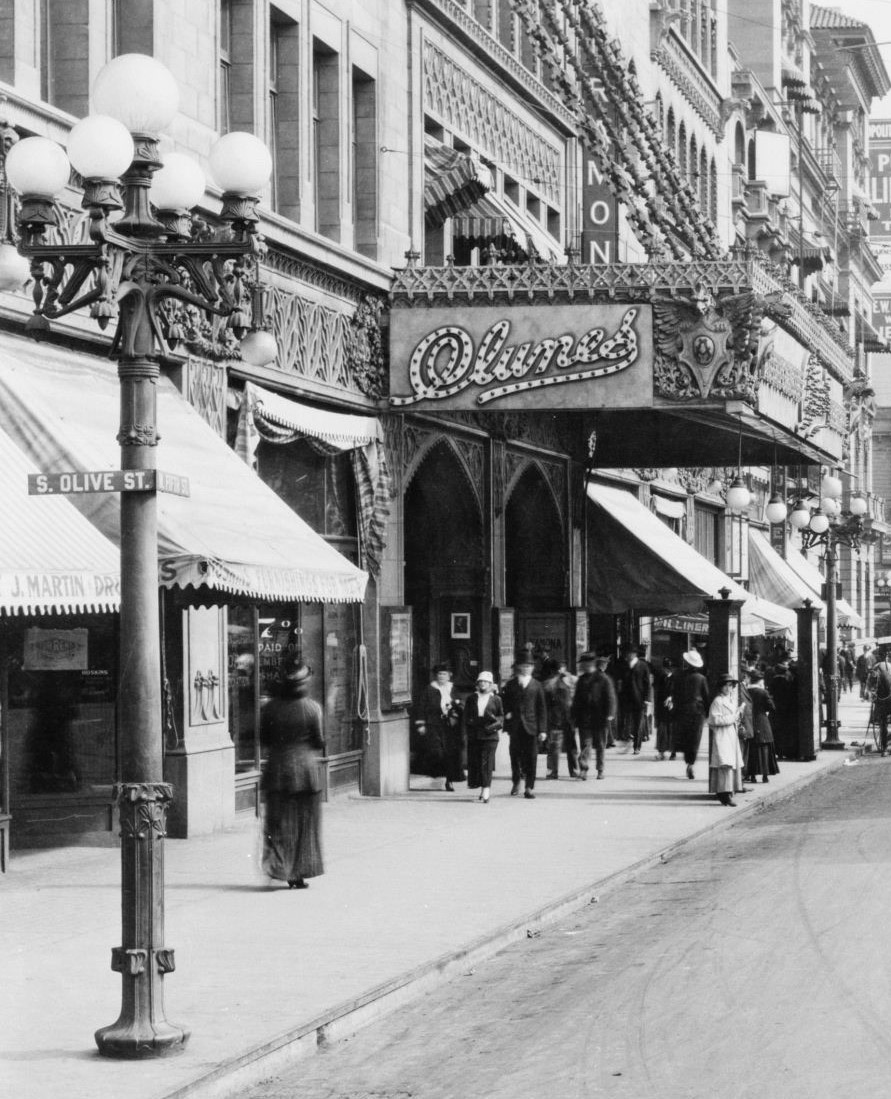 |
|
| (1914)* - A close-up view showing the details of both the Clune’s Theatre marquee and the ornate 5-lamp streetlight on the northeast corner of 5th and Olive Street. This beautiful streetlight, also known as 'Winslow,' added a certain charm to the downtown area. |
Historical Notes Note the details on the ornate streetlight on the corner, also known as the 'Winslow' electrolier. It was manufactured by the Llewellyn Iron Works, founded in 1889, which was one of the largest metalworking facilities in Los Angeles at the time. Click HERE to see more early views of 5-globe Llewellyn 'Winslow' Electroliers. |
Hill and 5th Street (Northwest Corner)
 |
|
| (1904)* - View of the California Club Building on the corner of 5th and Hill streets. A group of ladies are seen on the corner (lower-left) waiting to cross the street. |
Historical Notes The California Club is a private social club established in 1888 in downtown Los Angeles, the oldest such club in Southern California. The club's first location was in the second-floor rooms over the Tally-Ho Stables on the northwest corner of First and Fort (Broadway) streets, where the Los Angeles County Law Library now stands. It moved to the Wilcox Building on the southeast corner of Second and Spring streets in 1895, occupying the two top floors, the fourth and fifth. The building was distinguished as the first in Los Angeles to have two elevators — one for the public and the other for members. The men's dining room, reading room, bar and lounge were on the top floor. On the floor below was the ladies' dining room. The club remained at the Wilcox Building for ten years, Increased membership impelled the club to seek a new location in the southward and westward direction of the expansion of the city. In 1904 the club's headquarters were moved to a new five-story building with a basement and a roof garden on the northwest corner of Fifth and Hill streets. Beginning in the 1920s, blacks, Jews and women were barred from membership. Finally in 1987 the city of Los Angeles made discriminatory clubs illegal. Some members of the California Club then sought to maintain discriminatory membership policies, but their efforts were defeated by a majority of the members. Indeed, in the vote taken in June 1987, 90 percent of the voting members favored admitting women.* |
.jpg) |
|
| (2023)* - Looking at the NW corner of Hill and 5th streets. |
Then and Now
 |
|
| (1904 vs 2023)* - Looking at the NW corner of Hill and 5th streets. |
* * * * * |
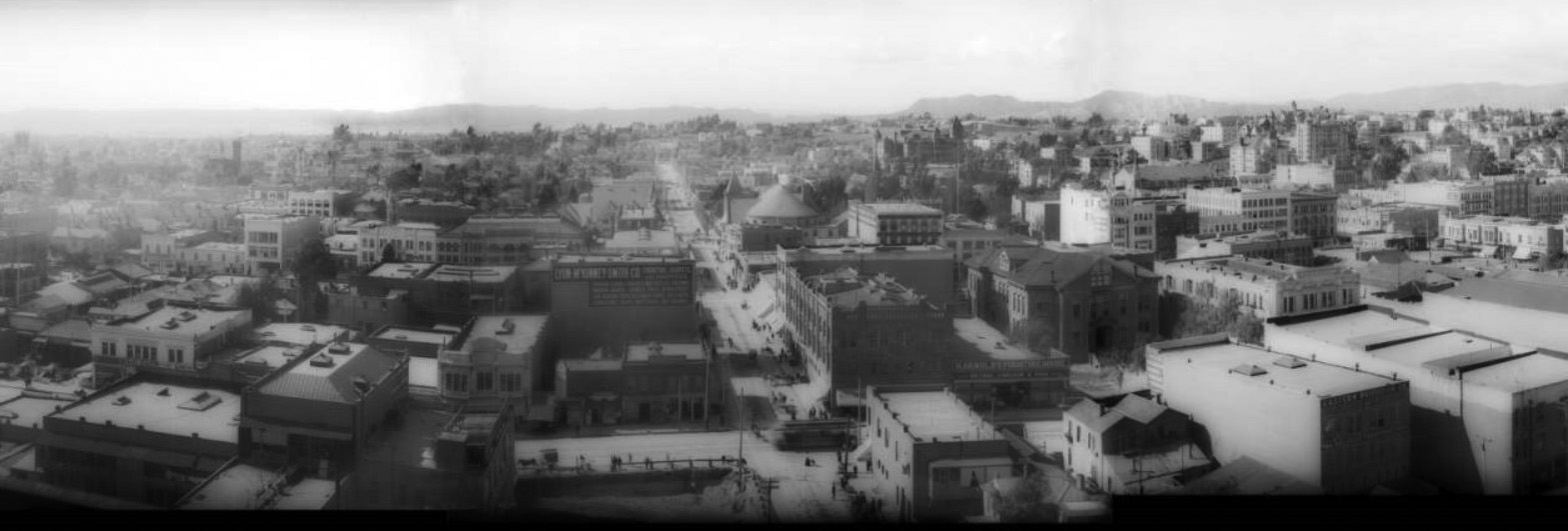 |
|
| (1904)^^ - Panoramic view of downtown Los Angeles, looking west on 6th street from the top of the still under construction Pacific Electric Building (6th Street & Main Street). |
Historical Notes The city is thriving with multi-storied commercial and residential buildings. Both, the large two-story mansion-style Spring Street School next to the H. Arnold Furniture Store building and the California State Normal School can be seen. Prominent buildings or landmarks include: Pershing Square (center right), Saint Paul's Episcopal Church, State Normal School (upper center) and the Metropolitan Building (still under construction -- behind the Los Angeles Examiner building). Mountains are visible in the distance: the Santa Monica Mountains to the left; the Hollywood Hills, center right; and a mix of the Verdugo and San Gabriel Mountains to the right. |
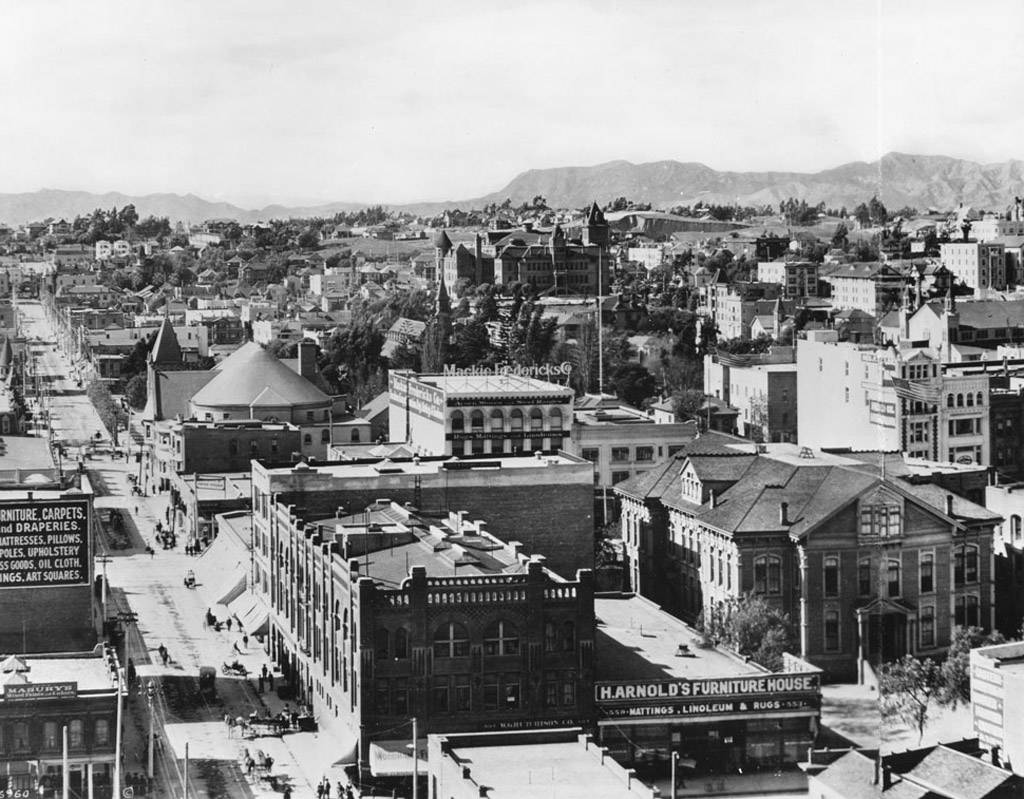 |
|
| (ca. 1904)^^ - View of Sixth Street looking west from Spring Street. The Hollywood hills can be seen in the distance. The large structure on the hill in the background (top-center) is the California State Normal School. The building at center-left with the conical-style roof is the First Methodist Episcopal Church. It's located on the NE corner of 6th and Hill, across the street from Central Park (later Pershing Square). |
Historical Notes Sixth Street stands to the left, stretching towards the horizon from the bottom of the photo, populated with pedestrians and horse-drawn carriages. Tall two- to four-story victorian-style business buildings line it to the left and right. To the extreme right, the large, two-story mansion-style Spring Street School can be seen next to the H. Arnold Furniture House that advertises "Mattings, Linoleum & Rugs". Mountains (Hollywood HIlls) are visible in the background. The California State Normal School is the largest structure in the background.^^ |
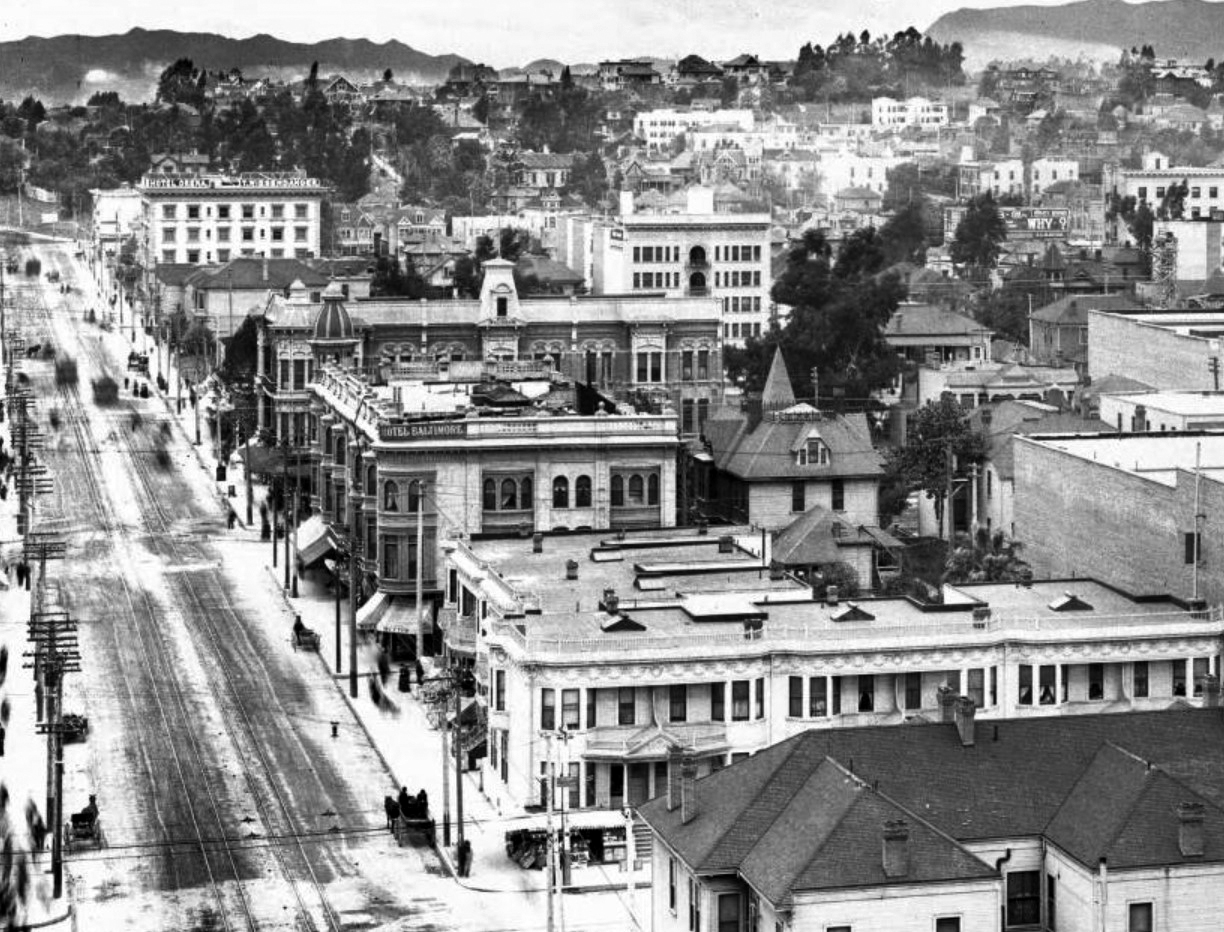 |
|
| (ca. 1905)^^ – View looking west on 7th Street from the Lankershim Hotel (SE corner of 7th at Broadway. The Hotel Baltimore (NE corner of 7th and Olive) can be seen at center-left. |
Pacific Electric Building
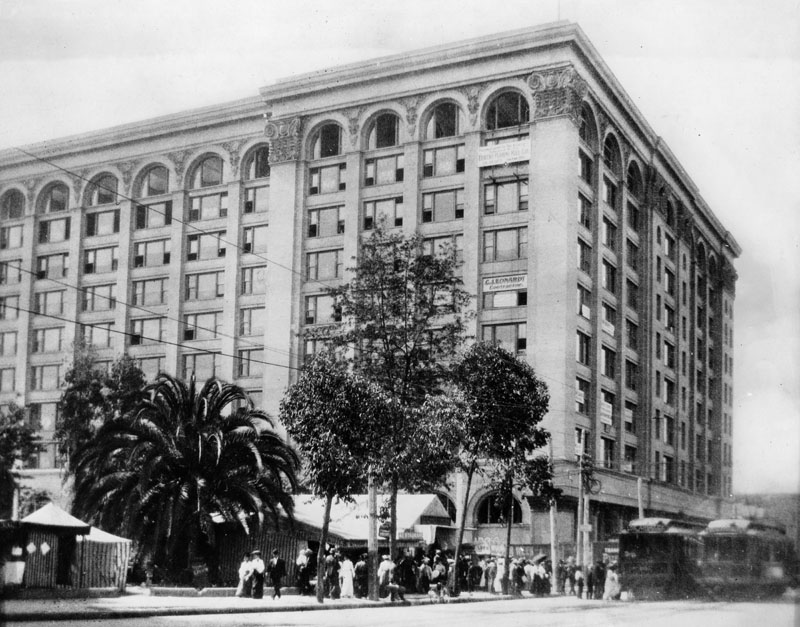 |
|
| (1905)^ - View of the Pacific Electric Railway building on Main and Sixth Streets, which housed the ticket office. Passengers are seen in line waiting to board the PE electric streetcars. |
Historical Notes The historic Pacific Electric Building (also known as the Huntington Building, after the Pacific Electric founder and developer, Henry Huntington) opened in 1905 as the terminal for the Pacific Electric Red Car Lines running east and south of downtown Los Angeles, as well as the company's main headquarters building. It was designed by architect Thornton Fitzhugh. Though not the first modern building in Los Angeles, nor the tallest, its large footprint and ten-floor height made it the largest building in floor area west of Chicago for several decades. Above the main floor terminal were five floors of offices and, on the top three floors, the Jonathan Club, one of the city's leading businessmen's clubs. The club moved to its own building on Figueroa Street in 1925.*^ |
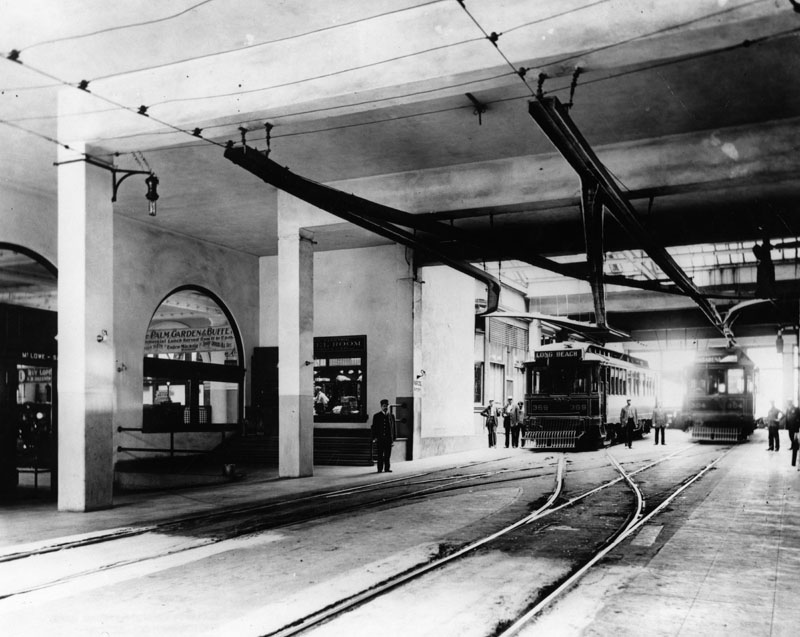 |
|
| (ca. 1905)^ - Interior view of the Pacific Electric Building, the main streetcar station located on Main and 6th streets. Two streetcars, one bound for Long Beach, the other for Pasadena, are seen surrounded by several conductors. The Palm Garden & Buffet, a small lunch counter managed by Eugen Mächtig, is visible on the left. Another business, perhaps a men's clothier, is also present in the building. One sign on the far left reads "Mt. Lowe", once a popular mountain destination for Pacific Electric customer (Click HERE to see more in Early Views of Mt. Lowe Railway). |
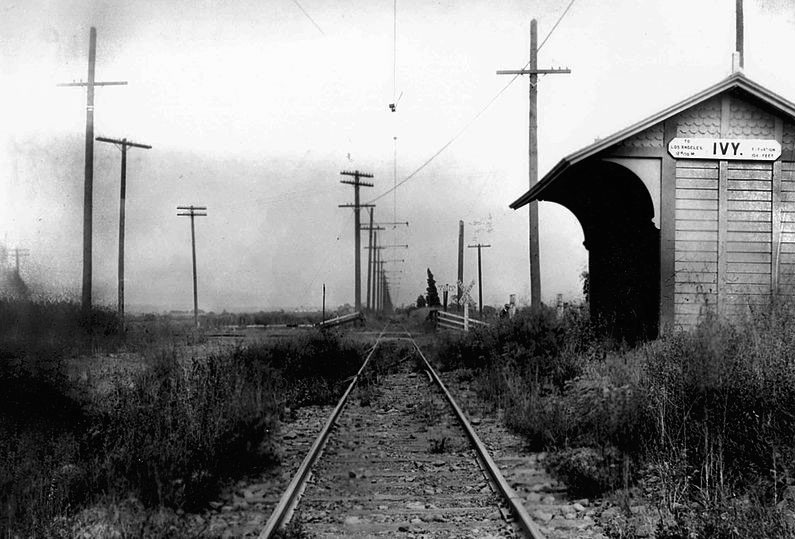 |
|
| (ca. 1905)^## - Westbound view of "Ivy Station" at the current location of the Culver City station of Los Angeles Metro's Exposition light rail line. |
Historical Notes Named after the Ivy Park housing development, the Ivy station stop along the Santa Monica Air Line served present-day Culver City. Located near the corner of Venice and Robertson Boulevards, the Ivy Station was later renamed Culver Junction. It eventually closed in 1953.^## |
* * * * * |
Venice of America
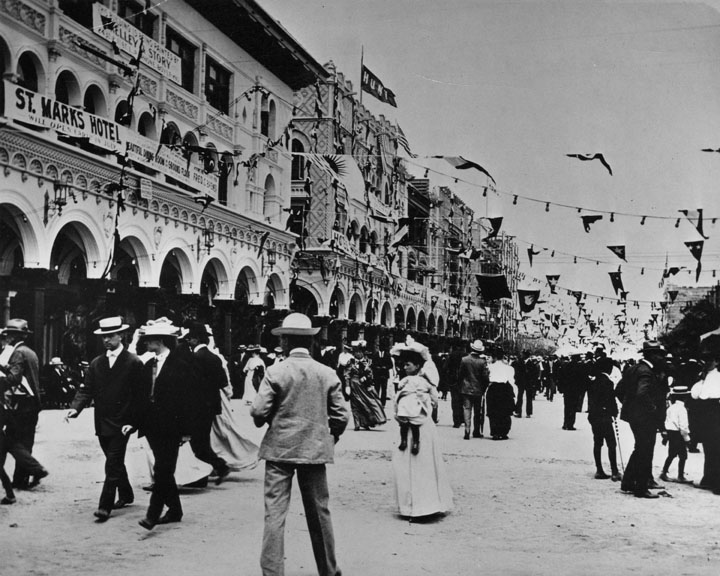 |
|
| (1905)* - The street is filled with people strolling, and the air with banners strung from the Hunt Hotel on the left. A banner on the building to the near left declares that "St. Mark's Hotel will open in early July". This was the grand opening celebration for Venice of America, July 4, 1905. Click HERE to see more in Early Southern California Amusement Parks. |
Historical Notes In 1891 Abbot Kinney built the resort of Ocean Park, which became the center of his coastal amusement paradise, Venice of America. Easily accessible by streetcar from both Santa Monica and Los Angeles, Venice, which opened in 1905, included canals, gondolas and gondoliers, Venetian-style buildings, an amusement pier, a dancehall and an auditorium. Kinney inherited his father's tobacco business and made a substantial fortune manufacturing Sweet Caporal cigarettes.* |
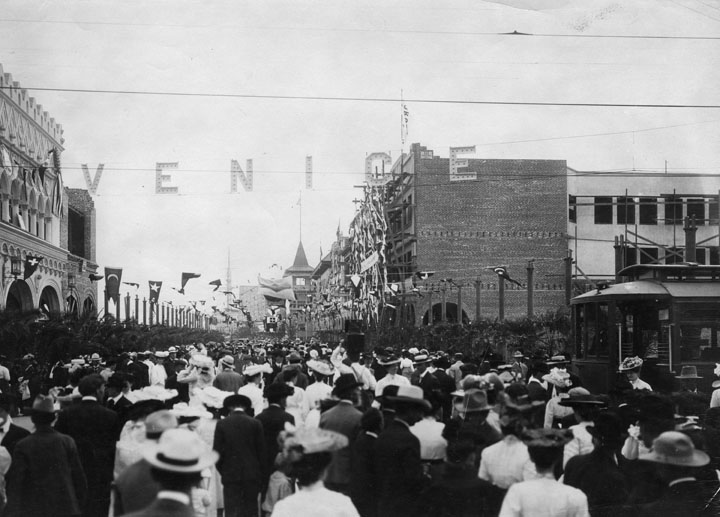 |
|
| (ca. 1905)^ - There are wall to wall people filling Windward Ave. in Venice of America, all looking and moving toward the ocean. "VENICE" is strung above their heads over the street in large letters. |
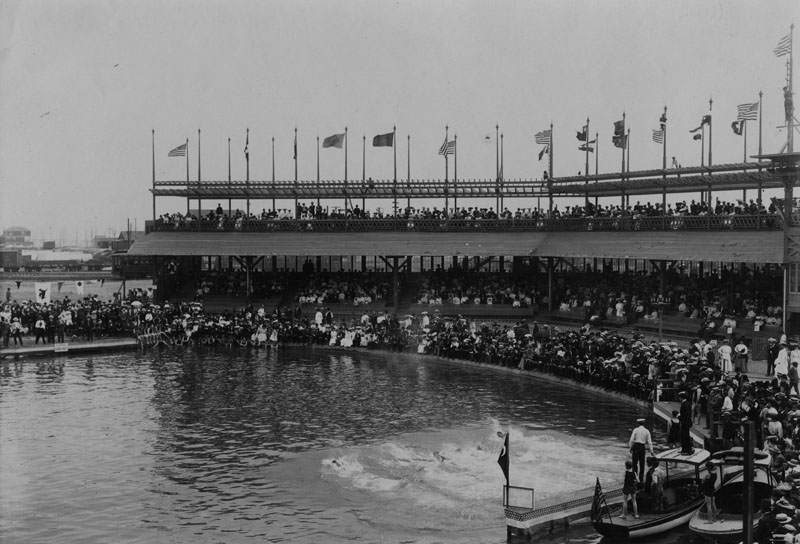 |
|
| (1905)^ - Swimming race at Venice of America. A large crowd is present in the amphitheater at Venice near Los Angeles to view the swimming races on July 4th. Here the 50 yard race has just begun. |
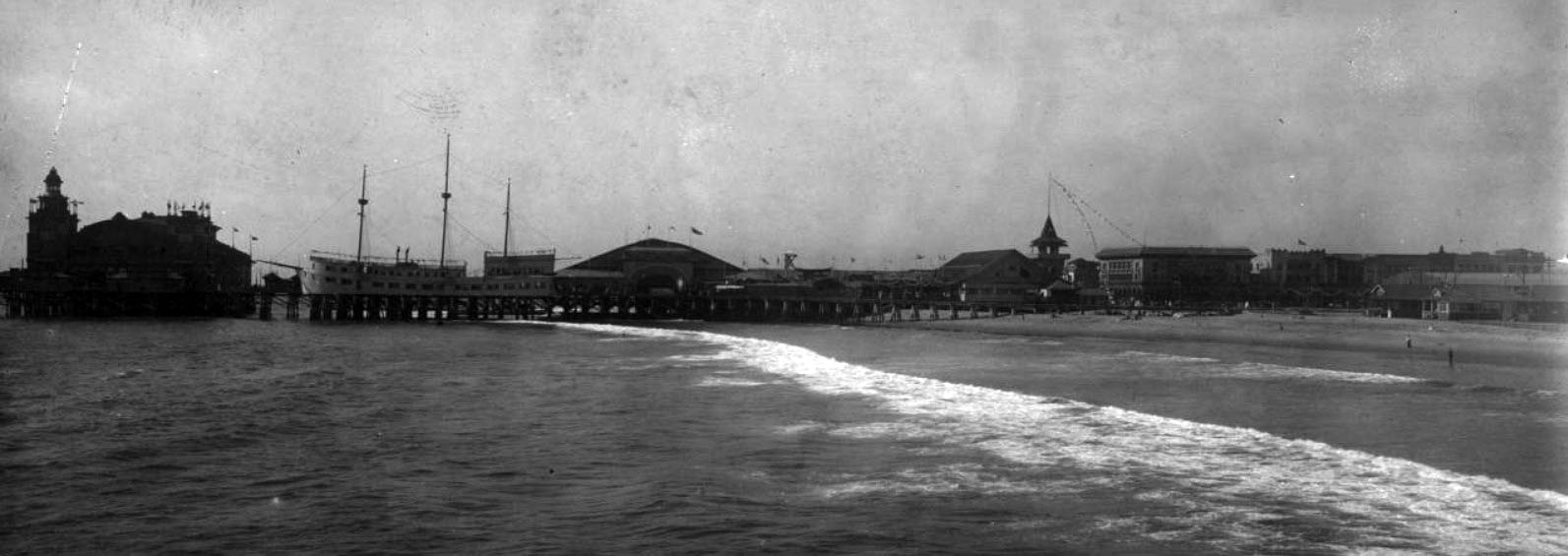 |
|
| (ca. 1905)^^ - Panoramic view looking north at the Pier at Venice Beach showing the amusement park and beach. The Ship Cafe is seen on the left. |
Historical Notes Among the South Bay piers, the most notable in this period was Abbot Kinney's Venice of America pier, started in 1904 and built to rival his former partner's Ocean Park Pier. Located at the end of Windward Avenue in Venice, Kinney's pier was 900 feet long, 30 feet wide and included an Auditorium, large replica Ship Cafe, Dance Hall, Dentzel carousel, a Japanese Tea House and an Ocean Inn Restaurant. Venice soon became considered its own neighborhood.*^ |
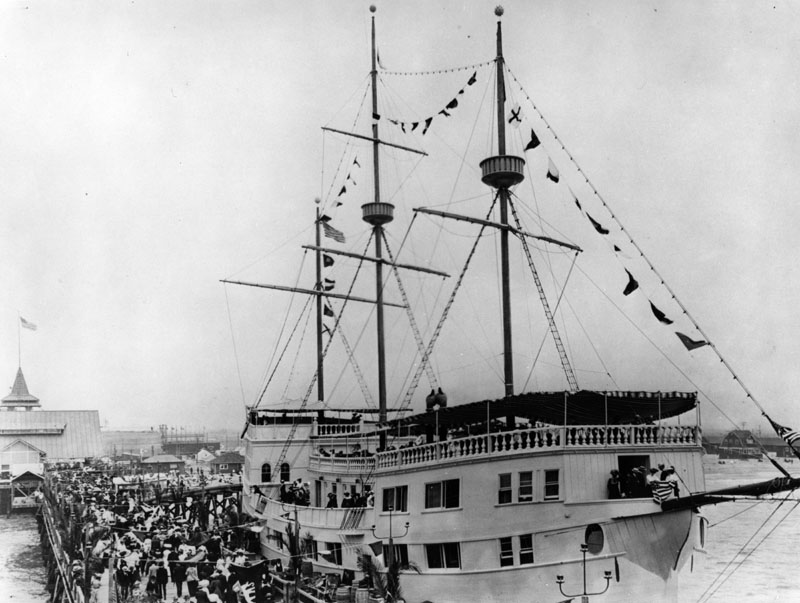 |
|
| (1905)^ - A big crowd is seen behind the large restaurant ship which was a replica of Juan Cabrillo's Spanish galleon. People can also be seen aboard the ship which was located in Venice at the Abbot Kinney Pier. |
Historical Notes Venice of America was founded by tobacco millionaire Abbot Kinney in 1905 as a beach resort town. He and his partner Francis Ryan had bought two miles of oceanfront property south of Santa Monica in 1891. They built a resort town on the north end of the property called Ocean Park, which was soon annexed to Santa Monica. After Ryan died, Kinney and his new partners continued building south of Navy Street in the unincorporated territory. After the partnership dissolved in 1904, Kinney built on the marshy land on the south end of the property, intending to create a seaside resort like its namesake in Italy.*^ |
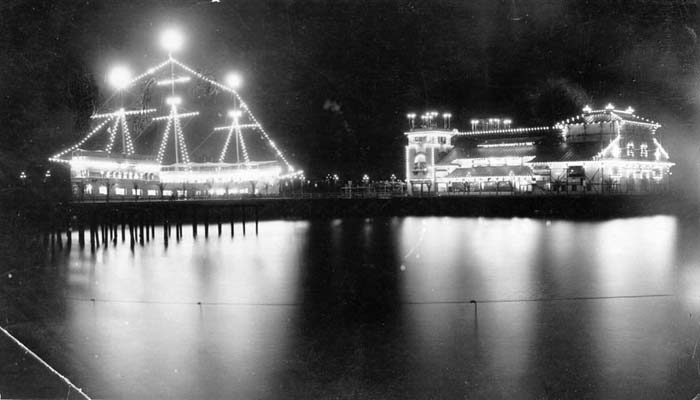 |
|
| (1905)^ - Nigthtime view of Abbott Kinney's Pier in Venice. The pier was destroyed by fire in 1920. |
Historical Notes When Venice of America opened on July 4, 1905, Kinney had dug several miles of canals to drain the marshes for his residential area, built a 1,200-foot long pleasure pier with an auditorium, ship restaurant, and dance hall, constructed a hot salt-water plunge, and built a block-long arcaded business street with Venetian architecture. Tourists, mostly arriving on the "Red Cars" of the Pacific Electric Railway from Los Angeles and Santa Monica, then rode Venice's miniature railroad and gondolas to tour the town.*^ |
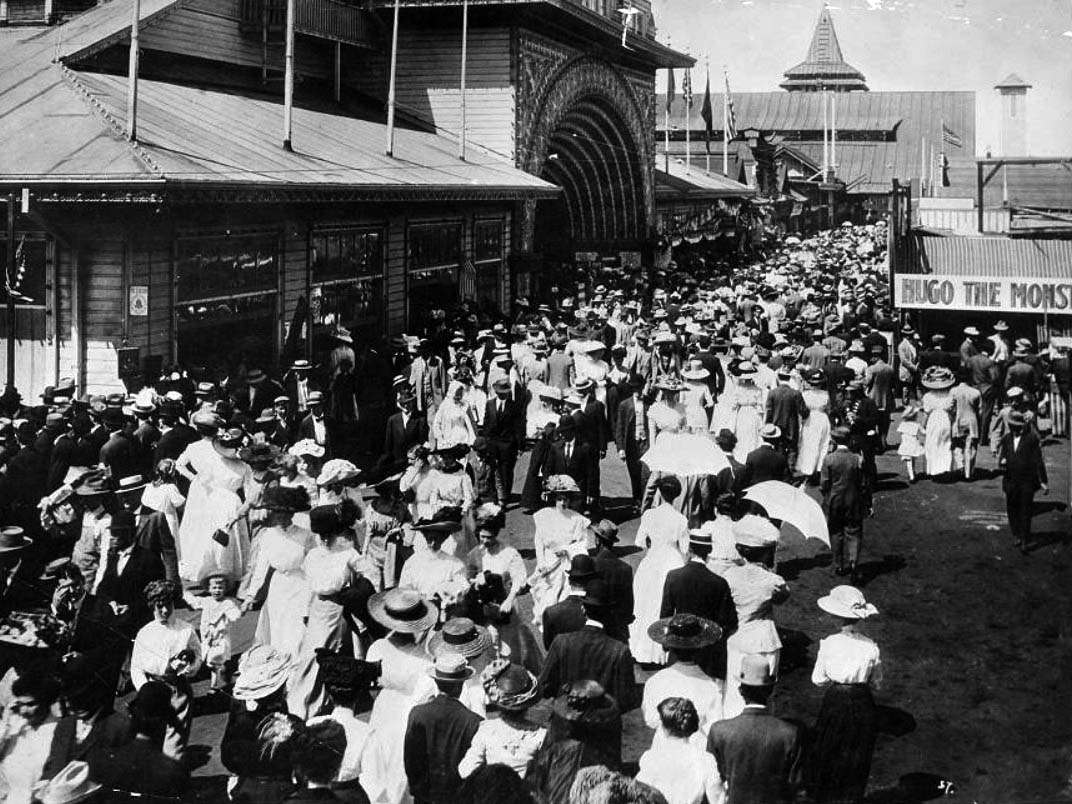 |
|
| (1908)^^ - Venice Pier on a crowded day with the Dance Hall seen in the background. |
* * * * * |
Naples Canals (Long Beach)
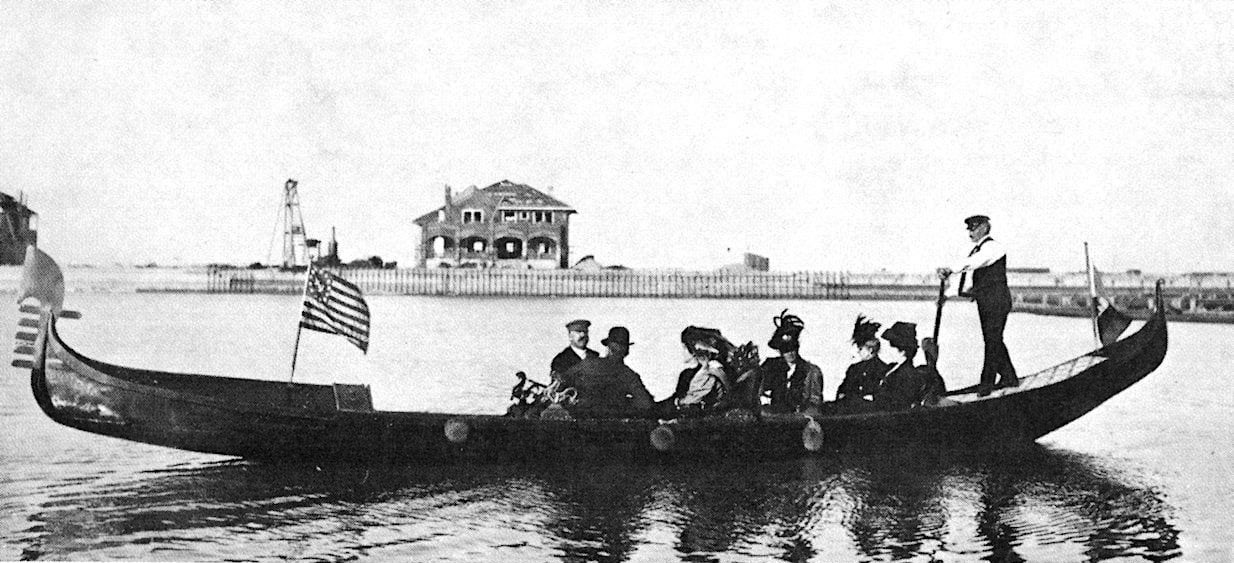 |
|
| (ca. 1905)* - A gondola carrying six passengers and a gondolier navigates the waterways of the canals in Naples, Long Beach. Note: this photo is often misidentified as the Venice Canals. |
Historical Notes In 1903, A.M. Parson and his son began plotting a path to build Naples into a resort village reminiscent of an Italian village. However, the area was considered a swampland known for flooding and was, therefore, difficult to build on. In an effort to showcase the beauty of the islands, Naples was one of the stops on the Triangle Trolley Trip excursion that began in Los Angeles. Passengers were transported by the Pacific Electric Red Trolley Cars to this small community of canals. |
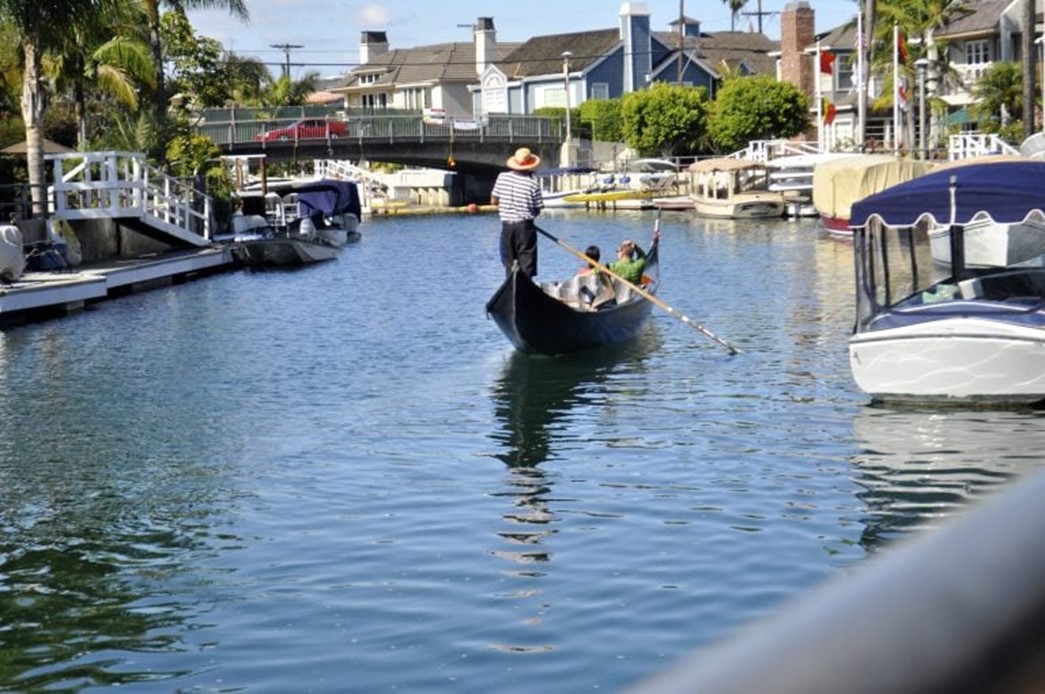 |
|
| (2016)* – Contemporary view of the canals adjacent to Naples Island in Long Beach. Photo courtesy of KW Coastal Properties |
Historical Notes Located between Belmont Shore and the Long Beach Marina are the islands that make Naples. The neighborhood consists of three islands along Alamitos Bay, which are divided by enticing canals that lead to the open bay. |
* * * * * |
Venice Canals
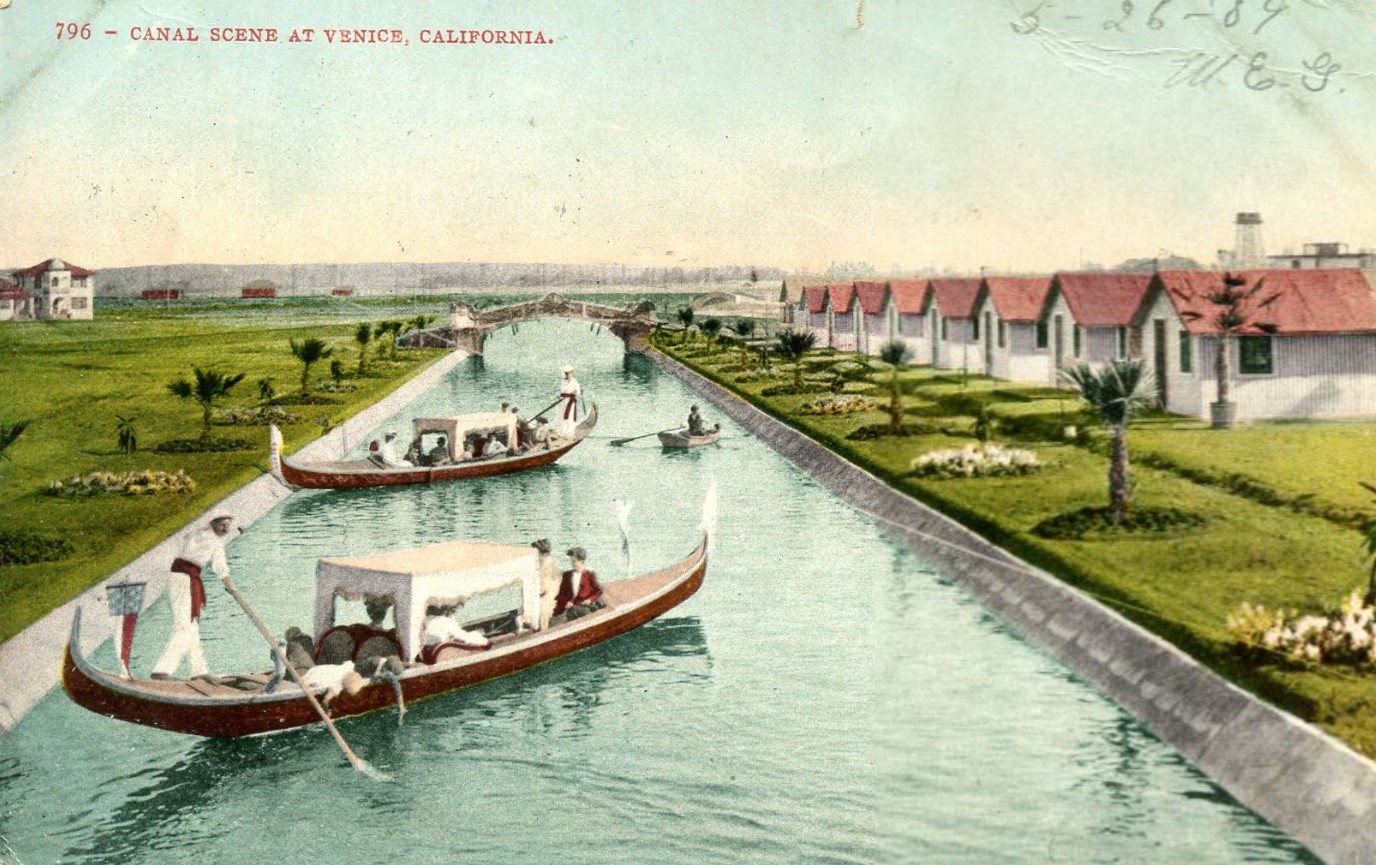 |
|
| (1909)* - This postcard depicts one of the canals built by Abbot Kinney in 1905 in Venice, California to replicated the feeling of Venice, Italy in Southern California. Complete with Venetian style buildings and gondolas (as seen here), Kinney's Venice of America opened on July 4, 1905. Written on back: "This little scene taken at one of our beaches is, of course, artificial that is - canals are cut to let in the ocean water. |
Historical Notes The Venice Canals were originally conceived by developer Abbot Kinney in 1905 as part of his vision to create a "Venice of America" in what is now the Venice neighborhood of Los Angeles. Inspired by the famous canals of Venice, Italy, Kinney aimed to recreate a romantic and picturesque waterfront community. |
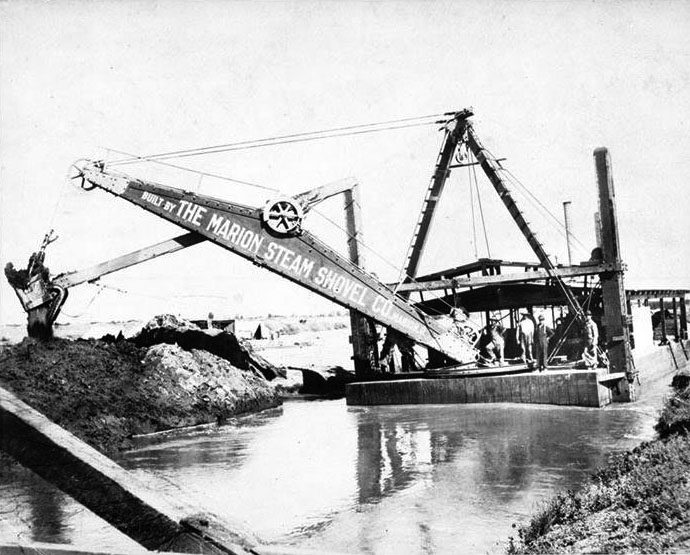 |
|
| (ca. 1904)^^ - View of canal dredging in Venice, showing a large steam shovel arm protruding from the bow of a barge. Several men are standing on the barge near the shovel arm. The arm reads "Built by the Marion Steam Shovel Co. Marion, O". |
Historical Notes Kinney dredged several miles of marshland to create the canals, which were accompanied by Italian-inspired bridges and walkways. Construction began in 1904, and by 1905, the first canals were completed. The area quickly became a popular tourist destination and residential area. |
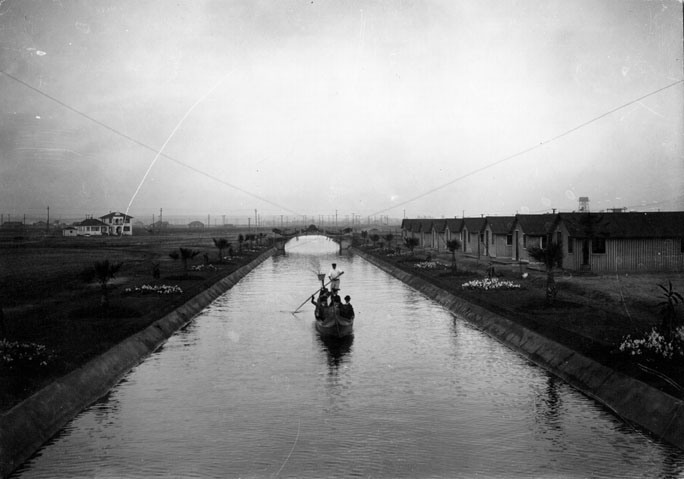 |
|
| (1905)^ - A boat glides along a canal in Venice, in 1905. Notice the newly planted palm trees along the sides of the canal, and bungalows are visible at right. The sky looks overcast. The oarsman is standing at back, and men with suits and hats are sitting together at front. |
Historical Notes The original Venice of America canals contributed to the success of Kinney's real estate development. Lots fronting the canals became a favorite choice for owners of the local amusement concerns or out-of-town tourists looking for a place to pitch a summer cottage. |
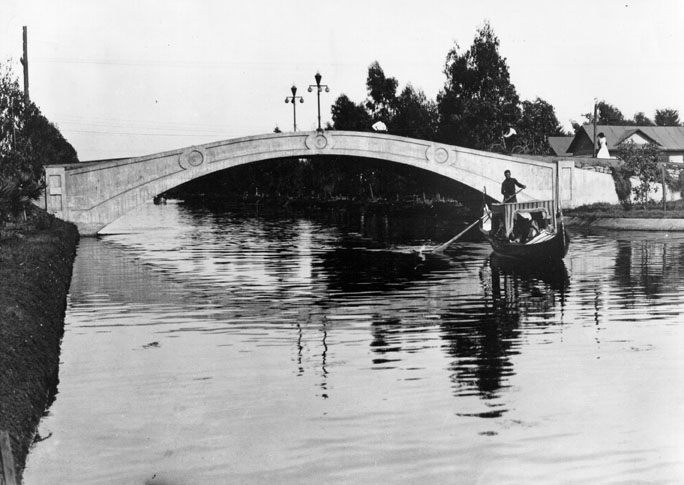 |
|
| (ca. 1905)^ - A gondolier and boat passes under one of the bridges on the canal route. At the same time a pedestrian and a bicycle rider are passing over the bridge. |
Historical Notes The beautifully lit canals with gondoliers and arched bridges drew widespread publicity and helped sell lots in Kinney’s Venice development. |
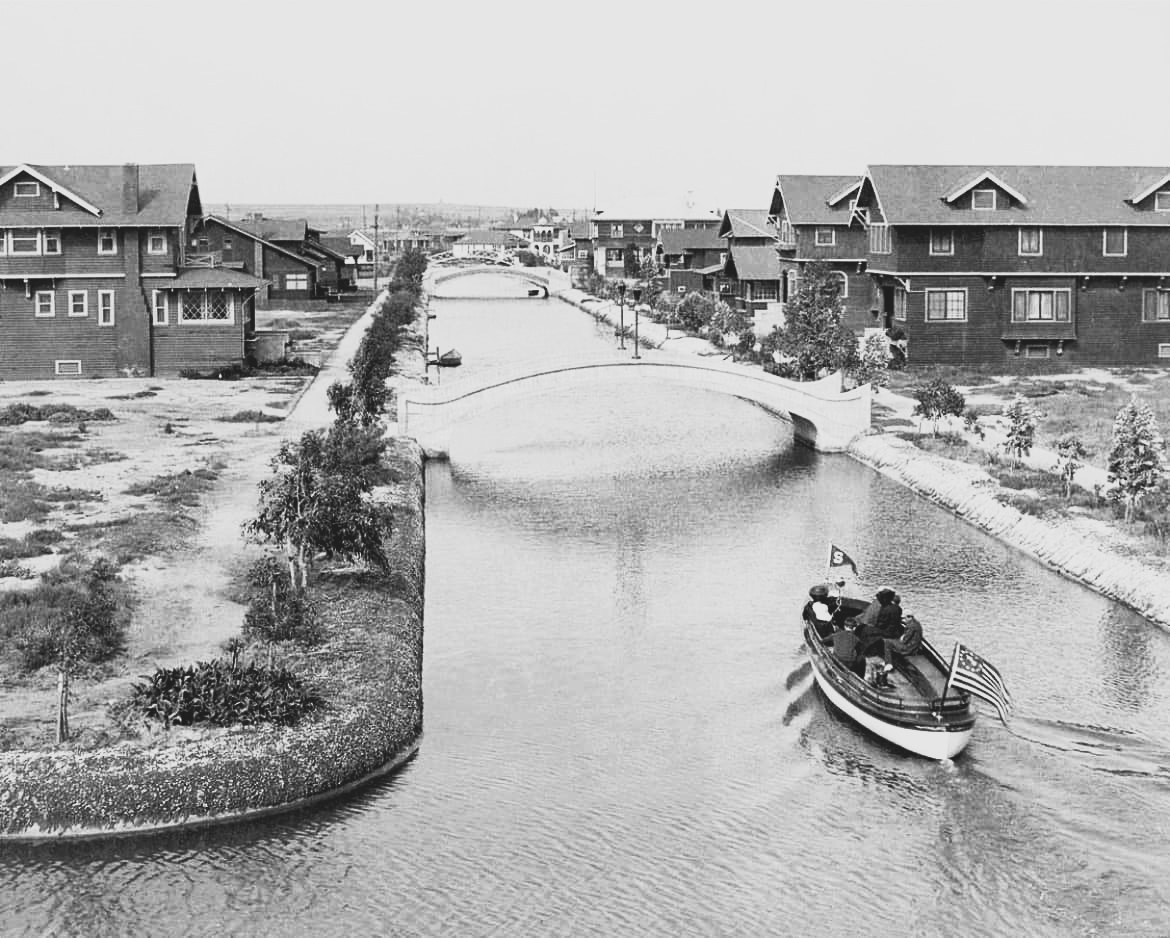 |
|
| (1911)* - A boat heads down the Aldebaran Canal. |
Historical Notes The Aldebaran Canal would later become Market Street after the canals were filled ca. 1929. |
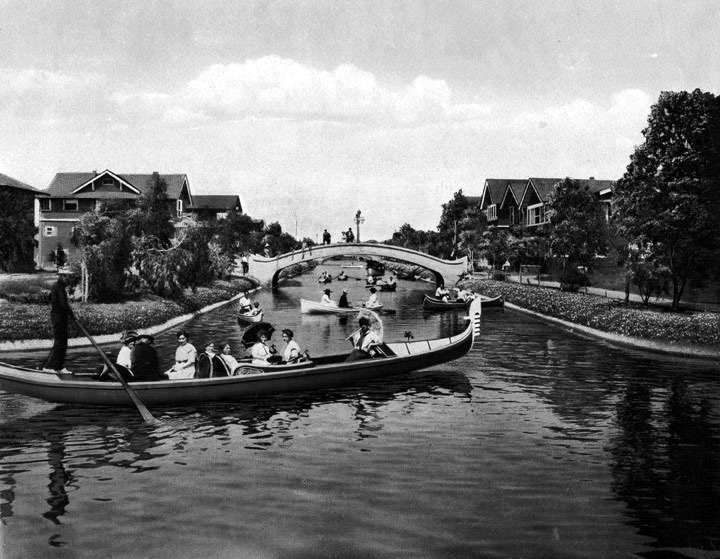 |
|
| (ca. 1909)^ – Postcard view showing gondoliers and row boats on the Aldebaran Canal. This would later become Market Street in Venice. |
Historical Notes As the automobile gained in popularity, the canals were viewed by many as outdated, and the bulk of the canals were filled in 1929 to create roads. |
 |
|
| (1924)^ - View showing a complex of rental bungalows known as United States Island. It was accessible only by the foot bridges seen on either side of it. In this view, looking north, Altair Canal is on the left and Cabrillo Canal on the right. |
Historical Notes When it opened on July 4, 1905, Venice of America boasted seven distinct canals arranged in an irregular grid pattern. Totaling nearly two miles and dredged out of former saltwater marshlands, the canals encircled four islands, including the tiny triangular United States Island. The widest of them, appropriately named Grand Canal, terminated at a large saltwater lagoon. Three of the smaller canals referred to celestial bodies: Aldebaran, Venus, and Altair. |
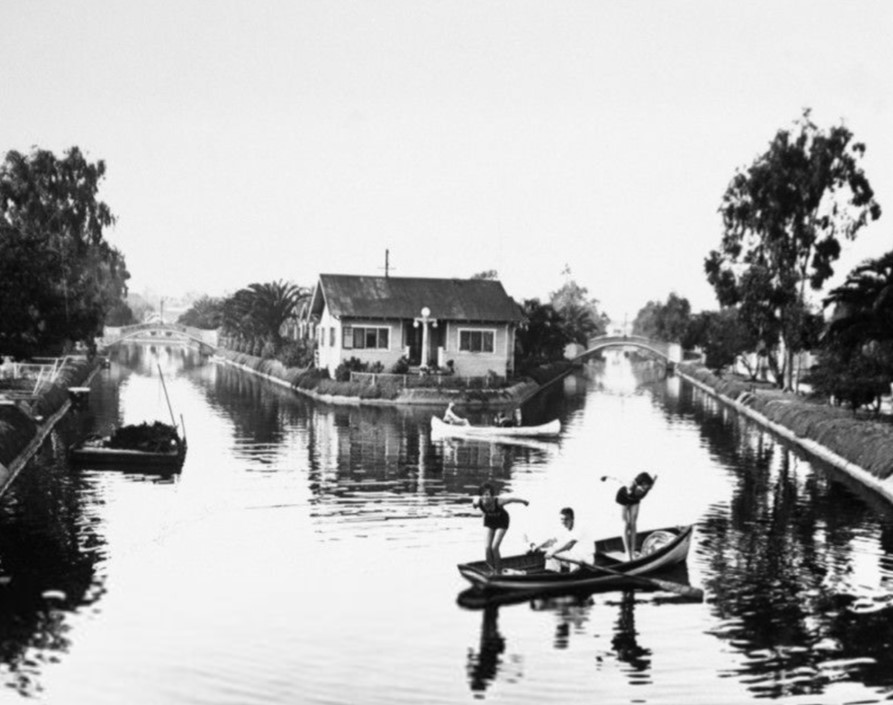 |
|
| (ca. 1924)* - Two young women preparing to dive into the water of the Venice Canals. In the background is a complex of rental bungalows on what was known as United States Island. It was accessible only by the foot bridges seen on either side of it. |
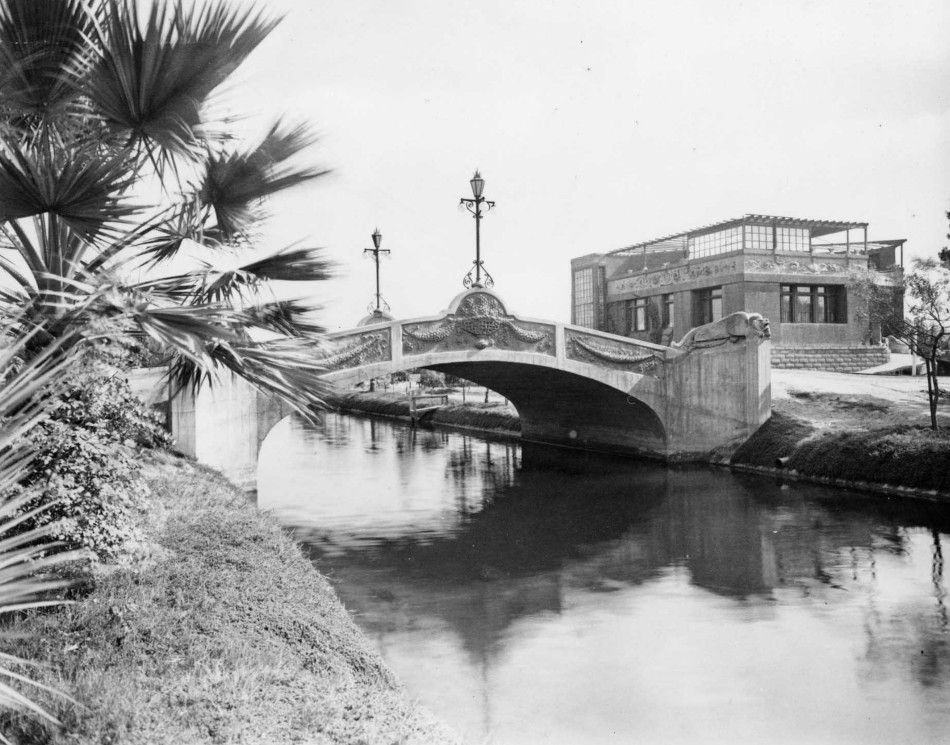 |
|
| (ca. 1920s)* - Lion Canal in Venice of America, part of Abbot Kinney's rich imagination and attention to detail. Note the majestic Lion resting on the bridge. |
Historical Notes Lion Canal, was renamed Windward, it stretched from the bathing lake, or lagoon past Saint Marks Island to Cabrillo Canal. |
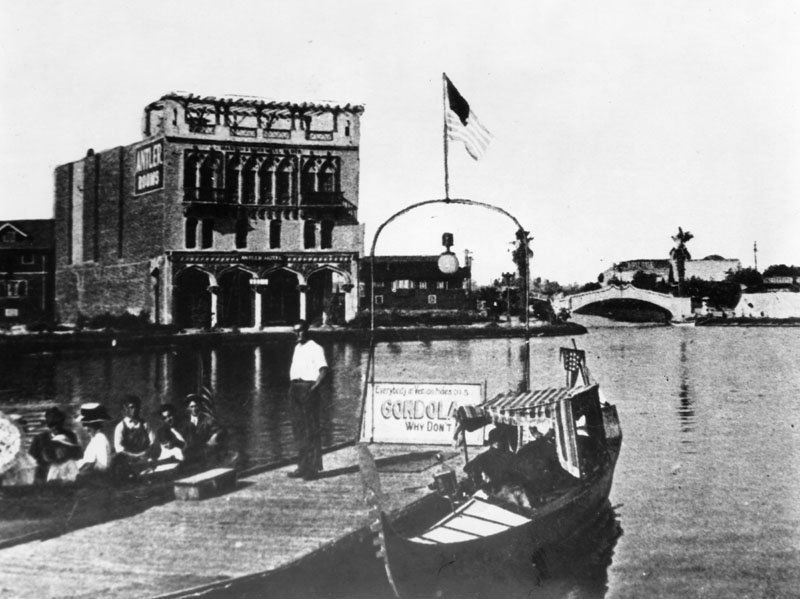 |
|
| (ca. 1905)^ - View of the Lagoon at Venice. Groups of people pay for a boat or a gondola ride on the canal. The Antler Hotel can be seen in the background to the left of the bridge over the canal. |
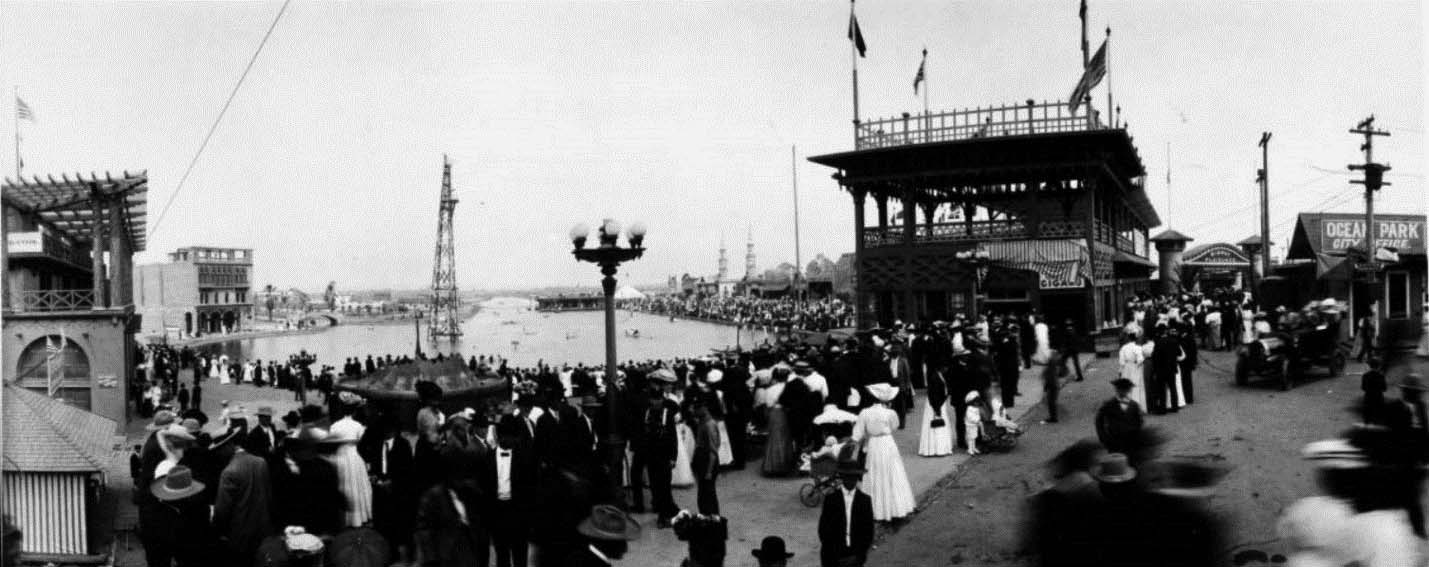 |
|
| (ca. 1910)* – View showing a crowd of people stretched from left to right between two pavilions at the Venice lagoon. The three story building in the distance (left) is the Antler Hotel. Next to it is a small bridge extending over a canal. At center, a Venice lagoon can be seen with a number of row-boats in it. What appears to be a watch tower stands in the middle of the lagoon. In the background, at center, another canal can be seen extending towards an extreme background. |
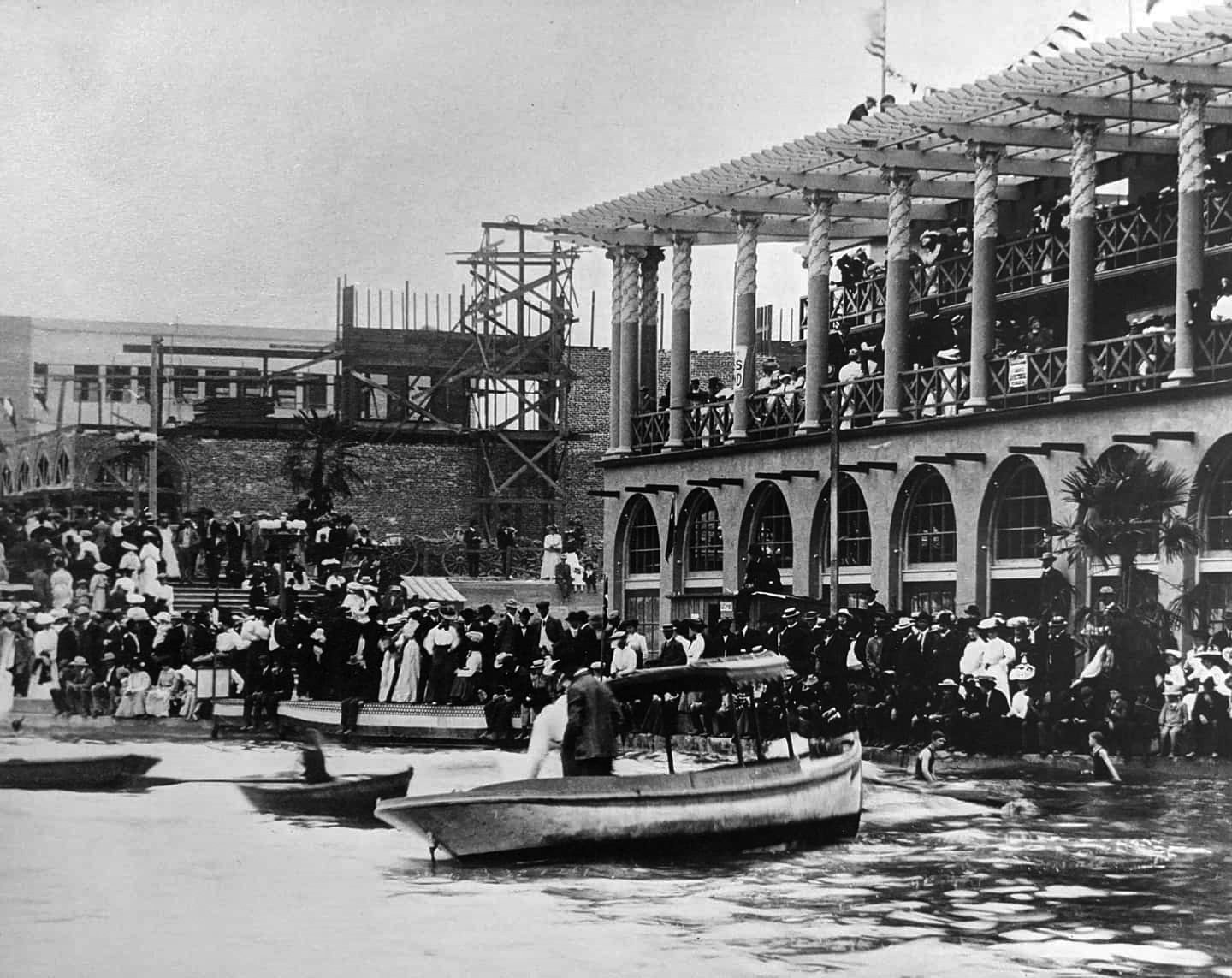 |
|
| (ca. 1910)* - Spectators watch what appears to be a row boat race in the Venice Lagoon. |
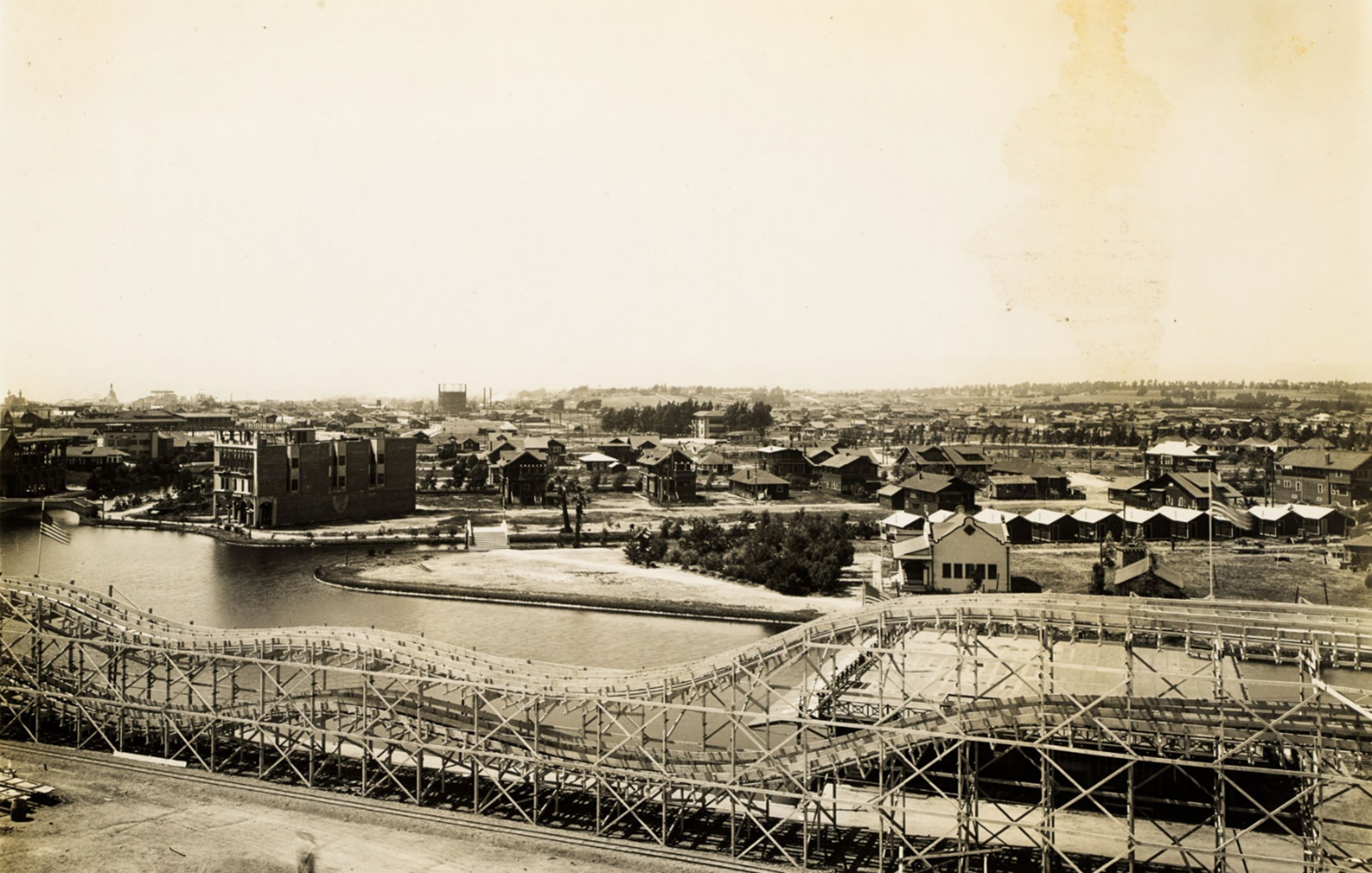 |
|
| (1910s)* - View of the Race Thru the Clouds racing roller coaster next to the Venice Lagoon in Venice, California. The Antler Hotel is visible on the left at the edge of the lagoon, with beach cottages, houses, and other buildings in the distance. Photo from the Ernest Marquez Collection. |
Historical Notes The "Race Thru the Clouds" was a prominent wooden roller coaster located at Venice Pier in Venice, California, during the 1910s. It was notable for being the first racing roller coaster on the West Coast and opened on July 4, 1911. The coaster was designed by John Miller, a renowned roller coaster designer, and was constructed by the Ingersoll Construction Company, with Thomas Prior and Frederick Church responsible for its operation and maintenance. The "Race Thru the Clouds" featured a twin-track design, allowing two coaster cars to race each other along parallel tracks. Each track was 4,000 feet long, and the coaster reached a height of 90 feet. This design provided a thrilling experience with numerous twists and turns, making it a popular attraction for visitors to Venice Beach. |
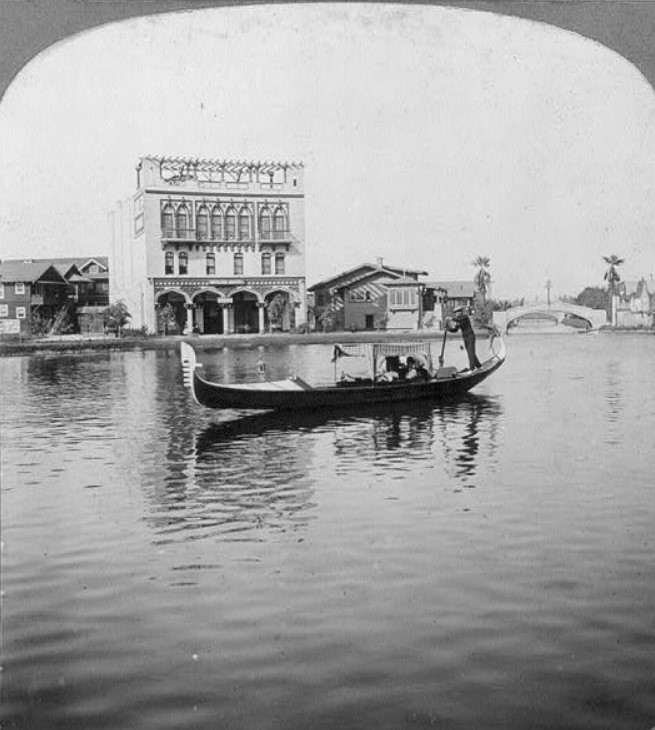 |
|
| (1913)* – Half of a stereoscopic image showing a gondola with a gondolier in the rear rowing on the Venice Lagoon. The Antler Hotel stands in the background. |
Historical Notes The Antler Hotel was a key landmark in Venice, California's early 20th-century "Venice of America" development, designed to mirror Venice, Italy, with canals and Venetian architecture. Located near the Venice Lagoon, the hotel was part of a vibrant area featuring attractions like the "Race Thru The Clouds" roller coaster. By the late 1920s, the lagoon was filled in, transforming the area into the Windward Circle. |
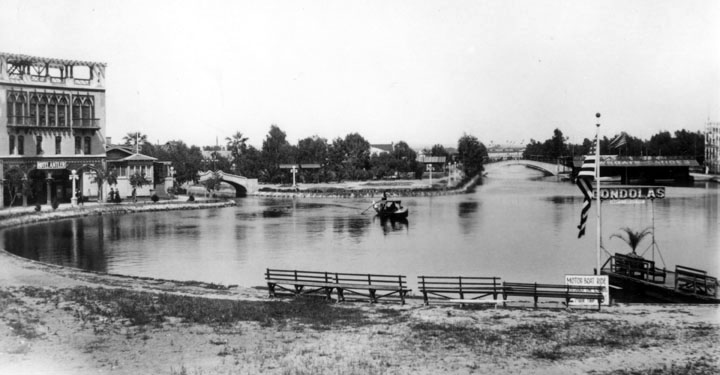 |
|
| (ca. 1910s)^ - Panoramic view showing a gondola being rowed across the canal towards the sign "Gondola" and another sign offering motor boat rides. On the left next to the water is the Hotel Antler. |
Historical Notes The canals converged on a large saltwater lagoon that later became a traffic circle. The bulk of the canals were filled in 1929 to create roads. |
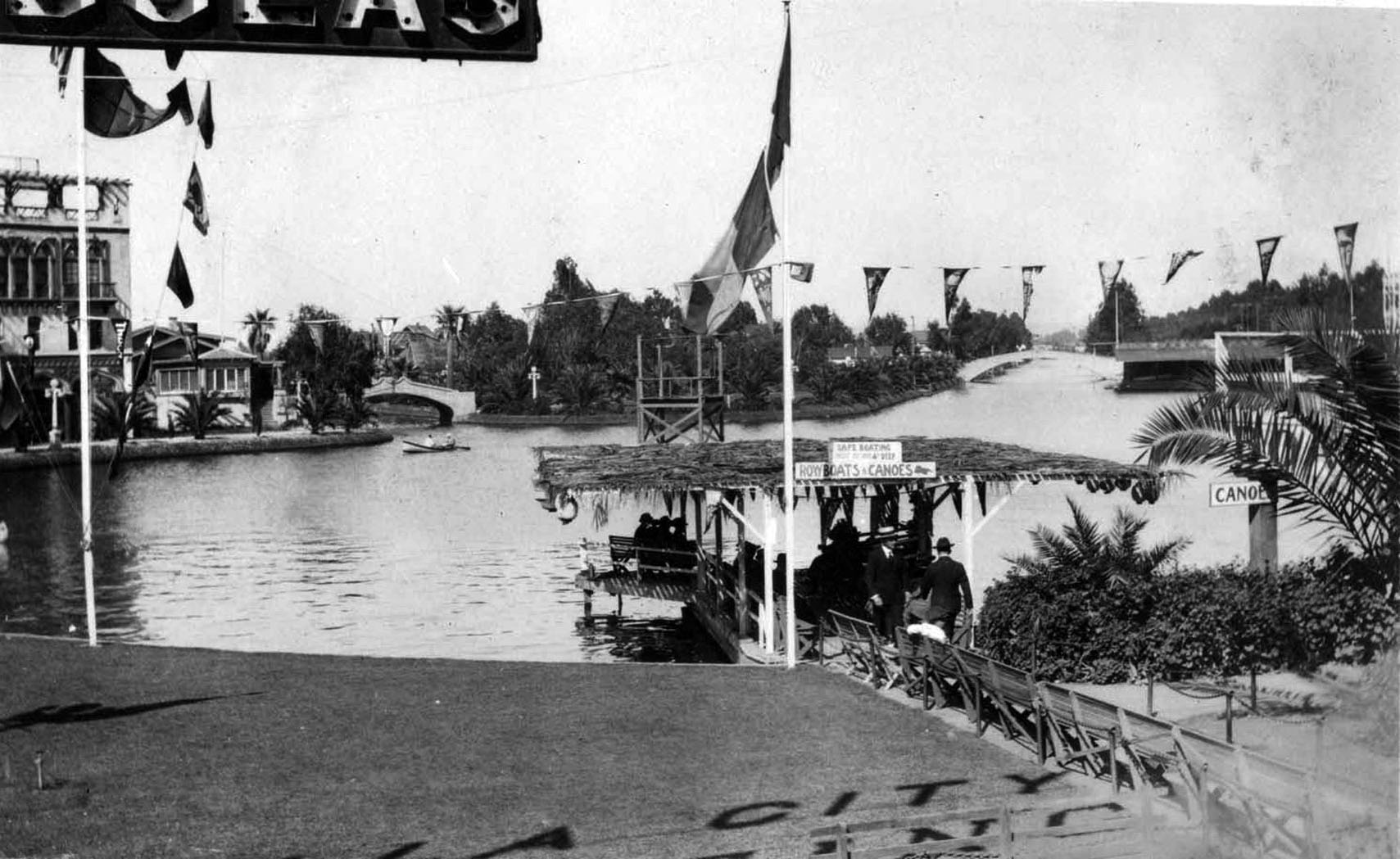 |
|
| (ca. 1910s)* - Venice Lagoon looking toward Grand Canal (right) and Lion Canal (left, later renamed Windward). In the foreground folks are patronizing a rowboat and canoe rental venue. Signage on the upper left corner of the photograph possibly advertises "gondolas." |
Then and Now
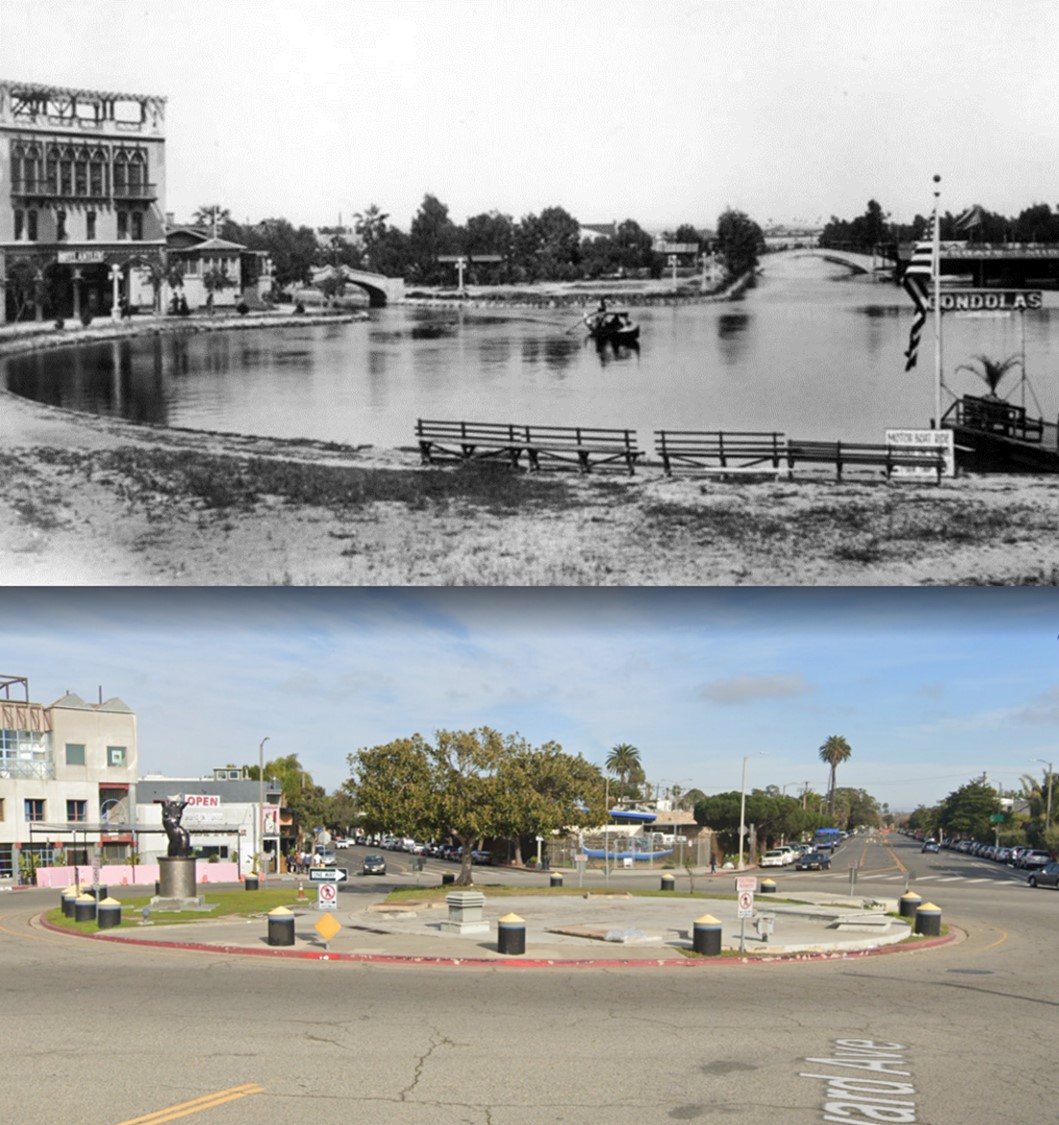 |
|
| Then and Now – Looking east showing the Venice Lagoon now the Windward Traffic Circle (1910s vs 2021)*. Windward Ave (previously Lion Canal) is on the left while Grand Blvd (previously Grand Canal) is on the right. The Antler Hotel is seen at upper-left. |
Historical Notes The transformation of Venice's canals into roads was primarily driven by economic and maintenance considerations. As the canals began to deteriorate, the cost of upkeep became a significant burden for the city. Filling the canals was seen as a more economically viable solution, especially during the Great Depression, when resources were limited. This financial pressure, combined with the rise of automobile use and urban development priorities after Venice's 1926 annexation by Los Angeles, led to the widespread conversion of canals into roads. Despite resident opposition, most canals were filled, although some were preserved and later recognized as historic landmarks. |
Then and Now
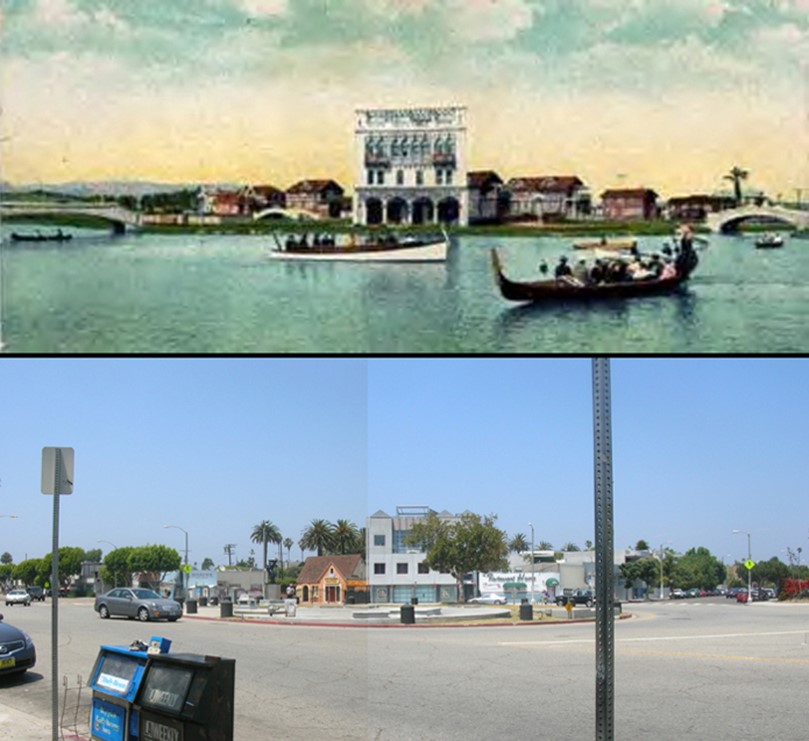 |
|
| Then and Now* – Venice Lagoon, now Windward Traffic Circle. |
Then and Now
 |
|
| (1910 vs 2020s)* - Grand Canal at the Rialto Bridge, today Grand Blvd at Rialto Avenue. |
Then and Now
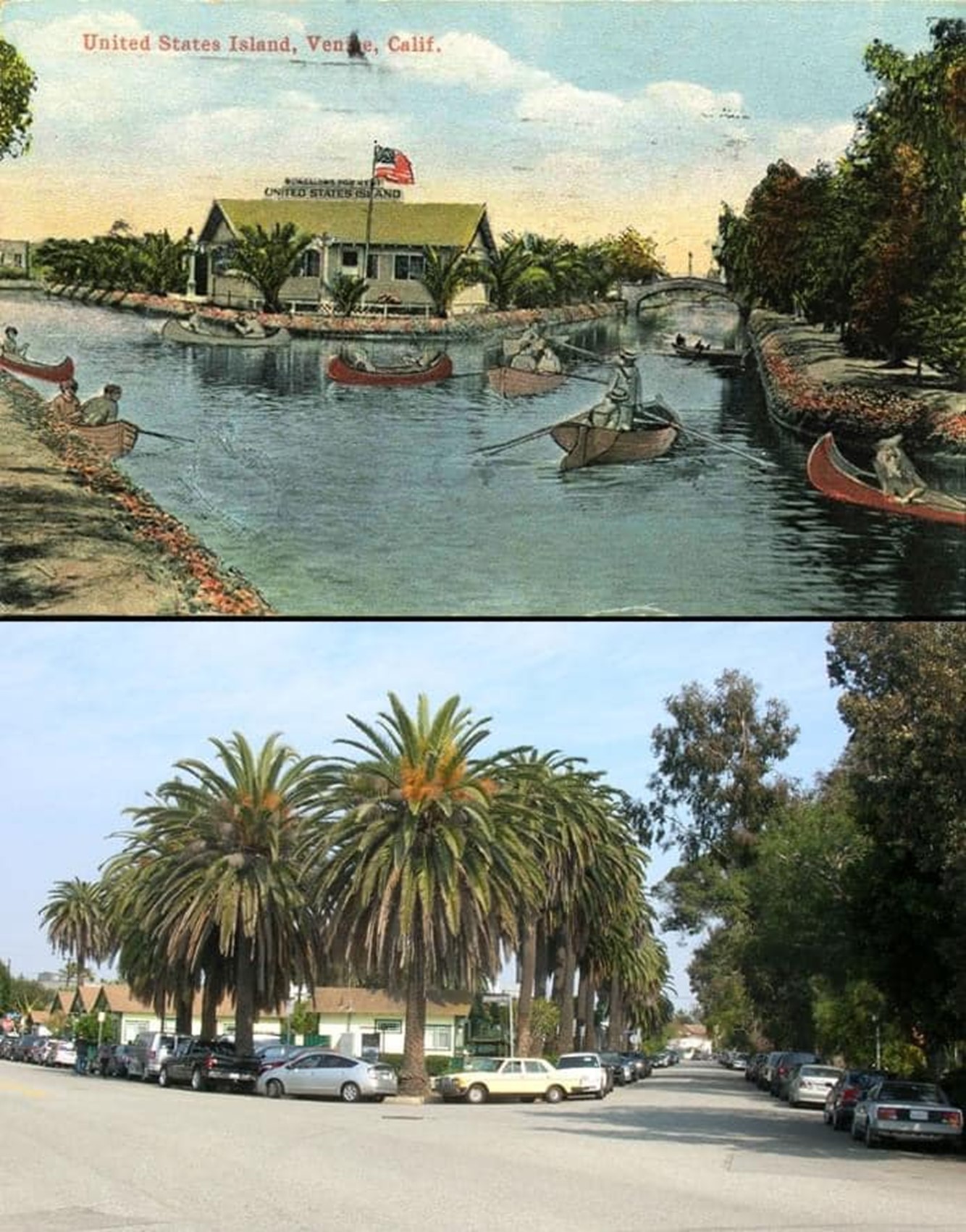 |
|
| (Then and Now)* |
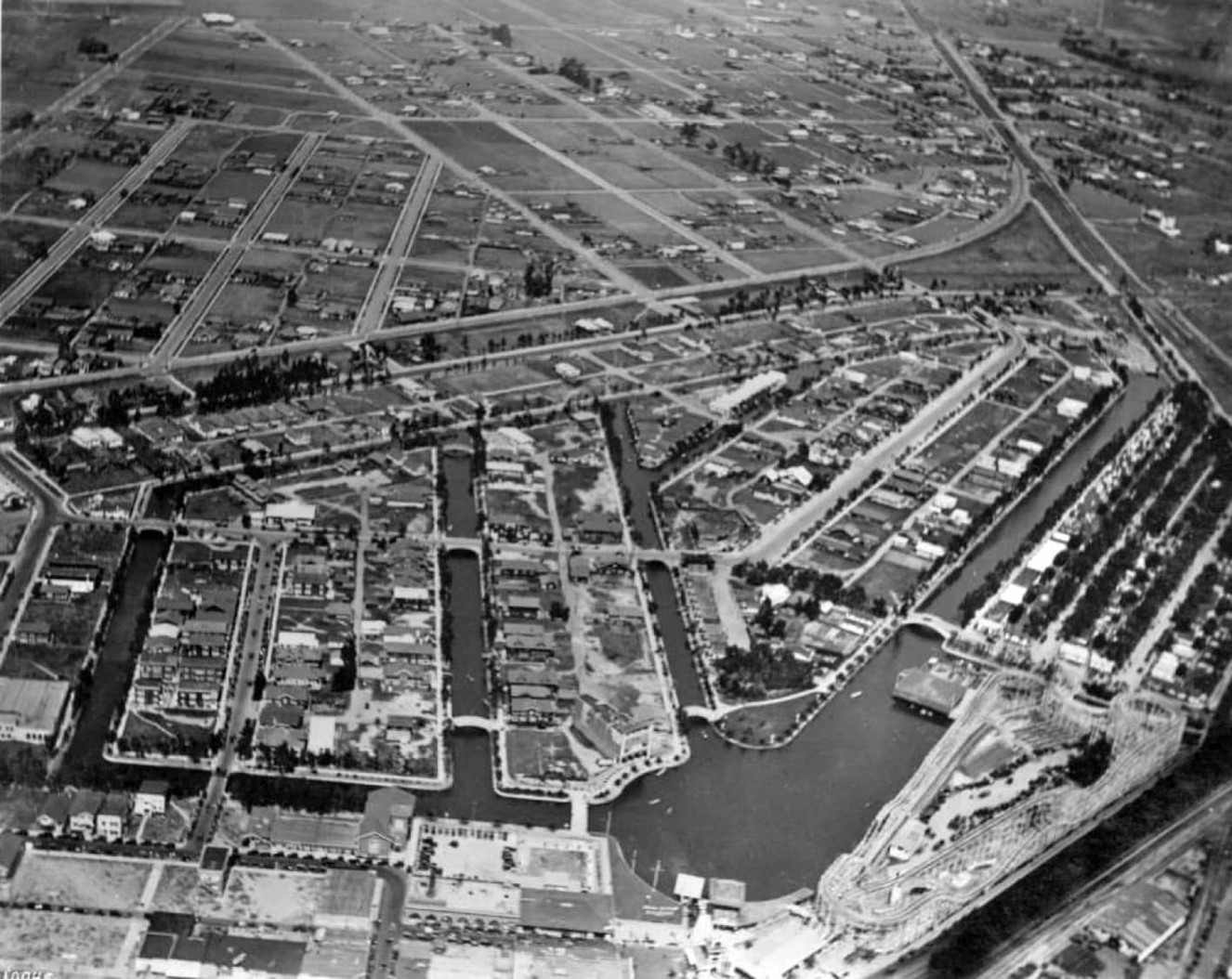 |
|
| (1920s)* - Aerial view of the Venice canals looking easterly with the Venice Lagoon at lower center-right. Note all the undeveloped land at top of photo. |
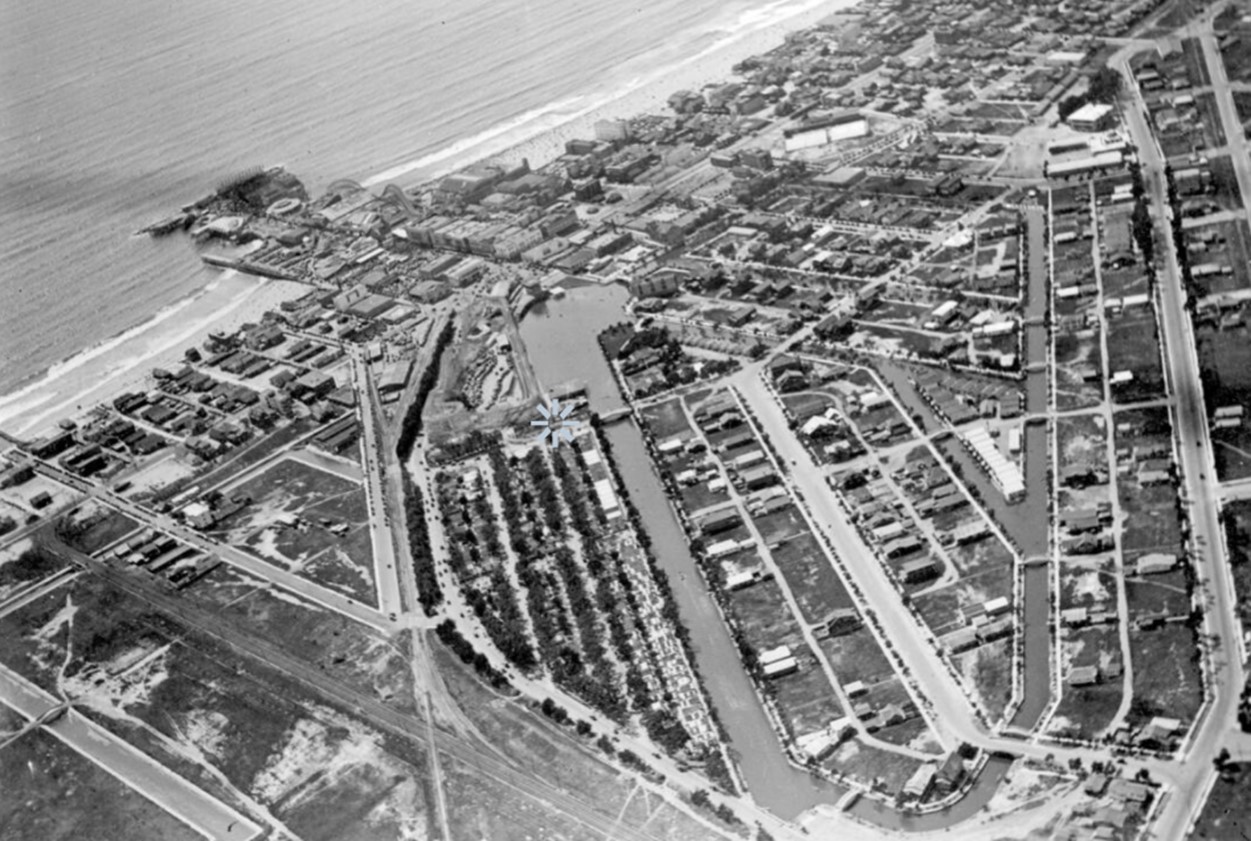 |
|
| (1918)* - Aerial view of looking west showing extent of the Venice Canals with Venice Pier at upper-left and the Venice Lagoon at top center. |
Historical Notes Before 1929, the area covered by canals was approximately three to four times as large as today. The entire area between Abbot Kinney, Pacific, and Venice Blvd. were canals. These canals were: Coral Canal (now Main St.), Cabrillo Canal (now Cabrillo Ave.), Venus Canal (now San Juan Ave.), Lion Canal (now Windward Ave.), Altair Canal (now Altair St.), Aldebaren Canal (now Market St.), and Grand Canal (now Grand Boulevard). |
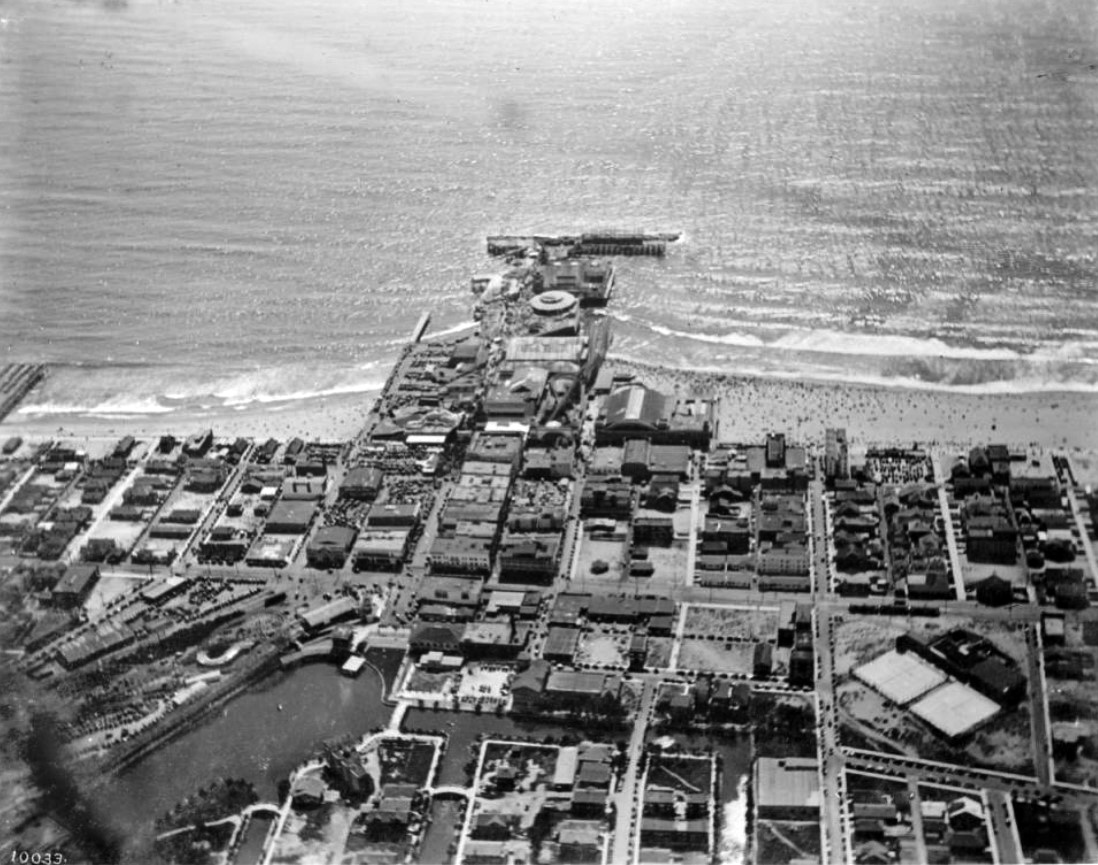 |
|
| (1918)* – Aerial view of the pier in Venice, looking west. At bottom of photo can be seen the Venice Lagoon and Canals. The Hotel Antler with its new large roof-mounted signboard can be made out at lower-left next to the lagoon. |
Historical Notes Today, the traffic circle at Pacific and Windward Avenues is located on top of what once was the Venice Lagoon. |
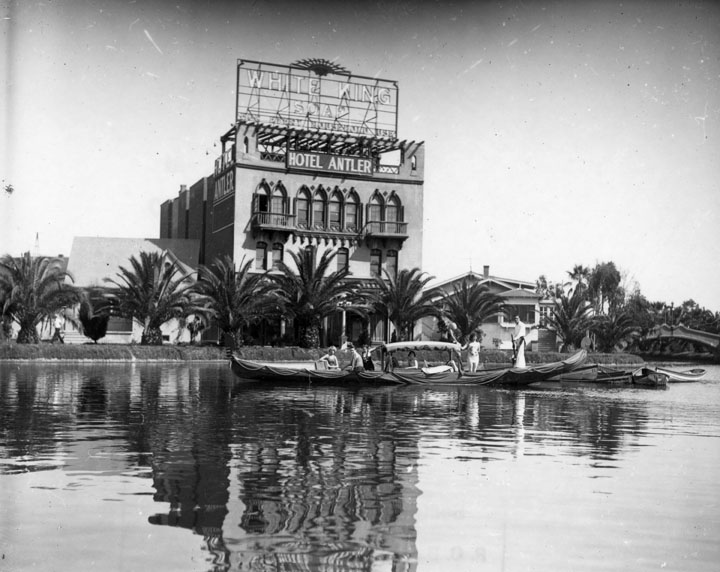 |
|
| (ca. 1920s)^ - View of gondola with several ladies on it, and a gondolier to steer, works its way across the canal. Behind them is the Hotel Antler. |
* * * * * |
Venice Miniature Railway
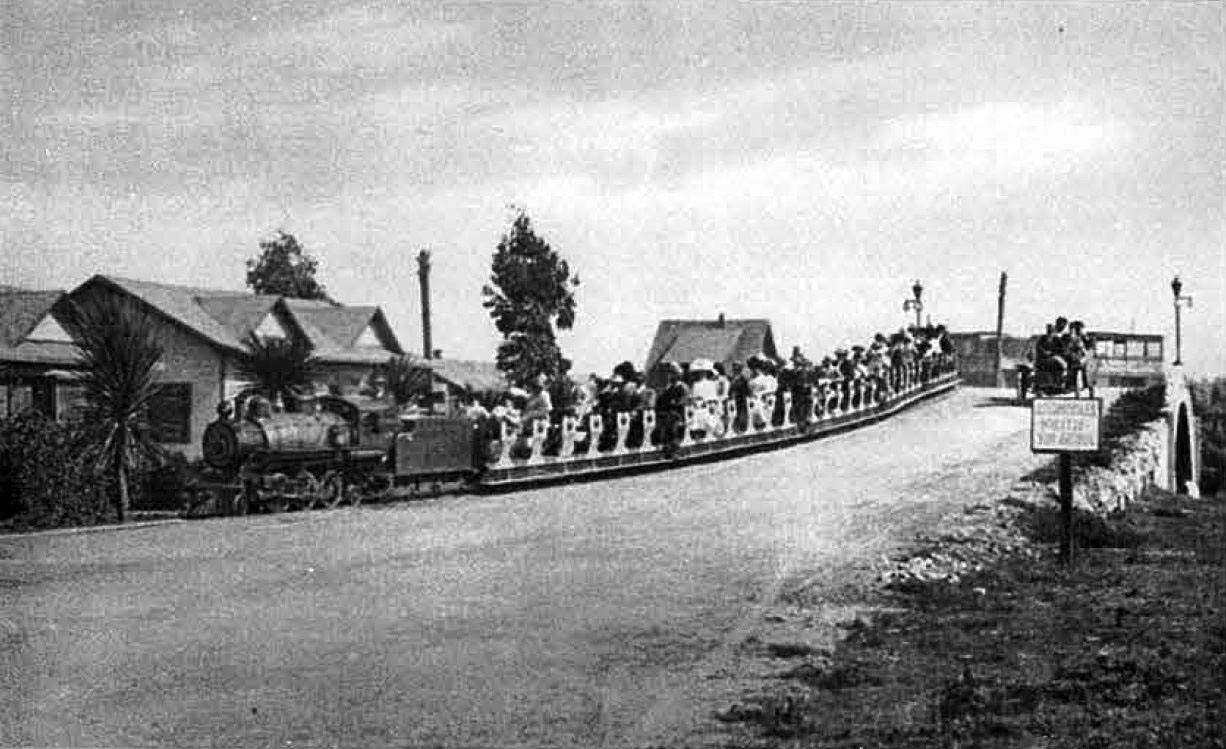 |
|
| (ca. 1905)* - View of the Venice Miniature Railway train crossing over a Venice Canal bridge on its way back to Windward Avenue at the Venice of America Amusement Park. |
Historical Notes When Abbot Kinney was building Venice in 1905, he decided that his new resort should have an internal transportation system to shuttle visitors and residents around town. He turned to John J. Coit who operated a successful eighteen inch gauge (1/3rd scale) miniature steam railroad at Eastlake Park (now Lincoln Park) in Los Angeles. He persuaded him to oversee the construction and management of a mile and three quarter long railroad that would take passengers from the Windward Avenue business district on a loop across canal bridges and through the canalled residential district, then return via a loop up Washington Boulevard, past its Lake Avenue maintenance yard and back to the Windward station along Mildred Avenue. |
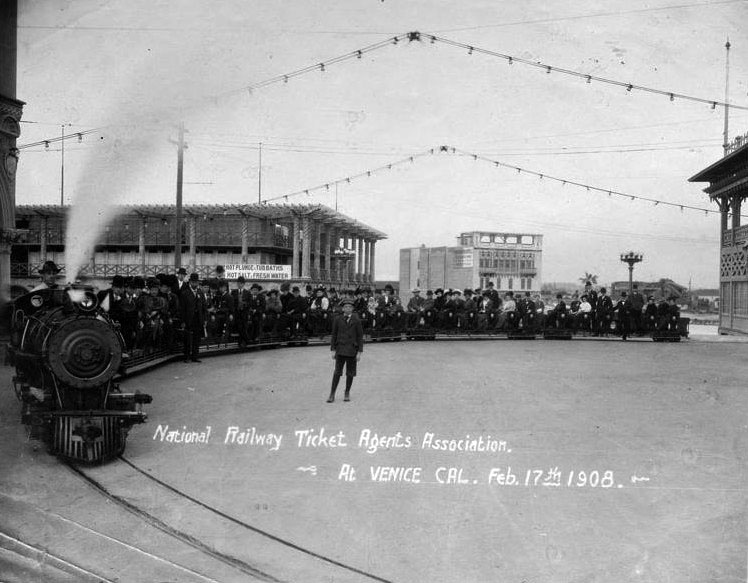 |
|
| (1908)^ - View of the Miniature Railroad Ride filled to capacity at the Venice Amusement Park. |
Historical Notes The cost of a trip around Venice was five cents, although residents could buy a book of tickets for $1.00 which made the run only two cents. At that time, it cost 15 cents to ride from Los Angeles to Venice on the Los Angeles Pacific Railway. |
 |
|
| (1910s)* – View looking west down Windward Avenue towards the ocean showing the Venice Miniature Railroad. |
Historical Notes Kinney installed the Venice Miniature Rail Road (V.M.R.R.) as both a tourist attraction and as a means to escort potential home builders and buyers to look at the subdivided parcels he was promoting. The train was very popular for its time, but it interfered with traffic. |
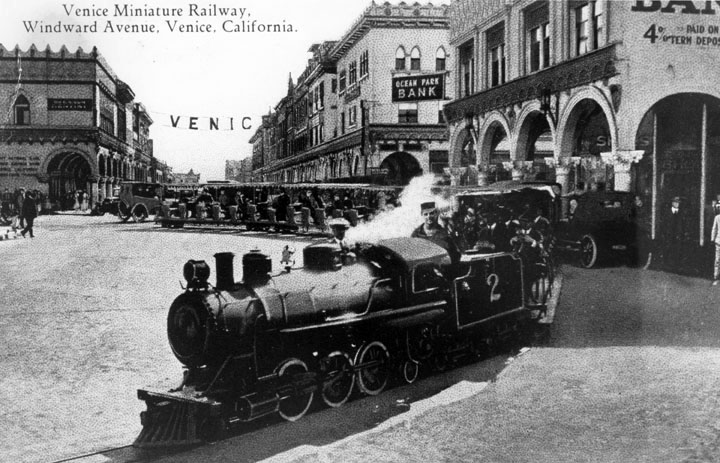 |
|
| (1912)* - Postcard view of the Miniature Railway on Windward Avenue in Venice. The miniature railroad would carry passengers for trips around the Venice streets, including Windward Ave. as shown here, and around the canal area. |
Historical Notes The Venice Miniature Railroad remained a popular ride and had run on weekends for twenty years. However, the train was opposed by merchants along its route on Washington Boulevard. In 1925, the city of Venice passed an ordinance that would prohibit miniature railroads from operating on streets, thus leading to the demise of the long running Venice Miniature Railroad. Click HERE to see more in Early Southern California Amusement Parks. |
* * * * * |
Windward Avenue
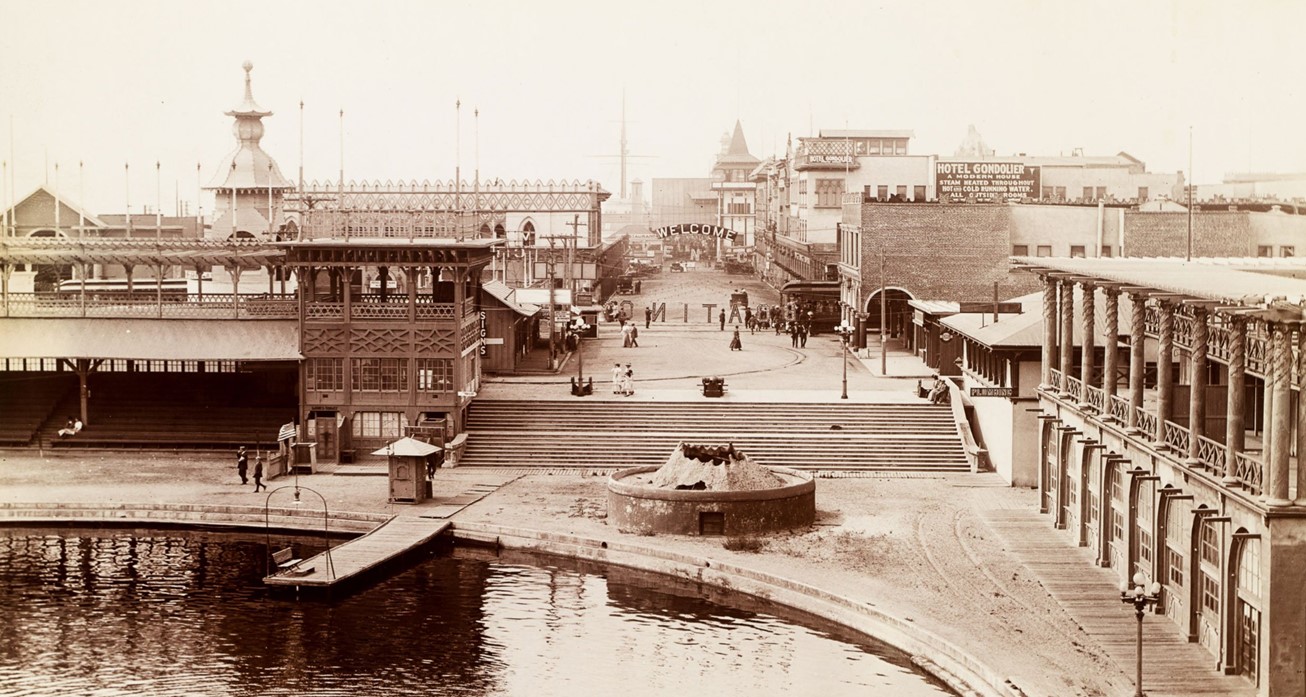 |
|
| (ca. 1906)* – View of Windward Avenue from the Venice Lagoon, with the Abbot Kinney Pier, Ship Café, and Auditorium visible in the distance. A sign reads: 'Hotel Gondolier, a modern house, steam heated throughout, with hot and cold running water.' The u-shaped tracks of the Venice Miniature Railroad are seen at the center of the image, with a streetcar stopped toward the center-right. Photo from the Ernest Marquez Collection. |
Historical Notes Windward Avenue, a key feature of early Venice, California, was envisioned by developer Abbot Kinney as the central artery of his grand Venice of America project, which opened in 1905. Modeled after its namesake in Italy, Kinney sought to bring the charm of European canals and culture to Southern California. The avenue stretched from the Venice Lagoon (now Windward Circle) to the Pacific Ocean, functioning as both a commercial hub and a picturesque promenade. |
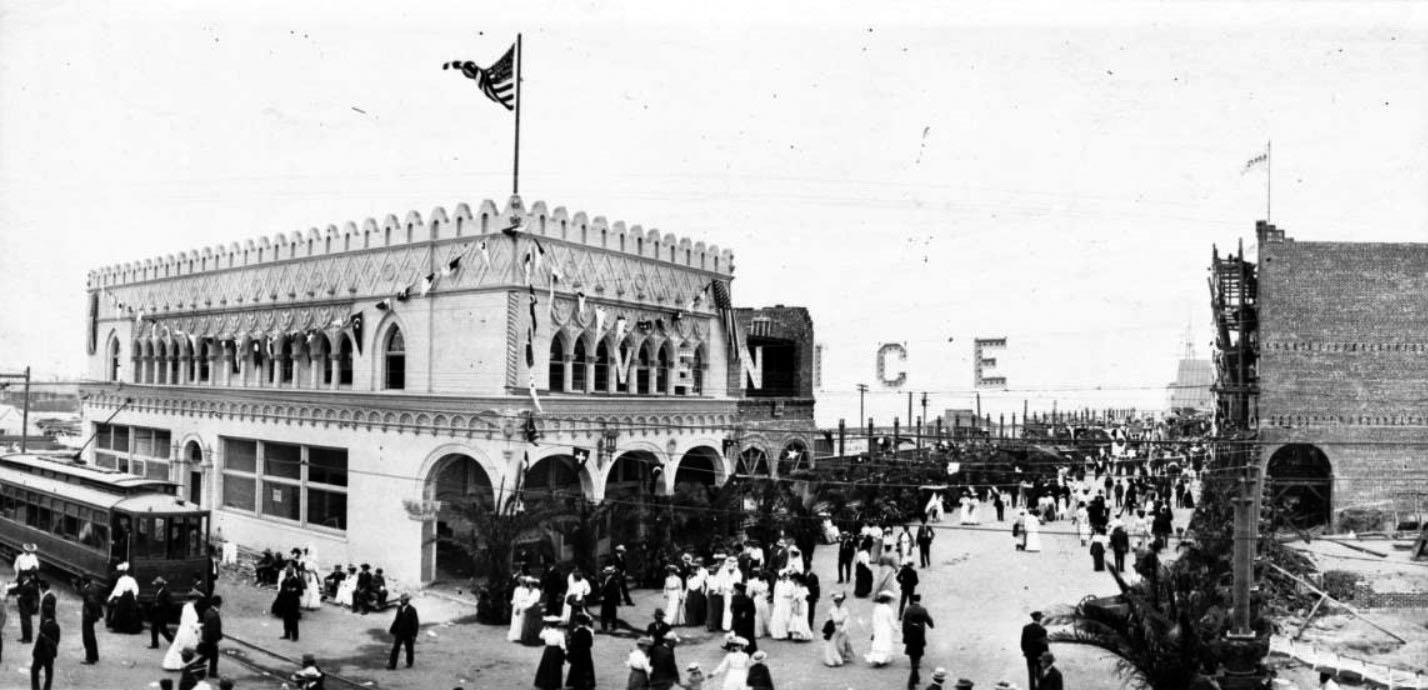 |
|
| (ca. 1905)* - Panoramic view showing a streetcar passing by a crowded pier in Venice. A wide walkway intersects perpendicularly with the train tracks, and hundreds of people can be seen walking on the road. This would be called Windward Avenue, also known as "The Gateway to Venice." |
Historical Notes In 1905, the founding year of Venice, Windward Avenue was two blocks long, stretching between the canal system and the pier, lined with hotels that featured hot salt water in every room. |
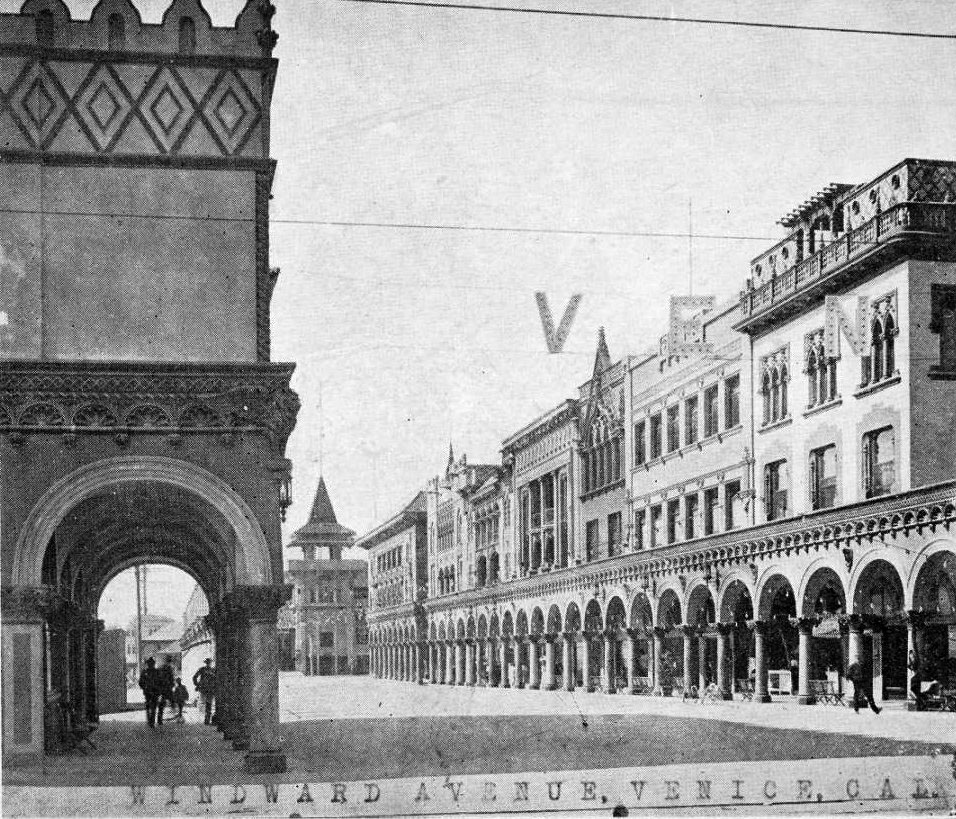 |
|
| (ca. 1905)^^ - Postcard view looking east on Windward Avenue in Venice. |
Historical Notes The Venice, Italy-inspired architecture of Windward Avenue was the whole advertising gimmick which brought Angelinos from downtown out to the Venice Beach area in the first place (back in 1905! It was quite a trek back then; a good gimmick was definitely NEEDED to pull folks away from the then-popular Downtown LA district. |
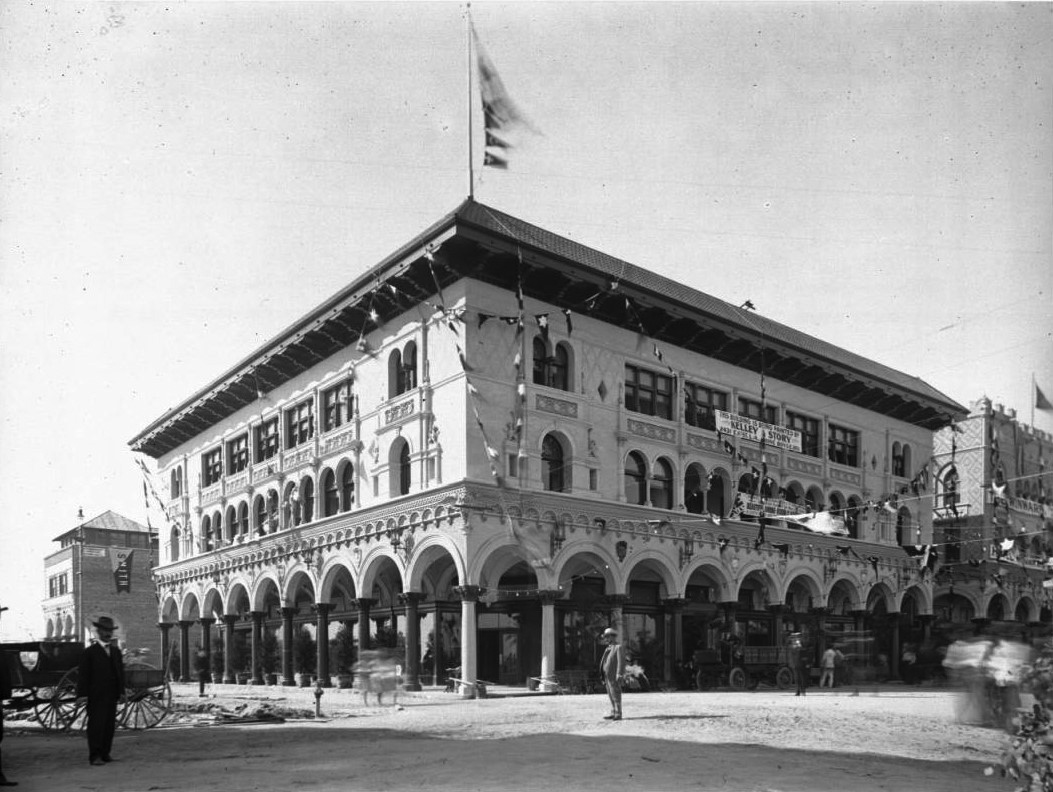 |
|
| (1905)^^ - View showing the newly constructed Saint Mark's Hotel on Windward Avenue at Ocean Front in Venice. The 3-story building has a two colonnades topped with arches supporting the roof over the sidewalk on two sides. Streams of banners fly from the roof of the hotel. |
Historical Notes Ground was broken for the St. Mark's Hotel on December 5,1904. It was one of Venice's original buildings and stood until 1964 when it was demolished. |
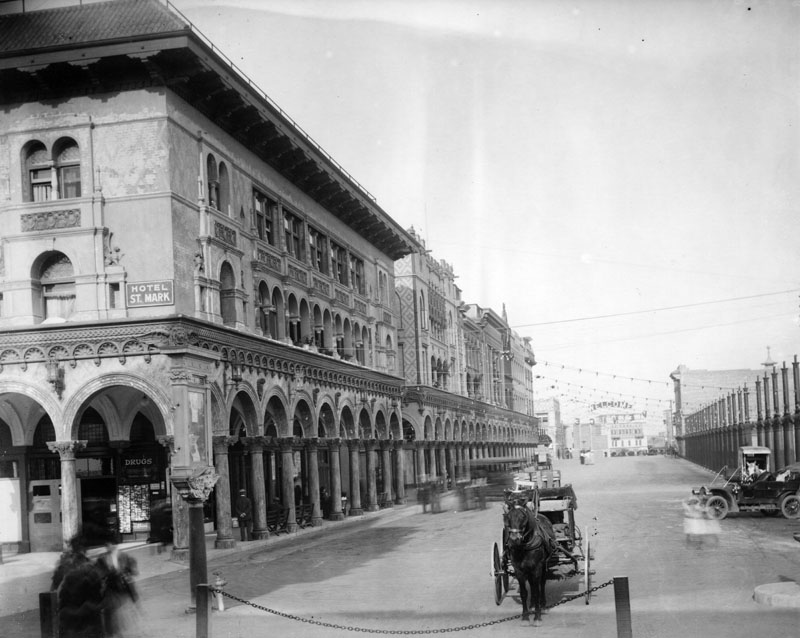 |
|
| (1906)^ - View looking west on Windward Avenue with the St. Mark's Hotel at left. A horse-drawn wagon is in the foreground. |
Historical Notes In 1906, Windward Avenue was built-up on the north side, but not the south side. The south side didn't really come into its own until prohibition came along and fancy basements were constructed.^ |
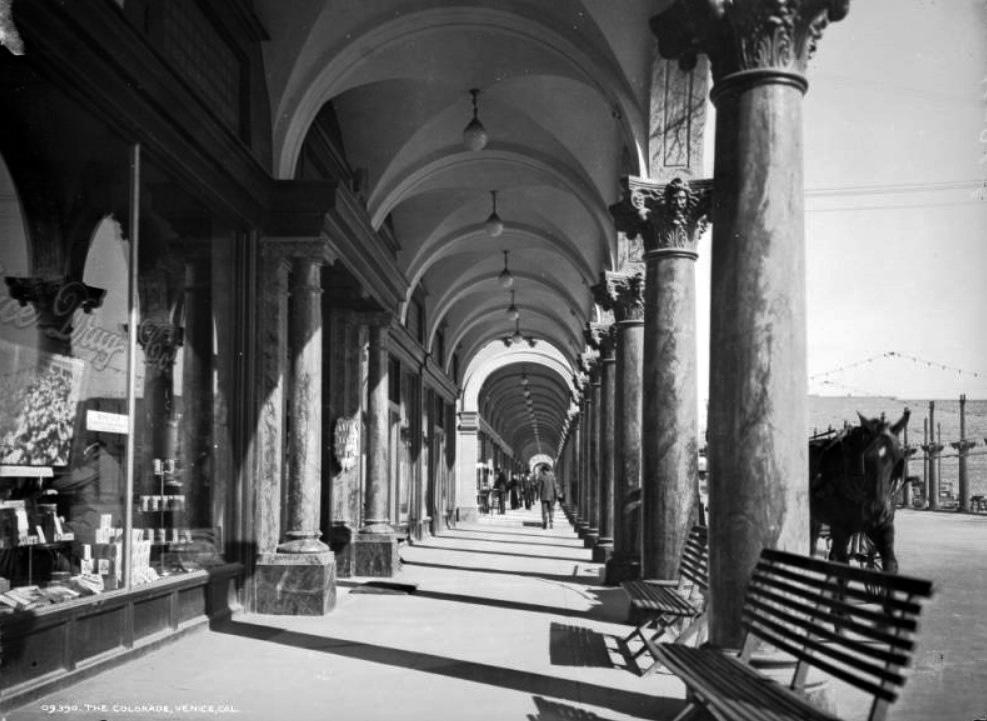 |
|
| (ca. 1906)^ - View of the colonnade at St. Mark's Hotel in Venice showing pedestrians on the sidewalk, a horse, wooden benches, and a man behind a window. Signs read: "(?) Drug Co." "Ice cream" "Hotel Saint Mark." |
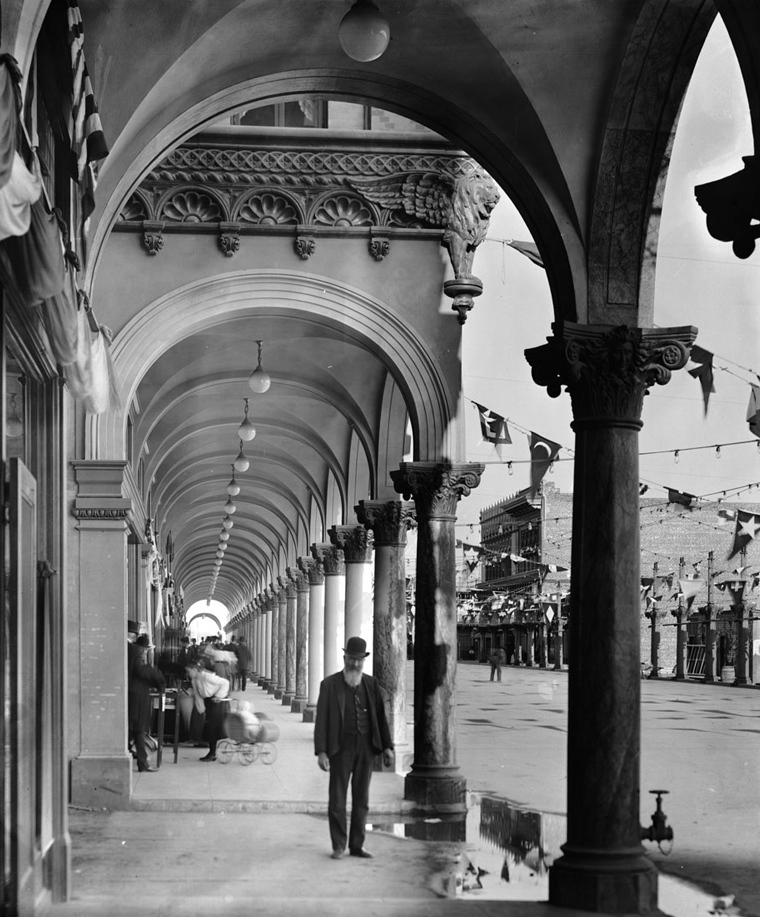 |
|
| (ca. 1906)* - View of the Saint Mark's Hotel on Windward Avenue in Venice Beach. An outdoor corridor houses a street arcade. A man with a beard stands in the foreground near one of the many pillars and arches forming the corridor. |
Historical Notes The colonnade, made up of dozens of Corinthian columns supporting Venetian-style arcade buildings on Windward, Pacific, and Market avenues, still serves as the gateway to the city and is one of Venice's most recognizable landmarks. |
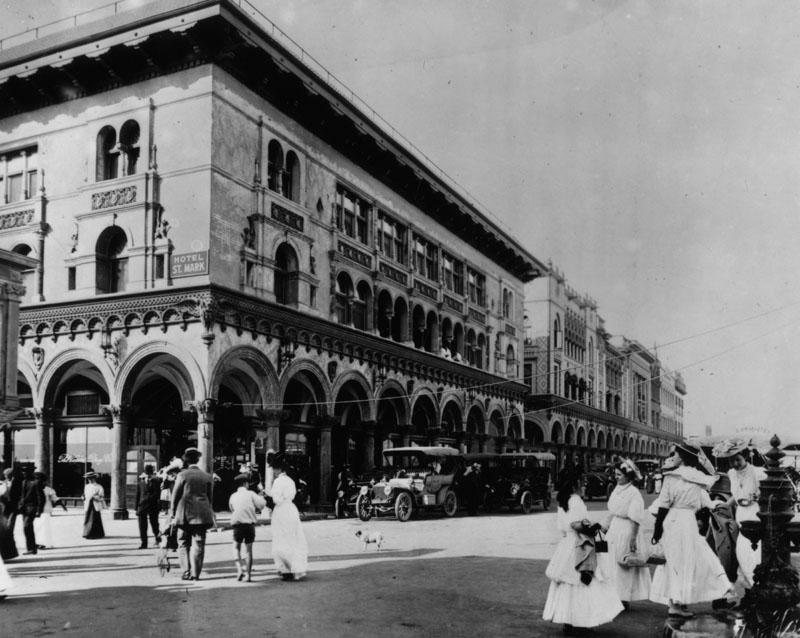 |
|
| (ca. 1906)^ - A corner view of the exterior of a business building on Windward Avenue in Venice which includes the St. Mark's Hotel. |
Historical Notes When Venice was constructed in 1905, the business district utilities were placed underground in two tunnels running beneath the alleys on either side of Windward Avenue. The two tunnels originated at the heating plant and powerhouse located on Windward near the lagoon (current site of the B of A building near the traffic circle). In addition, some hotels along Ocean Front Walk constructed tunnels beneath the promenade to the beach because an ordinance forbid bathing suits on the boardwalk. The St. Mark's Hotel at the corner of Windward was one. During Prohibition in the 20's, rum runners would unload their booze from boats beneath the pier and sneak them into the St. Mark's tunnel. |
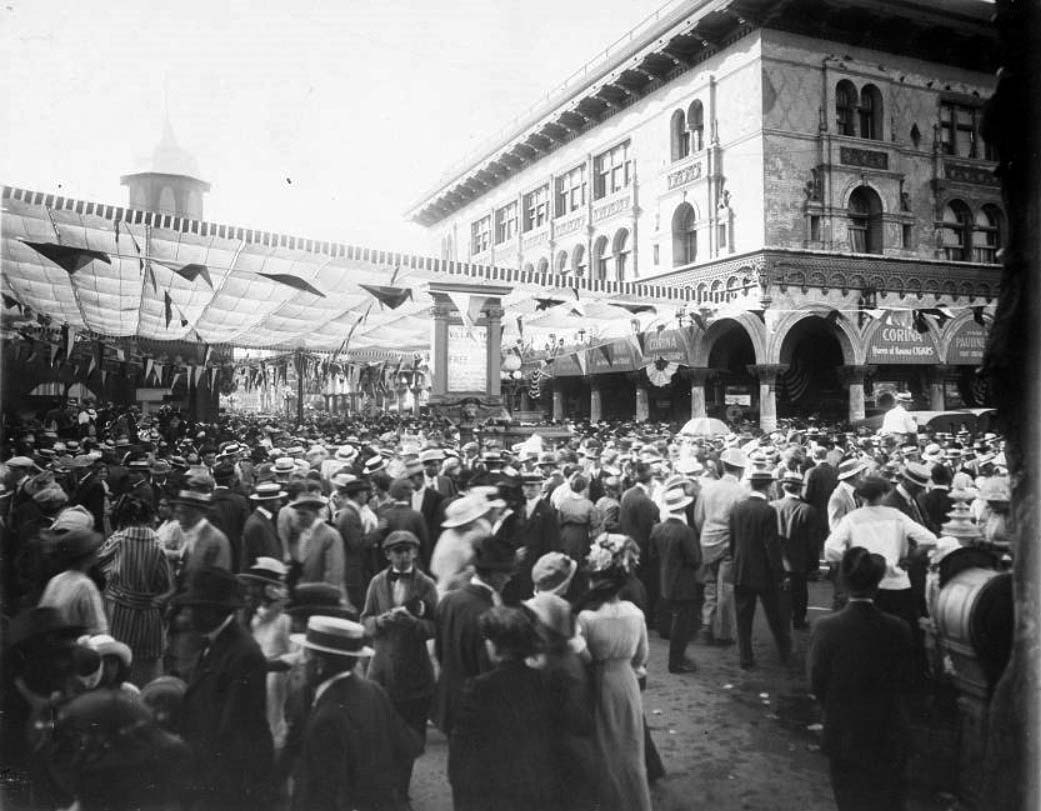 |
|
| (ca. 1910)* – View showing a large gathering of people in front of the St. Mark's Hotel. |
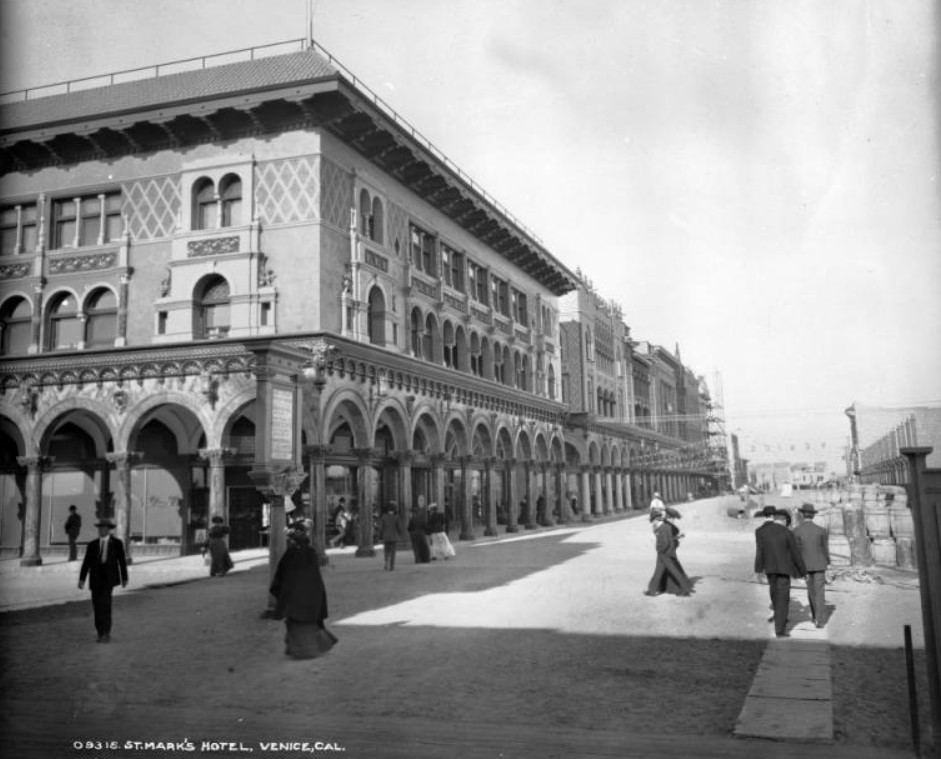 |
|
| (ca. 1910)* - Pedestrians walk in the street near St. Mark's Hotel. The Romanesque style building has arched windows and an arched colonnade. Signs read: "Venice Events, Dancing" and "Venice." |
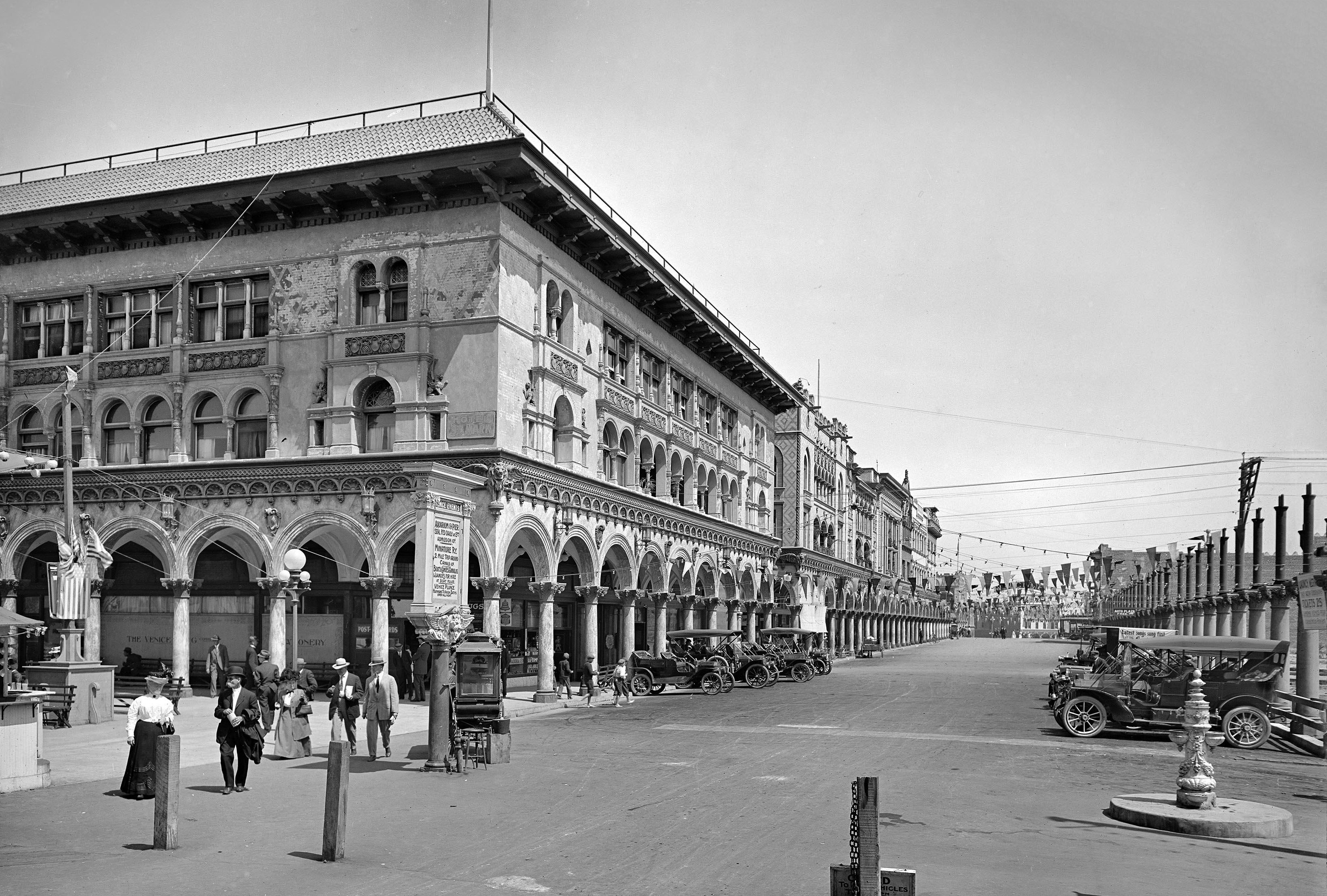 |
|
| (ca. 1912)* - A corner view of the St. Mark’s Hotel and the colonnade with its Corinthian columns extending two blocks down Windward Avenue. Photo: Library of Congress |
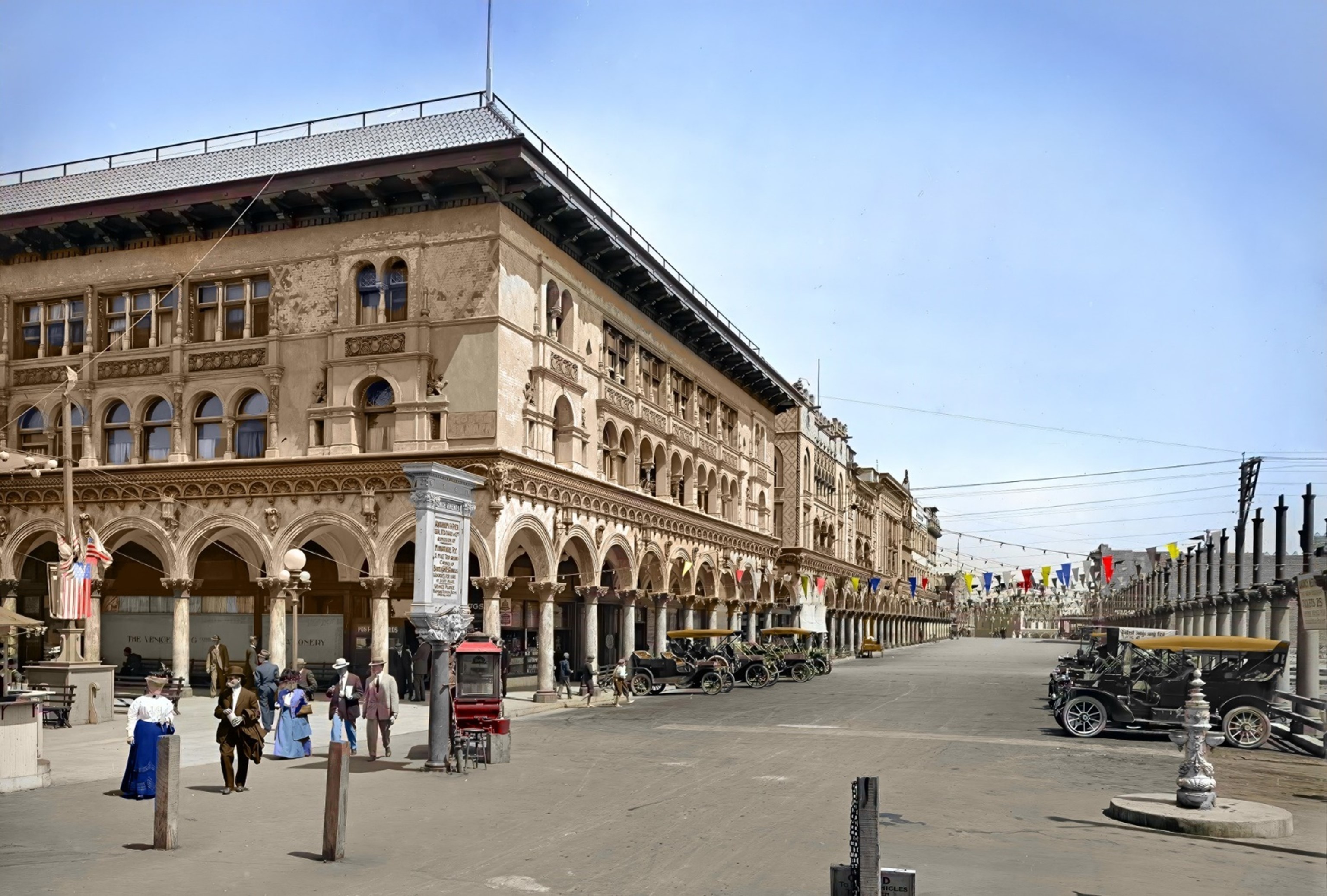 |
|
| (ca. 1912)* - A corner view of the St. Mark’s Hotel and the colonnade with its Corinthian columns extending two blocks down Windward Avenue. Photo: Library of Congress; Image enhancement and colorization by Richard Holoff |
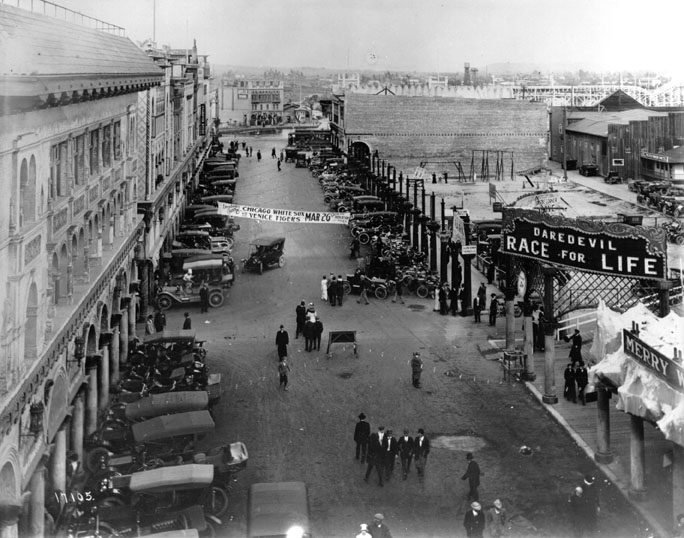 |
|
| (1913)^ - Looking from a roof at the end of Windward in Venice, one can see the street below and in the distance the piers along the ocean. A banner across the street announces a baseball game between the Chicago White Sox and the Venice Tigers. Click HERE to see more on the Venice Tigers in Baseball in Early L.A. On the right hand side of the street you can enter attractions such as the Daredevil Race for Life and the Merry Widow. |
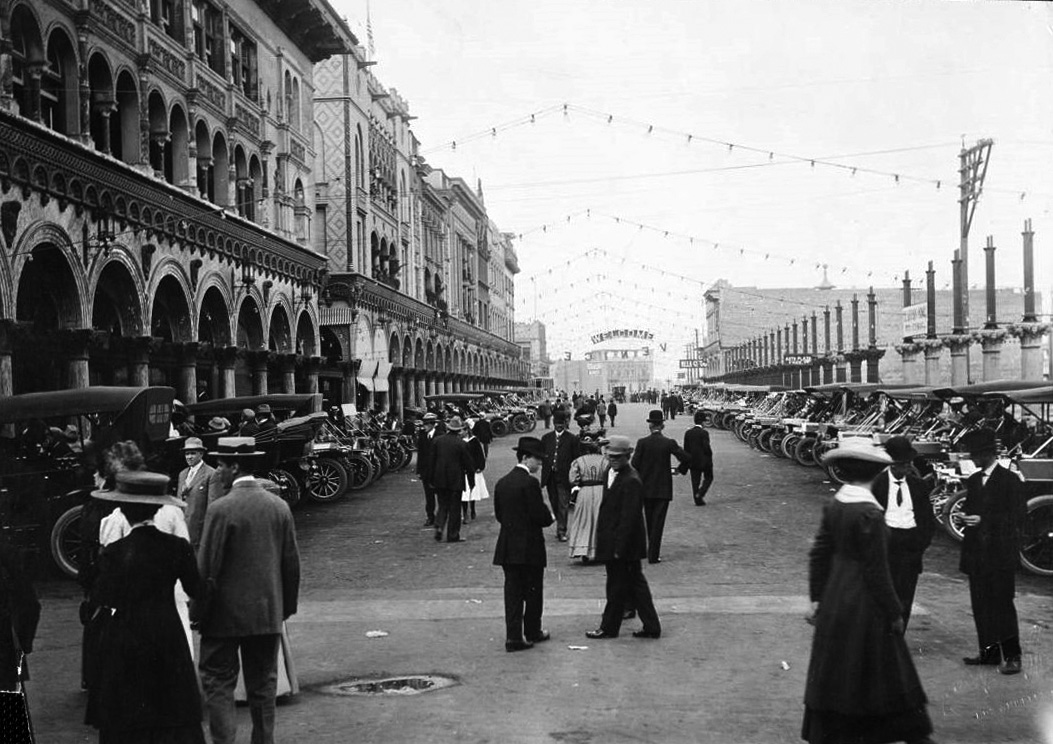 |
|
| (ca. 1915)* – View looking west on Windward Avenue showing well-dressed men and women walking down the center of the street. Buildings on the right have yet to be completed. |
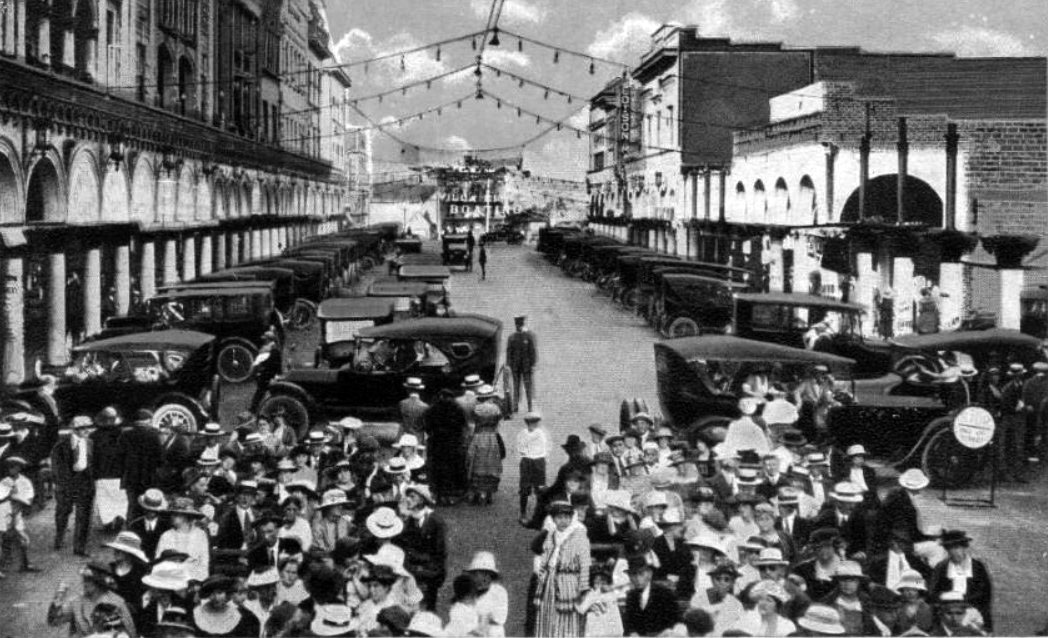 |
|
| (ca. 1920)* – Postcard view showing a large group of people waiting in line on Windward Avenue, Venice. The street behind is full of parked vehicles. |
 |
|
| (1914)* – View looking west on Windward Avenue showing a Turkish Bath House, theaters, an apartment house, automobiles, motorcyle, and bicycles parked along the street. The Hotel Omar is seen at left. |
.jpg) |
|
| (ca. 1910s)* – Sailors on shore leave venture down Windward Avenue in Venice. |
.jpg) |
|
| (1914)* – Detailed view looking west on Windward Ave with double decker bus seen on the left. Autos, motorcycle, and cars are parked on the right in front of the Windward Apartments. |
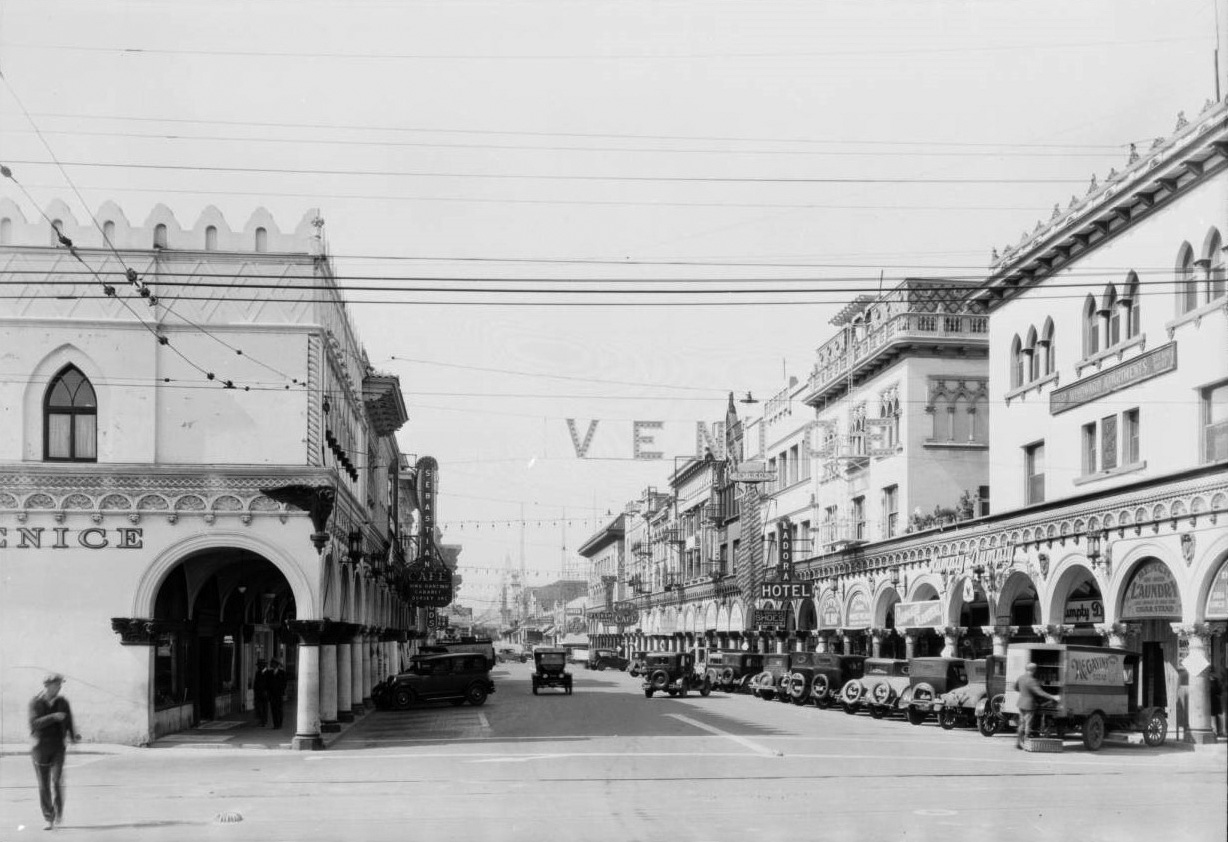 |
|
| (ca. 1929)^^ - View looking west of Windward Avenue in Venice Beach, showing cars parked diagonally along the side of the road. The two-lane paved street runs is lined by two-story buildings at left and three-story buildings at right. Both sets of buildings have covered arcades in front of them. The buildings are light-colored and house shops, hotels, and restaurants. A sign that says "Venice" is suspended over the street. Legible signs include, from left: "Sebastian Café Ming Dancing Cabaret Dorsey Orc.", "The Florsh Shoe", "United", "Mars Café", "Ladora Hotel", "W. L. Douglas Shoes", "Hotel Del Mar", "Men's Wear", "Humpty Dumpty", "Beach Soft Water Laundry Cigar Stand". |
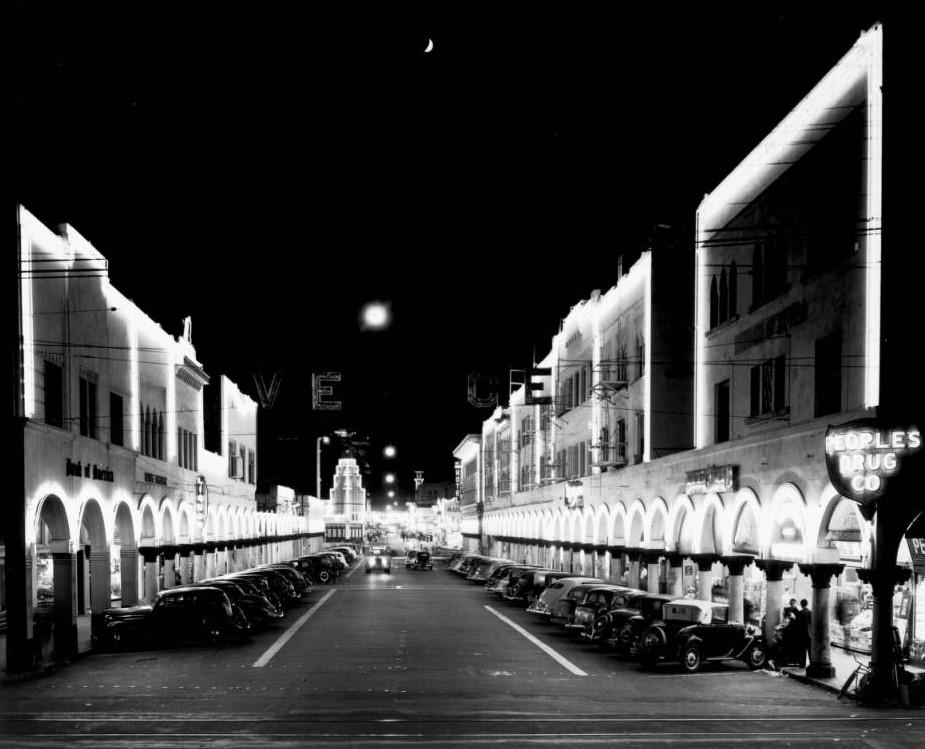 |
|
| (1939)* – View showing a brightly lit Windward Avenue at night. Photo by Dick Whittington |
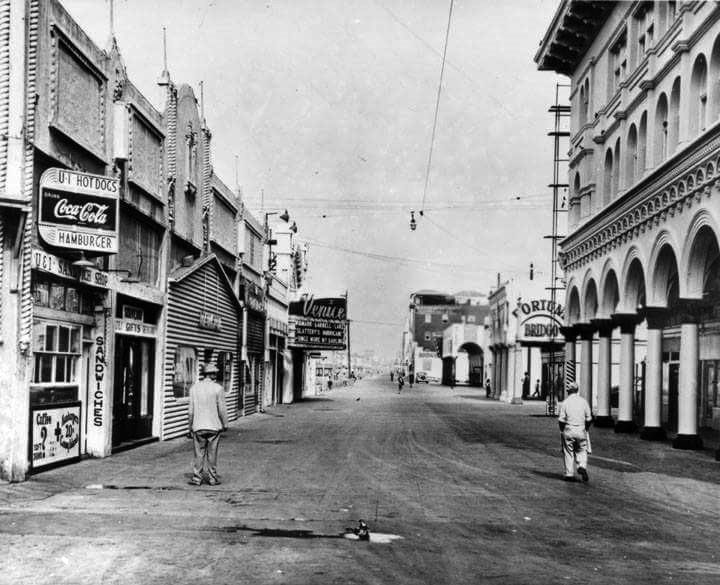 |
|
| (1949)^ – Two men are seen walking along a near-empty Ocean Front at Windward Avenue. The St. Mark's Hotel is on the right (NE Corner) and In the distance can be seen the Venice Theater*. |
Historical Notes The Venice Theatre opened in 1920 as the California Theatre on the water side of Ocean Front Walk. The location was between Windward Avenue and Market St. (formerly called Zephyr). In the 1923-24 directory it's listed at 1506 Ocean Front Walk. |
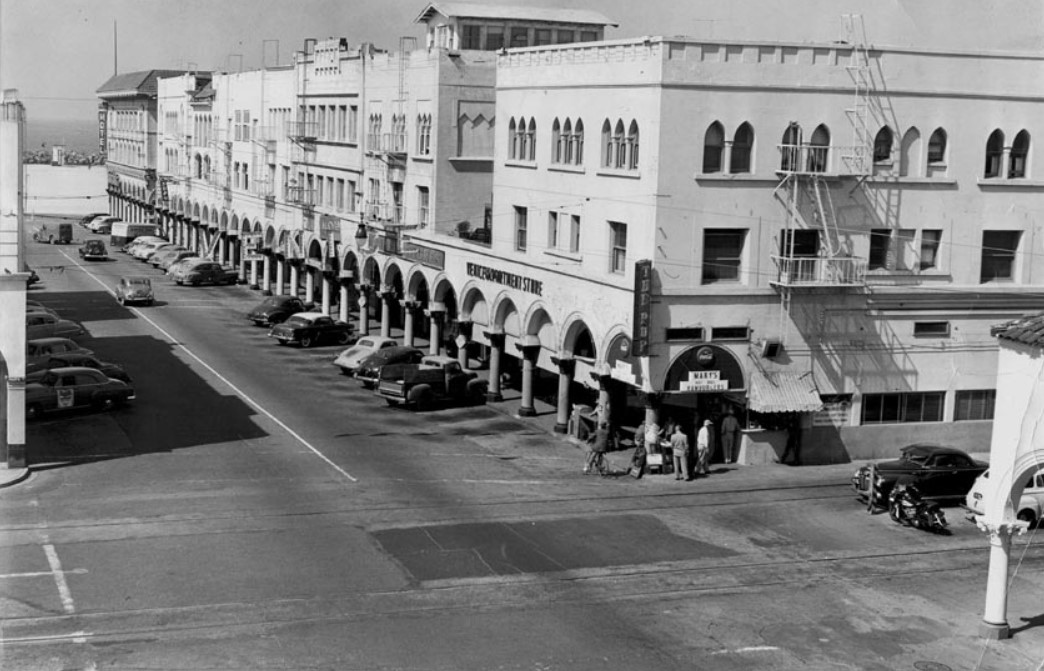 |
|
| (1953)^ – View looking west at Windward Avenue in Venice – Looking towards site of pier. |
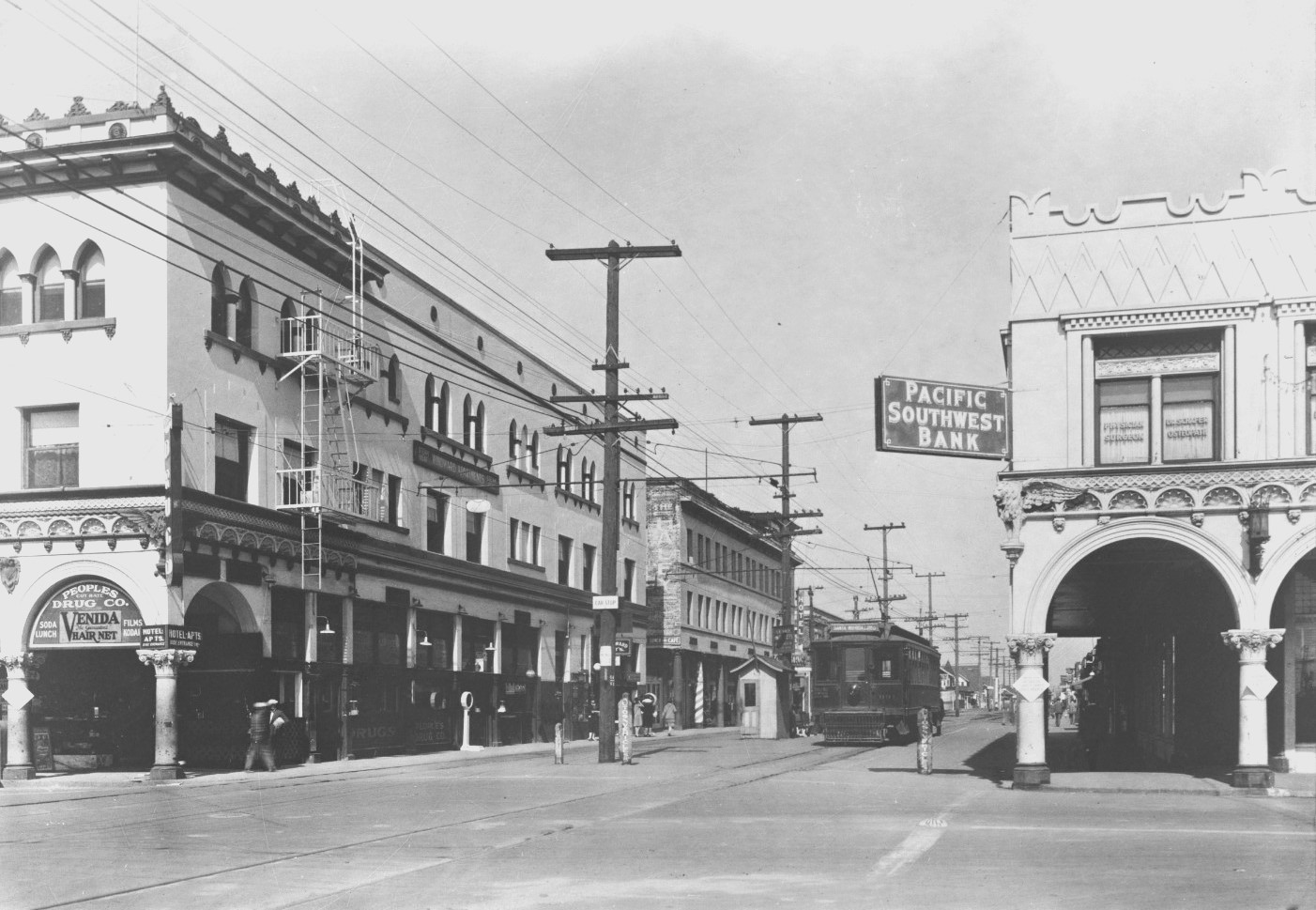 |
|
| (n.d.)* - Windward and Trolley Way (Pacific Avenue) with Pacific Southwest Bank on the right, People's Drug Store and Windward Apartments on the left. |
Historical Notes On plat maps for the neighborhood Trolley Way is also referenced as Electric Avenue, which makes sense as the train cars operating on it were electric. |
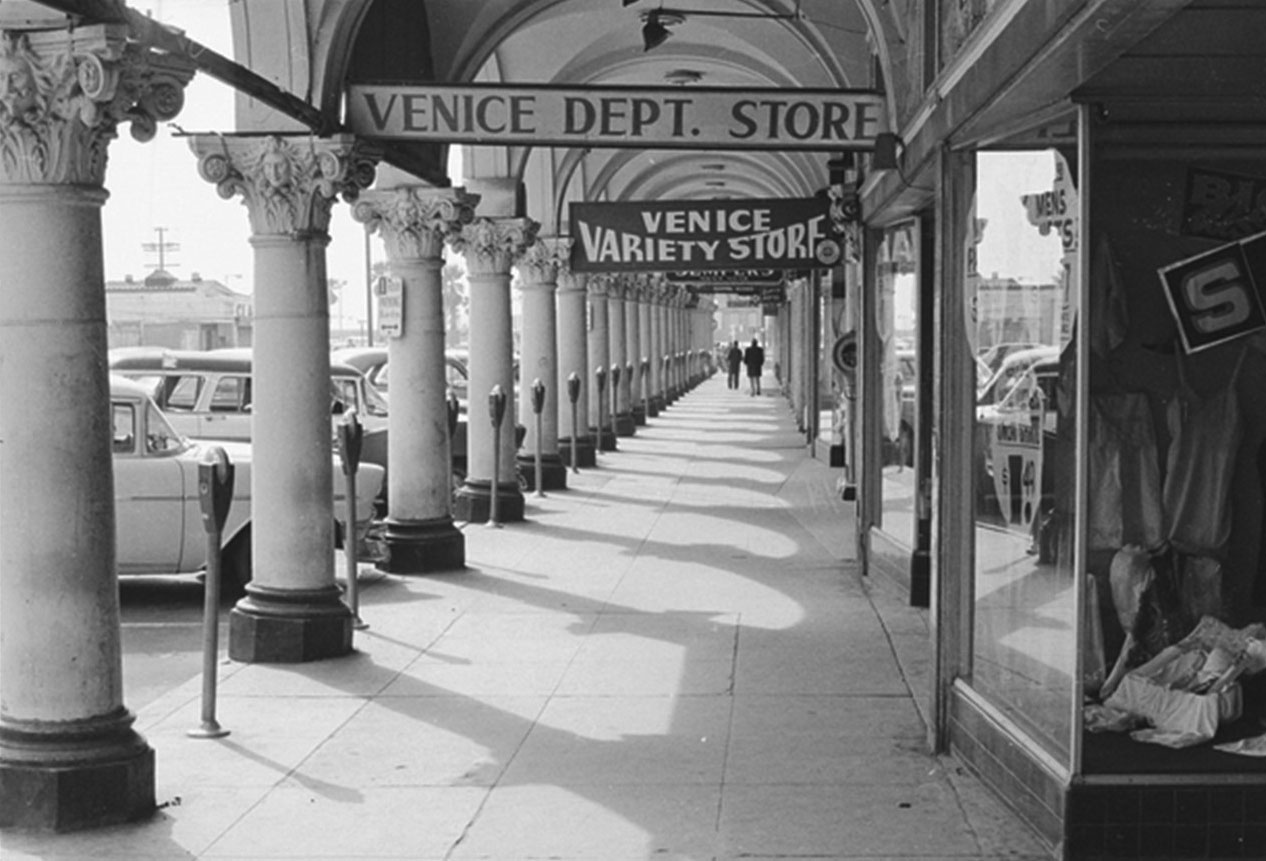 |
|
| (1950s)* - Windward Avenue in Venice Beach...mid 1950's. |
Then and Now
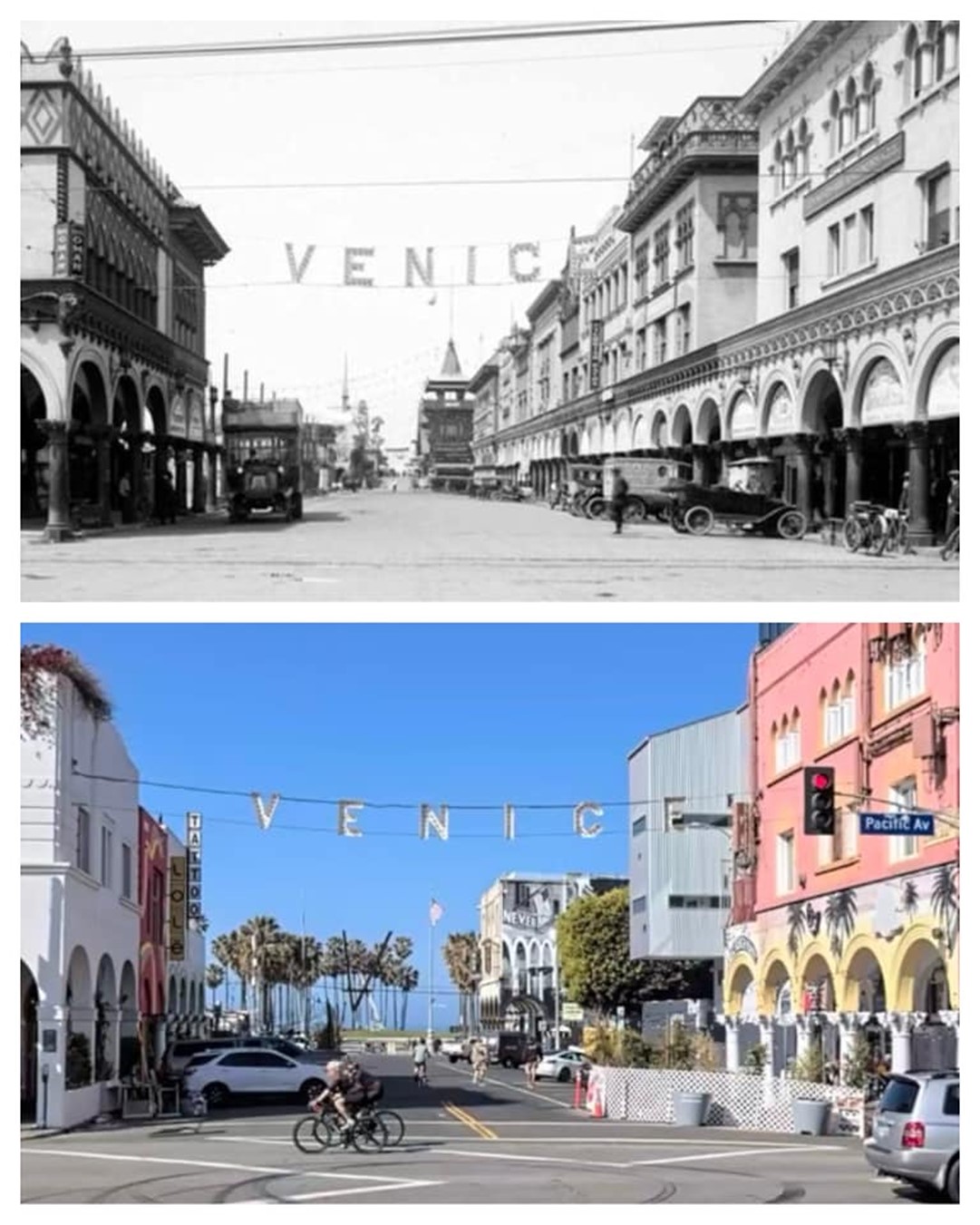 |
|
| (1914 vs 2023)* - Windward Avenue looking west at Pacific Avenue. Photo comparison by Trey Callaway |
Then and Now
 |
|
| (1914 vs 2023)* - Windward Avenue looking West. Contemporary image taken by @mileschatterji |
* * * * * |
Ocean Front Walk and Windward
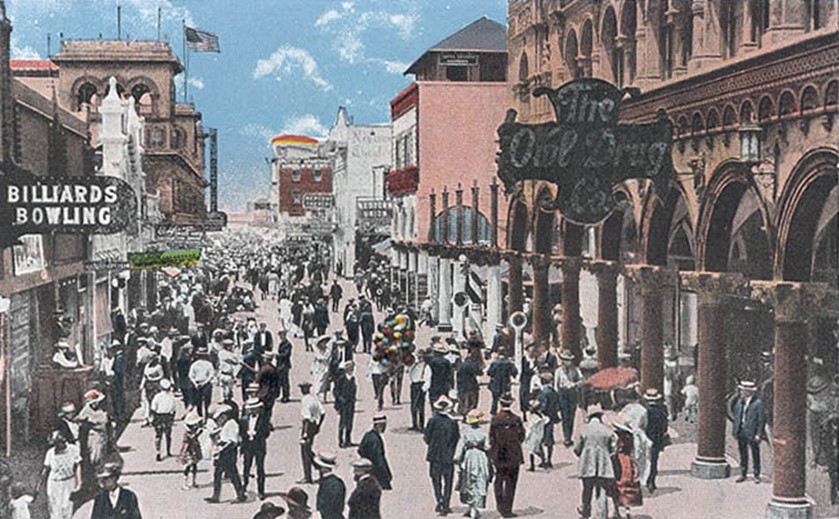 |
|
| (ca. 1921)* – Postcard view looking north on Ocean Front Walk from Windward Avenue. That green thing sticking out on the left just beyond the "Billiards Bowling" sign is the marquee of the California Theatre. You can see a bit of the big white arch of the facade. The large structure just beyond the theatre is the Plunge, once advertised as the largest indoor saltwater pool in the world. On the right it's the St. Mark's Hotel at Windward and Ocean Front. Down in the next block on the right there's a glimpse of the arches of the facade and the protruding signage at the Neptune Theatre. |
Historical Notes Ocean Front Walk near Windward Avenue in Venice during the 1920s was a vibrant and bustling entertainment district, serving as the heart of Venice's tourist attractions. This area featured an array of notable establishments, including the California Theatre, which opened in 1920, the Neptune Theatre, and the St. Mark's Hotel. The famous Plunge, advertised as the world's largest indoor saltwater pool, was also a major draw. The boardwalk was lined with two and three-story buildings housing shops, hotels, restaurants, and covered arcades, creating a lively atmosphere for visitors. Abbot Kinney, Venice's founder, had designed the area as an amusement center with attractions built over the ocean. |
 |
|
| (1923)* - Firefighters march in parade on Ocean Front Walk in Venice. Neptune Theatre in background, Strand Cafe and Mecca Cafe in foreground. |
Historical Notes Parades were frequent in Venice, showcasing bands, floats, and celebrities from silent films and sports. They were organized for holidays and special events to draw tourists. In the 1920s-30s, Ocean Front Walk was a hub for attractions, including the California Theatre (opened in 1920), beauty pageants, and various festivities. |
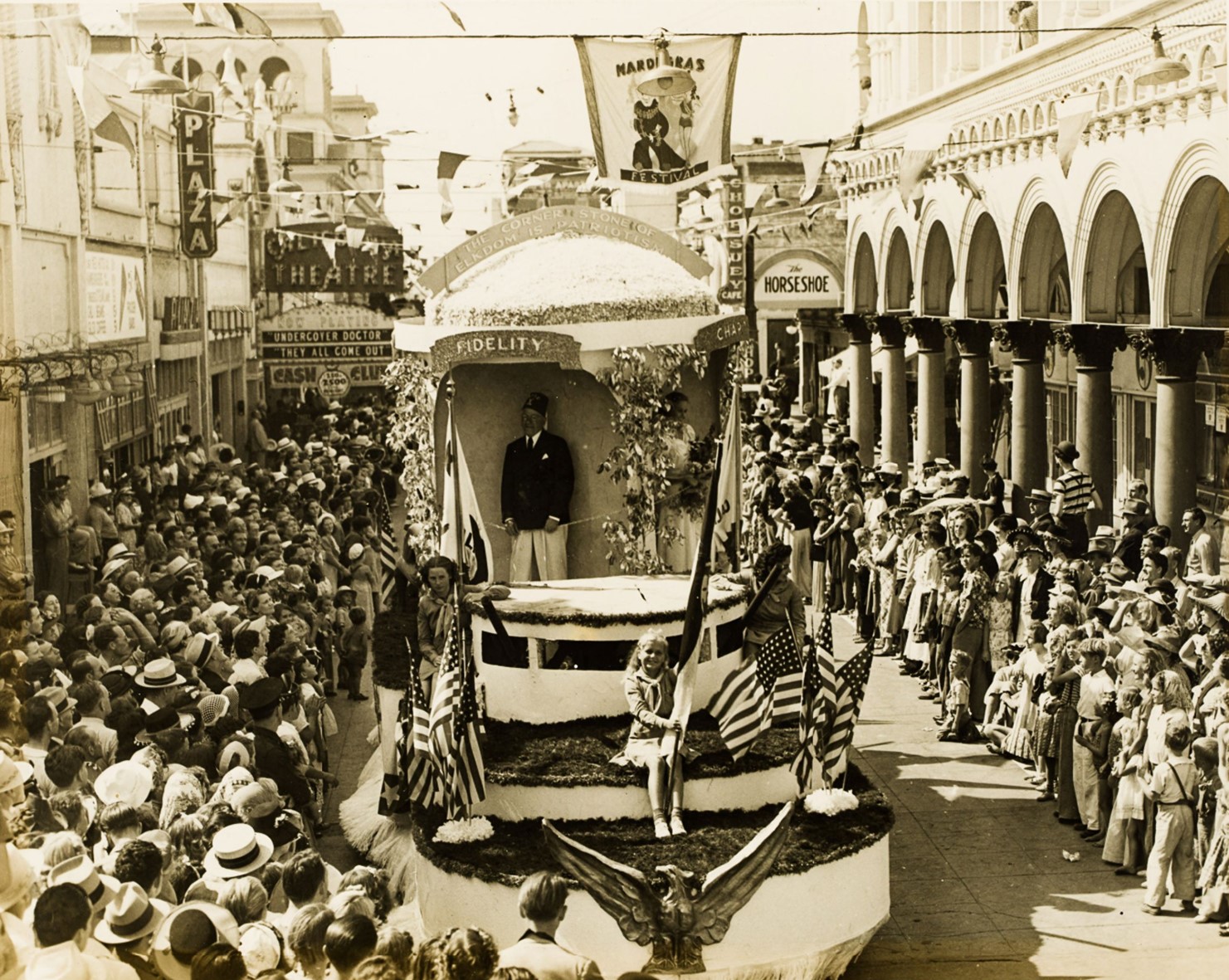 |
|
| (1939)* - A Mardi Gras Festival parade on Ocean Front Walk near Windward Avenue in Venice, with the colonnades of the St. Marks Hotel visible on the right. Signs along the parade route include 'Undercover Doctor' and 'They all come out' on a movie marquee, as well as 'Plaza,' 'The Horseshoe,' 'Chop Suey Cafe,' 'California Theatre,' and 'Mardi Gras Festival.' A float in the parade displays the message 'The cornerstone of Elkdom is patriotism, fidelity, [charity?],' featuring a girl, young women, and an Elks member wearing a fez. Photo from the Ernest Marquez Collection. |
Historical Notes The Venice Mardi Gras Festival, which began in 1935, was a vibrant summer celebration held in Venice during the 1930s. Unlike traditional Mardi Gras events, this three-day festival took place in August and was designed to boost the local economy and attract tourists. The festival featured elaborate parades along Ocean Front Walk and Windward Avenue, showcasing floats and participants wearing enormous papier-mâché masks. Highlights included the arrival of King Neptune by outrigger canoe, the coronation of Queen Venetia, and a grand procession along Ocean Front Walk. The event also boasted beauty pageants, street carnivals, aquatic events, and a culminating Mardi Gras Ball. Growing rapidly in popularity, the Venice Mardi Gras Festival became an annual tradition that fostered civic pride and drew increasingly large crowds. By 1941, its final year before being interrupted by World War II, the festival had expanded to four days and attracted an estimated 500,000 attendees, cementing its place as a unique blend of New Orleans-style revelry and California beach culture. |
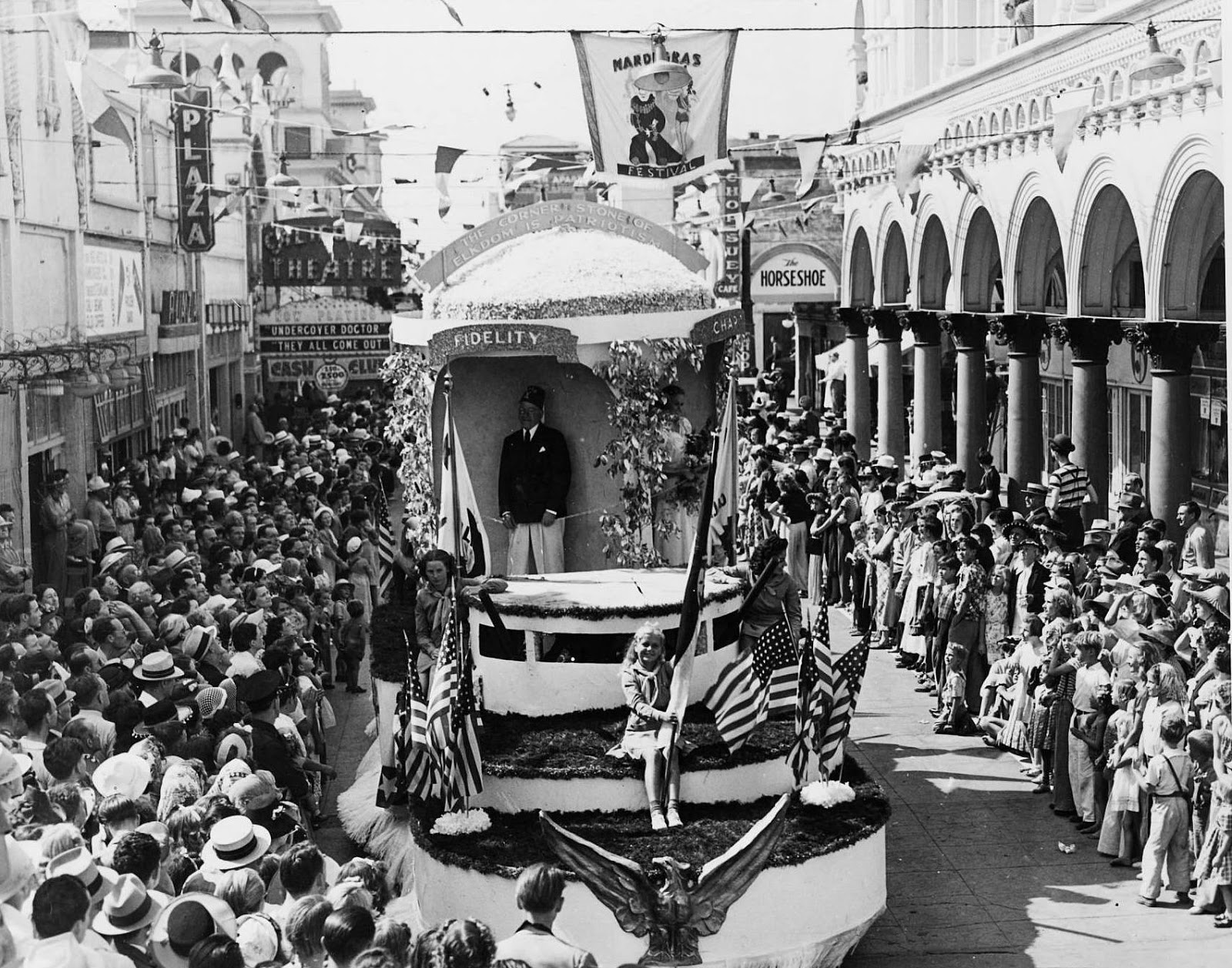 |
|
| (1939)* - A Mardi Gras Festival parade on Ocean Front Walk near Windward Avenue. Photo from the Ernest Marquez Collection. |
 |
|
| (1937)* - Looking north on Ocean Front Walk with The Plunge just beyond and the beach off to the left behind the California Theatre. |
Historical Notes The California Theatre opened on July 1, 1920 on the water side of Ocean Front Walk. It was constructed on what had been the site of the scenic railway. The location was between Windward Ave. and Market St. (formerly called Zephyr). In the 1923-24 directory the address is listed as 1506 Ocean Front Walk. |
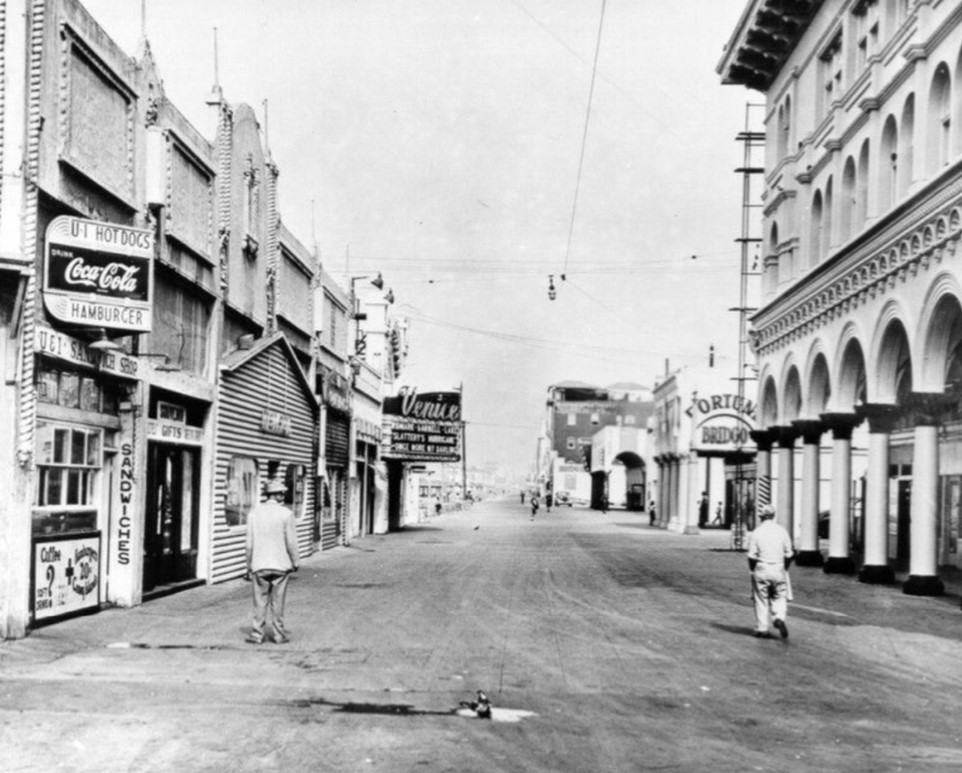 |
|
| (1949)* - A look north on Ocean Front Walk towards Ocean Park. Far down on the left is the Venice Theatre (formerly the California Theatre), and on the right is the St. Mark's Hotel. |
Historical Notes After World War II, Ocean Front Walk near Windward Avenue in Venice experienced a significant downward trend. The once-thriving beach resort and amusement center fell into decline as the City of Los Angeles, which had annexed Venice in 1925, largely neglected the area. By the 1950s, Venice was dubbed the "Slum of the Sea," with deteriorating infrastructure and changing demographics. Tourist attractions were replaced by pawnshops and liquor stores, while cheap rents attracted European immigrants and counterculture artists. The city's code enforcement policies in the early 1960s led to the demolition of many historic buildings, including the St. Marks Hotel and Venice Theatre. This period of decline transformed the area from a popular tourist destination to a more bohemian enclave, setting the stage for later revitalization efforts and the eventual emergence of Venice's unique, eclectic beachfront character. |
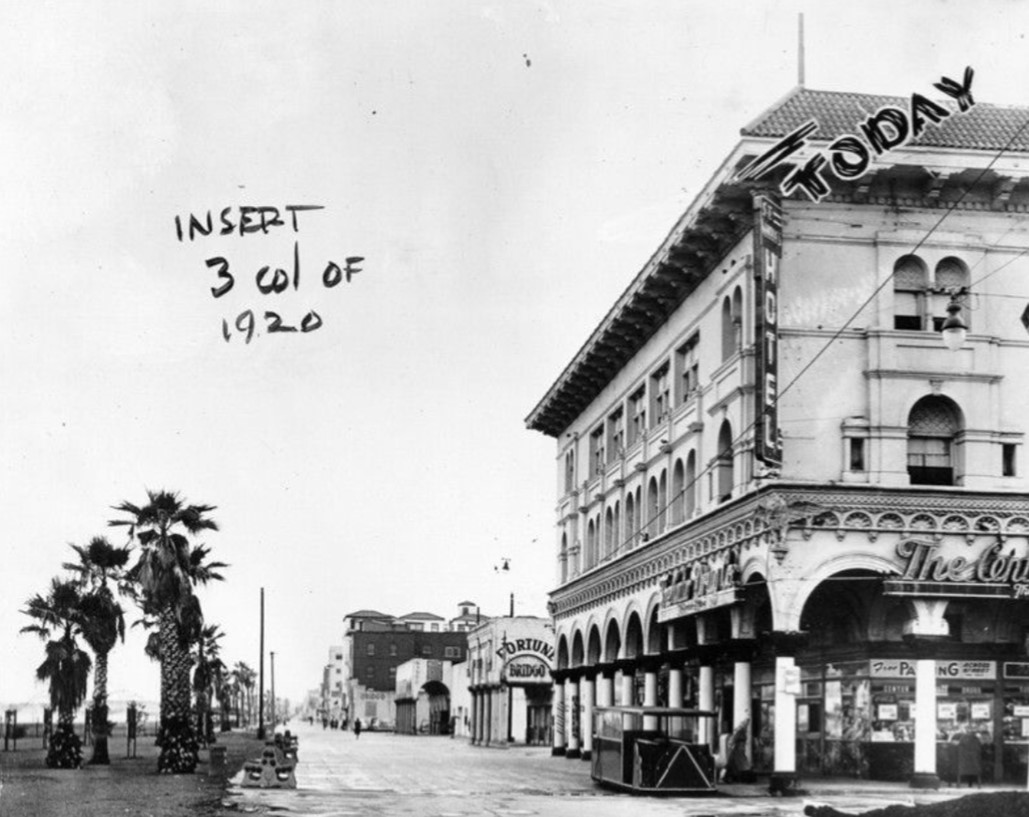 |
|
| (1955)* - Looking north on Ocean Front Walk at Windward Avenue. On the corner on the right is the St. Mark's Hotel, with a drug store filling the street level rooms. An empty tram car sets on the corner by the hotel. Note: All the building on the left (ocean side) have been demolished. |
Historical Notes The entire row of buildings on the left, including the Vista Theatre, was demolished and later became the location of Windward Plaza Park. The St. Marks Hotel on the right would be demolished one year after the above photo was taken. |
Then and Now
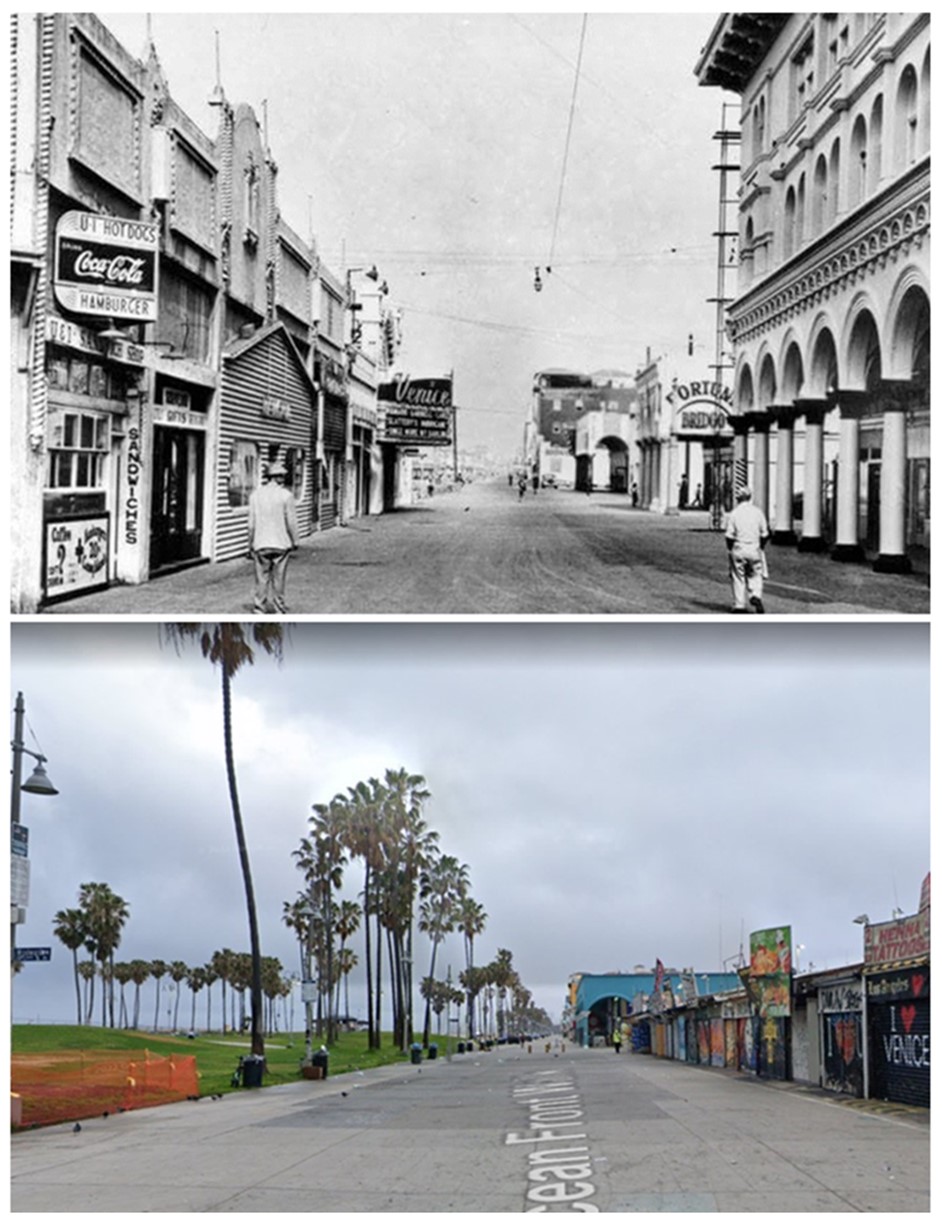 |
|
| (1949 vs 2022)* - Looking north on Ocean Front Walk from Windward Avenue in Venice. The St. Marks Hotel on the right was demolished in 1956. The entire row of buildings on the left, including the Venice Theatre, was also demolished and today is the location of Windward Plaza Park. |
Before and After
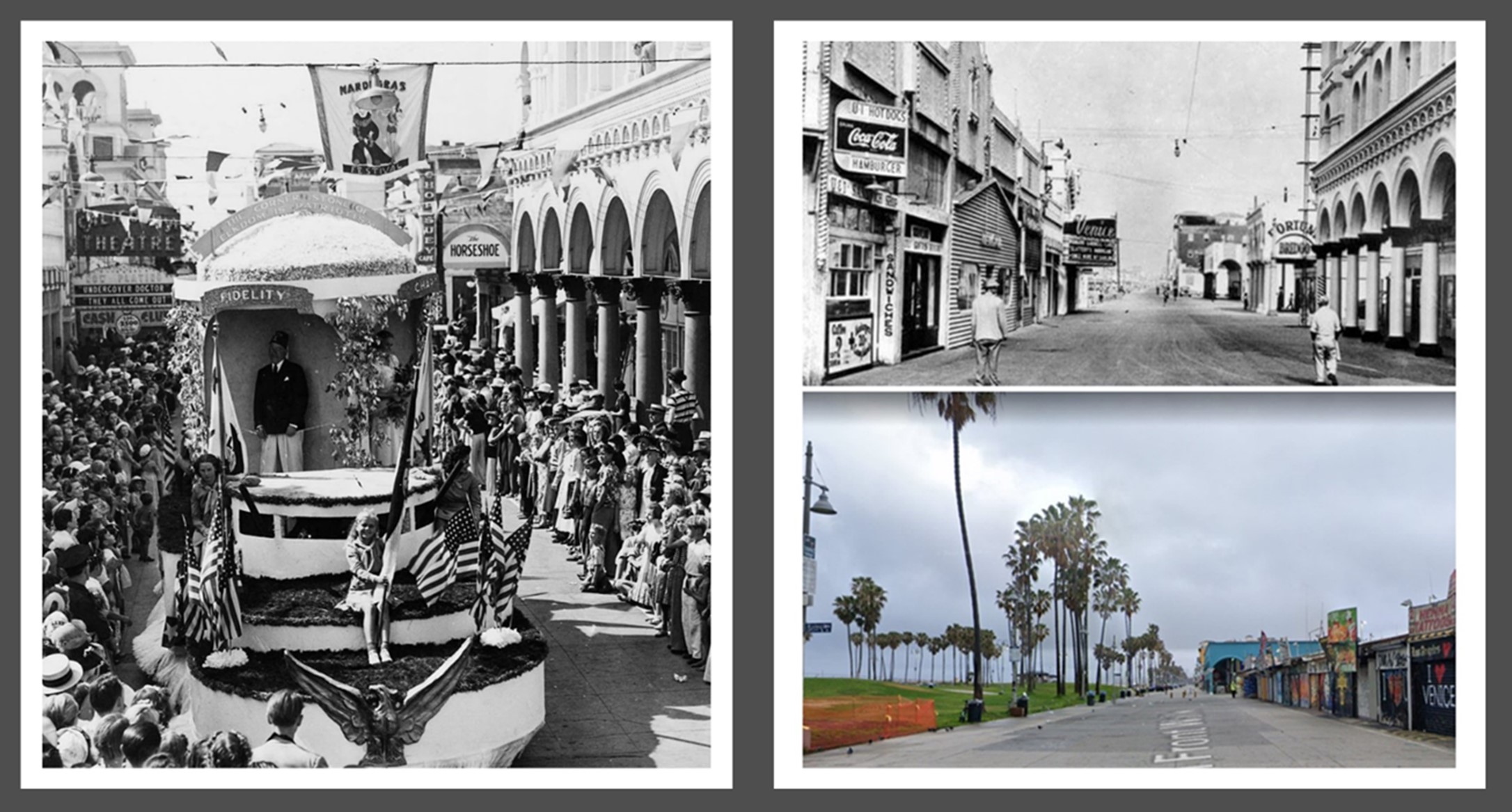 |
|
| (1939 / 1949 / 2022) - Ocean Front Walk just north of Windward Avenue. |
Historical Notes Over the past century, Ocean Front Walk near Windward Avenue in Venice has undergone significant transformations. Initially established in 1905 as part of Abbot Kinney's "Venice of America" project, it flourished as a popular tourist destination with Venetian-inspired architecture and attractions. The area thrived through the 1920s and 1930s, but experienced a decline after World War II, earning the nickname "Slum of the Sea" by the 1950s. The 1960s saw major demolitions and a shift towards a more bohemian character. In the late 1970s, Venice gained fame as the "Roller Skating Capital of the World," and by the 1980s-1990s, it had become a center for arts and culture. Today, Ocean Front Walk, also known as the Venice Beach Boardwalk, attracts millions of visitors annually with its eclectic mix of street vendors, performers, and recreational facilities. Despite facing challenges such as homelessness, it remains a vibrant and diverse urban beach destination, reflecting its evolution from a carefully planned resort to an iconic Southern California landmark. |
* * * * * |
Catalina
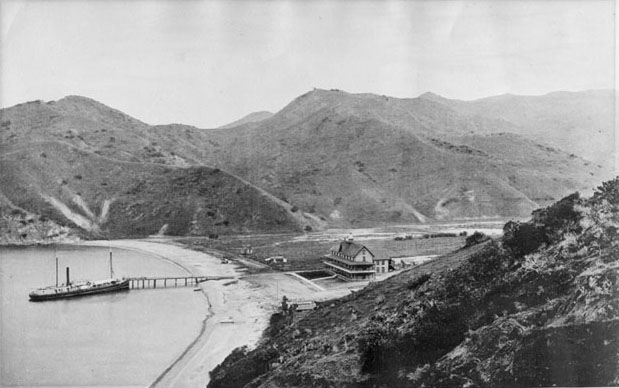 |
|
| (ca. 1888)#**^ - View of a steamer at the dock in Avalon Bay and the Hotel Metropole in Avalon, Santa Catalina. |
Historical Notes The first European to set foot on the island was the Portuguese explorer Juan Rodríguez Cabrillo, who sailed in the name of the Spanish crown. On October 7, 1542, he claimed the island for Spain and christened it San Salvador after his ship. Over half a century later, another Spanish explorer, Sebastián Vizcaíno, rediscovered the island on the eve of Saint Catherine's day (November 24) in 1602. Vizcaino renamed the island in the saint's honor. The first owner to try to develop Avalon into a resort destination was George Shatto, a real estate speculator from Grand Rapids, Michigan. Shatto purchased the island for $200,000 from the Lick estate at the height of the real estate boom in Southern California in 1887. Shatto created the settlement that would become Avalon, and can be credited with building the town's first hotel, the original Hotel Metropole, and pier. His sister-in-law Etta Whitney came up with the name Avalon, which was taken from Alfred, Lord Tennyson's poem "Idylls of the King," about the legend of King Arthur. Despite Shatto's efforts, he defaulted on his loan after only a few years and the island went back to the Lick estate.*^ |
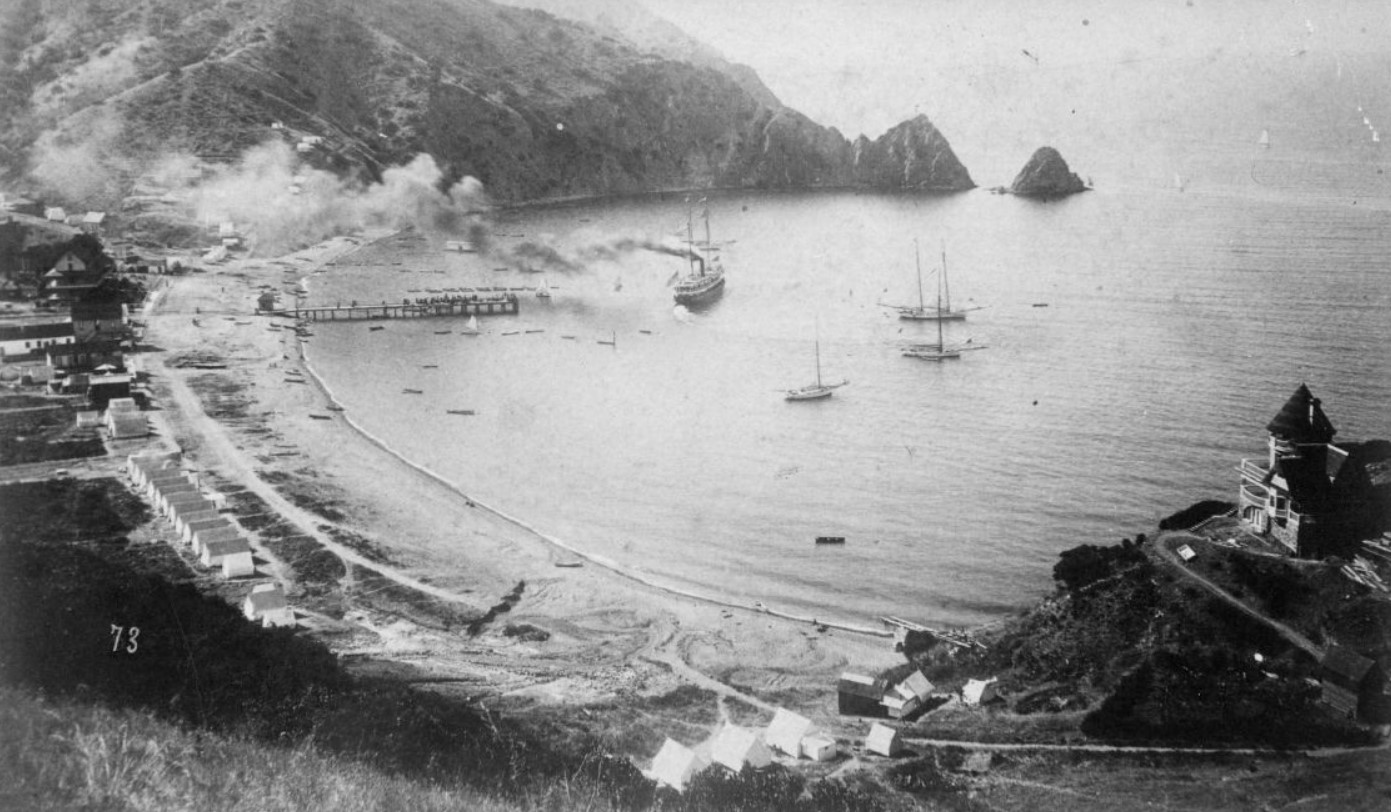 |
|
| (1891)#^^ – View of Avalon Bay in Catalina as seen from the hillside. The steamship S.S. Hermosa makes its way out toward the ocean away from the pier. House-tents can be seen along the beach. A large home (Holly Hill House) can be seen on the hillside to the right. The house still exists today and is Avalon's oldest remaining structure. |
Historical Notes The sons of Phineas Banning bought the island in 1891 from the estate of James Lick and established the Santa Catalina Island Company to develop it as a resort. They had a variety of reasons for doing this. They wanted Catalina's rock to build a breakwater at Wilmington for their shipping company. They had also just built a luxurious new boat, the Hermosa, to bring tourists to the Island. If tourism failed, this investment was at risk. By owning Catalina, they would not only get their rock, but also money from tourists for their passage as well as everything on the Island.*^ |
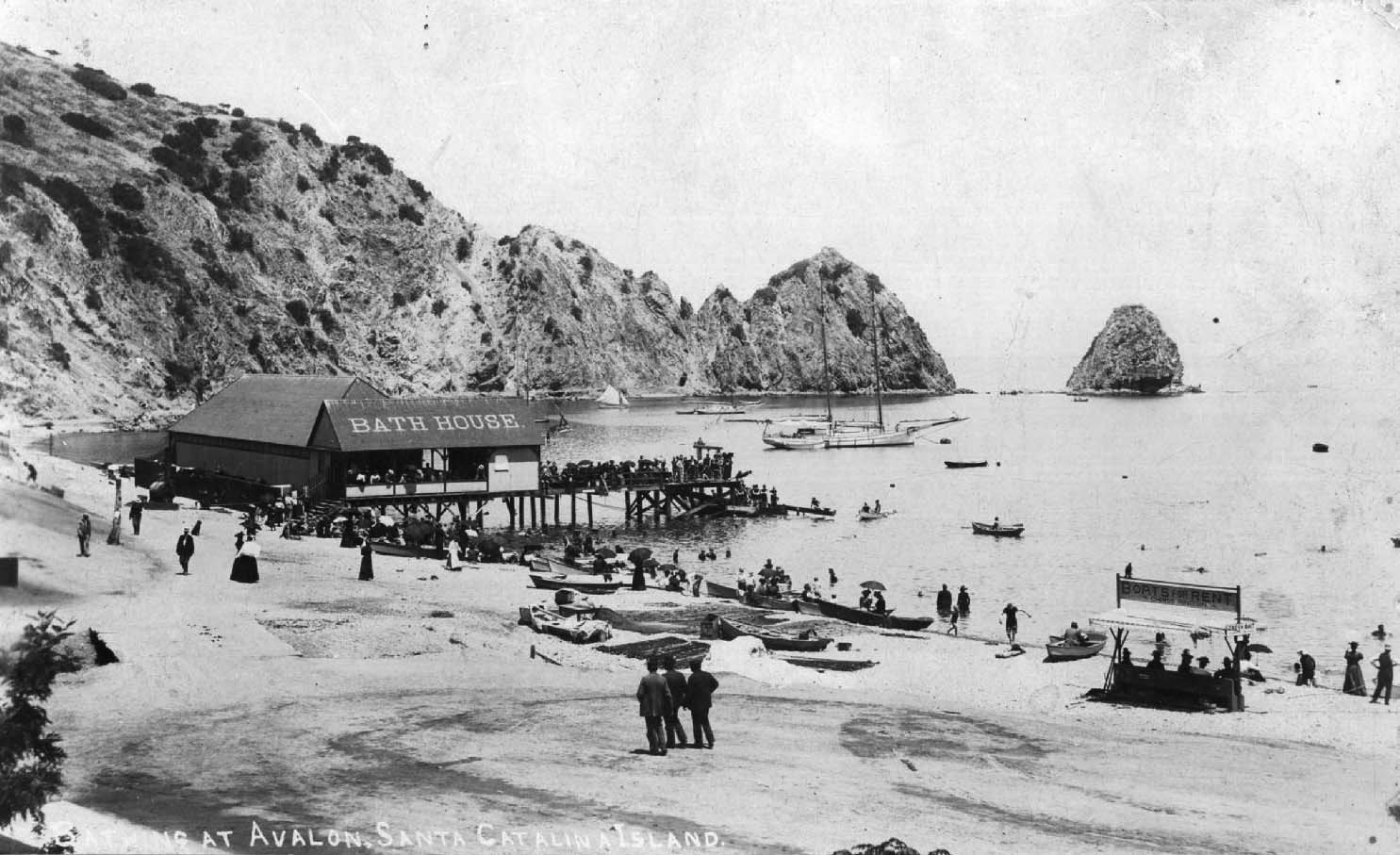 |
|
| (ca. 1900)^*# - View looking south at Avalon Bay on Catalina Island. The Avalon Bath House is seen on the pier. The rock formation called Surgarloaf Point is in the background. |
Historical Notes The Banning brothers fulfilled Shatto's dream of making Avalon a resort community with the construction of numerous tourist facilities. Although the Bannings' main focus was in Avalon, they also showed great interest in the rest of the island and wanted to introduce other parts of Catalina to the general public. They did this by paving the first dirt roads into the island's interior, where they built hunting lodges and led stagecoach tours, and by making Avalon's surrounding areas (Lovers Cove, Sugarloaf Point and Descanso Beach) accessible to tourists.*^ |
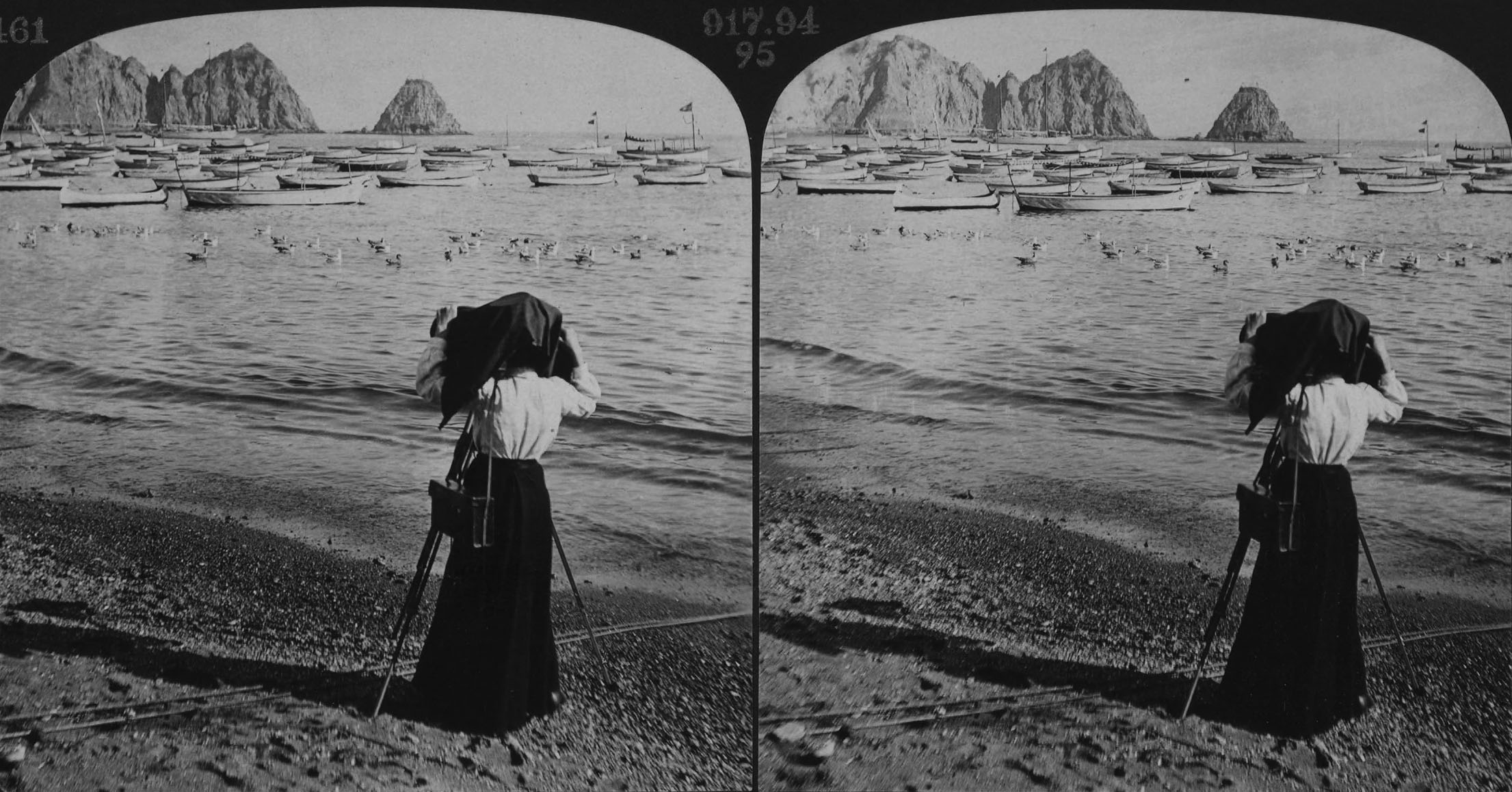 |
|
| (1903)*^ - Stereoscopic view of a woman taking a photograph of Sugarloaf Point at Avalon Bay on Catalina Island. |
Historical Notes The point upon which the beautiful and historic Casino sits has always been the defining landmark of Santa Catalina Island. Before the Casino was built, sailors arriving from the mainland would use Sugarloaf Point, as it was then called, to gain their bearings on approaching Avalon Bay.**#* |
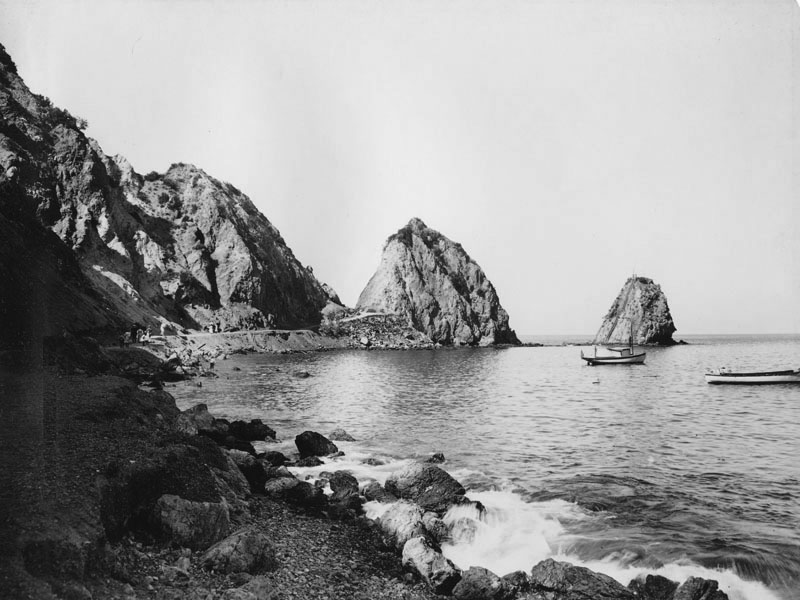 |
|
| (1908)^*# - Closer view of Sugarloaf Point in Avalon Bay. Several people can be seen on the Point's access road. |
Historical Notes Sugarloaf Point was actually defined by a pair of solid granite outcroppings. Big Sugarloaf and Little Sugarloaf were connected by a narrow sawtooth ridge.**#* |
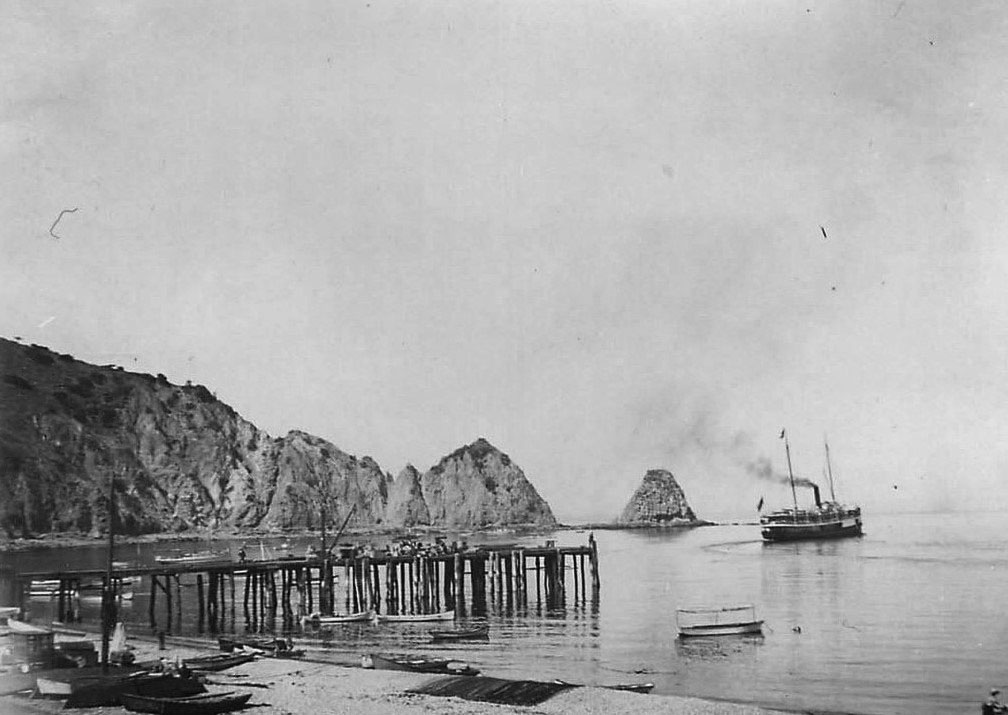 |
|
| (1901)^#^ - The steamer "Hermosa" leaving Catalina Island and making its way past Sugarloaf Point. |
Historical Notes The wooden steamship S.S. Hermosa was built in San Francisco in 1888 by the Wilmington Transportation Company, owned by the Banning family, for transportation to the Island during the summer season. Off-season, the ship had been leased to other operators for use in Puget Sound and Alaska. By June of 1892, the Hermosa had returned to service on the Santa Catalina Island run, the Island then being owned by the Banning brothers.#*** |
 |
|
| (ca. 1900)^*# - Close-up view of Sugarloaf Point showing a steep stairway on the side of the rock formation and a viewing platform at the top. The steamship Hermosa is seen on the other side of the Point. |
Historical Notes Like its namesake in Rio de Janeiro, Brazil, Sugarloaf Mountain was the site of numerous festivities. Fireworks were exploded from its summit on Fourth of July. Climbing Sugarloaf was no easy task. In 1896, a stairway was built to accommodate the less adventurous.**#* |
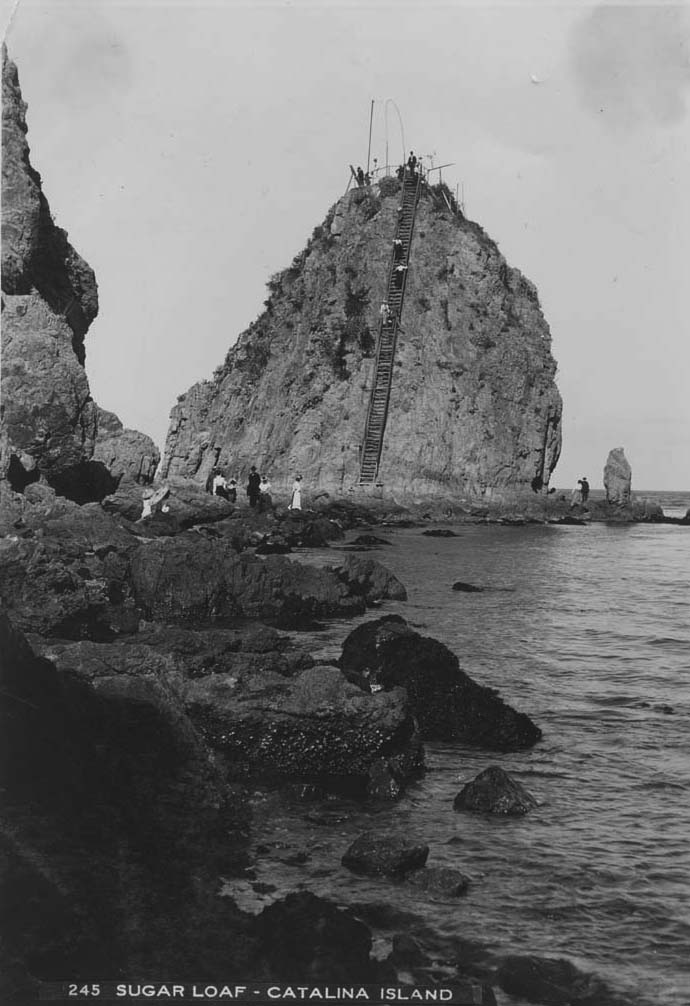 |
|
| (ca. 1900)^*# - Several people are seen ascending and descending Sugarloaf Point as others stand on the rocks below observing. A couple of people have already made it to to top. |
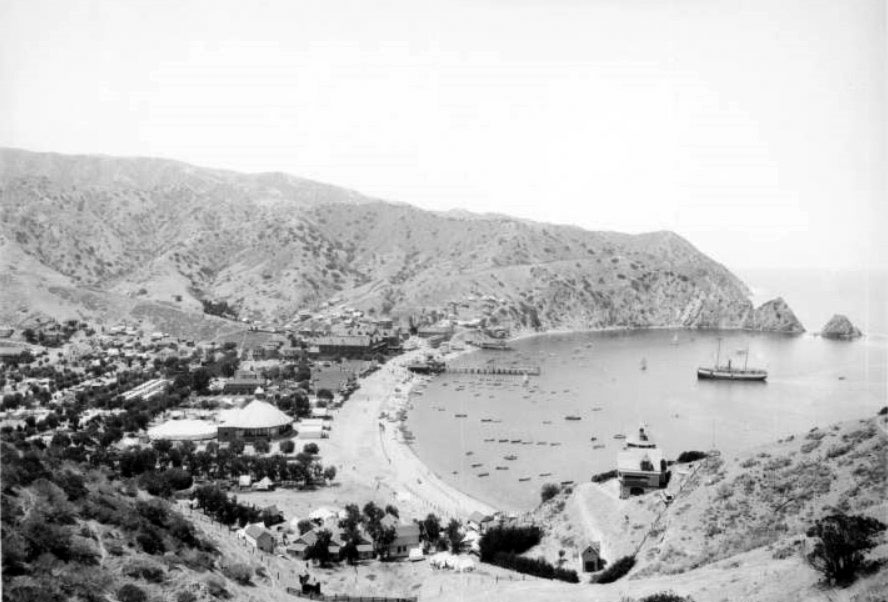 |
|
| (1905)^^ - View of Avalon Bay as seen from the hillside. The steamer "Hermosa" is approaching the pier. Close to the pier can be seen the Metropole Hotel. Beyond the pier is the Avalon Bath House and rounding the bay you get to Sugar Loaf Point. |
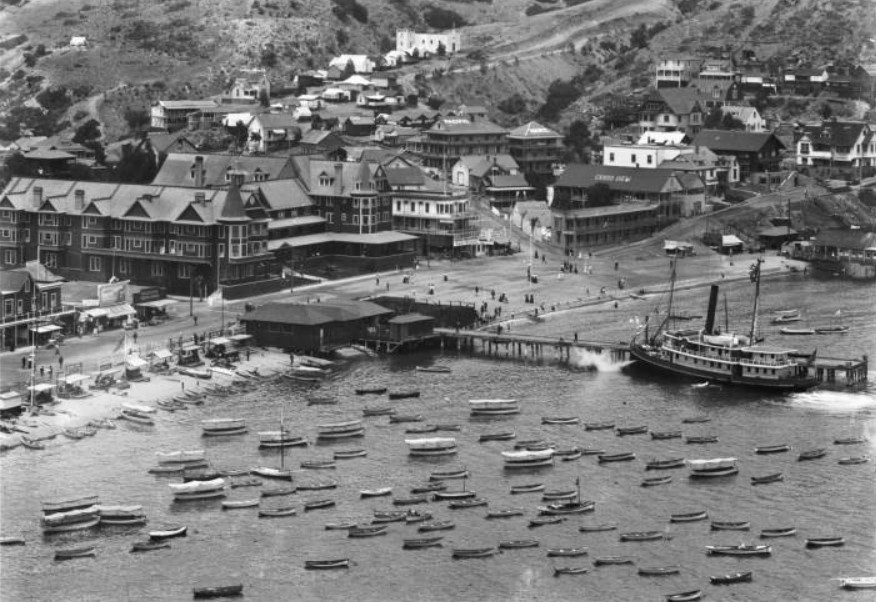 |
|
| (ca. 1905)^ - Panoramic view of the Town of Avalon on Santa Catalina Island with new Metropole Hotel and Grand View Hotel, as well as the pier and many small boats in the water. The steamer S.S Hermosa is docked at the wharf. |
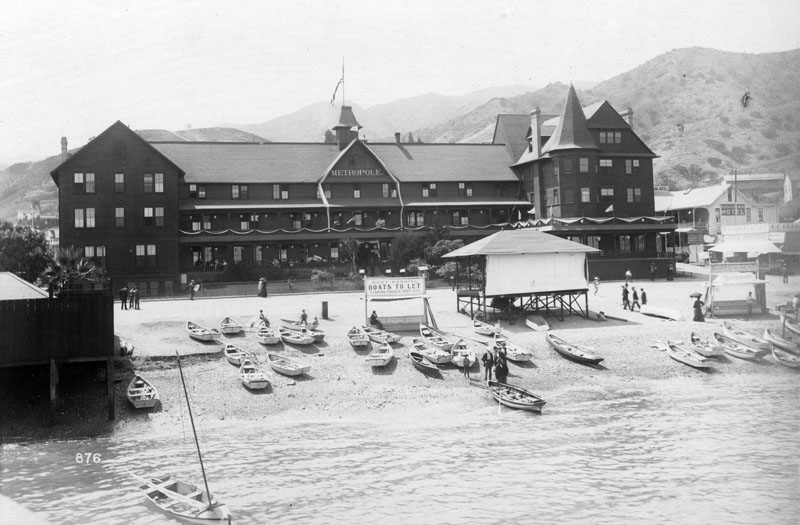 |
|
| (ca. 1900)^ - View of the historic Hotel Metropole located at 205 Crescent Avenue on Santa Catalina Island. Several people take a leisurely stroll through the streets, and at least two dozen boats are 'docked' on the beach. A sign next to a small structure reads: "Bert Harding - Boats to let - Fishing, tackle, Bait, etc." |
Historical Notes The Hotel Metropole, originally built in 1888 as Catalina's grande dame, was a large 3-story wooden structure with views of the bay that boasted of numerous windows, several dormers, half a dozen chimneys, and two covered patios. In 1915 this renowned landmark was completely destroyed by a devastating fire that ravaged much of Avalon. A few years later, the Hotel Metropole was rebuilt on the same site but was significantly downsized, this time consisting of only 48 rooms and a luxurious 2-bedroom Beach house.^ |
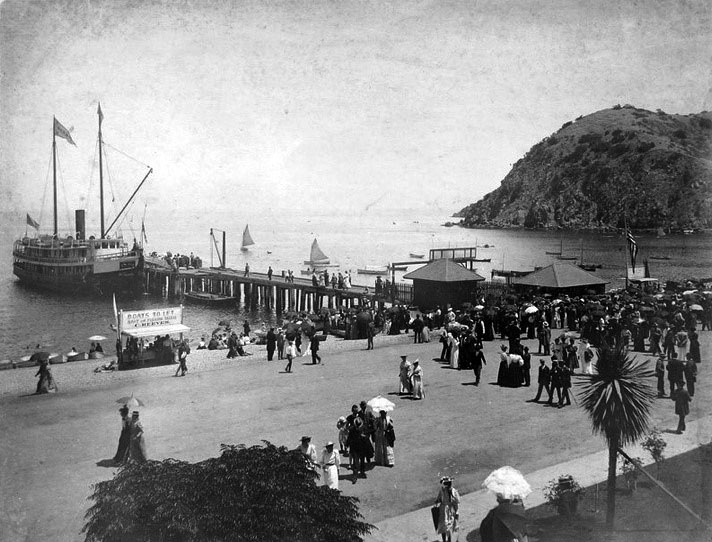 |
|
| (ca.1900)***# - View of the Wilmington Transportation Company's Steamer "Hermosa," docked at the Green Peer as seen from the front of the Metropole Hotel. Sign over the stand at center-left reads: “Boats to Let” |
Historical Notes The S.S. Hermosa carried up to 150 passengers and was elegantly decorated. It carried passengers to the island for fourteen years until it was replaced by the larger Hermosa II. The first Hermosa was stripped of valuables and set afire in Avalon harbor during a July 4th in 1902. #*** |
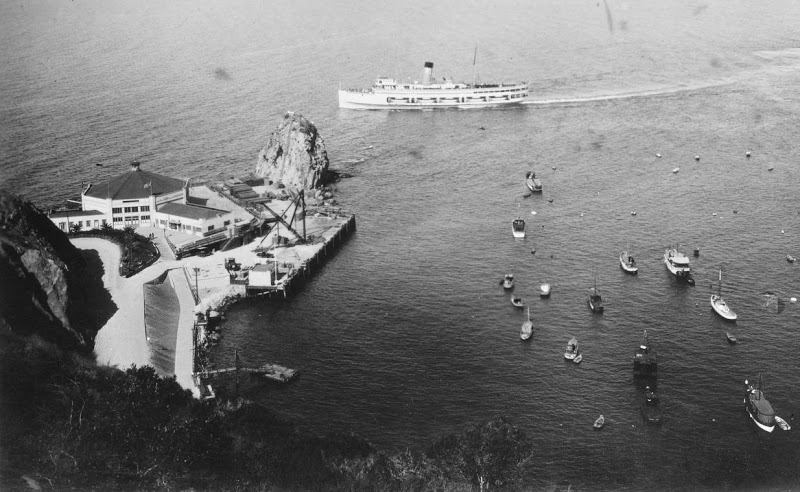 |
|
| (1927)^^ - View of Catalina Harbor looking seaward from behind Sugar Loaf. Sugarloaf Casino can be seen as well as several boats including the S.S. Catalina, "The Great White Steamer". |
Historical Notes In 1917, “Big” Sugarloaf was leveled for a new hotel to replace the Metropole. However, plans changed and a new site for the hotel (Hotel St. Catherine) was chosen: Descanso Canyon.**#* When chewing gum magnate William Wrigley Jr. bought the controlling stake in Catalina Island, he used the cleared spot (originally meant for Hotel St. Catherine) to build a dance hall. He named the new dance hall Sugarloaf Casino. It served as a ballroom and Avalon's first high school. The new structure was short lived, however, for it proved too small for Catalina's growing population. In 1928, the Casino was razed to make room for a newer Casino. Sugarloaf Rock was then blasted away to enhance the new Casino's ocean view.*^ |
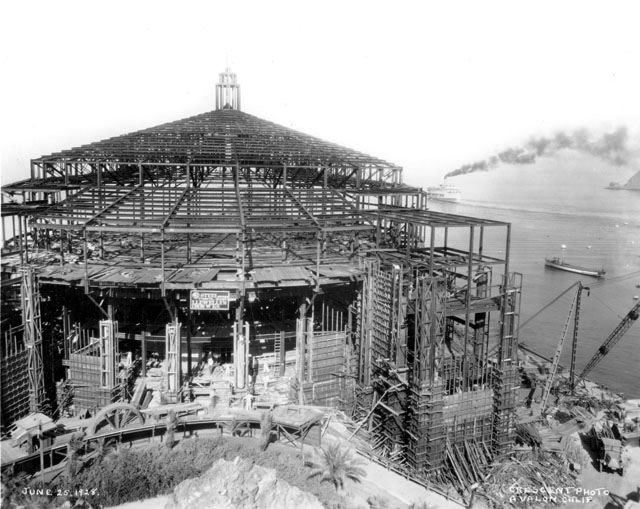 |
|
| (1928)#**^ - View showing the construction of the second Catalina Casino at Sugar Loaf Point. The steamship S.S. Catalina is seen in the background. |
Historical Notes In 1928, when the new, markedly taller casino building was completed, authorities changed their way of looking at Little Sugarloaf. What once had been a popular landmark was suddenly thought of as a view killer. Concern began to grow that climbers would injure themselves on Little Sugarloaf. The stairs were condemned and removed. In March, 1929, Little Sugarloaf was blasted away to give what is now called Casino Point, the look that it offers today.**#* |
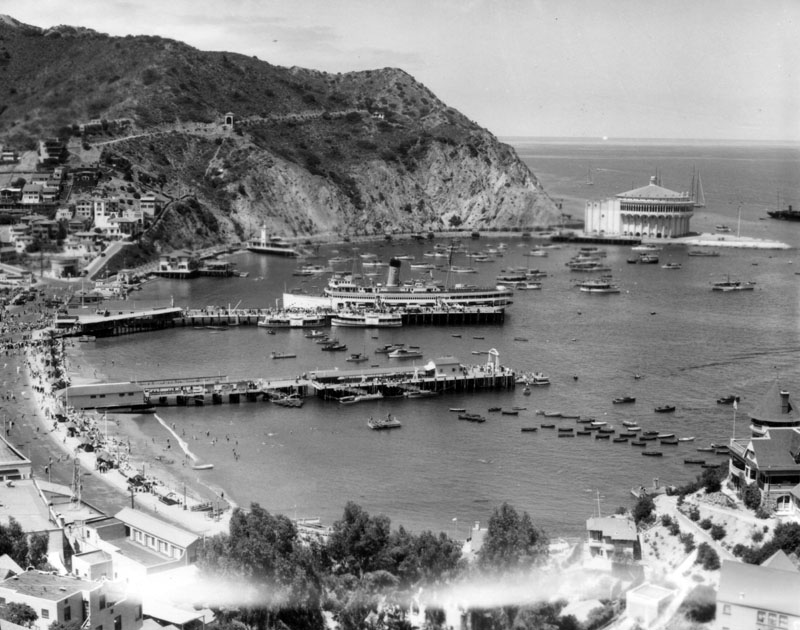 |
|
| (ca. 1929)^ - View of Avalon Bay across Crescent Bay, on Santa Catalina Island as seen from a mountain top. The Catalina Casino, surrounded by the sea on three sides, is visible at the edge of the bay. There are no signs that Sugarloaf Point, the once picturesque, cliff bound peninsula, had ever existed. |
 |
|
| (1931)^#^ - Seaplane landing near the new casino in Avalon. Click HERE to see more in Aviation in Early L.A. |
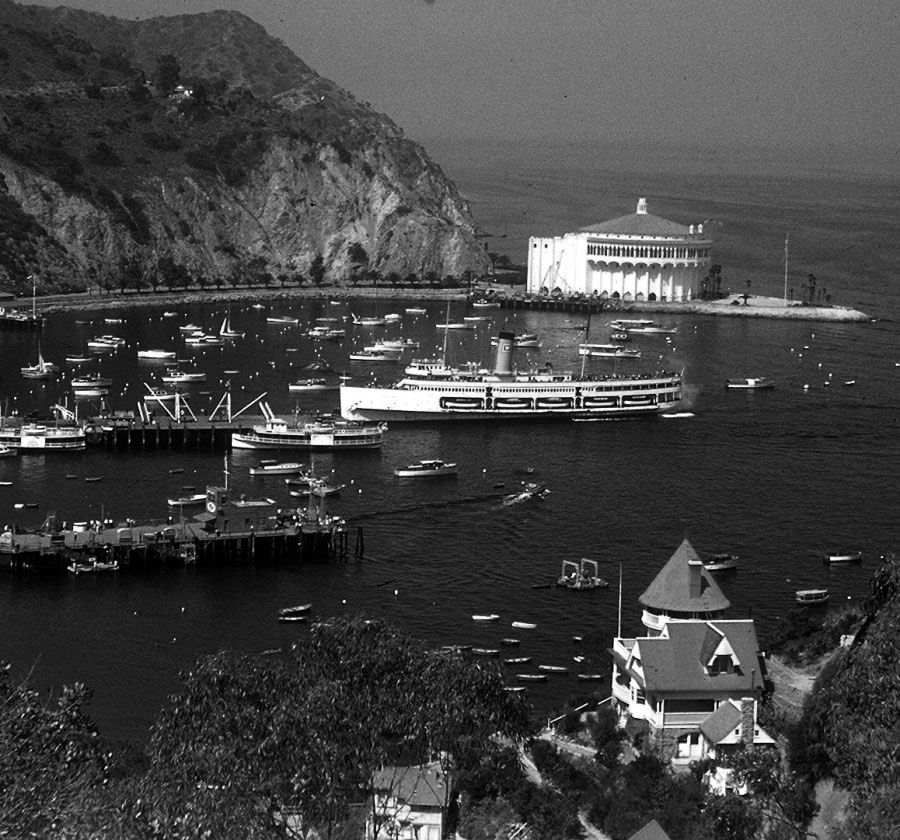 |
|
| (1940s)^#^ - View looking down at Crescent Bay in Avalon showing Catalina Casino where Big Sugarloaf and Little Sugarloaf once stood. The S.S. Catalina is seen approaching the pier surounded by smaller boats. The Victorian-style house in the lower right is one of Catalina's oldest building. |
Historical Notes Avalon's oldest remaining structure, the distinctive Holly Hill House, was built on a lot purchased from Shatto and his agent C.A. Summer for $500 in 1888.*^ The S.S. Catalina, known as "The Great White Steamer", took its maiden voyage on June 30, 1924. The 301-foot ship, originally built at a cost of $1 million dollars, was in service from 1924 and carried about 25 million passengers between Los Angeles and Avalon Harbor until she was retired on September 14, 1975.^ |
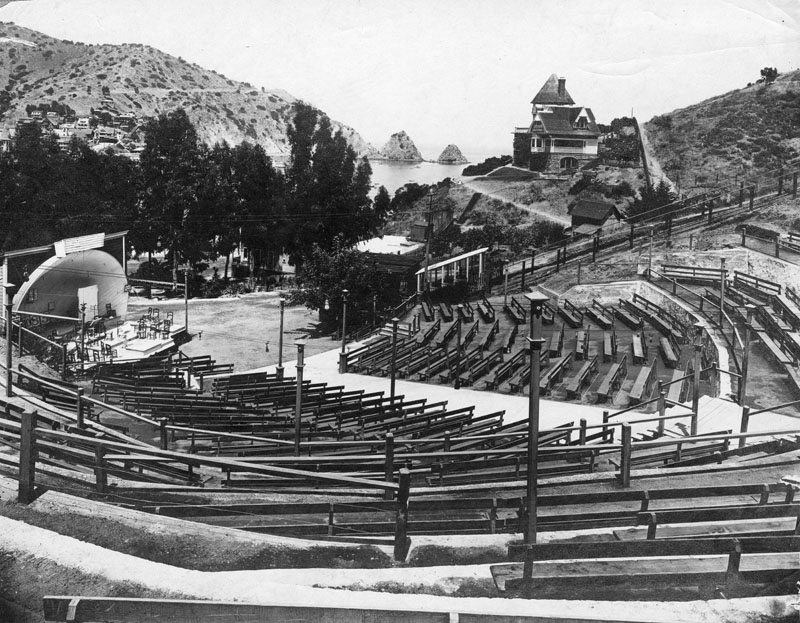 |
|
| (ca 1905)^ - View of the Avalon Amphitheater on Santa Catalina Island. Wooden rows of seats line the hillside, and the large Victorian-style Holly House is farther back on the hill. A furnicular is seen on the incline in the background. |
Historical Notes In 1905, funicular travel arrived in Catalina with the opening of the Santa Catalina Island Incline Railway. |
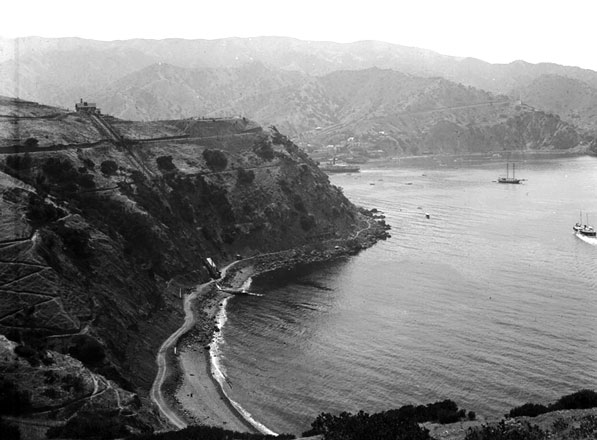 |
|
| (ca. 1905)^^ - View of the funicular descending from a tea house at the summit down to Pebbly Beach on Lovers Cove, Catalina Island. |
Historical Notes The railway consisted of two separate funiculars. One began at the base of the now-abandoned Avalon Amphitheater and ascended the hill on the southwestern side of Avalon Bay to a point known as Buena Vista Point. The other descended the opposite side of the hill to Pebbly Beach on Lovers Cove. Passengers could disembark at the summit for refreshments in a small tea house or continue on to Lovers Cove for a ride in a glass-bottomed boat. Variably known as the Santa Catalina Incline Railway, the Island Mountain Railway, and--confusingly--Angels Flight, the railway closed in 1918, several years after a fire devastated Avalon and depressed the tourist business. The railway briefly reopened in the 1920s but closed finally in 1923. Its ruins are still visible along the old right-of-way to this day.**# |
Click HERE to see more in Early Views of Catalina |
* * * * * |
Please Support Our CauseWater and Power Associates, Inc. is a non-profit, public service organization dedicated to preserving historical records and photos. We are of the belief that this information should be made available to everyone—for free, without restriction, without limitation and without advertisements. Your generosity allows us to continue to disseminate knowledge of the rich and diverse multicultural history of the greater Los Angeles area; to serve as a resource of historical information; and to assist in the preservation of the city's historic records.
|
For more Historical Los Angeles Views click one of the following:
For Other Historical Views click one of the following:
See Our Newest Sections:
To see how Water and Electricity shaped the history of Los Angeles click one of the following:
Water:
Power:
* * * * * |
References and Credits
* DWP - LA Public Library Image Archive
^ LA Public Library Image Archive
^*The Valley Observed: Street Name Origins; Timeline of Valley History
+*The Eastsider LA: Avenue of the Palms
*# blogdowntown: Third Street Tunnel
#* About.Com: History of Electric Vehicles
#+ Facebook.com: Classic Hollywood/Los Angeles/SFV
#*^Library of Congress: Venice Lagoon
##*A Visit to Old Los Angeles: CSULB
*##LA Times: Dig Into History You'll Find Snake Oil..Victor Girard Kleinberger ; 1900 Fashion
^##Metropolitan Transportation Library and Archive
##^CSUN Oviatt Library Digital Archives
###Denver Public Library Image Archive
*#*Historical Los Angeles Theatres: The Philharmonic Auditorium; Downtown Theatres
*^#LincolnHeightsLA.com: Legion Ascot Speedway
**#KCET - Lost Tunnels of Downtown LA; Three Forgotten Railway Inclines; Edendale Red Car Line; The Origins of Elysian Park; When L.A. Was a Horse-Powered Town; How L.A. Celebrated Sunset Boulevard's Opening in 1904
^*#California State Library Image Archive
^^#forum.scraperage.com: Aliso St; Hill Street Tunnel, 1903; Broadway Tunnel
*#^History of Hermosa Beach - Maureen Megowan
^#*City of Redondo Beach HIstory
^#^Noirish Los Angeles - forum.skyscraperpage.com; Broadway Tunnel; Sugarloaf Point; Angels Flight; Avalon; Boylston Yard; Angels Flight Observation Tower View
+#+Silentlocations.wordpress.com: Venice Minitiare Railroad
++#Everydayarmour.blogspot.com/
^^*Early Downtown Los Angeles - Cory Stargel, Sarah Stargel; Hollenbeck Hotel
***Los Angeles Historic - Cultural Monuments Listing
**^Historicechopark.org: Echo Park Lake; Elysian Park
*^*California Historical Landmarks Listing (Los Angeles)
*^^Nuestra Señora la Reina de los Ángeles: losangelespast.com
^^^Aerofiles - US Aviation Firsts
***^Oviatt Library Digital Archives
***#Pinterest.com: 1890's to 1920's Los Angeles - Anna Blanc's LA; Snapshots - Avalon Bay
#***S.S. Hermosa: pasadenastarnews.com
#**^LA County Library Image Archive
#*#^Brand Park and Studios: glendale.ca.us
*^#*On Bunker Hill: Crocker Mansion
*^#^Huntington Digital Library Archive
^^*^Restaurantwarecollectors.com: Angelus Hotel
^^^#Los Angeles Fire Department Historical Archive
#*^^Flickr.com: Views of Los Angeles
^*##Calisphere: University of California Image Archive
^##^Glendale Historical Society
^#^#U.S. Geological Survey Photographic Library
*#**Los Angeles Westerners Corral: Venice Miniature Railway
^#*^Facebook.com - Bizarre Los Angeles
*#*#Abandoned & Little-Known Airfields – Paul Freeman
^#*#Angels Flight Goes to the Movies
*##*Chatsworth Historical Society
+##+Restaurant-ing Through History: Ice Cream Parlors
**#*Creating a Landmark: the Historic Casino Point
*###Pacific Coast Architecture Database (PCAD): Bryson-Bonebrake Block
###*Glendalecagov.org: Glendale History
*##^Wikimapia: Pacific Electric Edendale Cut
#**#Debunking Venice's Historic Myths
#^^#Facebook.com: Garden of Allah Novels, Martin Turnbull
****#Tumblr.com: LA History - Leonis Adobe
#+++Facebook.com: West San Fernando Valley Then And Now
#+#+Glendale News-Press: Tropic
**#**Electric Railway Historic Association: Angel's Flight
**^*^Pacific Electric Historical Society
^^^**Metropolitan News: H. Jevne Co. Offers Free Home Delivery
^^^^#A History of the Los Angeles City Market
*#*#*Venice Miniature Railroad - Jeffrey Stanton
*^ Wikipedia: H.J. Whitley; Occidental College; Beverly Hills; Beverly Hills Hotel; Los Angeles Railway; Pershing Square; Broadway Tunnel: Isaac Van Nuys; Sawtelle; Port of Los Angeles; Tournament of Roses Parade; Angels Flight; Occidental College; Mt. Washington, LA; Broadway, LA; Hancock Park; La Brea Tar Pits; Los Angeles City Oil Field; Deadman's Island (San Pedro); Moses Sherman; Rose Bowl Game; Hollywood Hotel; Hollywood HIgh School; California Club; San Pedro; Salt Lake Oil Field - Gilmore Oil Field; Westwood; 2nd Street Tunnel; Hermosa Beach; Los Angeles Memorial Coliseum; Redondo Beach Pier; Redondo Beach; West Hollywood; Pacific Palisades; 1910 L.A. International Air Meet at Dominguez Hills; Hancock Park; Marlborough School; Pacific Electric Building; History of the Los Angeles Police Department; History of Los Angeles Population Growth; Avalon Bay Stereoscopic View; History of UCLA; Leslie Brand; Venice Canal HIstoric District; Leslie Brand; Grand Central Airport; Leonis Adobe; Los Angeles Herald-Examiner; Camera Obscura; Friday Morning Club
< Back
Menu
- Home
- Mission
- Museum
- Major Efforts
- Recent Newsletters
- Historical Op Ed Pieces
- Board Officers and Directors
- Mulholland/McCarthy Service Awards
- Positions on Owens Valley and the City of Los Angeles Issues
- Legislative Positions on
Water Issues
- Legislative Positions on
Energy Issues
- Membership
- Contact Us
- Search Index
.jpg)

